Principles of Marketing: An Asian Perspective Chapter 1
VerifiedAdded on 2022/01/24
|272
|12061
|245
AI Summary
This chapter from Principles of Marketing: An Asian Perspective discusses the basics of marketing, including the marketing process, customer needs, value proposition, and marketing management orientations. It also covers customer relationship management, capturing value from customers, and the changing marketing landscape. The chapter is relevant for students studying marketing and related courses in colleges and universities.
Contribute Materials
Your contribution can guide someone’s learning journey. Share your
documents today.
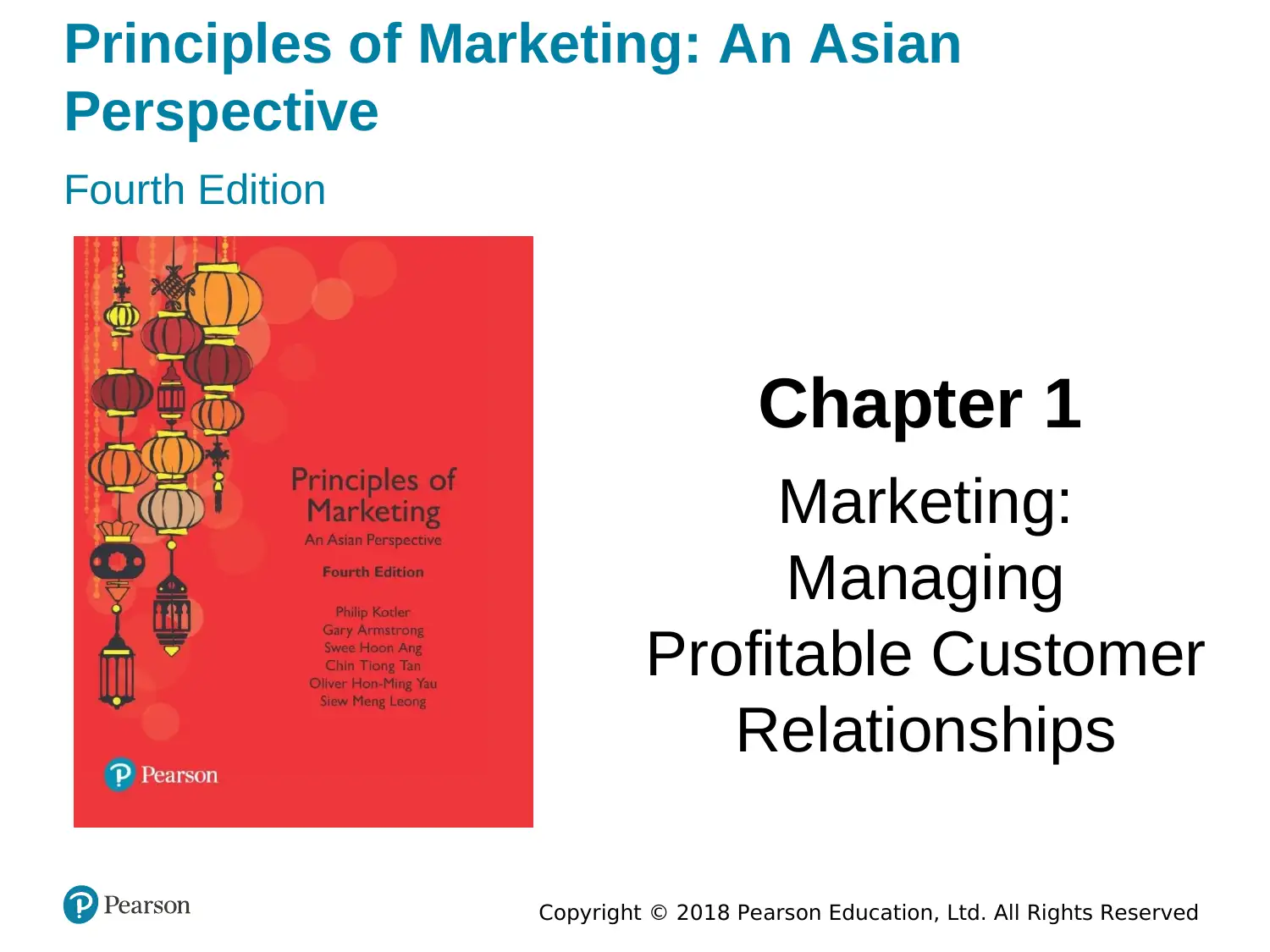
Fourth Edition
Chapter 1
Marketing:
Managing
Profitable Customer
Relationships
Copyright © 2018 Pearson Education, Ltd. All Rights Reserved
Principles of Marketing: An Asian
Perspective
Chapter 1
Marketing:
Managing
Profitable Customer
Relationships
Copyright © 2018 Pearson Education, Ltd. All Rights Reserved
Principles of Marketing: An Asian
Perspective
Secure Best Marks with AI Grader
Need help grading? Try our AI Grader for instant feedback on your assignments.

Copyright © 2018 Pearson Education, Ltd. All Rights Reserved
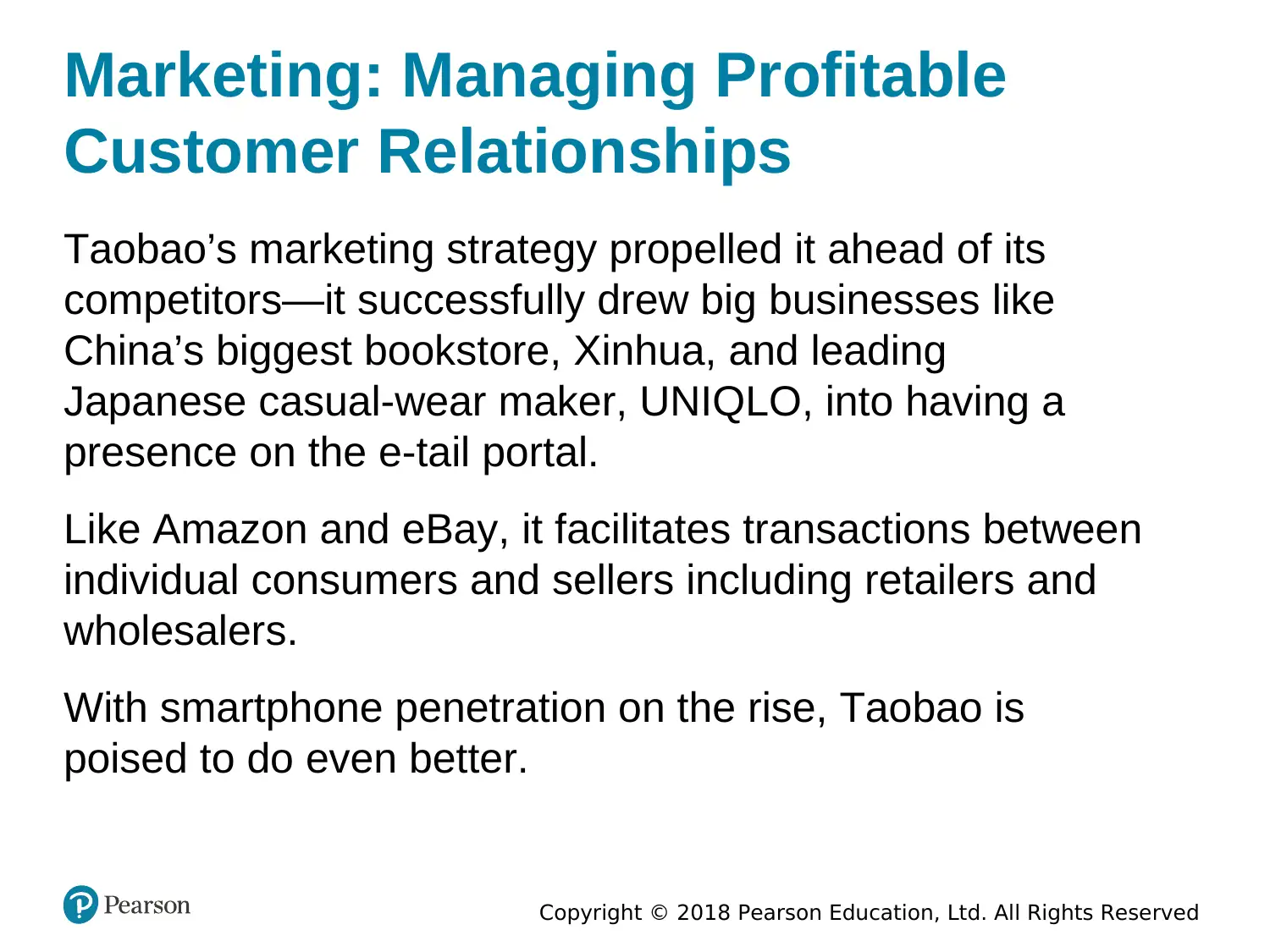
Copyright © 2018 Pearson Education, Ltd. All Rights Reserved
Marketing: Managing Profitable
Customer Relationships
Taobao’s marketing strategy propelled it ahead of its
competitors—it successfully drew big businesses like
China’s biggest bookstore, Xinhua, and leading
Japanese casual-wear maker, UNIQLO, into having a
presence on the e-tail portal.
Like Amazon and eBay, it facilitates transactions between
individual consumers and sellers including retailers and
wholesalers.
With smartphone penetration on the rise, Taobao is
poised to do even better.
Marketing: Managing Profitable
Customer Relationships
Taobao’s marketing strategy propelled it ahead of its
competitors—it successfully drew big businesses like
China’s biggest bookstore, Xinhua, and leading
Japanese casual-wear maker, UNIQLO, into having a
presence on the e-tail portal.
Like Amazon and eBay, it facilitates transactions between
individual consumers and sellers including retailers and
wholesalers.
With smartphone penetration on the rise, Taobao is
poised to do even better.
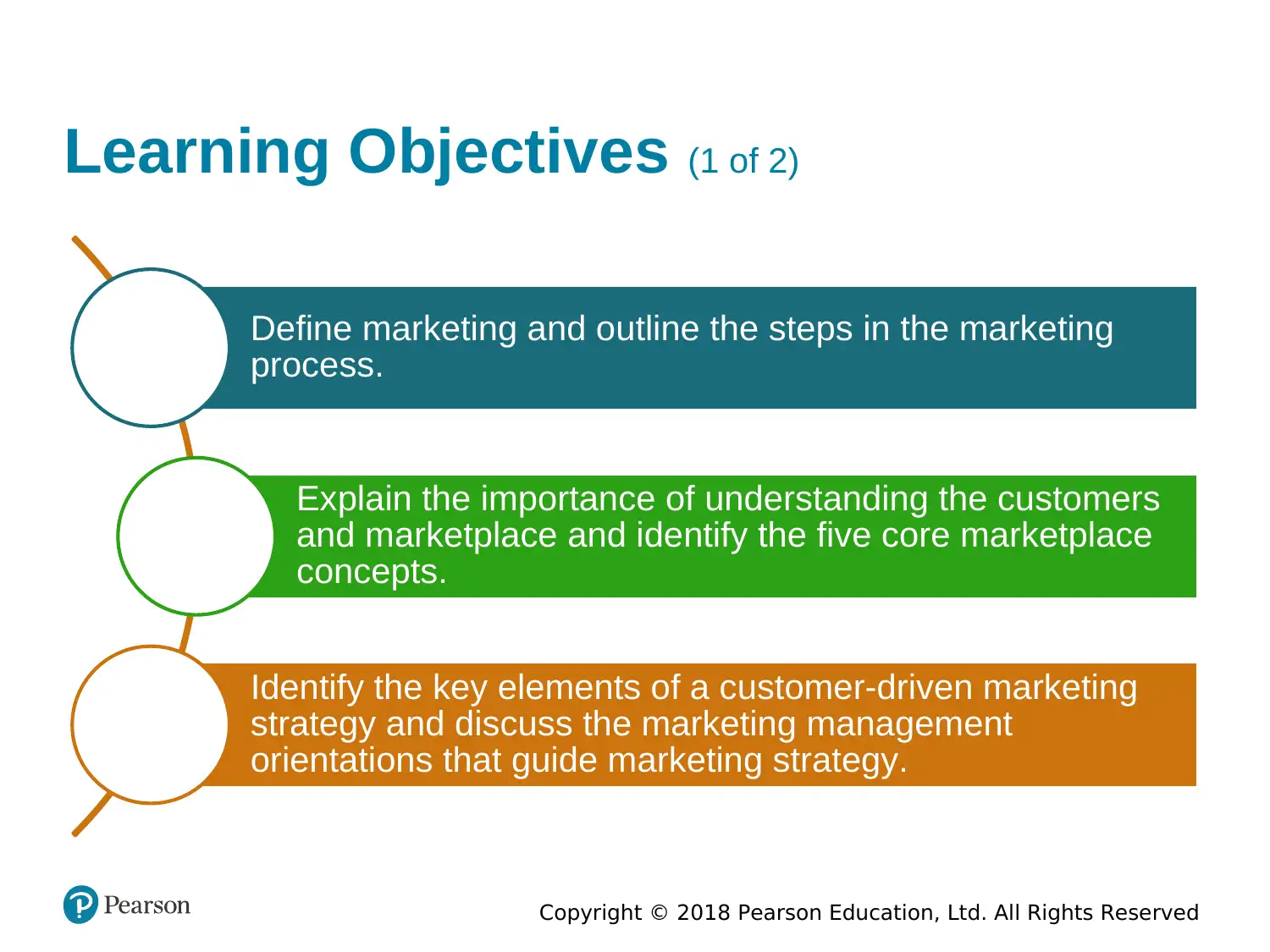
Copyright © 2018 Pearson Education, Ltd. All Rights Reserved
Learning Objectives (1 of 2)
Define marketing and outline the steps in the marketing
process.
Explain the importance of understanding the customers
and marketplace and identify the five core marketplace
concepts.
Identify the key elements of a customer-driven marketing
strategy and discuss the marketing management
orientations that guide marketing strategy.
Learning Objectives (1 of 2)
Define marketing and outline the steps in the marketing
process.
Explain the importance of understanding the customers
and marketplace and identify the five core marketplace
concepts.
Identify the key elements of a customer-driven marketing
strategy and discuss the marketing management
orientations that guide marketing strategy.
Secure Best Marks with AI Grader
Need help grading? Try our AI Grader for instant feedback on your assignments.
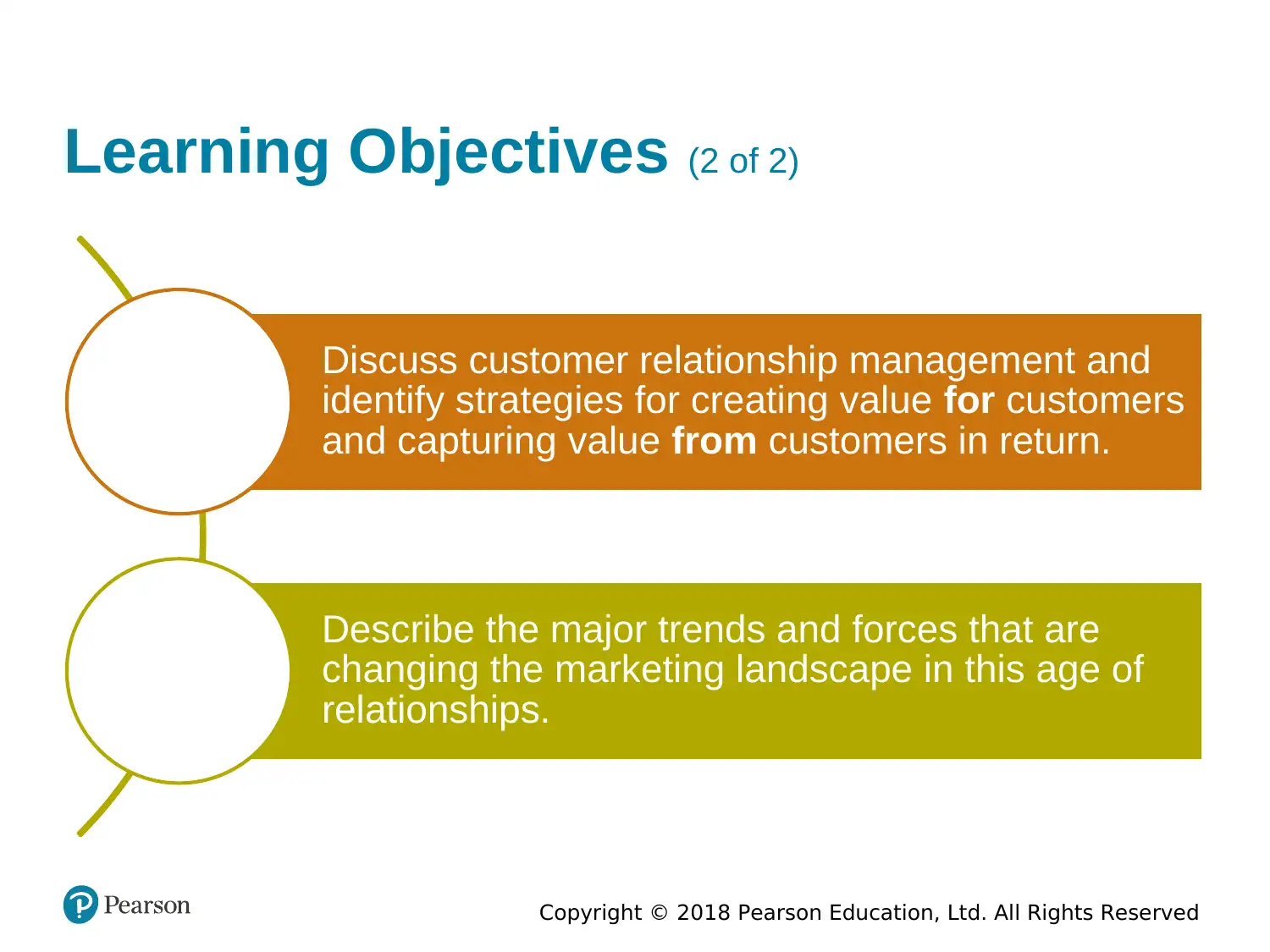
Copyright © 2018 Pearson Education, Ltd. All Rights Reserved
Learning Objectives (2 of 2)
Discuss customer relationship management and
identify strategies for creating value for customers
and capturing value from customers in return.
Describe the major trends and forces that are
changing the marketing landscape in this age of
relationships.
Learning Objectives (2 of 2)
Discuss customer relationship management and
identify strategies for creating value for customers
and capturing value from customers in return.
Describe the major trends and forces that are
changing the marketing landscape in this age of
relationships.
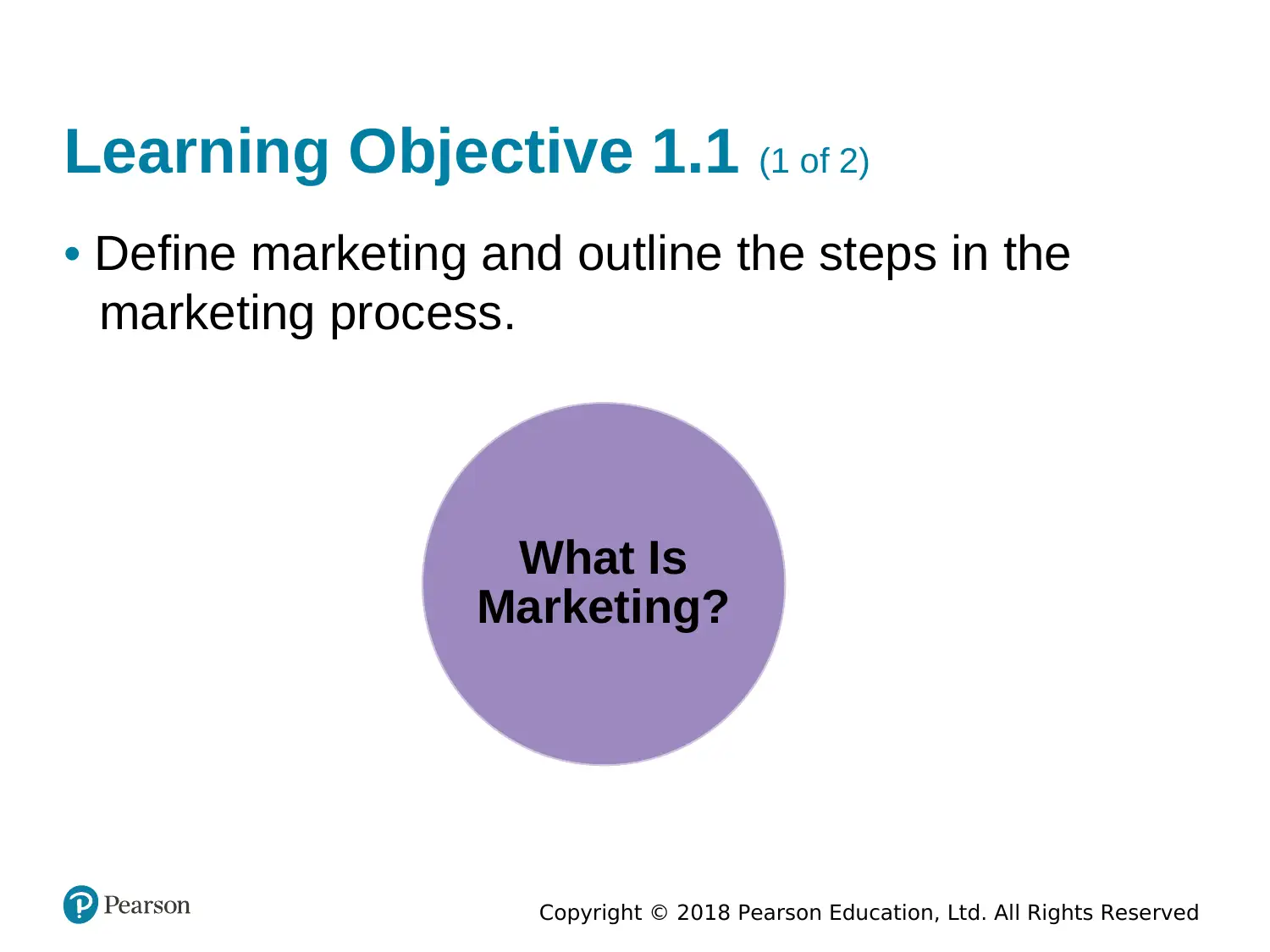
Copyright © 2018 Pearson Education, Ltd. All Rights Reserved
Learning Objective 1.1 (1 of 2)
• Define marketing and outline the steps in the
marketing process.
What Is
Marketing?
Learning Objective 1.1 (1 of 2)
• Define marketing and outline the steps in the
marketing process.
What Is
Marketing?
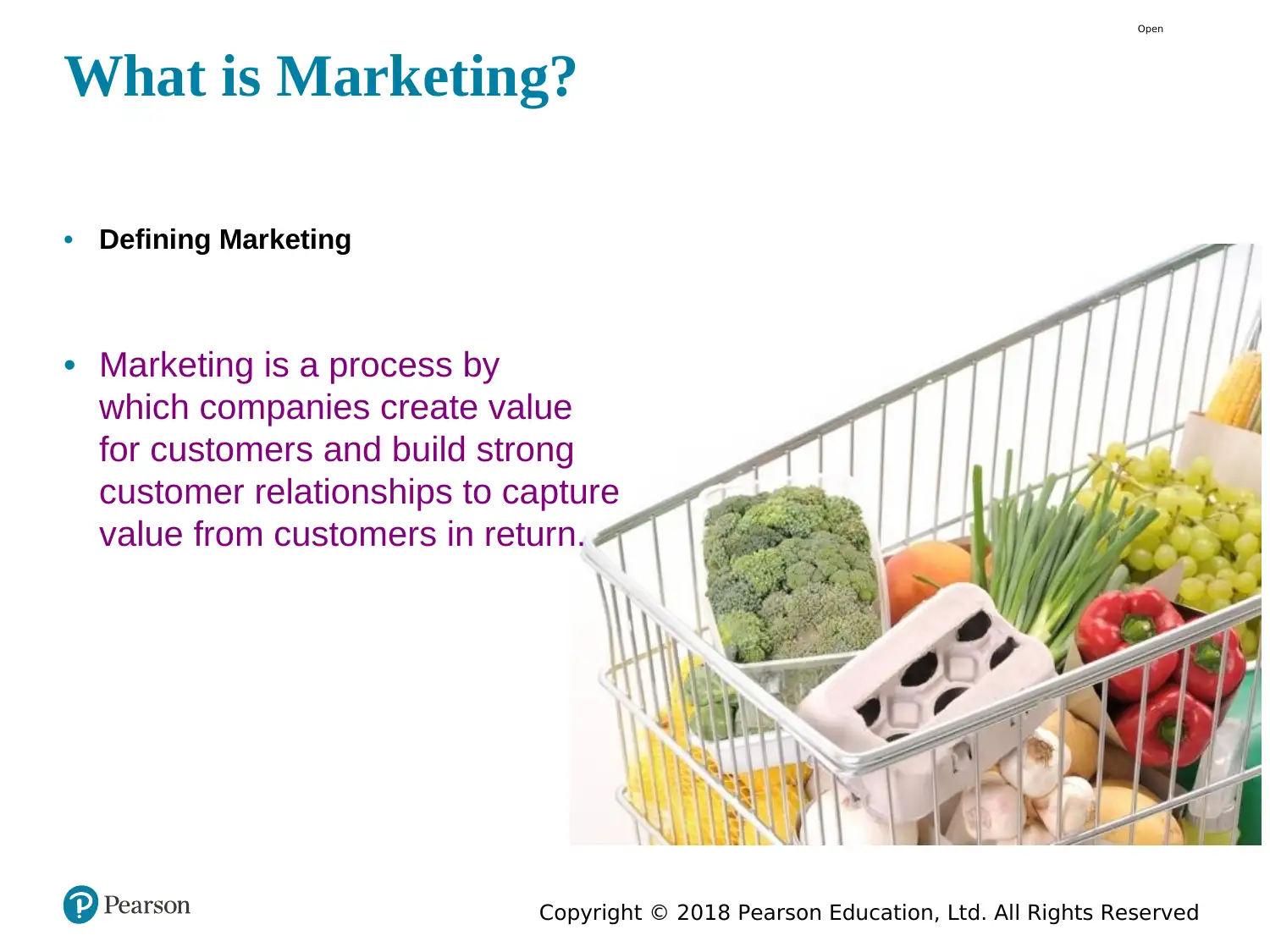
Copyright © 2018 Pearson Education, Ltd. All Rights Reserved
Open
7
What is Marketing?
• Defining Marketing
• Marketing is a process by
which companies create value
for customers and build strong
customer relationships to capture
value from customers in return.
Open
7
What is Marketing?
• Defining Marketing
• Marketing is a process by
which companies create value
for customers and build strong
customer relationships to capture
value from customers in return.
Paraphrase This Document
Need a fresh take? Get an instant paraphrase of this document with our AI Paraphraser
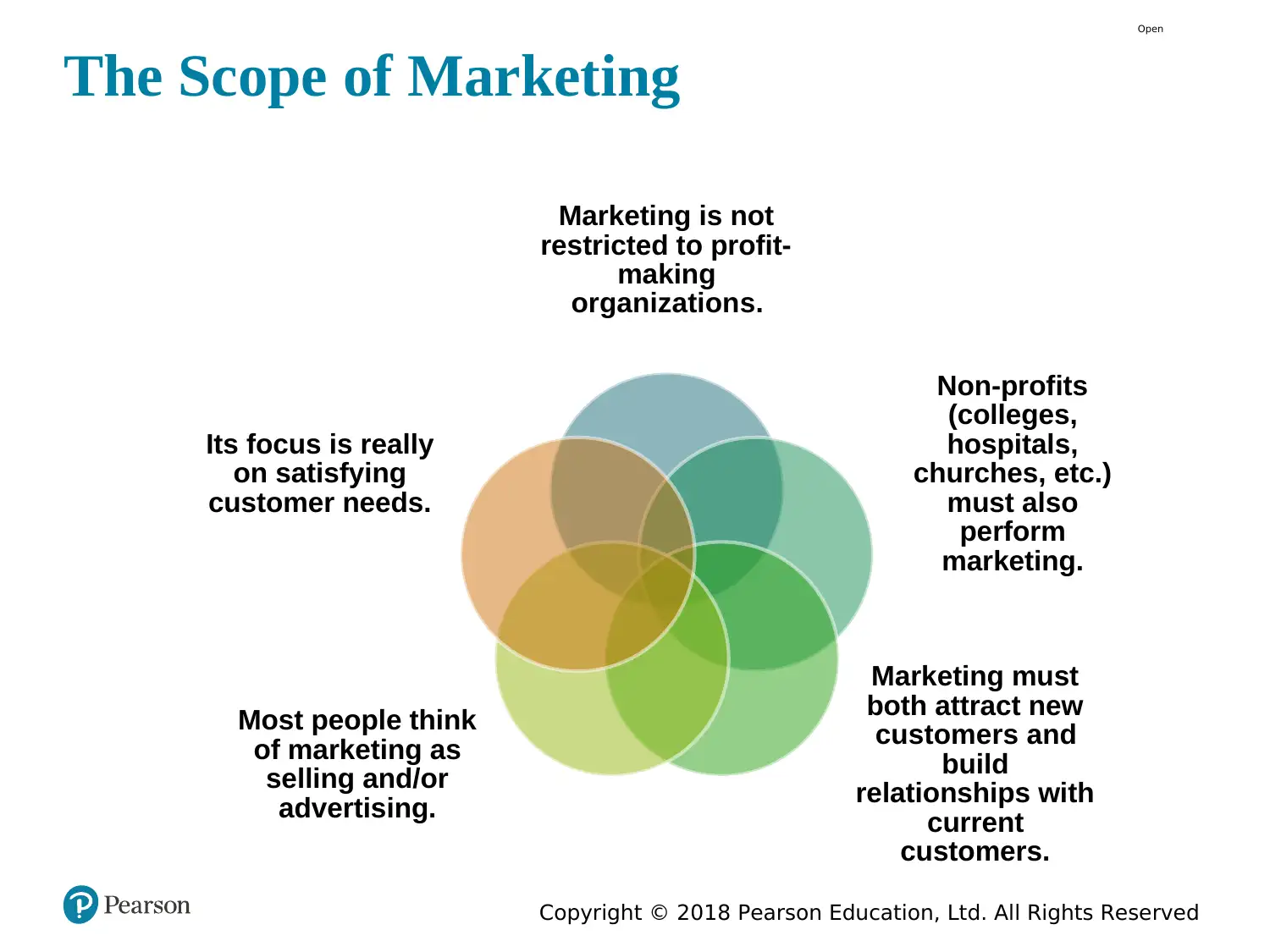
Copyright © 2018 Pearson Education, Ltd. All Rights Reserved
Open
8
The Scope of Marketing
Marketing is not
restricted to profit-
making
organizations.
Non-profits
(colleges,
hospitals,
churches, etc.)
must also
perform
marketing.
Marketing must
both attract new
customers and
build
relationships with
current
customers.
Most people think
of marketing as
selling and/or
advertising.
Its focus is really
on satisfying
customer needs.
Open
8
The Scope of Marketing
Marketing is not
restricted to profit-
making
organizations.
Non-profits
(colleges,
hospitals,
churches, etc.)
must also
perform
marketing.
Marketing must
both attract new
customers and
build
relationships with
current
customers.
Most people think
of marketing as
selling and/or
advertising.
Its focus is really
on satisfying
customer needs.
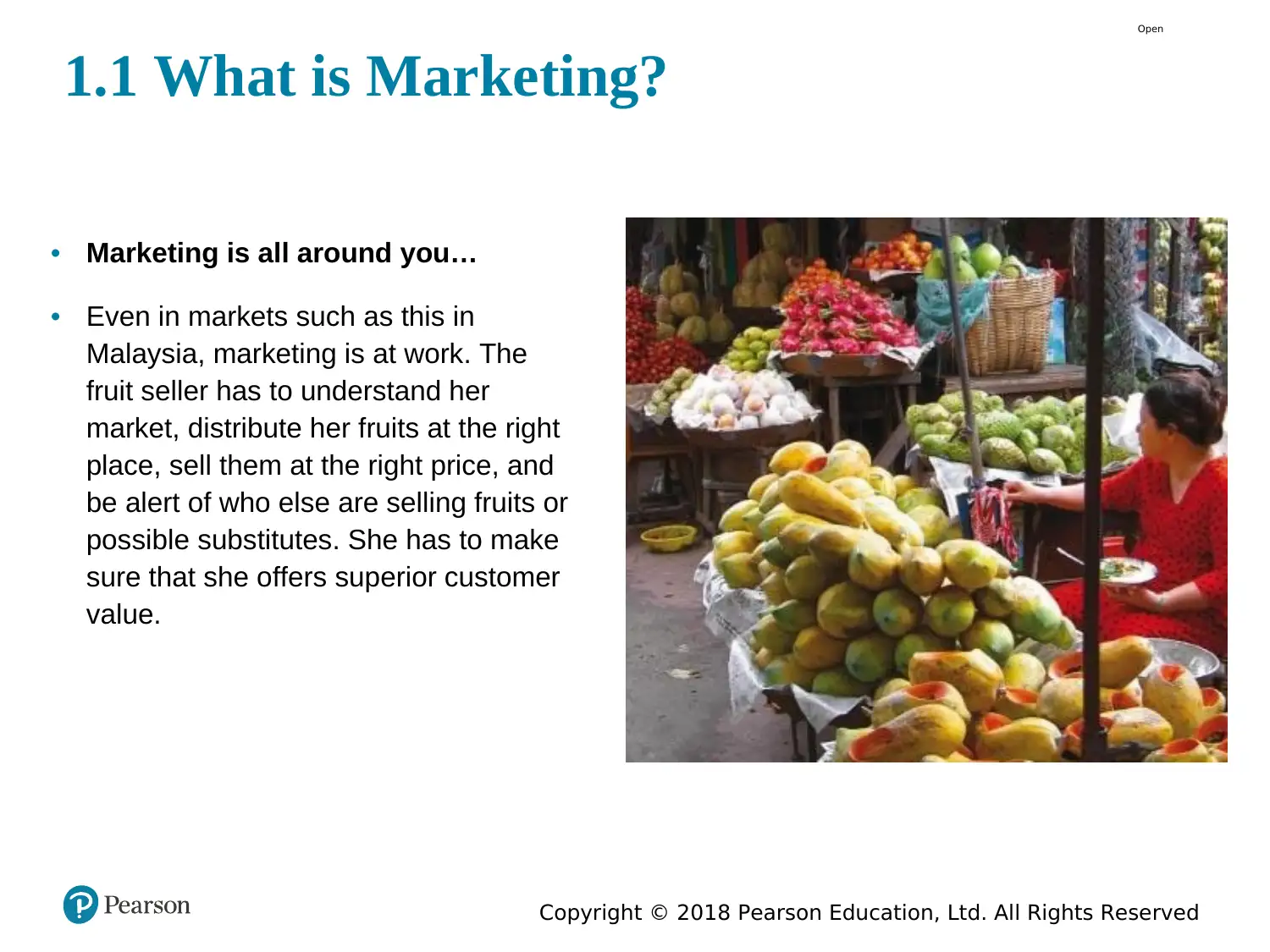
Copyright © 2018 Pearson Education, Ltd. All Rights Reserved
Open
9
1.1 What is Marketing?
• Marketing is all around you…
• Even in markets such as this in
Malaysia, marketing is at work. The
fruit seller has to understand her
market, distribute her fruits at the right
place, sell them at the right price, and
be alert of who else are selling fruits or
possible substitutes. She has to make
sure that she offers superior customer
value.
Open
9
1.1 What is Marketing?
• Marketing is all around you…
• Even in markets such as this in
Malaysia, marketing is at work. The
fruit seller has to understand her
market, distribute her fruits at the right
place, sell them at the right price, and
be alert of who else are selling fruits or
possible substitutes. She has to make
sure that she offers superior customer
value.
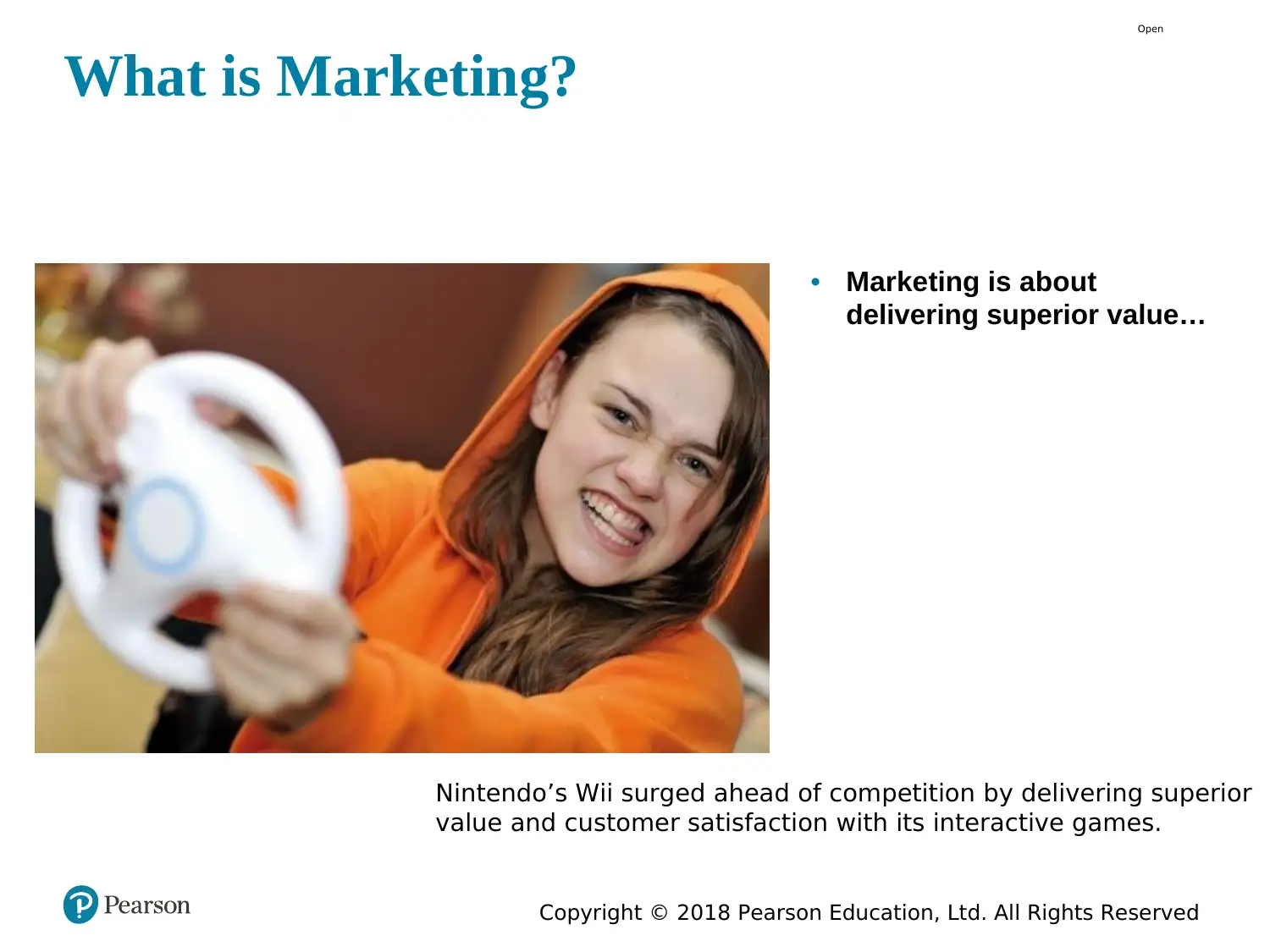
Copyright © 2018 Pearson Education, Ltd. All Rights Reserved
10
What is Marketing?
• Marketing is about
delivering superior value…
Open
Nintendo’s Wii surged ahead of competition by delivering superior
value and customer satisfaction with its interactive games.
10
What is Marketing?
• Marketing is about
delivering superior value…
Open
Nintendo’s Wii surged ahead of competition by delivering superior
value and customer satisfaction with its interactive games.
Secure Best Marks with AI Grader
Need help grading? Try our AI Grader for instant feedback on your assignments.
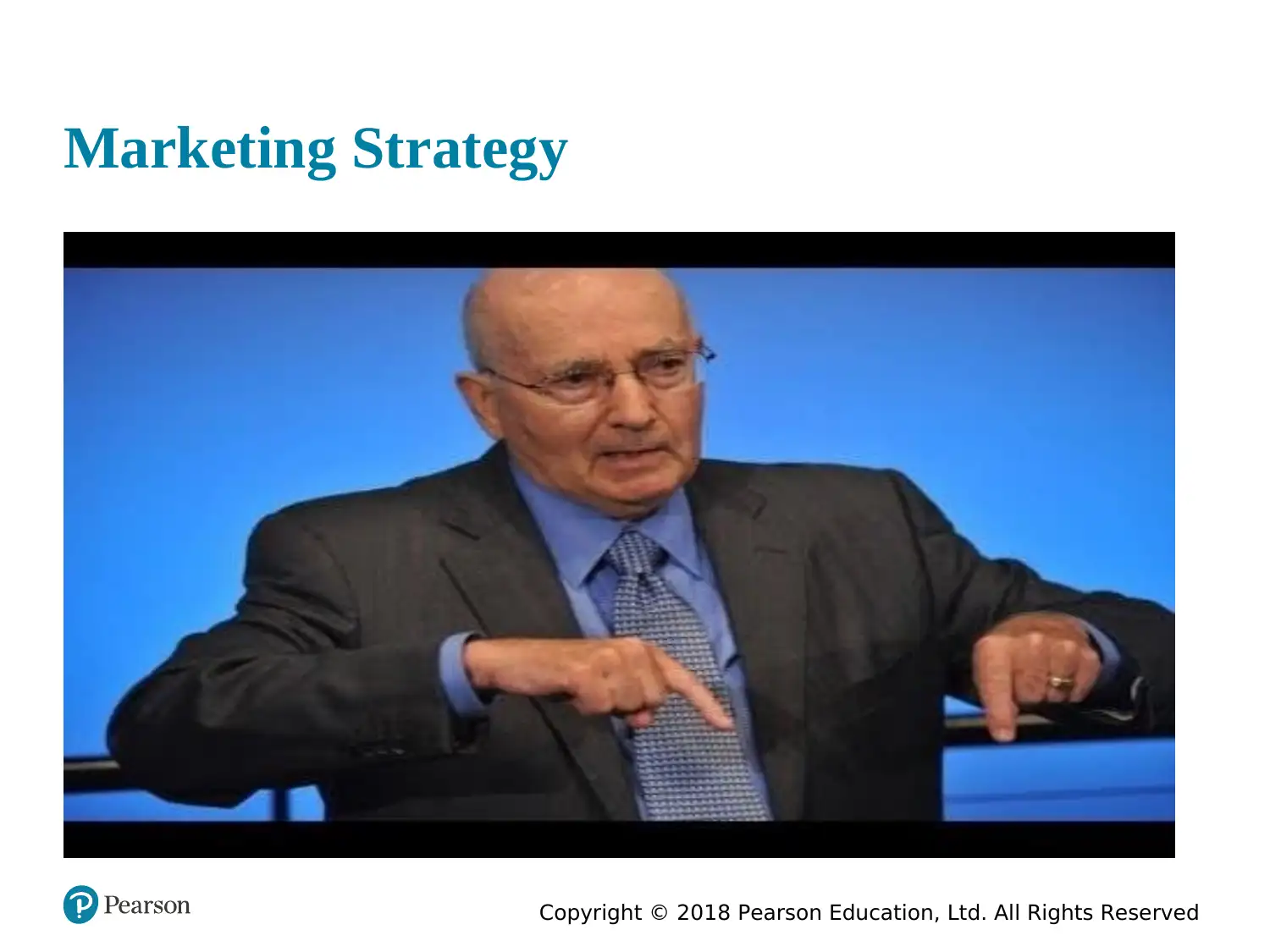
Copyright © 2018 Pearson Education, Ltd. All Rights Reserved
Marketing Strategy
Marketing Strategy
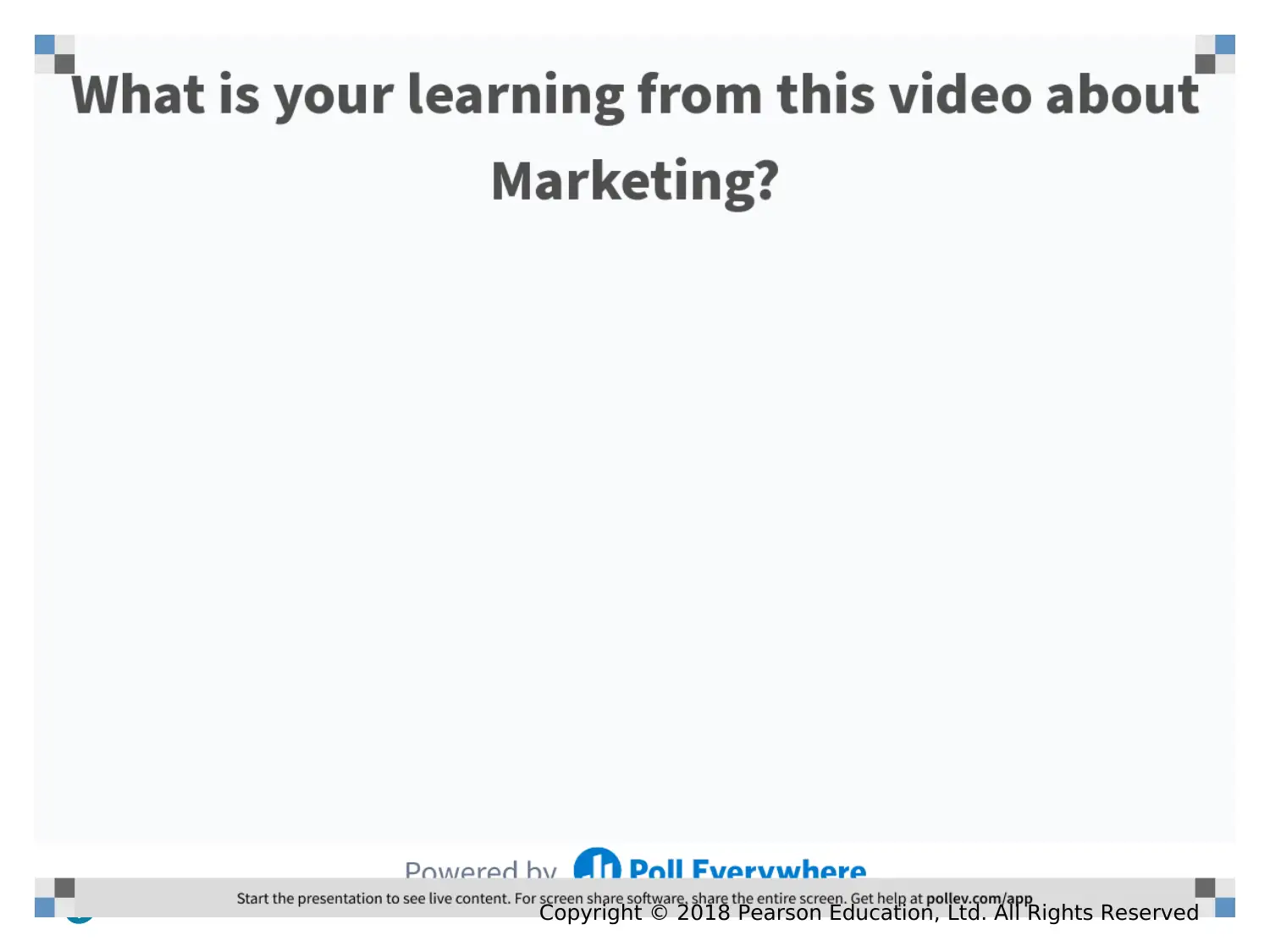
Copyright © 2018 Pearson Education, Ltd. All Rights Reserved
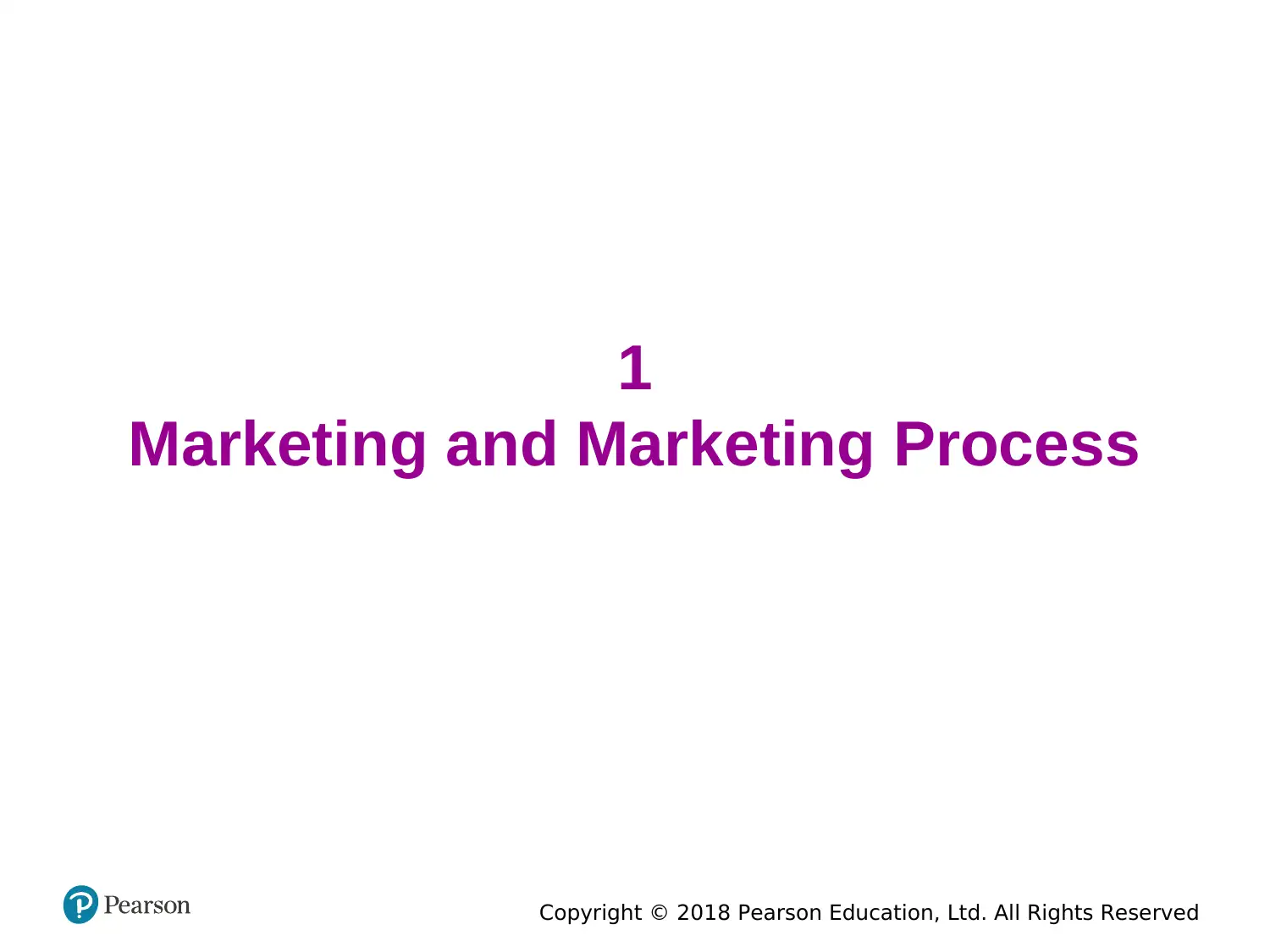
Copyright © 2018 Pearson Education, Ltd. All Rights Reserved
1
Marketing and Marketing Process
1
Marketing and Marketing Process
Paraphrase This Document
Need a fresh take? Get an instant paraphrase of this document with our AI Paraphraser
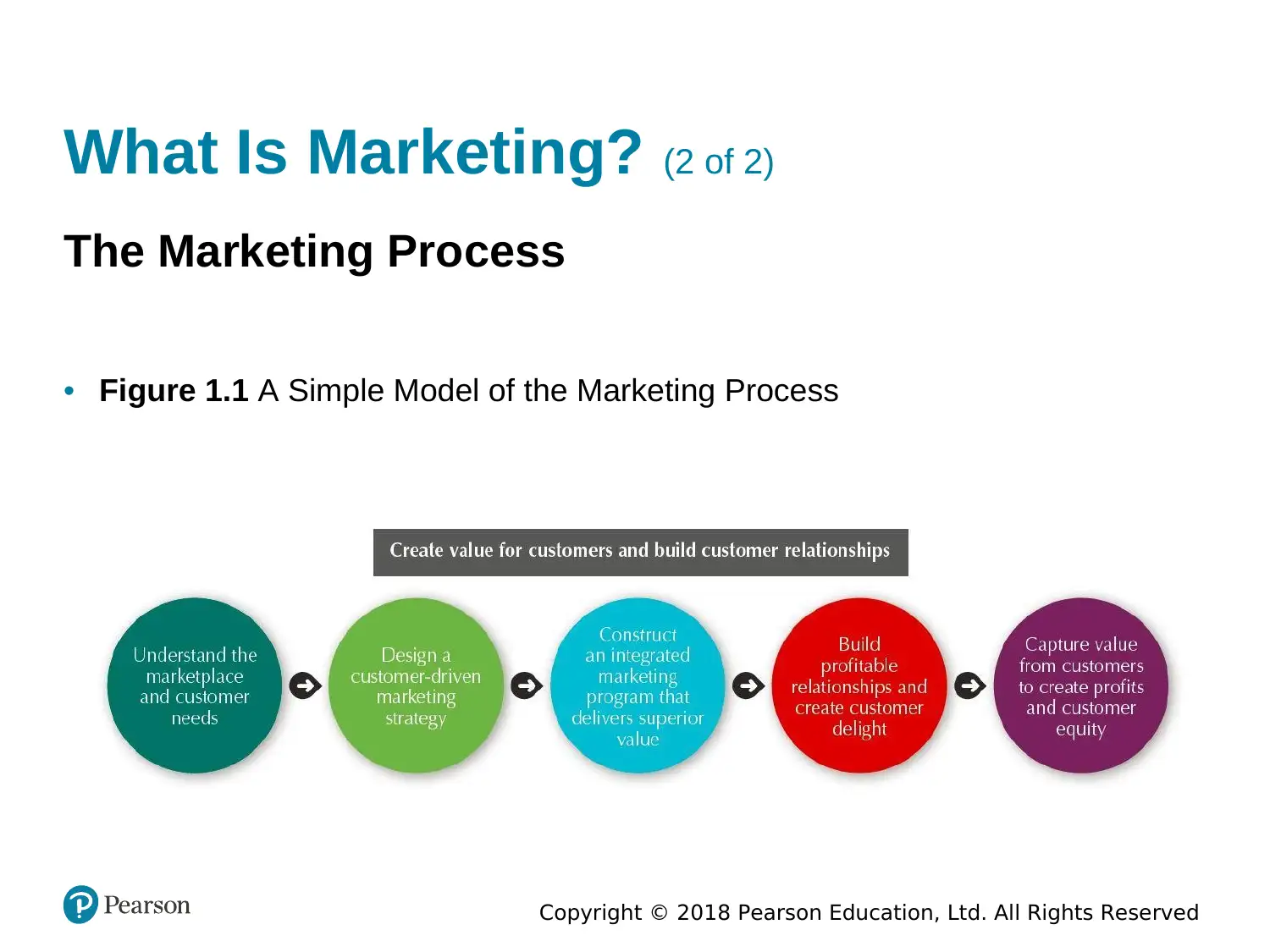
Copyright © 2018 Pearson Education, Ltd. All Rights Reserved
What Is Marketing? (2 of 2)
The Marketing Process
• Figure 1.1 A Simple Model of the Marketing Process
What Is Marketing? (2 of 2)
The Marketing Process
• Figure 1.1 A Simple Model of the Marketing Process
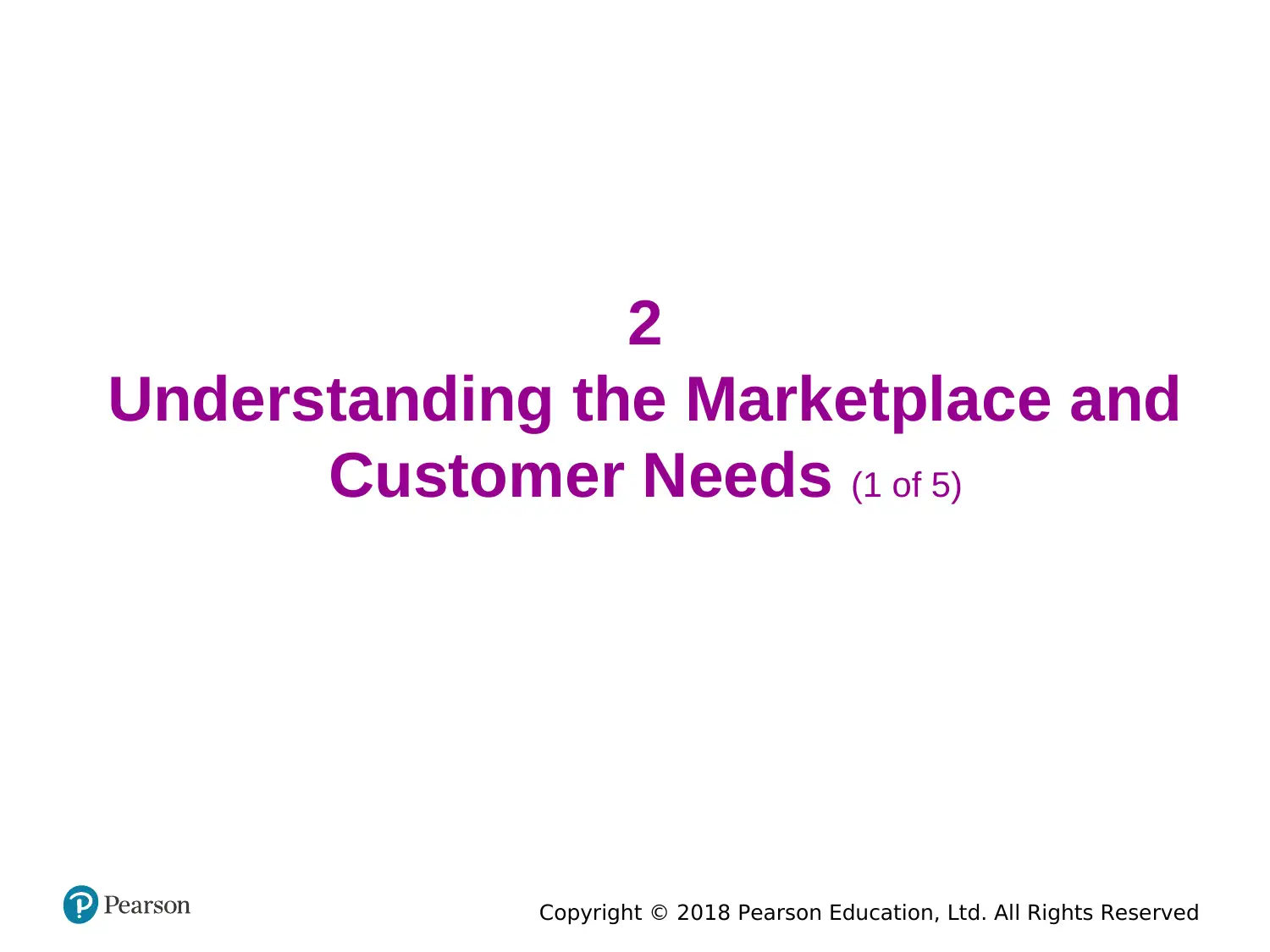
Copyright © 2018 Pearson Education, Ltd. All Rights Reserved
2
Understanding the Marketplace and
Customer Needs (1 of 5)
2
Understanding the Marketplace and
Customer Needs (1 of 5)
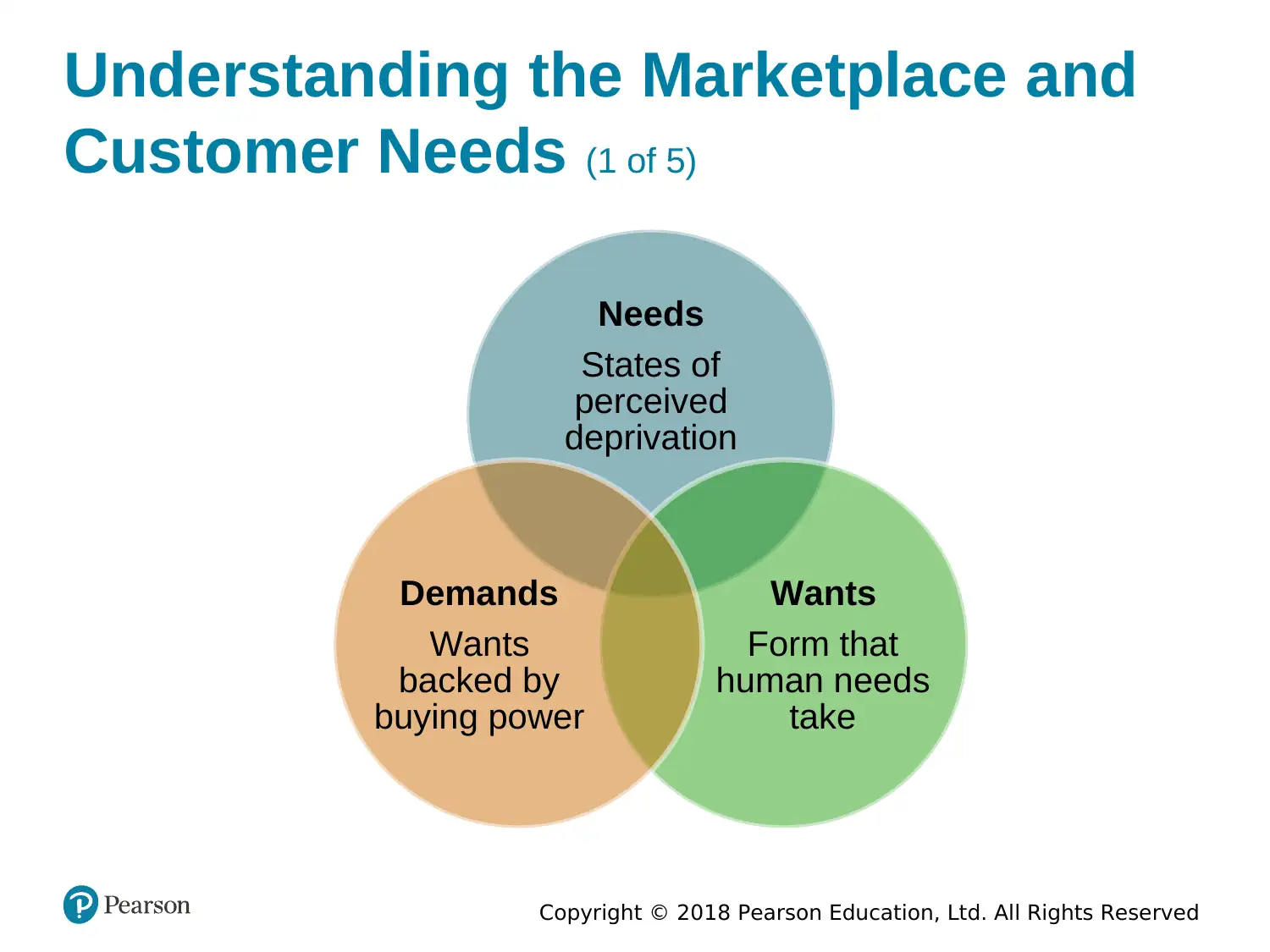
Copyright © 2018 Pearson Education, Ltd. All Rights Reserved
Understanding the Marketplace and
Customer Needs (1 of 5)
Needs
States of
perceived
deprivation
Wants
Form that
human needs
take
Demands
Wants
backed by
buying power
Understanding the Marketplace and
Customer Needs (1 of 5)
Needs
States of
perceived
deprivation
Wants
Form that
human needs
take
Demands
Wants
backed by
buying power
Secure Best Marks with AI Grader
Need help grading? Try our AI Grader for instant feedback on your assignments.
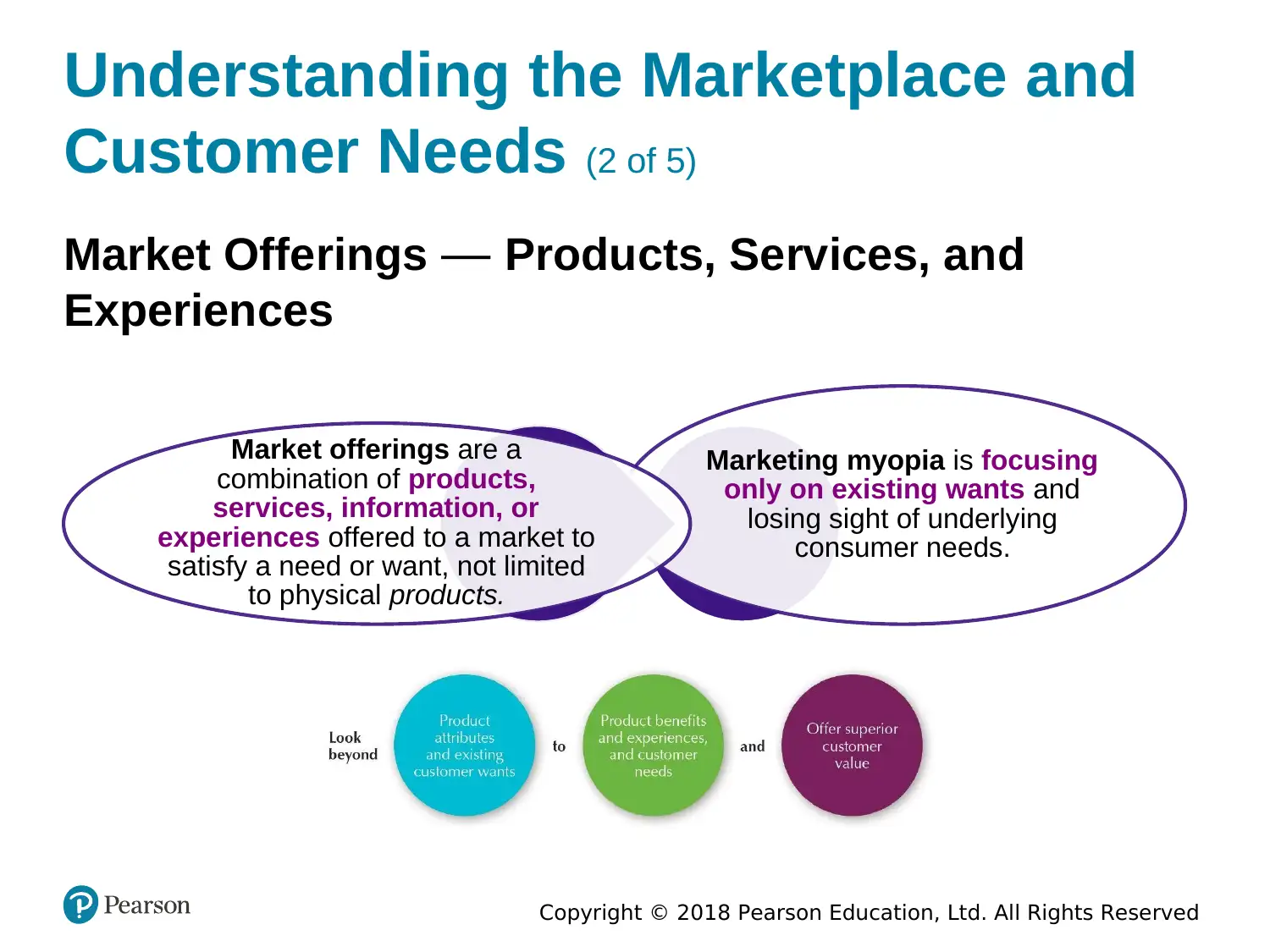
Copyright © 2018 Pearson Education, Ltd. All Rights Reserved
Understanding the Marketplace and
Customer Needs (2 of 5)
Market Offerings — Products, Services, and
Experiences
Marketing myopia is focusing
only on existing wants and
losing sight of underlying
consumer needs.
Market offerings are a
combination of products,
services, information, or
experiences offered to a market to
satisfy a need or want, not limited
to physical products.
Understanding the Marketplace and
Customer Needs (2 of 5)
Market Offerings — Products, Services, and
Experiences
Marketing myopia is focusing
only on existing wants and
losing sight of underlying
consumer needs.
Market offerings are a
combination of products,
services, information, or
experiences offered to a market to
satisfy a need or want, not limited
to physical products.
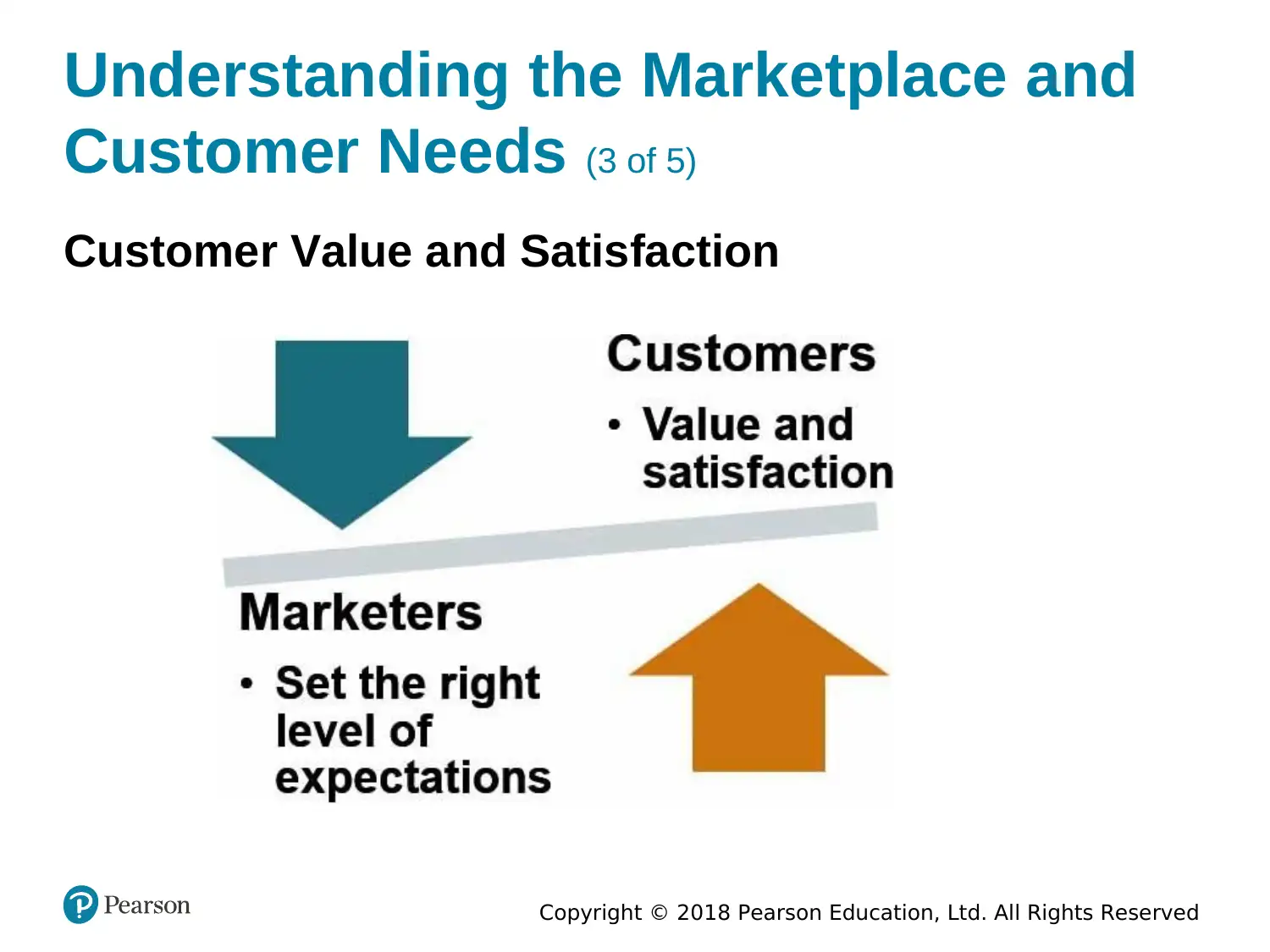
Copyright © 2018 Pearson Education, Ltd. All Rights Reserved
Understanding the Marketplace and
Customer Needs (3 of 5)
Customer Value and Satisfaction
Understanding the Marketplace and
Customer Needs (3 of 5)
Customer Value and Satisfaction
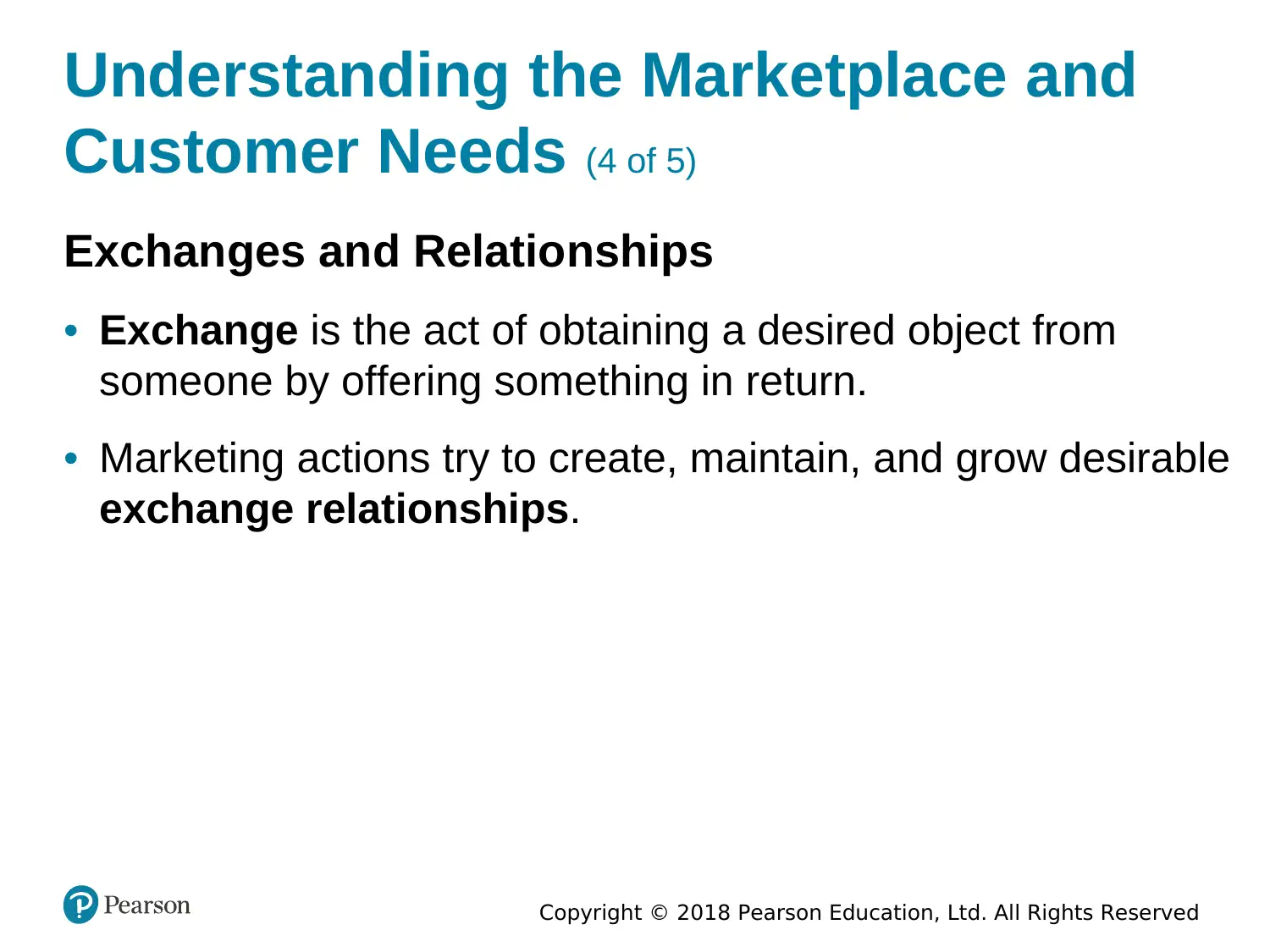
Copyright © 2018 Pearson Education, Ltd. All Rights Reserved
Understanding the Marketplace and
Customer Needs (4 of 5)
Exchanges and Relationships
• Exchange is the act of obtaining a desired object from
someone by offering something in return.
• Marketing actions try to create, maintain, and grow desirable
exchange relationships.
Understanding the Marketplace and
Customer Needs (4 of 5)
Exchanges and Relationships
• Exchange is the act of obtaining a desired object from
someone by offering something in return.
• Marketing actions try to create, maintain, and grow desirable
exchange relationships.
Paraphrase This Document
Need a fresh take? Get an instant paraphrase of this document with our AI Paraphraser
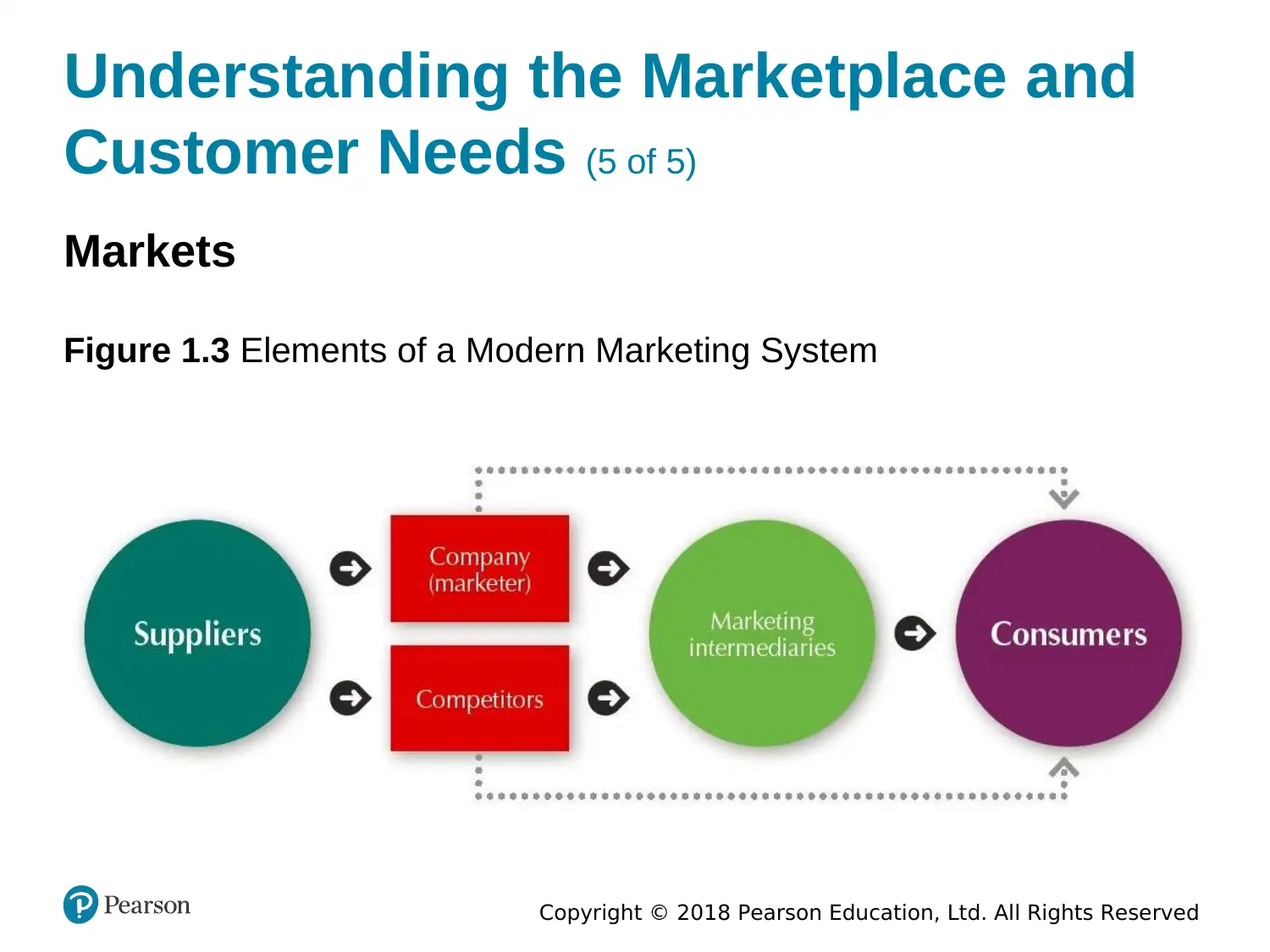
Copyright © 2018 Pearson Education, Ltd. All Rights Reserved
Understanding the Marketplace and
Customer Needs (5 of 5)
Markets
Figure 1.3 Elements of a Modern Marketing System
Understanding the Marketplace and
Customer Needs (5 of 5)
Markets
Figure 1.3 Elements of a Modern Marketing System
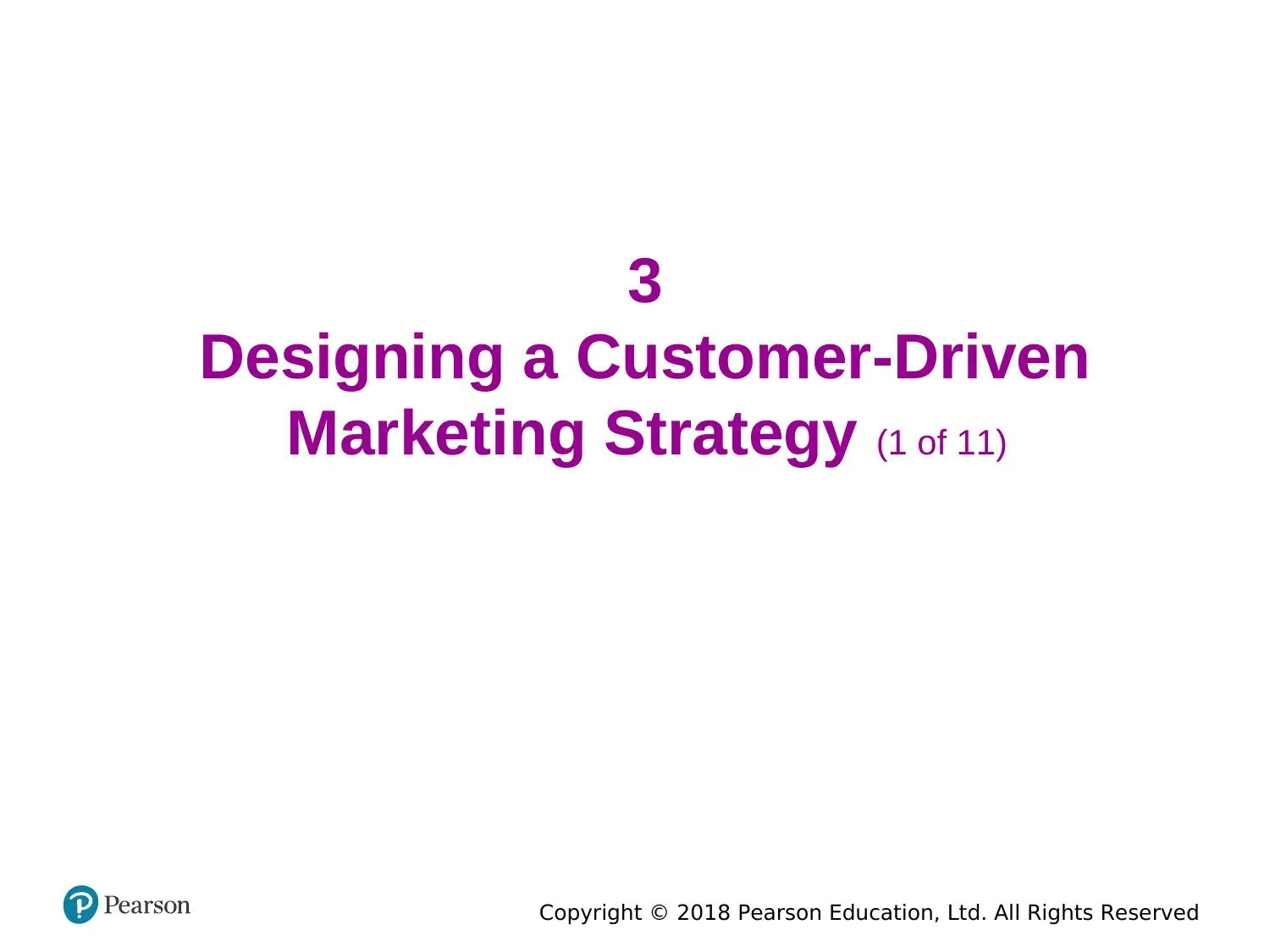
Copyright © 2018 Pearson Education, Ltd. All Rights Reserved
3
Designing a Customer-Driven
Marketing Strategy (1 of 11)
3
Designing a Customer-Driven
Marketing Strategy (1 of 11)
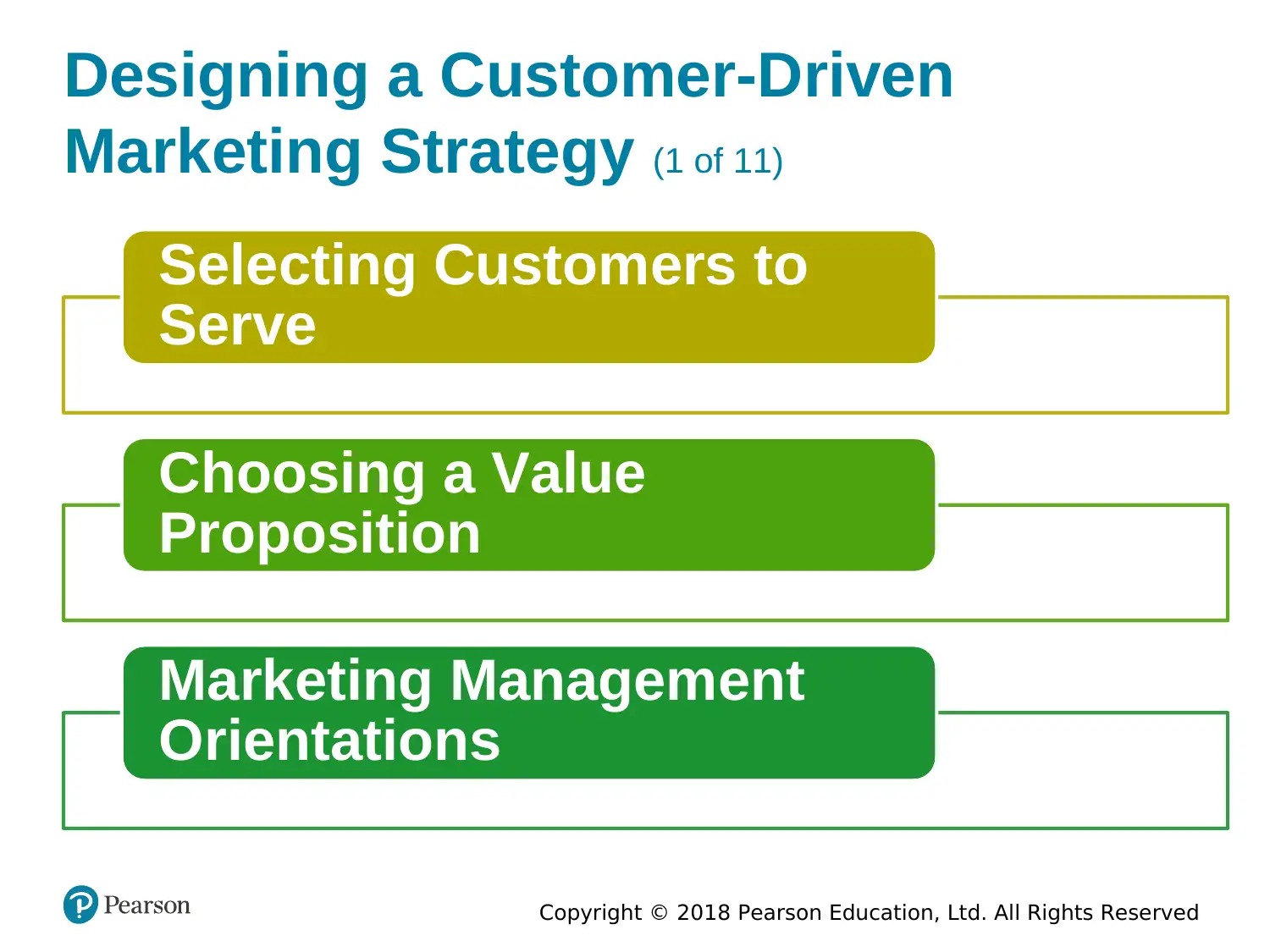
Copyright © 2018 Pearson Education, Ltd. All Rights Reserved
Designing a Customer-Driven
Marketing Strategy (1 of 11)
Selecting Customers to
Serve
Choosing a Value
Proposition
Marketing Management
Orientations
Designing a Customer-Driven
Marketing Strategy (1 of 11)
Selecting Customers to
Serve
Choosing a Value
Proposition
Marketing Management
Orientations
Secure Best Marks with AI Grader
Need help grading? Try our AI Grader for instant feedback on your assignments.
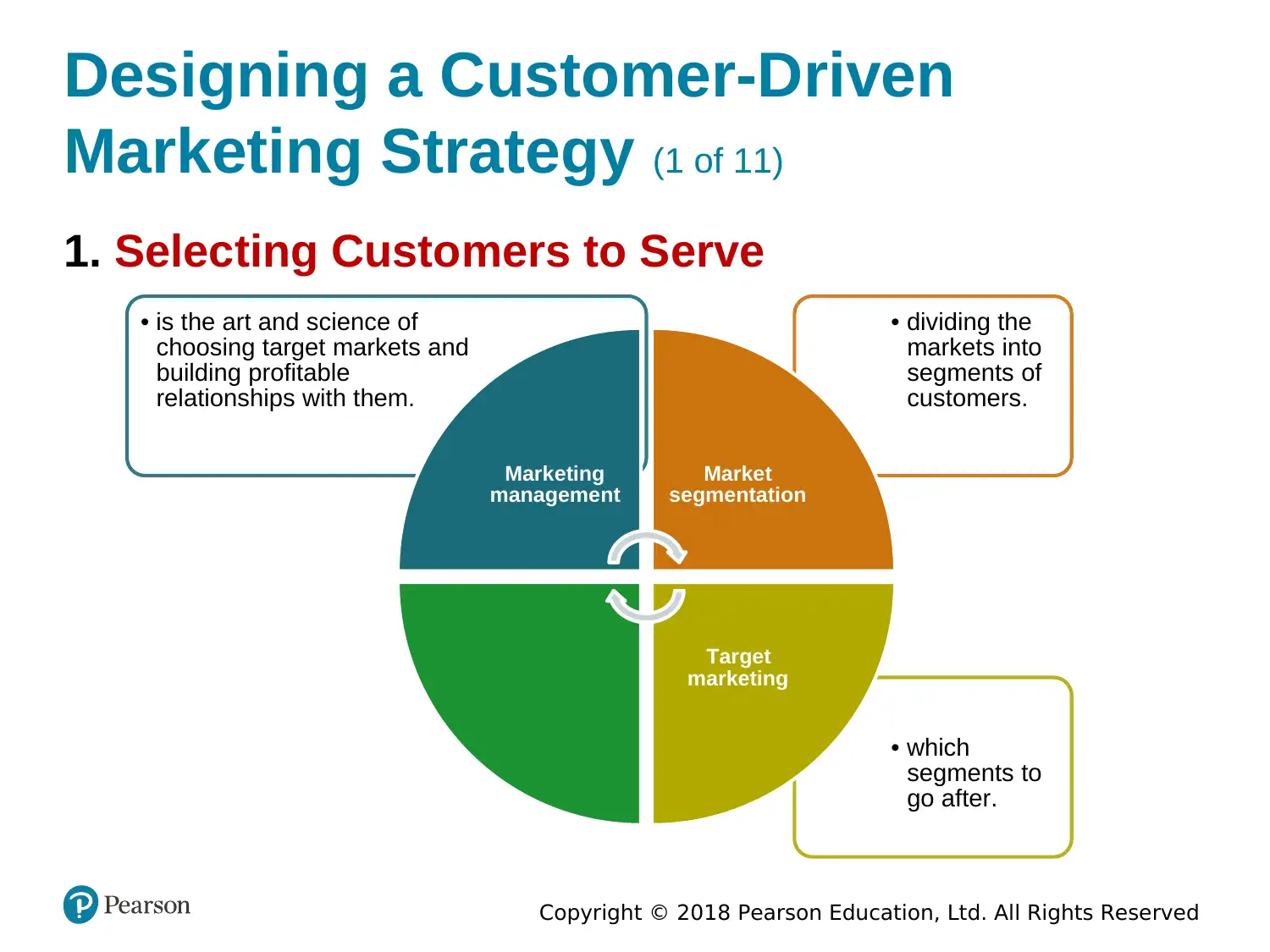
Copyright © 2018 Pearson Education, Ltd. All Rights Reserved
Designing a Customer-Driven
Marketing Strategy (1 of 11)
1. Selecting Customers to Serve
• which
segments to
go after.
• dividing the
markets into
segments of
customers.
• is the art and science of
choosing target markets and
building profitable
relationships with them.
Marketing
management
Market
segmentation
Target
marketing
Designing a Customer-Driven
Marketing Strategy (1 of 11)
1. Selecting Customers to Serve
• which
segments to
go after.
• dividing the
markets into
segments of
customers.
• is the art and science of
choosing target markets and
building profitable
relationships with them.
Marketing
management
Market
segmentation
Target
marketing
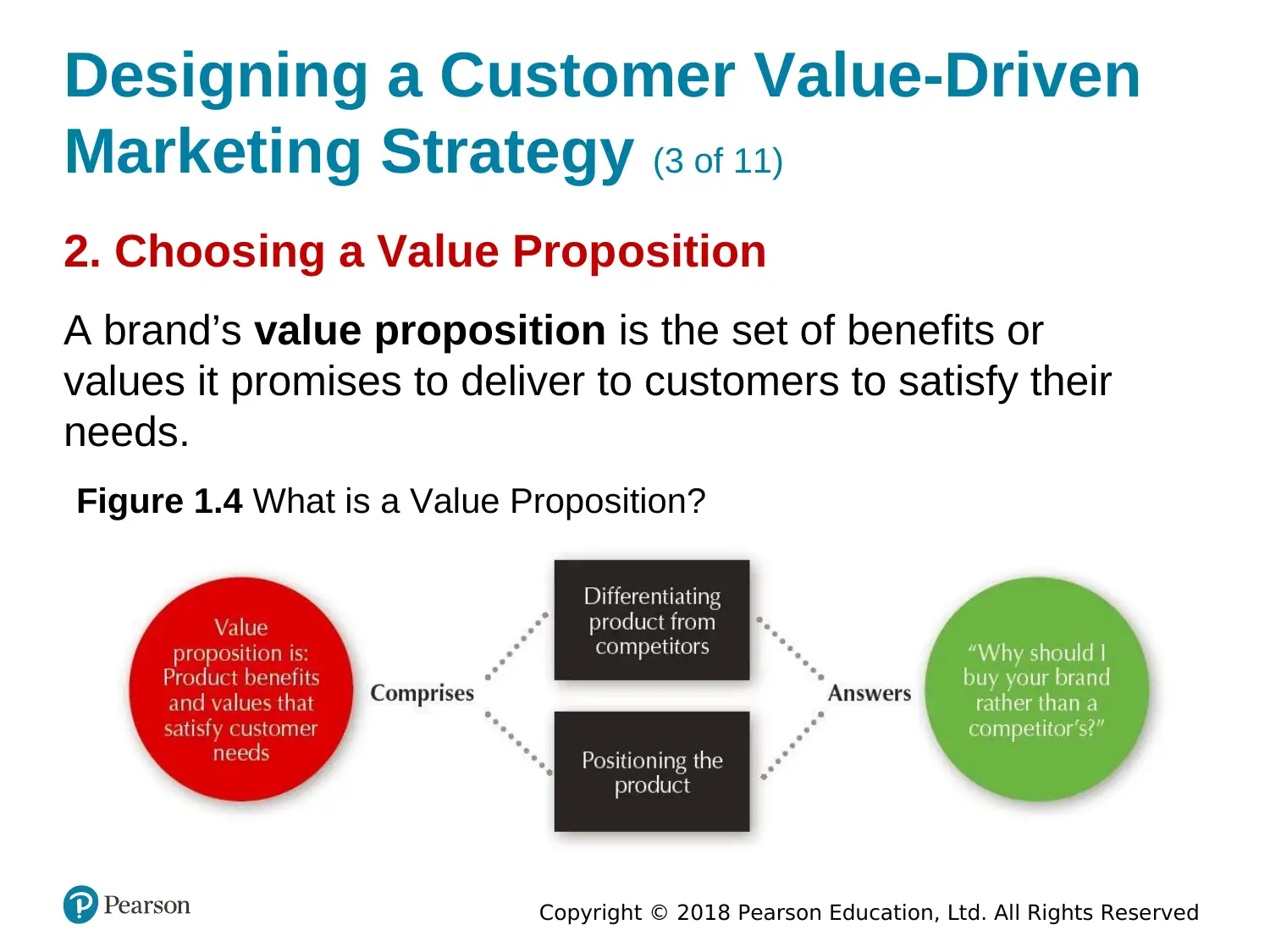
Copyright © 2018 Pearson Education, Ltd. All Rights Reserved
Designing a Customer Value-Driven
Marketing Strategy (3 of 11)
2. Choosing a Value Proposition
A brand’s value proposition is the set of benefits or
values it promises to deliver to customers to satisfy their
needs.
Figure 1.4 What is a Value Proposition?
Designing a Customer Value-Driven
Marketing Strategy (3 of 11)
2. Choosing a Value Proposition
A brand’s value proposition is the set of benefits or
values it promises to deliver to customers to satisfy their
needs.
Figure 1.4 What is a Value Proposition?
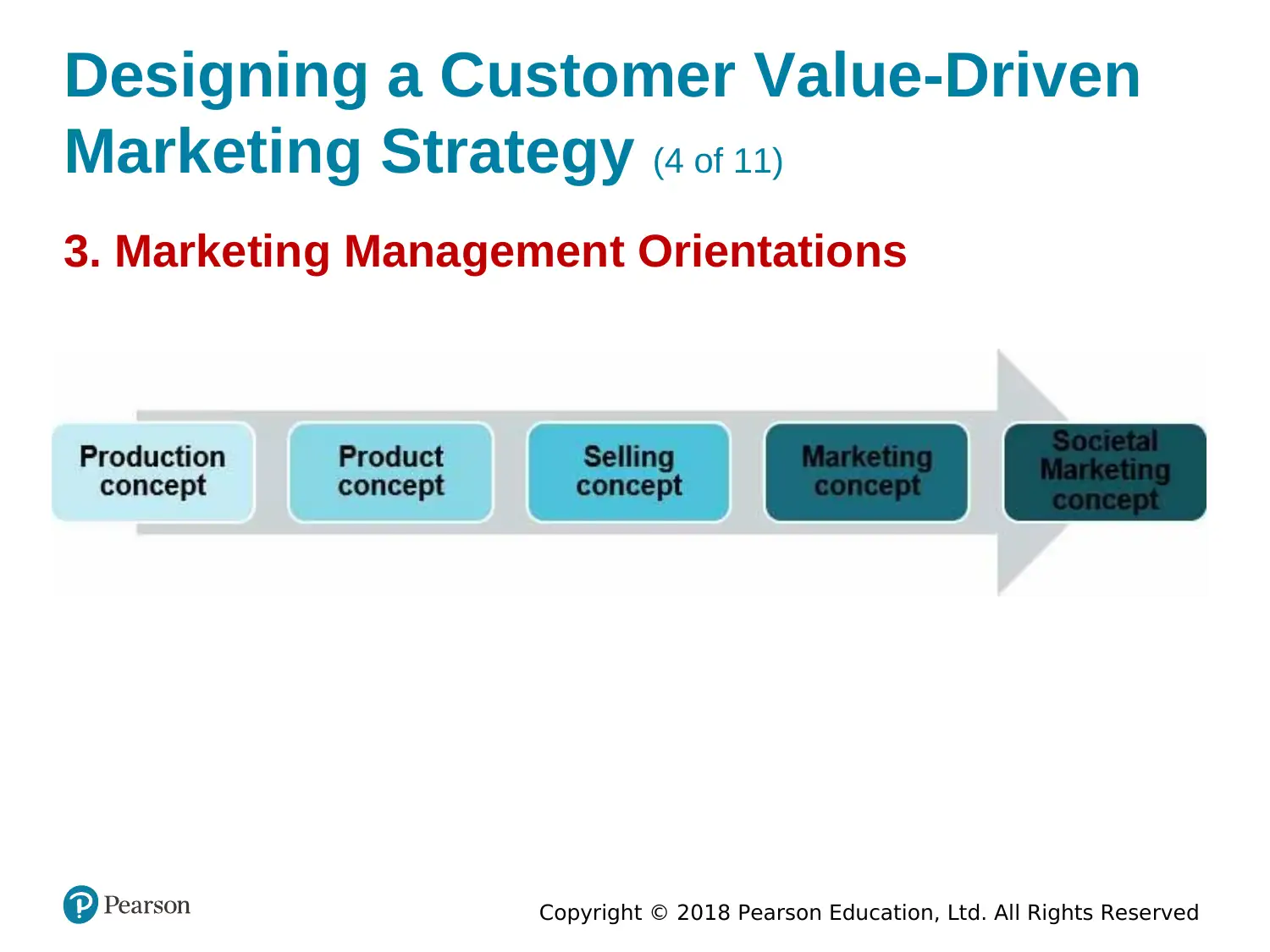
Copyright © 2018 Pearson Education, Ltd. All Rights Reserved
Designing a Customer Value-Driven
Marketing Strategy (4 of 11)
3. Marketing Management Orientations
Designing a Customer Value-Driven
Marketing Strategy (4 of 11)
3. Marketing Management Orientations
Paraphrase This Document
Need a fresh take? Get an instant paraphrase of this document with our AI Paraphraser
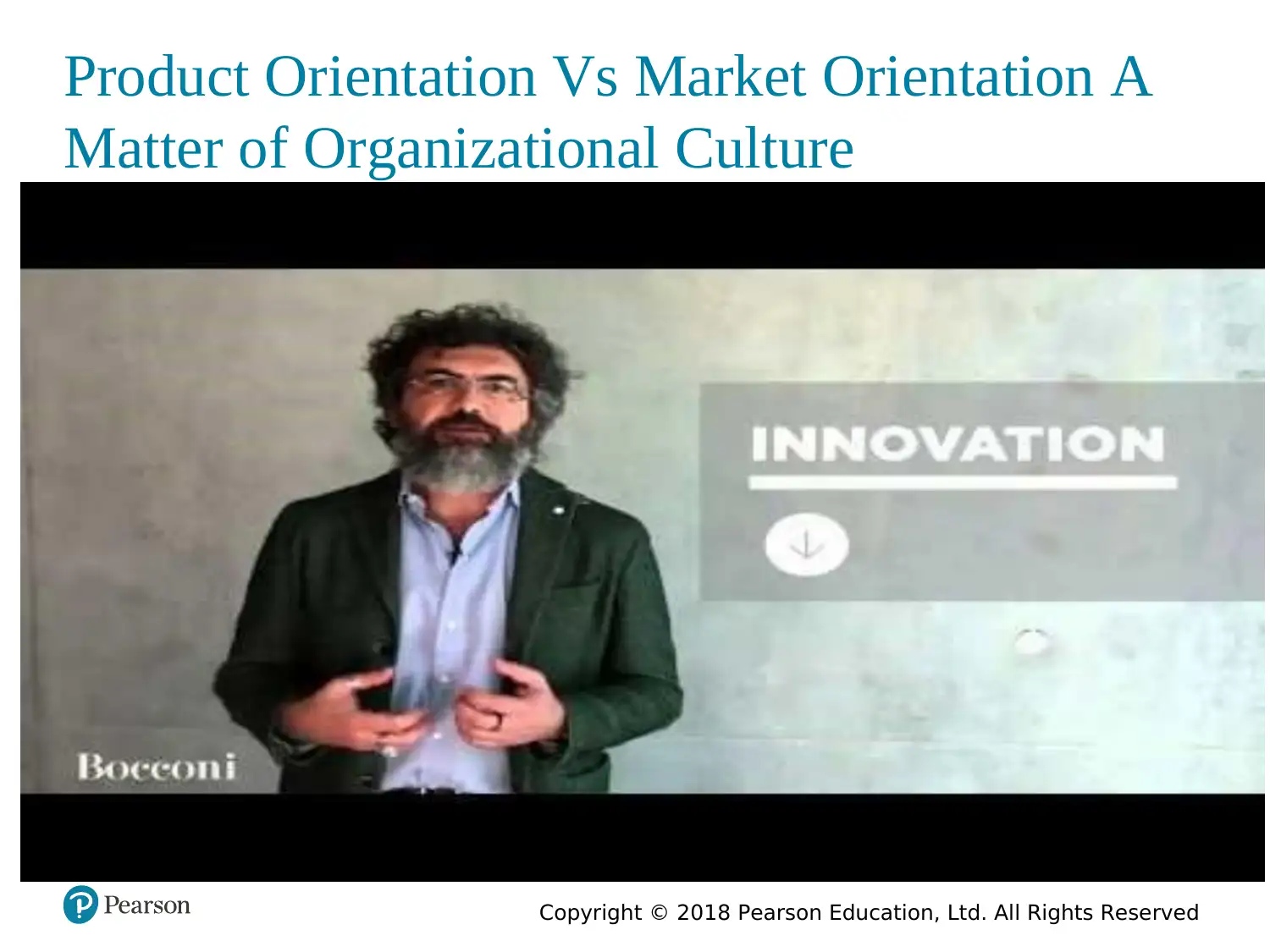
Copyright © 2018 Pearson Education, Ltd. All Rights Reserved
Product Orientation Vs Market Orientation A
Matter of Organizational Culture
Product Orientation Vs Market Orientation A
Matter of Organizational Culture
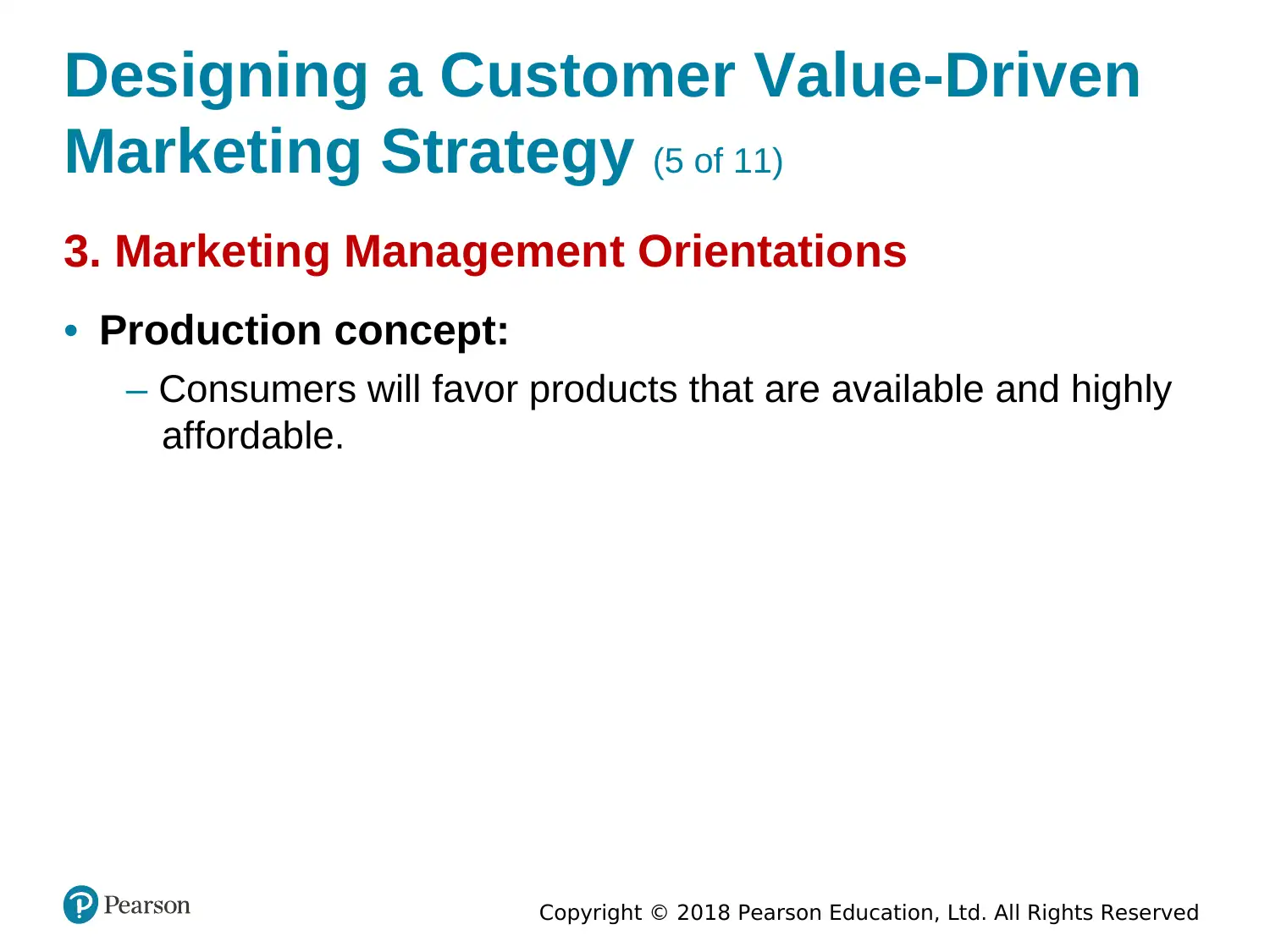
Copyright © 2018 Pearson Education, Ltd. All Rights Reserved
Designing a Customer Value-Driven
Marketing Strategy (5 of 11)
3. Marketing Management Orientations
• Production concept:
– Consumers will favor products that are available and highly
affordable.
Designing a Customer Value-Driven
Marketing Strategy (5 of 11)
3. Marketing Management Orientations
• Production concept:
– Consumers will favor products that are available and highly
affordable.
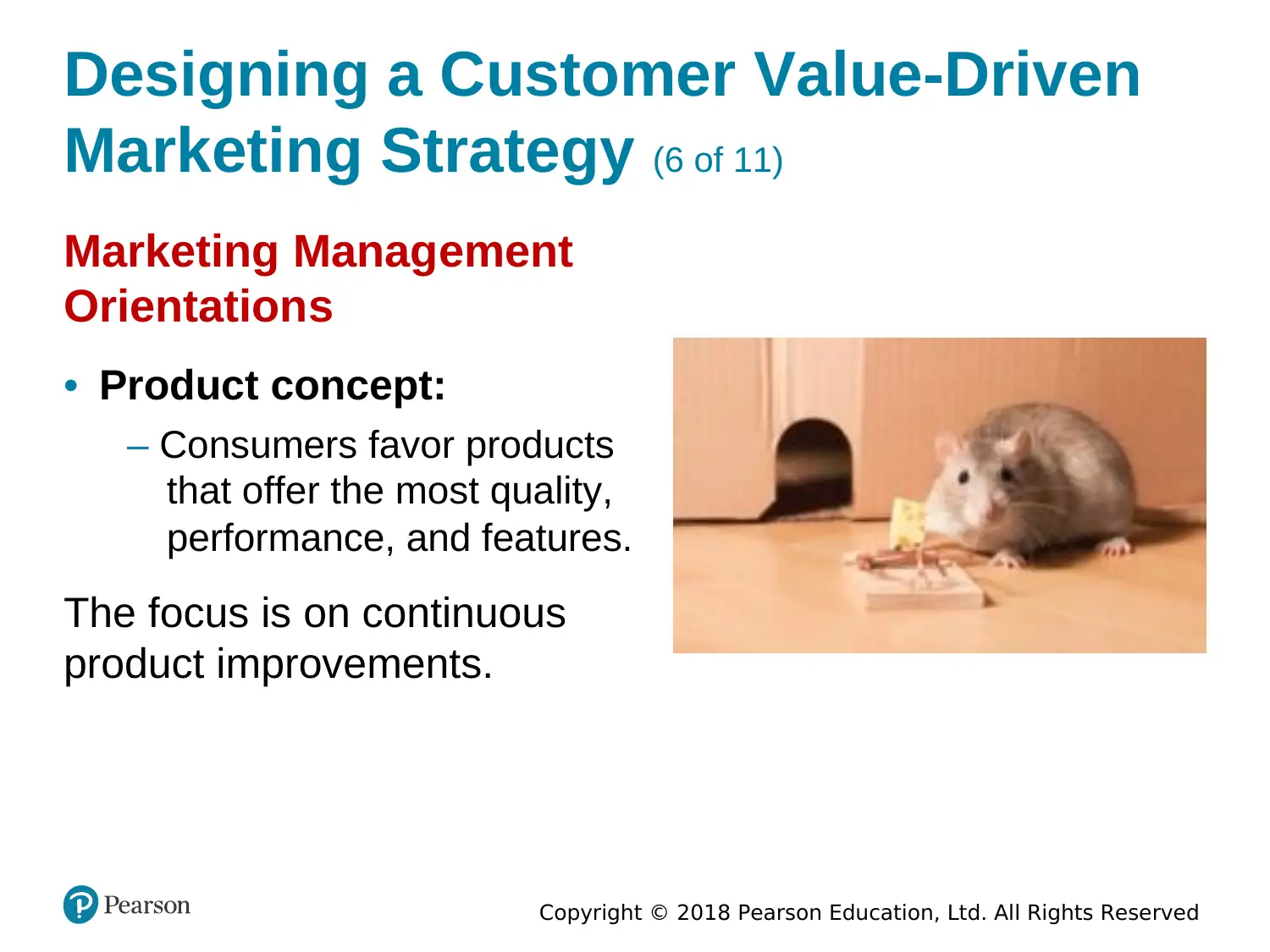
Copyright © 2018 Pearson Education, Ltd. All Rights Reserved
Designing a Customer Value-Driven
Marketing Strategy (6 of 11)
Marketing Management
Orientations
• Product concept:
– Consumers favor products
that offer the most quality,
performance, and features.
The focus is on continuous
product improvements.
Designing a Customer Value-Driven
Marketing Strategy (6 of 11)
Marketing Management
Orientations
• Product concept:
– Consumers favor products
that offer the most quality,
performance, and features.
The focus is on continuous
product improvements.
Secure Best Marks with AI Grader
Need help grading? Try our AI Grader for instant feedback on your assignments.
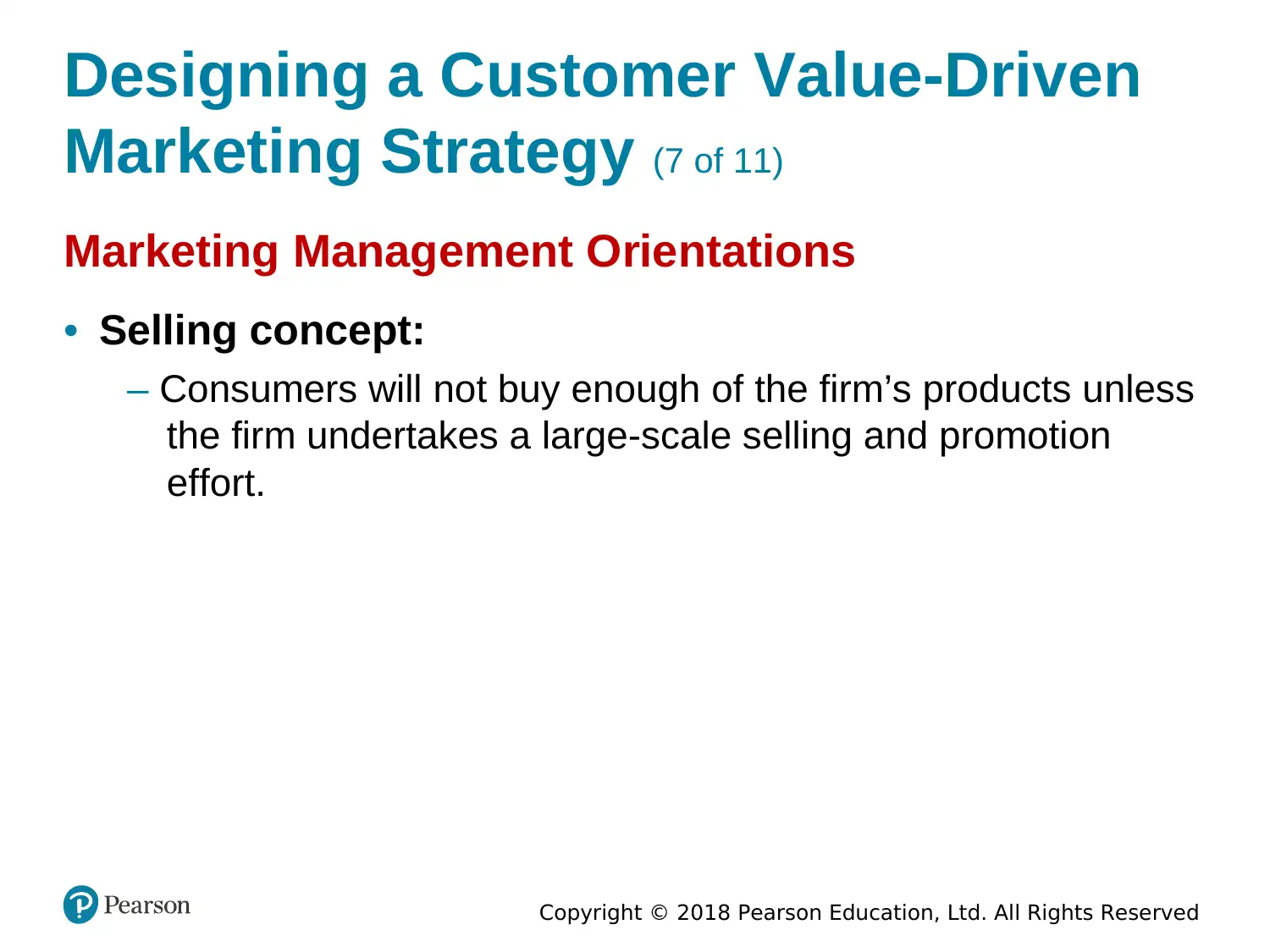
Copyright © 2018 Pearson Education, Ltd. All Rights Reserved
Designing a Customer Value-Driven
Marketing Strategy (7 of 11)
Marketing Management Orientations
• Selling concept:
– Consumers will not buy enough of the firm’s products unless
the firm undertakes a large-scale selling and promotion
effort.
Designing a Customer Value-Driven
Marketing Strategy (7 of 11)
Marketing Management Orientations
• Selling concept:
– Consumers will not buy enough of the firm’s products unless
the firm undertakes a large-scale selling and promotion
effort.
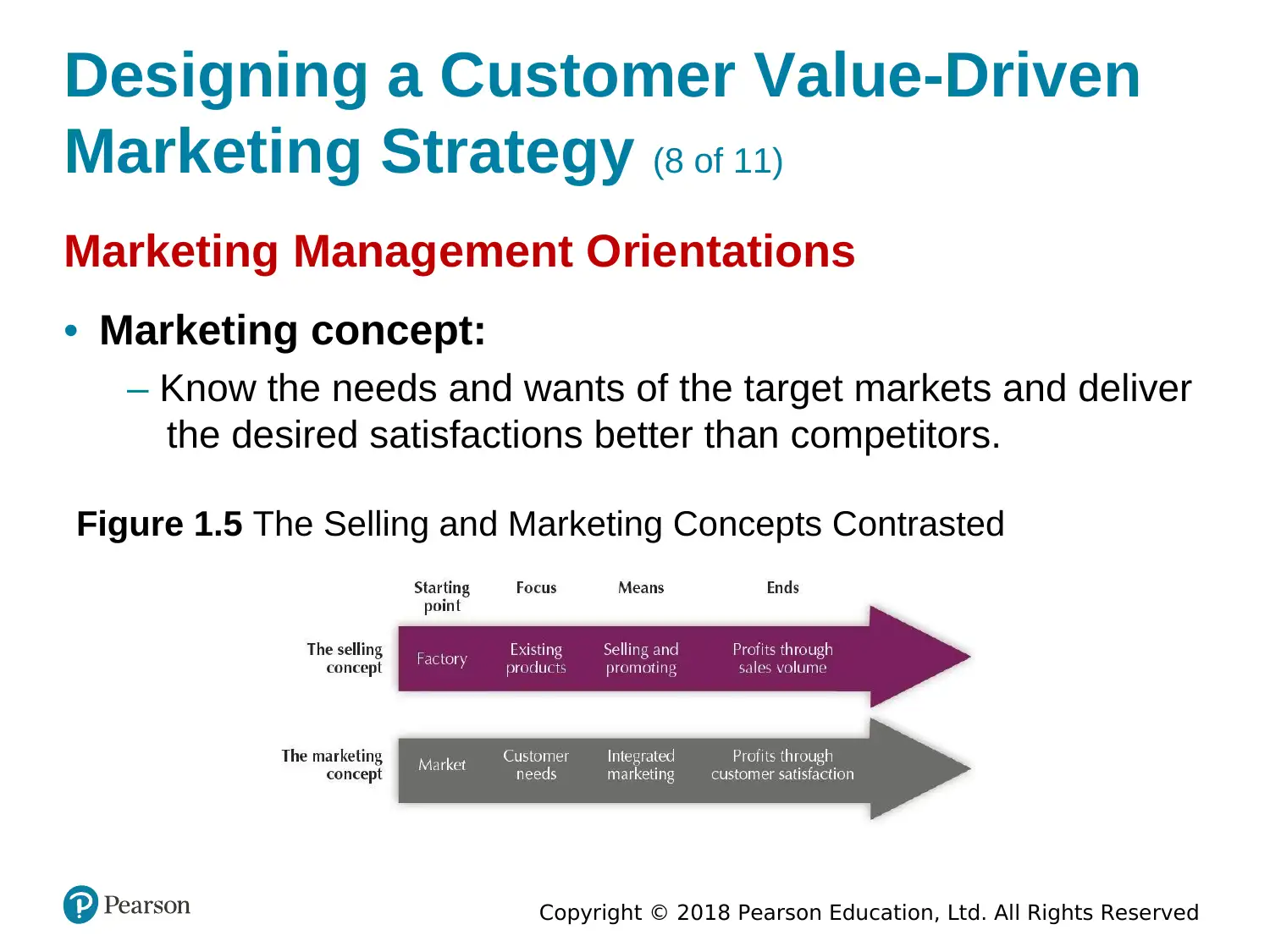
Copyright © 2018 Pearson Education, Ltd. All Rights Reserved
Designing a Customer Value-Driven
Marketing Strategy (8 of 11)
Marketing Management Orientations
• Marketing concept:
– Know the needs and wants of the target markets and deliver
the desired satisfactions better than competitors.
Figure 1.5 The Selling and Marketing Concepts Contrasted
Designing a Customer Value-Driven
Marketing Strategy (8 of 11)
Marketing Management Orientations
• Marketing concept:
– Know the needs and wants of the target markets and deliver
the desired satisfactions better than competitors.
Figure 1.5 The Selling and Marketing Concepts Contrasted
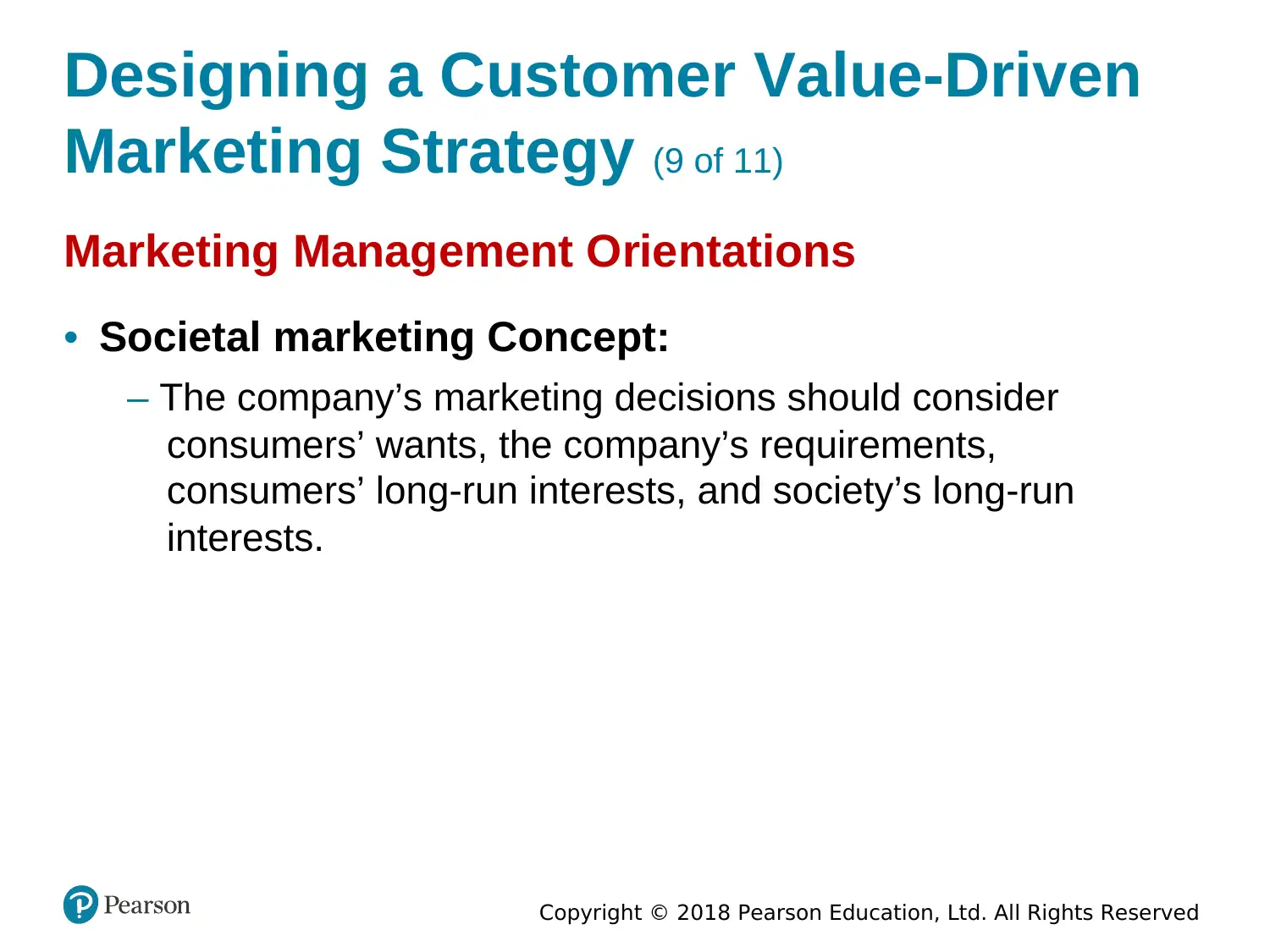
Copyright © 2018 Pearson Education, Ltd. All Rights Reserved
Designing a Customer Value-Driven
Marketing Strategy (9 of 11)
Marketing Management Orientations
• Societal marketing Concept:
– The company’s marketing decisions should consider
consumers’ wants, the company’s requirements,
consumers’ long-run interests, and society’s long-run
interests.
Designing a Customer Value-Driven
Marketing Strategy (9 of 11)
Marketing Management Orientations
• Societal marketing Concept:
– The company’s marketing decisions should consider
consumers’ wants, the company’s requirements,
consumers’ long-run interests, and society’s long-run
interests.
Paraphrase This Document
Need a fresh take? Get an instant paraphrase of this document with our AI Paraphraser
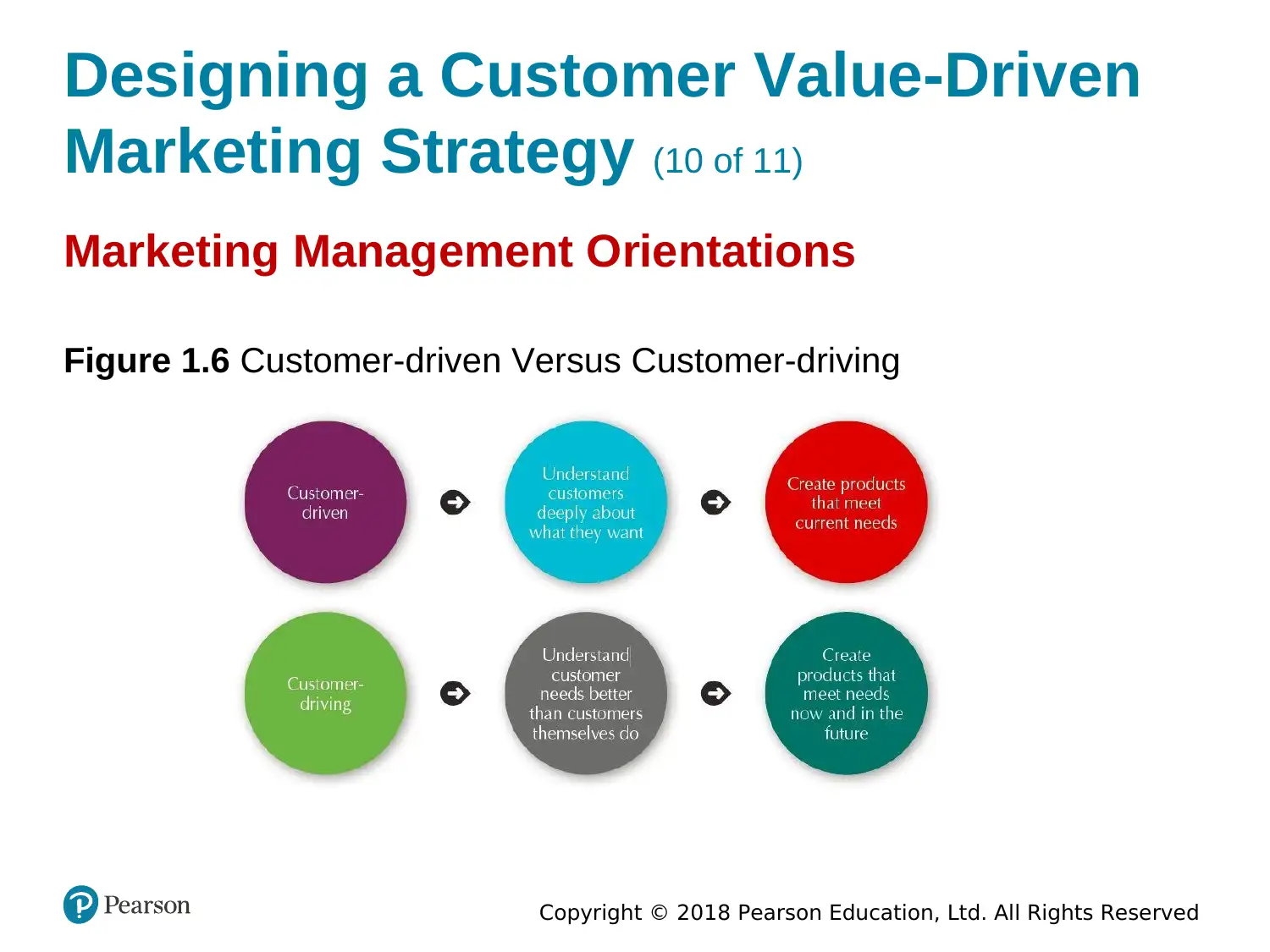
Copyright © 2018 Pearson Education, Ltd. All Rights Reserved
Designing a Customer Value-Driven
Marketing Strategy (10 of 11)
Marketing Management Orientations
Figure 1.6 Customer-driven Versus Customer-driving
Designing a Customer Value-Driven
Marketing Strategy (10 of 11)
Marketing Management Orientations
Figure 1.6 Customer-driven Versus Customer-driving
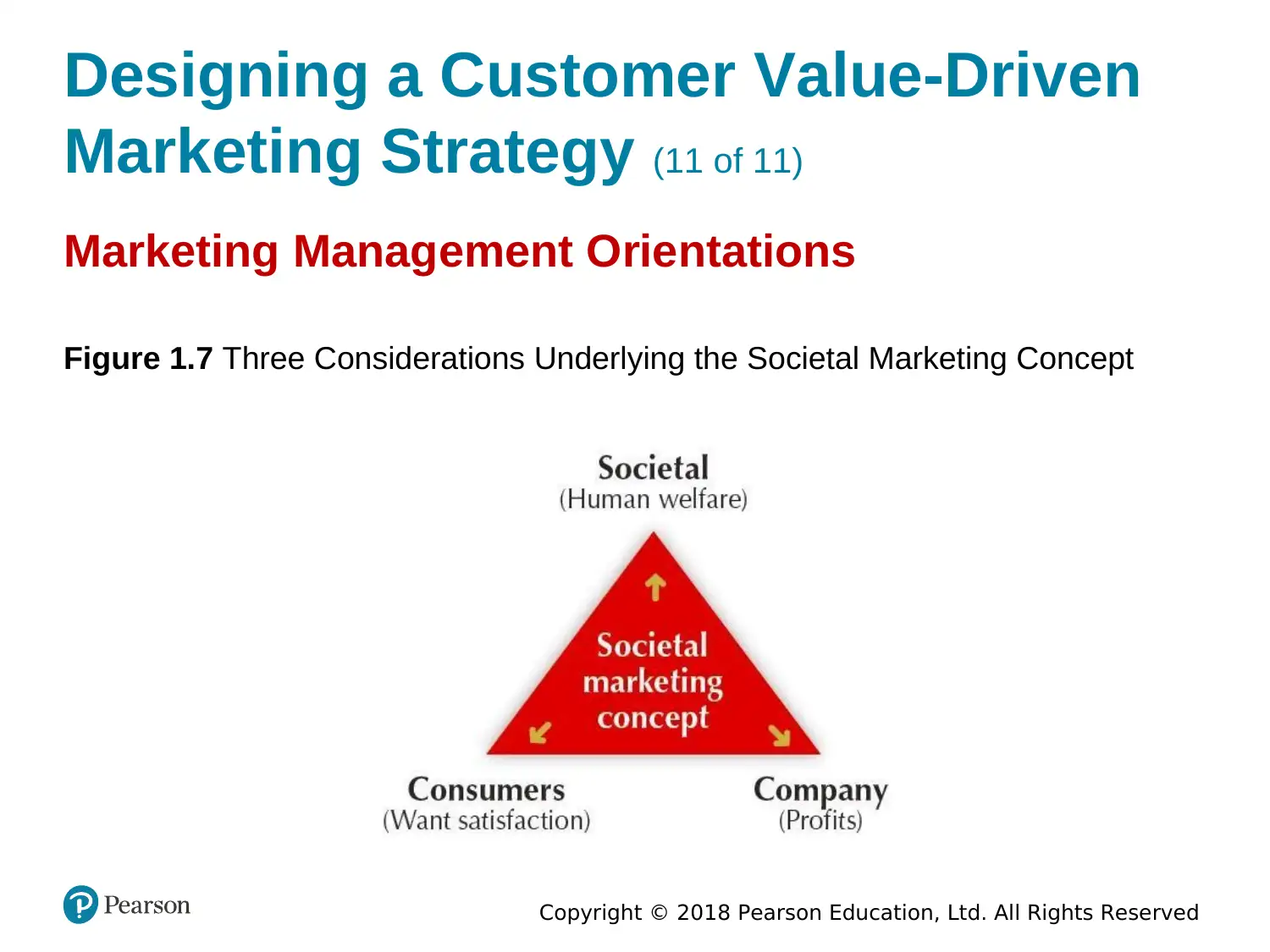
Copyright © 2018 Pearson Education, Ltd. All Rights Reserved
Designing a Customer Value-Driven
Marketing Strategy (11 of 11)
Marketing Management Orientations
Figure 1.7 Three Considerations Underlying the Societal Marketing Concept
Designing a Customer Value-Driven
Marketing Strategy (11 of 11)
Marketing Management Orientations
Figure 1.7 Three Considerations Underlying the Societal Marketing Concept
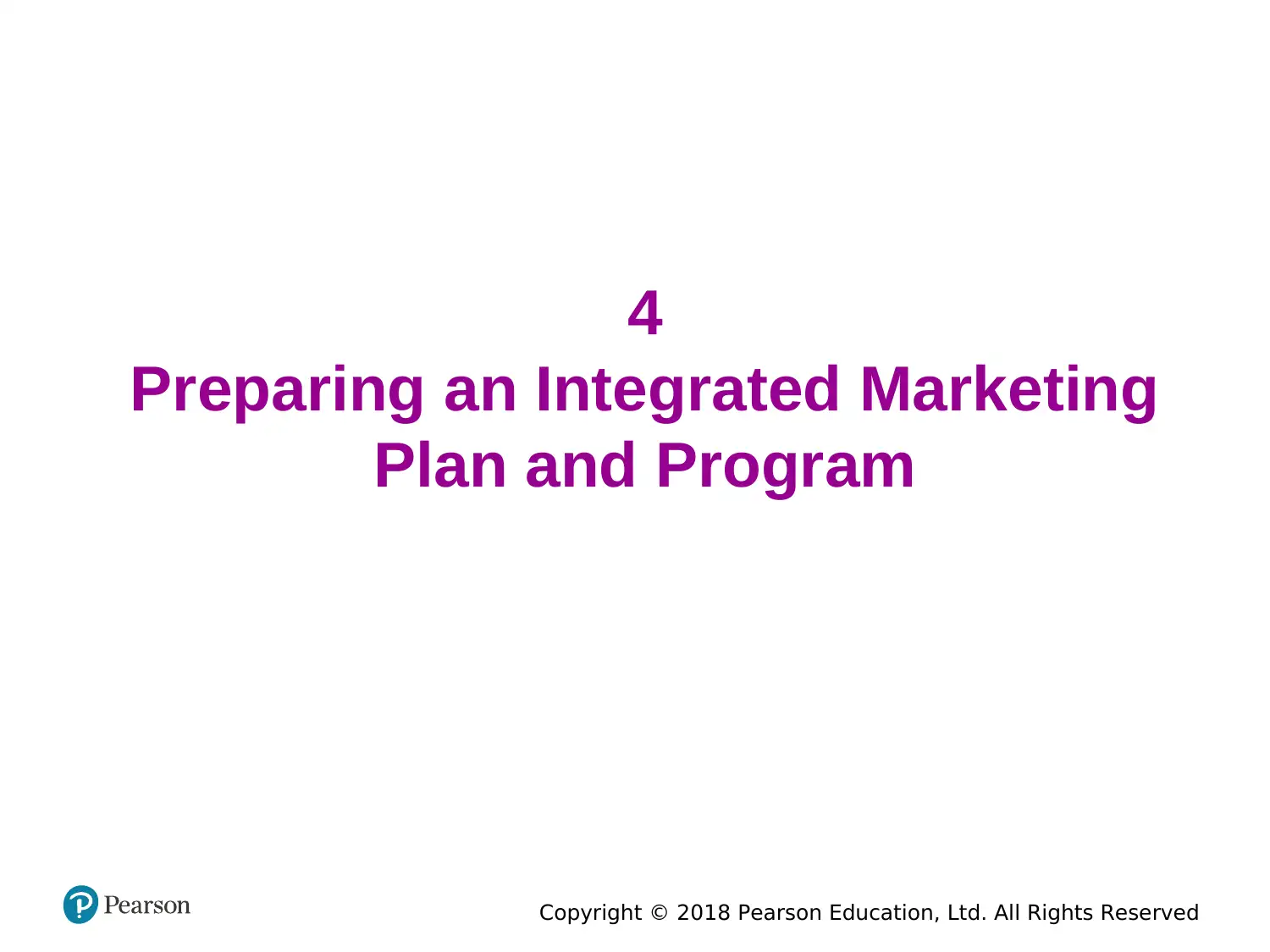
Copyright © 2018 Pearson Education, Ltd. All Rights Reserved
4
Preparing an Integrated Marketing
Plan and Program
4
Preparing an Integrated Marketing
Plan and Program
Secure Best Marks with AI Grader
Need help grading? Try our AI Grader for instant feedback on your assignments.
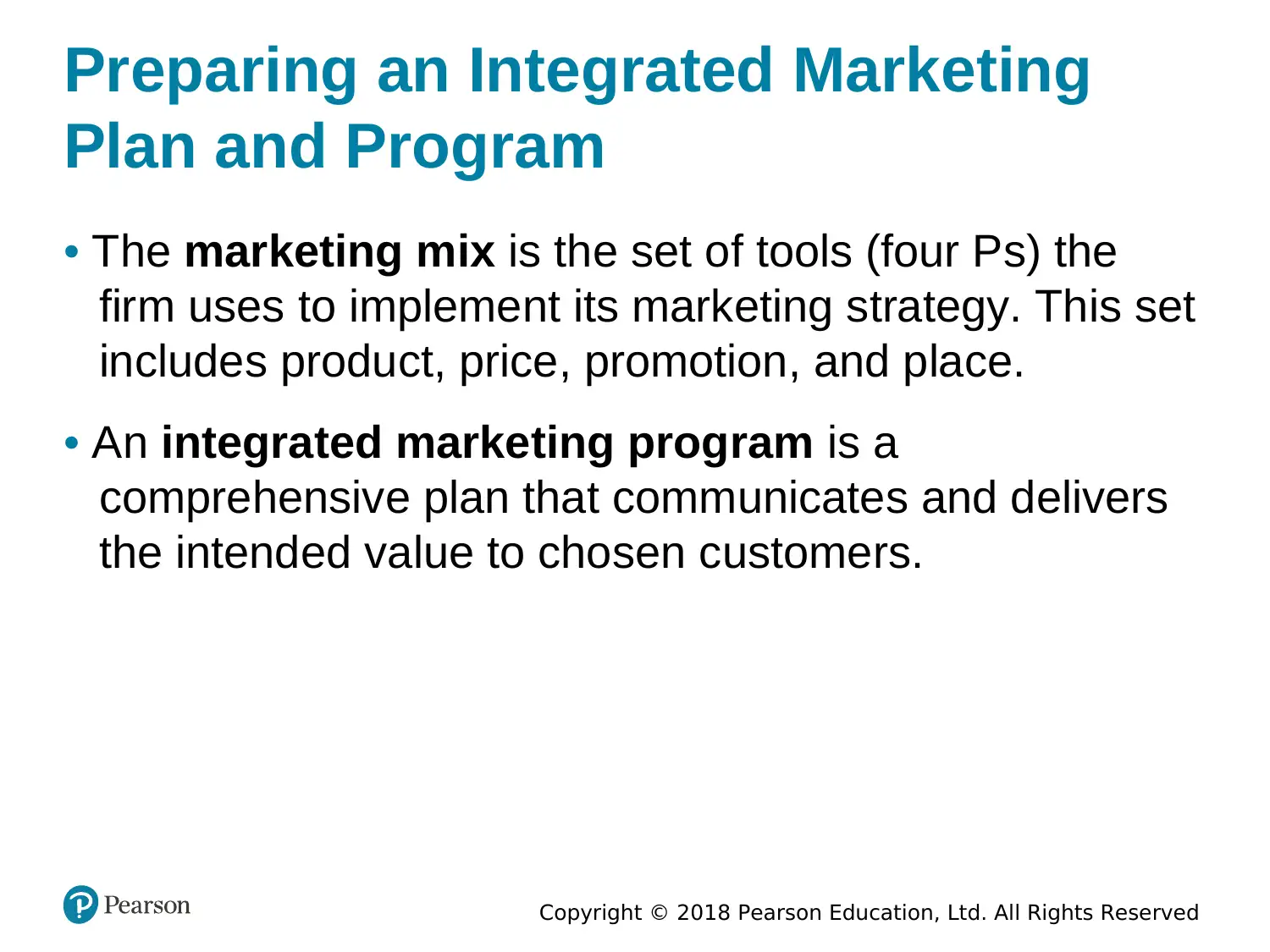
Copyright © 2018 Pearson Education, Ltd. All Rights Reserved
Preparing an Integrated Marketing
Plan and Program
• The marketing mix is the set of tools (four Ps) the
firm uses to implement its marketing strategy. This set
includes product, price, promotion, and place.
• An integrated marketing program is a
comprehensive plan that communicates and delivers
the intended value to chosen customers.
Preparing an Integrated Marketing
Plan and Program
• The marketing mix is the set of tools (four Ps) the
firm uses to implement its marketing strategy. This set
includes product, price, promotion, and place.
• An integrated marketing program is a
comprehensive plan that communicates and delivers
the intended value to chosen customers.
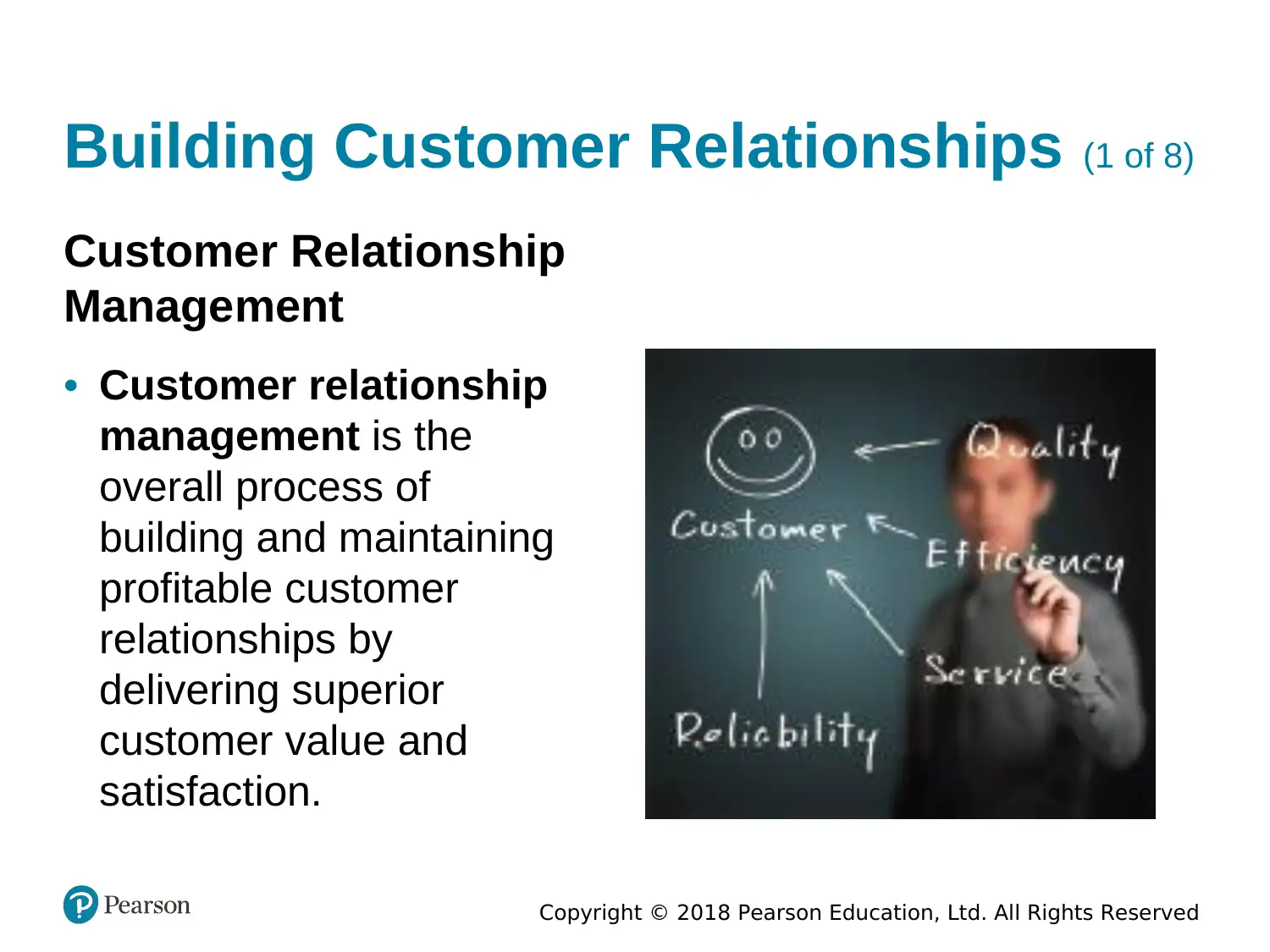
Copyright © 2018 Pearson Education, Ltd. All Rights Reserved
Building Customer Relationships (1 of 8)
Customer Relationship
Management
• Customer relationship
management is the
overall process of
building and maintaining
profitable customer
relationships by
delivering superior
customer value and
satisfaction.
Building Customer Relationships (1 of 8)
Customer Relationship
Management
• Customer relationship
management is the
overall process of
building and maintaining
profitable customer
relationships by
delivering superior
customer value and
satisfaction.
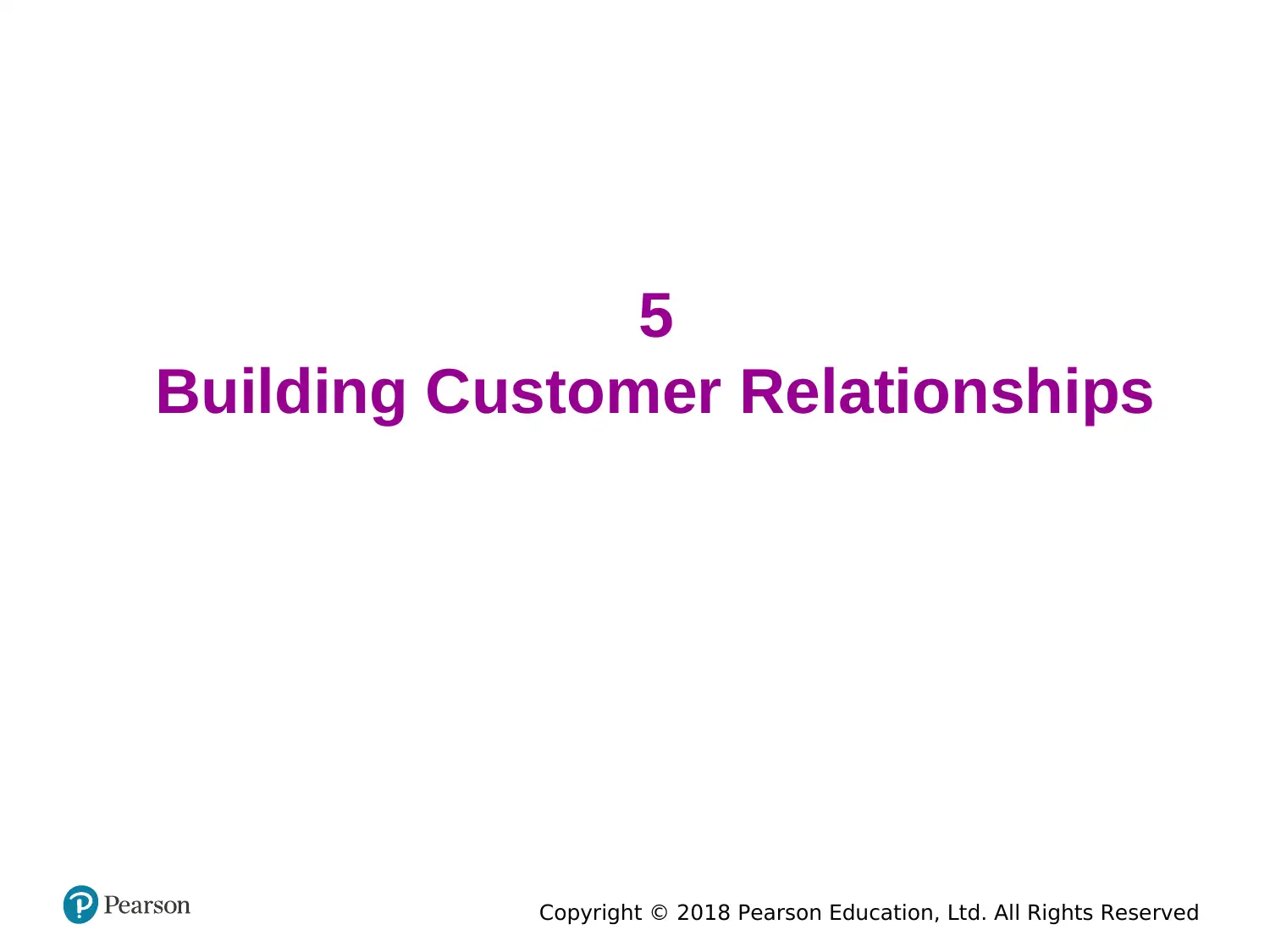
Copyright © 2018 Pearson Education, Ltd. All Rights Reserved
5
Building Customer Relationships
5
Building Customer Relationships
Paraphrase This Document
Need a fresh take? Get an instant paraphrase of this document with our AI Paraphraser
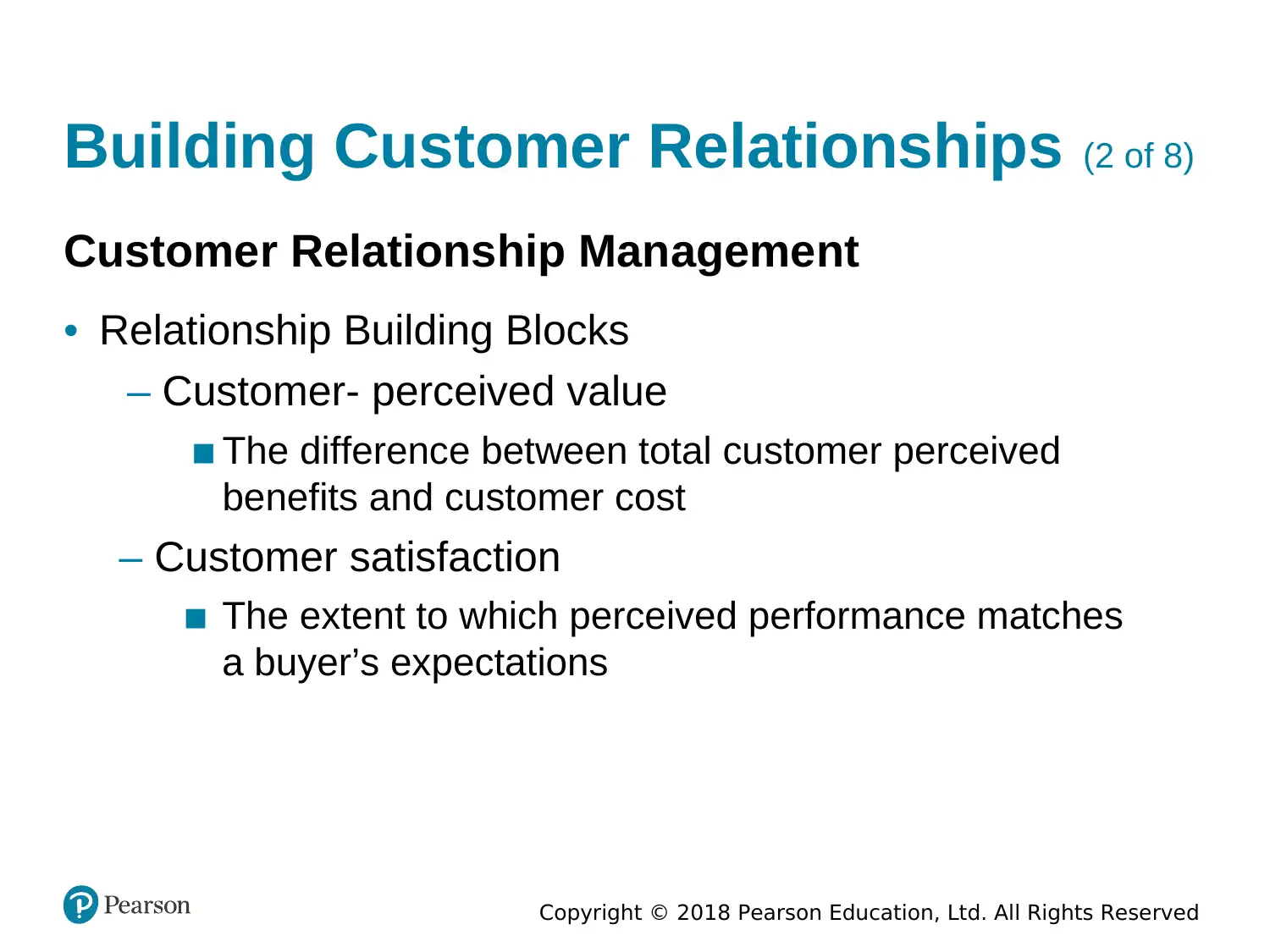
Copyright © 2018 Pearson Education, Ltd. All Rights Reserved
Building Customer Relationships (2 of 8)
Customer Relationship Management
• Relationship Building Blocks
– Customer- perceived value
▪ The difference between total customer perceived
benefits and customer cost
‒ Customer satisfaction
▪ The extent to which perceived performance matches
a buyer’s expectations
Building Customer Relationships (2 of 8)
Customer Relationship Management
• Relationship Building Blocks
– Customer- perceived value
▪ The difference between total customer perceived
benefits and customer cost
‒ Customer satisfaction
▪ The extent to which perceived performance matches
a buyer’s expectations
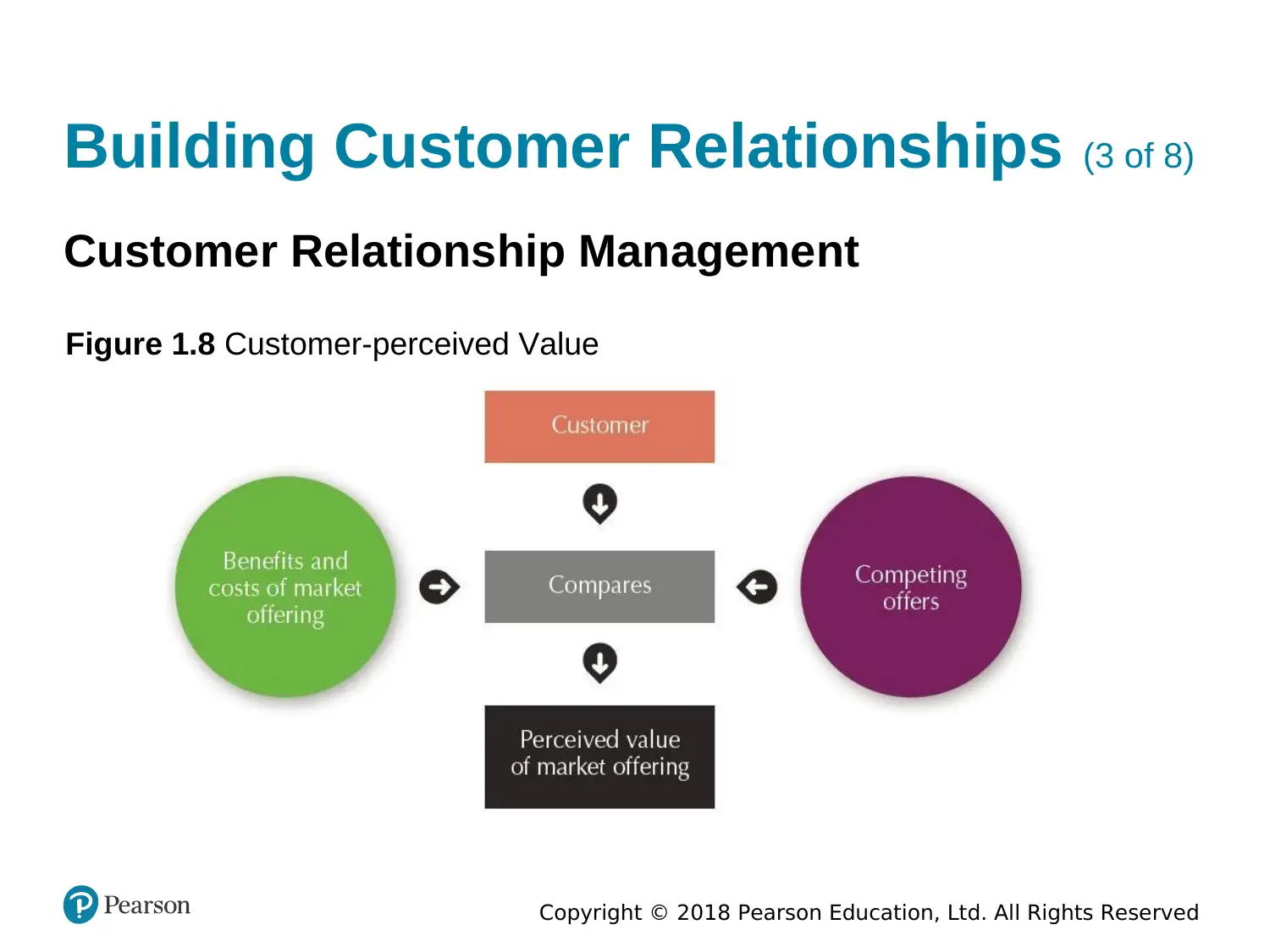
Copyright © 2018 Pearson Education, Ltd. All Rights Reserved
Building Customer Relationships (3 of 8)
Customer Relationship Management
Figure 1.8 Customer-perceived Value
Building Customer Relationships (3 of 8)
Customer Relationship Management
Figure 1.8 Customer-perceived Value
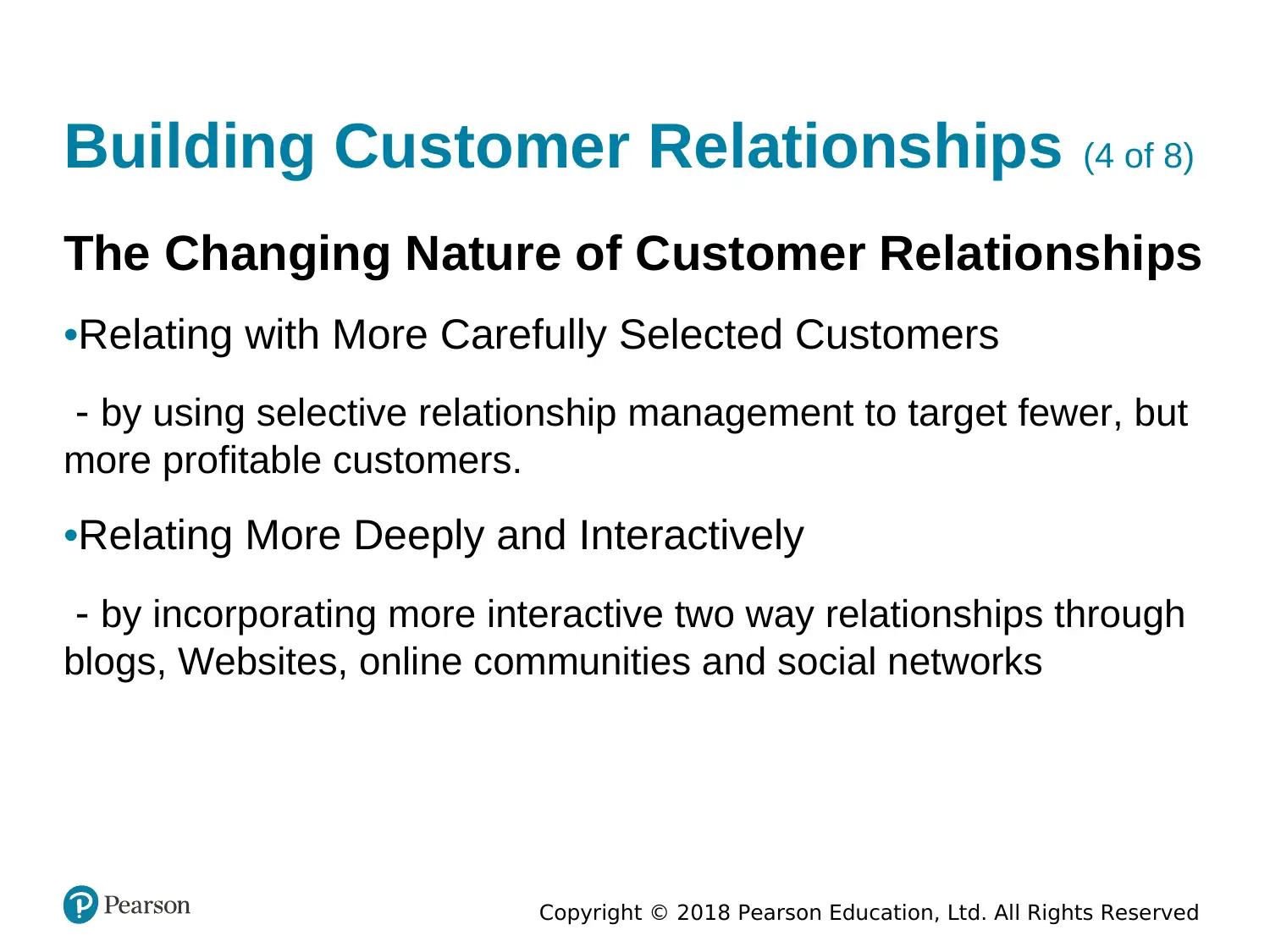
Copyright © 2018 Pearson Education, Ltd. All Rights Reserved
Building Customer Relationships (4 of 8)
The Changing Nature of Customer Relationships
•Relating with More Carefully Selected Customers
- by using selective relationship management to target fewer, but
more profitable customers.
•Relating More Deeply and Interactively
- by incorporating more interactive two way relationships through
blogs, Websites, online communities and social networks
Building Customer Relationships (4 of 8)
The Changing Nature of Customer Relationships
•Relating with More Carefully Selected Customers
- by using selective relationship management to target fewer, but
more profitable customers.
•Relating More Deeply and Interactively
- by incorporating more interactive two way relationships through
blogs, Websites, online communities and social networks
Secure Best Marks with AI Grader
Need help grading? Try our AI Grader for instant feedback on your assignments.
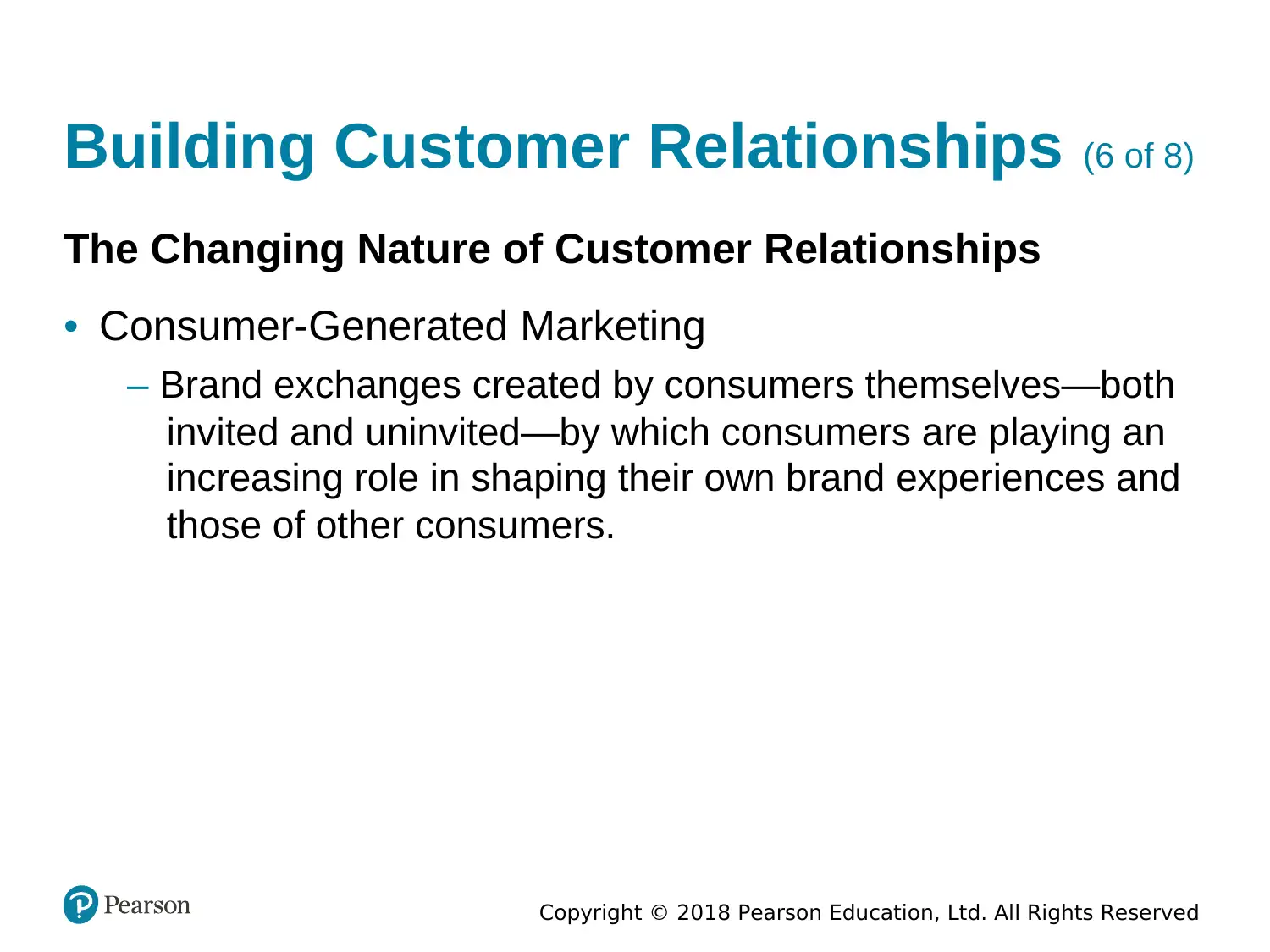
Copyright © 2018 Pearson Education, Ltd. All Rights Reserved
Building Customer Relationships (6 of 8)
The Changing Nature of Customer Relationships
• Consumer-Generated Marketing
– Brand exchanges created by consumers themselves—both
invited and uninvited—by which consumers are playing an
increasing role in shaping their own brand experiences and
those of other consumers.
Building Customer Relationships (6 of 8)
The Changing Nature of Customer Relationships
• Consumer-Generated Marketing
– Brand exchanges created by consumers themselves—both
invited and uninvited—by which consumers are playing an
increasing role in shaping their own brand experiences and
those of other consumers.
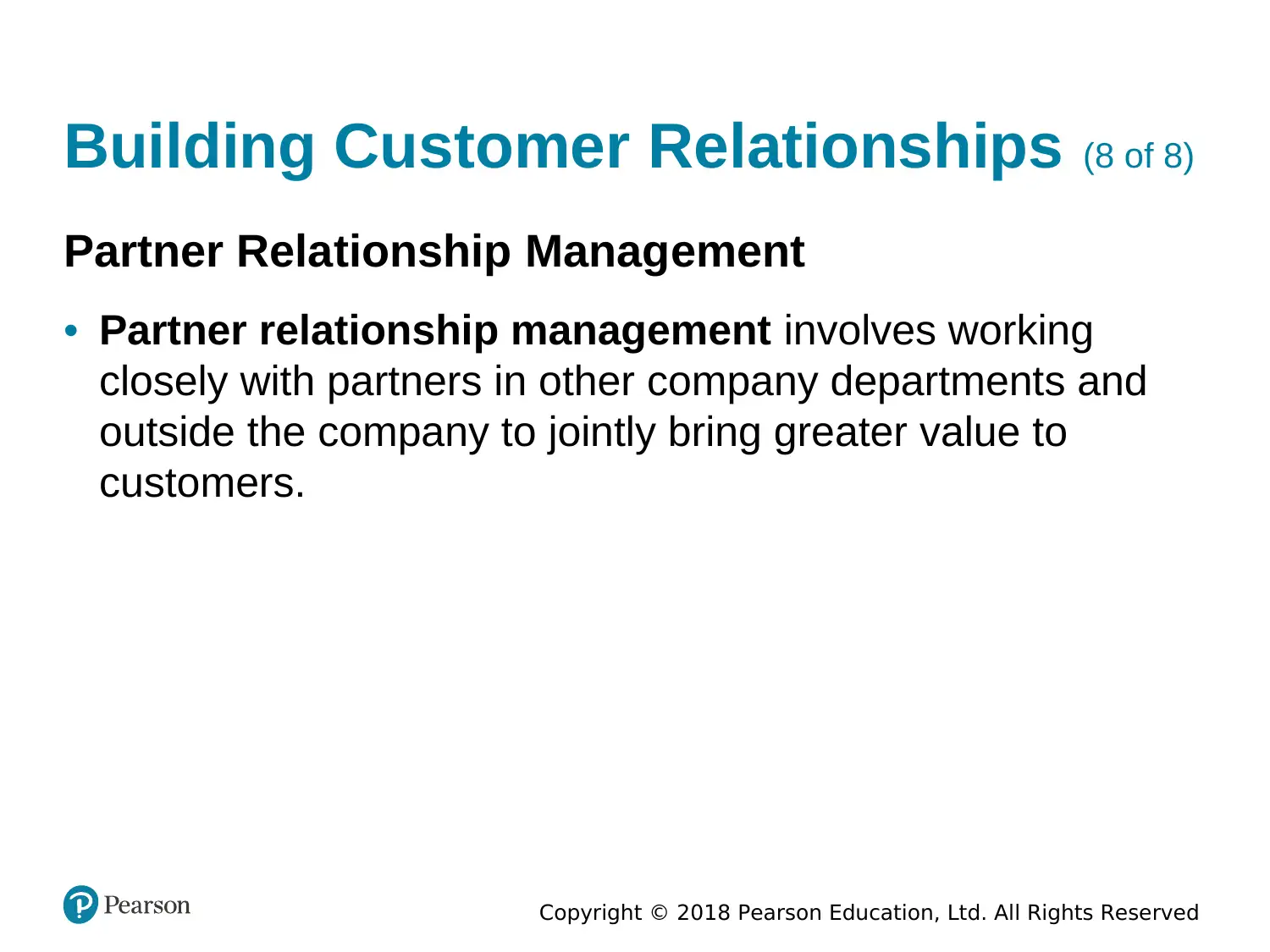
Copyright © 2018 Pearson Education, Ltd. All Rights Reserved
Building Customer Relationships (8 of 8)
Partner Relationship Management
• Partner relationship management involves working
closely with partners in other company departments and
outside the company to jointly bring greater value to
customers.
Building Customer Relationships (8 of 8)
Partner Relationship Management
• Partner relationship management involves working
closely with partners in other company departments and
outside the company to jointly bring greater value to
customers.
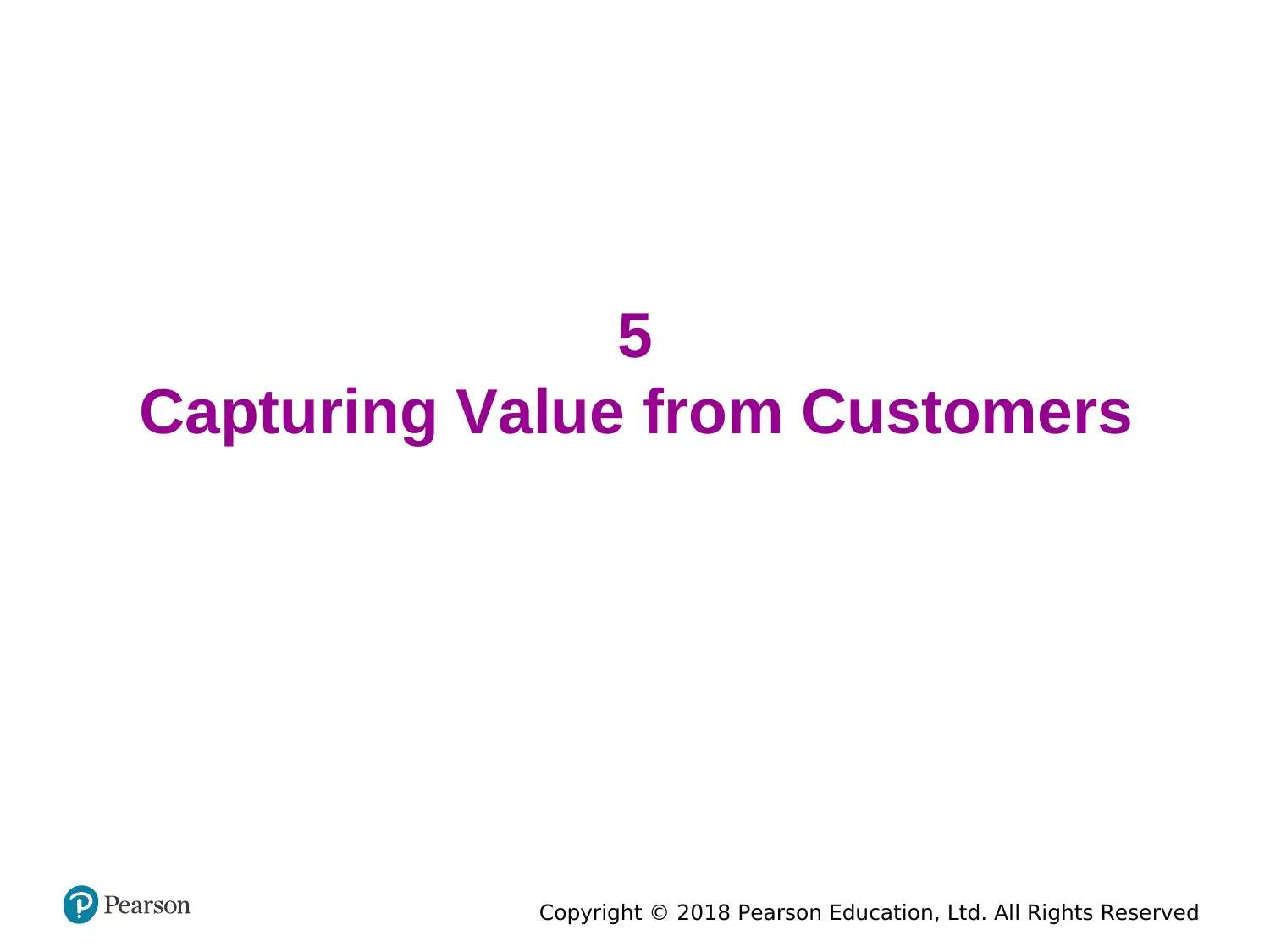
Copyright © 2018 Pearson Education, Ltd. All Rights Reserved
5
Capturing Value from Customers
5
Capturing Value from Customers
Paraphrase This Document
Need a fresh take? Get an instant paraphrase of this document with our AI Paraphraser
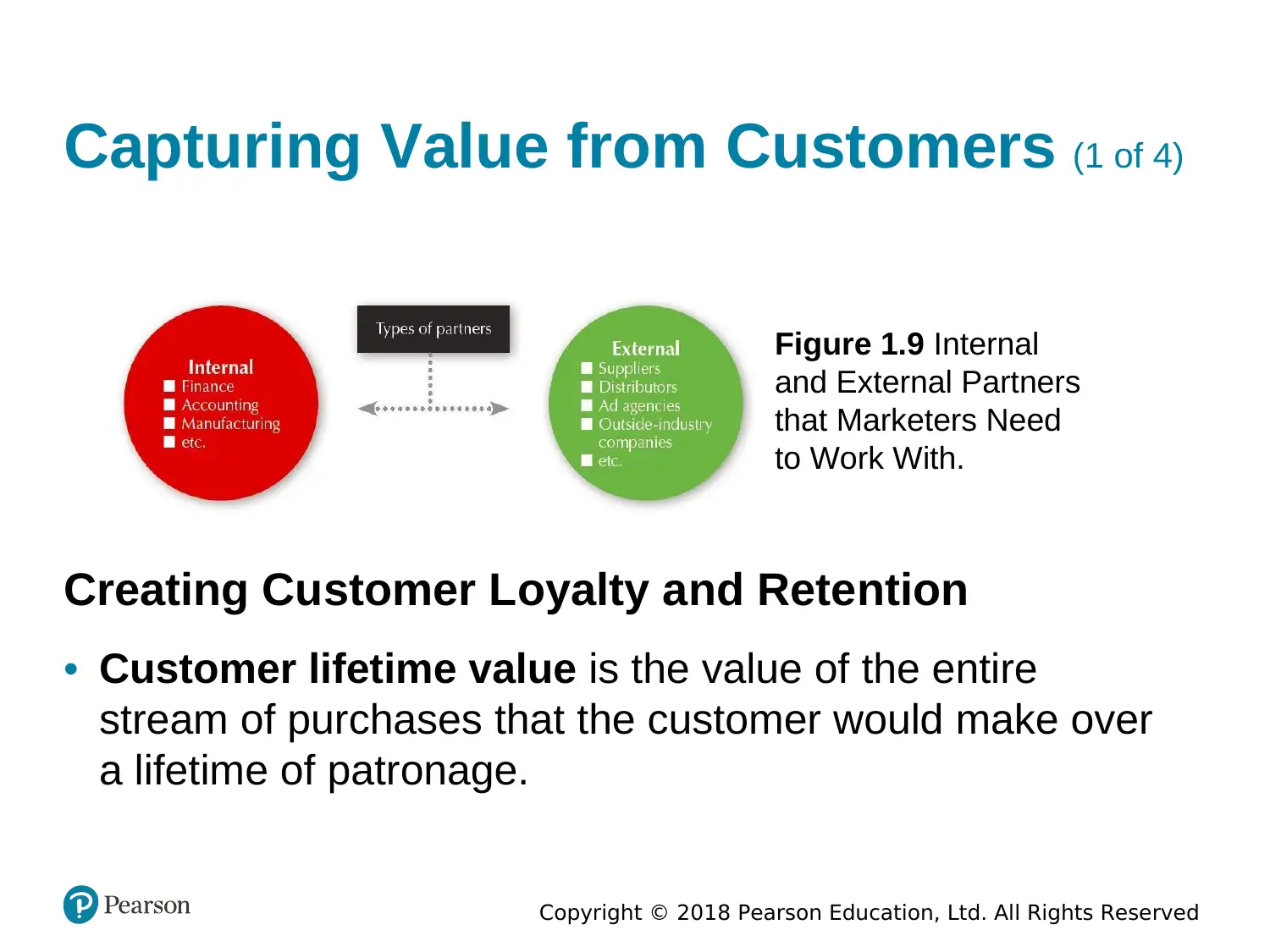
Copyright © 2018 Pearson Education, Ltd. All Rights Reserved
Capturing Value from Customers (1 of 4)
Creating Customer Loyalty and Retention
• Customer lifetime value is the value of the entire
stream of purchases that the customer would make over
a lifetime of patronage.
Figure 1.9 Internal
and External Partners
that Marketers Need
to Work With.
Capturing Value from Customers (1 of 4)
Creating Customer Loyalty and Retention
• Customer lifetime value is the value of the entire
stream of purchases that the customer would make over
a lifetime of patronage.
Figure 1.9 Internal
and External Partners
that Marketers Need
to Work With.
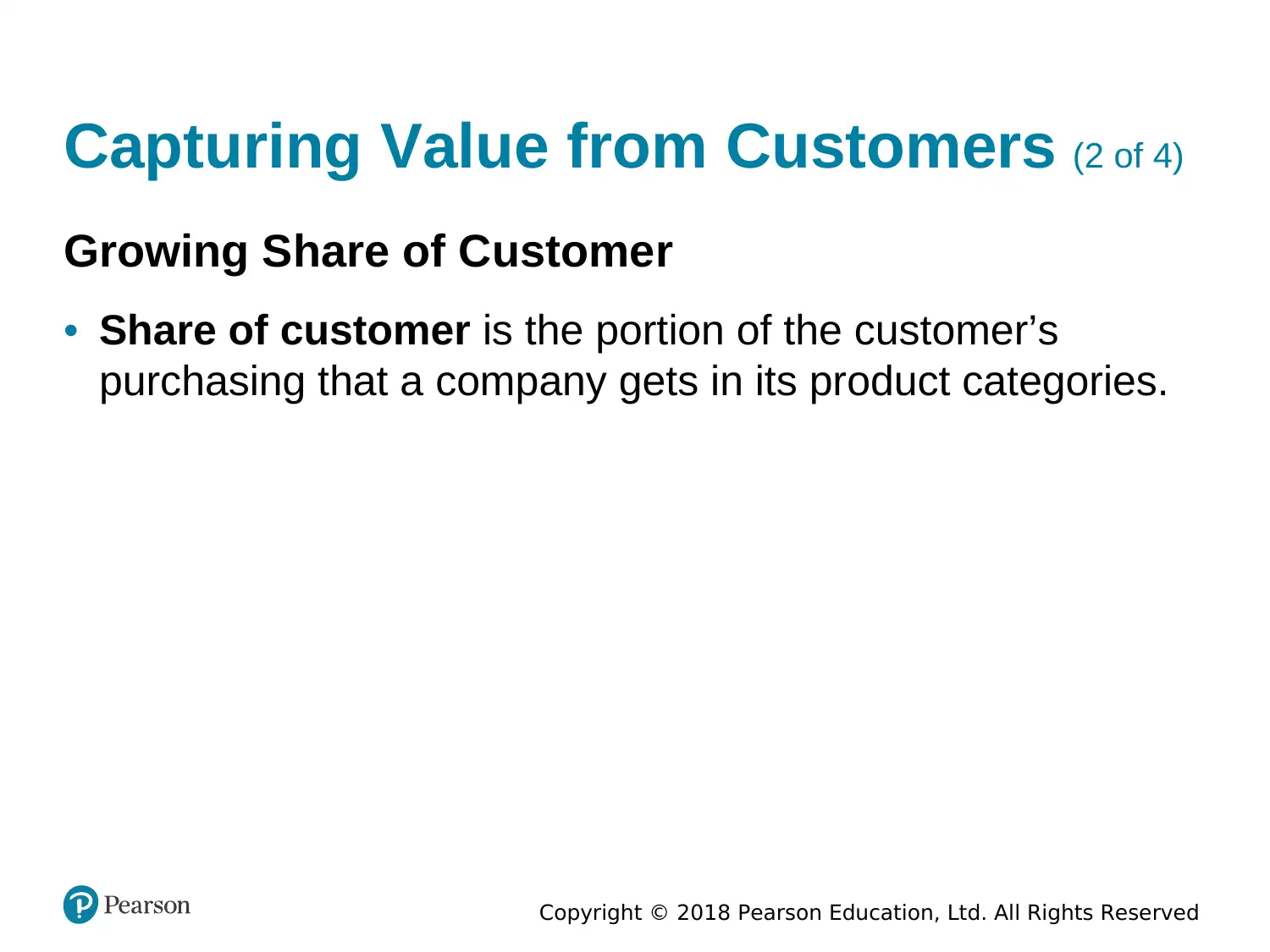
Copyright © 2018 Pearson Education, Ltd. All Rights Reserved
Capturing Value from Customers (2 of 4)
Growing Share of Customer
• Share of customer is the portion of the customer’s
purchasing that a company gets in its product categories.
Capturing Value from Customers (2 of 4)
Growing Share of Customer
• Share of customer is the portion of the customer’s
purchasing that a company gets in its product categories.
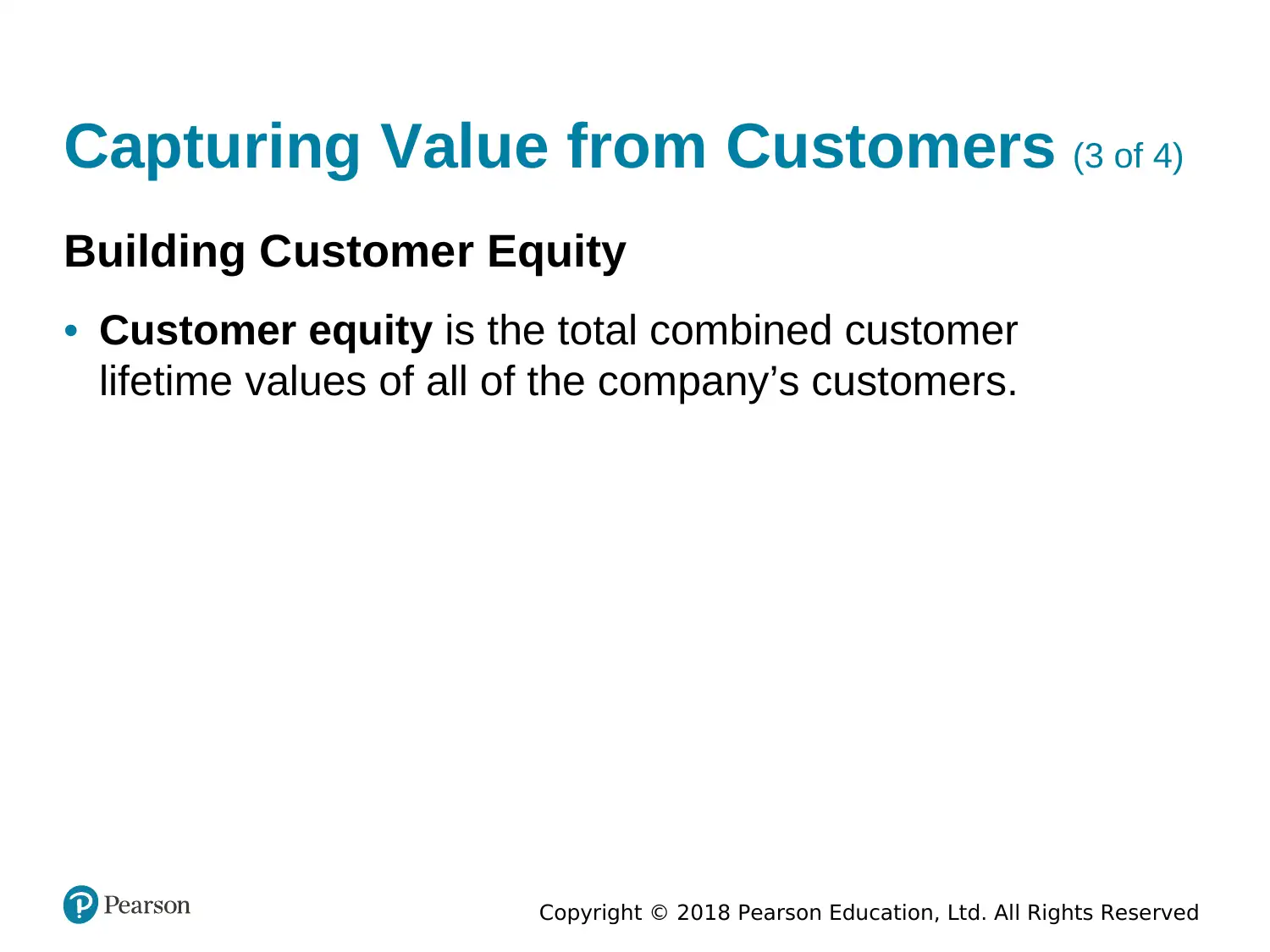
Copyright © 2018 Pearson Education, Ltd. All Rights Reserved
Capturing Value from Customers (3 of 4)
Building Customer Equity
• Customer equity is the total combined customer
lifetime values of all of the company’s customers.
Capturing Value from Customers (3 of 4)
Building Customer Equity
• Customer equity is the total combined customer
lifetime values of all of the company’s customers.
Secure Best Marks with AI Grader
Need help grading? Try our AI Grader for instant feedback on your assignments.
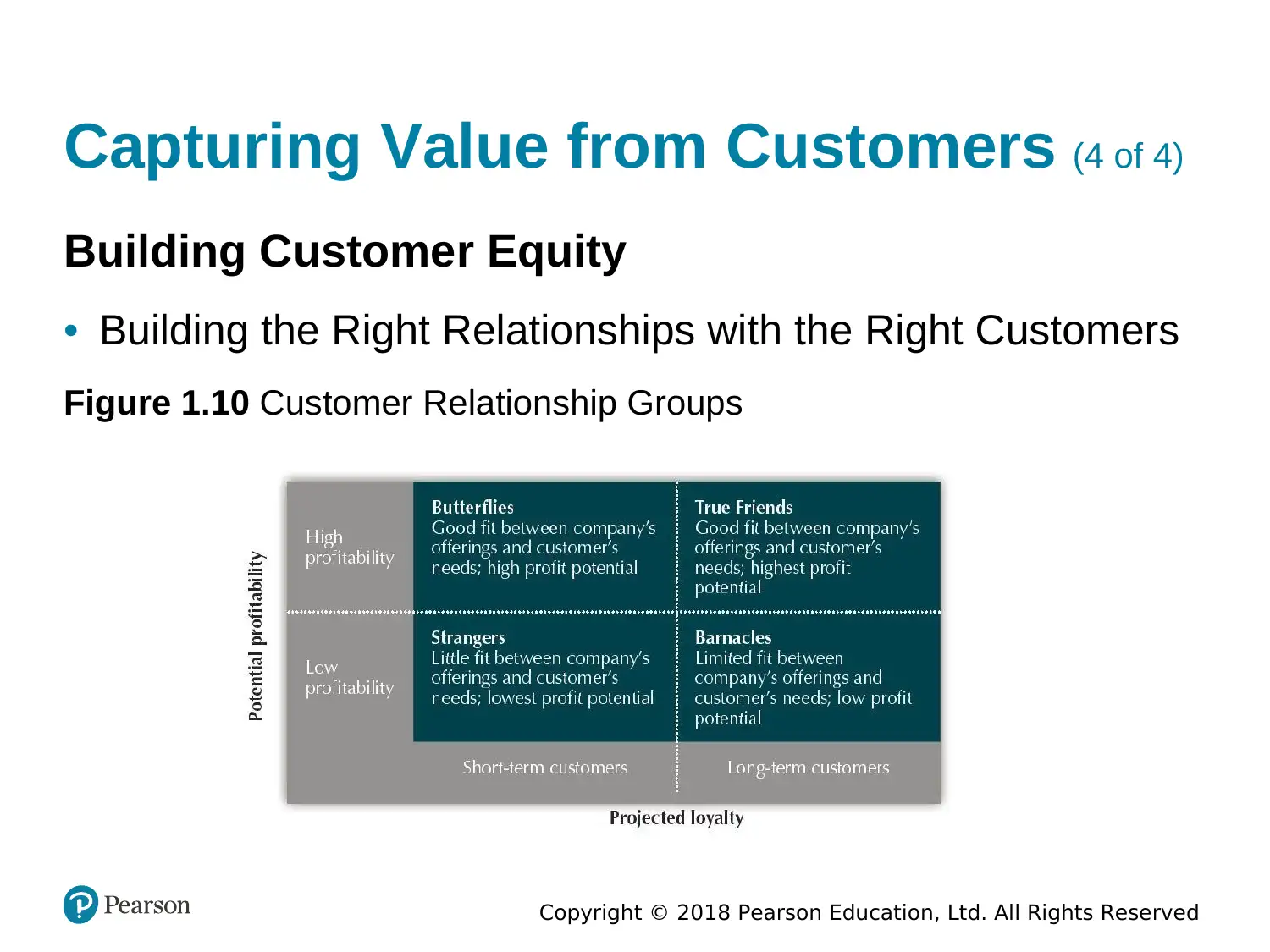
Copyright © 2018 Pearson Education, Ltd. All Rights Reserved
Capturing Value from Customers (4 of 4)
Building Customer Equity
• Building the Right Relationships with the Right Customers
Figure 1.10 Customer Relationship Groups
Capturing Value from Customers (4 of 4)
Building Customer Equity
• Building the Right Relationships with the Right Customers
Figure 1.10 Customer Relationship Groups
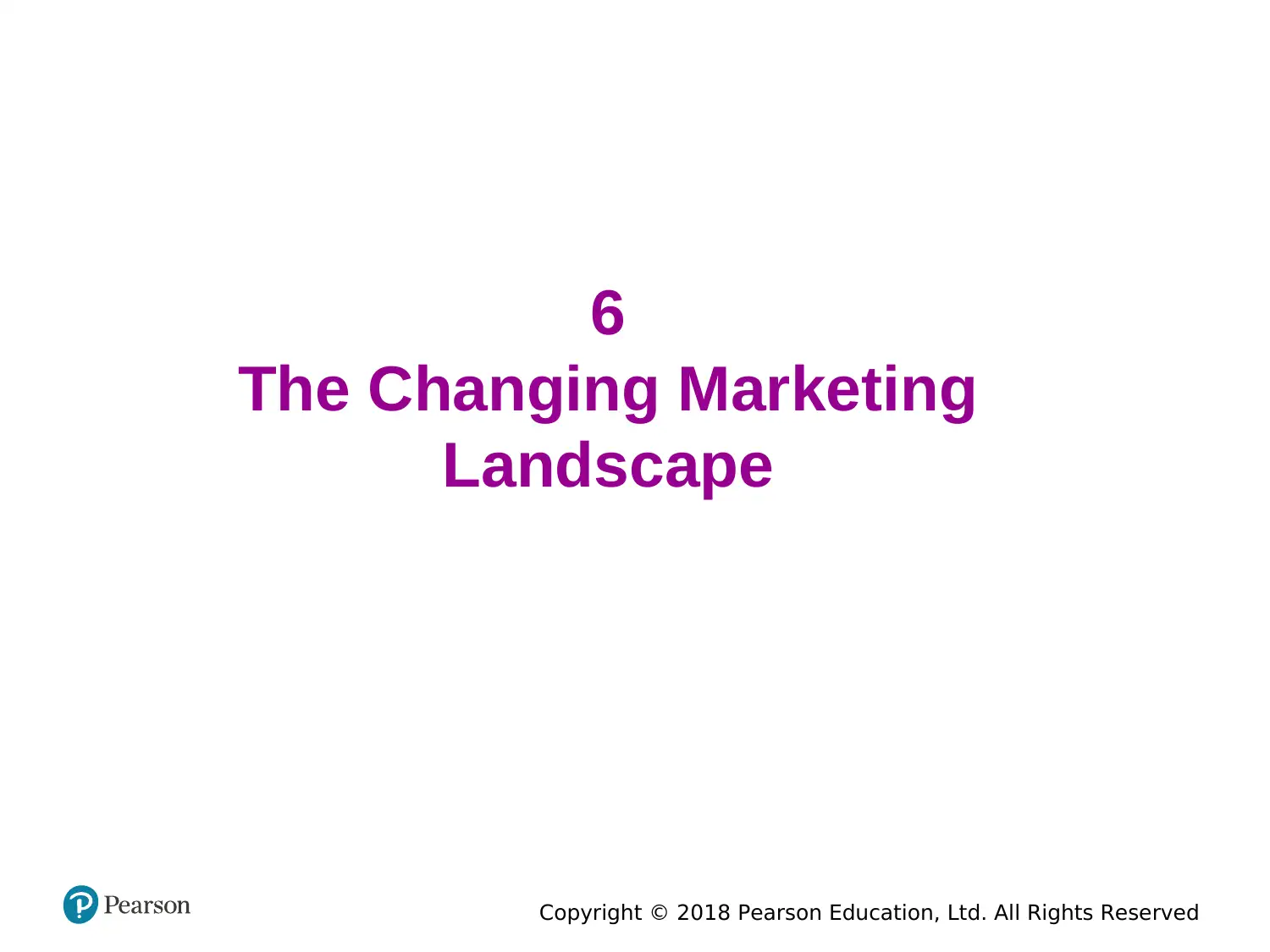
Copyright © 2018 Pearson Education, Ltd. All Rights Reserved
6
The Changing Marketing
Landscape
6
The Changing Marketing
Landscape
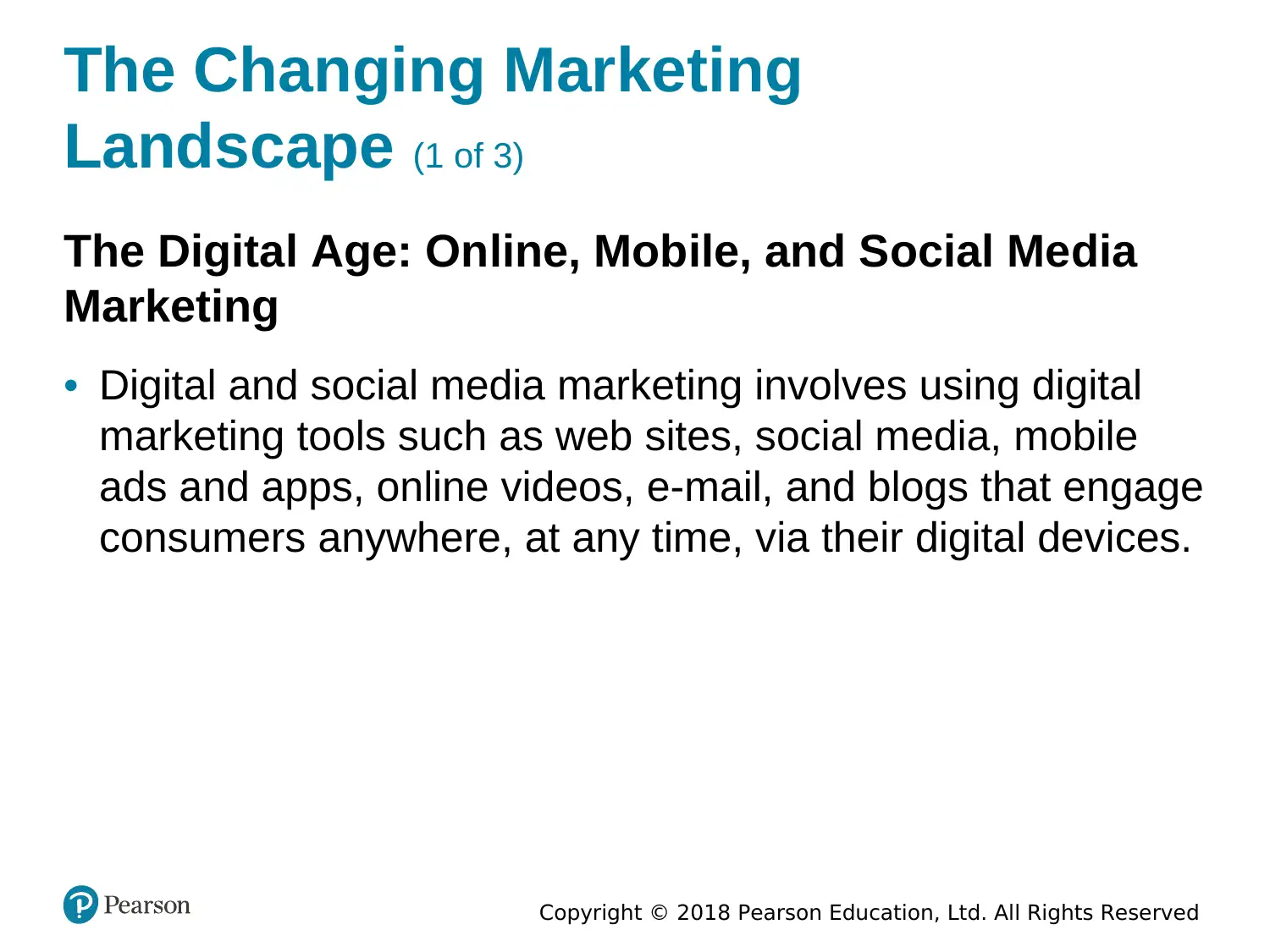
Copyright © 2018 Pearson Education, Ltd. All Rights Reserved
The Changing Marketing
Landscape (1 of 3)
The Digital Age: Online, Mobile, and Social Media
Marketing
• Digital and social media marketing involves using digital
marketing tools such as web sites, social media, mobile
ads and apps, online videos, e-mail, and blogs that engage
consumers anywhere, at any time, via their digital devices.
The Changing Marketing
Landscape (1 of 3)
The Digital Age: Online, Mobile, and Social Media
Marketing
• Digital and social media marketing involves using digital
marketing tools such as web sites, social media, mobile
ads and apps, online videos, e-mail, and blogs that engage
consumers anywhere, at any time, via their digital devices.
Paraphrase This Document
Need a fresh take? Get an instant paraphrase of this document with our AI Paraphraser
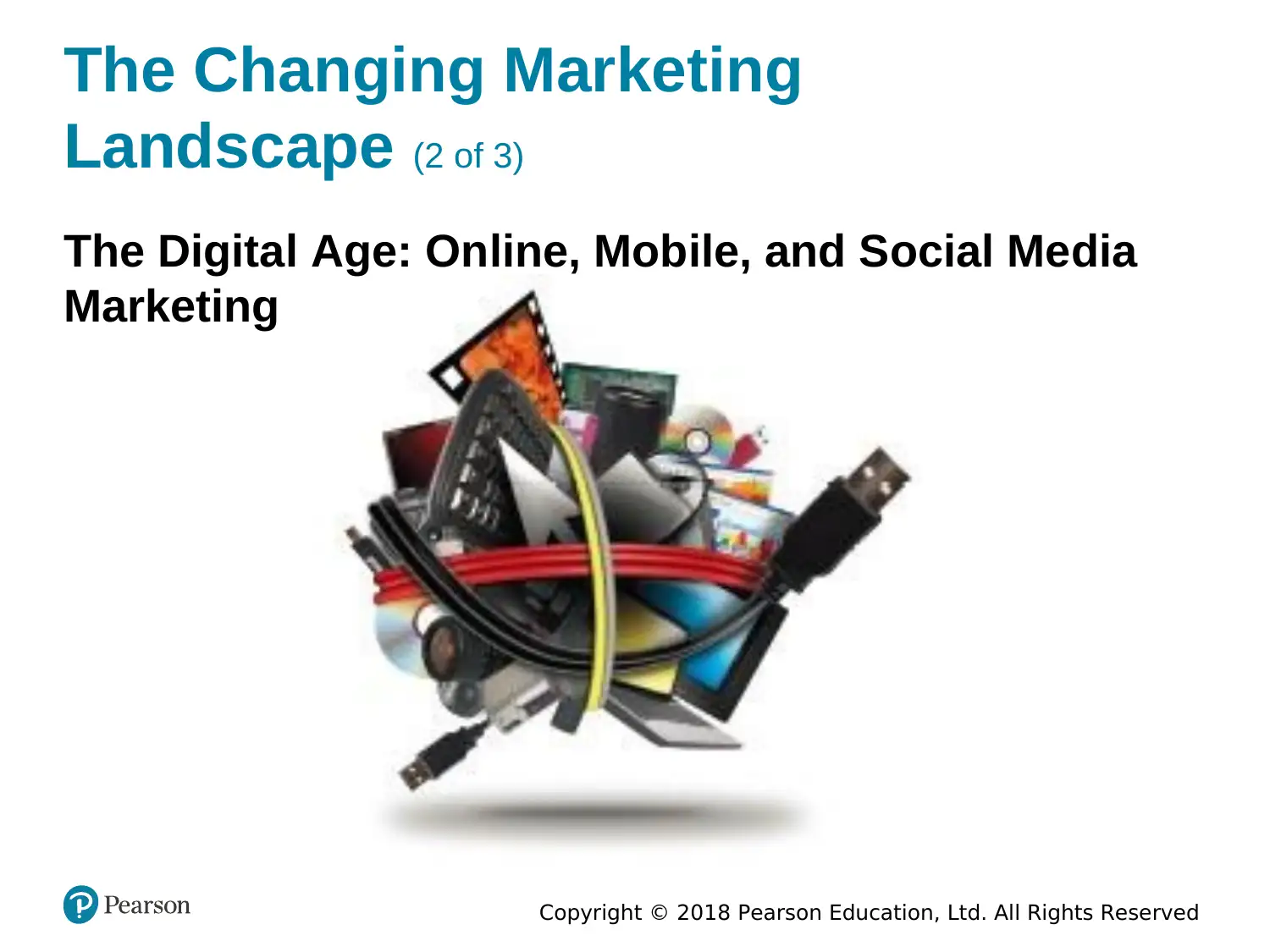
Copyright © 2018 Pearson Education, Ltd. All Rights Reserved
The Changing Marketing
Landscape (2 of 3)
The Digital Age: Online, Mobile, and Social Media
Marketing
The Changing Marketing
Landscape (2 of 3)
The Digital Age: Online, Mobile, and Social Media
Marketing
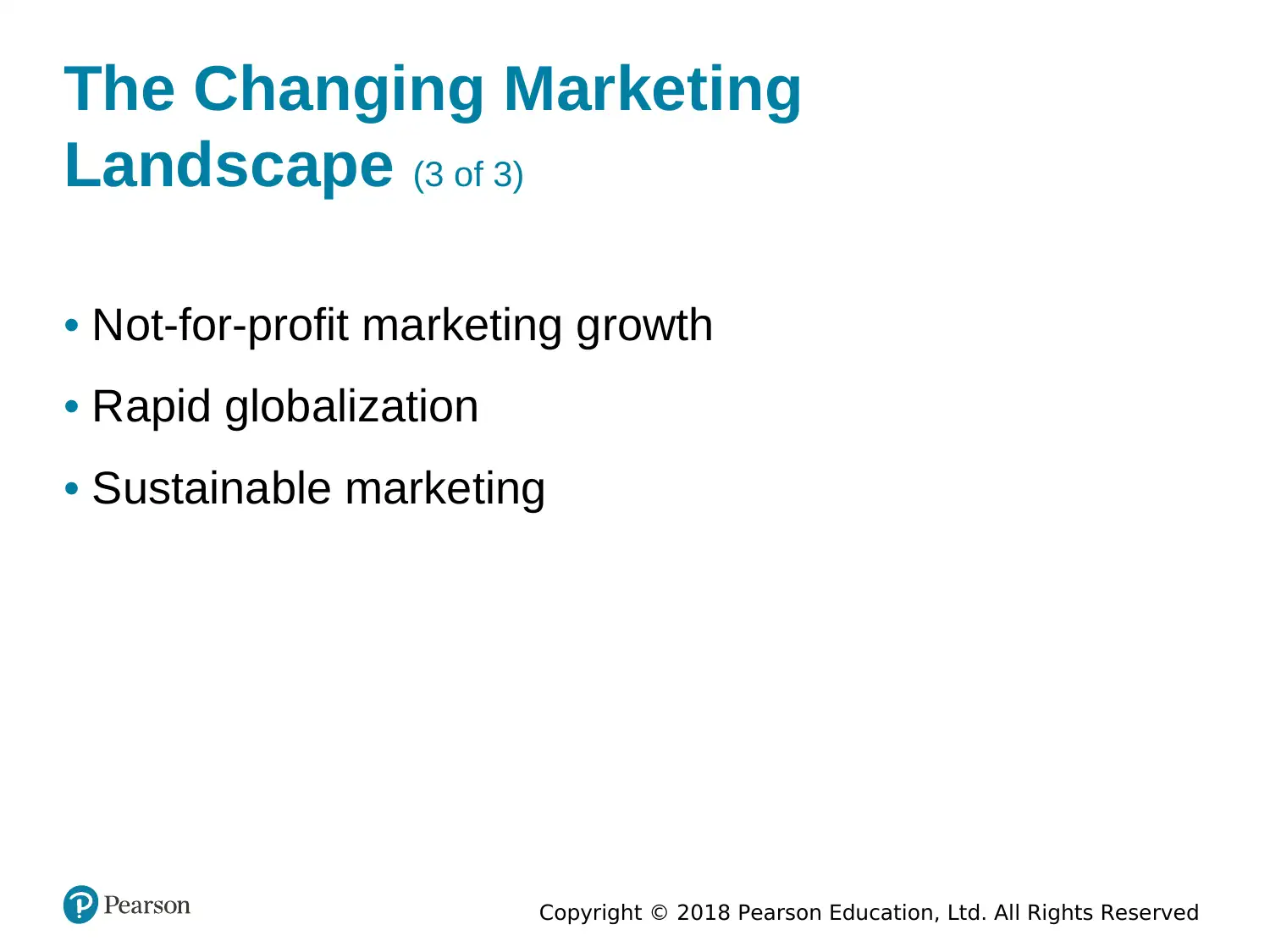
Copyright © 2018 Pearson Education, Ltd. All Rights Reserved
The Changing Marketing
Landscape (3 of 3)
• Not-for-profit marketing growth
• Rapid globalization
• Sustainable marketing
The Changing Marketing
Landscape (3 of 3)
• Not-for-profit marketing growth
• Rapid globalization
• Sustainable marketing
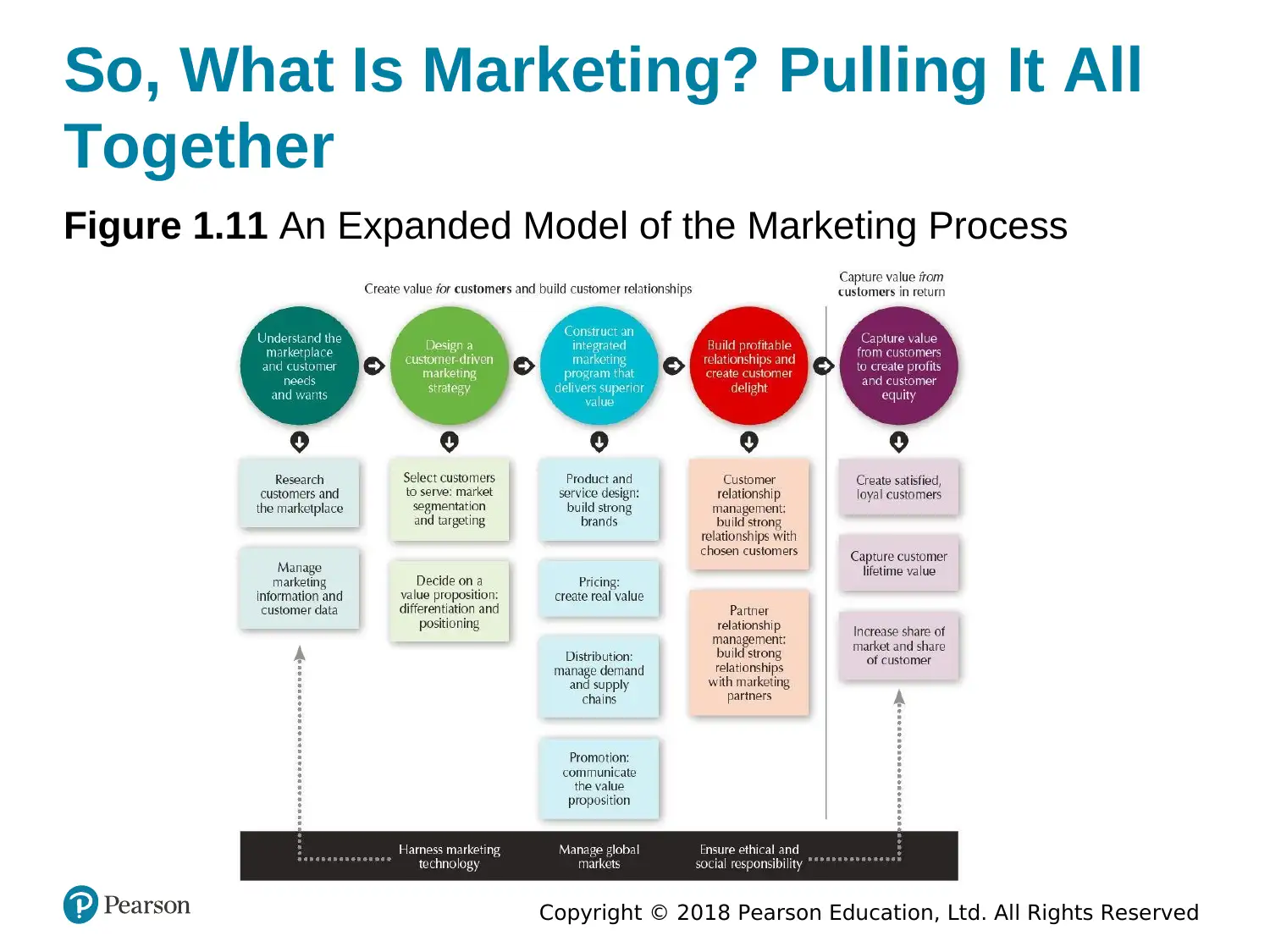
Copyright © 2018 Pearson Education, Ltd. All Rights Reserved
So, What Is Marketing? Pulling It All
Together
Figure 1.11 An Expanded Model of the Marketing Process
So, What Is Marketing? Pulling It All
Together
Figure 1.11 An Expanded Model of the Marketing Process
Secure Best Marks with AI Grader
Need help grading? Try our AI Grader for instant feedback on your assignments.
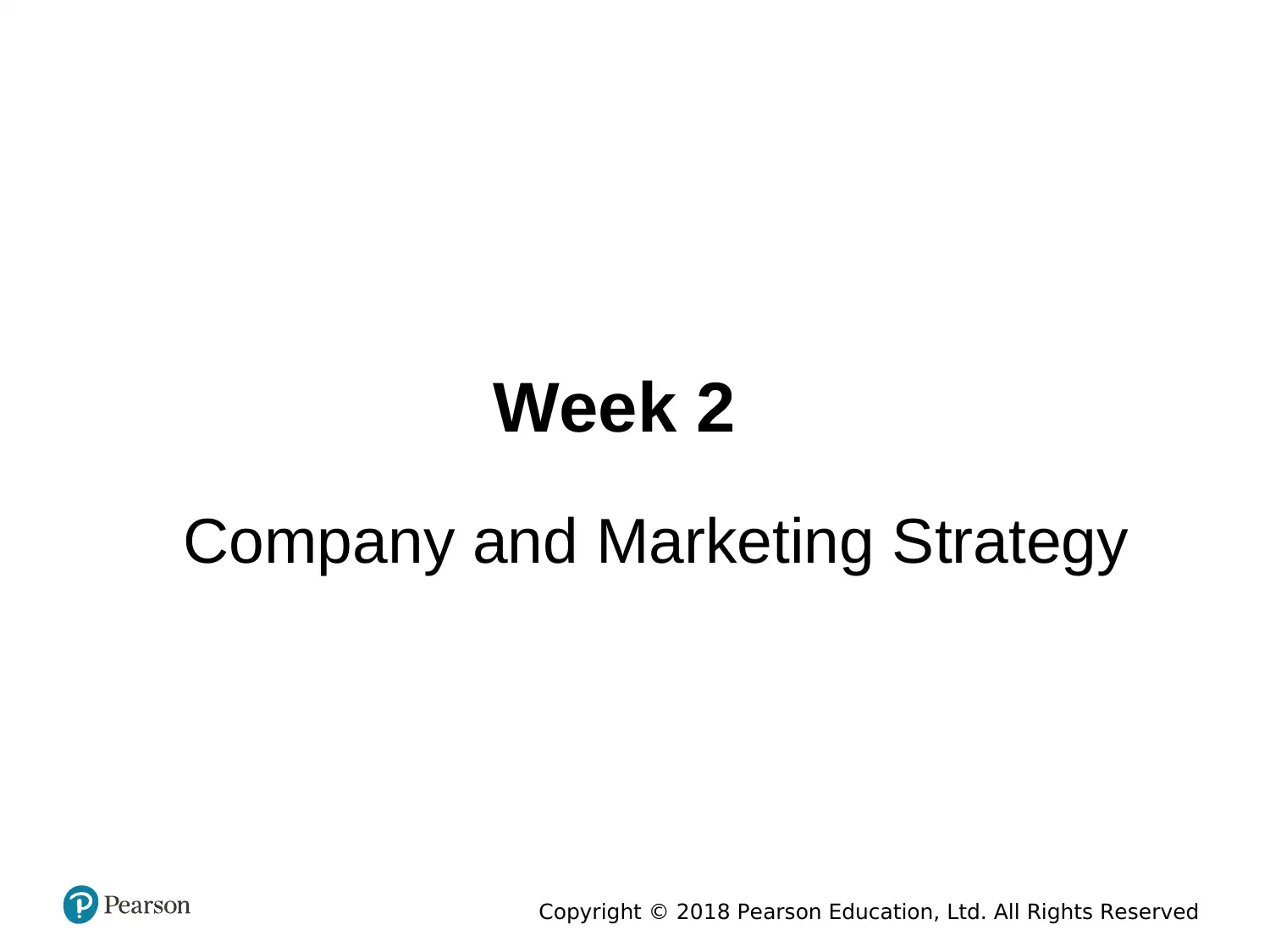
Week 2
Company and Marketing Strategy
Copyright © 2018 Pearson Education, Ltd. All Rights Reserved
Company and Marketing Strategy
Copyright © 2018 Pearson Education, Ltd. All Rights Reserved
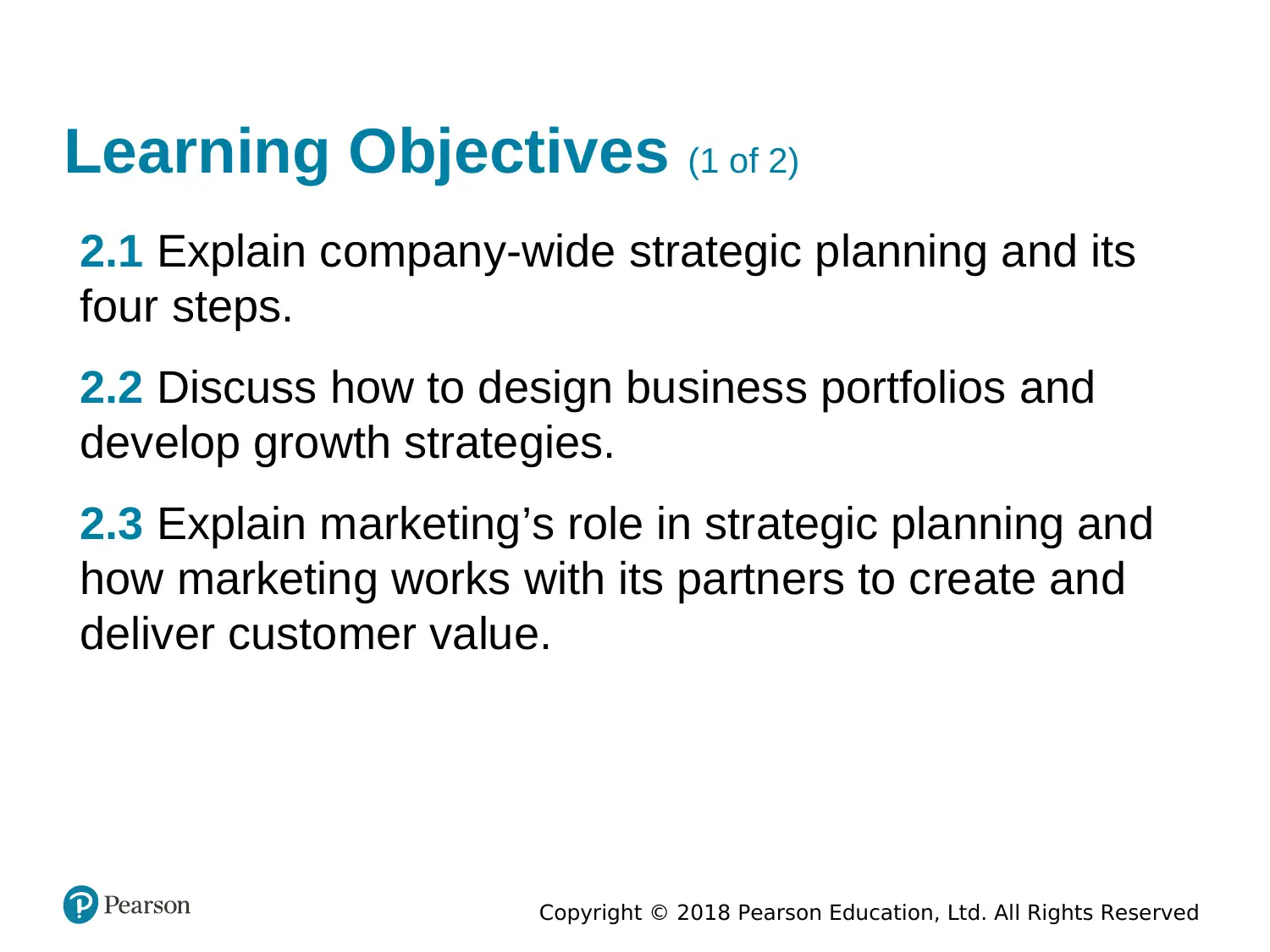
Copyright © 2018 Pearson Education, Ltd. All Rights Reserved
Learning Objectives (1 of 2)
• 2.1 Explain company-wide strategic planning and its
four steps.
• 2.2 Discuss how to design business portfolios and
develop growth strategies.
• 2.3 Explain marketing’s role in strategic planning and
how marketing works with its partners to create and
deliver customer value.
Learning Objectives (1 of 2)
• 2.1 Explain company-wide strategic planning and its
four steps.
• 2.2 Discuss how to design business portfolios and
develop growth strategies.
• 2.3 Explain marketing’s role in strategic planning and
how marketing works with its partners to create and
deliver customer value.
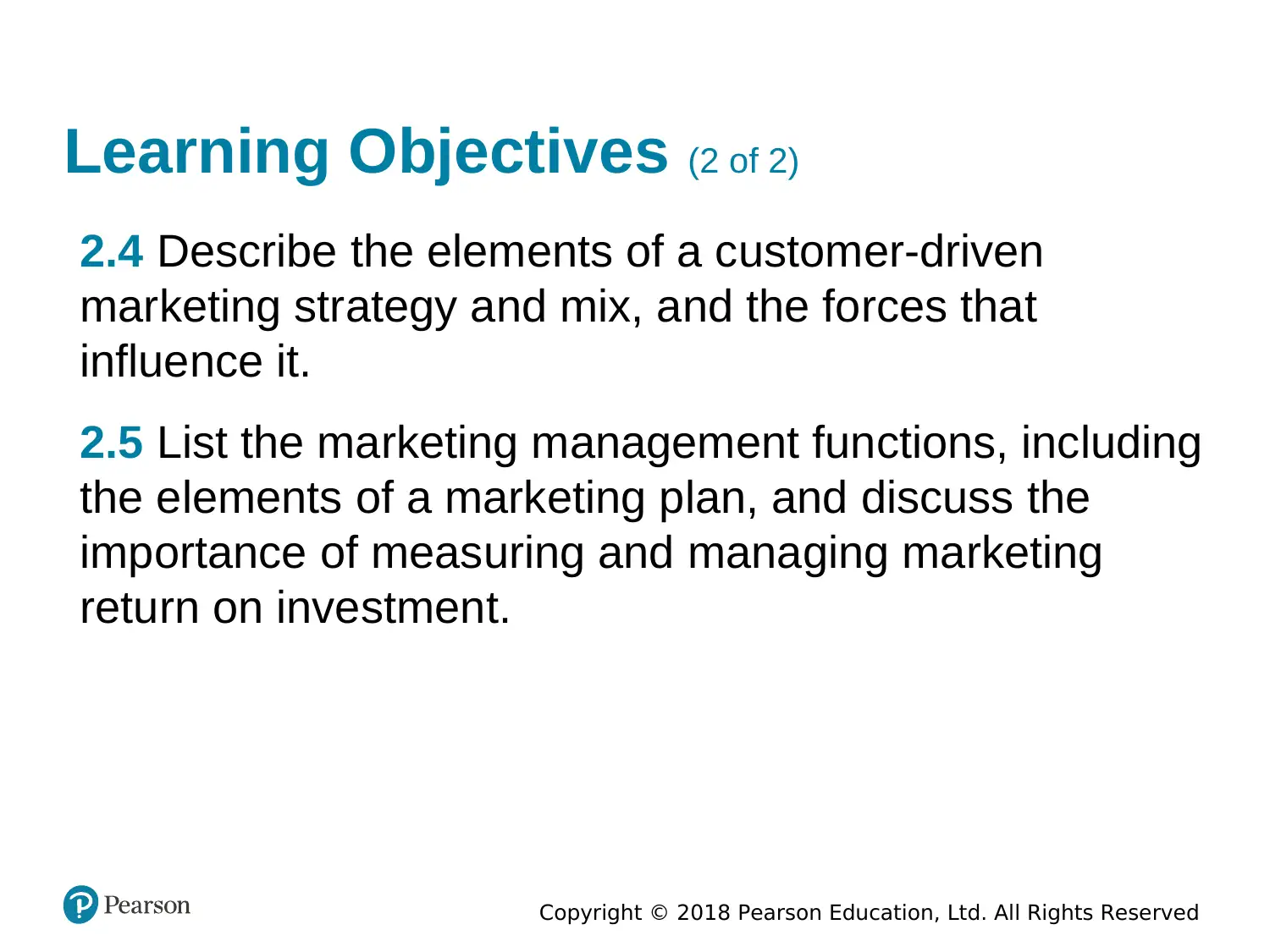
Copyright © 2018 Pearson Education, Ltd. All Rights Reserved
Learning Objectives (2 of 2)
• 2.4 Describe the elements of a customer-driven
marketing strategy and mix, and the forces that
influence it.
• 2.5 List the marketing management functions, including
the elements of a marketing plan, and discuss the
importance of measuring and managing marketing
return on investment.
Learning Objectives (2 of 2)
• 2.4 Describe the elements of a customer-driven
marketing strategy and mix, and the forces that
influence it.
• 2.5 List the marketing management functions, including
the elements of a marketing plan, and discuss the
importance of measuring and managing marketing
return on investment.
Paraphrase This Document
Need a fresh take? Get an instant paraphrase of this document with our AI Paraphraser
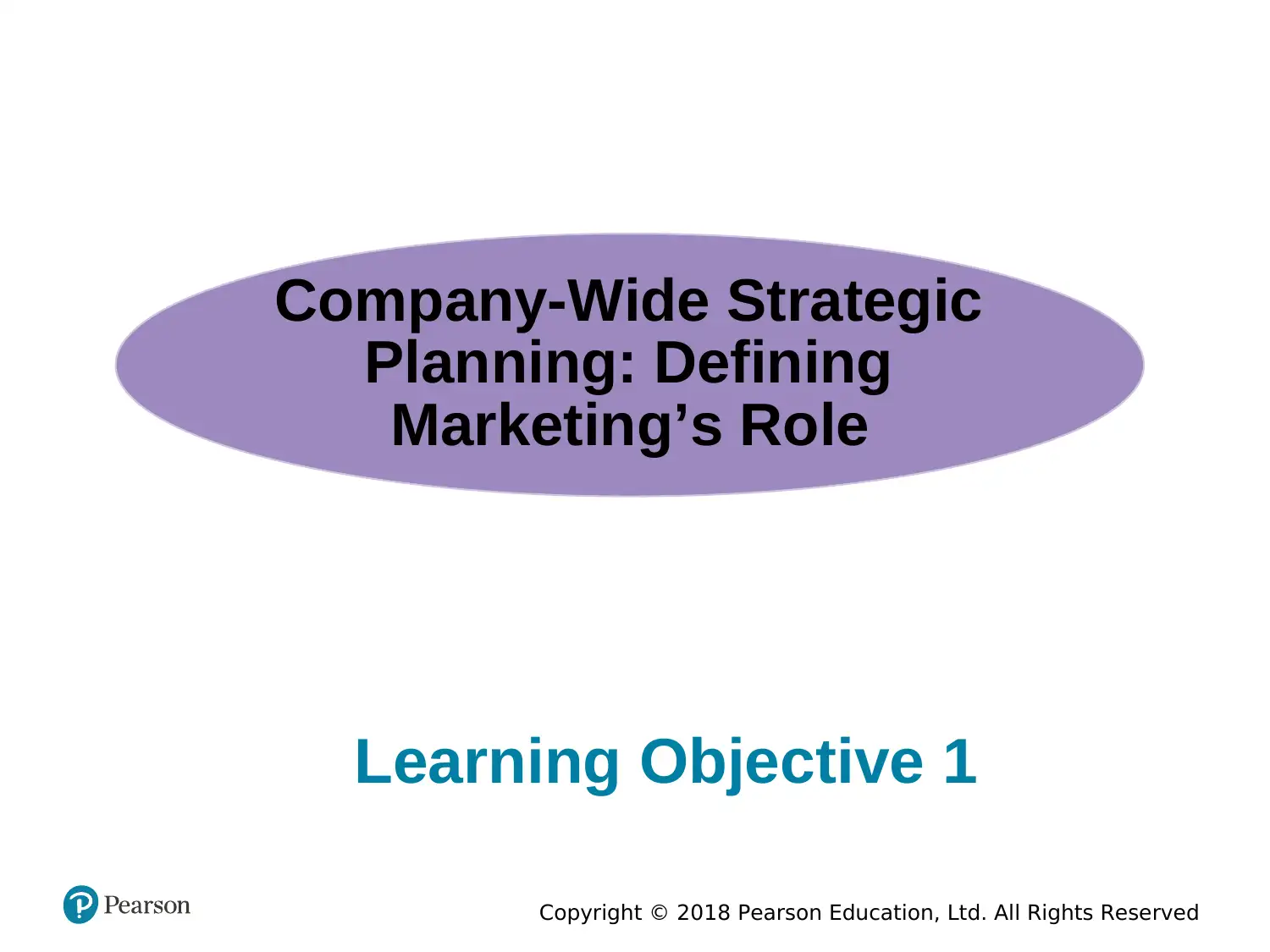
Copyright © 2018 Pearson Education, Ltd. All Rights Reserved
Company-Wide Strategic
Planning: Defining
Marketing’s Role
Learning Objective 1
Company-Wide Strategic
Planning: Defining
Marketing’s Role
Learning Objective 1
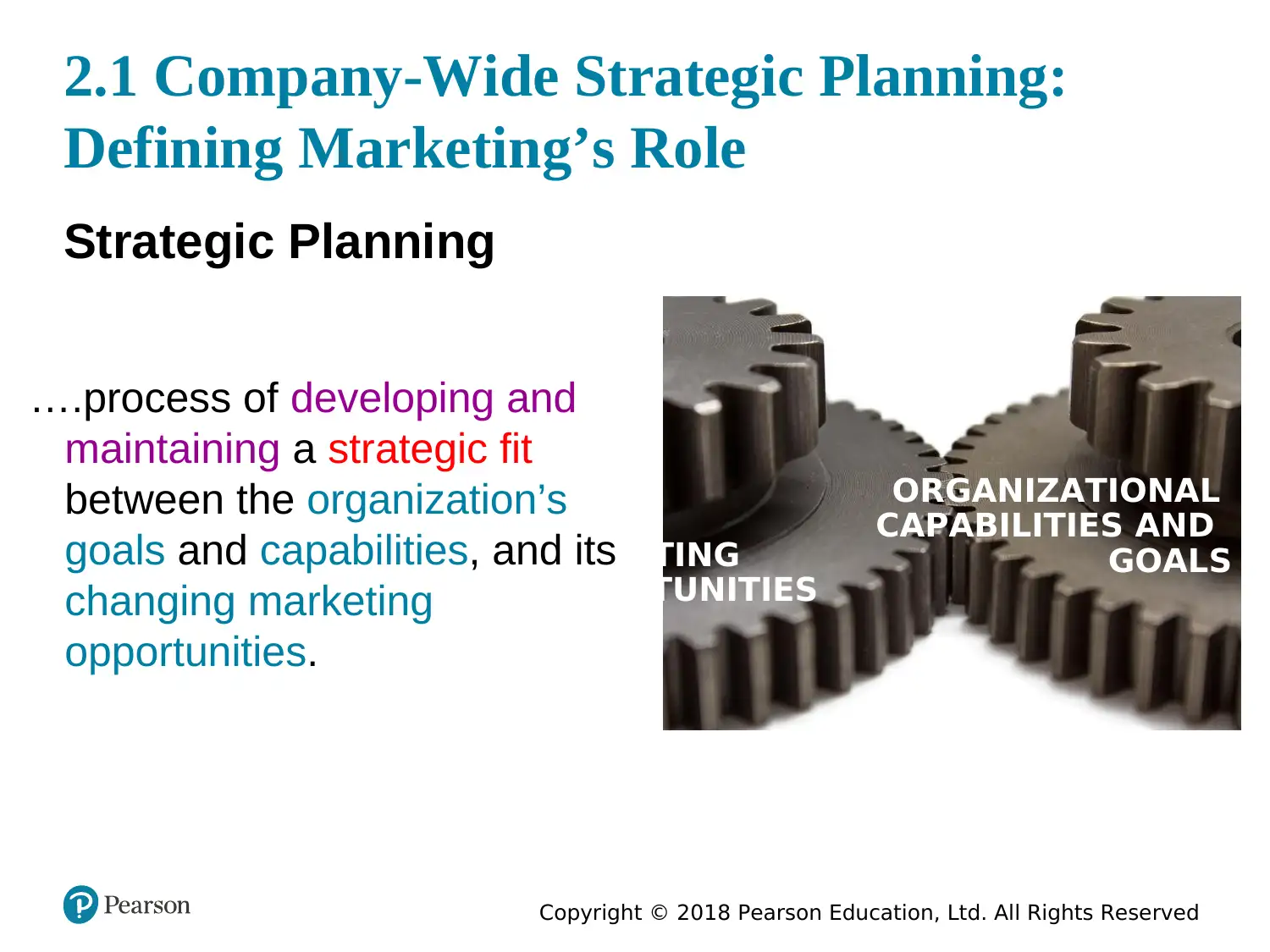
Copyright © 2018 Pearson Education, Ltd. All Rights Reserved
© 2012 Principles of Marketing: An
Asian Perspective
5
2.1 Company-Wide Strategic Planning:
Defining Marketing’s Role
Strategic Planning
MARKETING
OPPORTUNITIES
ORGANIZATIONAL
CAPABILITIES AND
GOALS
….process of developing and
maintaining a strategic fit
between the organization’s
goals and capabilities, and its
changing marketing
opportunities.
© 2012 Principles of Marketing: An
Asian Perspective
5
2.1 Company-Wide Strategic Planning:
Defining Marketing’s Role
Strategic Planning
MARKETING
OPPORTUNITIES
ORGANIZATIONAL
CAPABILITIES AND
GOALS
….process of developing and
maintaining a strategic fit
between the organization’s
goals and capabilities, and its
changing marketing
opportunities.
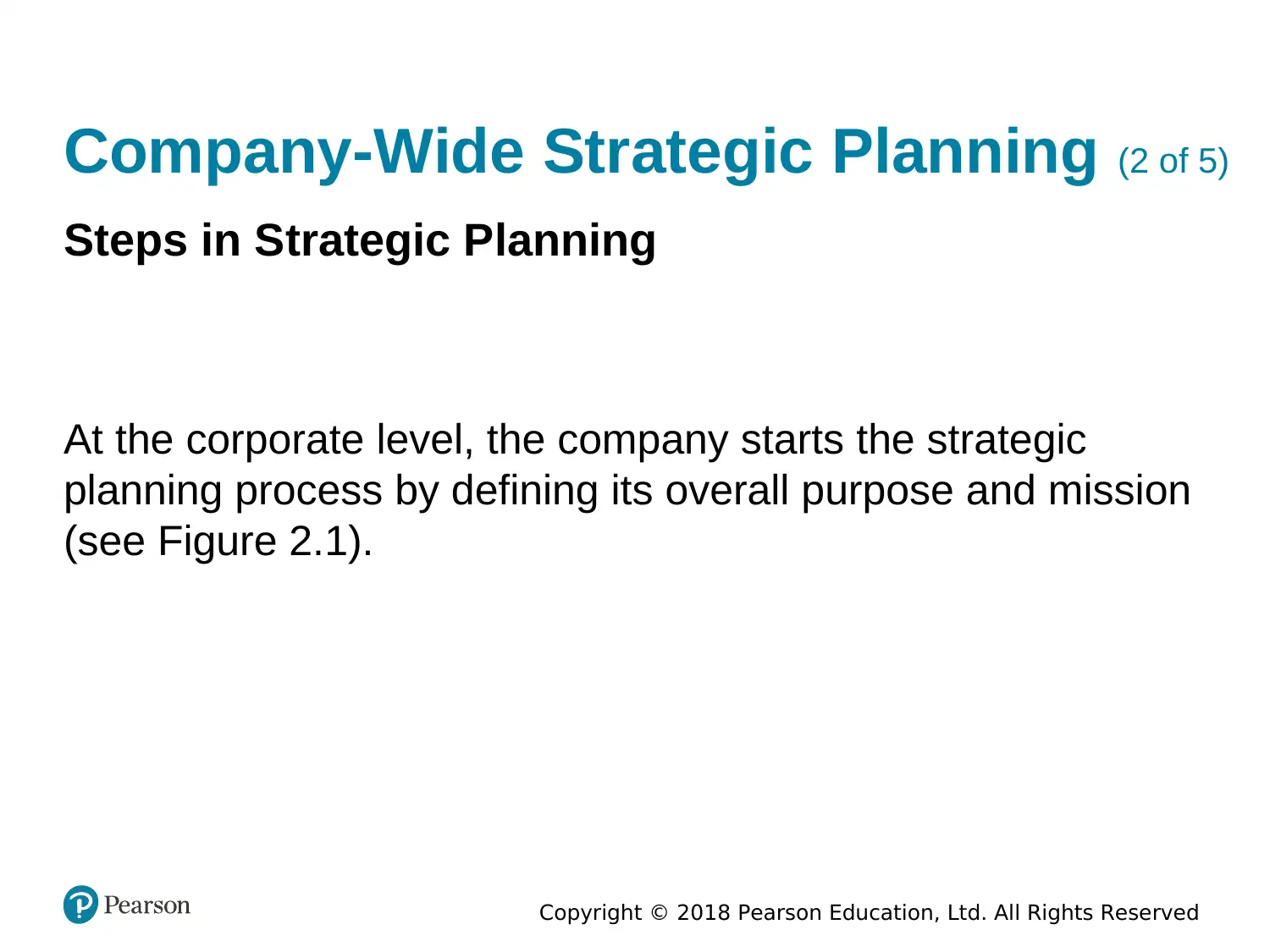
Copyright © 2018 Pearson Education, Ltd. All Rights Reserved
Company-Wide Strategic Planning (2 of 5)
Steps in Strategic Planning
At the corporate level, the company starts the strategic
planning process by defining its overall purpose and mission
(see Figure 2.1).
Company-Wide Strategic Planning (2 of 5)
Steps in Strategic Planning
At the corporate level, the company starts the strategic
planning process by defining its overall purpose and mission
(see Figure 2.1).
Secure Best Marks with AI Grader
Need help grading? Try our AI Grader for instant feedback on your assignments.
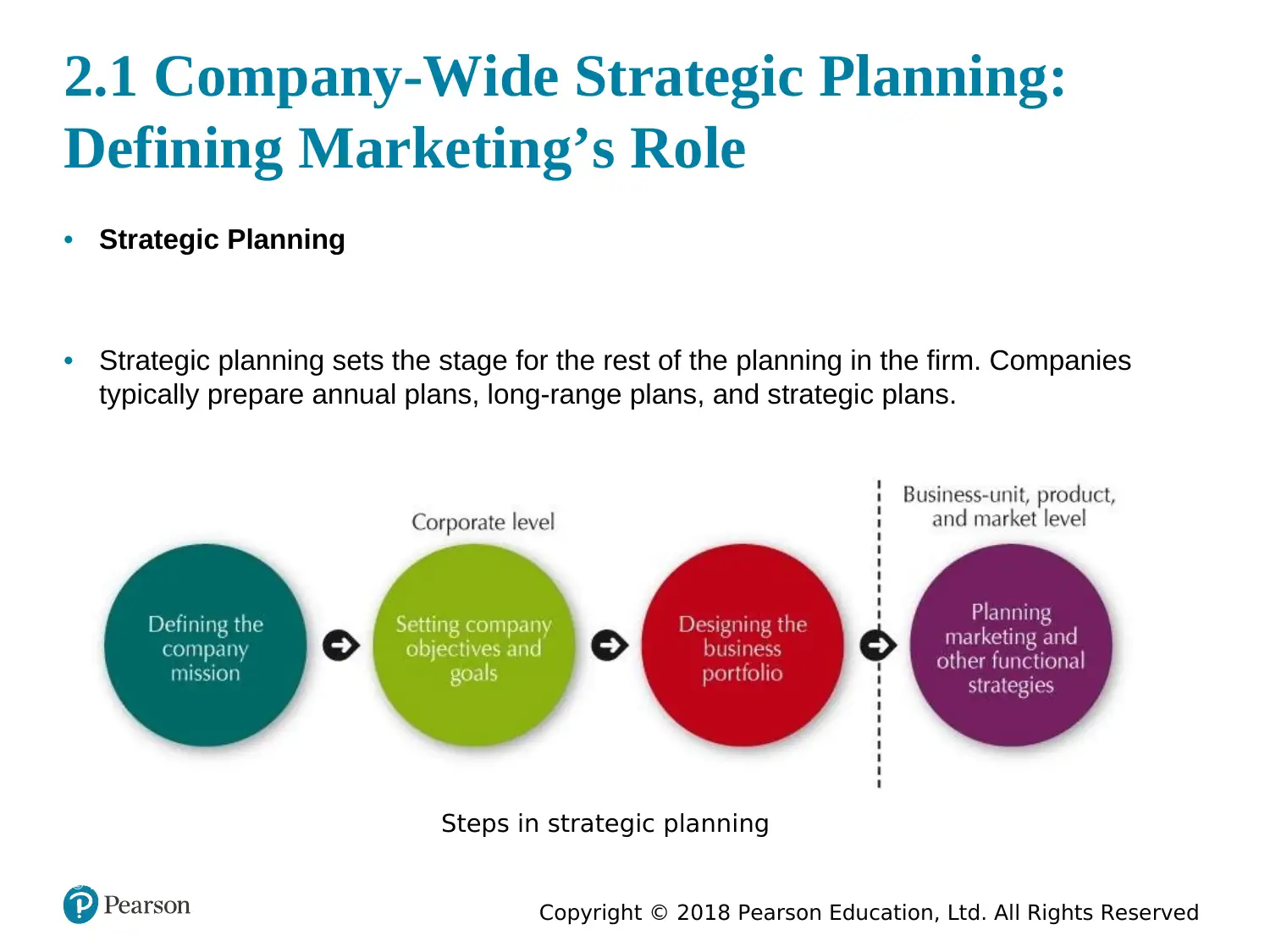
Copyright © 2018 Pearson Education, Ltd. All Rights Reserved
© 2012 Principles of Marketing: An Asian Perspective7
2.1 Company-Wide Strategic Planning:
Defining Marketing’s Role
• Strategic Planning
• Strategic planning sets the stage for the rest of the planning in the firm. Companies
typically prepare annual plans, long-range plans, and strategic plans.
Steps in strategic planning
© 2012 Principles of Marketing: An Asian Perspective7
2.1 Company-Wide Strategic Planning:
Defining Marketing’s Role
• Strategic Planning
• Strategic planning sets the stage for the rest of the planning in the firm. Companies
typically prepare annual plans, long-range plans, and strategic plans.
Steps in strategic planning
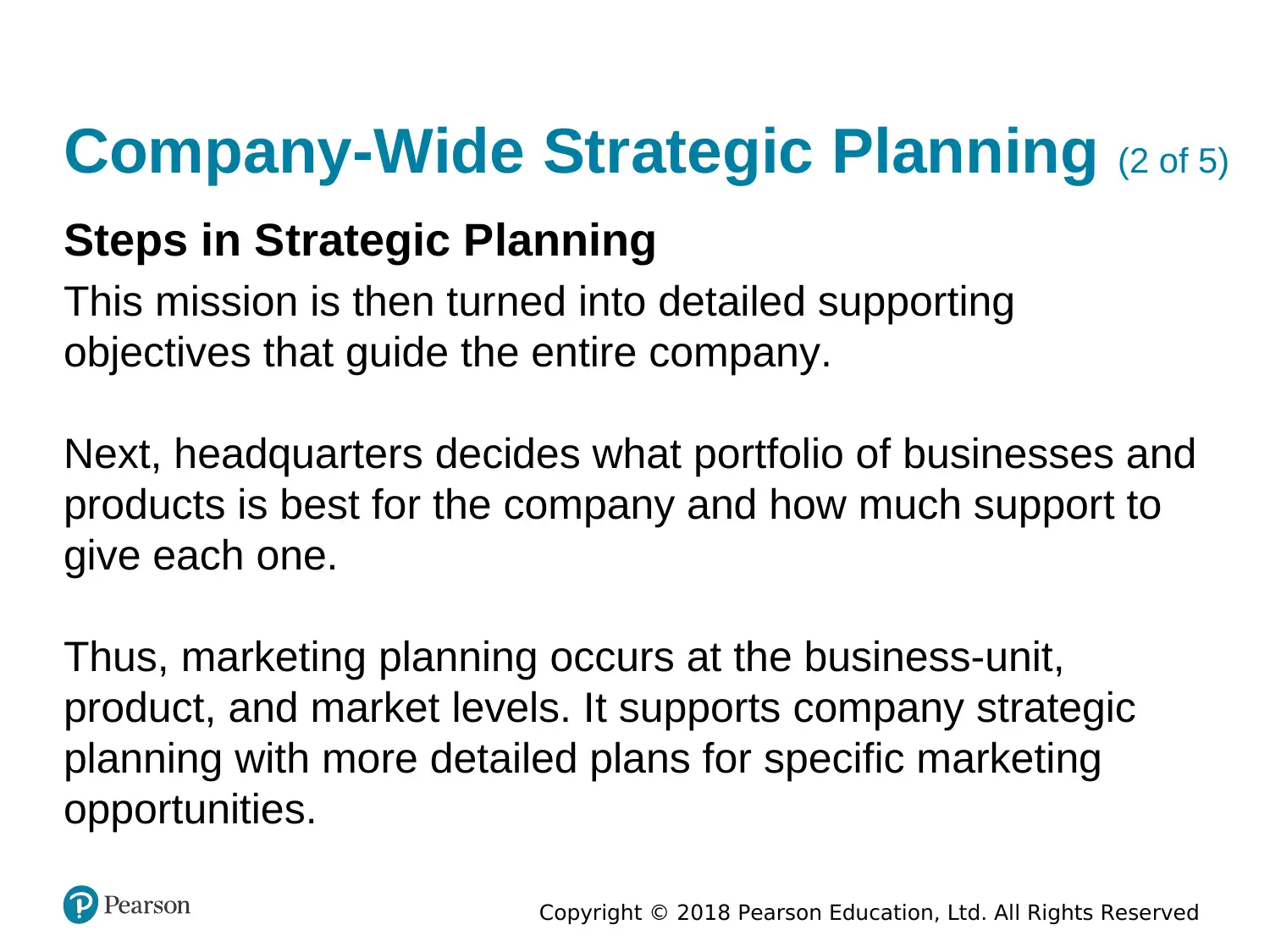
Copyright © 2018 Pearson Education, Ltd. All Rights Reserved
Company-Wide Strategic Planning (2 of 5)
Steps in Strategic Planning
This mission is then turned into detailed supporting
objectives that guide the entire company.
Next, headquarters decides what portfolio of businesses and
products is best for the company and how much support to
give each one.
Thus, marketing planning occurs at the business-unit,
product, and market levels. It supports company strategic
planning with more detailed plans for specific marketing
opportunities.
Company-Wide Strategic Planning (2 of 5)
Steps in Strategic Planning
This mission is then turned into detailed supporting
objectives that guide the entire company.
Next, headquarters decides what portfolio of businesses and
products is best for the company and how much support to
give each one.
Thus, marketing planning occurs at the business-unit,
product, and market levels. It supports company strategic
planning with more detailed plans for specific marketing
opportunities.
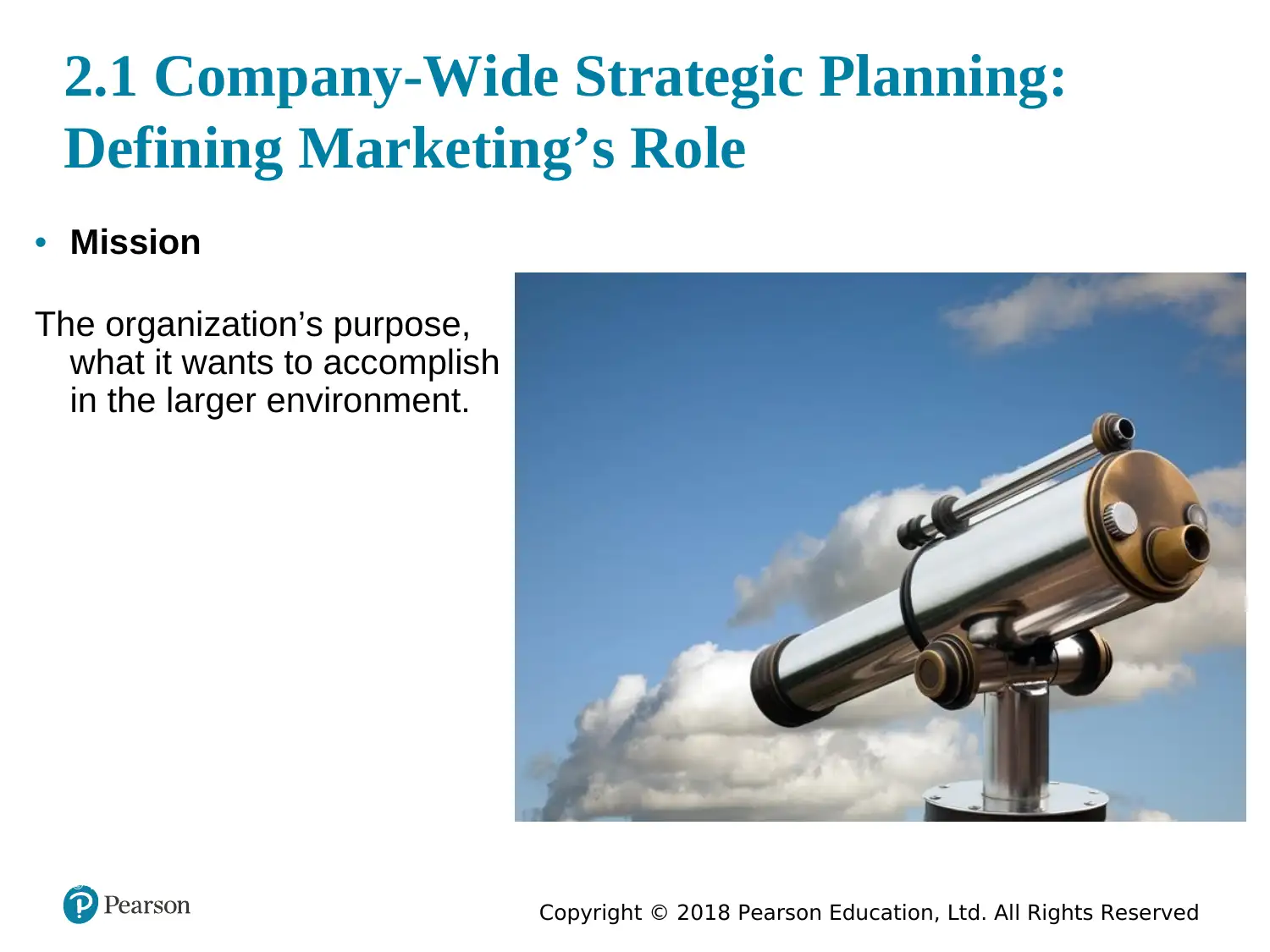
Copyright © 2018 Pearson Education, Ltd. All Rights Reserved
© 2012 Principles of Marketing: An Asian Perspective9
2.1 Company-Wide Strategic Planning:
Defining Marketing’s Role
• Mission
The organization’s purpose,
what it wants to accomplish
in the larger environment.
© 2012 Principles of Marketing: An Asian Perspective9
2.1 Company-Wide Strategic Planning:
Defining Marketing’s Role
• Mission
The organization’s purpose,
what it wants to accomplish
in the larger environment.
Paraphrase This Document
Need a fresh take? Get an instant paraphrase of this document with our AI Paraphraser
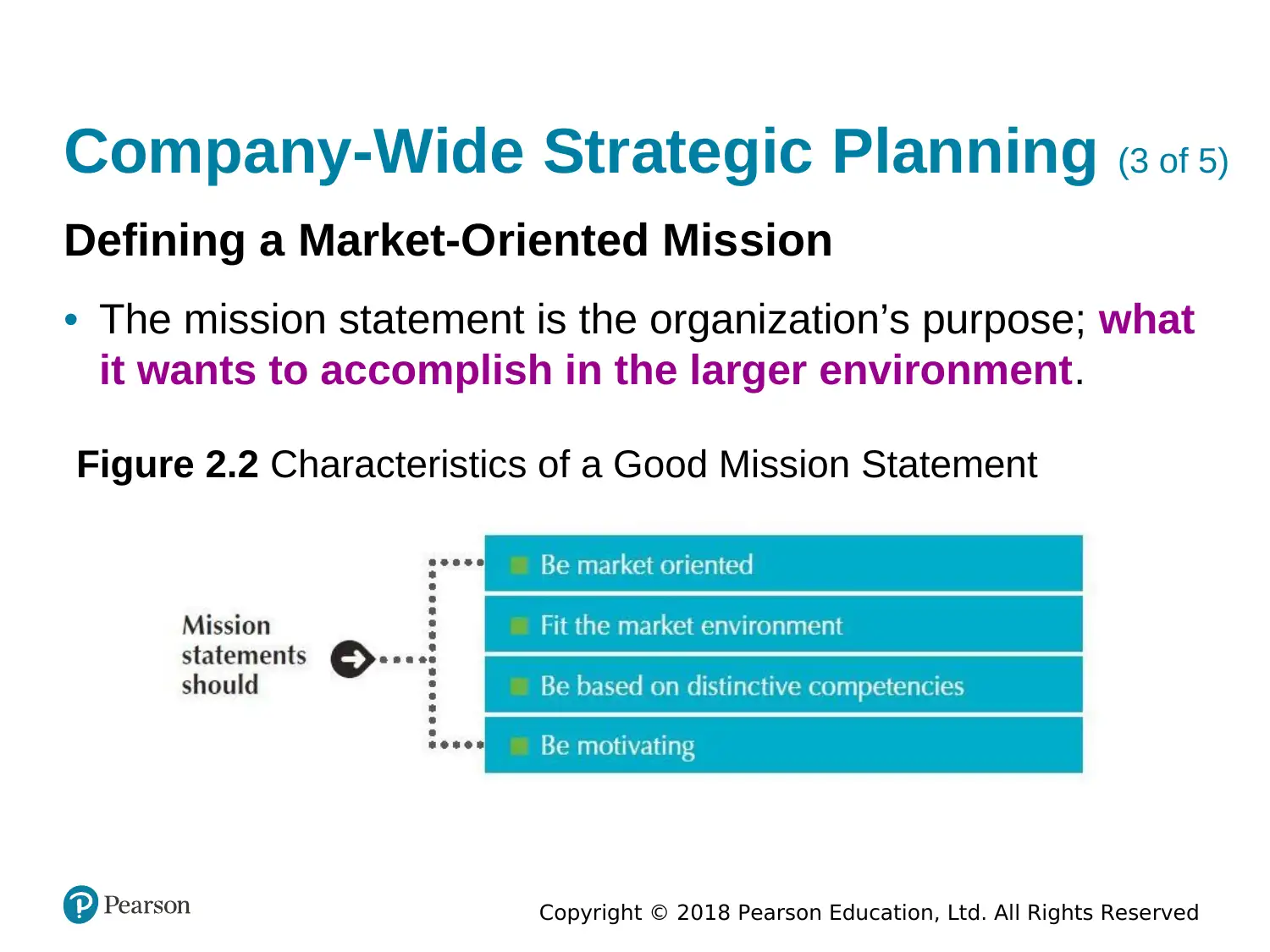
Copyright © 2018 Pearson Education, Ltd. All Rights Reserved
Company-Wide Strategic Planning (3 of 5)
Defining a Market-Oriented Mission
• The mission statement is the organization’s purpose; what
it wants to accomplish in the larger environment.
Figure 2.2 Characteristics of a Good Mission Statement
Company-Wide Strategic Planning (3 of 5)
Defining a Market-Oriented Mission
• The mission statement is the organization’s purpose; what
it wants to accomplish in the larger environment.
Figure 2.2 Characteristics of a Good Mission Statement
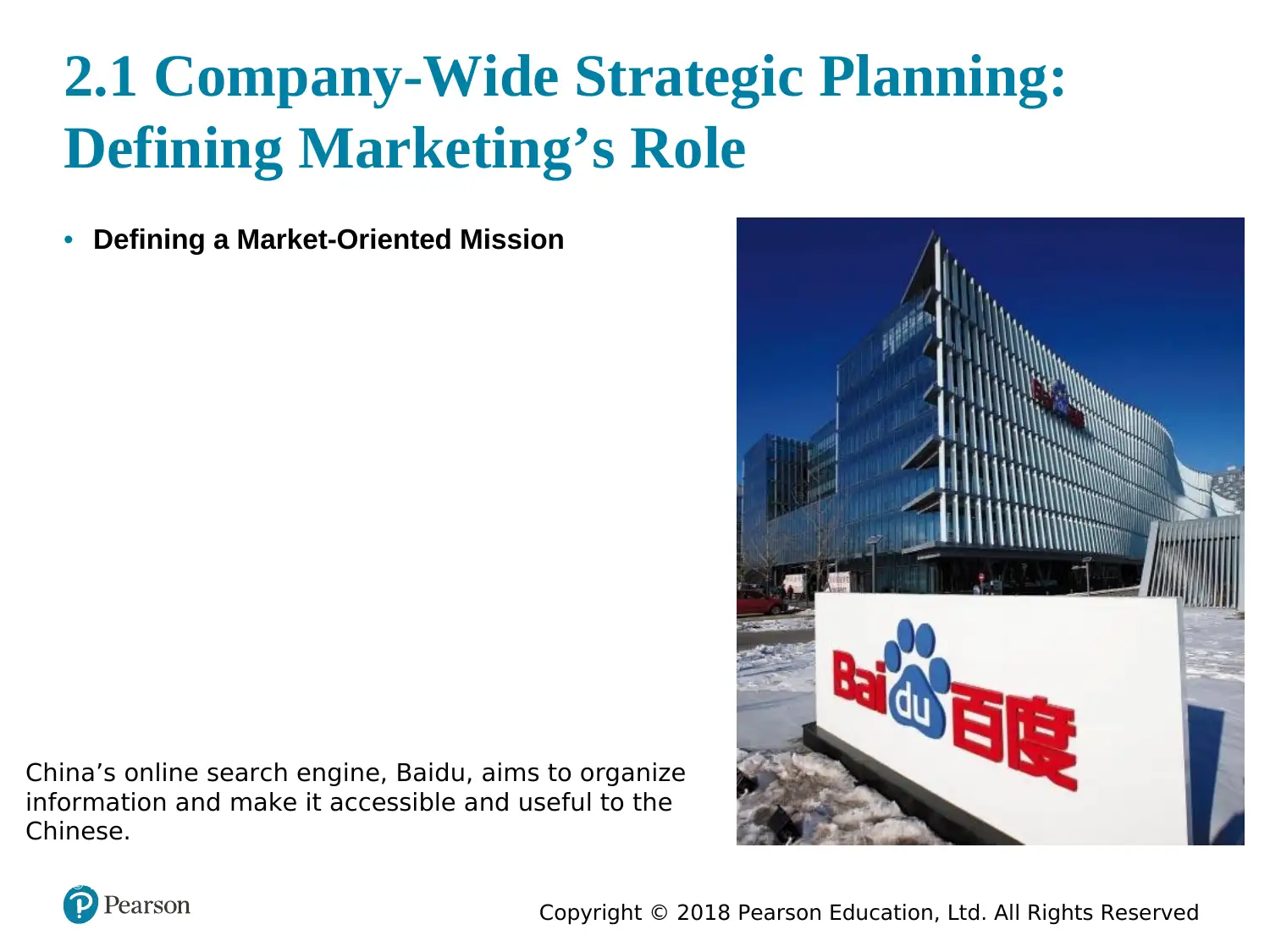
Copyright © 2018 Pearson Education, Ltd. All Rights Reserved
© 2012 Principles of Marketing: An Asian Perspective11
2.1 Company-Wide Strategic Planning:
Defining Marketing’s Role
• Defining a Market-Oriented Mission
China’s online search engine, Baidu, aims to organize
information and make it accessible and useful to the
Chinese.
© 2012 Principles of Marketing: An Asian Perspective11
2.1 Company-Wide Strategic Planning:
Defining Marketing’s Role
• Defining a Market-Oriented Mission
China’s online search engine, Baidu, aims to organize
information and make it accessible and useful to the
Chinese.
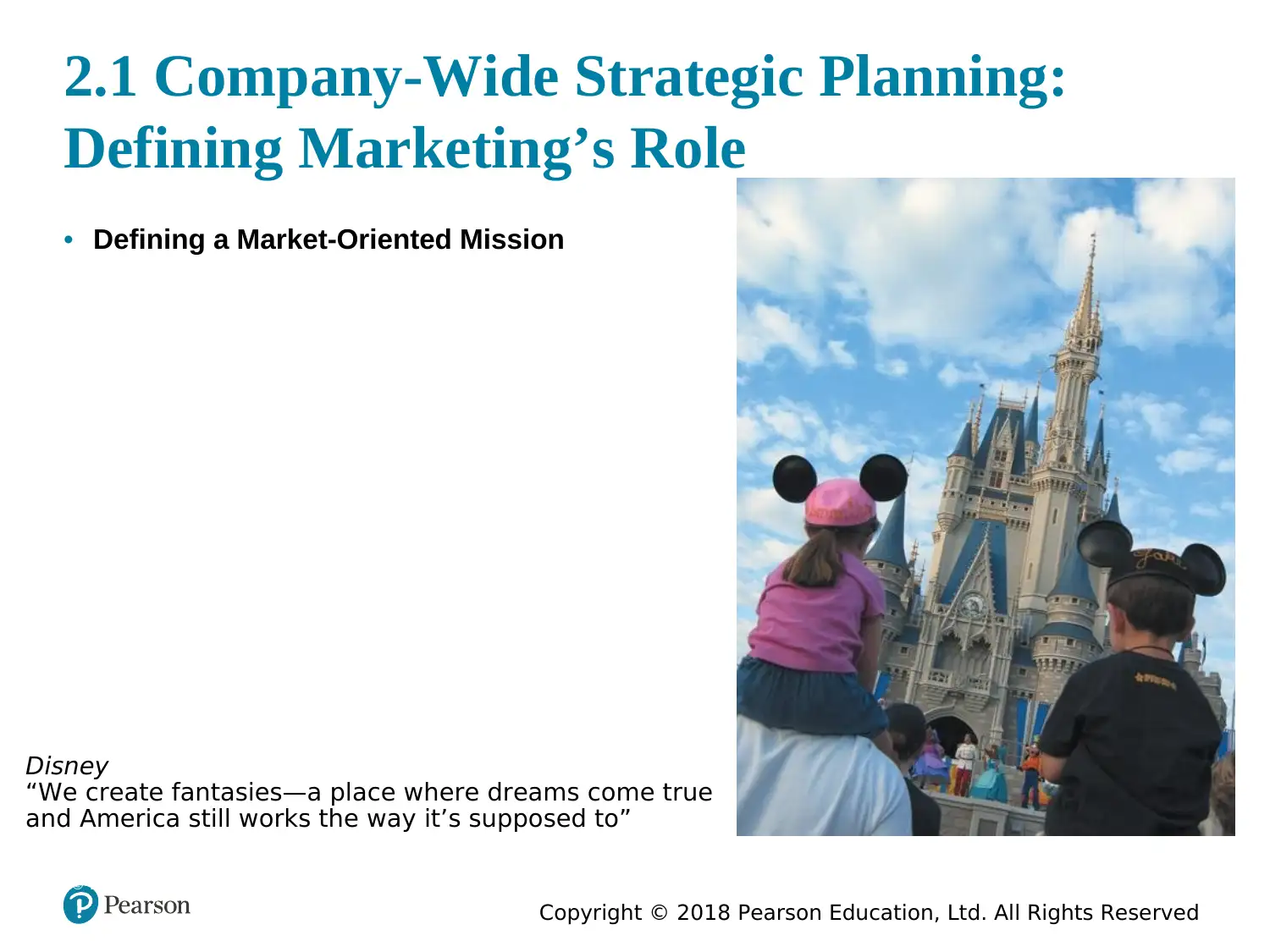
Copyright © 2018 Pearson Education, Ltd. All Rights Reserved
© 2012 Principles of Marketing: An Asian Perspective12
2.1 Company-Wide Strategic Planning:
Defining Marketing’s Role
• Defining a Market-Oriented Mission
Disney
“We create fantasies—a place where dreams come true
and America still works the way it’s supposed to”
© 2012 Principles of Marketing: An Asian Perspective12
2.1 Company-Wide Strategic Planning:
Defining Marketing’s Role
• Defining a Market-Oriented Mission
Disney
“We create fantasies—a place where dreams come true
and America still works the way it’s supposed to”
Secure Best Marks with AI Grader
Need help grading? Try our AI Grader for instant feedback on your assignments.
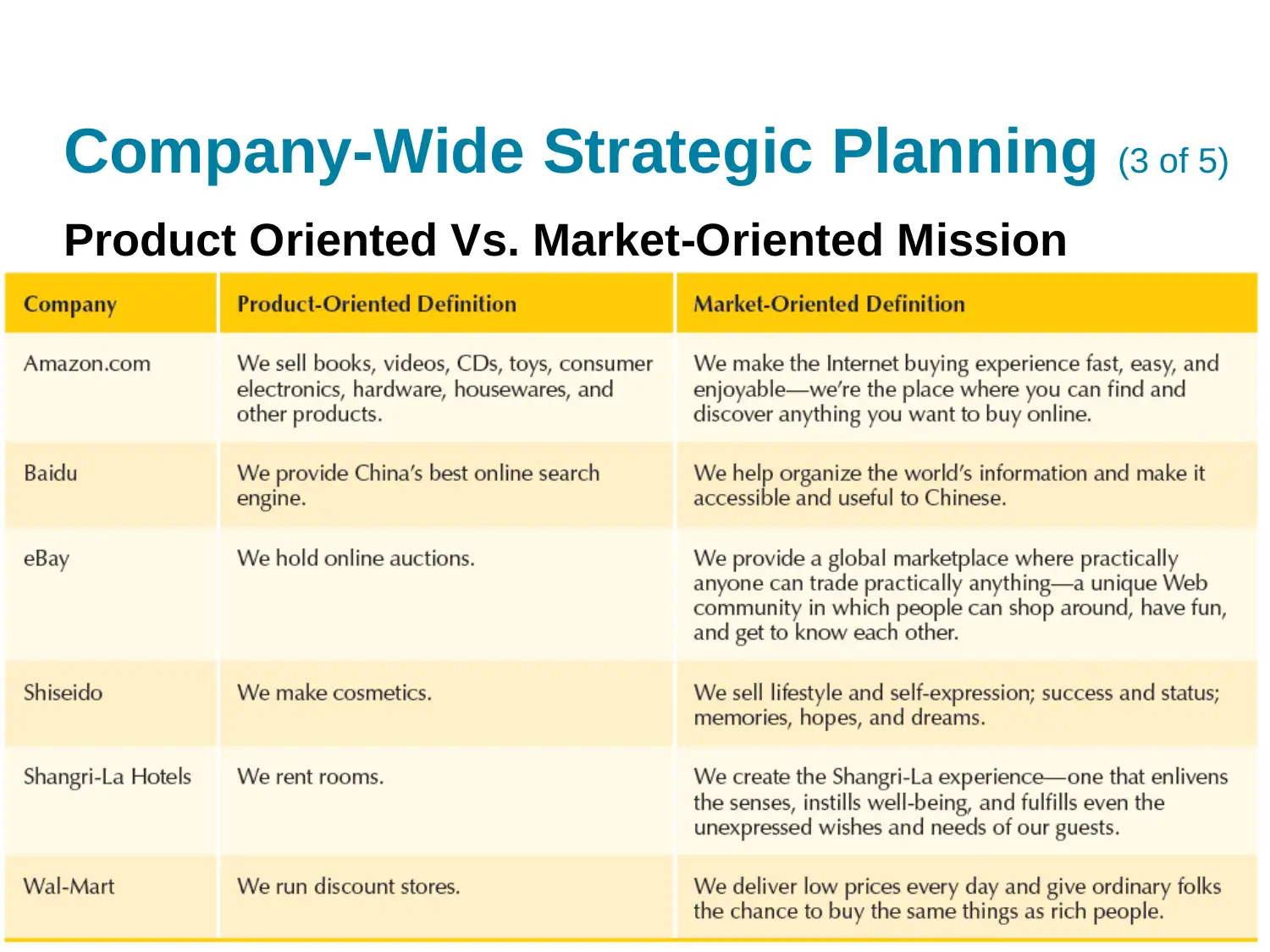
Copyright © 2018 Pearson Education, Ltd. All Rights Reserved
Company-Wide Strategic Planning (3 of 5)
Product Oriented Vs. Market-Oriented Mission
Company-Wide Strategic Planning (3 of 5)
Product Oriented Vs. Market-Oriented Mission
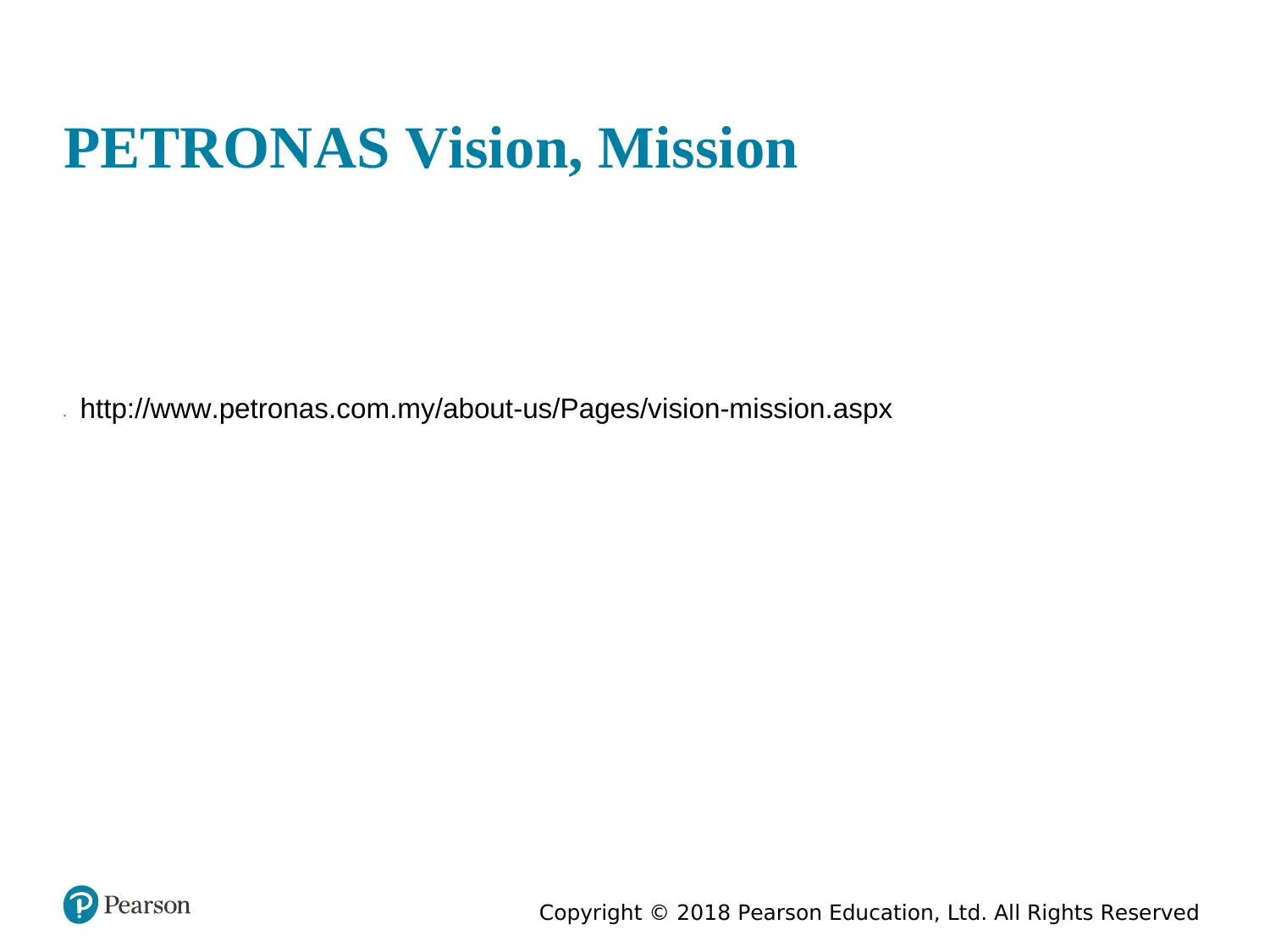
Copyright © 2018 Pearson Education, Ltd. All Rights Reserved
PETRONAS Vision, Mission
• http://www.petronas.com.my/about-us/Pages/vision-mission.aspx
PETRONAS Vision, Mission
• http://www.petronas.com.my/about-us/Pages/vision-mission.aspx
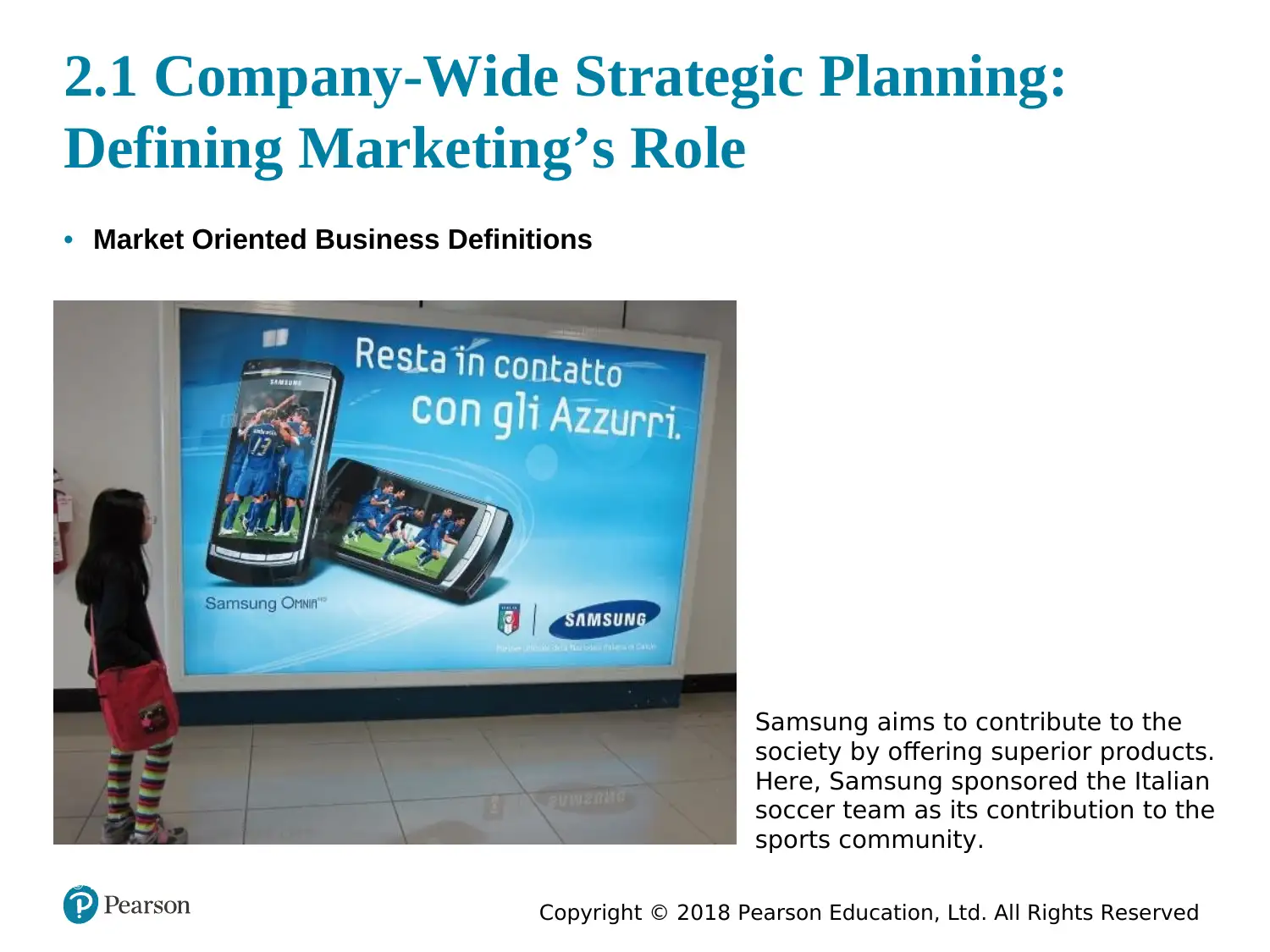
Copyright © 2018 Pearson Education, Ltd. All Rights Reserved
© 2012 Principles of Marketing: An Asian Perspective15
2.1 Company-Wide Strategic Planning:
Defining Marketing’s Role
• Market Oriented Business Definitions
Samsung aims to contribute to the
society by offering superior products.
Here, Samsung sponsored the Italian
soccer team as its contribution to the
sports community.
© 2012 Principles of Marketing: An Asian Perspective15
2.1 Company-Wide Strategic Planning:
Defining Marketing’s Role
• Market Oriented Business Definitions
Samsung aims to contribute to the
society by offering superior products.
Here, Samsung sponsored the Italian
soccer team as its contribution to the
sports community.
Paraphrase This Document
Need a fresh take? Get an instant paraphrase of this document with our AI Paraphraser
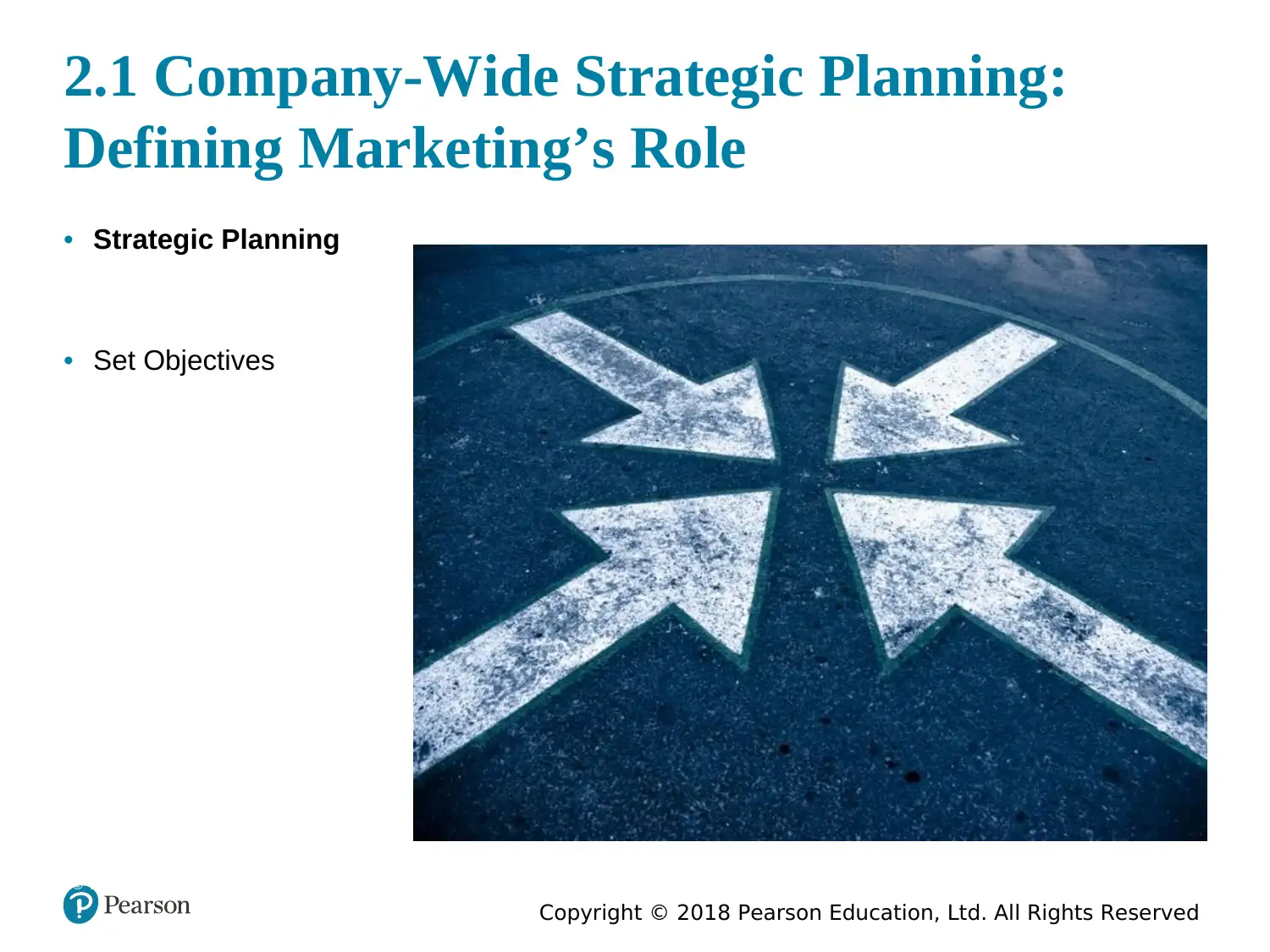
Copyright © 2018 Pearson Education, Ltd. All Rights Reserved
© 2012 Principles of Marketing: An Asian Perspective16
2.1 Company-Wide Strategic Planning:
Defining Marketing’s Role
• Strategic Planning
• Set Objectives
© 2012 Principles of Marketing: An Asian Perspective16
2.1 Company-Wide Strategic Planning:
Defining Marketing’s Role
• Strategic Planning
• Set Objectives
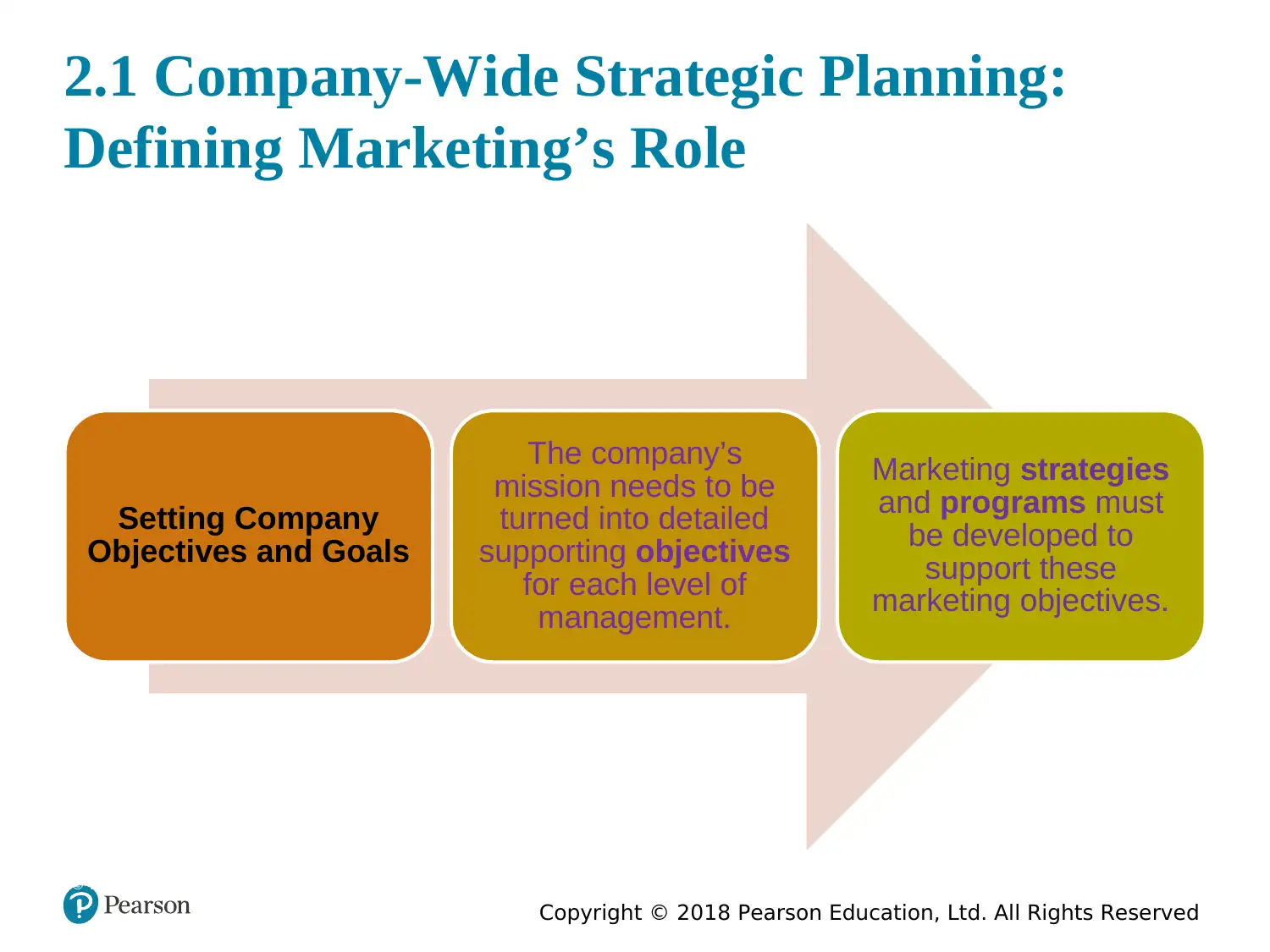
Copyright © 2018 Pearson Education, Ltd. All Rights Reserved
© 2012 Principles of Marketing: An Asian Perspective17
2.1 Company-Wide Strategic Planning:
Defining Marketing’s Role
Setting Company
Objectives and Goals
The company’s
mission needs to be
turned into detailed
supporting objectives
for each level of
management.
Marketing strategies
and programs must
be developed to
support these
marketing objectives.
© 2012 Principles of Marketing: An Asian Perspective17
2.1 Company-Wide Strategic Planning:
Defining Marketing’s Role
Setting Company
Objectives and Goals
The company’s
mission needs to be
turned into detailed
supporting objectives
for each level of
management.
Marketing strategies
and programs must
be developed to
support these
marketing objectives.
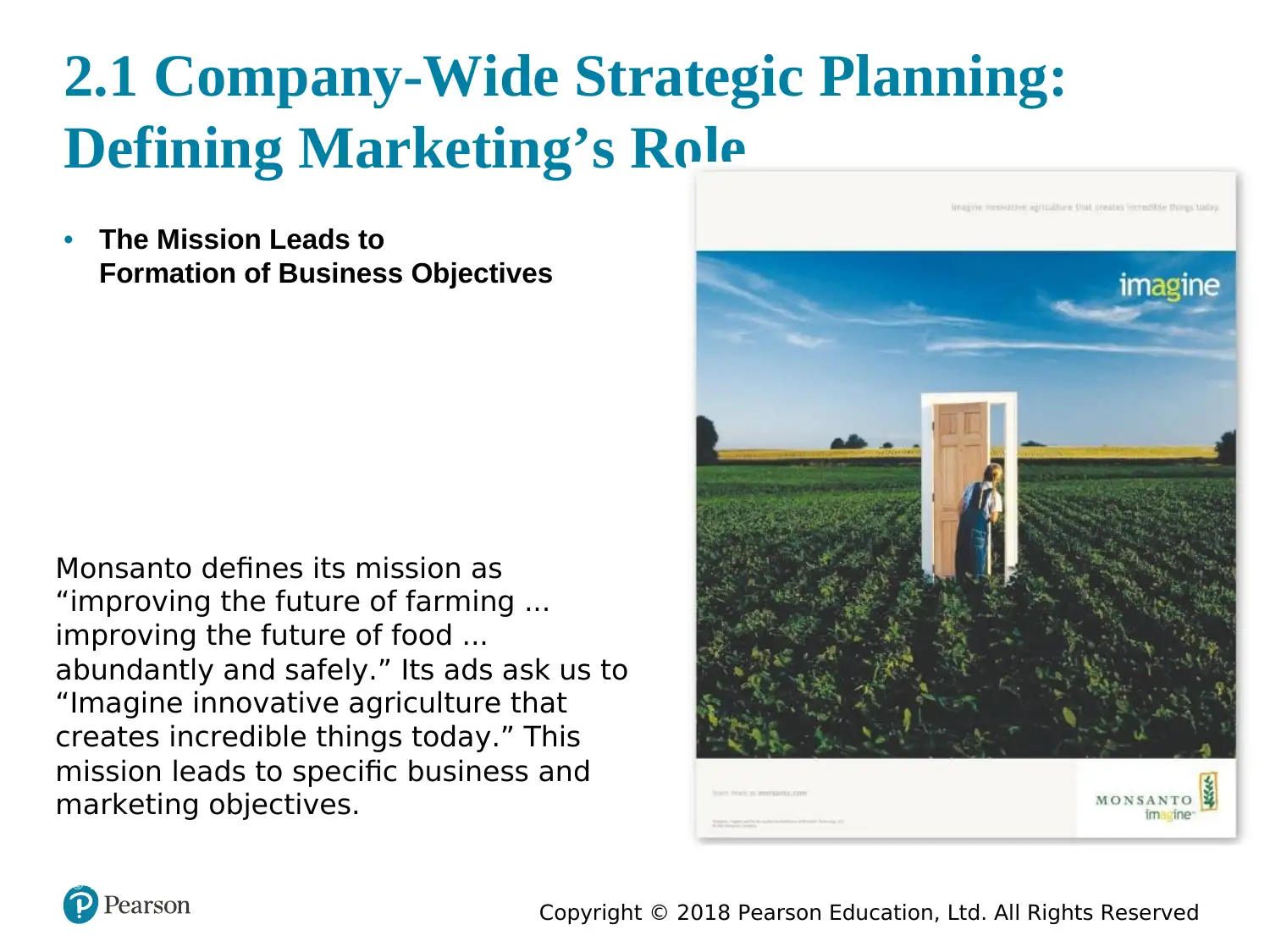
Copyright © 2018 Pearson Education, Ltd. All Rights Reserved
© 2012 Principles of Marketing: An Asian Perspective18
2.1 Company-Wide Strategic Planning:
Defining Marketing’s Role
• The Mission Leads to
Formation of Business Objectives
Monsanto defines its mission as
“improving the future of farming ...
improving the future of food ...
abundantly and safely.” Its ads ask us to
“Imagine innovative agriculture that
creates incredible things today.” This
mission leads to specific business and
marketing objectives.
© 2012 Principles of Marketing: An Asian Perspective18
2.1 Company-Wide Strategic Planning:
Defining Marketing’s Role
• The Mission Leads to
Formation of Business Objectives
Monsanto defines its mission as
“improving the future of farming ...
improving the future of food ...
abundantly and safely.” Its ads ask us to
“Imagine innovative agriculture that
creates incredible things today.” This
mission leads to specific business and
marketing objectives.
Secure Best Marks with AI Grader
Need help grading? Try our AI Grader for instant feedback on your assignments.
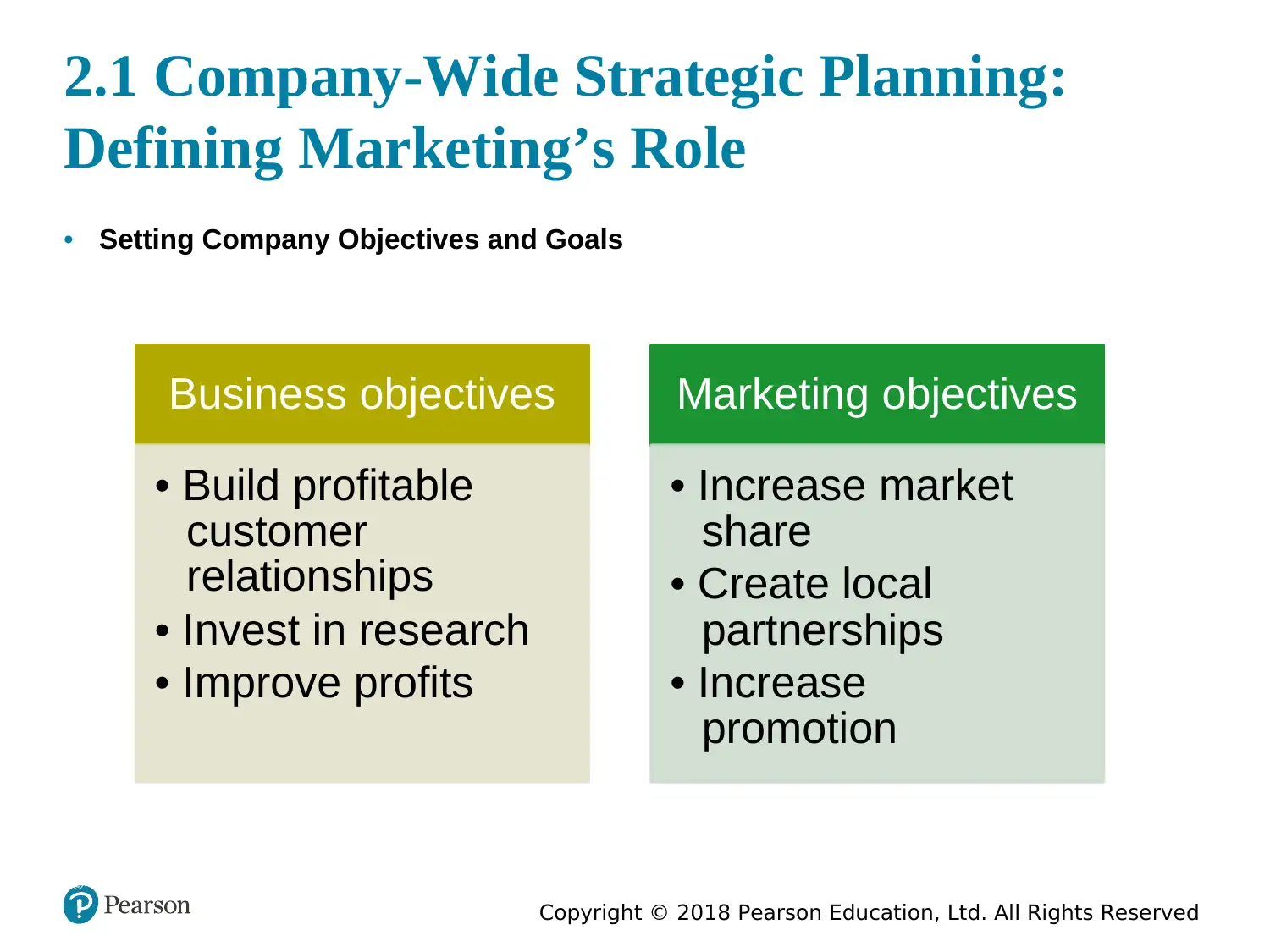
Copyright © 2018 Pearson Education, Ltd. All Rights Reserved
© 2012 Principles of Marketing: An Asian Perspective19
2.1 Company-Wide Strategic Planning:
Defining Marketing’s Role
• Setting Company Objectives and Goals
Business objectives
• Build profitable
customer
relationships
• Invest in research
• Improve profits
Marketing objectives
• Increase market
share
• Create local
partnerships
• Increase
promotion
© 2012 Principles of Marketing: An Asian Perspective19
2.1 Company-Wide Strategic Planning:
Defining Marketing’s Role
• Setting Company Objectives and Goals
Business objectives
• Build profitable
customer
relationships
• Invest in research
• Improve profits
Marketing objectives
• Increase market
share
• Create local
partnerships
• Increase
promotion
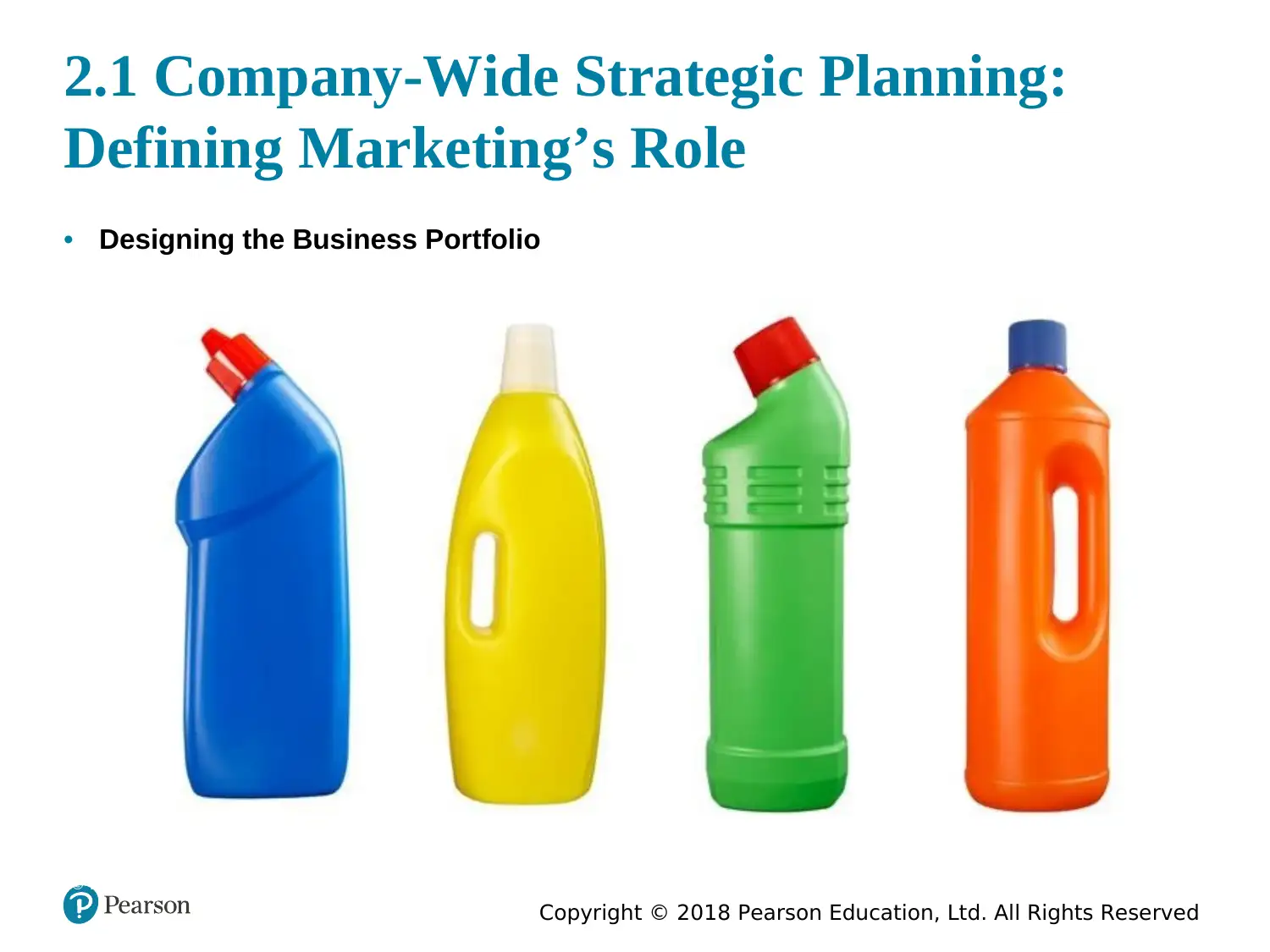
Copyright © 2018 Pearson Education, Ltd. All Rights Reserved
© 2012 Principles of Marketing: An Asian Perspective20
2.1 Company-Wide Strategic Planning:
Defining Marketing’s Role
• Designing the Business Portfolio
© 2012 Principles of Marketing: An Asian Perspective20
2.1 Company-Wide Strategic Planning:
Defining Marketing’s Role
• Designing the Business Portfolio
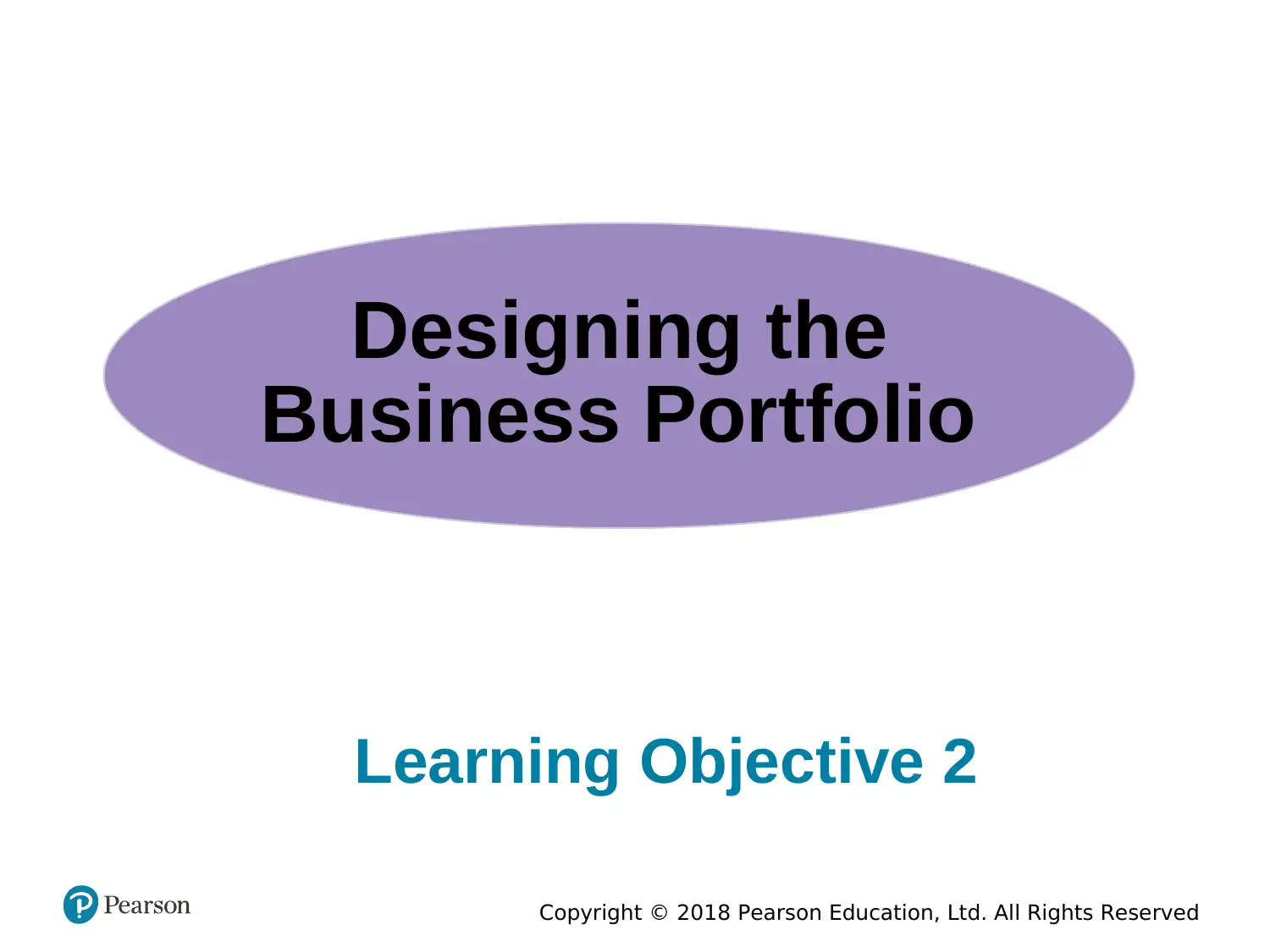
Copyright © 2018 Pearson Education, Ltd. All Rights Reserved
Designing the
Business Portfolio
Learning Objective 2
Designing the
Business Portfolio
Learning Objective 2
Paraphrase This Document
Need a fresh take? Get an instant paraphrase of this document with our AI Paraphraser
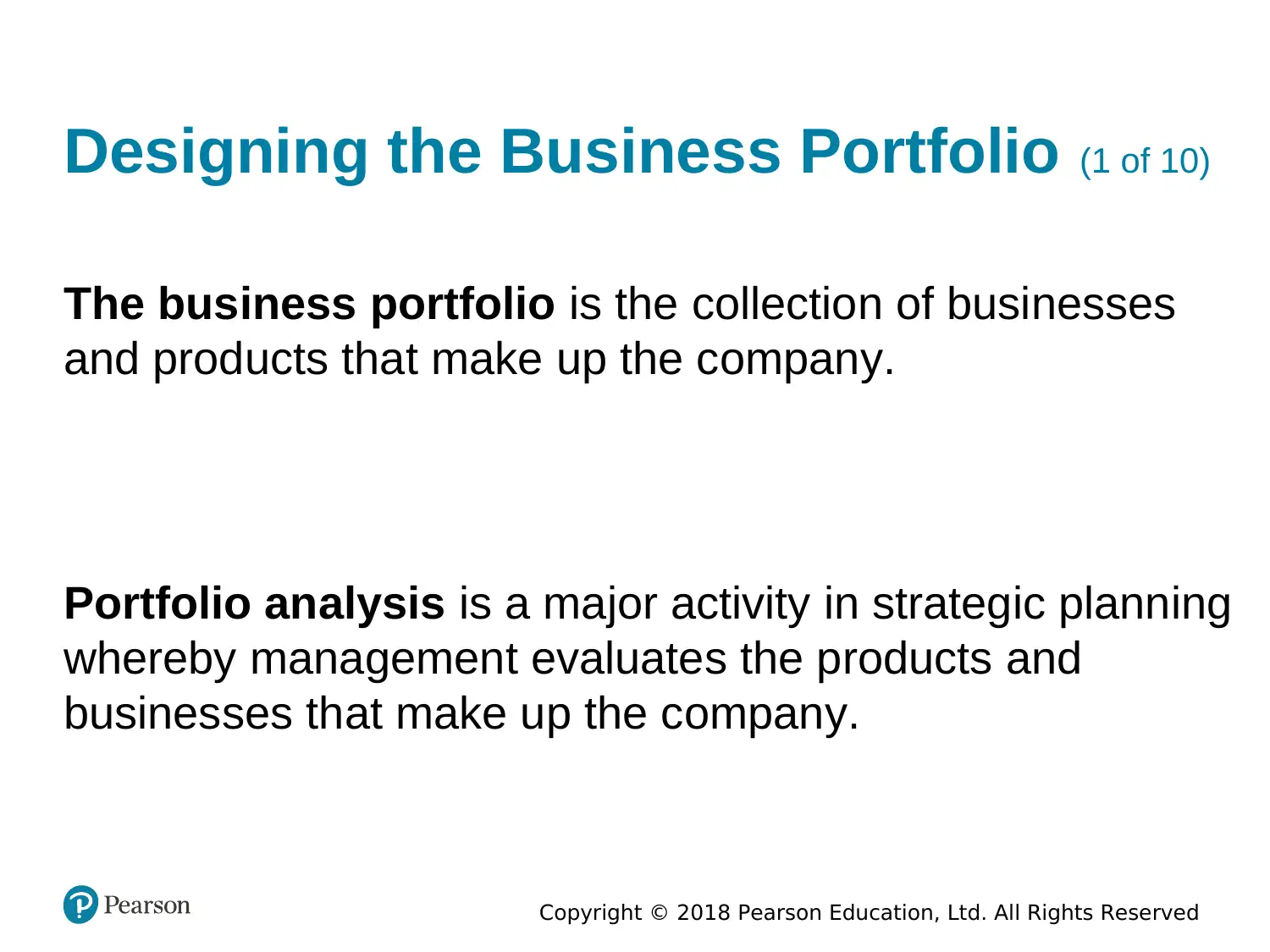
Copyright © 2018 Pearson Education, Ltd. All Rights Reserved
Designing the Business Portfolio (1 of 10)
The business portfolio is the collection of businesses
and products that make up the company.
Portfolio analysis is a major activity in strategic planning
whereby management evaluates the products and
businesses that make up the company.
Designing the Business Portfolio (1 of 10)
The business portfolio is the collection of businesses
and products that make up the company.
Portfolio analysis is a major activity in strategic planning
whereby management evaluates the products and
businesses that make up the company.
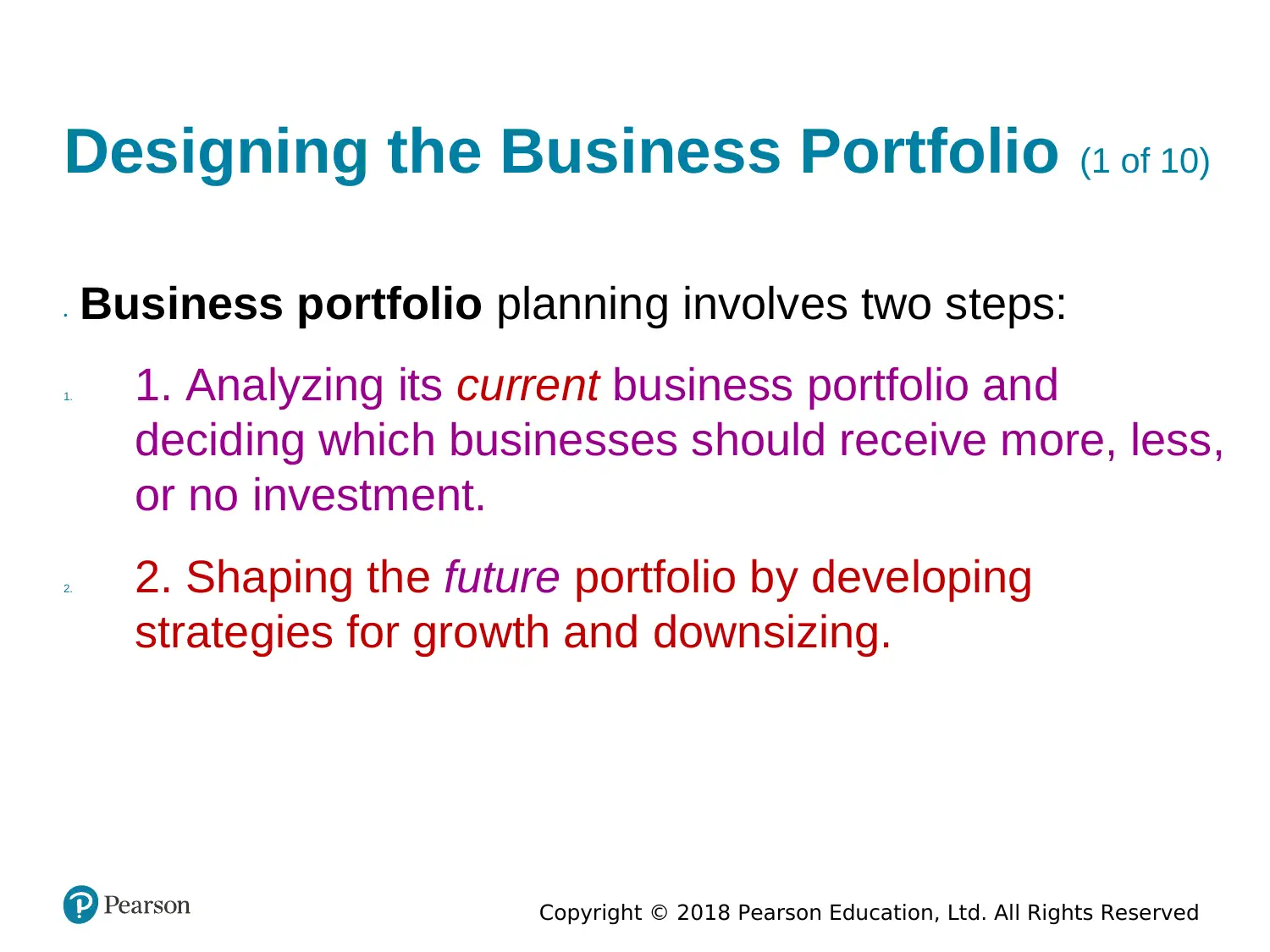
Copyright © 2018 Pearson Education, Ltd. All Rights Reserved
Designing the Business Portfolio (1 of 10)
• Business portfolio planning involves two steps:
1. 1. Analyzing its current business portfolio and
deciding which businesses should receive more, less,
or no investment.
2. 2. Shaping the future portfolio by developing
strategies for growth and downsizing.
Designing the Business Portfolio (1 of 10)
• Business portfolio planning involves two steps:
1. 1. Analyzing its current business portfolio and
deciding which businesses should receive more, less,
or no investment.
2. 2. Shaping the future portfolio by developing
strategies for growth and downsizing.
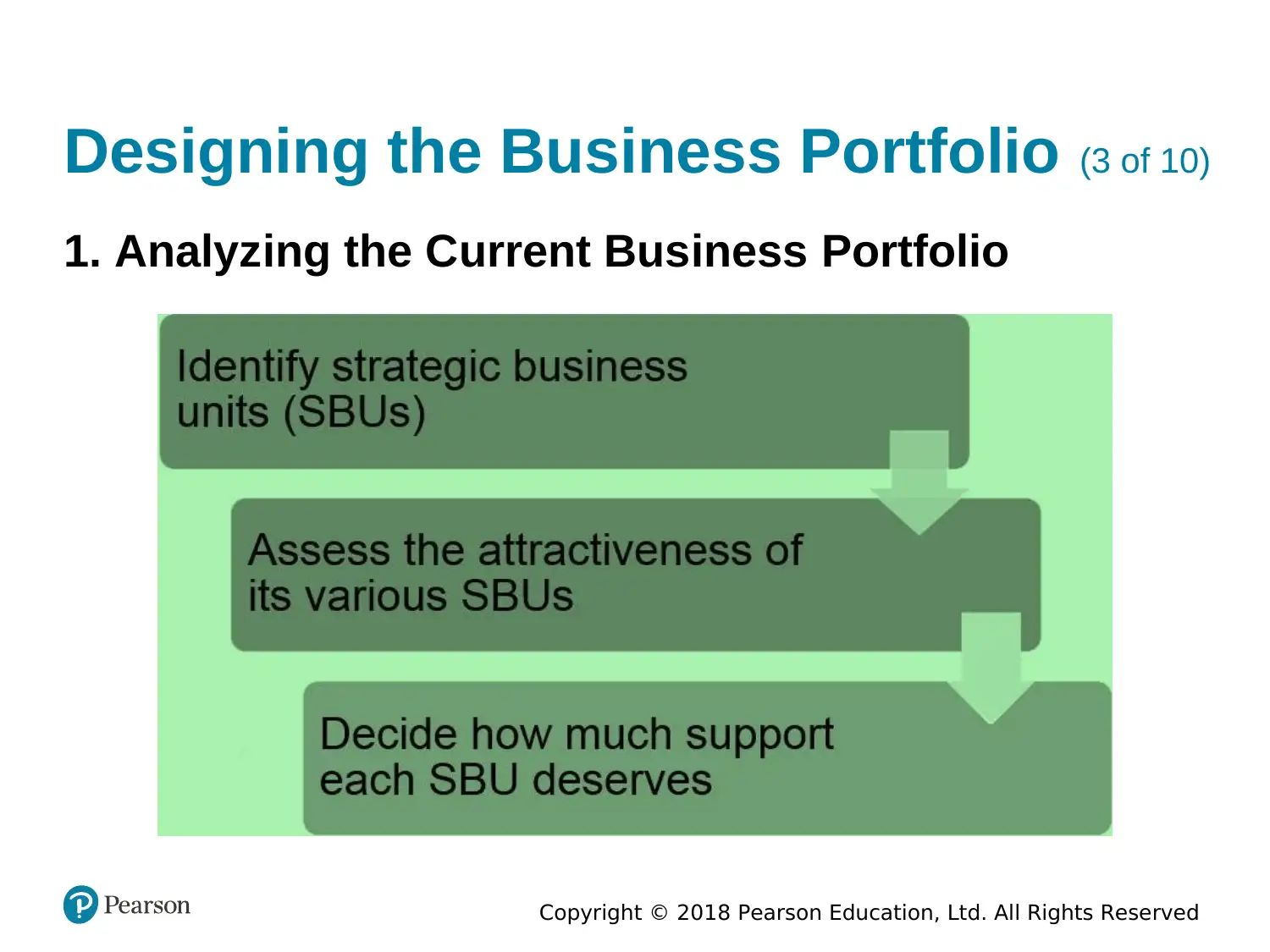
Copyright © 2018 Pearson Education, Ltd. All Rights Reserved
Designing the Business Portfolio (3 of 10)
1. Analyzing the Current Business Portfolio
Designing the Business Portfolio (3 of 10)
1. Analyzing the Current Business Portfolio
Secure Best Marks with AI Grader
Need help grading? Try our AI Grader for instant feedback on your assignments.
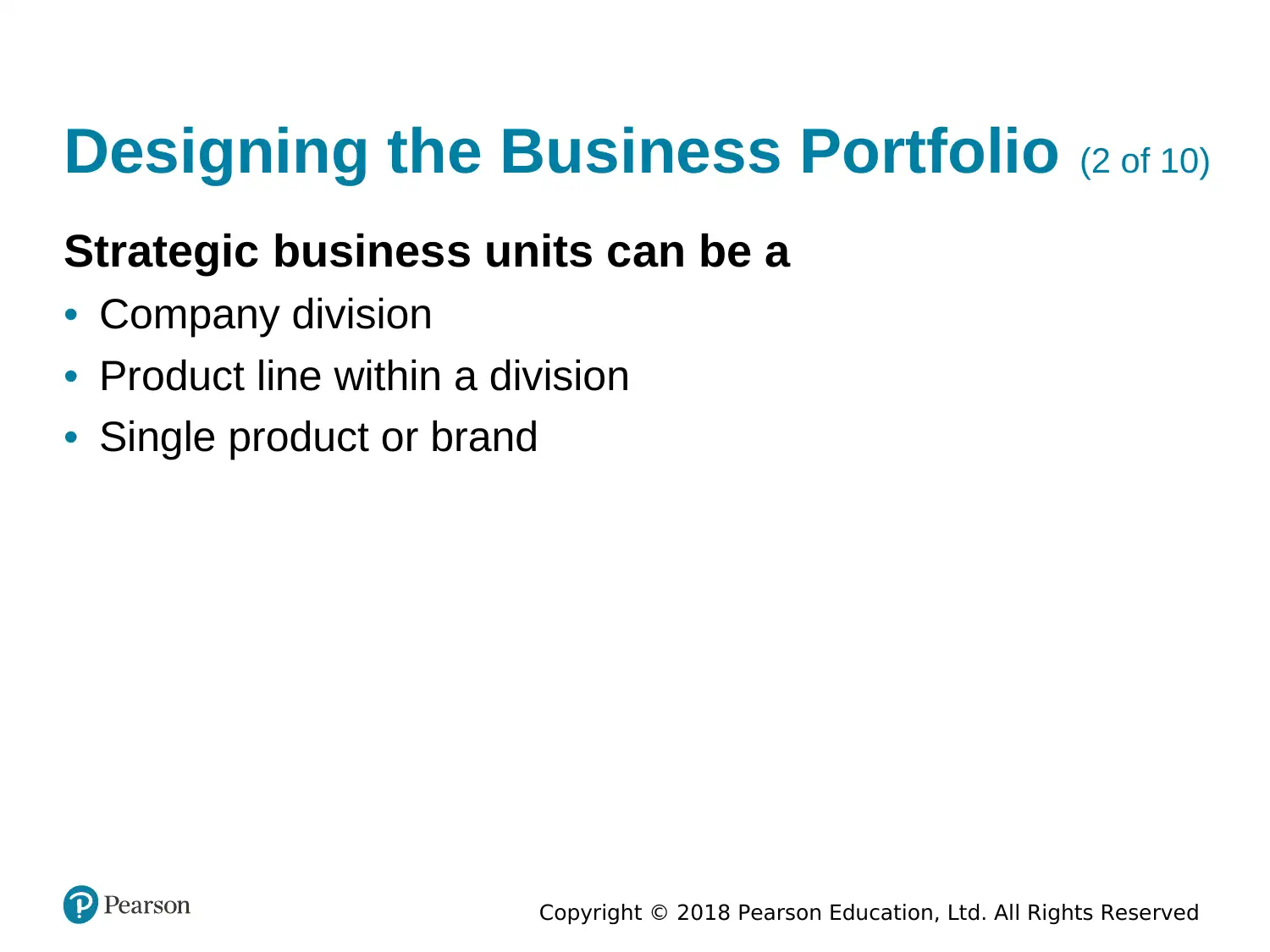
Copyright © 2018 Pearson Education, Ltd. All Rights Reserved
Designing the Business Portfolio (2 of 10)
Strategic business units can be a
• Company division
• Product line within a division
• Single product or brand
Designing the Business Portfolio (2 of 10)
Strategic business units can be a
• Company division
• Product line within a division
• Single product or brand
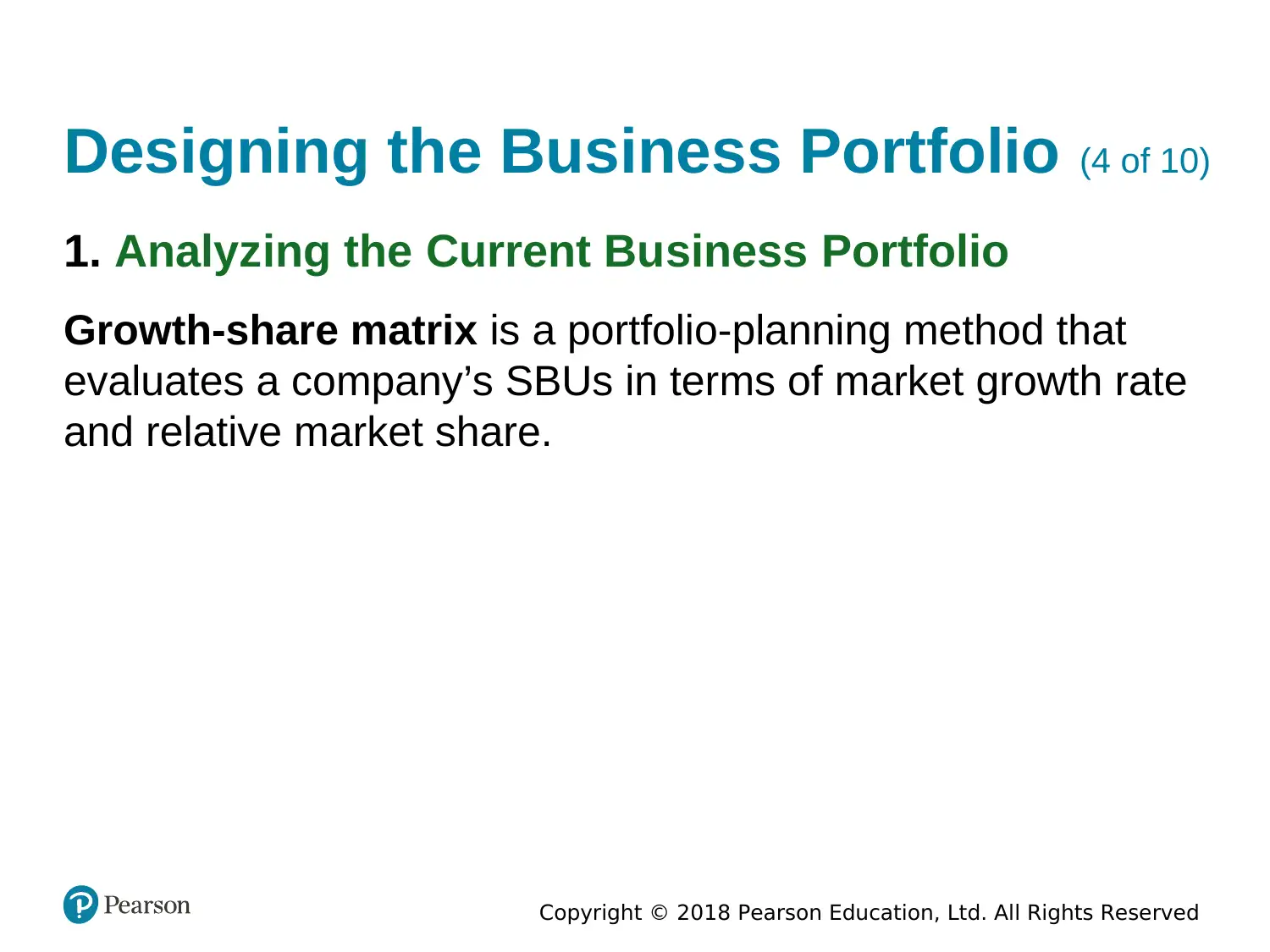
Copyright © 2018 Pearson Education, Ltd. All Rights Reserved
Designing the Business Portfolio (4 of 10)
1. Analyzing the Current Business Portfolio
Growth-share matrix is a portfolio-planning method that
evaluates a company’s SBUs in terms of market growth rate
and relative market share.
Designing the Business Portfolio (4 of 10)
1. Analyzing the Current Business Portfolio
Growth-share matrix is a portfolio-planning method that
evaluates a company’s SBUs in terms of market growth rate
and relative market share.
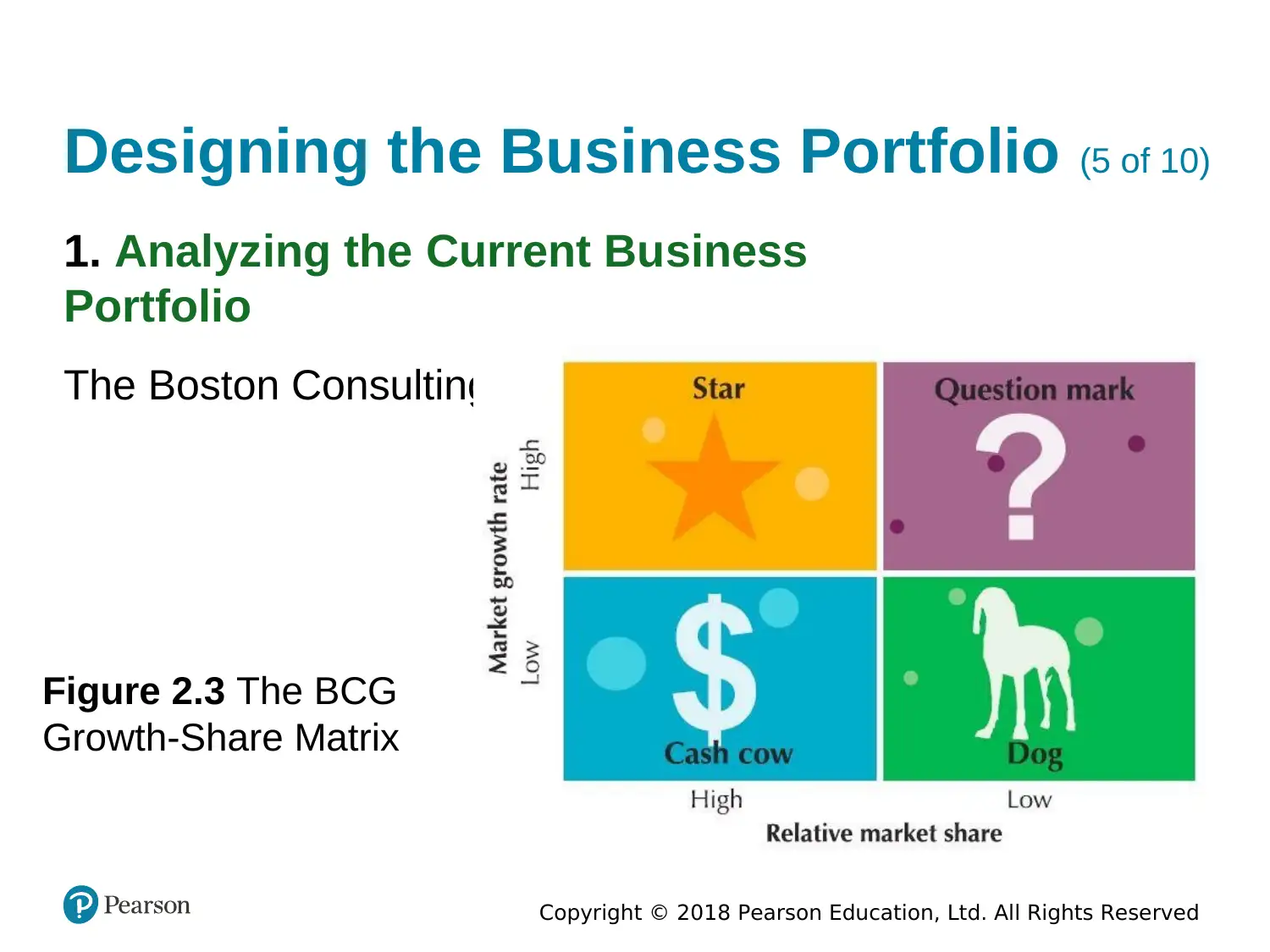
Copyright © 2018 Pearson Education, Ltd. All Rights Reserved
Designing the Business Portfolio (5 of 10)
1. Analyzing the Current Business
Portfolio
The Boston Consulting Group Approach
Figure 2.3 The BCG
Growth-Share Matrix
Designing the Business Portfolio (5 of 10)
1. Analyzing the Current Business
Portfolio
The Boston Consulting Group Approach
Figure 2.3 The BCG
Growth-Share Matrix
Paraphrase This Document
Need a fresh take? Get an instant paraphrase of this document with our AI Paraphraser
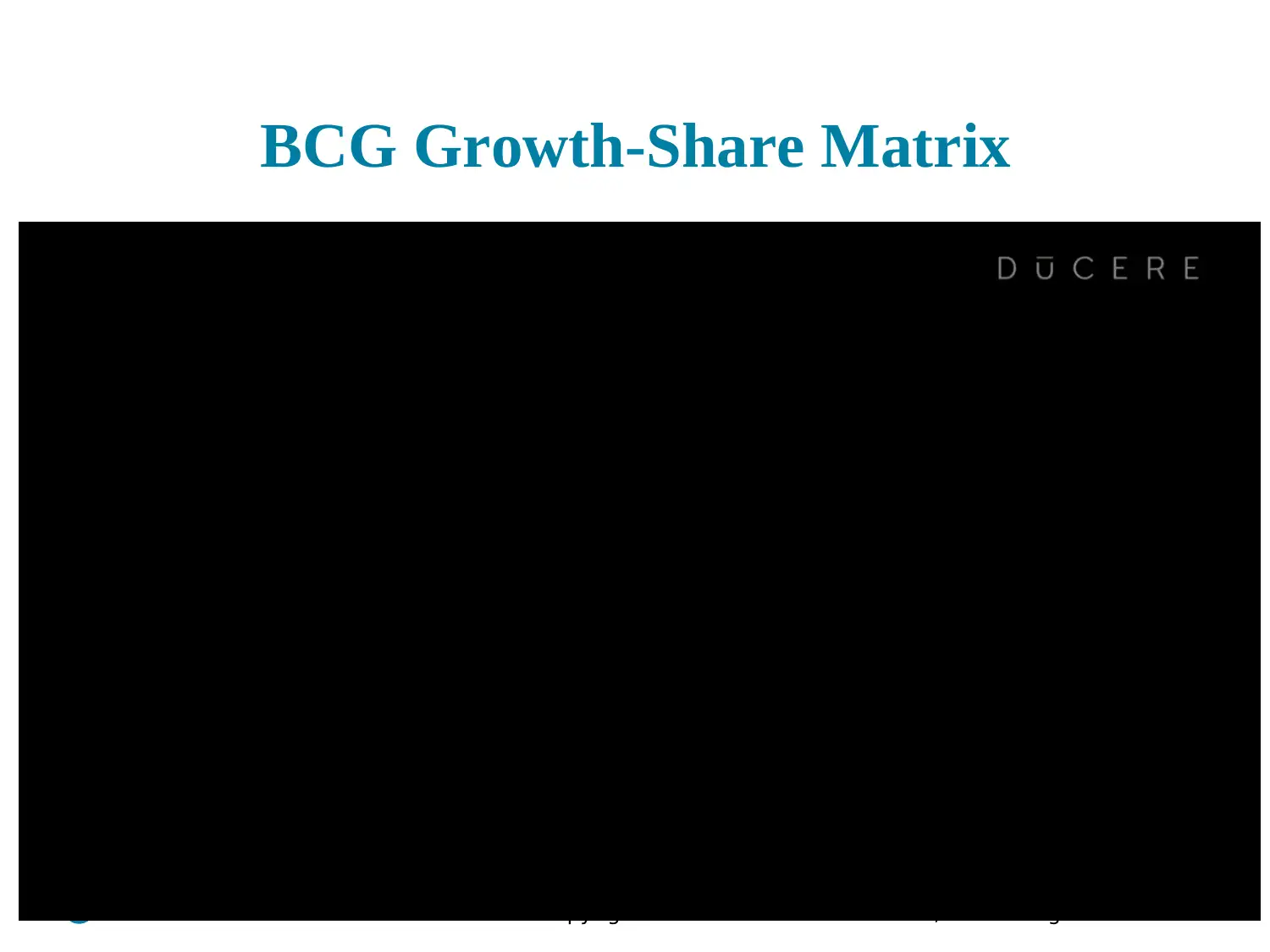
Copyright © 2018 Pearson Education, Ltd. All Rights Reserved
BCG Growth-Share Matrix
BCG Growth-Share Matrix
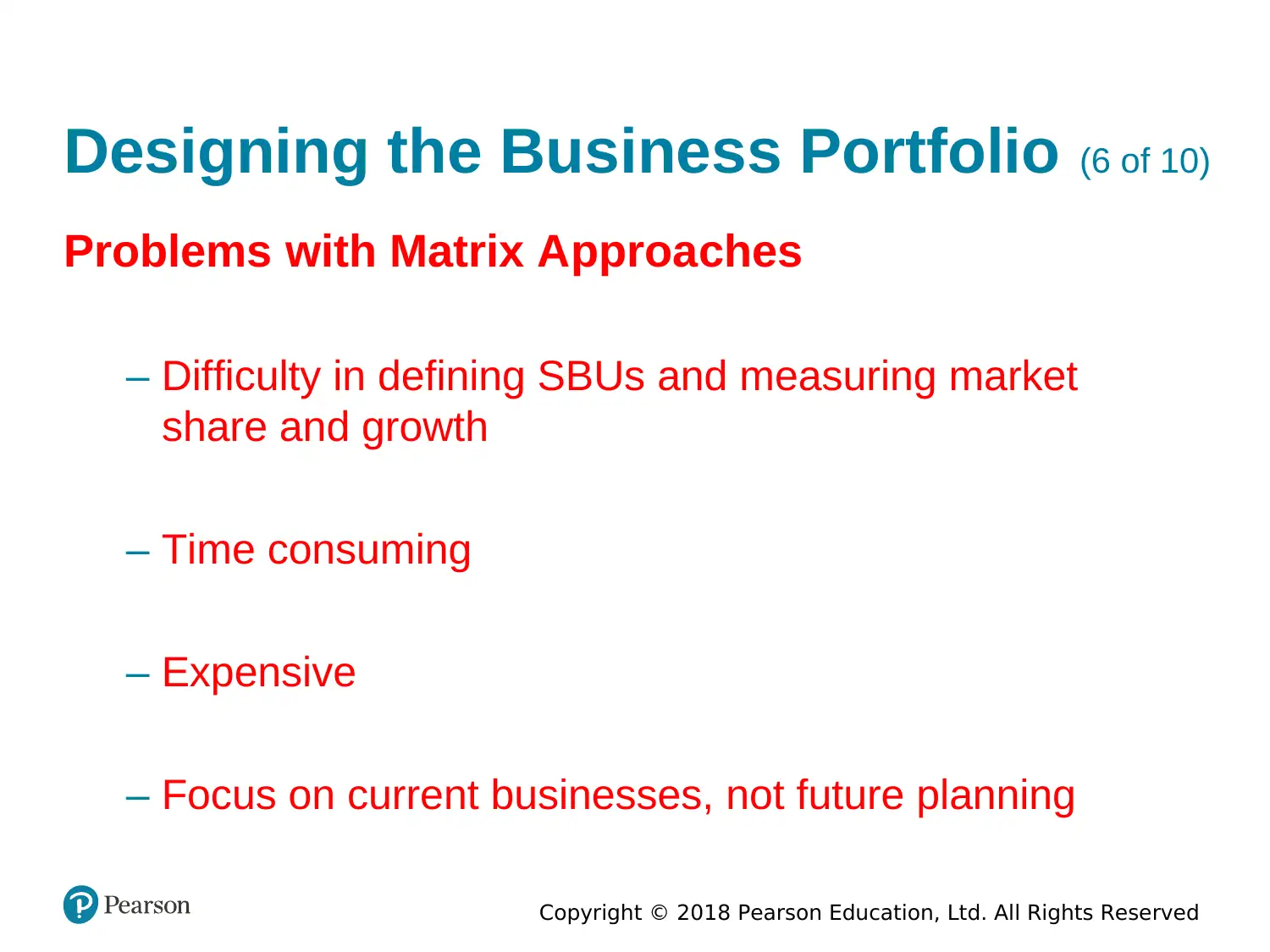
Copyright © 2018 Pearson Education, Ltd. All Rights Reserved
Designing the Business Portfolio (6 of 10)
Problems with Matrix Approaches
– Difficulty in defining SBUs and measuring market
share and growth
– Time consuming
– Expensive
– Focus on current businesses, not future planning
Designing the Business Portfolio (6 of 10)
Problems with Matrix Approaches
– Difficulty in defining SBUs and measuring market
share and growth
– Time consuming
– Expensive
– Focus on current businesses, not future planning
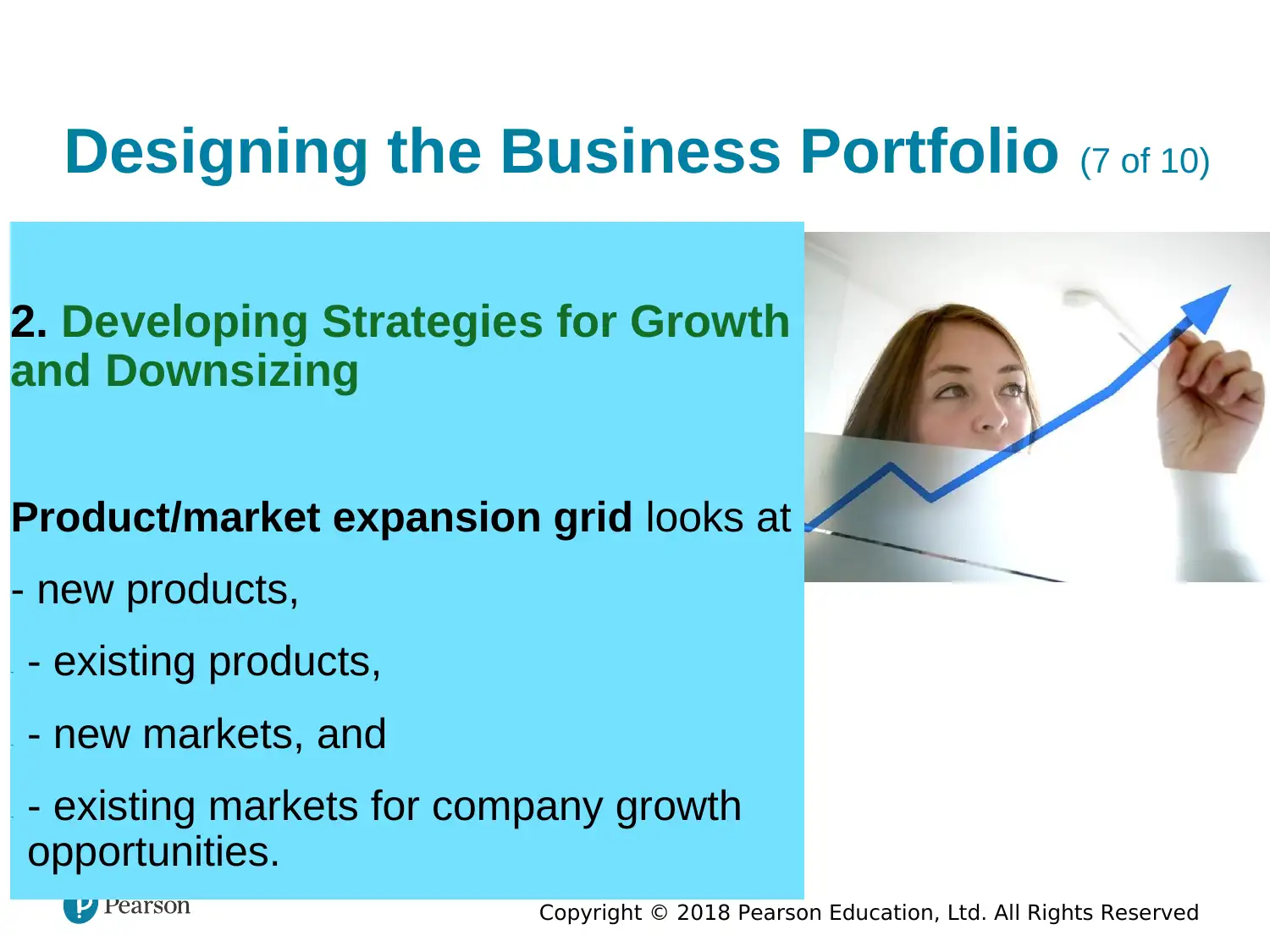
Copyright © 2018 Pearson Education, Ltd. All Rights Reserved
Designing the Business Portfolio (7 of 10)
2. Developing Strategies for Growth
and Downsizing
Product/market expansion grid looks at
- new products,
- - existing products,
- - new markets, and
- - existing markets for company growth
opportunities.
Designing the Business Portfolio (7 of 10)
2. Developing Strategies for Growth
and Downsizing
Product/market expansion grid looks at
- new products,
- - existing products,
- - new markets, and
- - existing markets for company growth
opportunities.
Secure Best Marks with AI Grader
Need help grading? Try our AI Grader for instant feedback on your assignments.
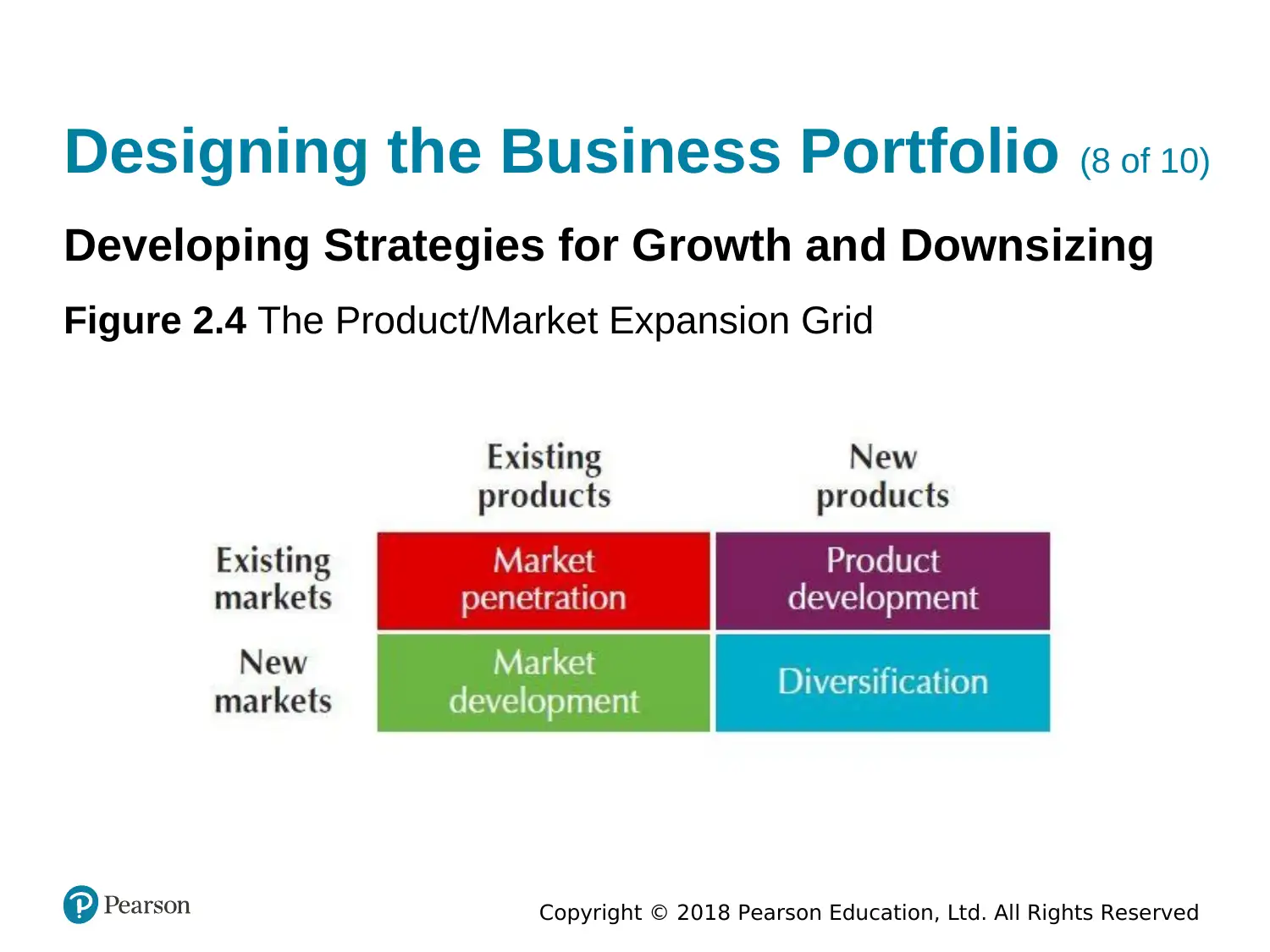
Copyright © 2018 Pearson Education, Ltd. All Rights Reserved
Designing the Business Portfolio (8 of 10)
Developing Strategies for Growth and Downsizing
Figure 2.4 The Product/Market Expansion Grid
Designing the Business Portfolio (8 of 10)
Developing Strategies for Growth and Downsizing
Figure 2.4 The Product/Market Expansion Grid
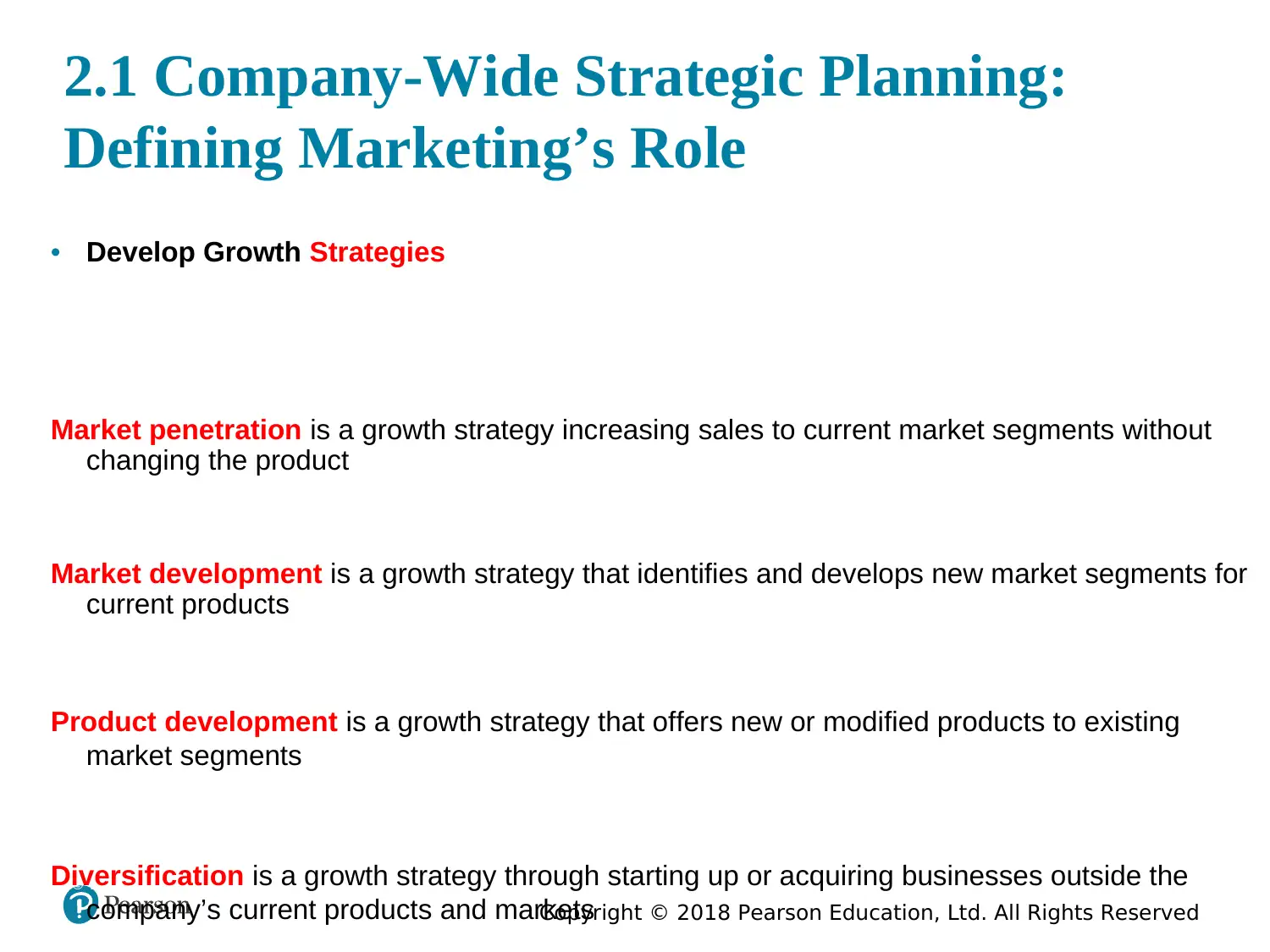
Copyright © 2018 Pearson Education, Ltd. All Rights Reserved
© 2012 Principles of Marketing: An Asian Perspective32
2.1 Company-Wide Strategic Planning:
Defining Marketing’s Role
• Develop Growth Strategies
Market penetration is a growth strategy increasing sales to current market segments without
changing the product
Market development is a growth strategy that identifies and develops new market segments for
current products
Product development is a growth strategy that offers new or modified products to existing
market segments
Diversification is a growth strategy through starting up or acquiring businesses outside the
company’s current products and markets
© 2012 Principles of Marketing: An Asian Perspective32
2.1 Company-Wide Strategic Planning:
Defining Marketing’s Role
• Develop Growth Strategies
Market penetration is a growth strategy increasing sales to current market segments without
changing the product
Market development is a growth strategy that identifies and develops new market segments for
current products
Product development is a growth strategy that offers new or modified products to existing
market segments
Diversification is a growth strategy through starting up or acquiring businesses outside the
company’s current products and markets
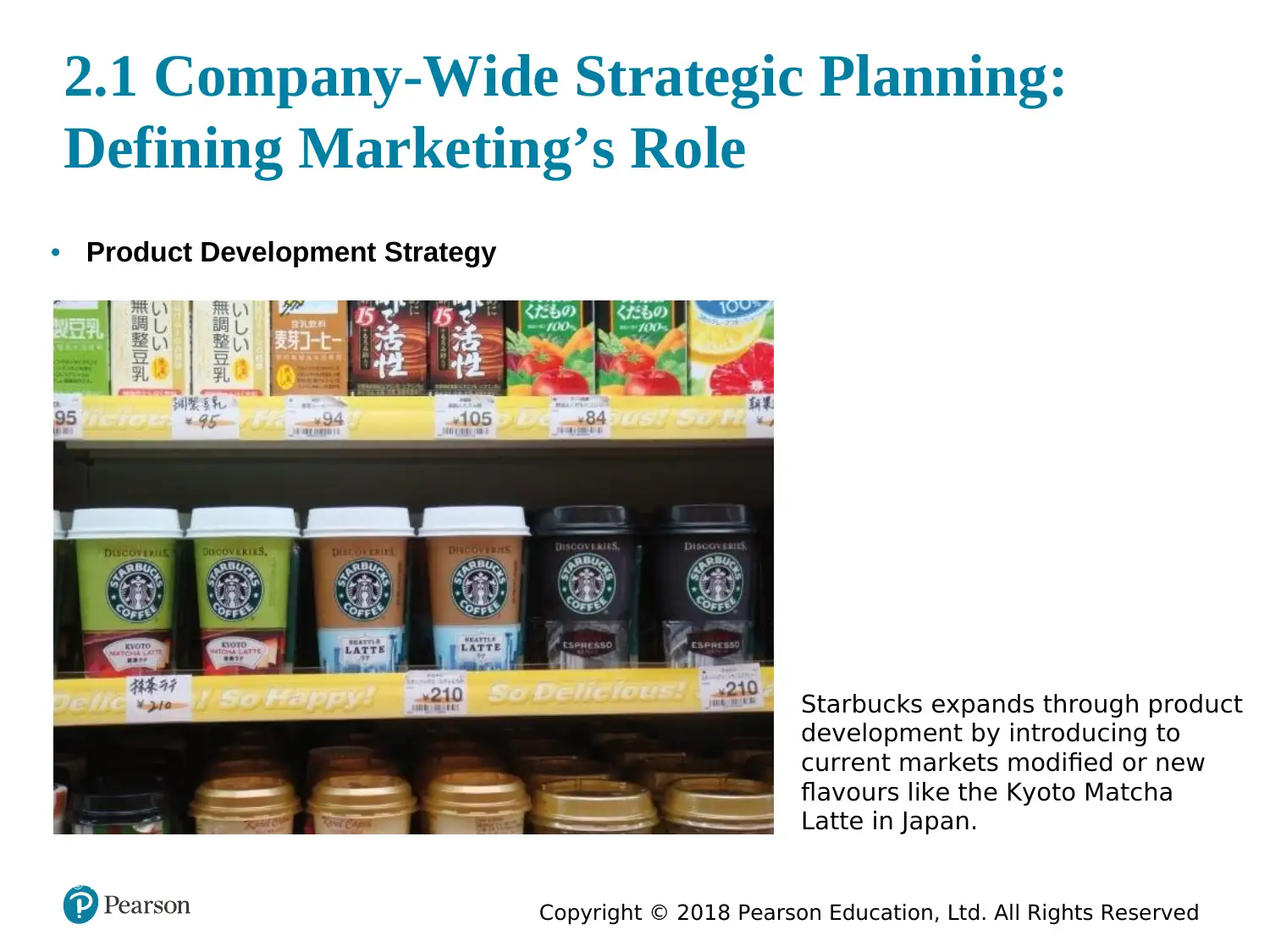
Copyright © 2018 Pearson Education, Ltd. All Rights Reserved
© 2012 Principles of Marketing: An Asian Perspective33
2.1 Company-Wide Strategic Planning:
Defining Marketing’s Role
• Product Development Strategy
Starbucks expands through product
development by introducing to
current markets modified or new
flavours like the Kyoto Matcha
Latte in Japan.
© 2012 Principles of Marketing: An Asian Perspective33
2.1 Company-Wide Strategic Planning:
Defining Marketing’s Role
• Product Development Strategy
Starbucks expands through product
development by introducing to
current markets modified or new
flavours like the Kyoto Matcha
Latte in Japan.
Paraphrase This Document
Need a fresh take? Get an instant paraphrase of this document with our AI Paraphraser
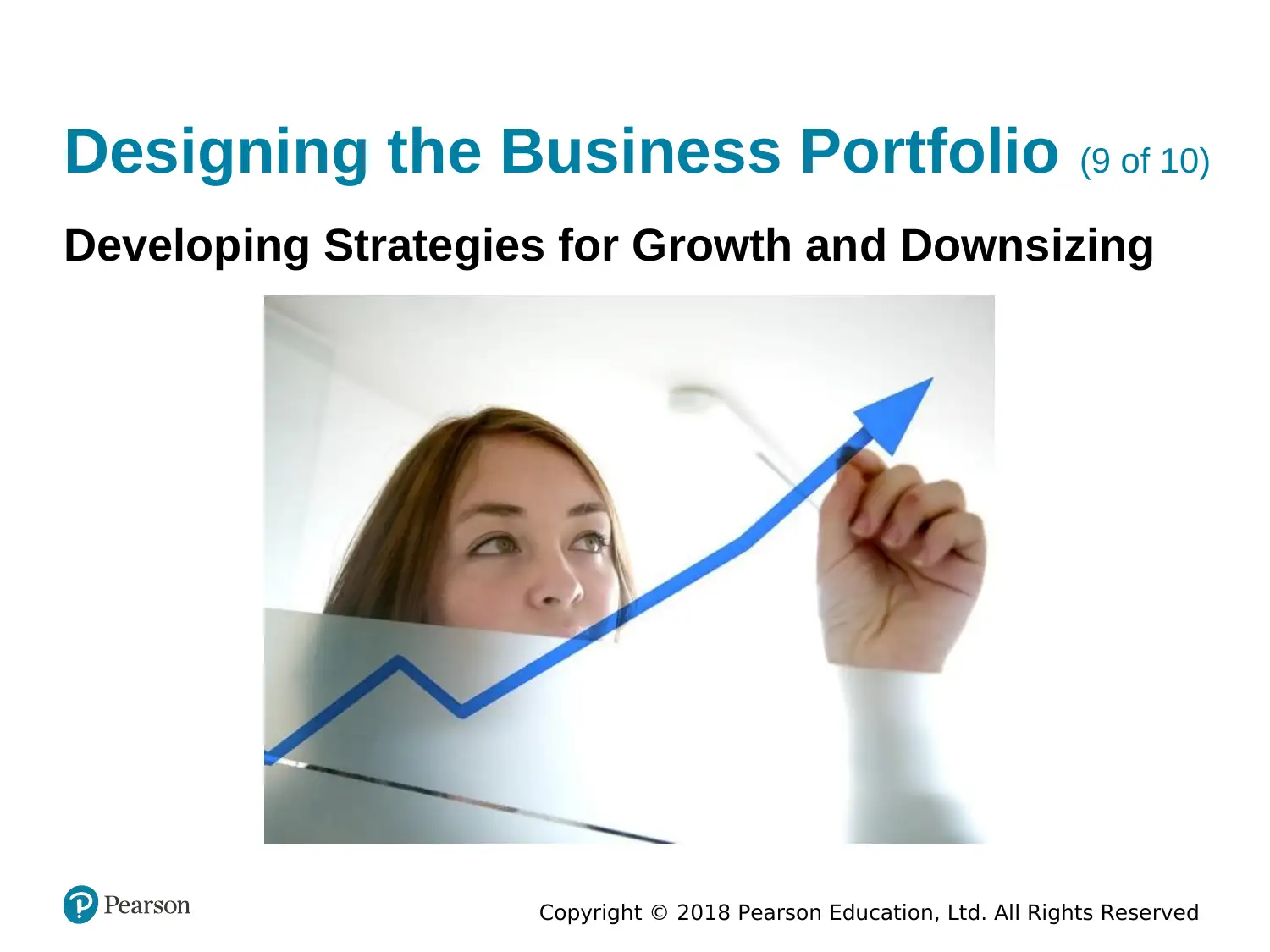
Copyright © 2018 Pearson Education, Ltd. All Rights Reserved
Designing the Business Portfolio (9 of 10)
Developing Strategies for Growth and Downsizing
Designing the Business Portfolio (9 of 10)
Developing Strategies for Growth and Downsizing
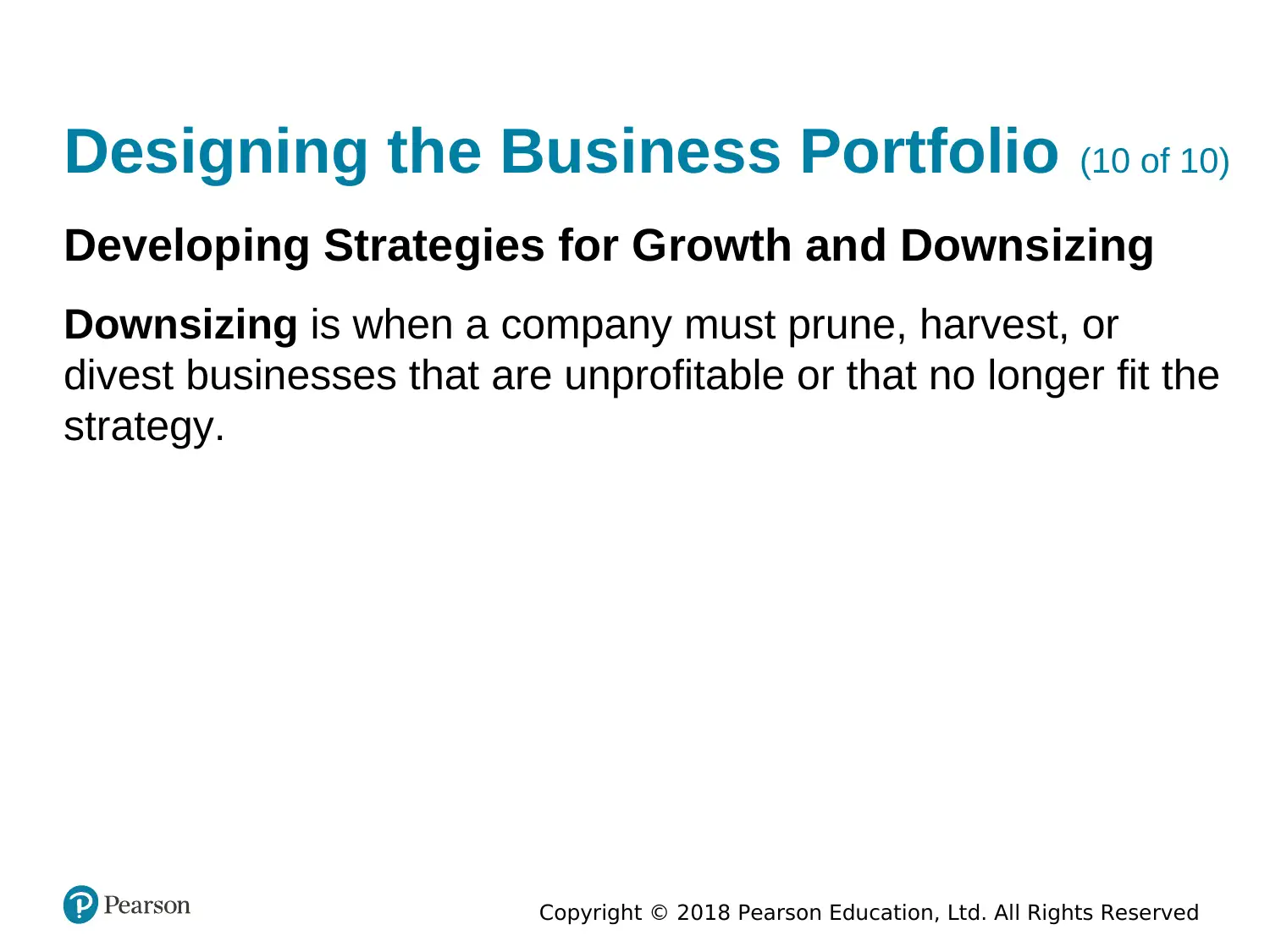
Copyright © 2018 Pearson Education, Ltd. All Rights Reserved
Designing the Business Portfolio (10 of 10)
Developing Strategies for Growth and Downsizing
Downsizing is when a company must prune, harvest, or
divest businesses that are unprofitable or that no longer fit the
strategy.
Designing the Business Portfolio (10 of 10)
Developing Strategies for Growth and Downsizing
Downsizing is when a company must prune, harvest, or
divest businesses that are unprofitable or that no longer fit the
strategy.
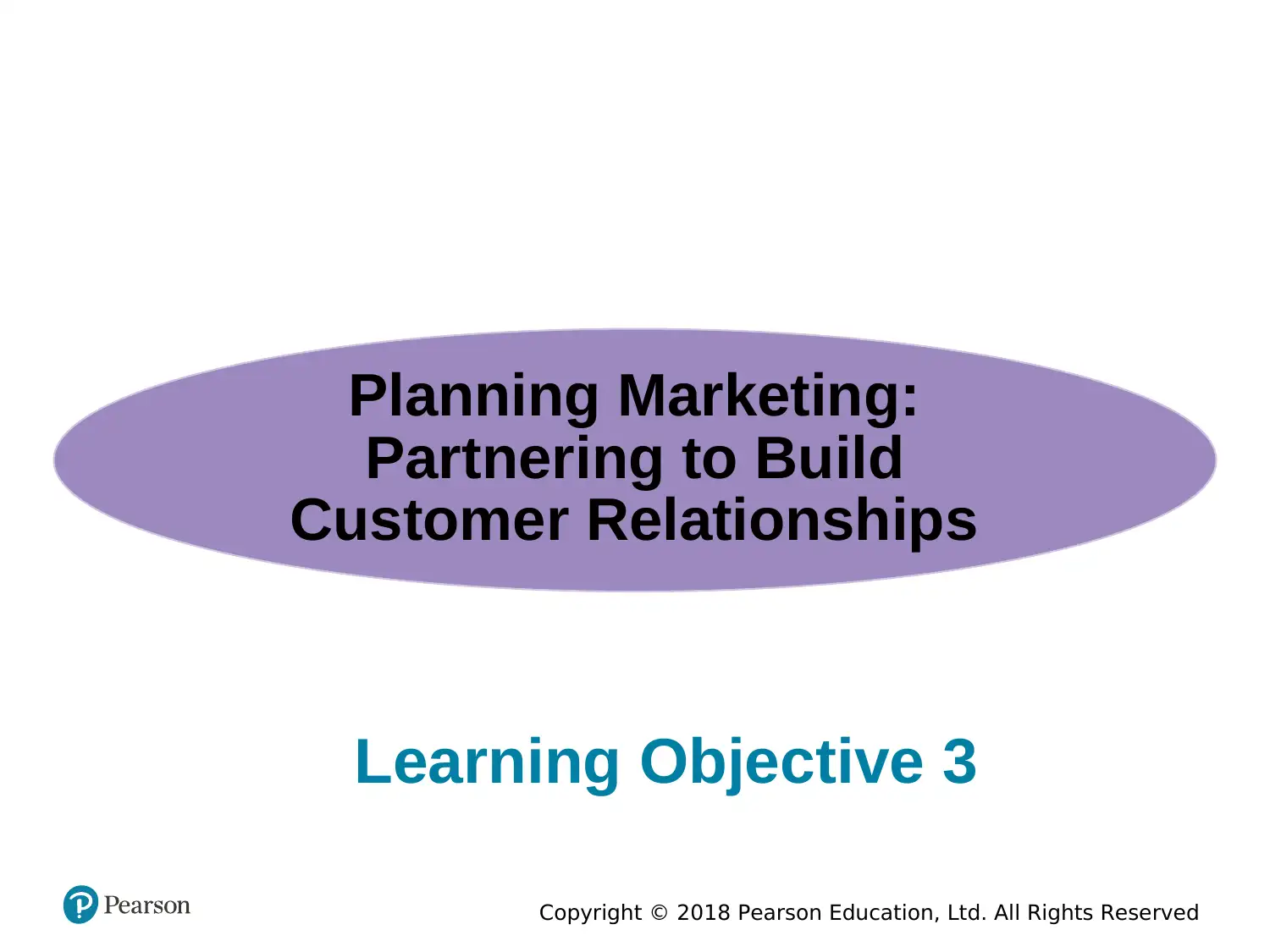
Copyright © 2018 Pearson Education, Ltd. All Rights Reserved
Learning Objective 3
Planning Marketing:
Partnering to Build
Customer Relationships
Learning Objective 3
Planning Marketing:
Partnering to Build
Customer Relationships
Secure Best Marks with AI Grader
Need help grading? Try our AI Grader for instant feedback on your assignments.
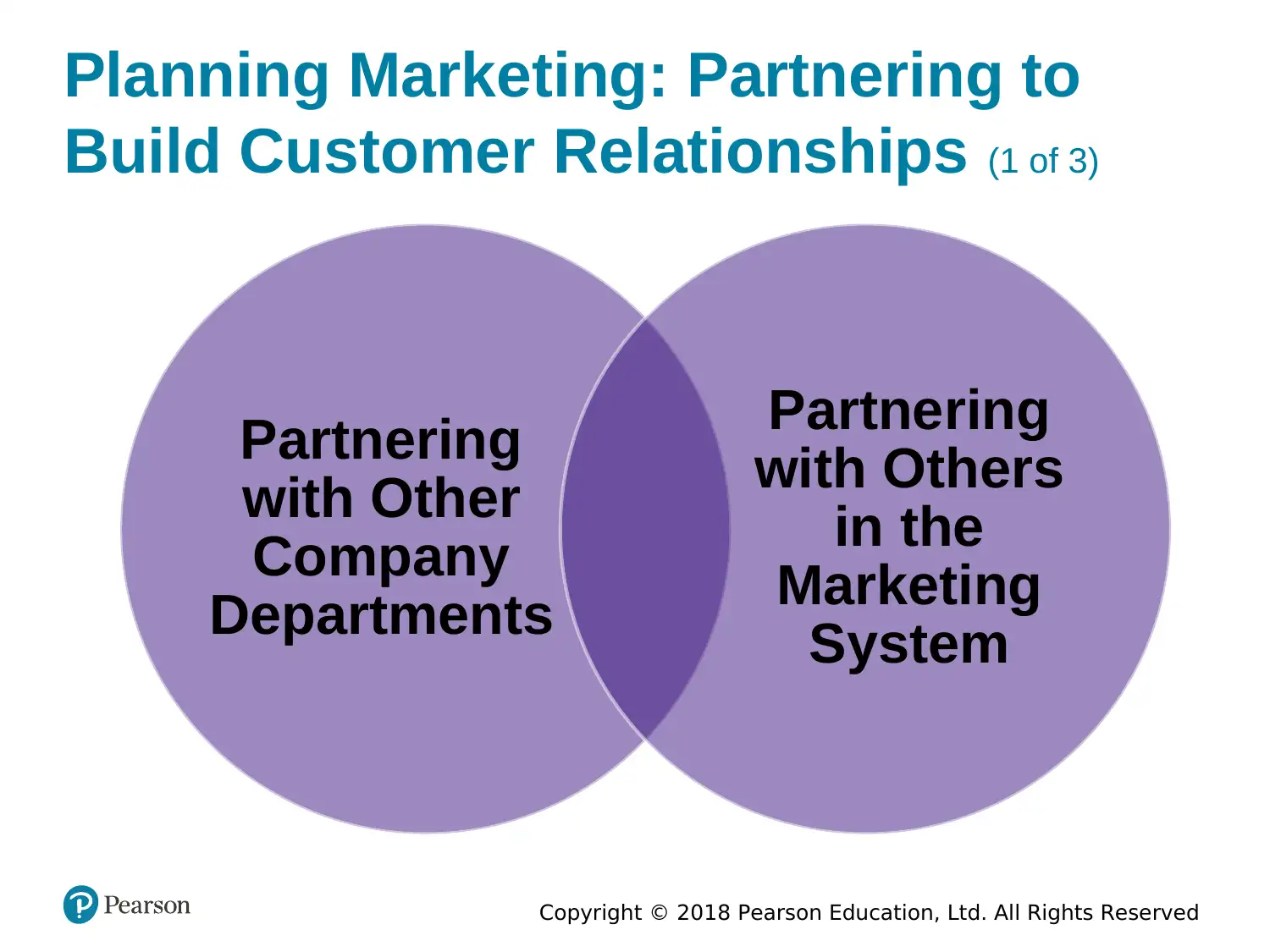
Copyright © 2018 Pearson Education, Ltd. All Rights Reserved
Planning Marketing: Partnering to
Build Customer Relationships (1 of 3)
Partnering
with Other
Company
Departments
Partnering
with Others
in the
Marketing
System
Planning Marketing: Partnering to
Build Customer Relationships (1 of 3)
Partnering
with Other
Company
Departments
Partnering
with Others
in the
Marketing
System
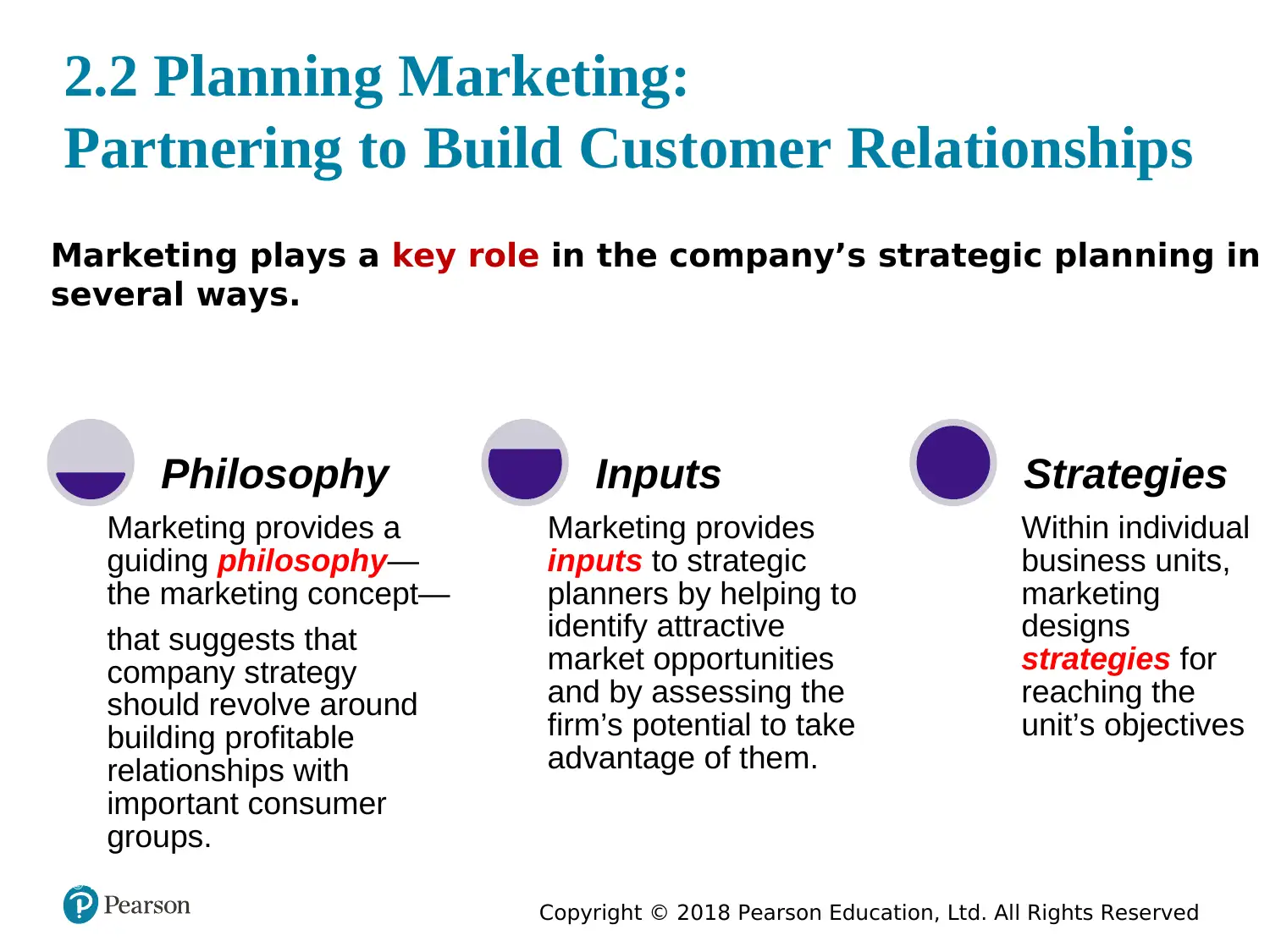
Copyright © 2018 Pearson Education, Ltd. All Rights Reserved
© 2012 Principles of Marketing: An Asian Perspective38
2.2 Planning Marketing:
Partnering to Build Customer Relationships
Marketing plays a key role in the company’s strategic planning in
several ways.
Marketing provides a
guiding philosophy—
the marketing concept—
that suggests that
company strategy
should revolve around
building profitable
relationships with
important consumer
groups.
Philosophy
Marketing provides
inputs to strategic
planners by helping to
identify attractive
market opportunities
and by assessing the
firm’s potential to take
advantage of them.
Inputs
Within individual
business units,
marketing
designs
strategies for
reaching the
unit’s objectives
Strategies
© 2012 Principles of Marketing: An Asian Perspective38
2.2 Planning Marketing:
Partnering to Build Customer Relationships
Marketing plays a key role in the company’s strategic planning in
several ways.
Marketing provides a
guiding philosophy—
the marketing concept—
that suggests that
company strategy
should revolve around
building profitable
relationships with
important consumer
groups.
Philosophy
Marketing provides
inputs to strategic
planners by helping to
identify attractive
market opportunities
and by assessing the
firm’s potential to take
advantage of them.
Inputs
Within individual
business units,
marketing
designs
strategies for
reaching the
unit’s objectives
Strategies
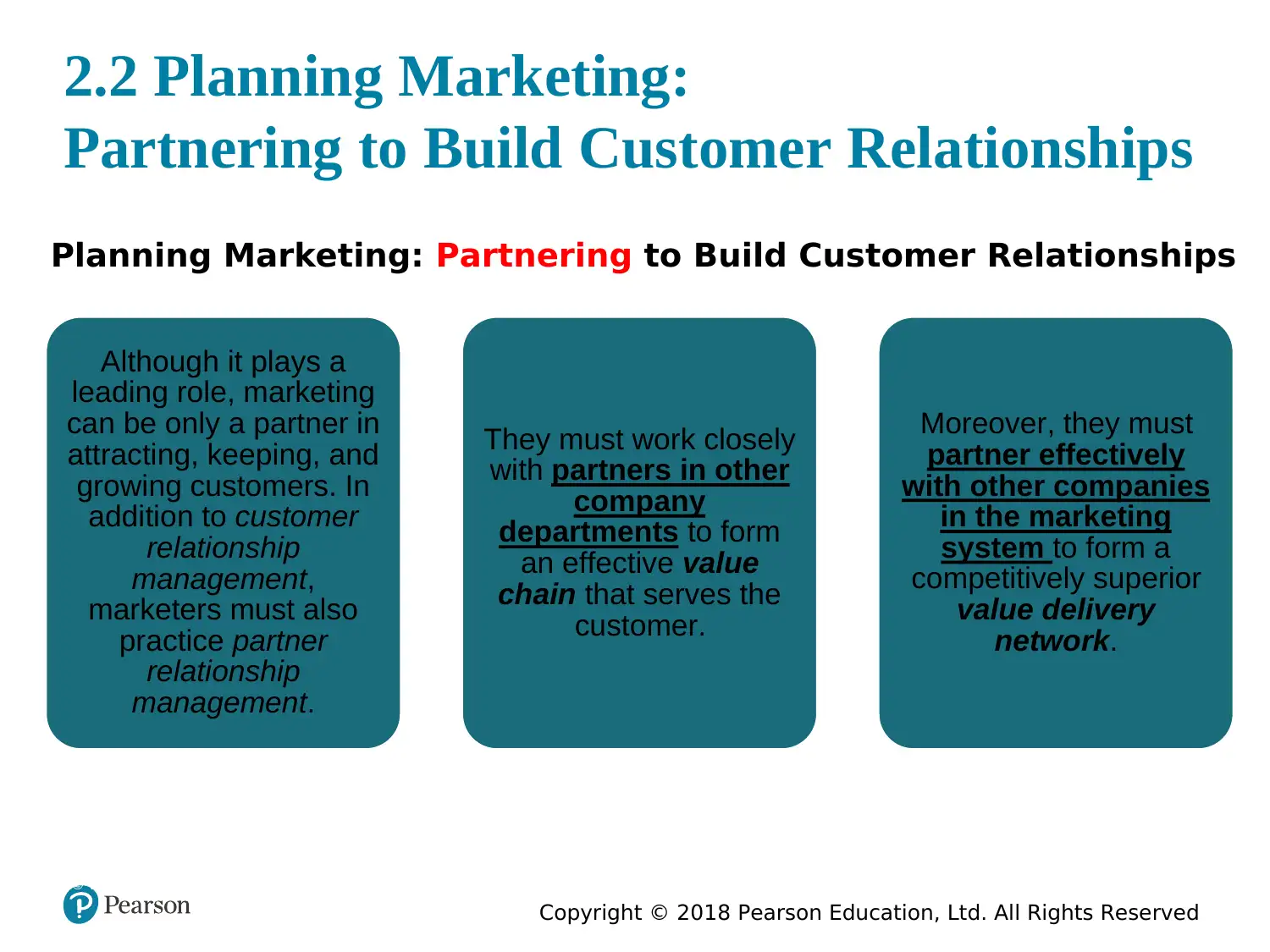
Copyright © 2018 Pearson Education, Ltd. All Rights Reserved
© 2012 Principles of Marketing: An Asian Perspective39
2.2 Planning Marketing:
Partnering to Build Customer Relationships
Planning Marketing: Partnering to Build Customer Relationships
Although it plays a
leading role, marketing
can be only a partner in
attracting, keeping, and
growing customers. In
addition to customer
relationship
management,
marketers must also
practice partner
relationship
management.
They must work closely
with partners in other
company
departments to form
an effective value
chain that serves the
customer.
Moreover, they must
partner effectively
with other companies
in the marketing
system to form a
competitively superior
value delivery
network.
© 2012 Principles of Marketing: An Asian Perspective39
2.2 Planning Marketing:
Partnering to Build Customer Relationships
Planning Marketing: Partnering to Build Customer Relationships
Although it plays a
leading role, marketing
can be only a partner in
attracting, keeping, and
growing customers. In
addition to customer
relationship
management,
marketers must also
practice partner
relationship
management.
They must work closely
with partners in other
company
departments to form
an effective value
chain that serves the
customer.
Moreover, they must
partner effectively
with other companies
in the marketing
system to form a
competitively superior
value delivery
network.
Paraphrase This Document
Need a fresh take? Get an instant paraphrase of this document with our AI Paraphraser
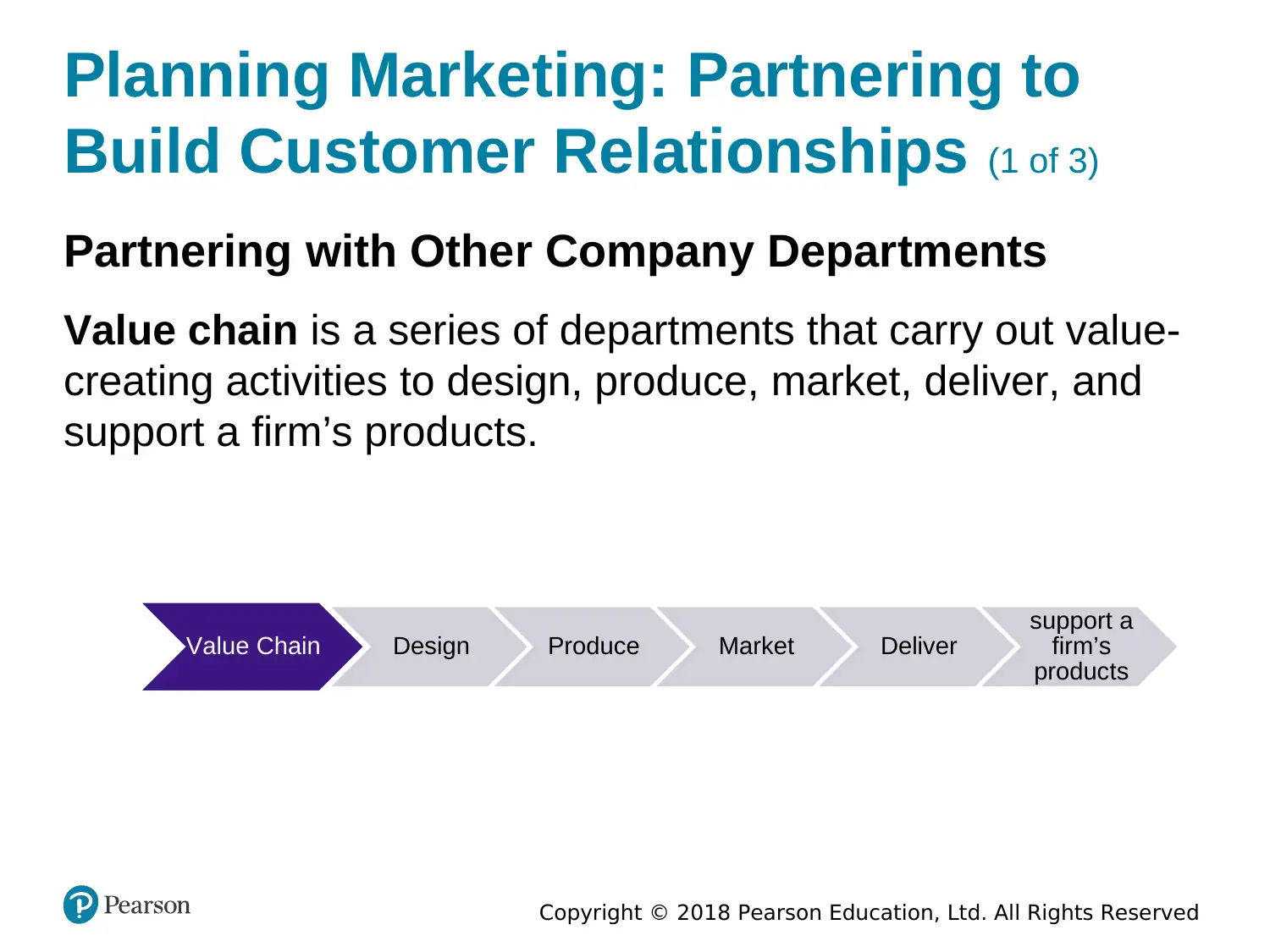
Copyright © 2018 Pearson Education, Ltd. All Rights Reserved
Planning Marketing: Partnering to
Build Customer Relationships (1 of 3)
Partnering with Other Company Departments
Value chain is a series of departments that carry out value-
creating activities to design, produce, market, deliver, and
support a firm’s products.
Value Chain Design Produce Market Deliver
support a
firm’s
products
Planning Marketing: Partnering to
Build Customer Relationships (1 of 3)
Partnering with Other Company Departments
Value chain is a series of departments that carry out value-
creating activities to design, produce, market, deliver, and
support a firm’s products.
Value Chain Design Produce Market Deliver
support a
firm’s
products
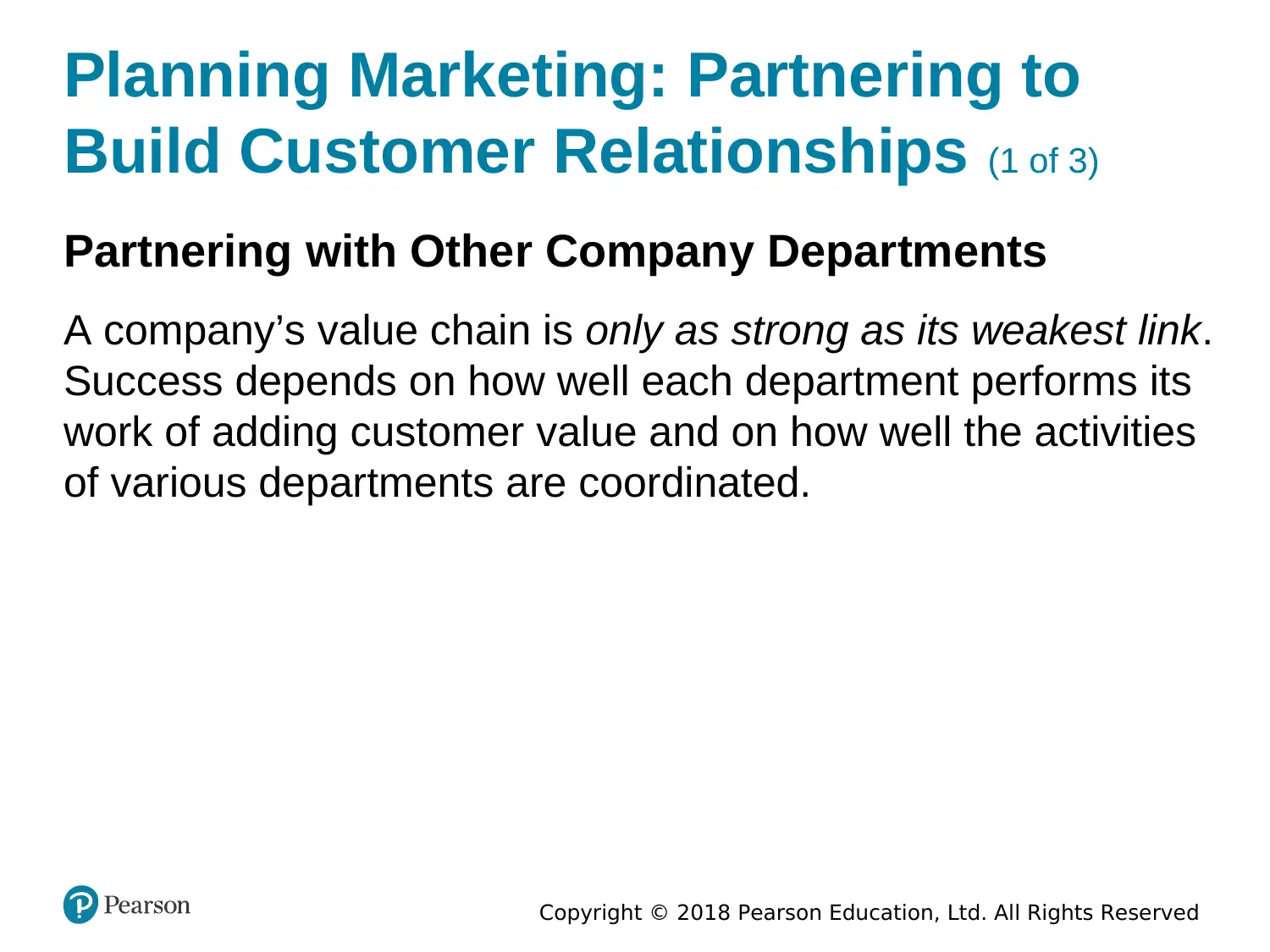
Copyright © 2018 Pearson Education, Ltd. All Rights Reserved
Planning Marketing: Partnering to
Build Customer Relationships (1 of 3)
Partnering with Other Company Departments
A company’s value chain is only as strong as its weakest link.
Success depends on how well each department performs its
work of adding customer value and on how well the activities
of various departments are coordinated.
Planning Marketing: Partnering to
Build Customer Relationships (1 of 3)
Partnering with Other Company Departments
A company’s value chain is only as strong as its weakest link.
Success depends on how well each department performs its
work of adding customer value and on how well the activities
of various departments are coordinated.
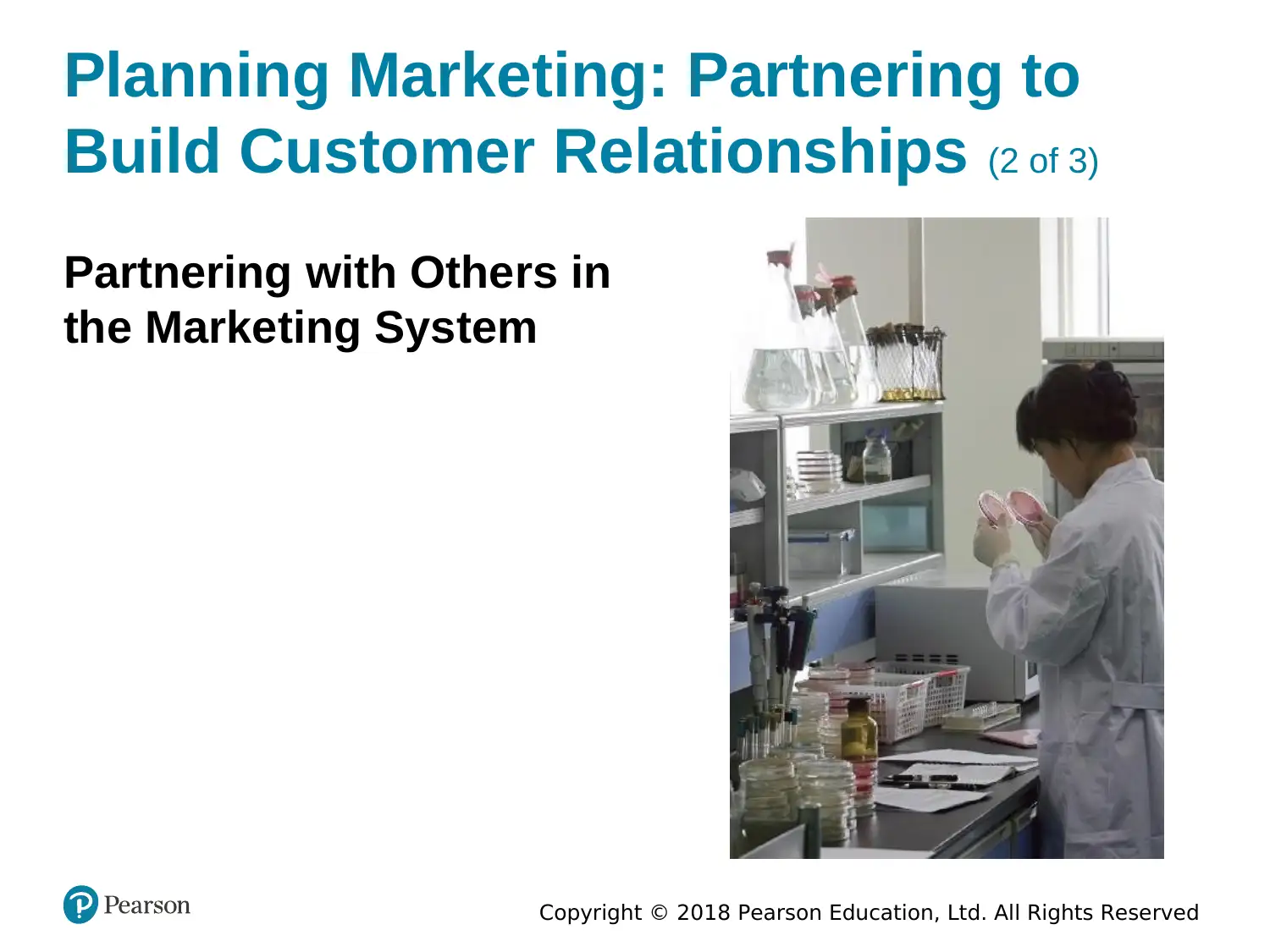
Copyright © 2018 Pearson Education, Ltd. All Rights Reserved
Planning Marketing: Partnering to
Build Customer Relationships (2 of 3)
Partnering with Others in
the Marketing System
Planning Marketing: Partnering to
Build Customer Relationships (2 of 3)
Partnering with Others in
the Marketing System
Secure Best Marks with AI Grader
Need help grading? Try our AI Grader for instant feedback on your assignments.
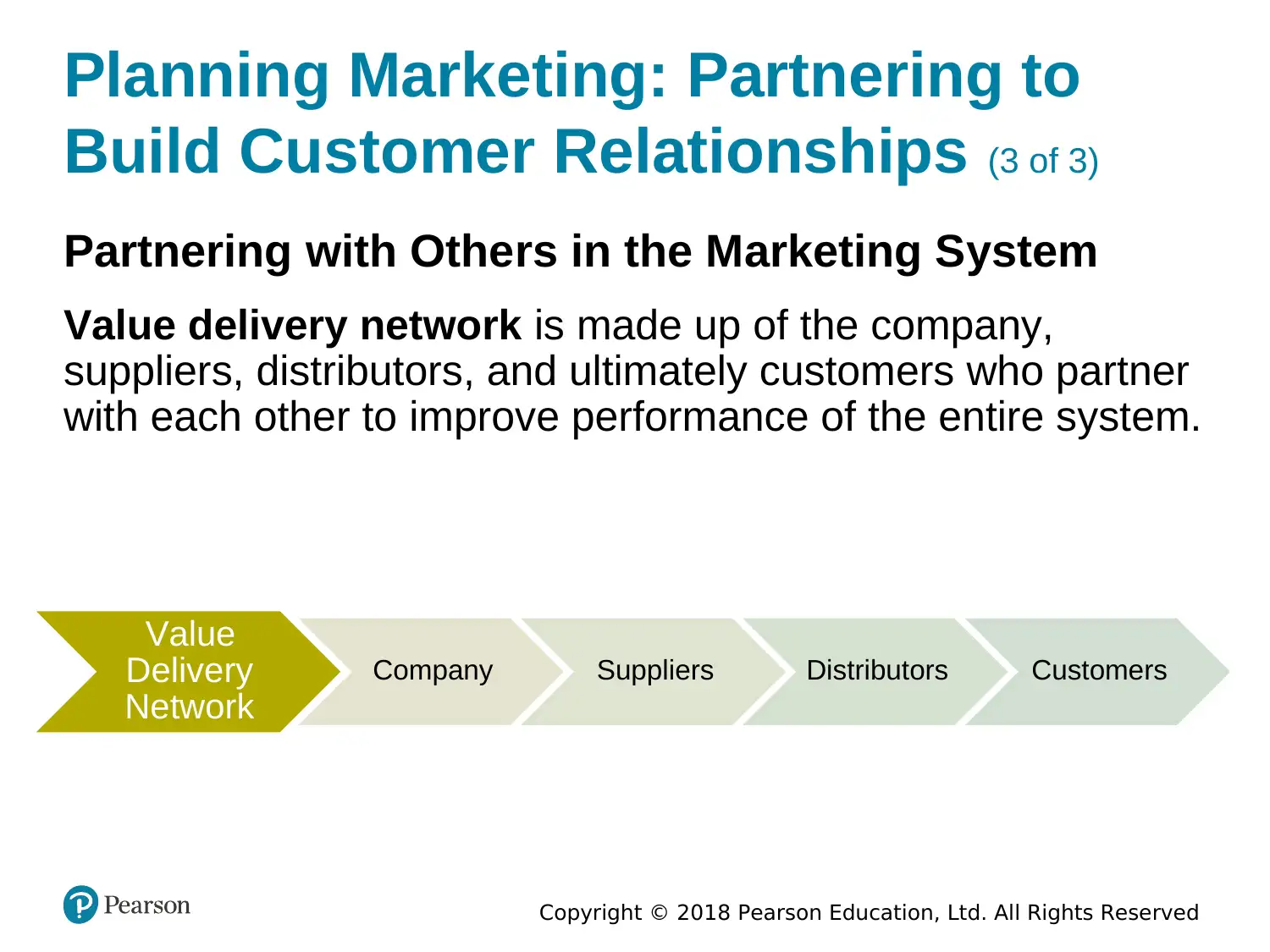
Copyright © 2018 Pearson Education, Ltd. All Rights Reserved
Planning Marketing: Partnering to
Build Customer Relationships (3 of 3)
Partnering with Others in the Marketing System
Value delivery network is made up of the company,
suppliers, distributors, and ultimately customers who partner
with each other to improve performance of the entire system.
Value
Delivery
Network
Company Suppliers Distributors Customers
Planning Marketing: Partnering to
Build Customer Relationships (3 of 3)
Partnering with Others in the Marketing System
Value delivery network is made up of the company,
suppliers, distributors, and ultimately customers who partner
with each other to improve performance of the entire system.
Value
Delivery
Network
Company Suppliers Distributors Customers

Copyright © 2018 Pearson Education, Ltd. All Rights Reserved
Its 36,000 restaurants across 100 countries
serve more than 69 million customers daily
Its 36,000 restaurants across 100 countries
serve more than 69 million customers daily
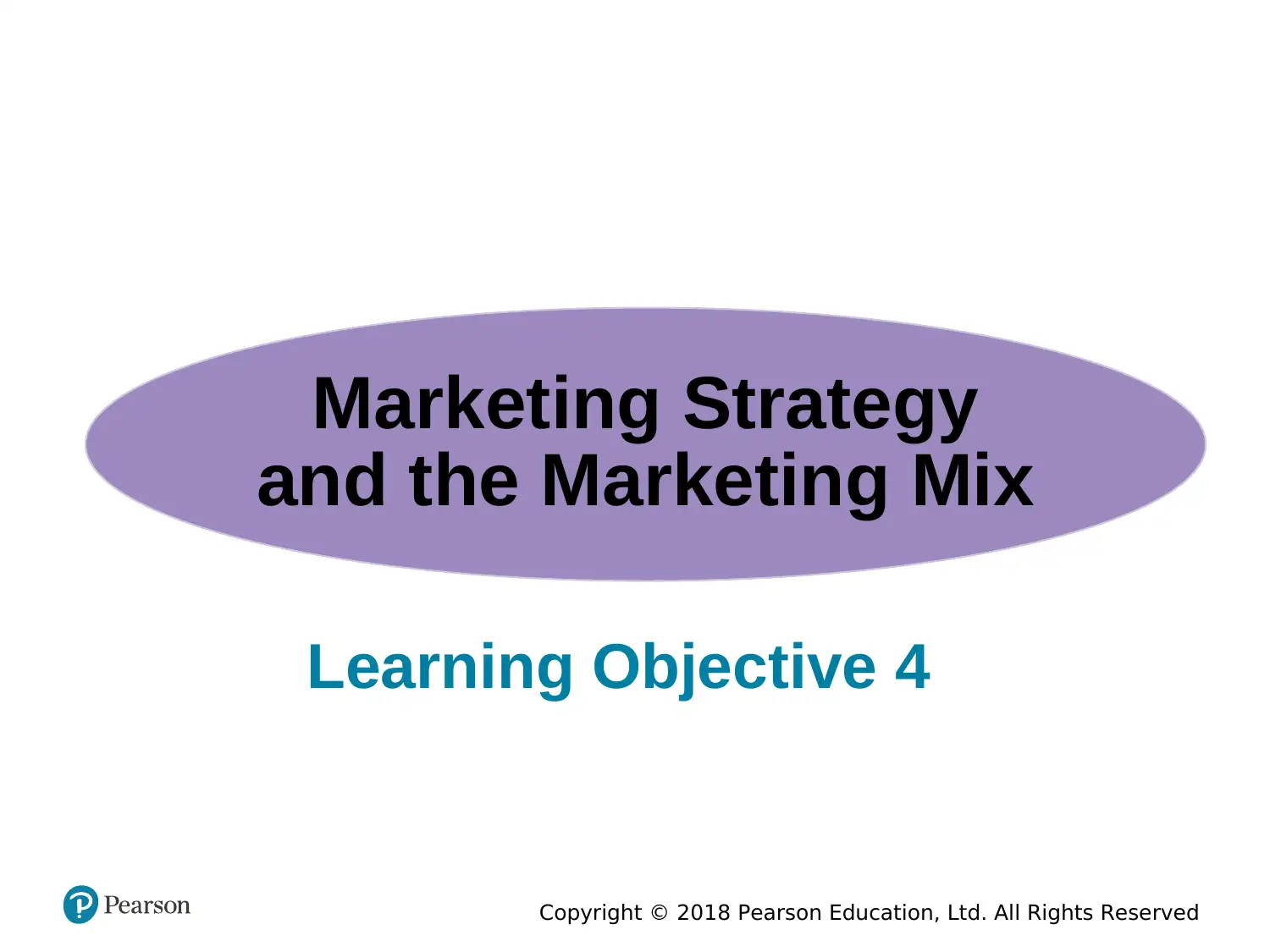
Copyright © 2018 Pearson Education, Ltd. All Rights Reserved
Learning Objective 4
Marketing Strategy
and the Marketing Mix
Learning Objective 4
Marketing Strategy
and the Marketing Mix
Paraphrase This Document
Need a fresh take? Get an instant paraphrase of this document with our AI Paraphraser
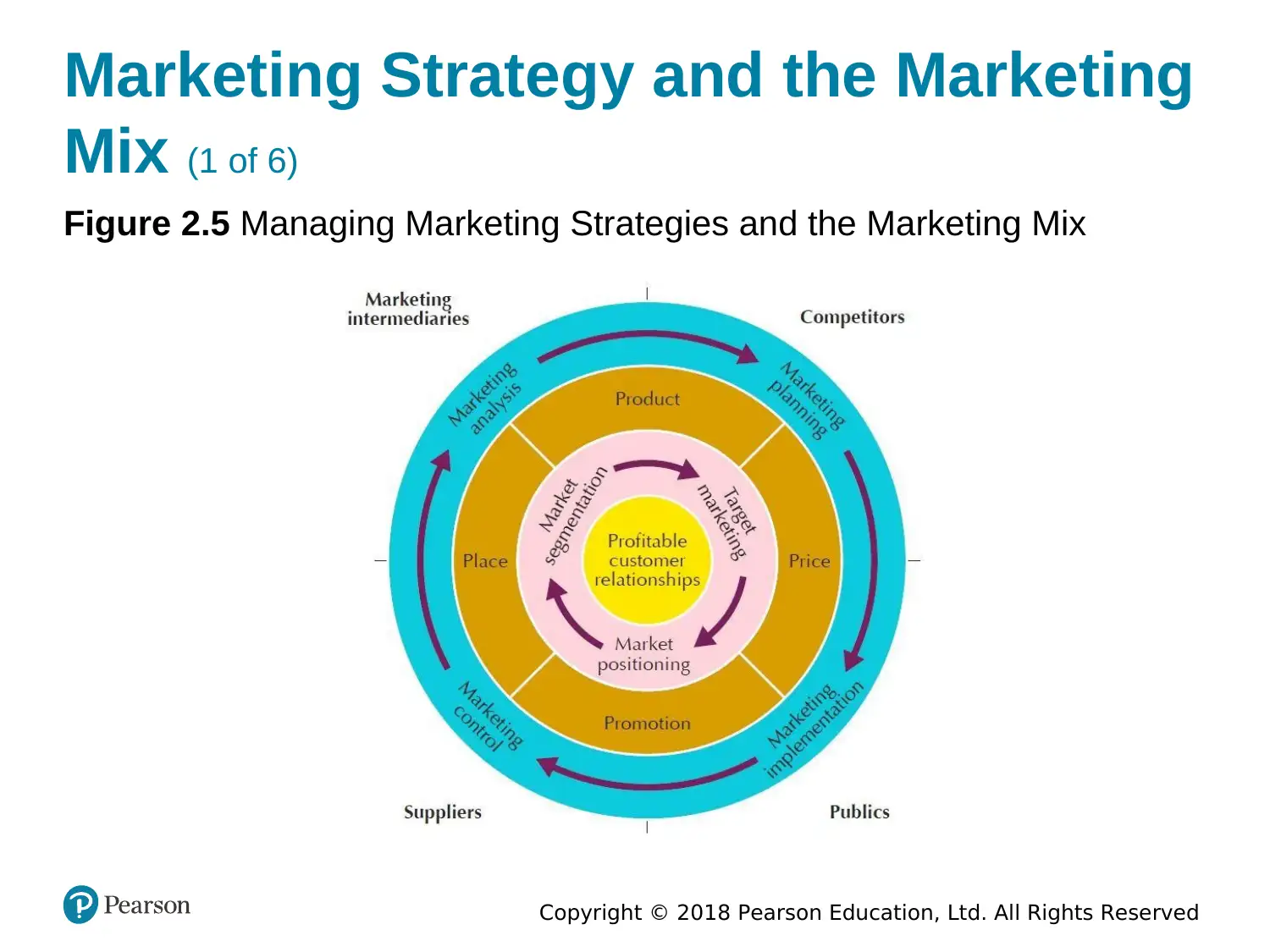
Copyright © 2018 Pearson Education, Ltd. All Rights Reserved
Marketing Strategy and the Marketing
Mix (1 of 6)
Figure 2.5 Managing Marketing Strategies and the Marketing Mix
Marketing Strategy and the Marketing
Mix (1 of 6)
Figure 2.5 Managing Marketing Strategies and the Marketing Mix
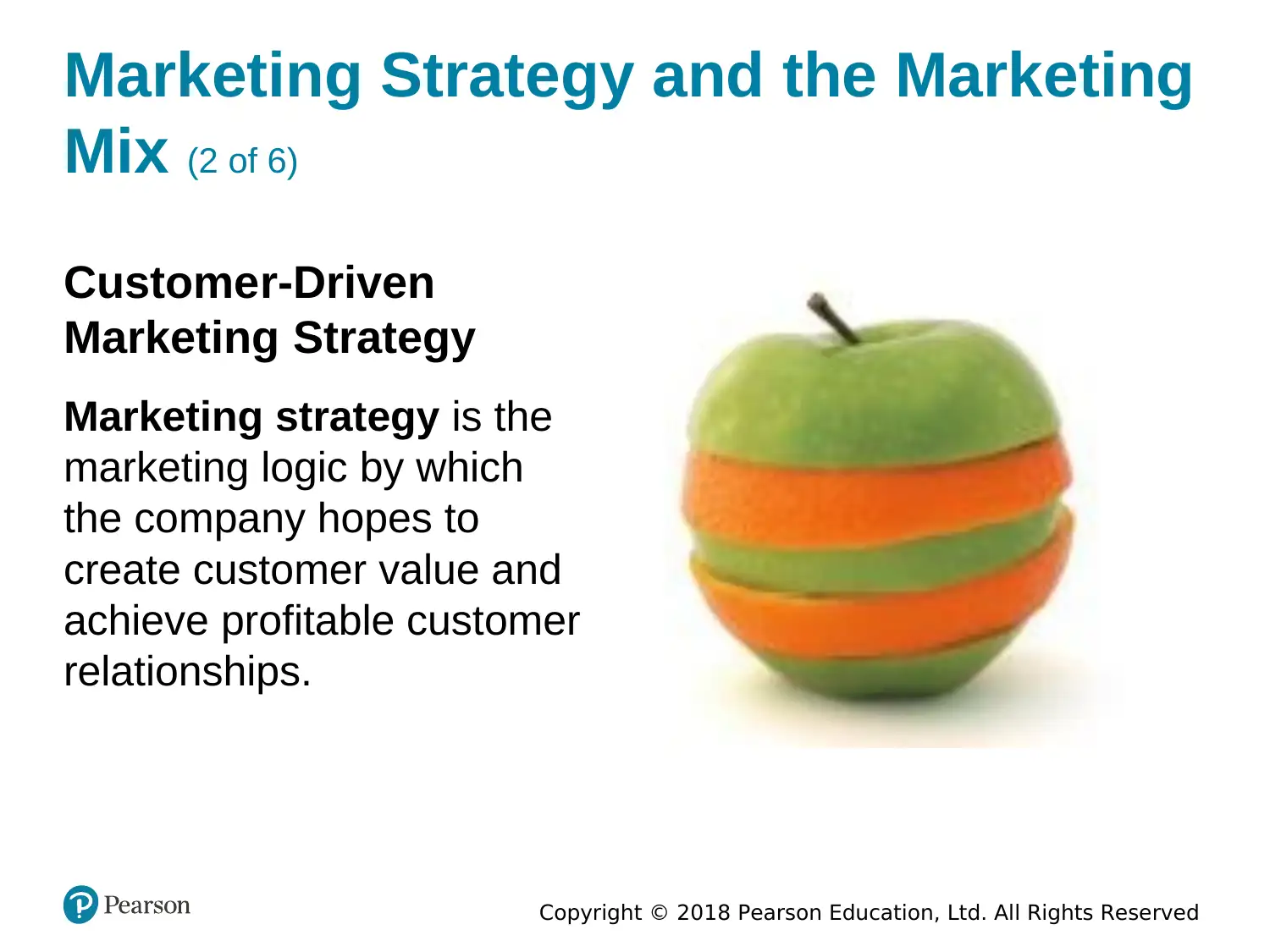
Copyright © 2018 Pearson Education, Ltd. All Rights Reserved
Marketing Strategy and the Marketing
Mix (2 of 6)
Customer-Driven
Marketing Strategy
Marketing strategy is the
marketing logic by which
the company hopes to
create customer value and
achieve profitable customer
relationships.
Marketing Strategy and the Marketing
Mix (2 of 6)
Customer-Driven
Marketing Strategy
Marketing strategy is the
marketing logic by which
the company hopes to
create customer value and
achieve profitable customer
relationships.
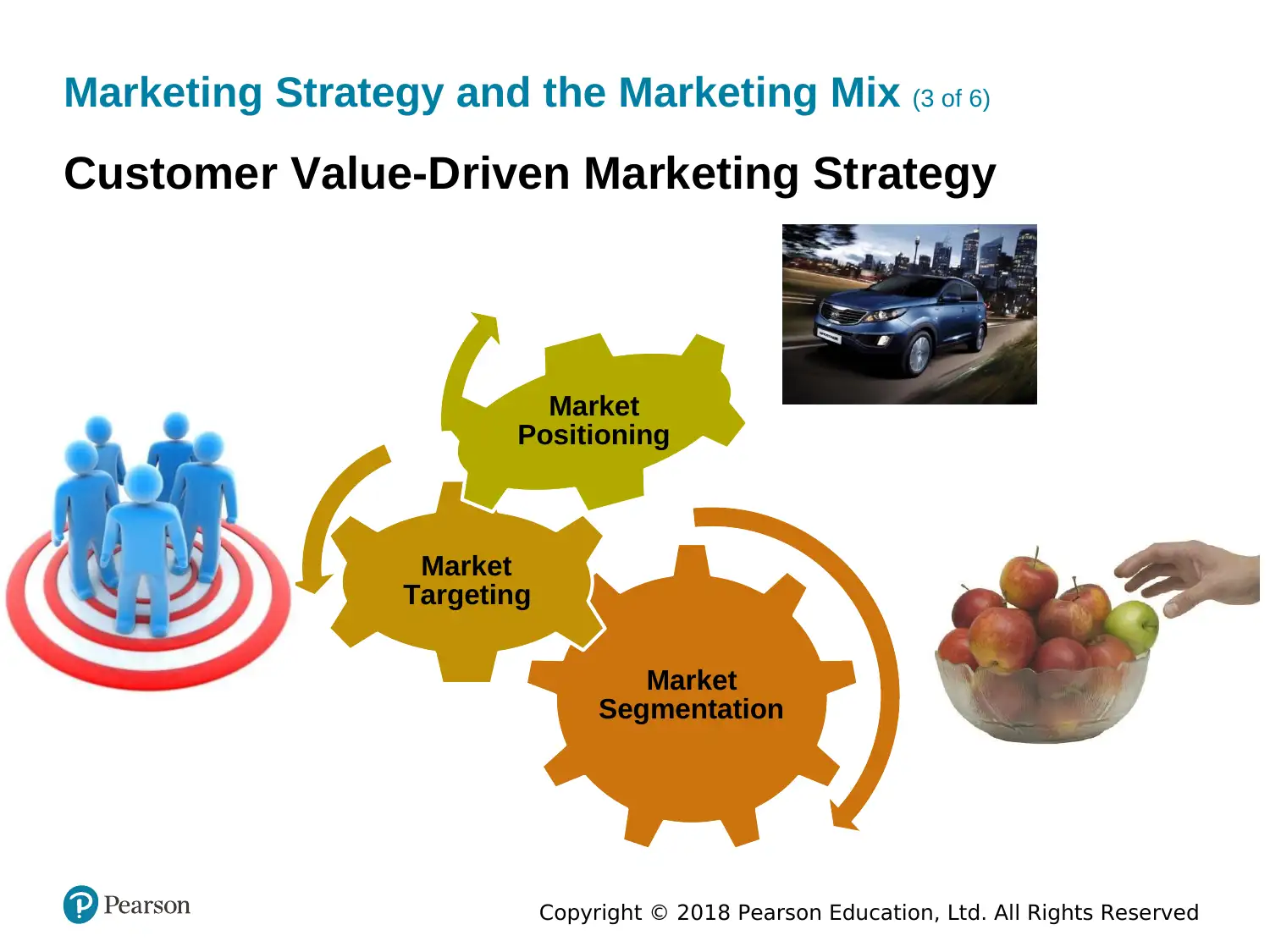
Copyright © 2018 Pearson Education, Ltd. All Rights Reserved
Marketing Strategy and the Marketing Mix (3 of 6)
Customer Value-Driven Marketing Strategy
Market
Segmentation
Market
Targeting
Market
Positioning
Marketing Strategy and the Marketing Mix (3 of 6)
Customer Value-Driven Marketing Strategy
Market
Segmentation
Market
Targeting
Market
Positioning
Secure Best Marks with AI Grader
Need help grading? Try our AI Grader for instant feedback on your assignments.
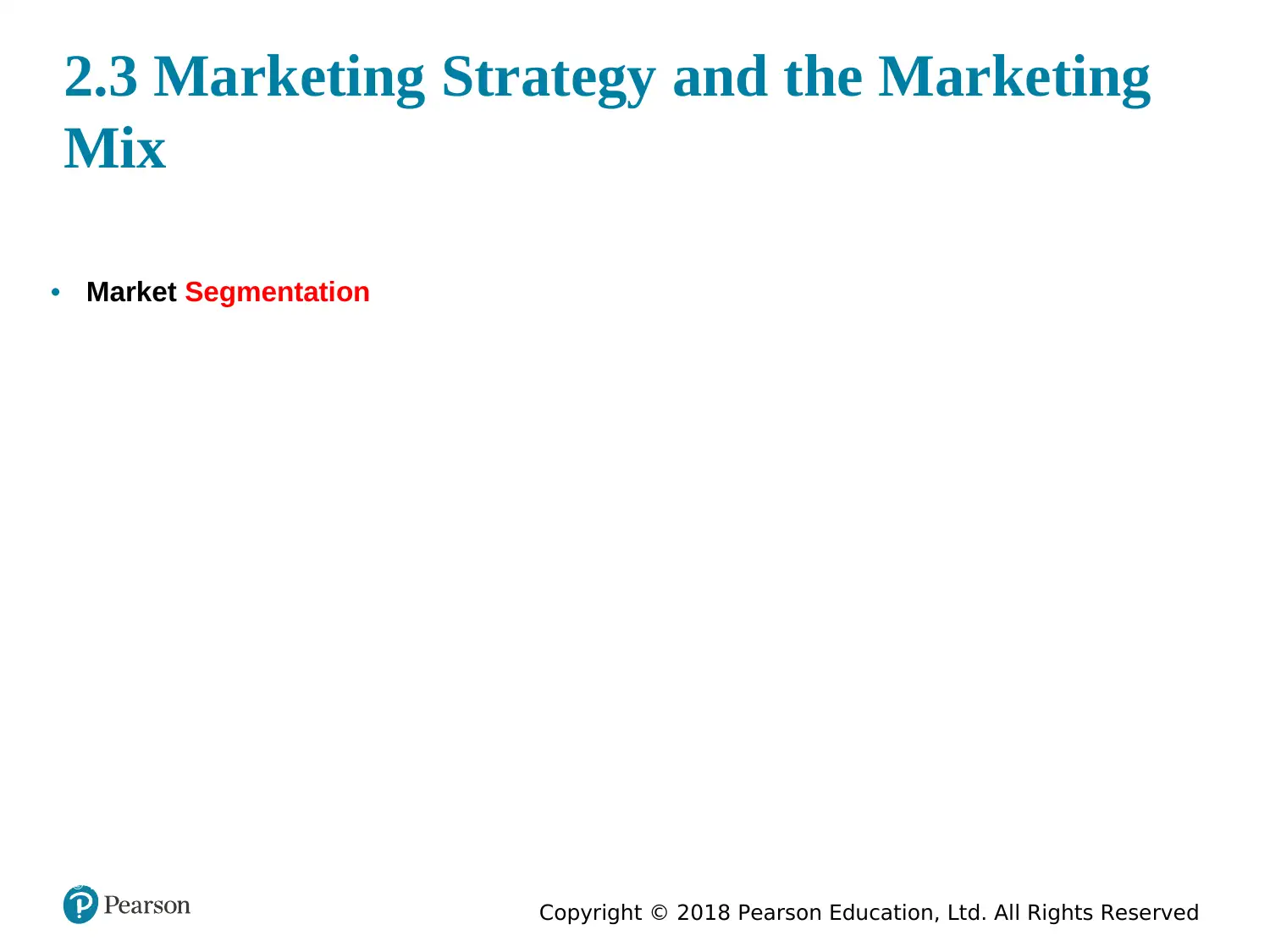
Copyright © 2018 Pearson Education, Ltd. All Rights Reserved
© 2012 Principles of Marketing: An Asian Perspective49
2.3 Marketing Strategy and the Marketing
Mix
• Market Segmentation
© 2012 Principles of Marketing: An Asian Perspective49
2.3 Marketing Strategy and the Marketing
Mix
• Market Segmentation

Copyright © 2018 Pearson Education, Ltd. All Rights Reserved
STP
STP
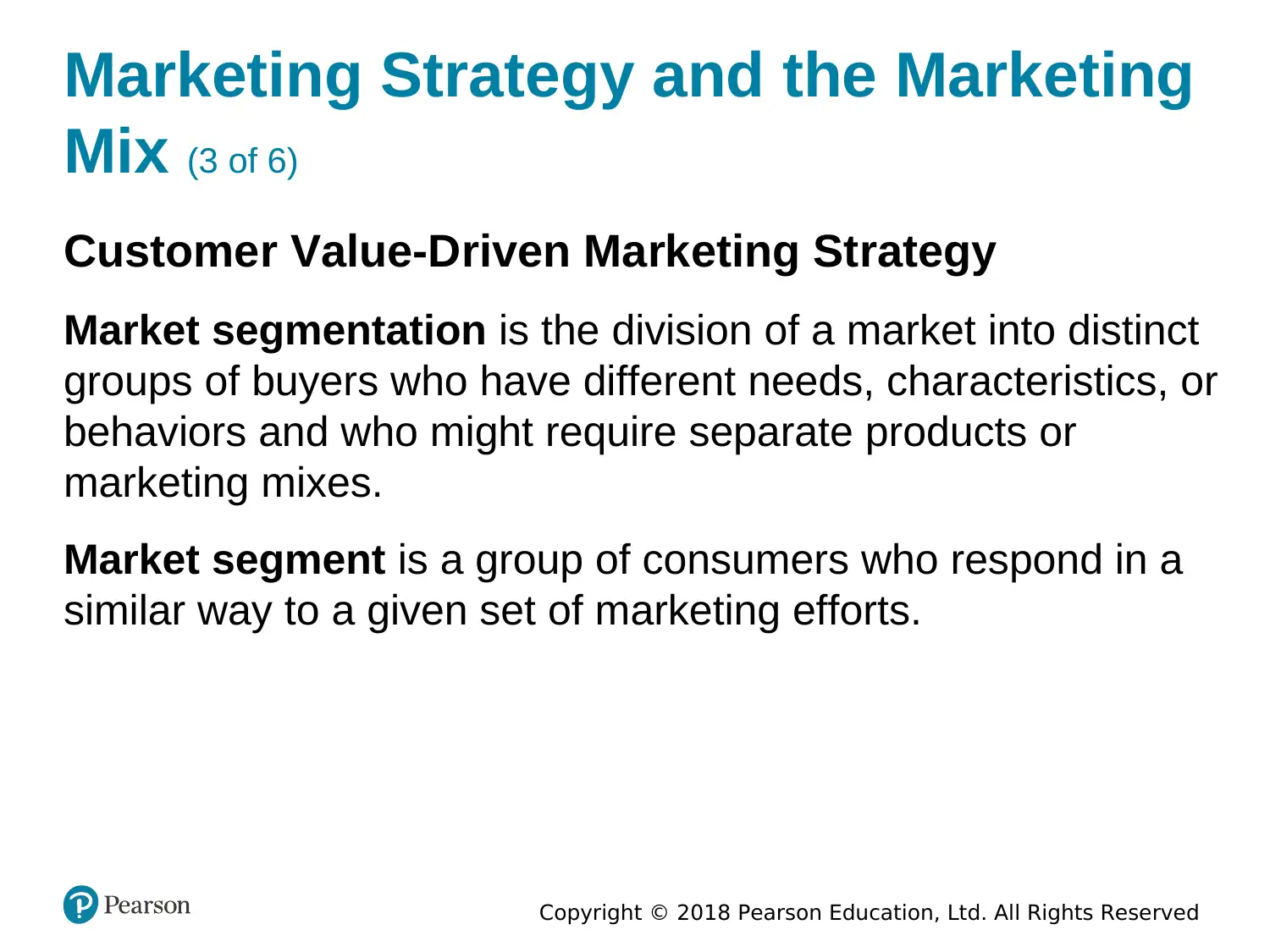
Copyright © 2018 Pearson Education, Ltd. All Rights Reserved
Marketing Strategy and the Marketing
Mix (3 of 6)
Customer Value-Driven Marketing Strategy
Market segmentation is the division of a market into distinct
groups of buyers who have different needs, characteristics, or
behaviors and who might require separate products or
marketing mixes.
Market segment is a group of consumers who respond in a
similar way to a given set of marketing efforts.
Marketing Strategy and the Marketing
Mix (3 of 6)
Customer Value-Driven Marketing Strategy
Market segmentation is the division of a market into distinct
groups of buyers who have different needs, characteristics, or
behaviors and who might require separate products or
marketing mixes.
Market segment is a group of consumers who respond in a
similar way to a given set of marketing efforts.
Paraphrase This Document
Need a fresh take? Get an instant paraphrase of this document with our AI Paraphraser
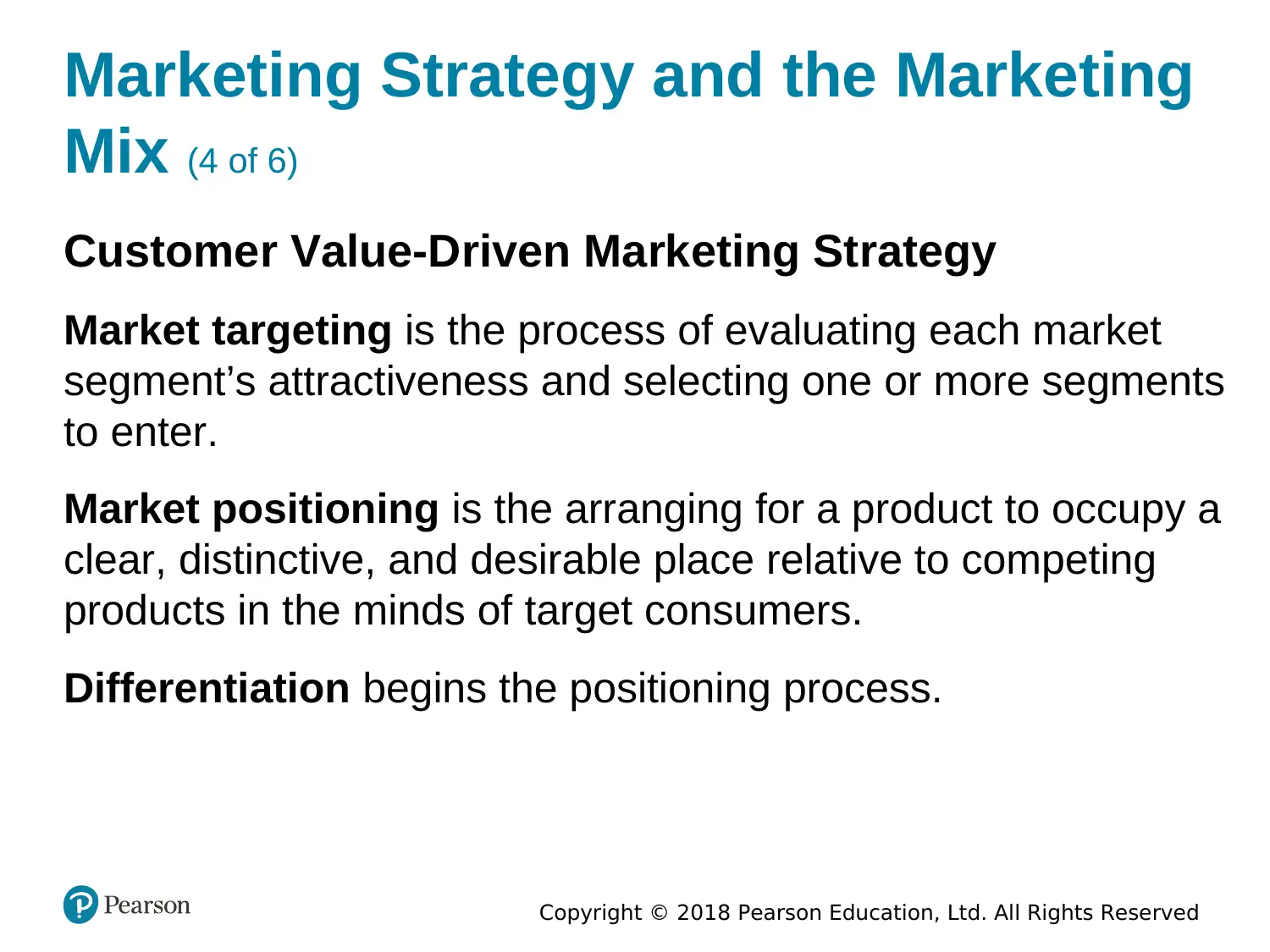
Copyright © 2018 Pearson Education, Ltd. All Rights Reserved
Marketing Strategy and the Marketing
Mix (4 of 6)
Customer Value-Driven Marketing Strategy
Market targeting is the process of evaluating each market
segment’s attractiveness and selecting one or more segments
to enter.
Market positioning is the arranging for a product to occupy a
clear, distinctive, and desirable place relative to competing
products in the minds of target consumers.
Differentiation begins the positioning process.
Marketing Strategy and the Marketing
Mix (4 of 6)
Customer Value-Driven Marketing Strategy
Market targeting is the process of evaluating each market
segment’s attractiveness and selecting one or more segments
to enter.
Market positioning is the arranging for a product to occupy a
clear, distinctive, and desirable place relative to competing
products in the minds of target consumers.
Differentiation begins the positioning process.
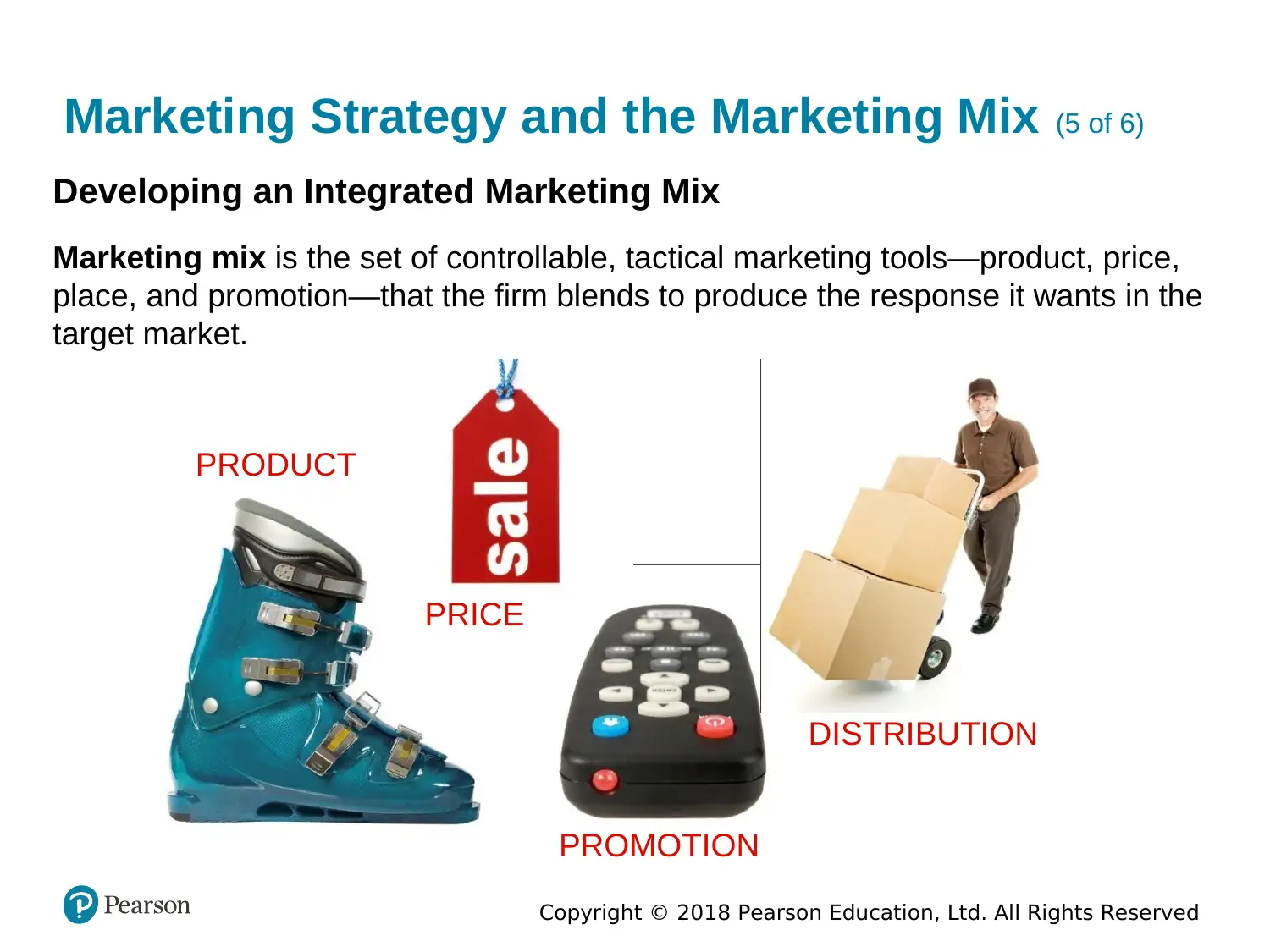
Copyright © 2018 Pearson Education, Ltd. All Rights Reserved
Marketing Strategy and the Marketing Mix (5 of 6)
Developing an Integrated Marketing Mix
Marketing mix is the set of controllable, tactical marketing tools—product, price,
place, and promotion—that the firm blends to produce the response it wants in the
target market.
PRICE
PROMOTION
PRODUCT
DISTRIBUTION
Marketing Strategy and the Marketing Mix (5 of 6)
Developing an Integrated Marketing Mix
Marketing mix is the set of controllable, tactical marketing tools—product, price,
place, and promotion—that the firm blends to produce the response it wants in the
target market.
PRICE
PROMOTION
PRODUCT
DISTRIBUTION
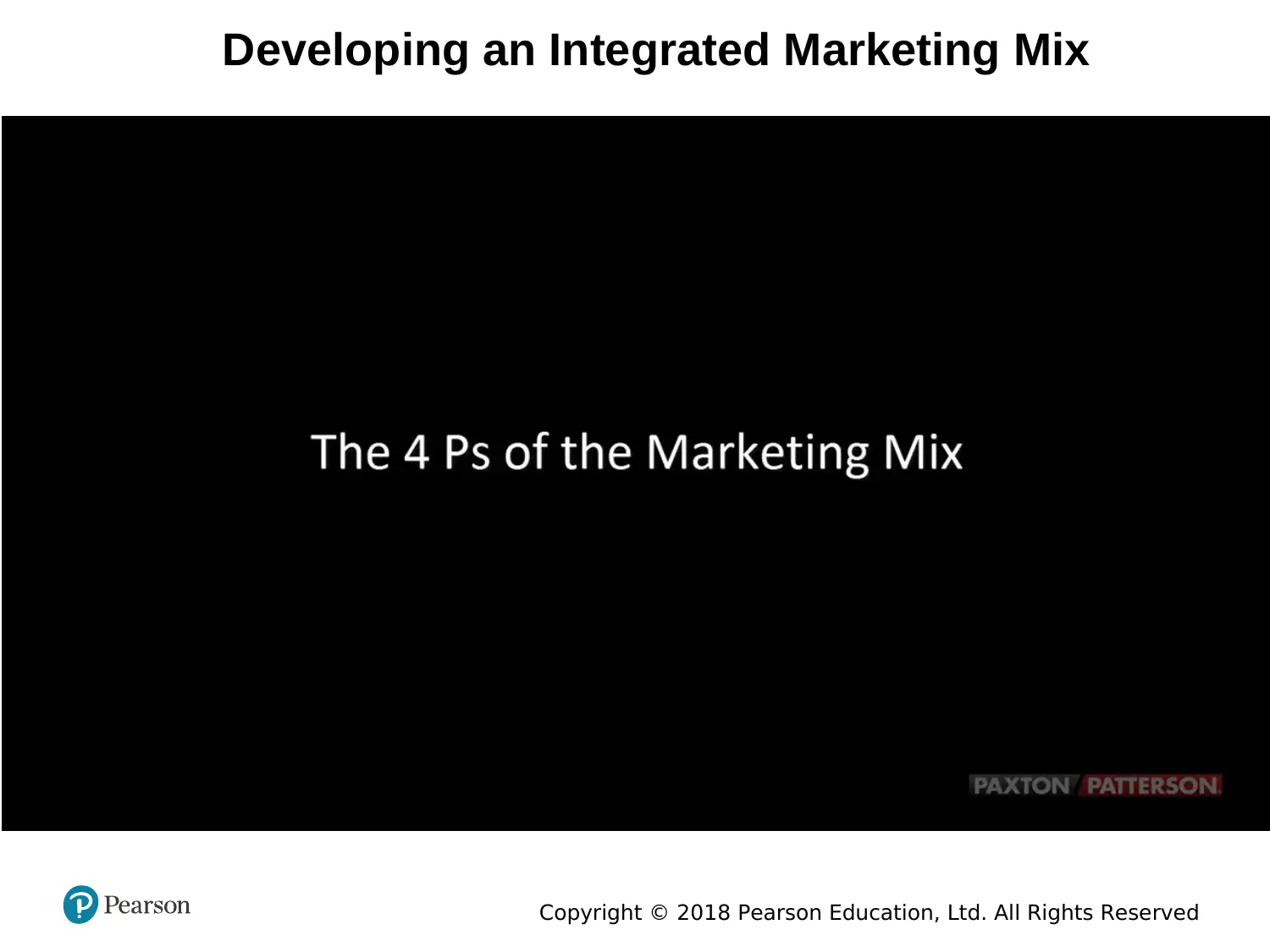
Copyright © 2018 Pearson Education, Ltd. All Rights Reserved
Developing an Integrated Marketing Mix
Developing an Integrated Marketing Mix
Secure Best Marks with AI Grader
Need help grading? Try our AI Grader for instant feedback on your assignments.
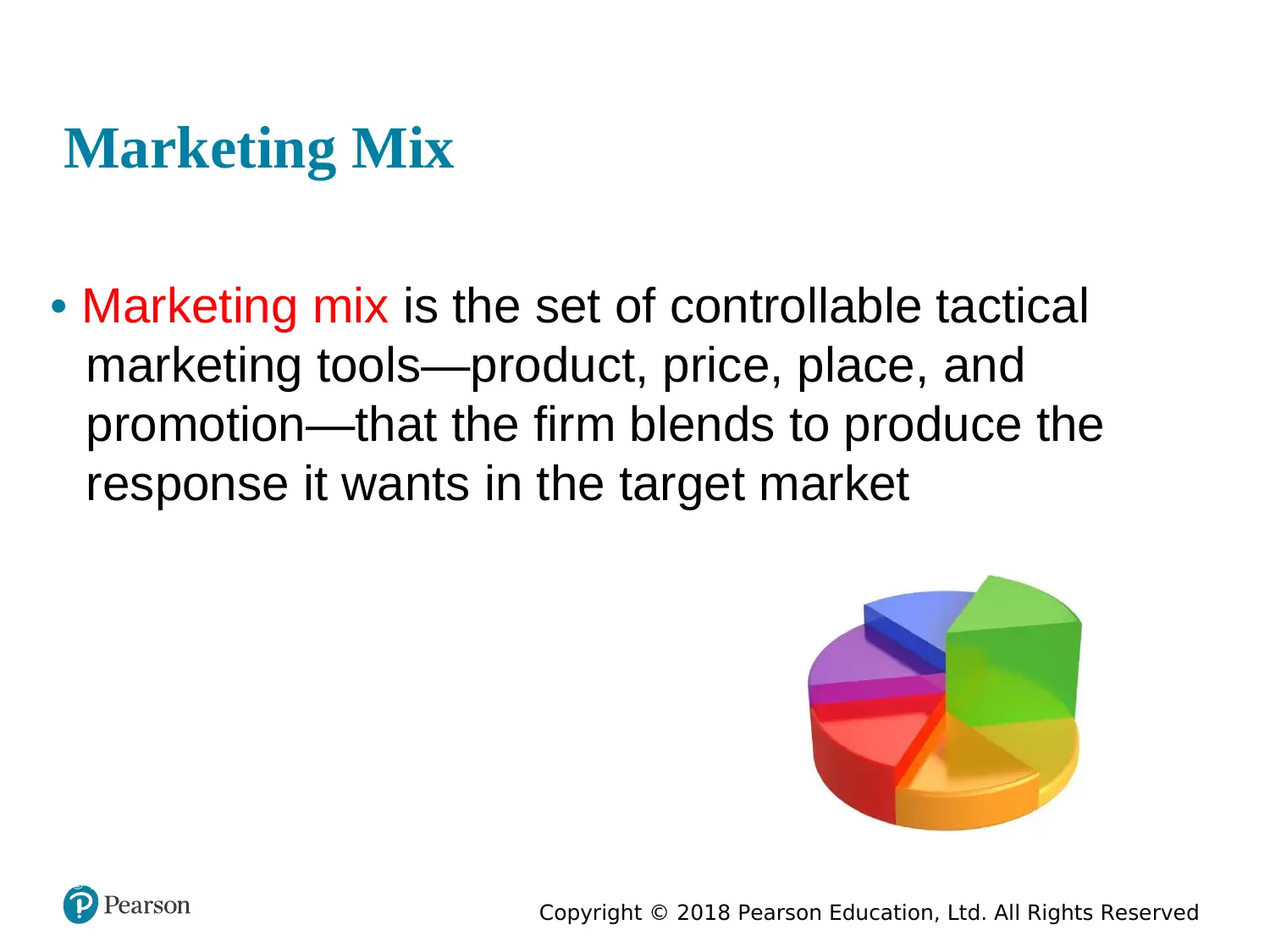
Copyright © 2018 Pearson Education, Ltd. All Rights Reserved
© 2012 Principles of Marketing: An Asian Perspective55
Marketing Mix
• Marketing mix is the set of controllable tactical
marketing tools—product, price, place, and
promotion—that the firm blends to produce the
response it wants in the target market
© 2012 Principles of Marketing: An Asian Perspective55
Marketing Mix
• Marketing mix is the set of controllable tactical
marketing tools—product, price, place, and
promotion—that the firm blends to produce the
response it wants in the target market
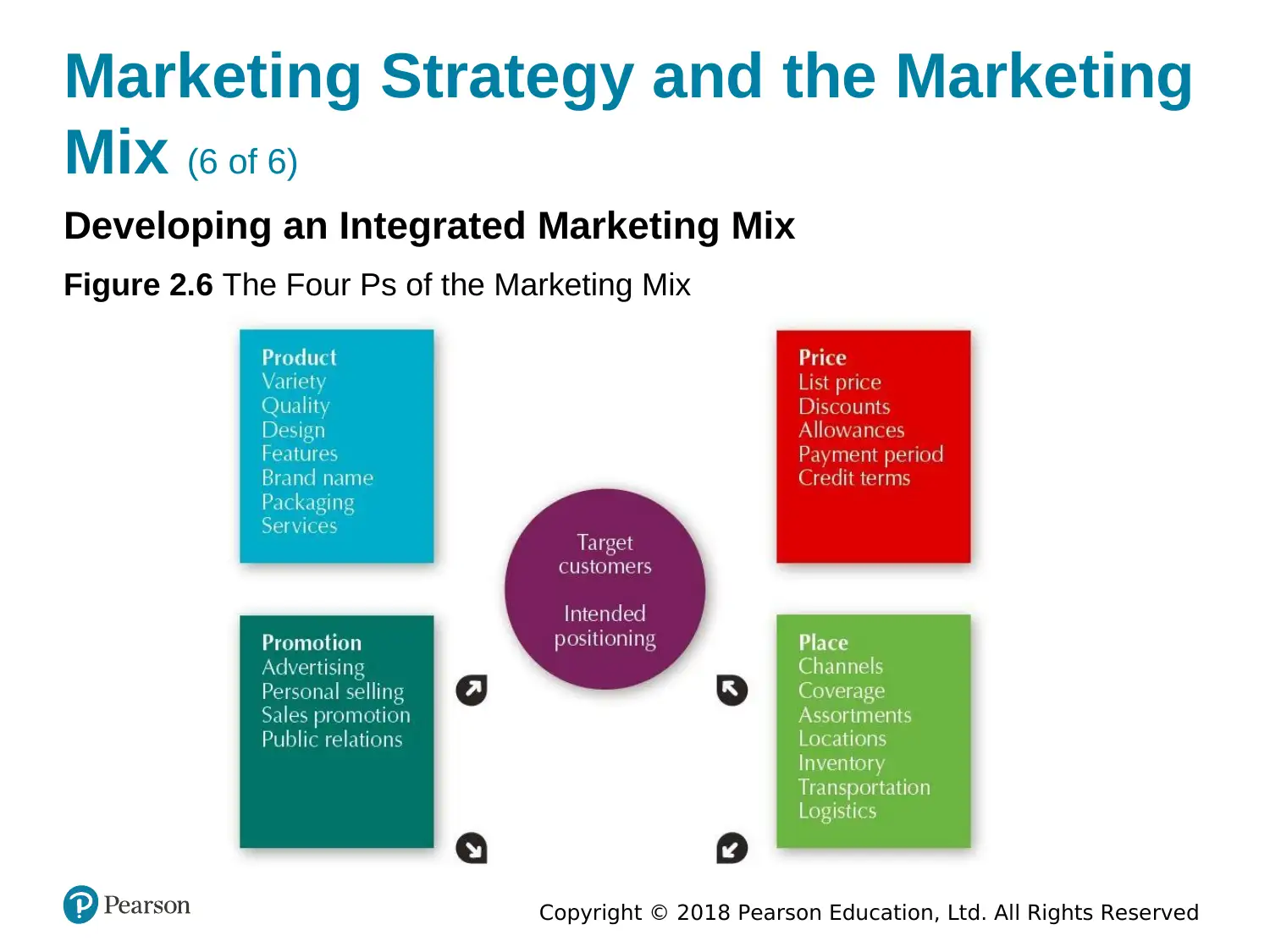
Copyright © 2018 Pearson Education, Ltd. All Rights Reserved
Marketing Strategy and the Marketing
Mix (6 of 6)
Developing an Integrated Marketing Mix
Figure 2.6 The Four Ps of the Marketing Mix
Marketing Strategy and the Marketing
Mix (6 of 6)
Developing an Integrated Marketing Mix
Figure 2.6 The Four Ps of the Marketing Mix
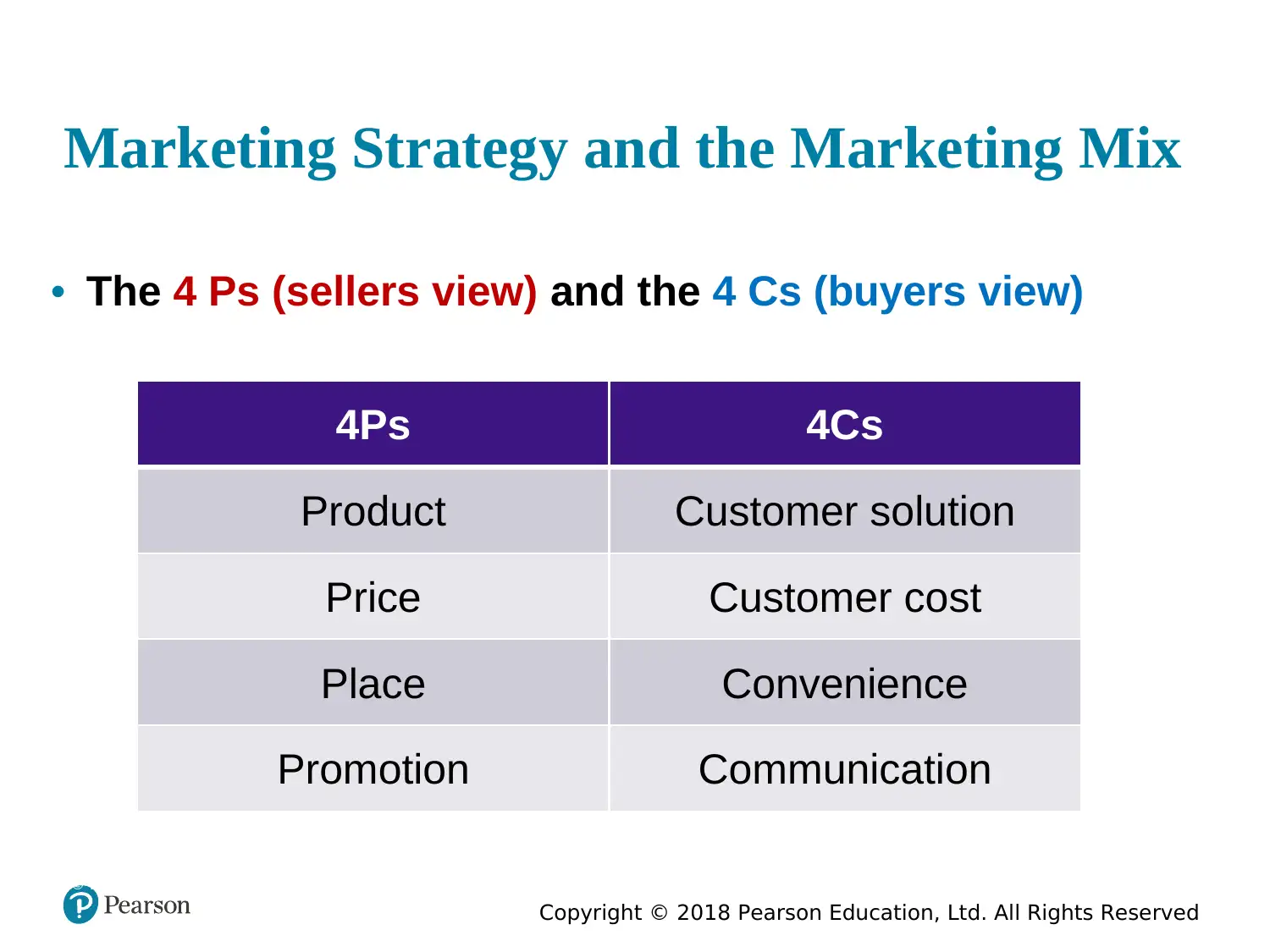
Copyright © 2018 Pearson Education, Ltd. All Rights Reserved
© 2012 Principles of Marketing: An Asian Perspective57
Marketing Strategy and the Marketing Mix
• The 4 Ps (sellers view) and the 4 Cs (buyers view)
4Ps 4Cs
Product Customer solution
Price Customer cost
Place Convenience
Promotion Communication
© 2012 Principles of Marketing: An Asian Perspective57
Marketing Strategy and the Marketing Mix
• The 4 Ps (sellers view) and the 4 Cs (buyers view)
4Ps 4Cs
Product Customer solution
Price Customer cost
Place Convenience
Promotion Communication
Paraphrase This Document
Need a fresh take? Get an instant paraphrase of this document with our AI Paraphraser
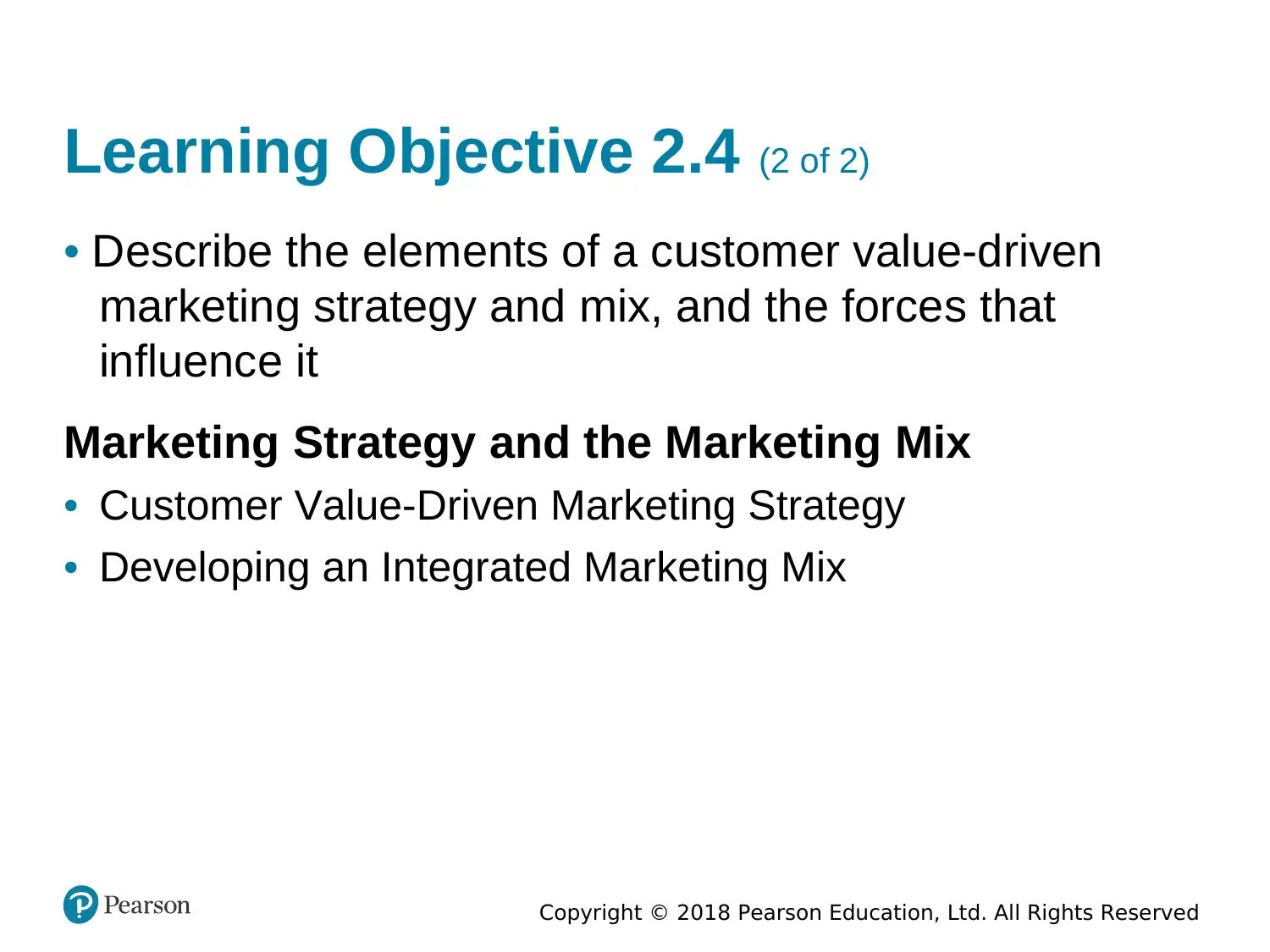
Copyright © 2018 Pearson Education, Ltd. All Rights Reserved
Learning Objective 2.4 (2 of 2)
• Describe the elements of a customer value-driven
marketing strategy and mix, and the forces that
influence it
Marketing Strategy and the Marketing Mix
• Customer Value-Driven Marketing Strategy
• Developing an Integrated Marketing Mix
Learning Objective 2.4 (2 of 2)
• Describe the elements of a customer value-driven
marketing strategy and mix, and the forces that
influence it
Marketing Strategy and the Marketing Mix
• Customer Value-Driven Marketing Strategy
• Developing an Integrated Marketing Mix
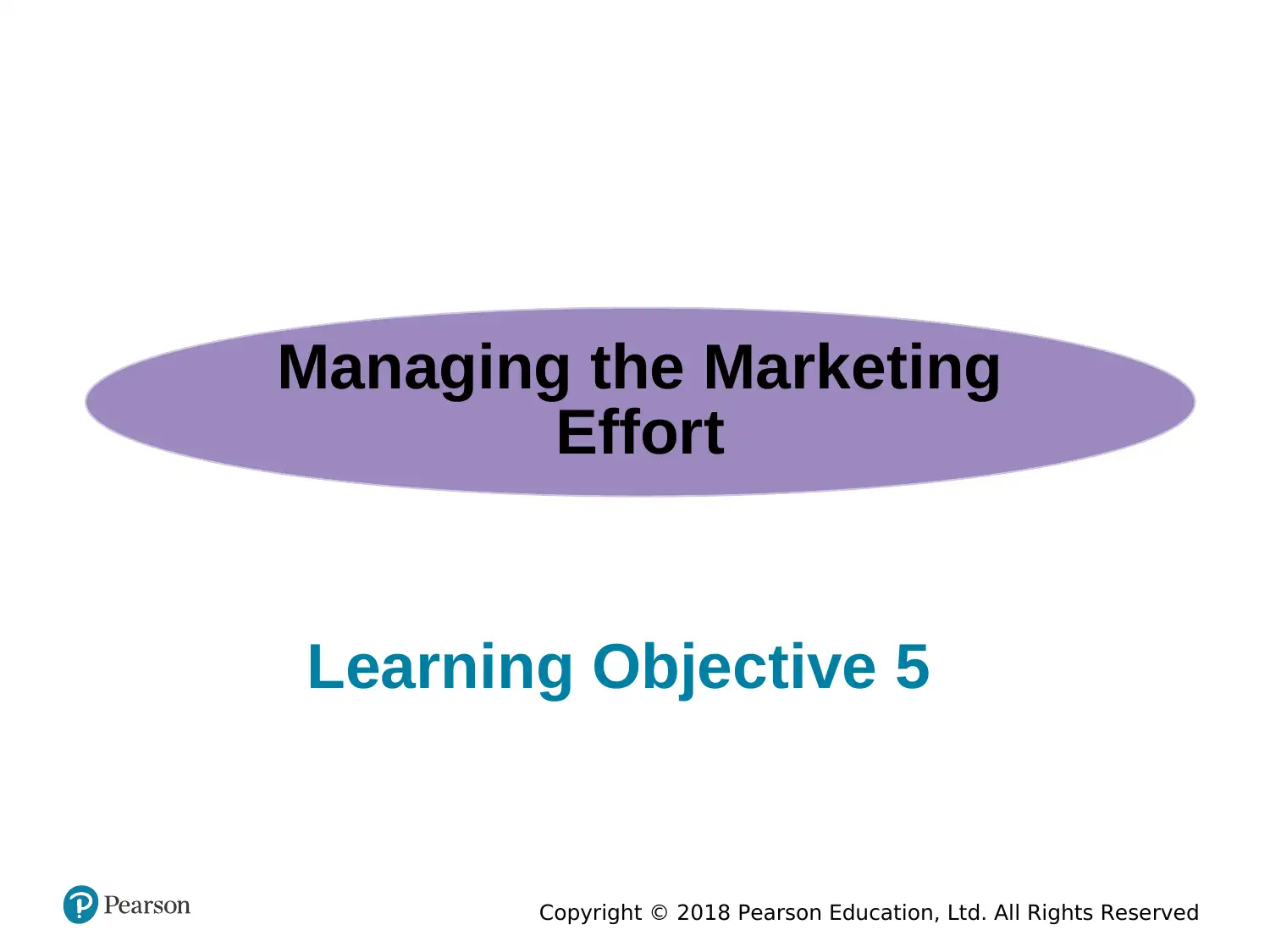
Copyright © 2018 Pearson Education, Ltd. All Rights Reserved
Managing the Marketing
Effort
Learning Objective 5
Managing the Marketing
Effort
Learning Objective 5
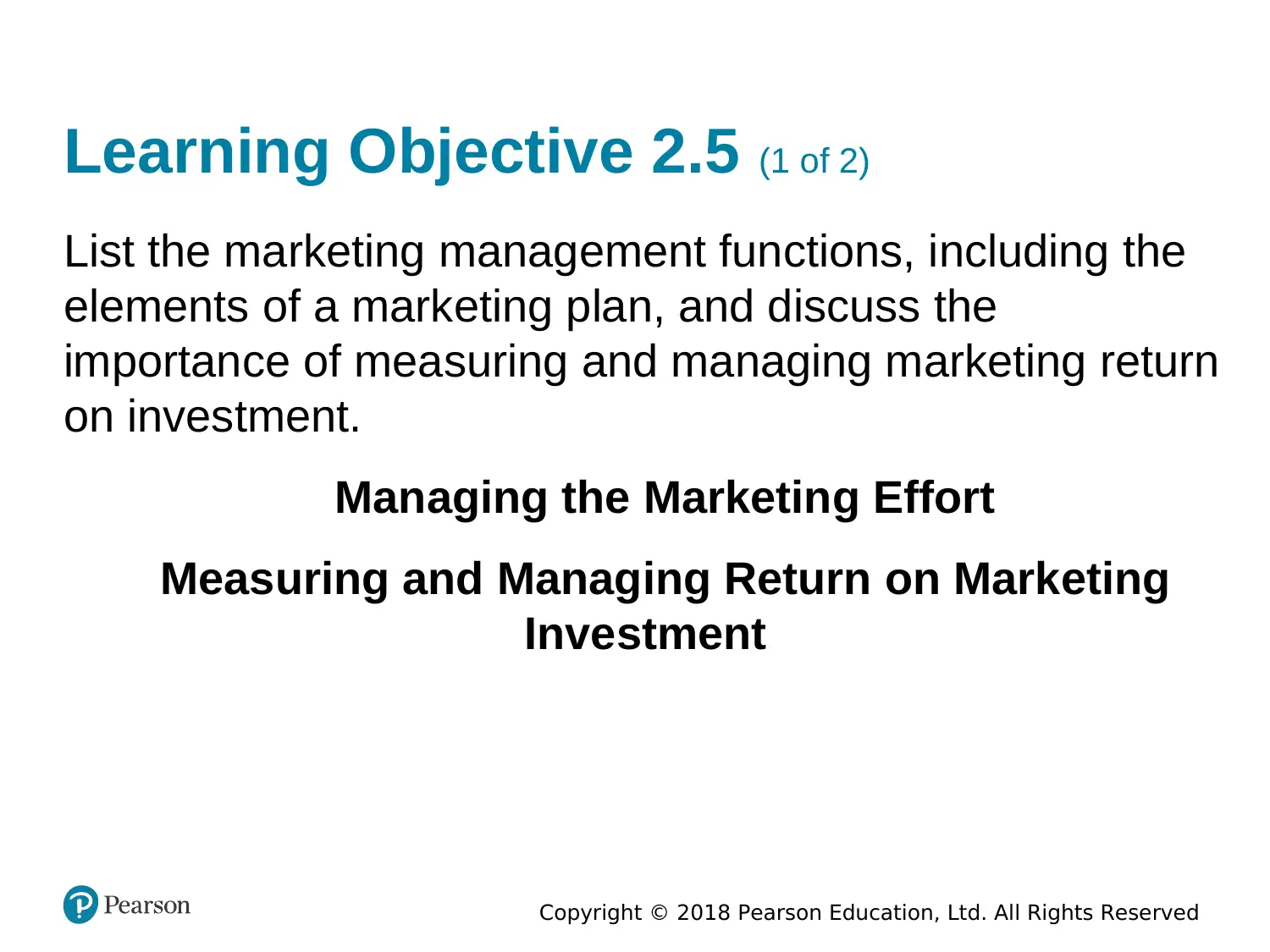
Copyright © 2018 Pearson Education, Ltd. All Rights Reserved
Learning Objective 2.5 (1 of 2)
List the marketing management functions, including the
elements of a marketing plan, and discuss the
importance of measuring and managing marketing return
on investment.
Managing the Marketing Effort
Measuring and Managing Return on Marketing
Investment
Learning Objective 2.5 (1 of 2)
List the marketing management functions, including the
elements of a marketing plan, and discuss the
importance of measuring and managing marketing return
on investment.
Managing the Marketing Effort
Measuring and Managing Return on Marketing
Investment
Secure Best Marks with AI Grader
Need help grading? Try our AI Grader for instant feedback on your assignments.
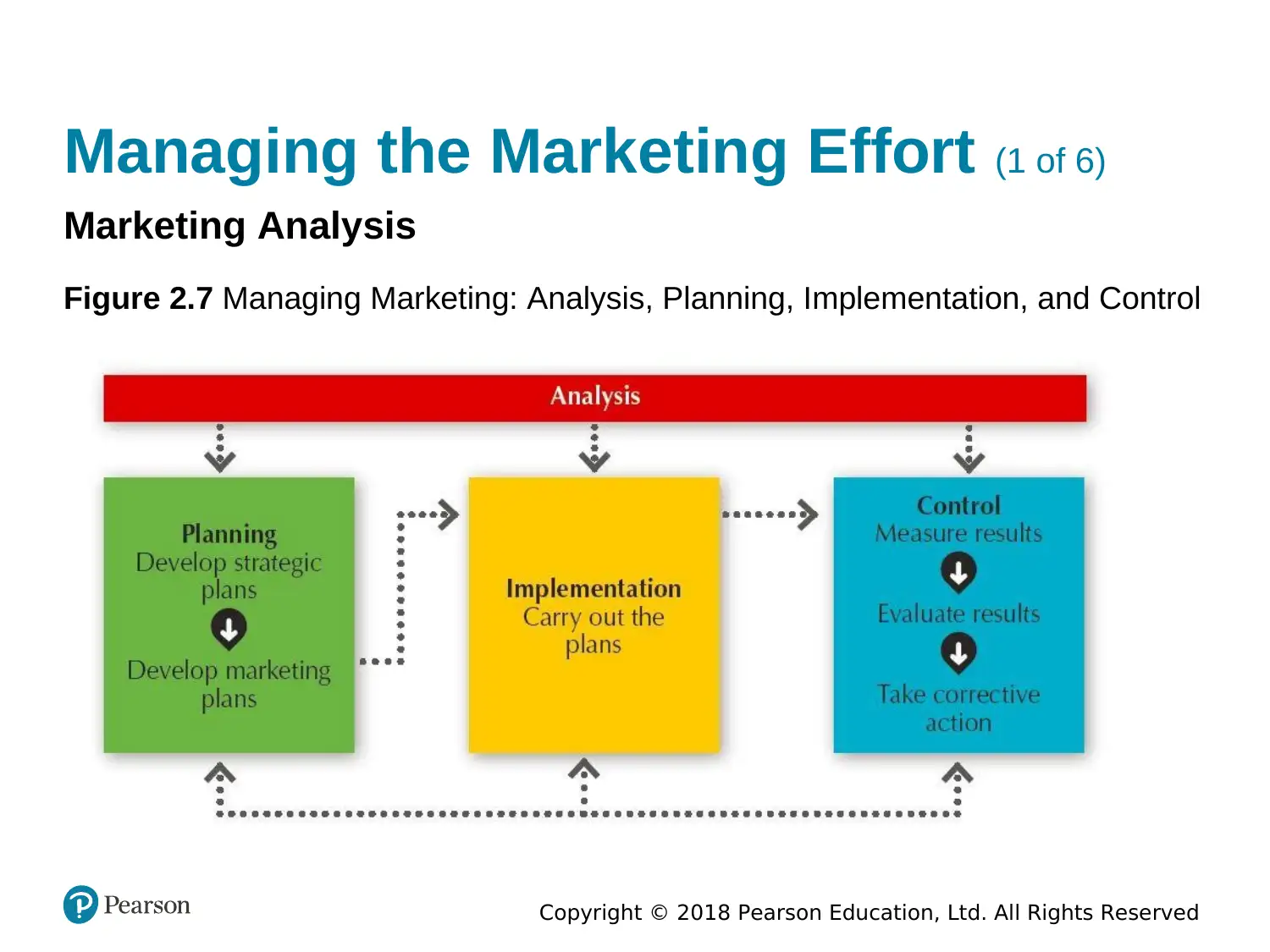
Copyright © 2018 Pearson Education, Ltd. All Rights Reserved
Managing the Marketing Effort (1 of 6)
Marketing Analysis
Figure 2.7 Managing Marketing: Analysis, Planning, Implementation, and Control
Managing the Marketing Effort (1 of 6)
Marketing Analysis
Figure 2.7 Managing Marketing: Analysis, Planning, Implementation, and Control
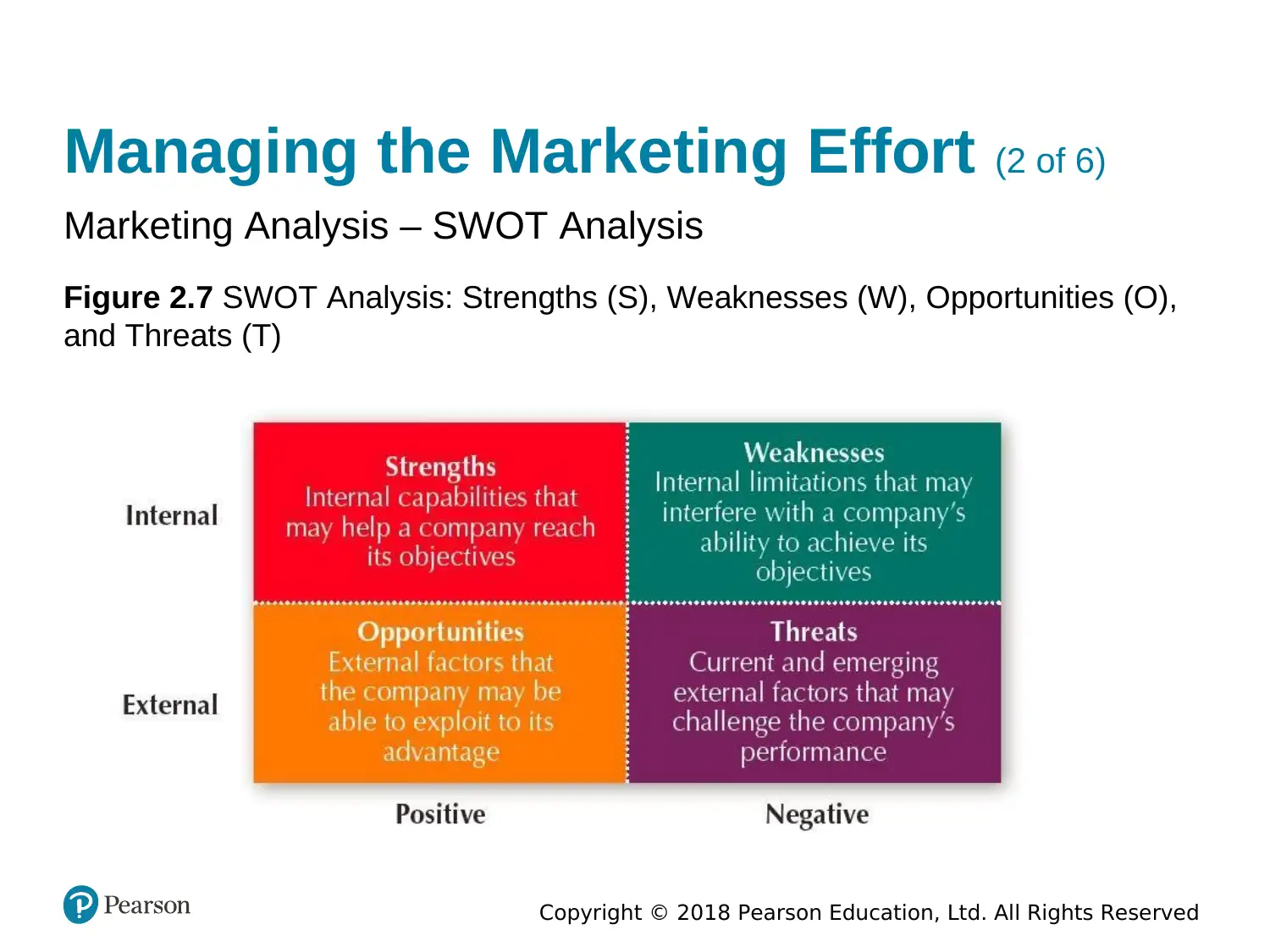
Copyright © 2018 Pearson Education, Ltd. All Rights Reserved
Managing the Marketing Effort (2 of 6)
Marketing Analysis – SWOT Analysis
Figure 2.7 SWOT Analysis: Strengths (S), Weaknesses (W), Opportunities (O),
and Threats (T)
Managing the Marketing Effort (2 of 6)
Marketing Analysis – SWOT Analysis
Figure 2.7 SWOT Analysis: Strengths (S), Weaknesses (W), Opportunities (O),
and Threats (T)
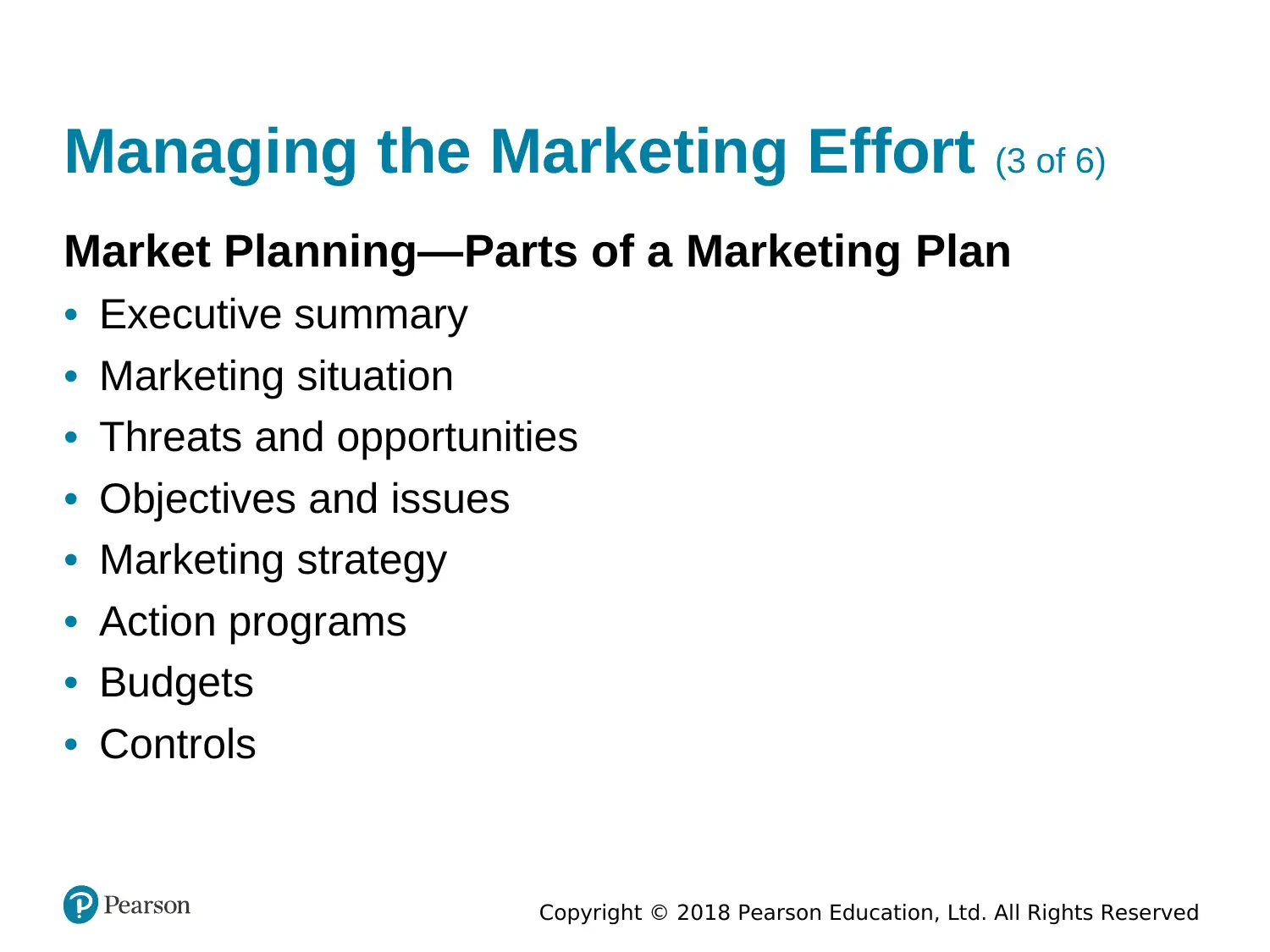
Copyright © 2018 Pearson Education, Ltd. All Rights Reserved
Managing the Marketing Effort (3 of 6)
Market Planning—Parts of a Marketing Plan
• Executive summary
• Marketing situation
• Threats and opportunities
• Objectives and issues
• Marketing strategy
• Action programs
• Budgets
• Controls
Managing the Marketing Effort (3 of 6)
Market Planning—Parts of a Marketing Plan
• Executive summary
• Marketing situation
• Threats and opportunities
• Objectives and issues
• Marketing strategy
• Action programs
• Budgets
• Controls
Paraphrase This Document
Need a fresh take? Get an instant paraphrase of this document with our AI Paraphraser
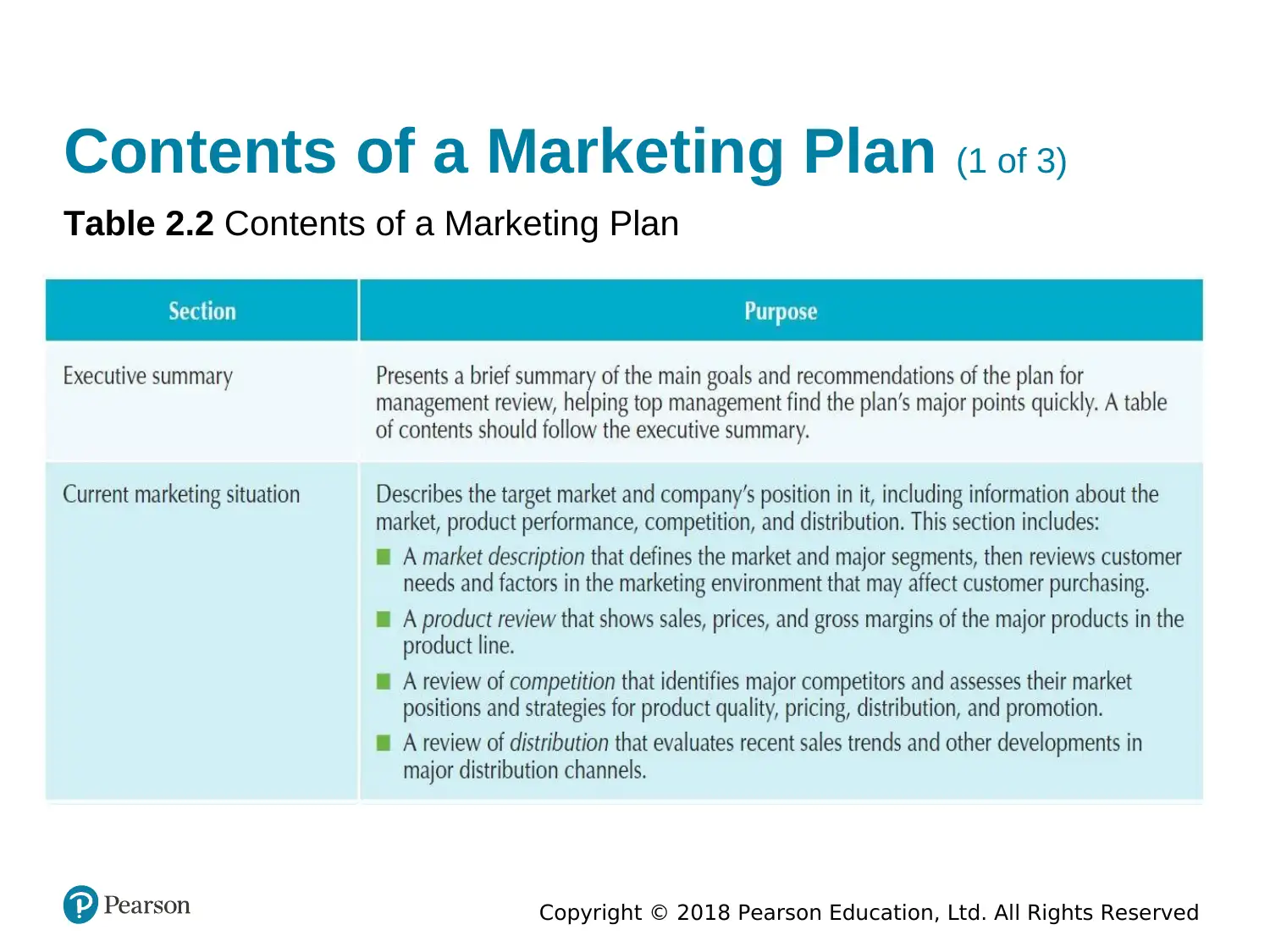
Copyright © 2018 Pearson Education, Ltd. All Rights Reserved
Contents of a Marketing Plan (1 of 3)
Table 2.2 Contents of a Marketing Plan
Contents of a Marketing Plan (1 of 3)
Table 2.2 Contents of a Marketing Plan
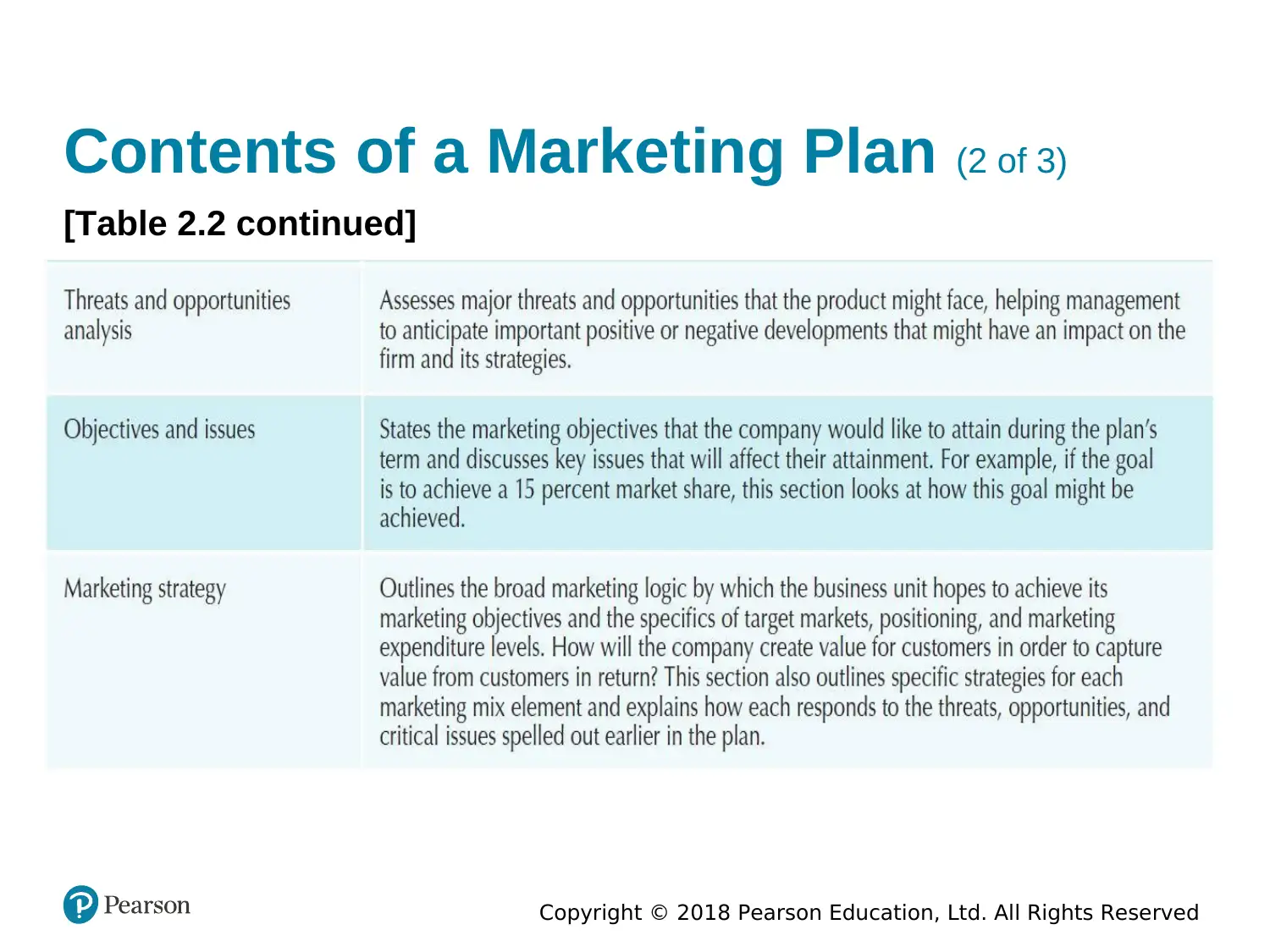
Copyright © 2018 Pearson Education, Ltd. All Rights Reserved
Contents of a Marketing Plan (2 of 3)
[Table 2.2 continued]
Contents of a Marketing Plan (2 of 3)
[Table 2.2 continued]
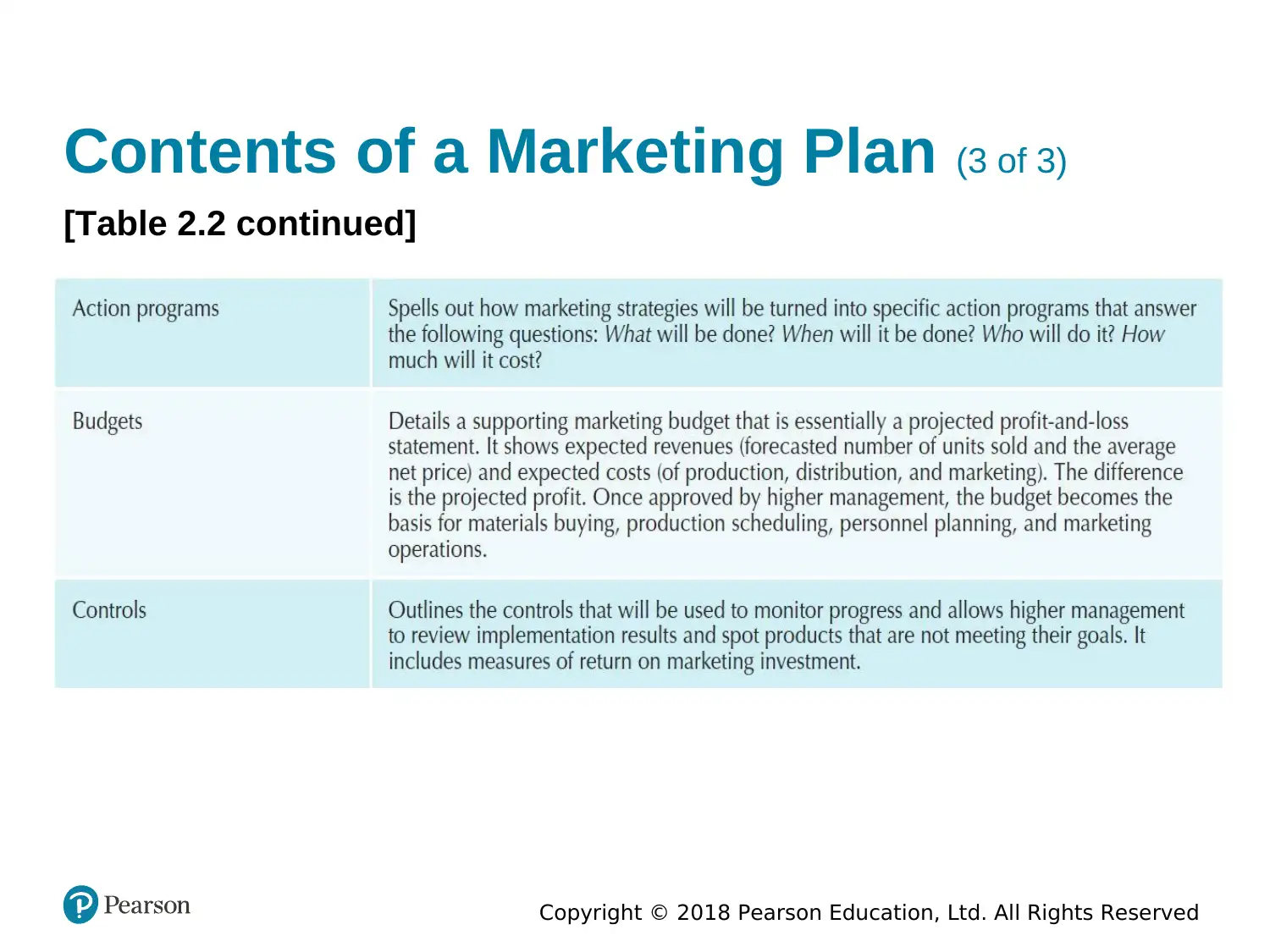
Copyright © 2018 Pearson Education, Ltd. All Rights Reserved
Contents of a Marketing Plan (3 of 3)
[Table 2.2 continued]
Contents of a Marketing Plan (3 of 3)
[Table 2.2 continued]
Secure Best Marks with AI Grader
Need help grading? Try our AI Grader for instant feedback on your assignments.
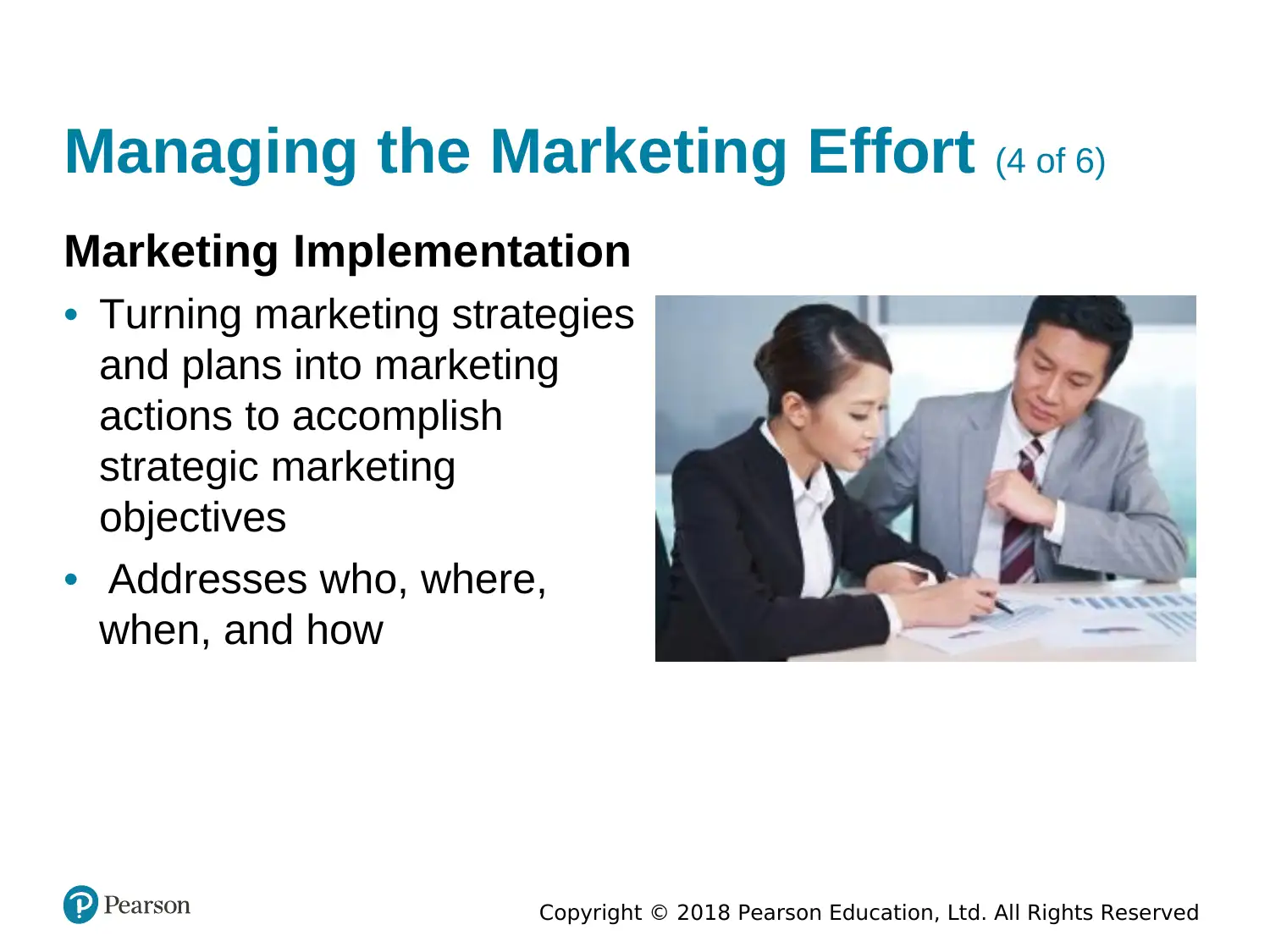
Copyright © 2018 Pearson Education, Ltd. All Rights Reserved
Managing the Marketing Effort (4 of 6)
Marketing Implementation
• Turning marketing strategies
and plans into marketing
actions to accomplish
strategic marketing
objectives
• Addresses who, where,
when, and how
Managing the Marketing Effort (4 of 6)
Marketing Implementation
• Turning marketing strategies
and plans into marketing
actions to accomplish
strategic marketing
objectives
• Addresses who, where,
when, and how
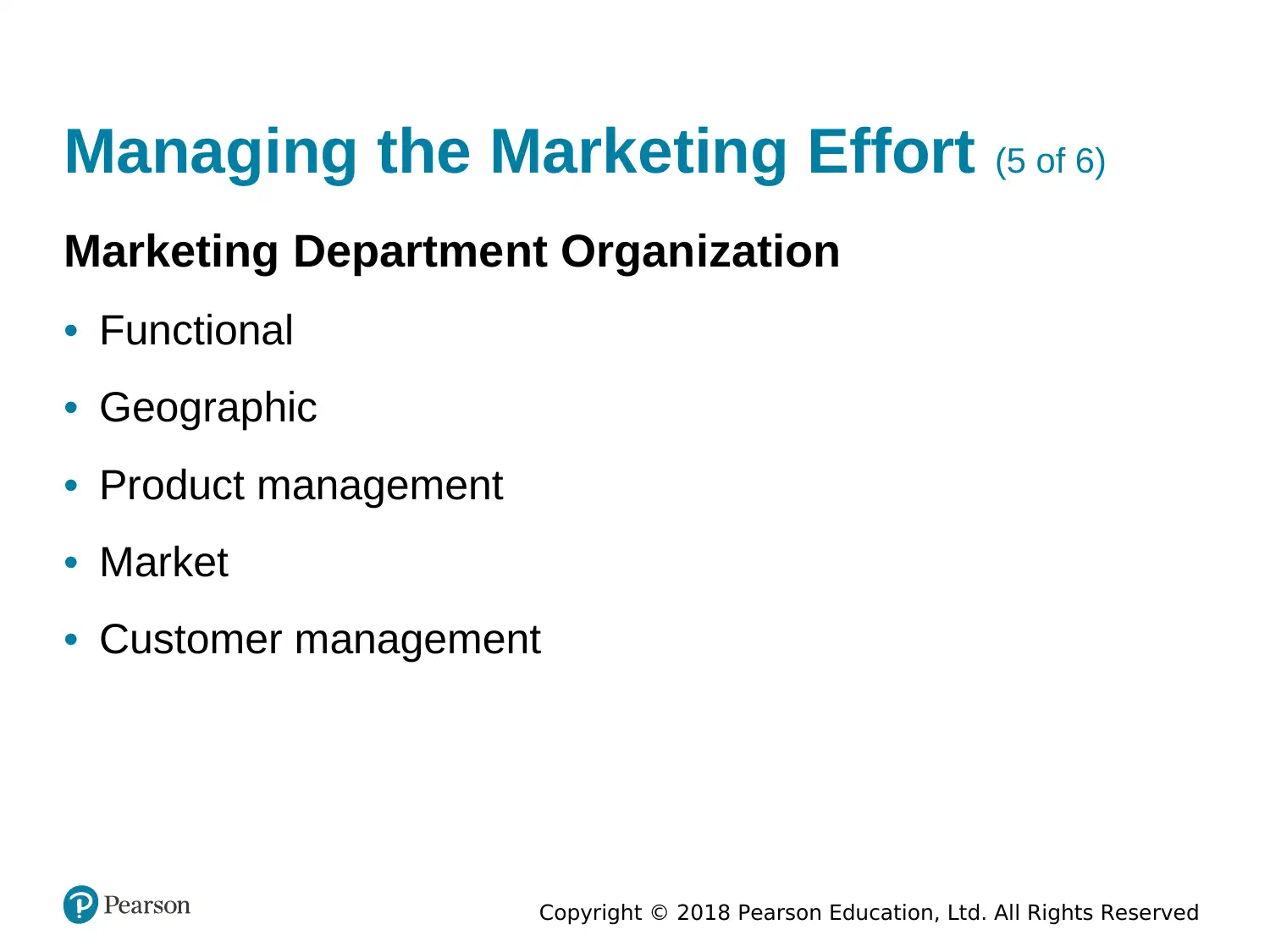
Copyright © 2018 Pearson Education, Ltd. All Rights Reserved
Managing the Marketing Effort (5 of 6)
Marketing Department Organization
• Functional
• Geographic
• Product management
• Market
• Customer management
Managing the Marketing Effort (5 of 6)
Marketing Department Organization
• Functional
• Geographic
• Product management
• Market
• Customer management
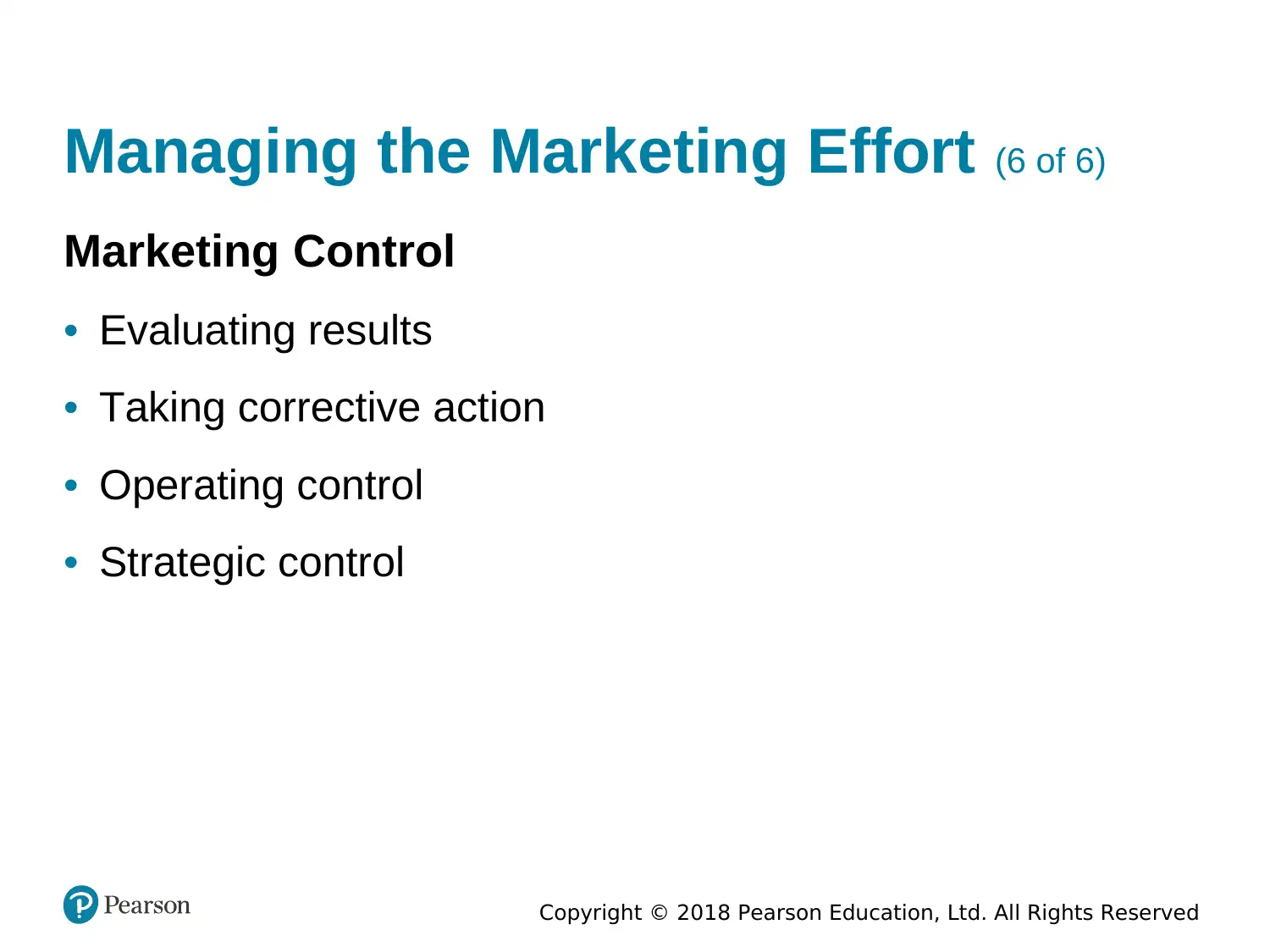
Copyright © 2018 Pearson Education, Ltd. All Rights Reserved
Managing the Marketing Effort (6 of 6)
Marketing Control
• Evaluating results
• Taking corrective action
• Operating control
• Strategic control
Managing the Marketing Effort (6 of 6)
Marketing Control
• Evaluating results
• Taking corrective action
• Operating control
• Strategic control
Paraphrase This Document
Need a fresh take? Get an instant paraphrase of this document with our AI Paraphraser
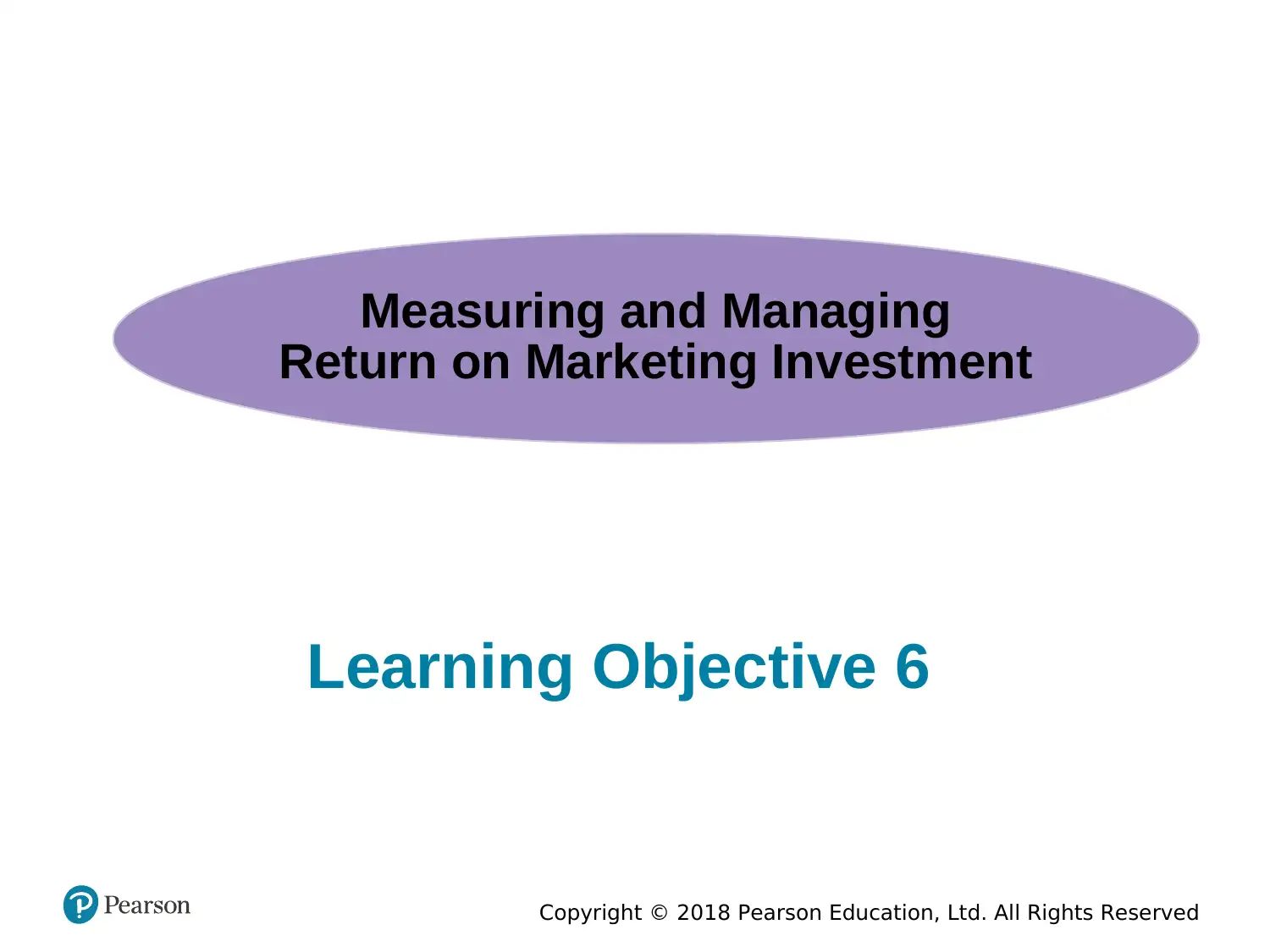
Copyright © 2018 Pearson Education, Ltd. All Rights Reserved
Measuring and Managing
Return on Marketing Investment
Learning Objective 6
Measuring and Managing
Return on Marketing Investment
Learning Objective 6
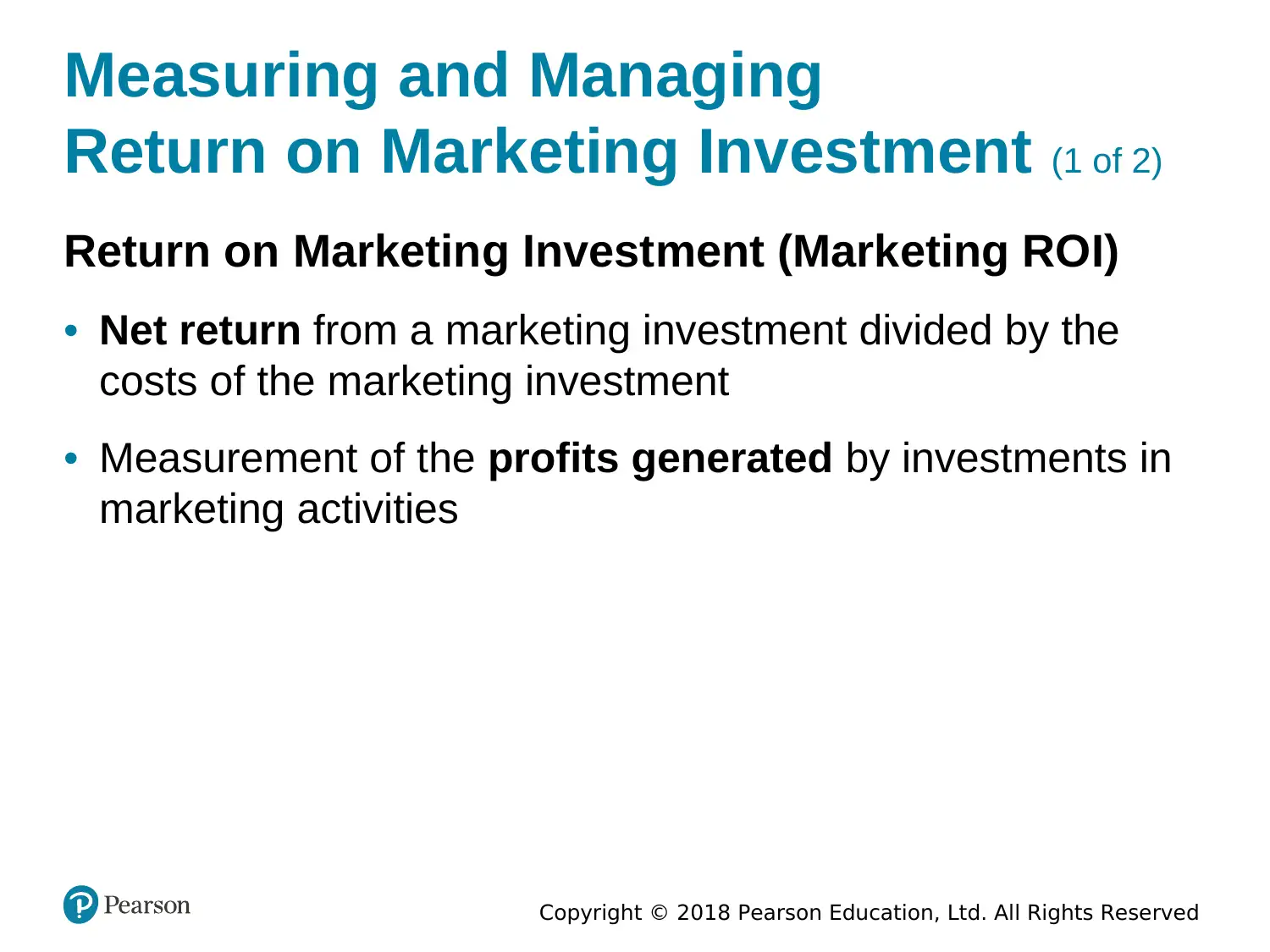
Copyright © 2018 Pearson Education, Ltd. All Rights Reserved
Measuring and Managing
Return on Marketing Investment (1 of 2)
Return on Marketing Investment (Marketing ROI)
• Net return from a marketing investment divided by the
costs of the marketing investment
• Measurement of the profits generated by investments in
marketing activities
Measuring and Managing
Return on Marketing Investment (1 of 2)
Return on Marketing Investment (Marketing ROI)
• Net return from a marketing investment divided by the
costs of the marketing investment
• Measurement of the profits generated by investments in
marketing activities
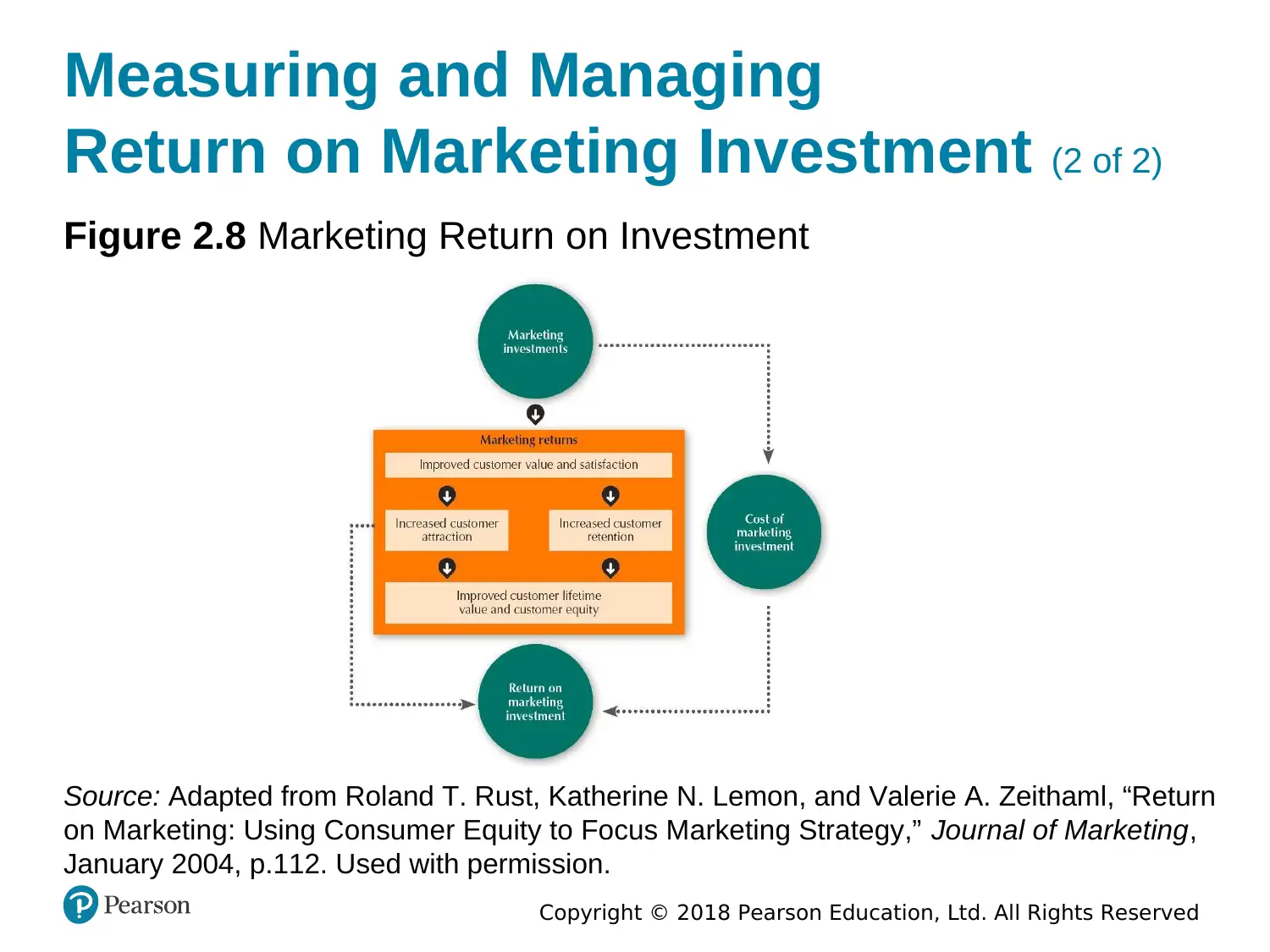
Copyright © 2018 Pearson Education, Ltd. All Rights Reserved
Measuring and Managing
Return on Marketing Investment (2 of 2)
Figure 2.8 Marketing Return on Investment
Source: Adapted from Roland T. Rust, Katherine N. Lemon, and Valerie A. Zeithaml, “Return
on Marketing: Using Consumer Equity to Focus Marketing Strategy,” Journal of Marketing,
January 2004, p.112. Used with permission.
Measuring and Managing
Return on Marketing Investment (2 of 2)
Figure 2.8 Marketing Return on Investment
Source: Adapted from Roland T. Rust, Katherine N. Lemon, and Valerie A. Zeithaml, “Return
on Marketing: Using Consumer Equity to Focus Marketing Strategy,” Journal of Marketing,
January 2004, p.112. Used with permission.
Secure Best Marks with AI Grader
Need help grading? Try our AI Grader for instant feedback on your assignments.
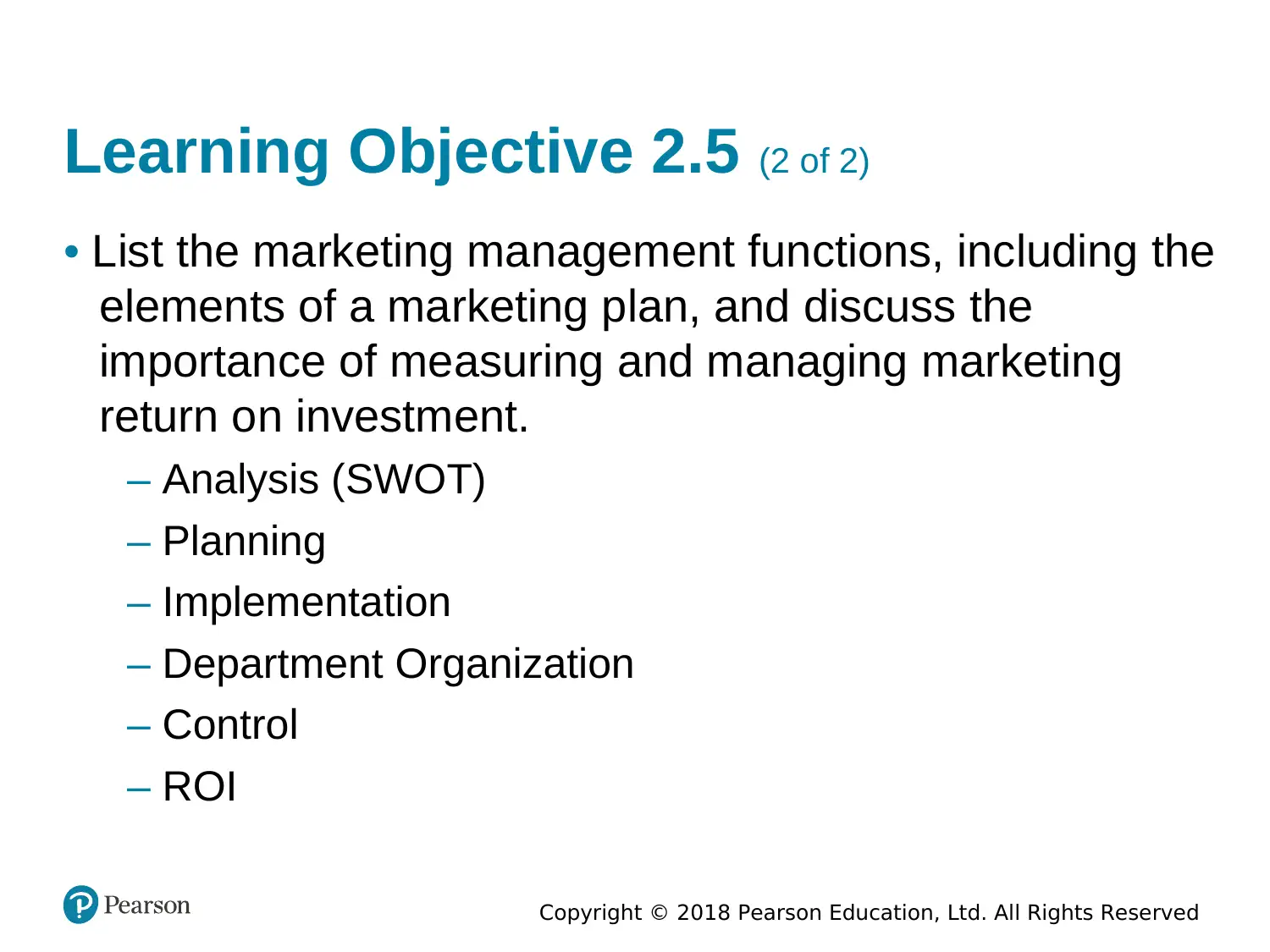
Copyright © 2018 Pearson Education, Ltd. All Rights Reserved
Learning Objective 2.5 (2 of 2)
• List the marketing management functions, including the
elements of a marketing plan, and discuss the
importance of measuring and managing marketing
return on investment.
– Analysis (SWOT)
– Planning
– Implementation
– Department Organization
– Control
– ROI
Learning Objective 2.5 (2 of 2)
• List the marketing management functions, including the
elements of a marketing plan, and discuss the
importance of measuring and managing marketing
return on investment.
– Analysis (SWOT)
– Planning
– Implementation
– Department Organization
– Control
– ROI
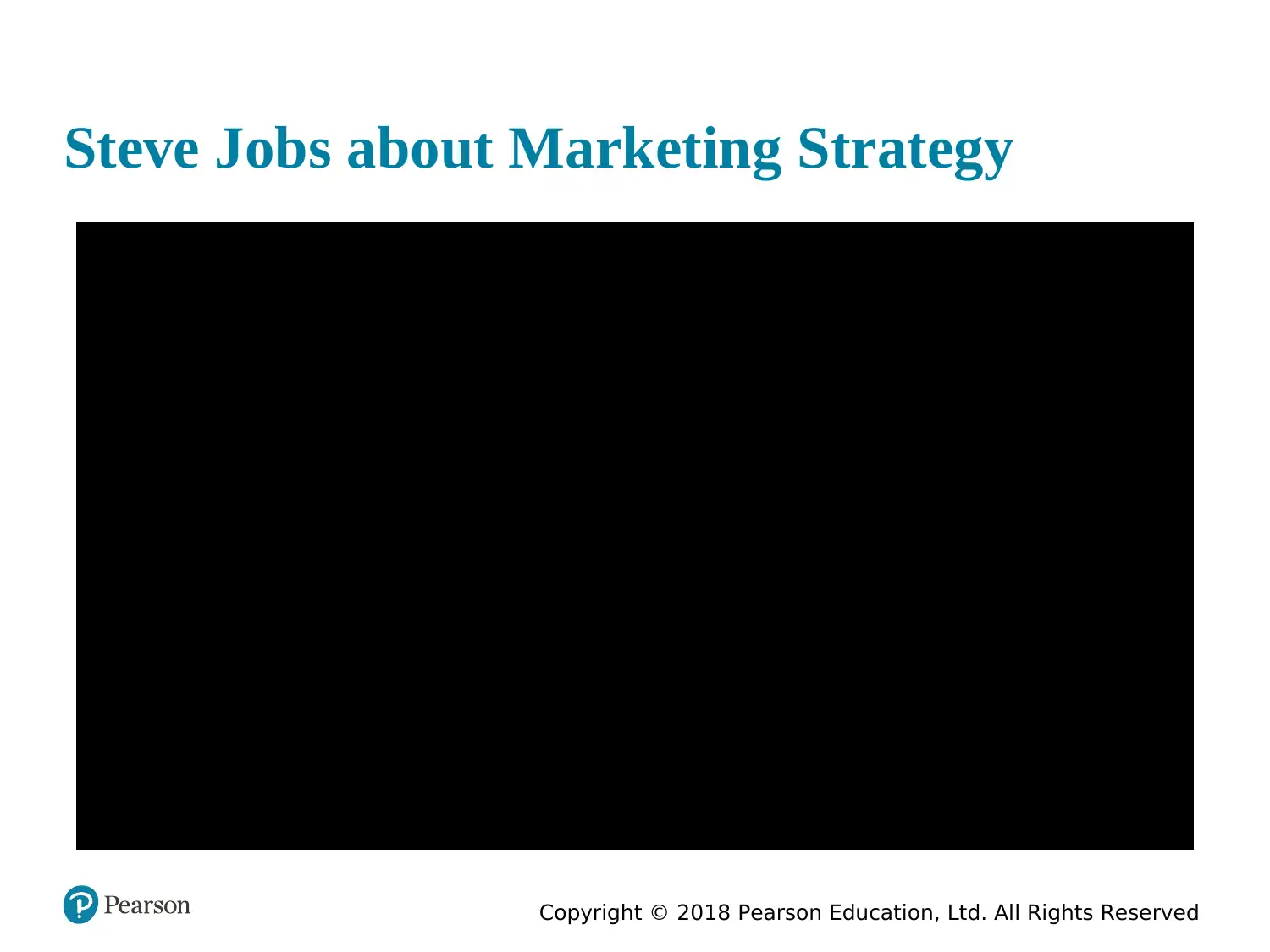
Copyright © 2018 Pearson Education, Ltd. All Rights Reserved
Steve Jobs about Marketing Strategy
Steve Jobs about Marketing Strategy
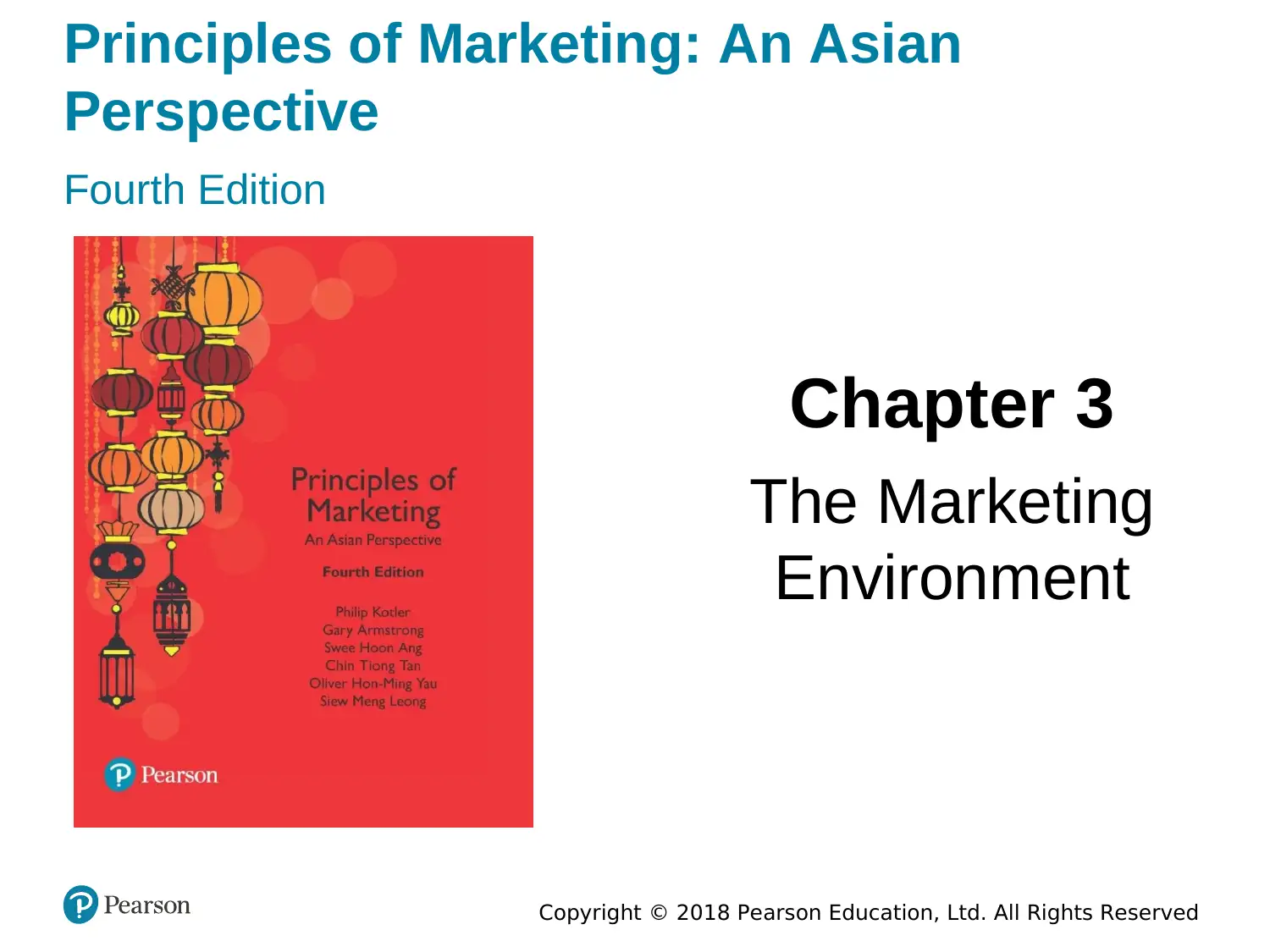
Fourth Edition
Chapter 3
The Marketing
Environment
Copyright © 2018 Pearson Education, Ltd. All Rights Reserved
Principles of Marketing: An Asian
Perspective
Chapter 3
The Marketing
Environment
Copyright © 2018 Pearson Education, Ltd. All Rights Reserved
Principles of Marketing: An Asian
Perspective
Paraphrase This Document
Need a fresh take? Get an instant paraphrase of this document with our AI Paraphraser
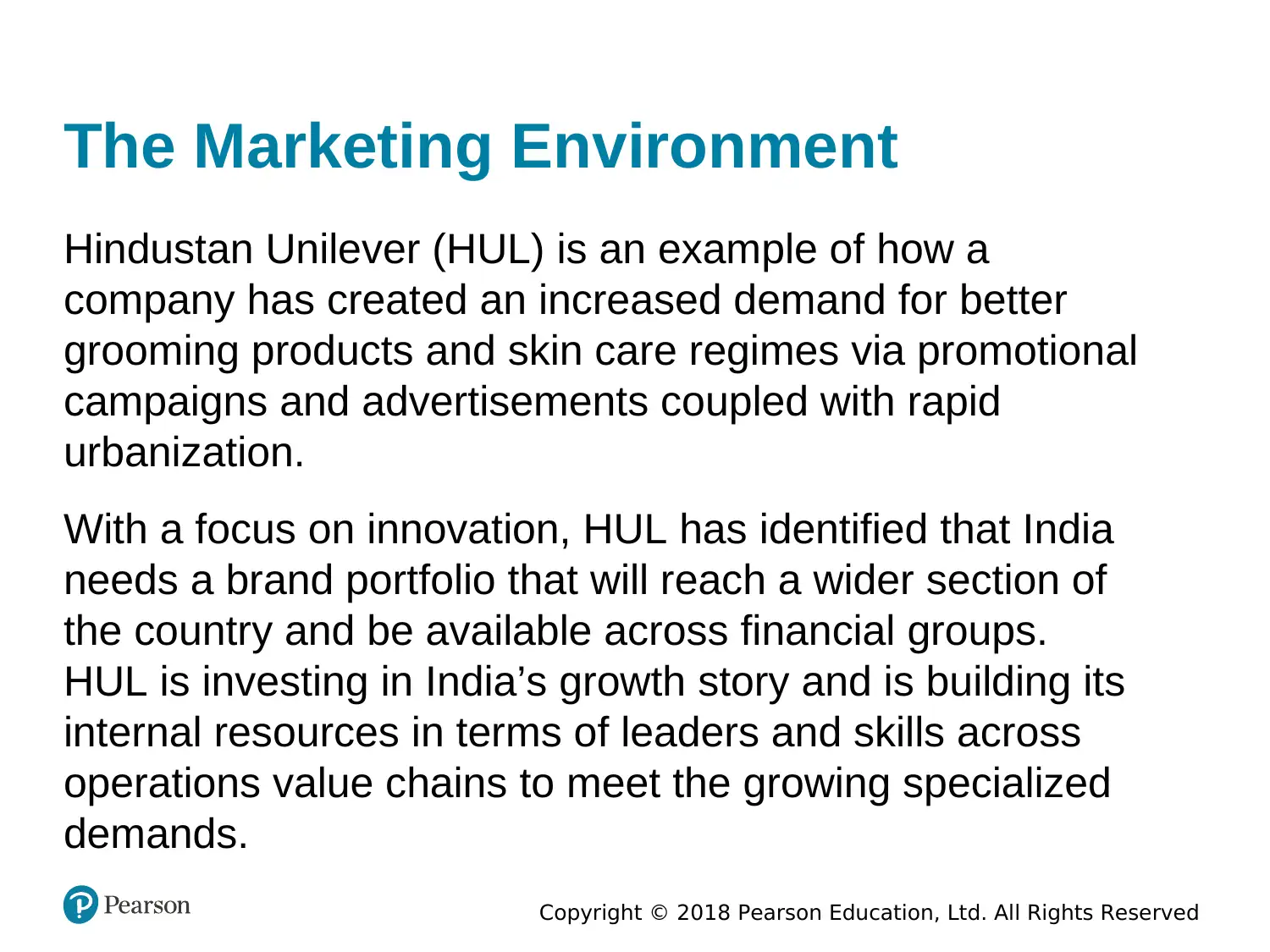
Copyright © 2018 Pearson Education, Ltd. All Rights Reserved
The Marketing Environment
Hindustan Unilever (HUL) is an example of how a
company has created an increased demand for better
grooming products and skin care regimes via promotional
campaigns and advertisements coupled with rapid
urbanization.
With a focus on innovation, HUL has identified that India
needs a brand portfolio that will reach a wider section of
the country and be available across financial groups.
HUL is investing in India’s growth story and is building its
internal resources in terms of leaders and skills across
operations value chains to meet the growing specialized
demands.
The Marketing Environment
Hindustan Unilever (HUL) is an example of how a
company has created an increased demand for better
grooming products and skin care regimes via promotional
campaigns and advertisements coupled with rapid
urbanization.
With a focus on innovation, HUL has identified that India
needs a brand portfolio that will reach a wider section of
the country and be available across financial groups.
HUL is investing in India’s growth story and is building its
internal resources in terms of leaders and skills across
operations value chains to meet the growing specialized
demands.
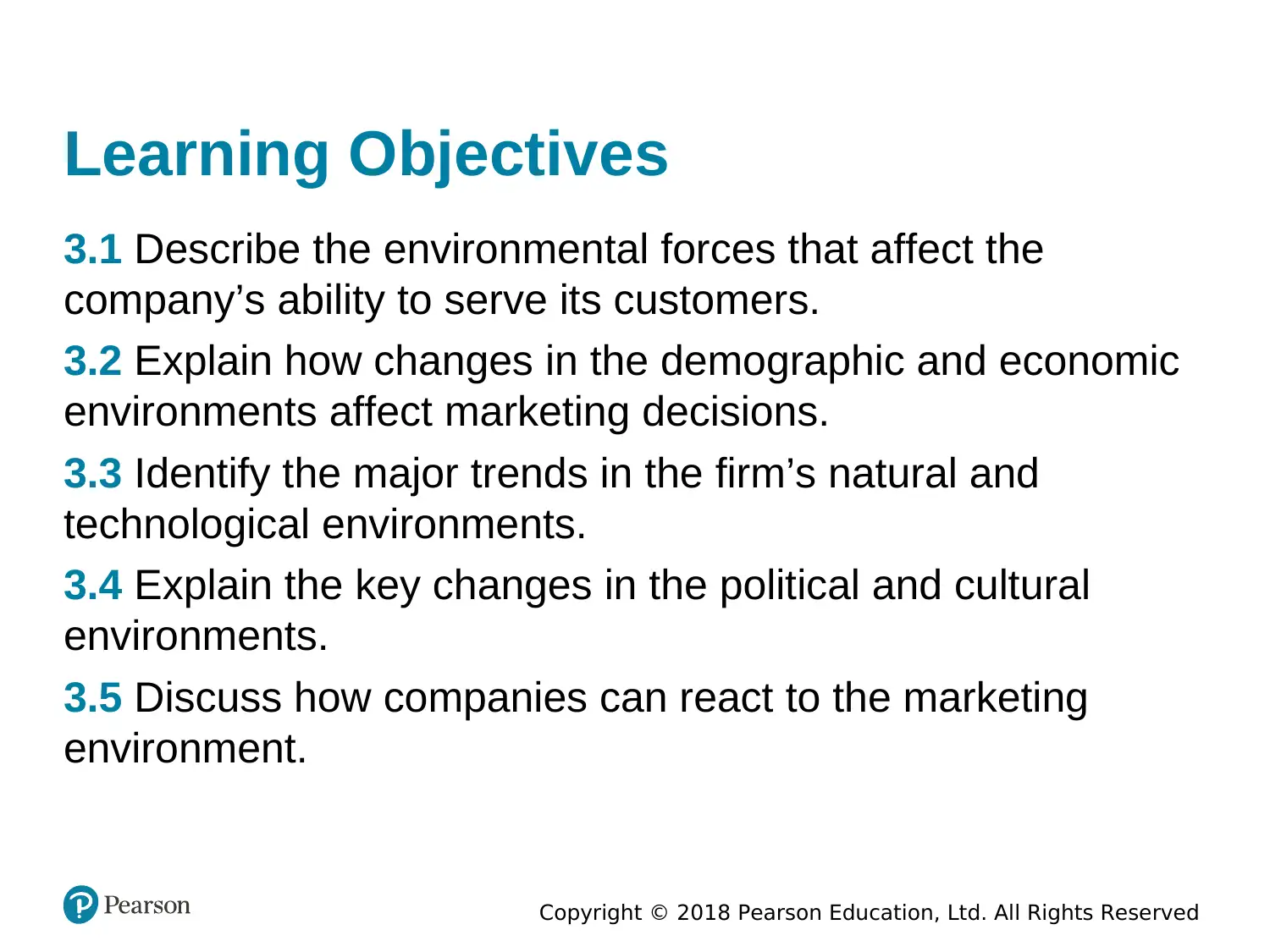
Copyright © 2018 Pearson Education, Ltd. All Rights Reserved
Learning Objectives
3.1 Describe the environmental forces that affect the
company’s ability to serve its customers.
3.2 Explain how changes in the demographic and economic
environments affect marketing decisions.
3.3 Identify the major trends in the firm’s natural and
technological environments.
3.4 Explain the key changes in the political and cultural
environments.
3.5 Discuss how companies can react to the marketing
environment.
Learning Objectives
3.1 Describe the environmental forces that affect the
company’s ability to serve its customers.
3.2 Explain how changes in the demographic and economic
environments affect marketing decisions.
3.3 Identify the major trends in the firm’s natural and
technological environments.
3.4 Explain the key changes in the political and cultural
environments.
3.5 Discuss how companies can react to the marketing
environment.
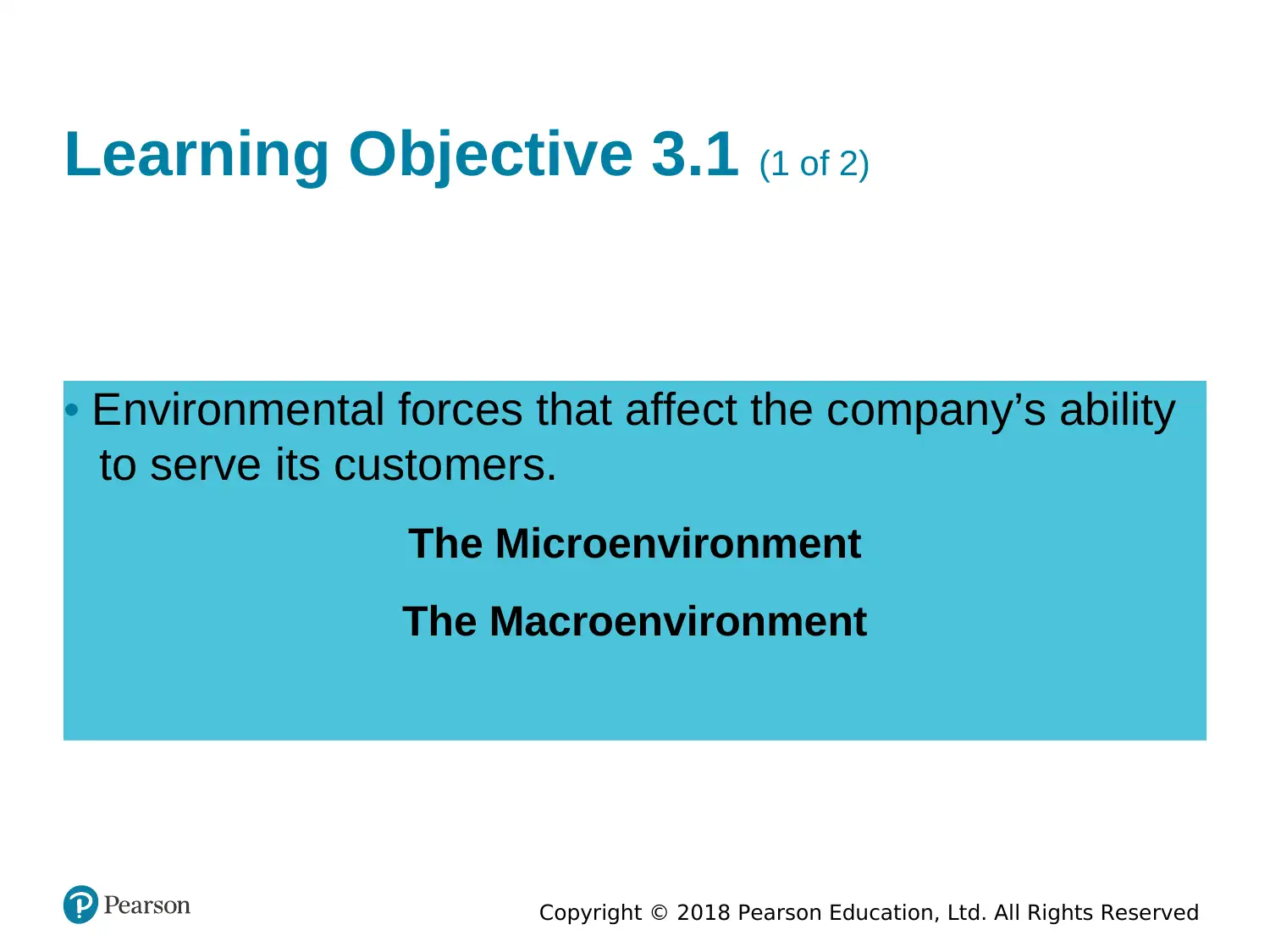
Copyright © 2018 Pearson Education, Ltd. All Rights Reserved
Learning Objective 3.1 (1 of 2)
• Environmental forces that affect the company’s ability
to serve its customers.
The Microenvironment
The Macroenvironment
Learning Objective 3.1 (1 of 2)
• Environmental forces that affect the company’s ability
to serve its customers.
The Microenvironment
The Macroenvironment
Secure Best Marks with AI Grader
Need help grading? Try our AI Grader for instant feedback on your assignments.
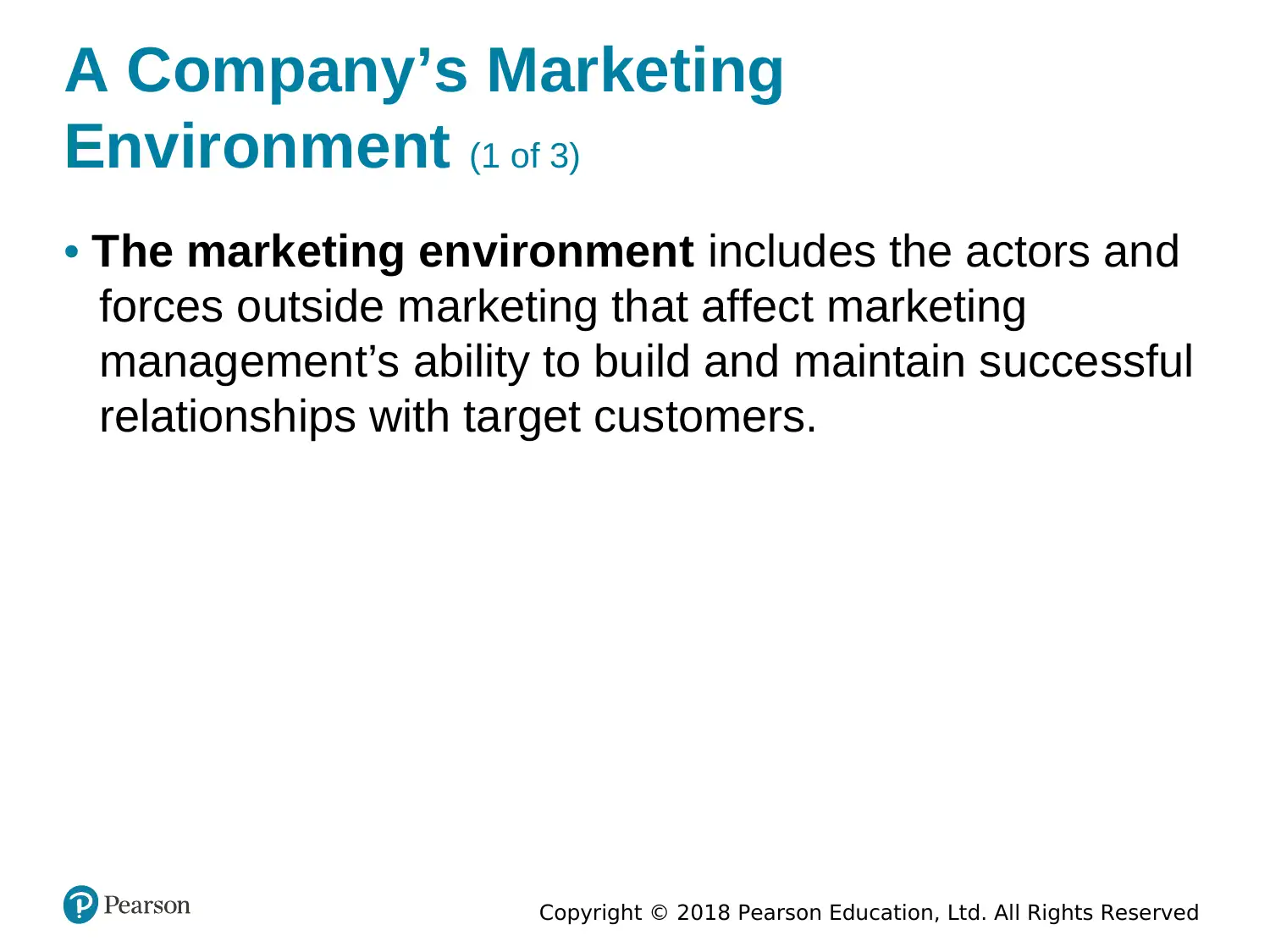
Copyright © 2018 Pearson Education, Ltd. All Rights Reserved
A Company’s Marketing
Environment (1 of 3)
• The marketing environment includes the actors and
forces outside marketing that affect marketing
management’s ability to build and maintain successful
relationships with target customers.
A Company’s Marketing
Environment (1 of 3)
• The marketing environment includes the actors and
forces outside marketing that affect marketing
management’s ability to build and maintain successful
relationships with target customers.
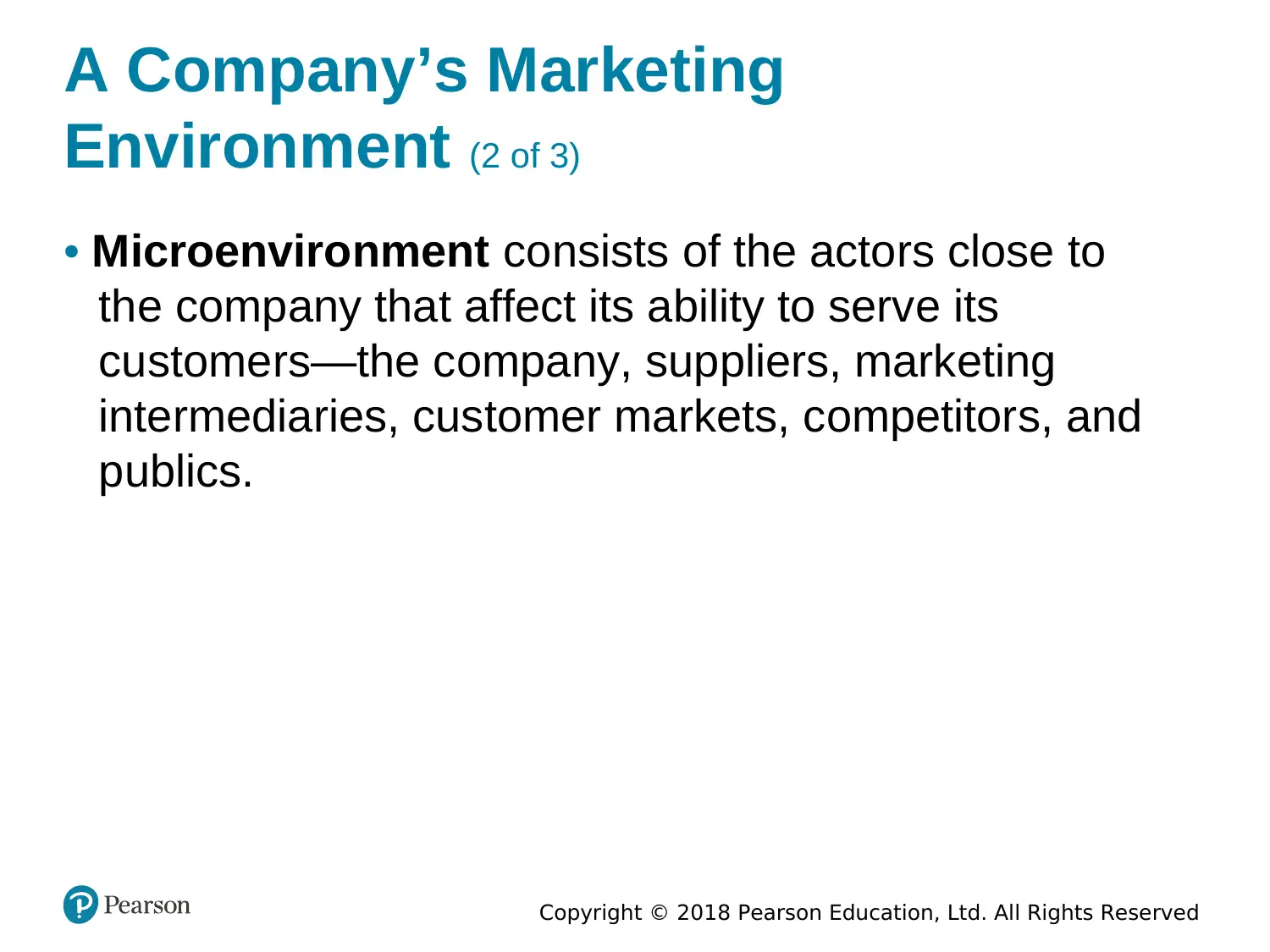
Copyright © 2018 Pearson Education, Ltd. All Rights Reserved
A Company’s Marketing
Environment (2 of 3)
• Microenvironment consists of the actors close to
the company that affect its ability to serve its
customers—the company, suppliers, marketing
intermediaries, customer markets, competitors, and
publics.
A Company’s Marketing
Environment (2 of 3)
• Microenvironment consists of the actors close to
the company that affect its ability to serve its
customers—the company, suppliers, marketing
intermediaries, customer markets, competitors, and
publics.
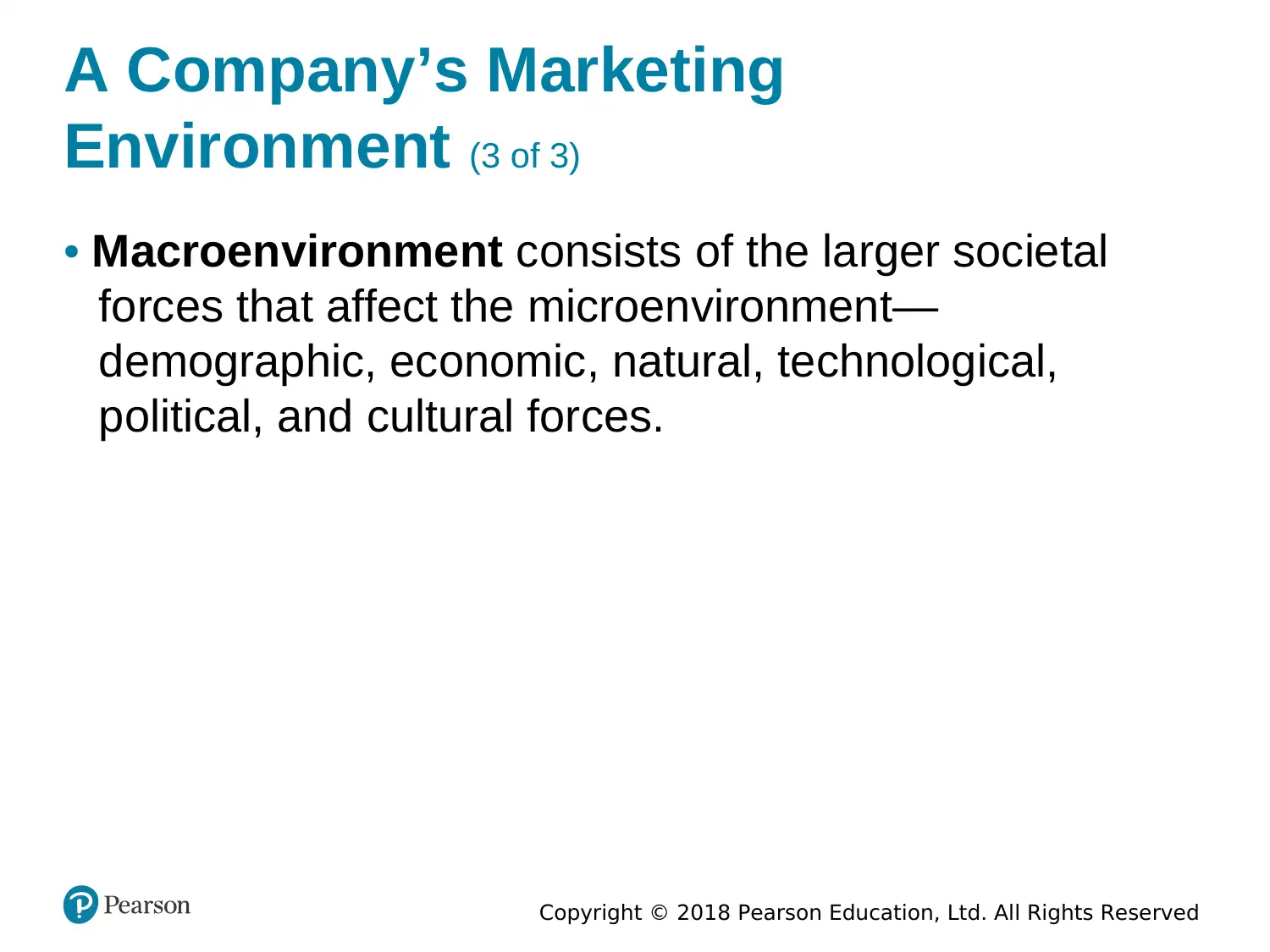
Copyright © 2018 Pearson Education, Ltd. All Rights Reserved
A Company’s Marketing
Environment (3 of 3)
• Macroenvironment consists of the larger societal
forces that affect the microenvironment—
demographic, economic, natural, technological,
political, and cultural forces.
A Company’s Marketing
Environment (3 of 3)
• Macroenvironment consists of the larger societal
forces that affect the microenvironment—
demographic, economic, natural, technological,
political, and cultural forces.
Paraphrase This Document
Need a fresh take? Get an instant paraphrase of this document with our AI Paraphraser

Copyright © 2018 Pearson Education, Ltd. All Rights Reserved
MICROENVIRONMENT
MICROENVIRONMENT

Copyright © 2018 Pearson Education, Ltd. All Rights Reserved
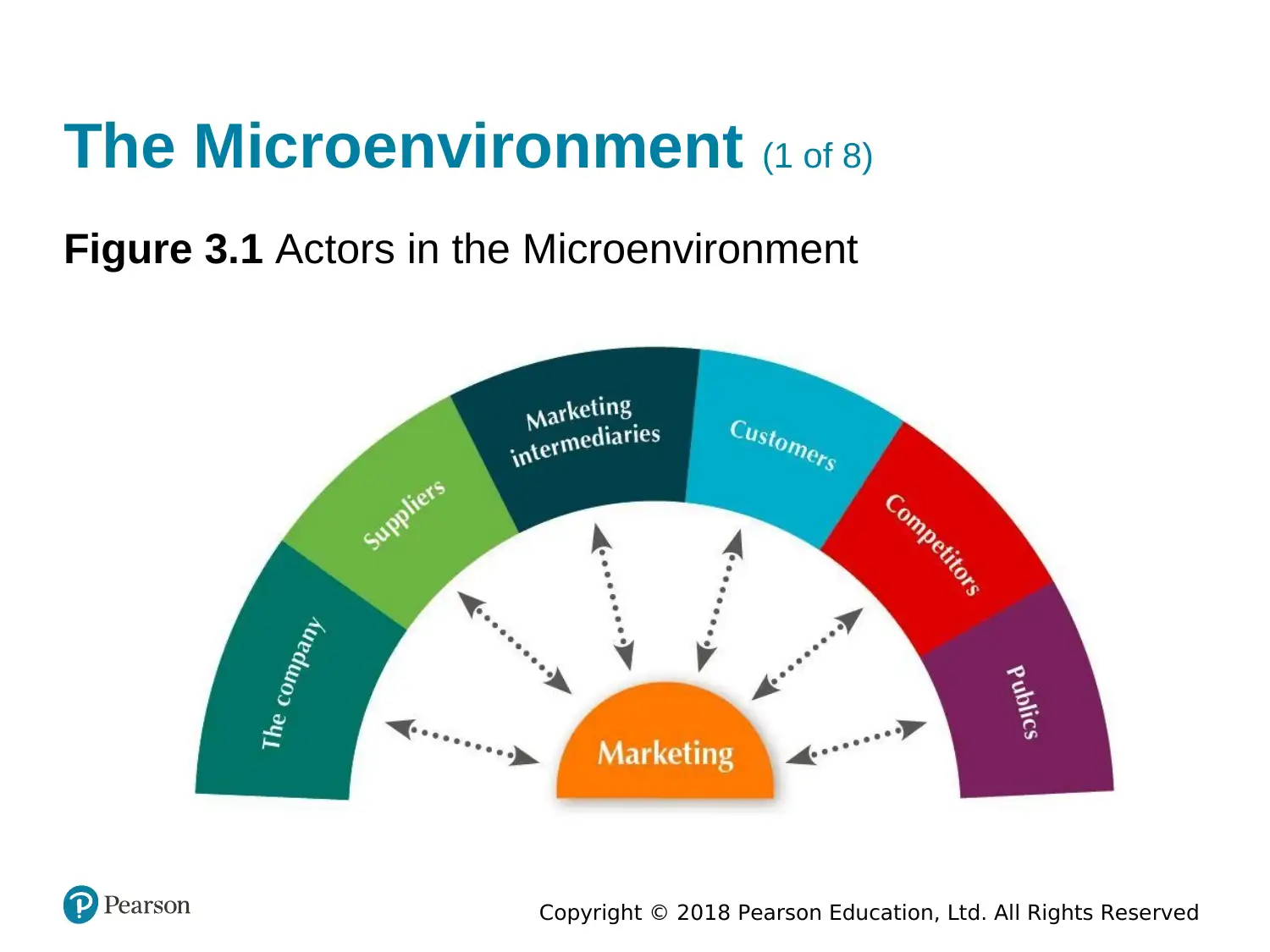
Copyright © 2018 Pearson Education, Ltd. All Rights Reserved
The Microenvironment (1 of 8)
Figure 3.1 Actors in the Microenvironment
The Microenvironment (1 of 8)
Figure 3.1 Actors in the Microenvironment
Secure Best Marks with AI Grader
Need help grading? Try our AI Grader for instant feedback on your assignments.
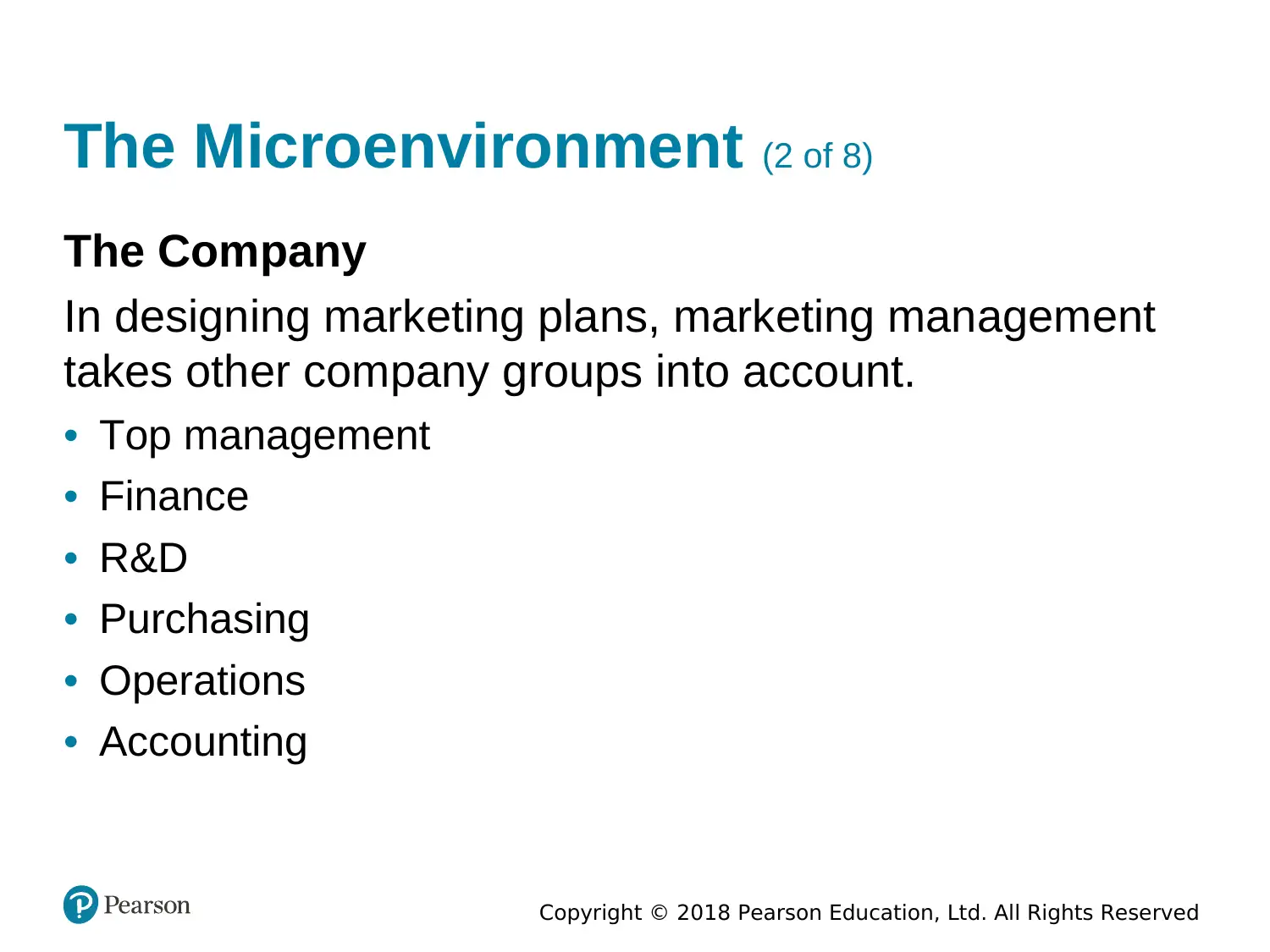
Copyright © 2018 Pearson Education, Ltd. All Rights Reserved
The Microenvironment (2 of 8)
The Company
In designing marketing plans, marketing management
takes other company groups into account.
• Top management
• Finance
• R&D
• Purchasing
• Operations
• Accounting
The Microenvironment (2 of 8)
The Company
In designing marketing plans, marketing management
takes other company groups into account.
• Top management
• Finance
• R&D
• Purchasing
• Operations
• Accounting
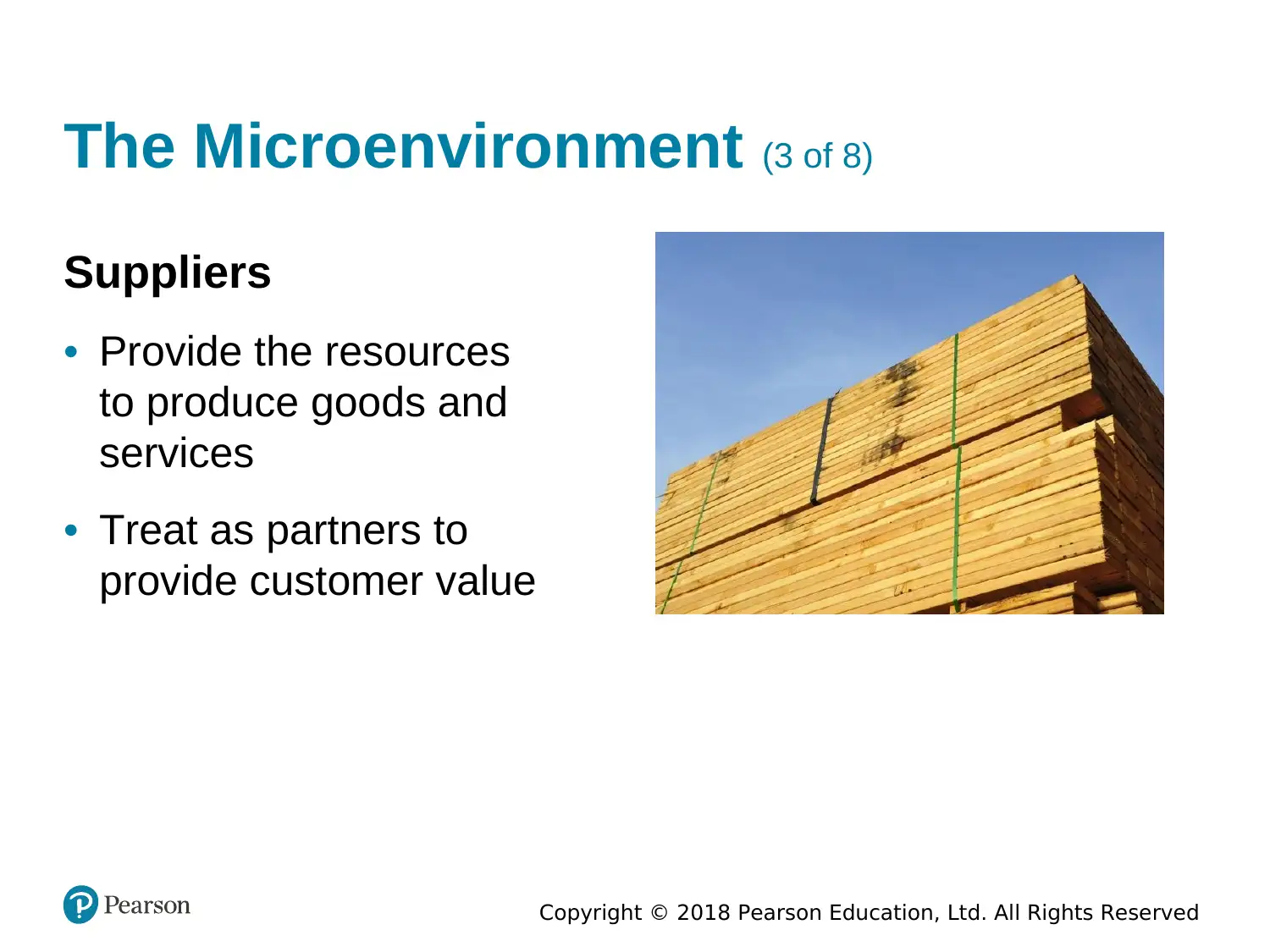
Copyright © 2018 Pearson Education, Ltd. All Rights Reserved
The Microenvironment (3 of 8)
Suppliers
• Provide the resources
to produce goods and
services
• Treat as partners to
provide customer value
The Microenvironment (3 of 8)
Suppliers
• Provide the resources
to produce goods and
services
• Treat as partners to
provide customer value
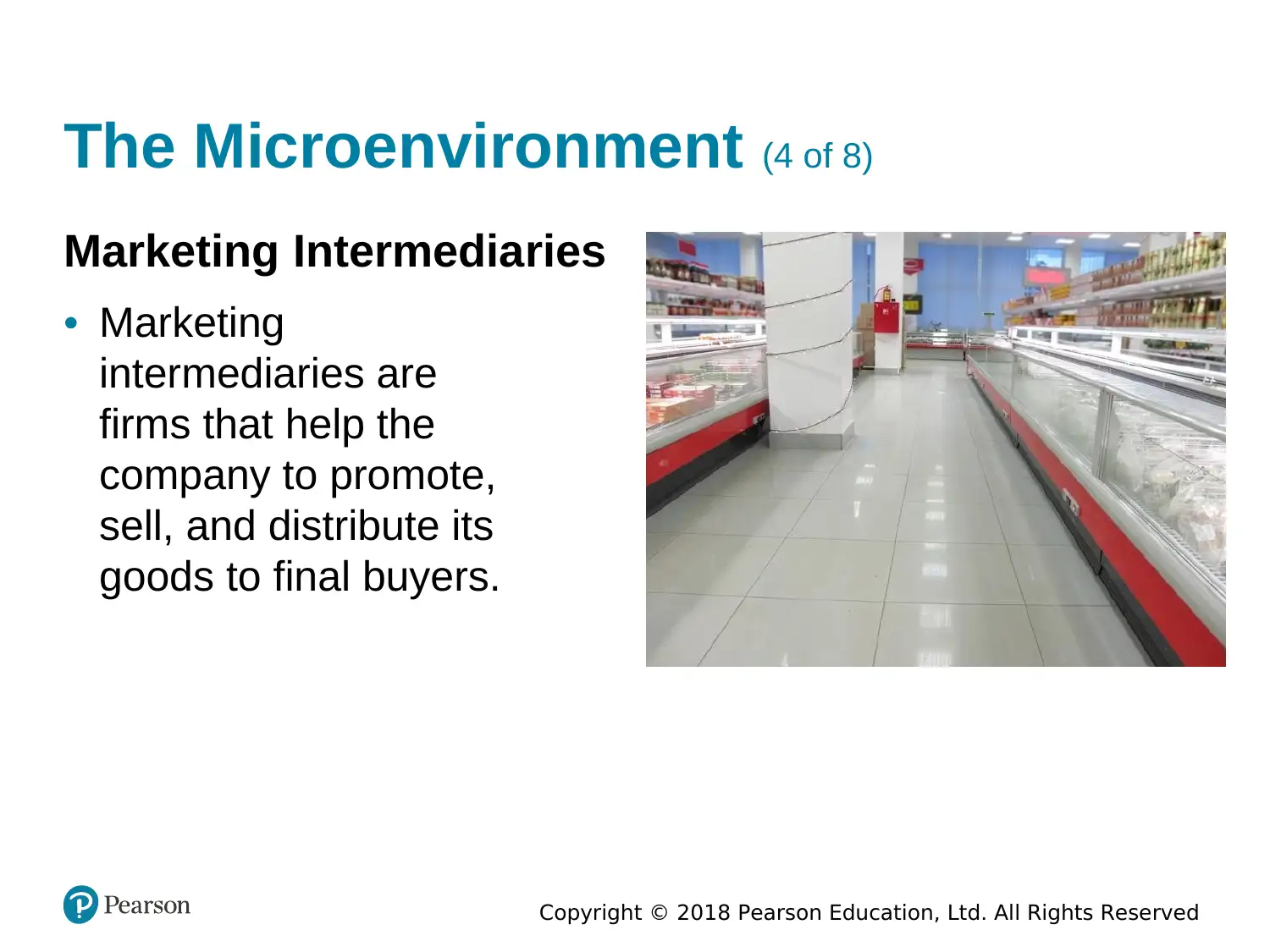
Copyright © 2018 Pearson Education, Ltd. All Rights Reserved
The Microenvironment (4 of 8)
Marketing Intermediaries
• Marketing
intermediaries are
firms that help the
company to promote,
sell, and distribute its
goods to final buyers.
The Microenvironment (4 of 8)
Marketing Intermediaries
• Marketing
intermediaries are
firms that help the
company to promote,
sell, and distribute its
goods to final buyers.
Paraphrase This Document
Need a fresh take? Get an instant paraphrase of this document with our AI Paraphraser
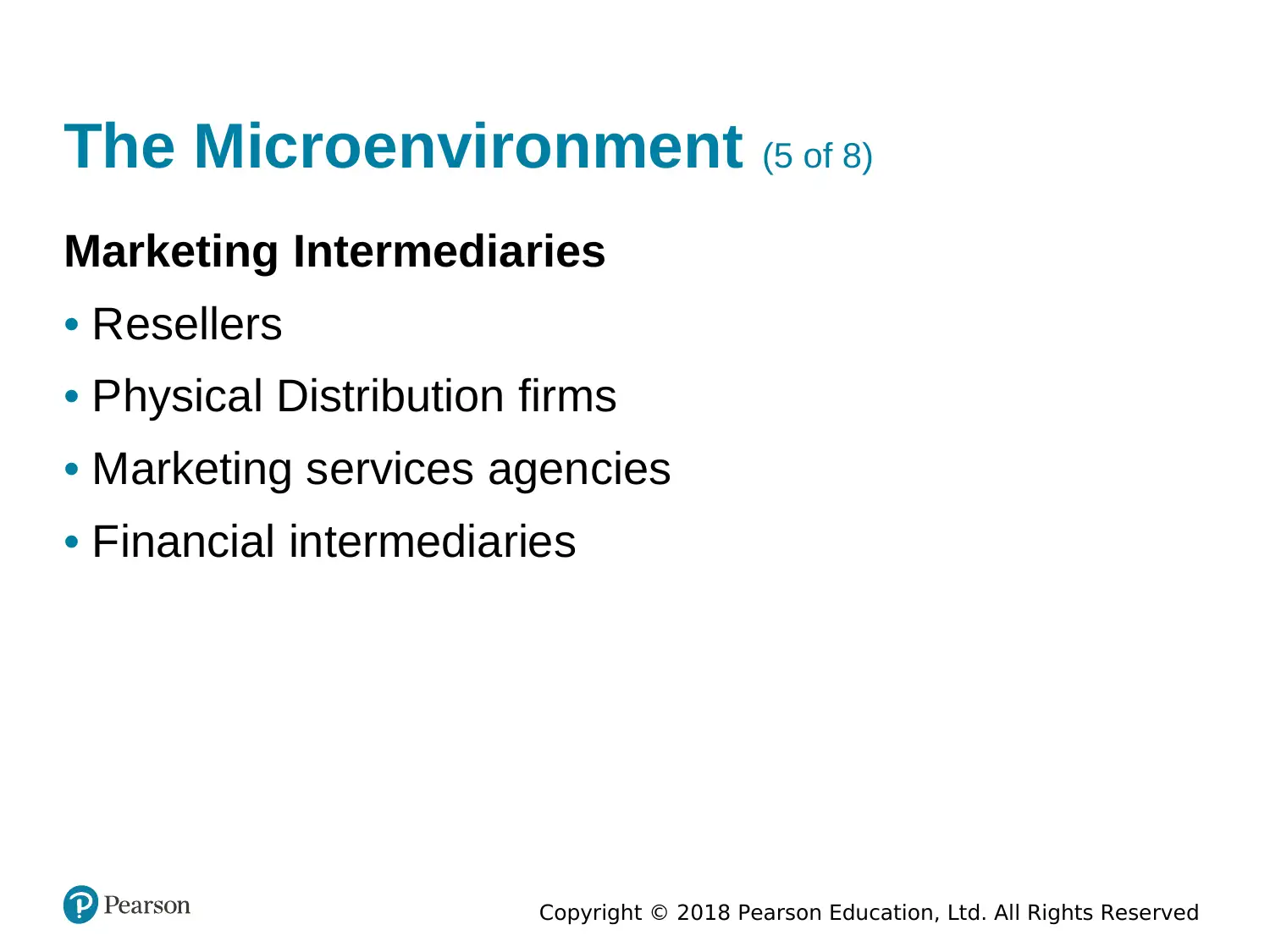
Copyright © 2018 Pearson Education, Ltd. All Rights Reserved
The Microenvironment (5 of 8)
Marketing Intermediaries
• Resellers
• Physical Distribution firms
• Marketing services agencies
• Financial intermediaries
The Microenvironment (5 of 8)
Marketing Intermediaries
• Resellers
• Physical Distribution firms
• Marketing services agencies
• Financial intermediaries
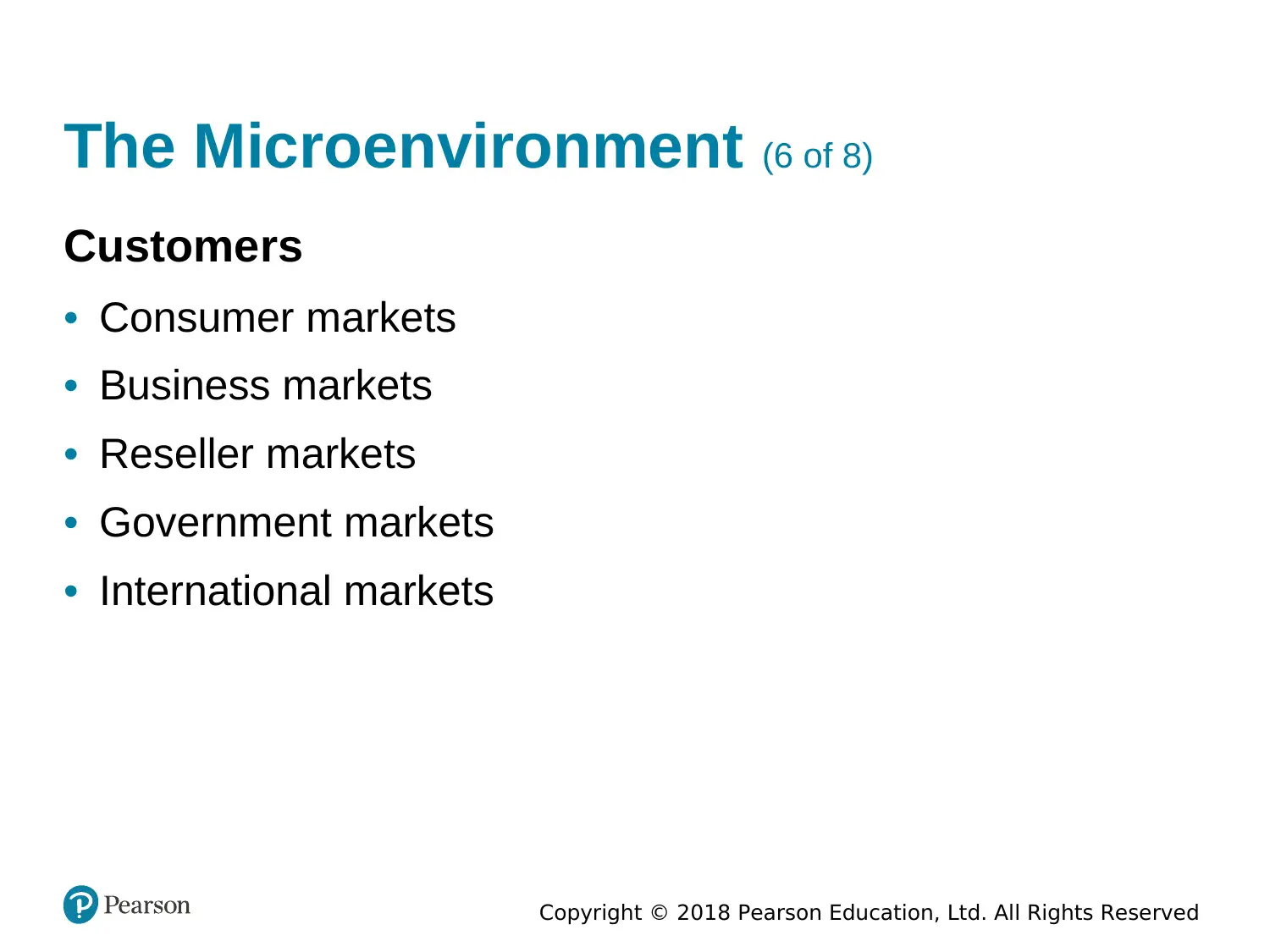
Copyright © 2018 Pearson Education, Ltd. All Rights Reserved
The Microenvironment (6 of 8)
Customers
• Consumer markets
• Business markets
• Reseller markets
• Government markets
• International markets
The Microenvironment (6 of 8)
Customers
• Consumer markets
• Business markets
• Reseller markets
• Government markets
• International markets
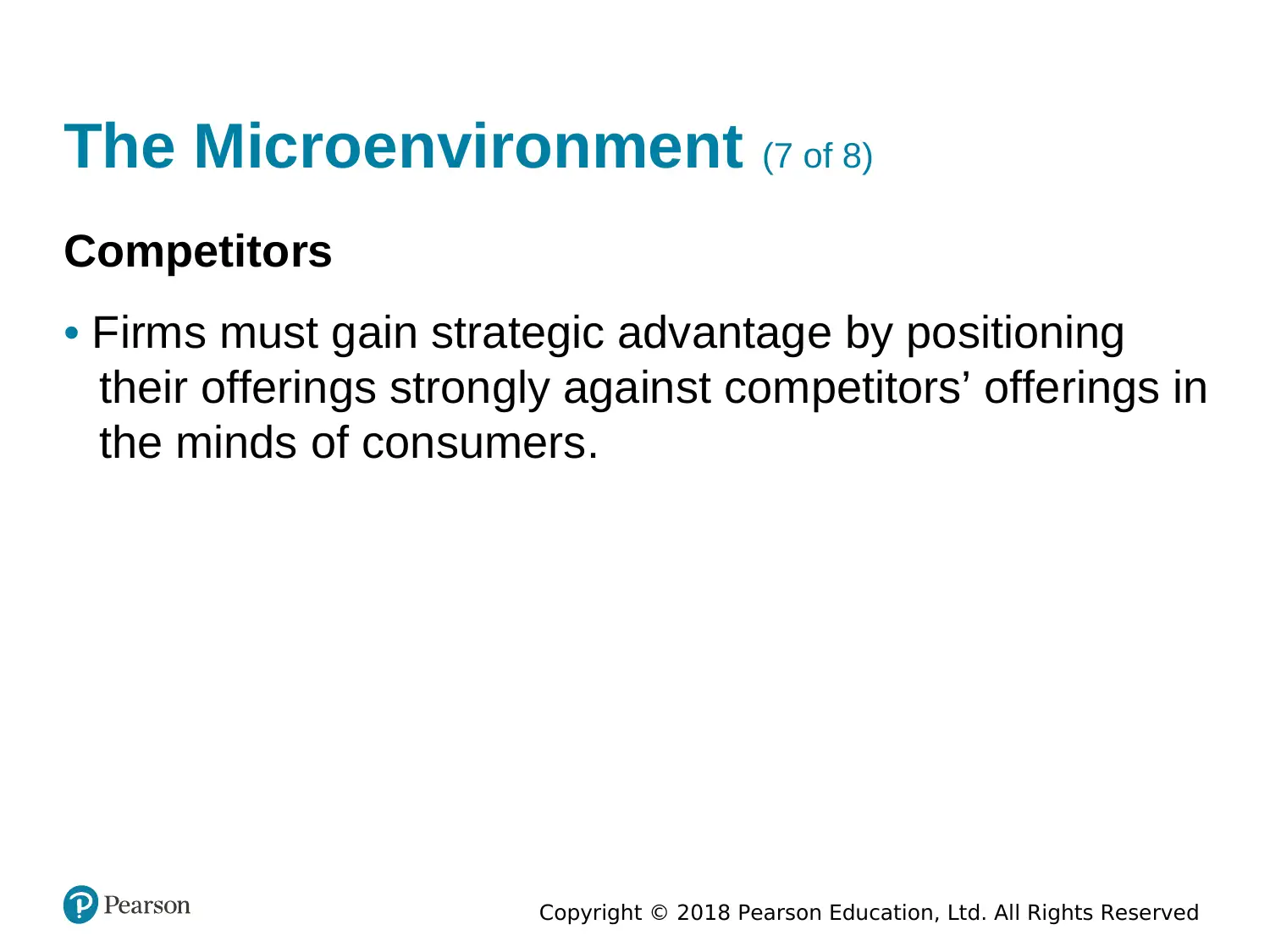
Copyright © 2018 Pearson Education, Ltd. All Rights Reserved
The Microenvironment (7 of 8)
Competitors
• Firms must gain strategic advantage by positioning
their offerings strongly against competitors’ offerings in
the minds of consumers.
The Microenvironment (7 of 8)
Competitors
• Firms must gain strategic advantage by positioning
their offerings strongly against competitors’ offerings in
the minds of consumers.
Secure Best Marks with AI Grader
Need help grading? Try our AI Grader for instant feedback on your assignments.
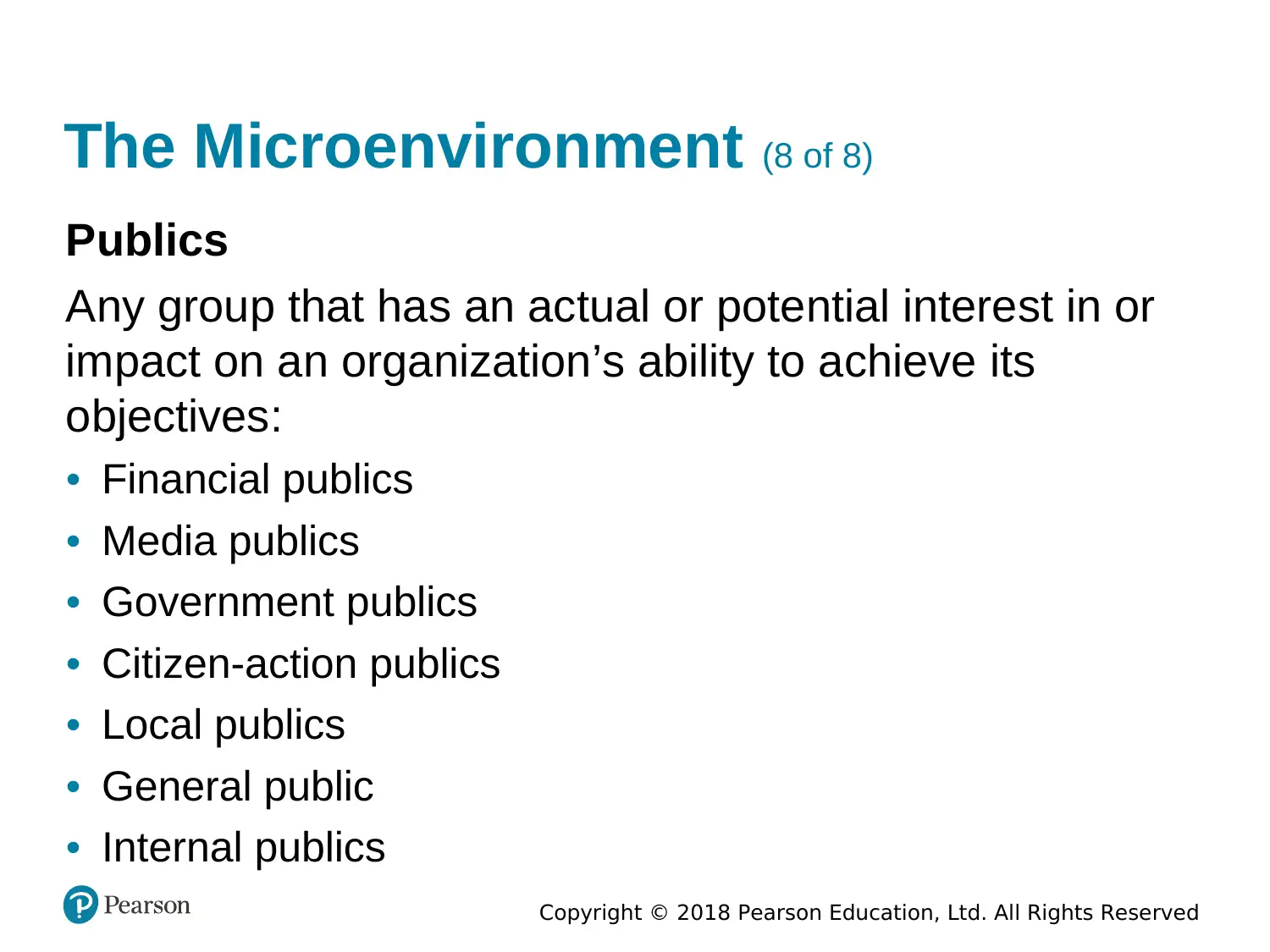
Copyright © 2018 Pearson Education, Ltd. All Rights Reserved
The Microenvironment (8 of 8)
Publics
Any group that has an actual or potential interest in or
impact on an organization’s ability to achieve its
objectives:
• Financial publics
• Media publics
• Government publics
• Citizen-action publics
• Local publics
• General public
• Internal publics
The Microenvironment (8 of 8)
Publics
Any group that has an actual or potential interest in or
impact on an organization’s ability to achieve its
objectives:
• Financial publics
• Media publics
• Government publics
• Citizen-action publics
• Local publics
• General public
• Internal publics

Copyright © 2018 Pearson Education, Ltd. All Rights Reserved
MACROENVIRONMENT
MACROENVIRONMENT

Copyright © 2018 Pearson Education, Ltd. All Rights Reserved
Paraphrase This Document
Need a fresh take? Get an instant paraphrase of this document with our AI Paraphraser
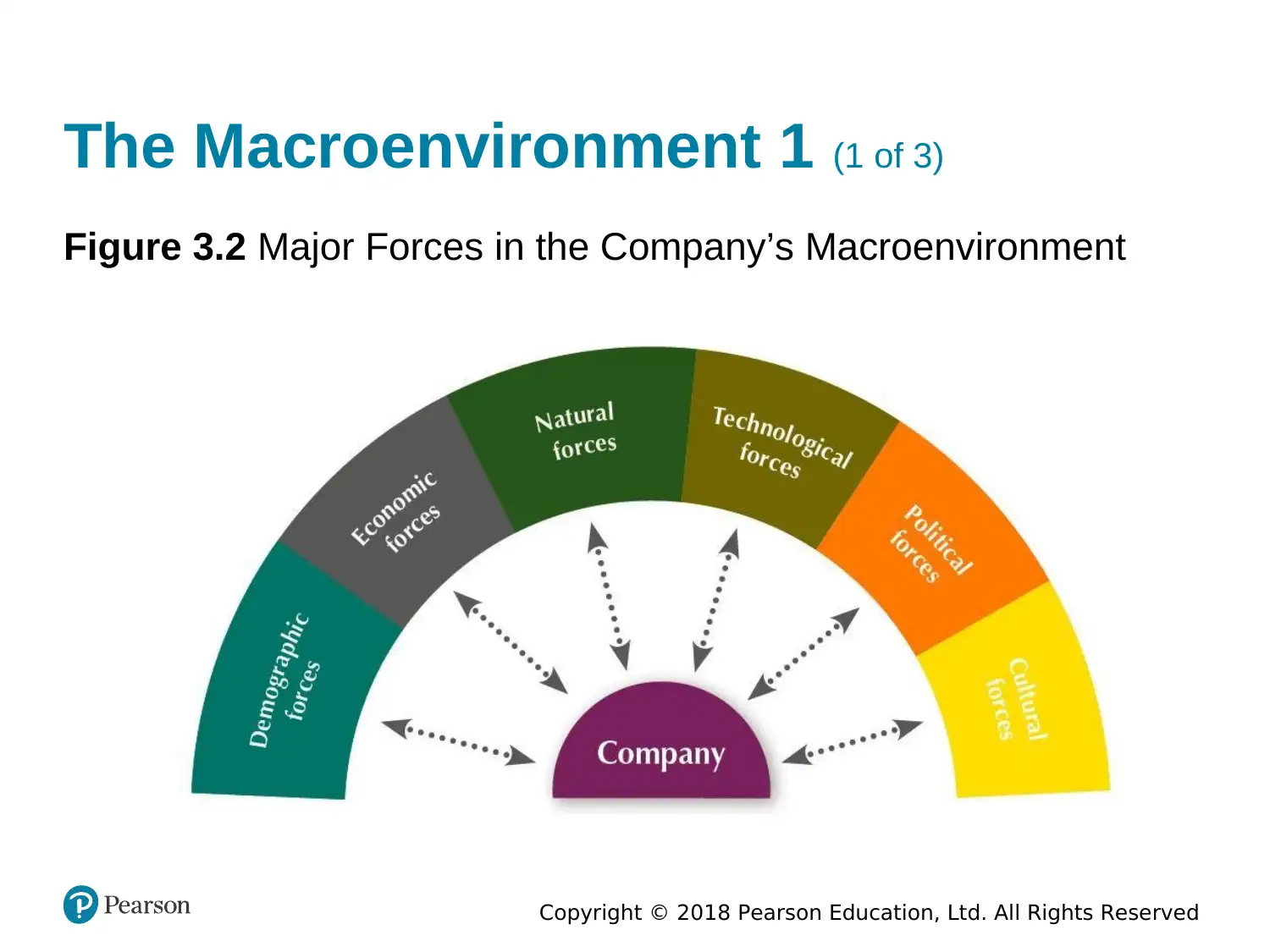
Copyright © 2018 Pearson Education, Ltd. All Rights Reserved
The Macroenvironment 1 (1 of 3)
Figure 3.2 Major Forces in the Company’s Macroenvironment
The Macroenvironment 1 (1 of 3)
Figure 3.2 Major Forces in the Company’s Macroenvironment
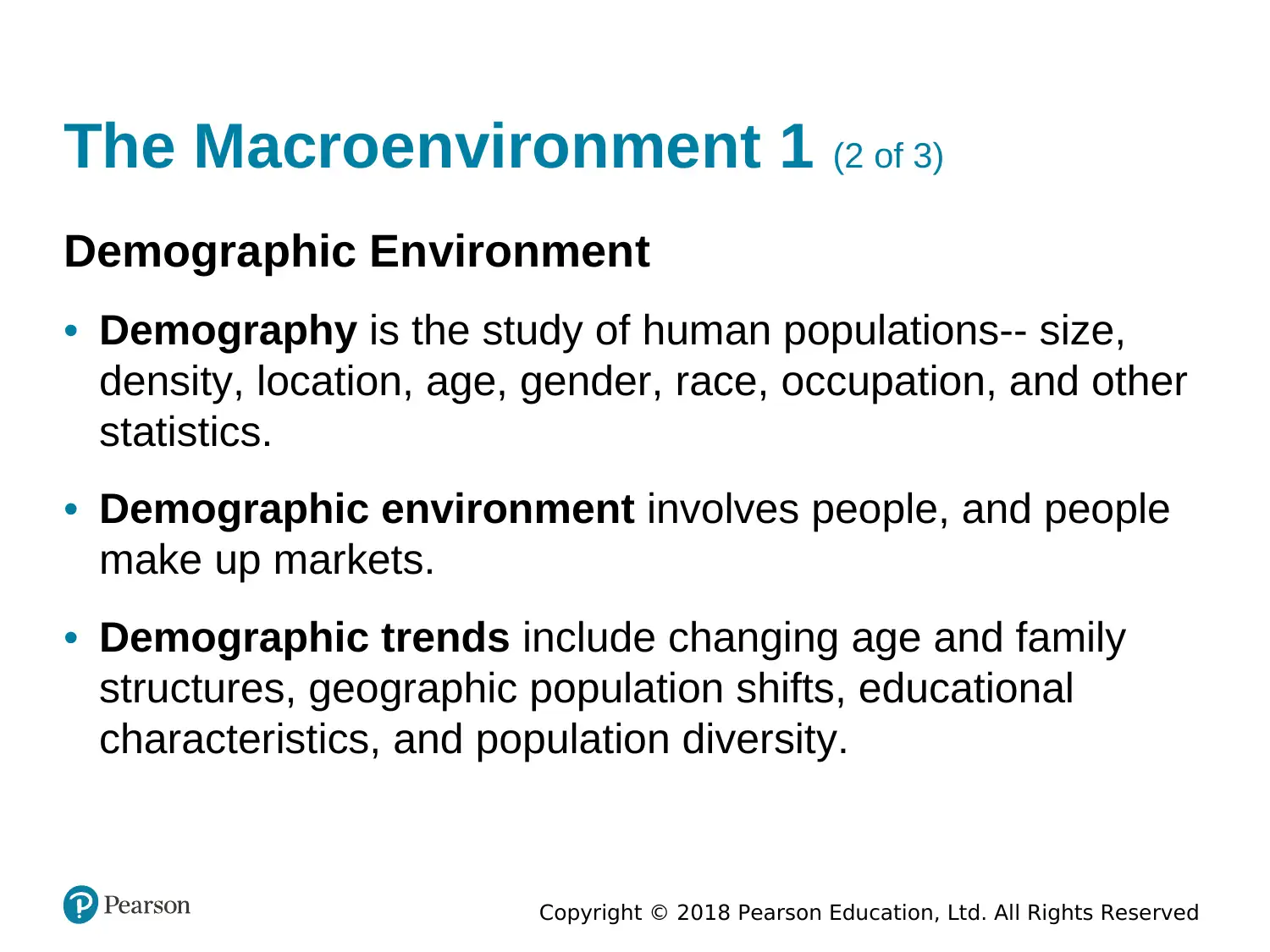
Copyright © 2018 Pearson Education, Ltd. All Rights Reserved
The Macroenvironment 1 (2 of 3)
Demographic Environment
• Demography is the study of human populations-- size,
density, location, age, gender, race, occupation, and other
statistics.
• Demographic environment involves people, and people
make up markets.
• Demographic trends include changing age and family
structures, geographic population shifts, educational
characteristics, and population diversity.
The Macroenvironment 1 (2 of 3)
Demographic Environment
• Demography is the study of human populations-- size,
density, location, age, gender, race, occupation, and other
statistics.
• Demographic environment involves people, and people
make up markets.
• Demographic trends include changing age and family
structures, geographic population shifts, educational
characteristics, and population diversity.
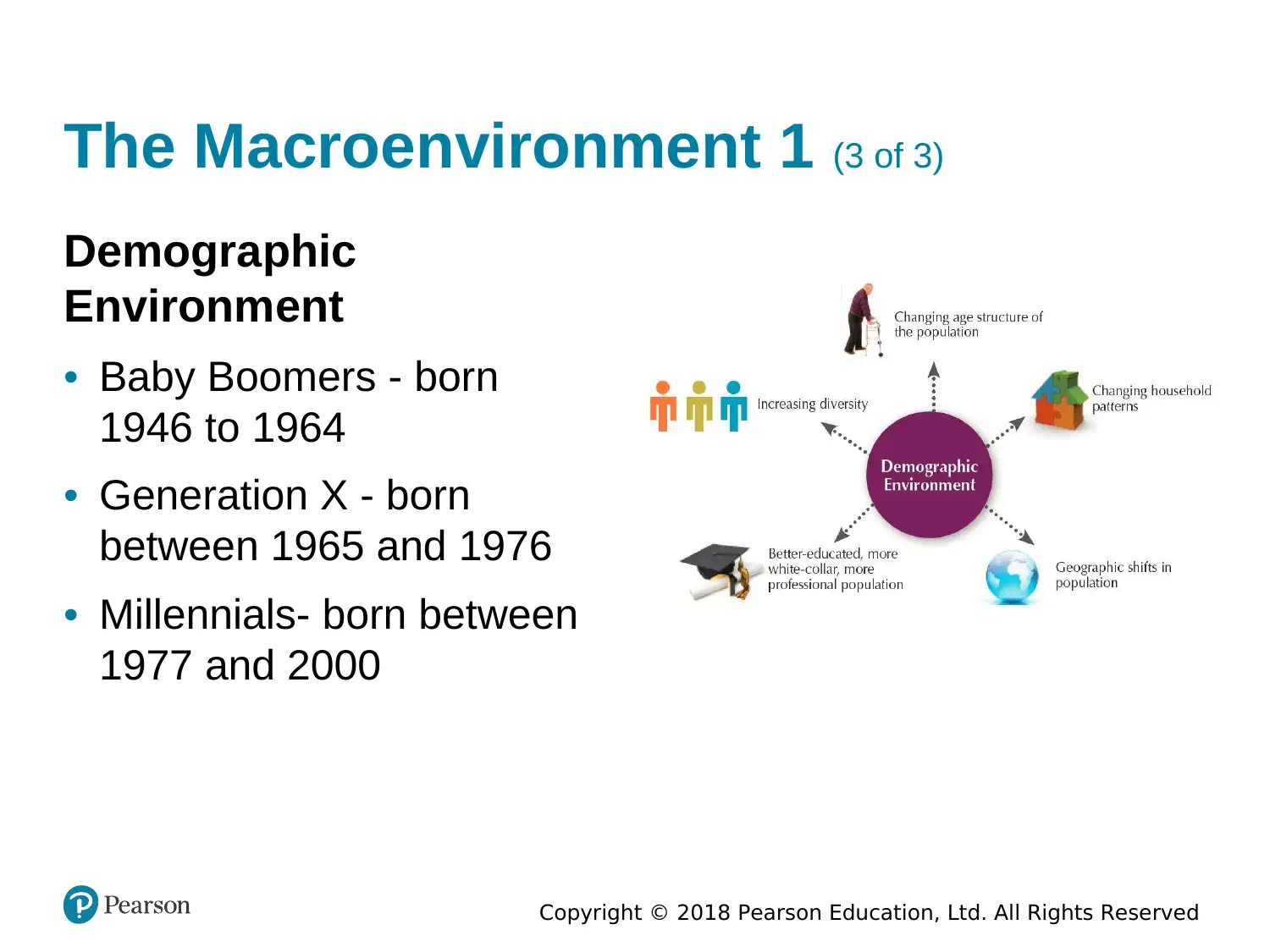
Copyright © 2018 Pearson Education, Ltd. All Rights Reserved
The Macroenvironment 1 (3 of 3)
Demographic
Environment
• Baby Boomers - born
1946 to 1964
• Generation X - born
between 1965 and 1976
• Millennials- born between
1977 and 2000
The Macroenvironment 1 (3 of 3)
Demographic
Environment
• Baby Boomers - born
1946 to 1964
• Generation X - born
between 1965 and 1976
• Millennials- born between
1977 and 2000
Secure Best Marks with AI Grader
Need help grading? Try our AI Grader for instant feedback on your assignments.
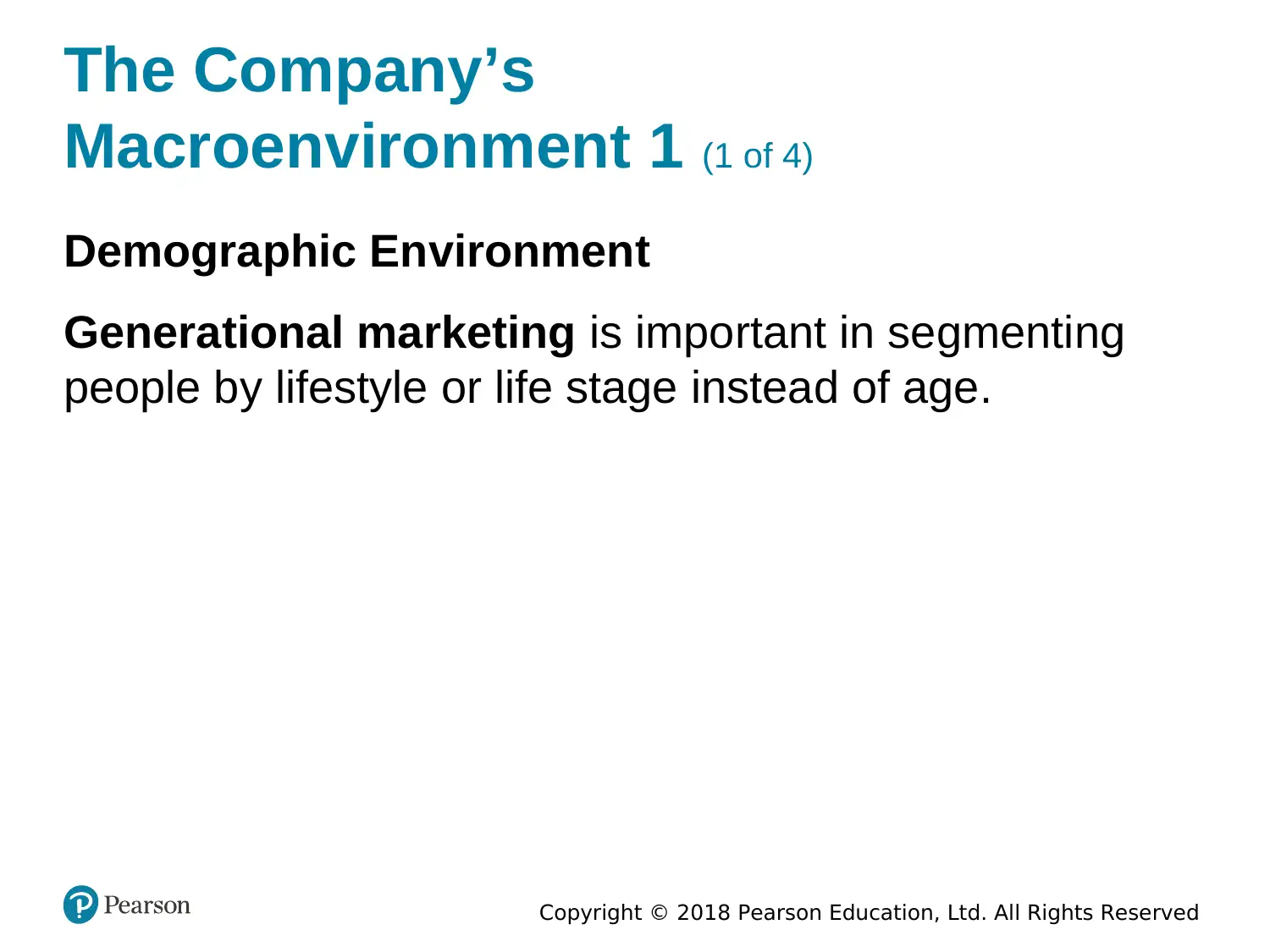
Copyright © 2018 Pearson Education, Ltd. All Rights Reserved
The Company’s
Macroenvironment 1 (1 of 4)
Demographic Environment
Generational marketing is important in segmenting
people by lifestyle or life stage instead of age.
The Company’s
Macroenvironment 1 (1 of 4)
Demographic Environment
Generational marketing is important in segmenting
people by lifestyle or life stage instead of age.
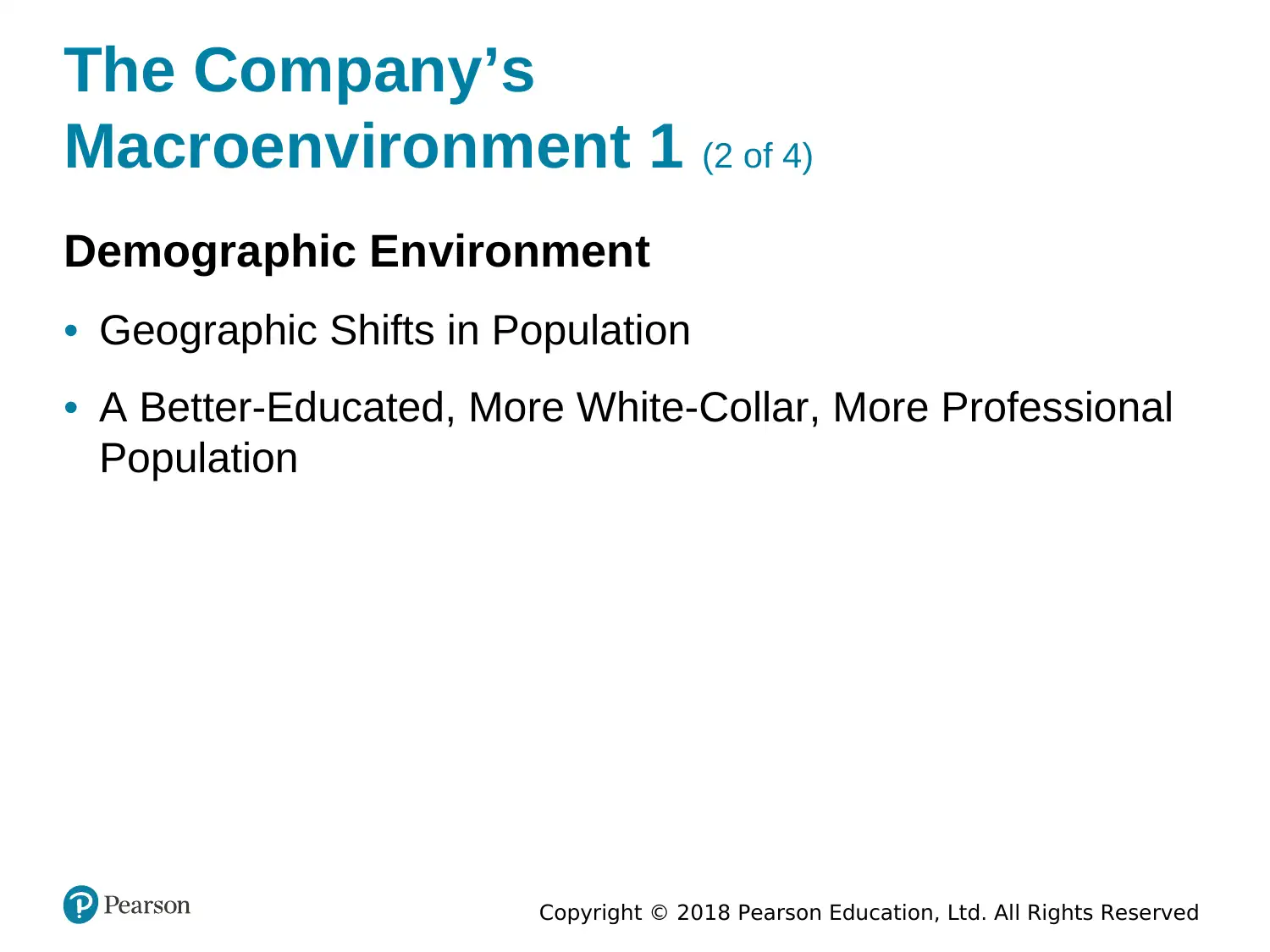
Copyright © 2018 Pearson Education, Ltd. All Rights Reserved
The Company’s
Macroenvironment 1 (2 of 4)
Demographic Environment
• Geographic Shifts in Population
• A Better-Educated, More White-Collar, More Professional
Population
The Company’s
Macroenvironment 1 (2 of 4)
Demographic Environment
• Geographic Shifts in Population
• A Better-Educated, More White-Collar, More Professional
Population
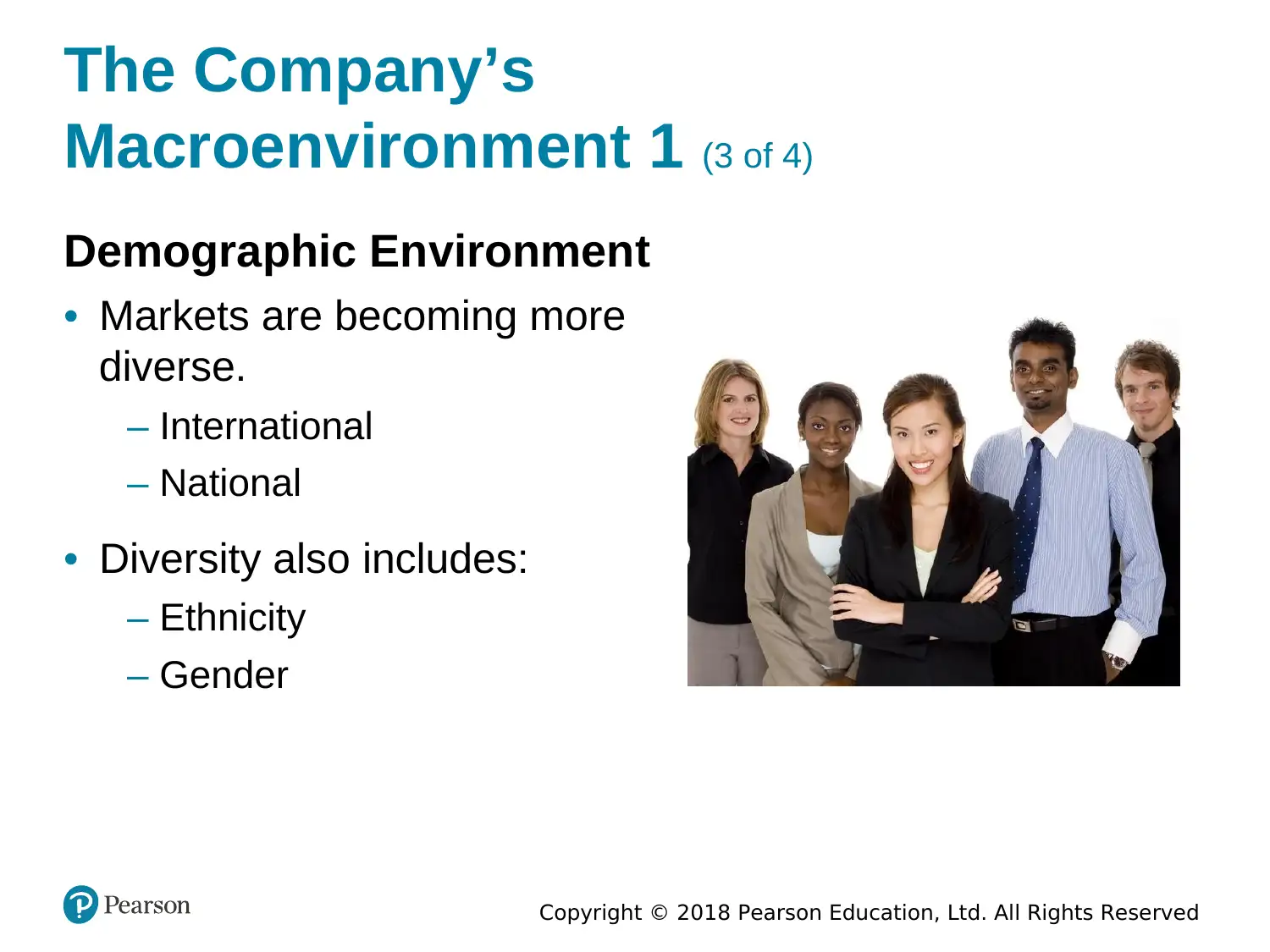
Copyright © 2018 Pearson Education, Ltd. All Rights Reserved
The Company’s
Macroenvironment 1 (3 of 4)
Demographic Environment
• Markets are becoming more
diverse.
– International
– National
• Diversity also includes:
– Ethnicity
– Gender
The Company’s
Macroenvironment 1 (3 of 4)
Demographic Environment
• Markets are becoming more
diverse.
– International
– National
• Diversity also includes:
– Ethnicity
– Gender
Paraphrase This Document
Need a fresh take? Get an instant paraphrase of this document with our AI Paraphraser
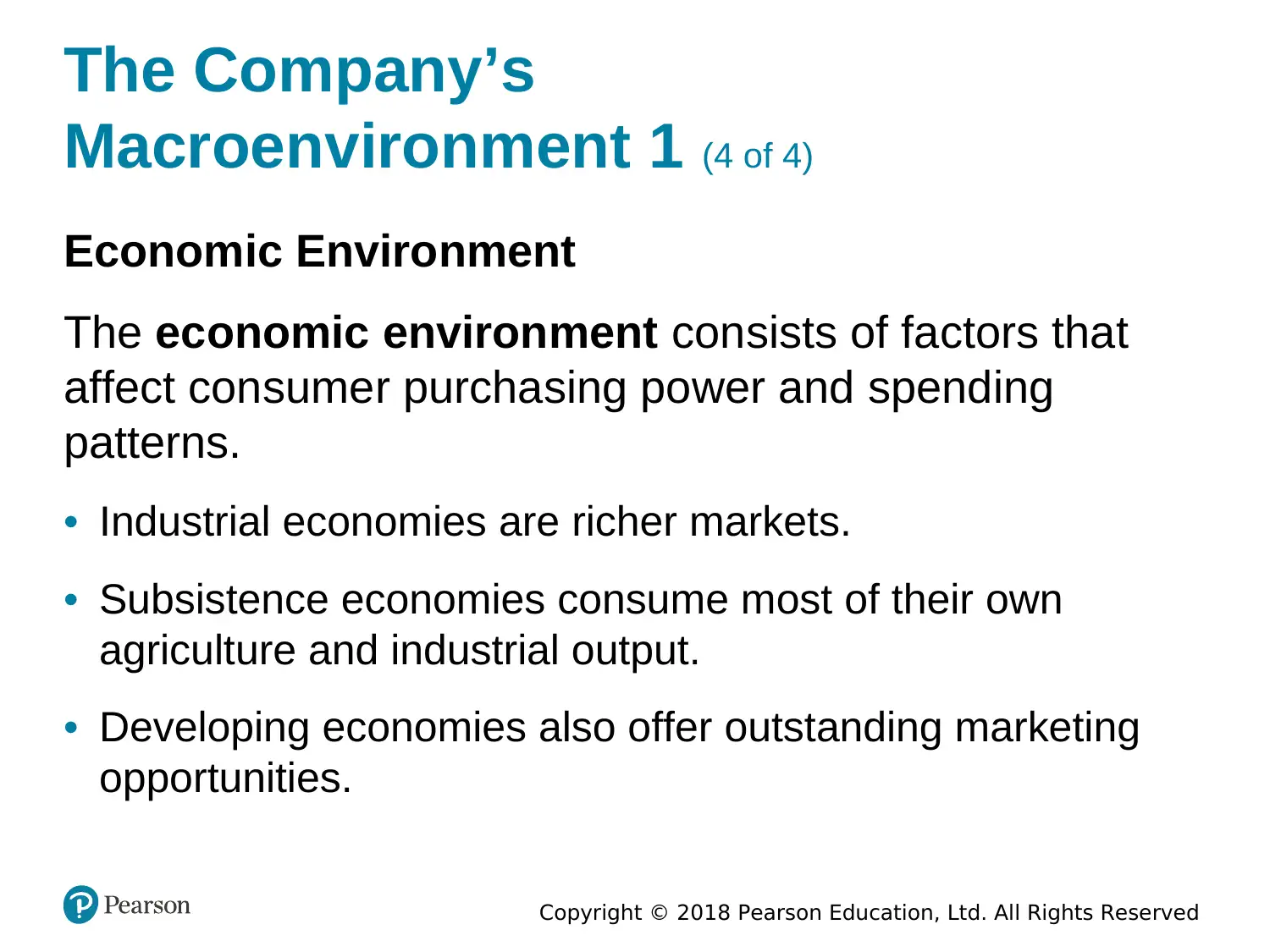
Copyright © 2018 Pearson Education, Ltd. All Rights Reserved
The Company’s
Macroenvironment 1 (4 of 4)
Economic Environment
The economic environment consists of factors that
affect consumer purchasing power and spending
patterns.
• Industrial economies are richer markets.
• Subsistence economies consume most of their own
agriculture and industrial output.
• Developing economies also offer outstanding marketing
opportunities.
The Company’s
Macroenvironment 1 (4 of 4)
Economic Environment
The economic environment consists of factors that
affect consumer purchasing power and spending
patterns.
• Industrial economies are richer markets.
• Subsistence economies consume most of their own
agriculture and industrial output.
• Developing economies also offer outstanding marketing
opportunities.
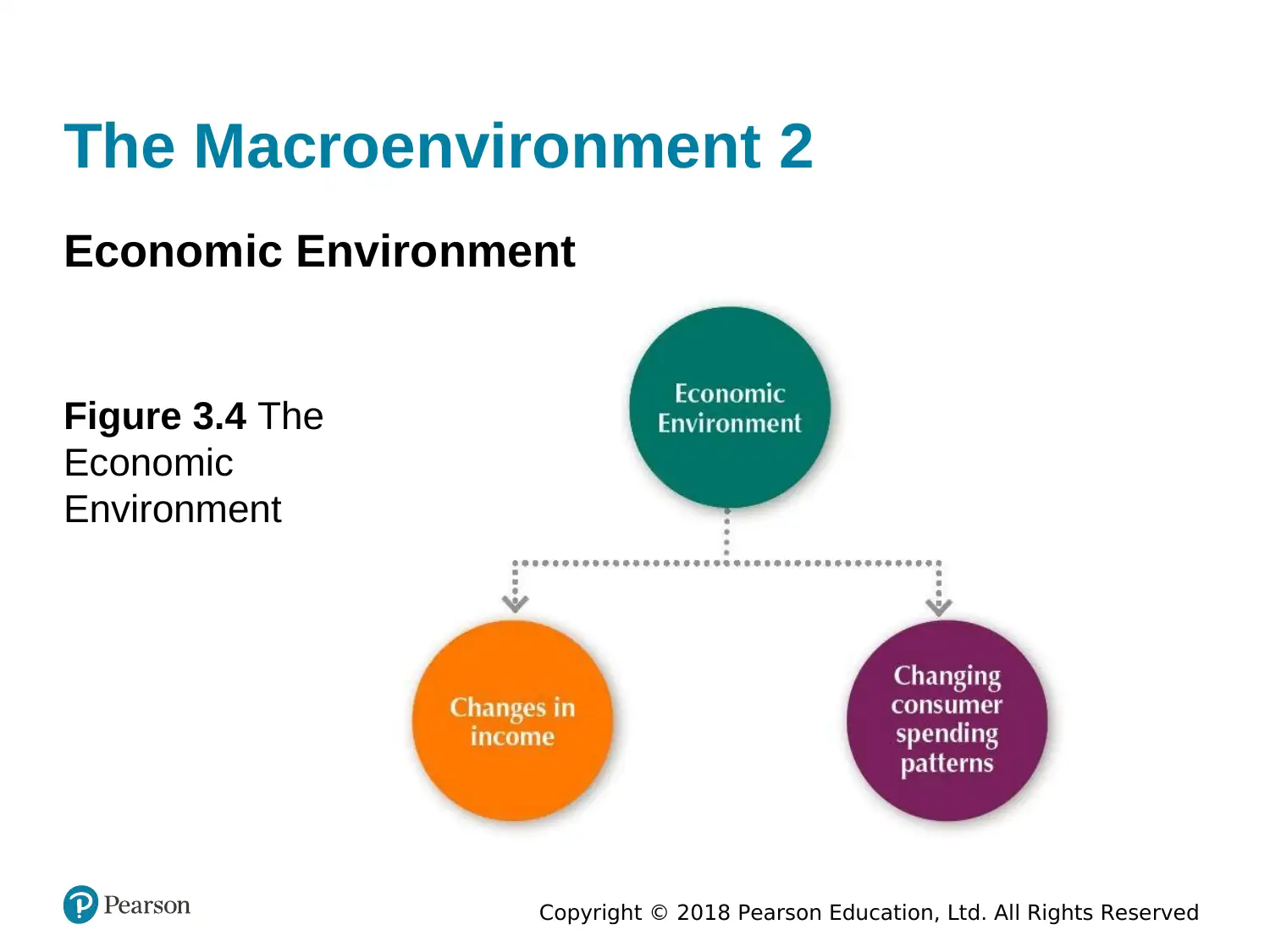
Copyright © 2018 Pearson Education, Ltd. All Rights Reserved
The Macroenvironment 2
Economic Environment
Figure 3.4 The
Economic
Environment
The Macroenvironment 2
Economic Environment
Figure 3.4 The
Economic
Environment
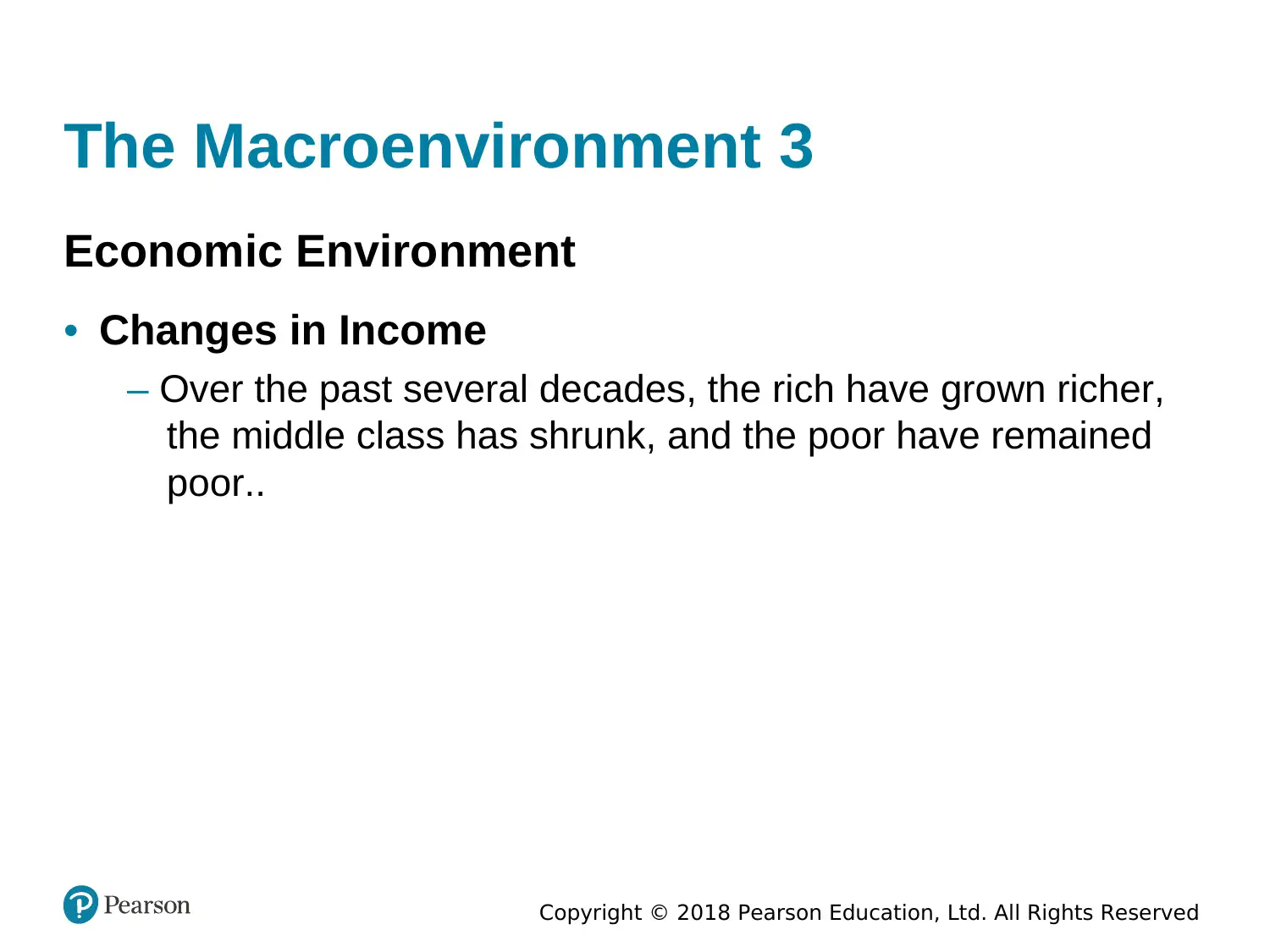
Copyright © 2018 Pearson Education, Ltd. All Rights Reserved
The Macroenvironment 3
Economic Environment
• Changes in Income
– Over the past several decades, the rich have grown richer,
the middle class has shrunk, and the poor have remained
poor..
The Macroenvironment 3
Economic Environment
• Changes in Income
– Over the past several decades, the rich have grown richer,
the middle class has shrunk, and the poor have remained
poor..
Secure Best Marks with AI Grader
Need help grading? Try our AI Grader for instant feedback on your assignments.
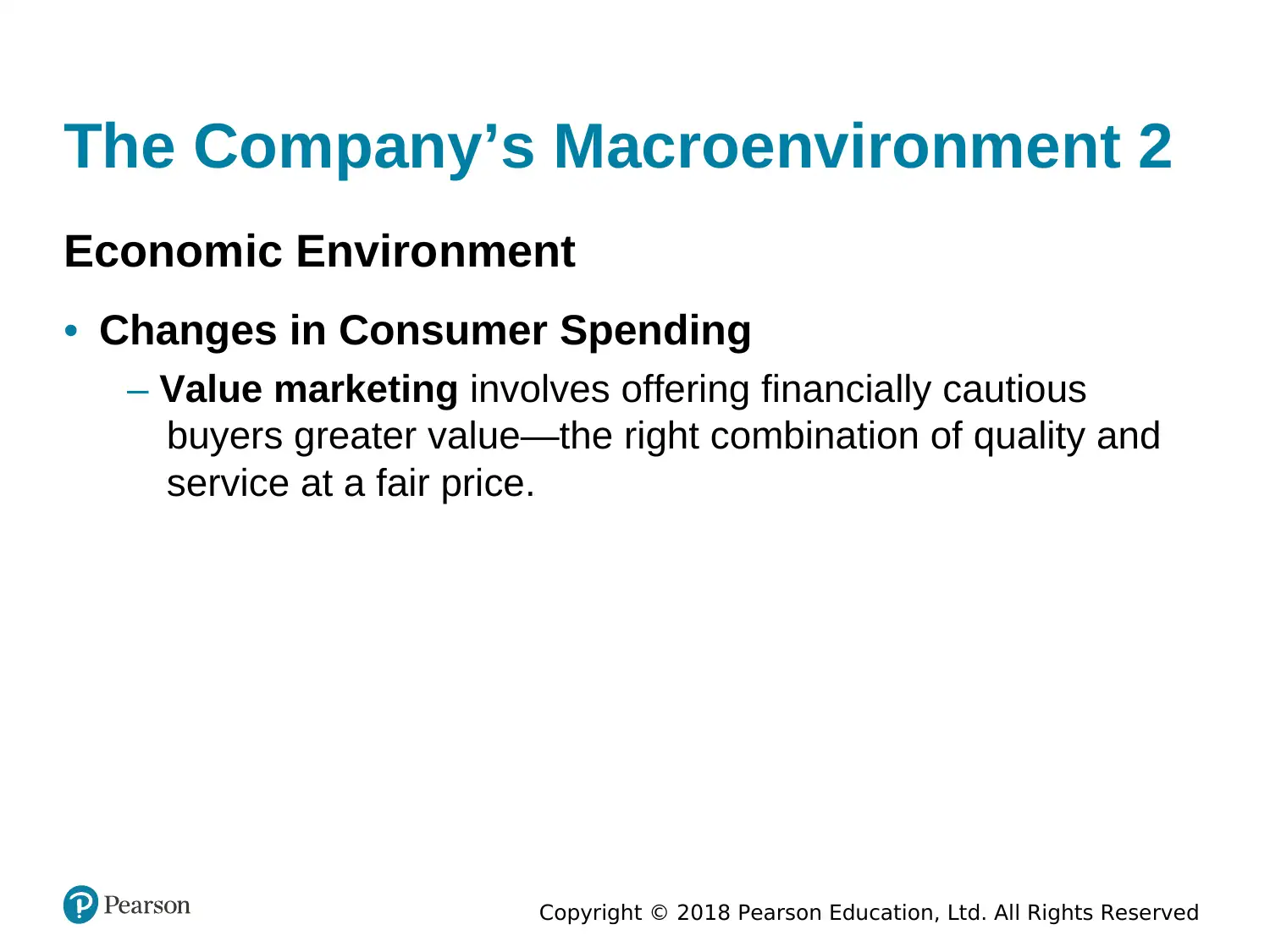
Copyright © 2018 Pearson Education, Ltd. All Rights Reserved
The Company’s Macroenvironment 2
Economic Environment
• Changes in Consumer Spending
– Value marketing involves offering financially cautious
buyers greater value—the right combination of quality and
service at a fair price.
The Company’s Macroenvironment 2
Economic Environment
• Changes in Consumer Spending
– Value marketing involves offering financially cautious
buyers greater value—the right combination of quality and
service at a fair price.
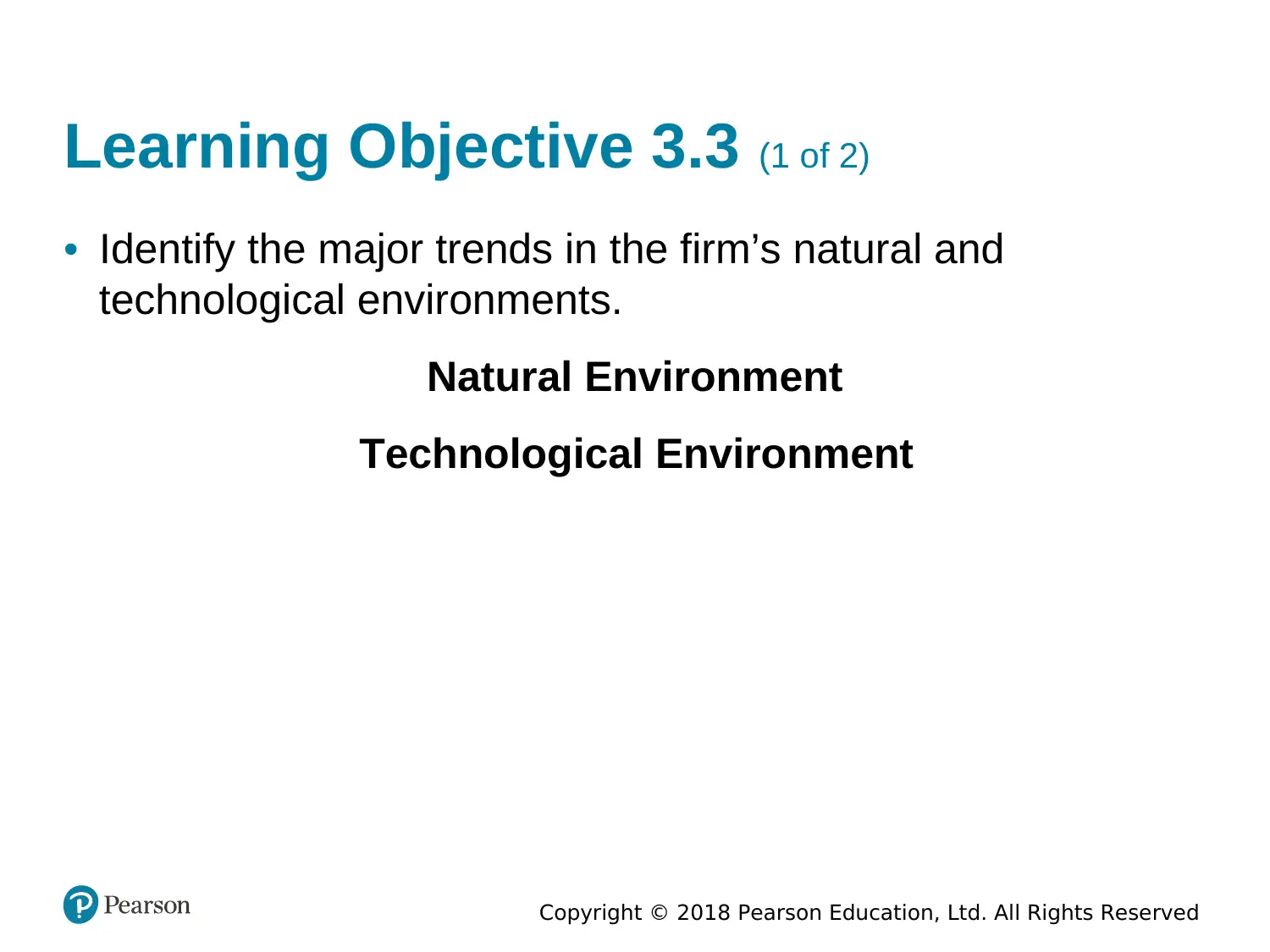
Copyright © 2018 Pearson Education, Ltd. All Rights Reserved
Learning Objective 3.3 (1 of 2)
• Identify the major trends in the firm’s natural and
technological environments.
Natural Environment
Technological Environment
Learning Objective 3.3 (1 of 2)
• Identify the major trends in the firm’s natural and
technological environments.
Natural Environment
Technological Environment
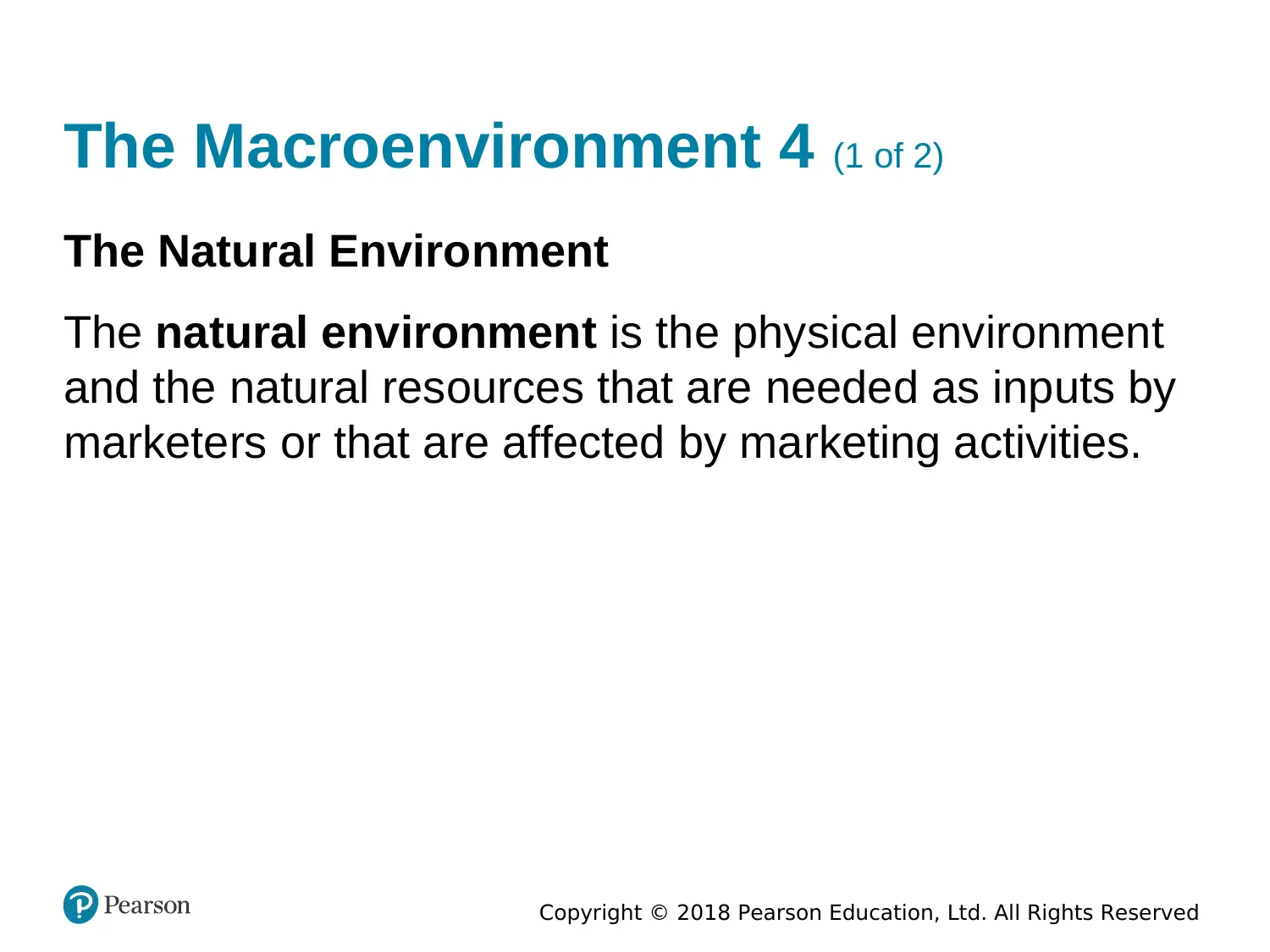
Copyright © 2018 Pearson Education, Ltd. All Rights Reserved
The Macroenvironment 4 (1 of 2)
The Natural Environment
The natural environment is the physical environment
and the natural resources that are needed as inputs by
marketers or that are affected by marketing activities.
The Macroenvironment 4 (1 of 2)
The Natural Environment
The natural environment is the physical environment
and the natural resources that are needed as inputs by
marketers or that are affected by marketing activities.
Paraphrase This Document
Need a fresh take? Get an instant paraphrase of this document with our AI Paraphraser
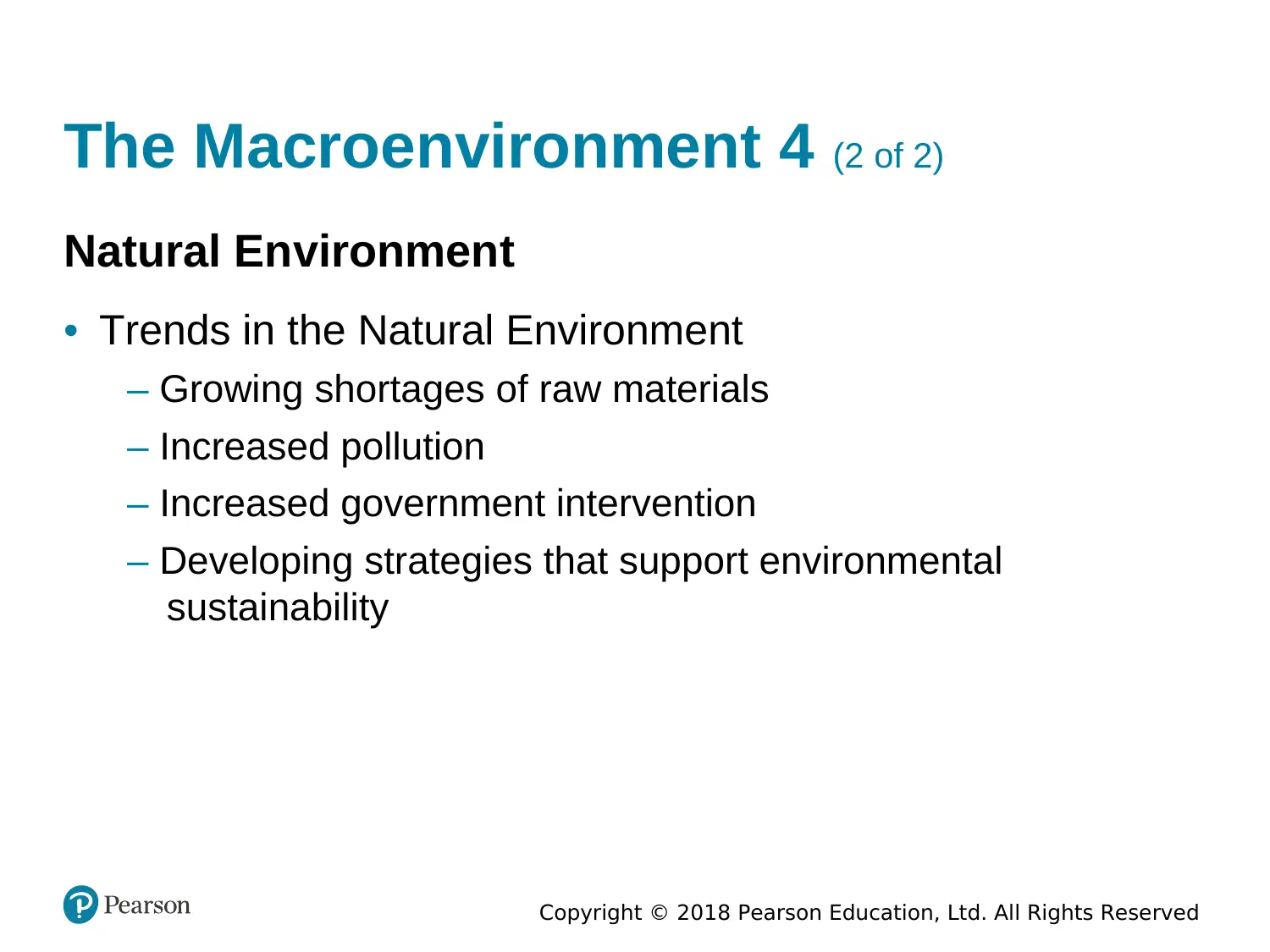
Copyright © 2018 Pearson Education, Ltd. All Rights Reserved
The Macroenvironment 4 (2 of 2)
Natural Environment
• Trends in the Natural Environment
– Growing shortages of raw materials
– Increased pollution
– Increased government intervention
– Developing strategies that support environmental
sustainability
The Macroenvironment 4 (2 of 2)
Natural Environment
• Trends in the Natural Environment
– Growing shortages of raw materials
– Increased pollution
– Increased government intervention
– Developing strategies that support environmental
sustainability
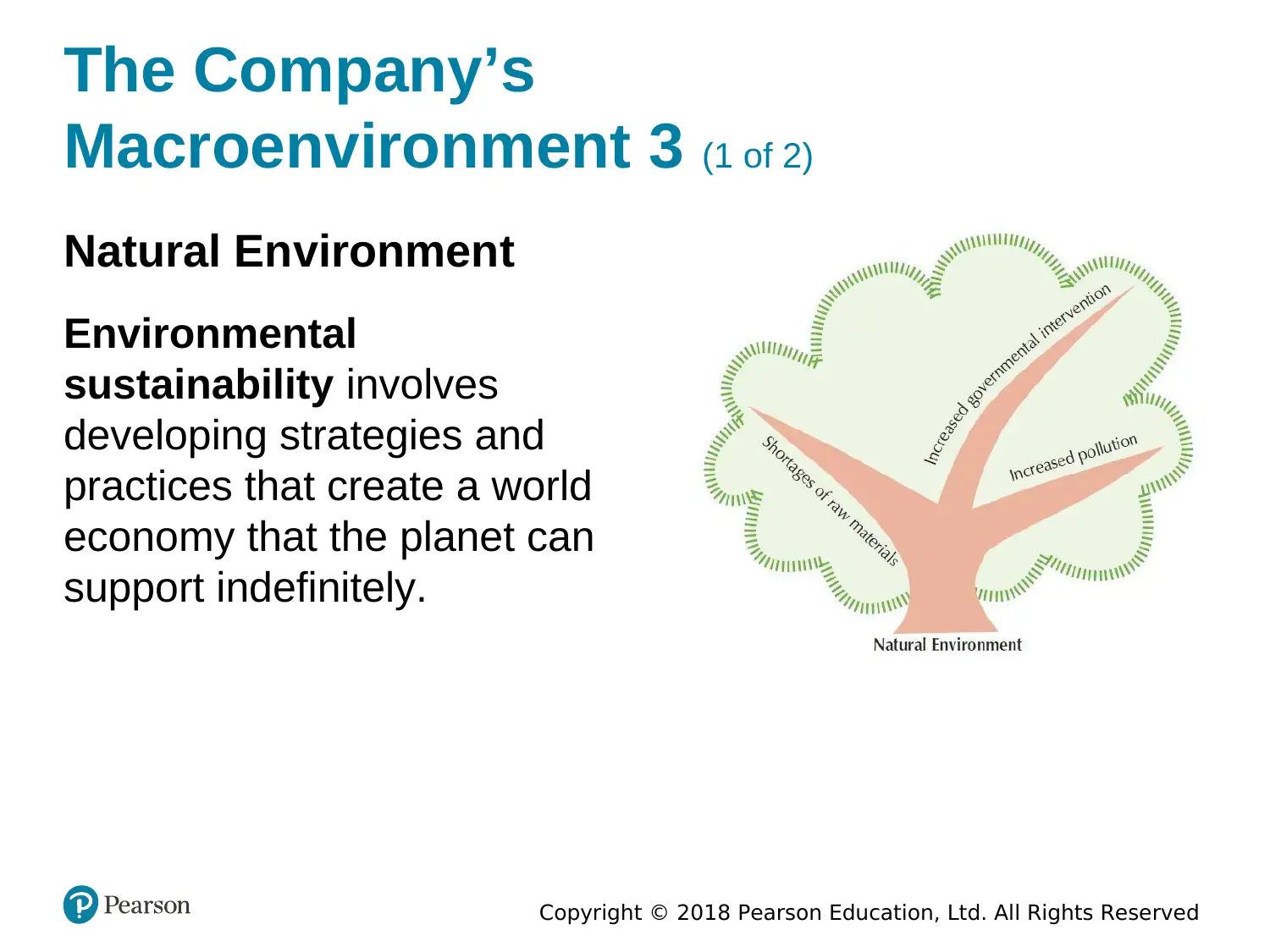
Copyright © 2018 Pearson Education, Ltd. All Rights Reserved
The Company’s
Macroenvironment 3 (1 of 2)
Natural Environment
Environmental
sustainability involves
developing strategies and
practices that create a world
economy that the planet can
support indefinitely.
The Company’s
Macroenvironment 3 (1 of 2)
Natural Environment
Environmental
sustainability involves
developing strategies and
practices that create a world
economy that the planet can
support indefinitely.
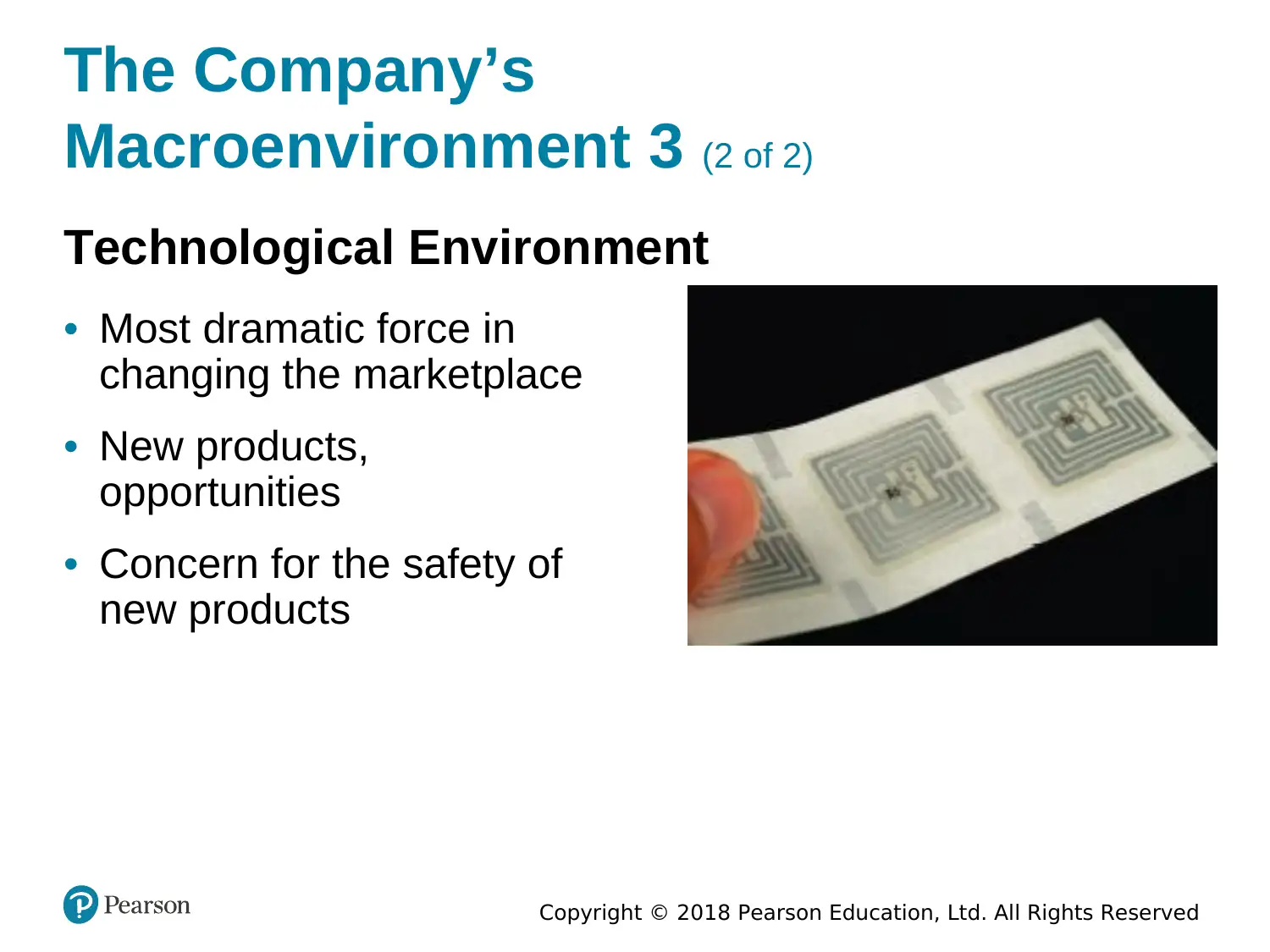
Copyright © 2018 Pearson Education, Ltd. All Rights Reserved
The Company’s
Macroenvironment 3 (2 of 2)
Technological Environment
• Most dramatic force in
changing the marketplace
• New products,
opportunities
• Concern for the safety of
new products
The Company’s
Macroenvironment 3 (2 of 2)
Technological Environment
• Most dramatic force in
changing the marketplace
• New products,
opportunities
• Concern for the safety of
new products
Secure Best Marks with AI Grader
Need help grading? Try our AI Grader for instant feedback on your assignments.
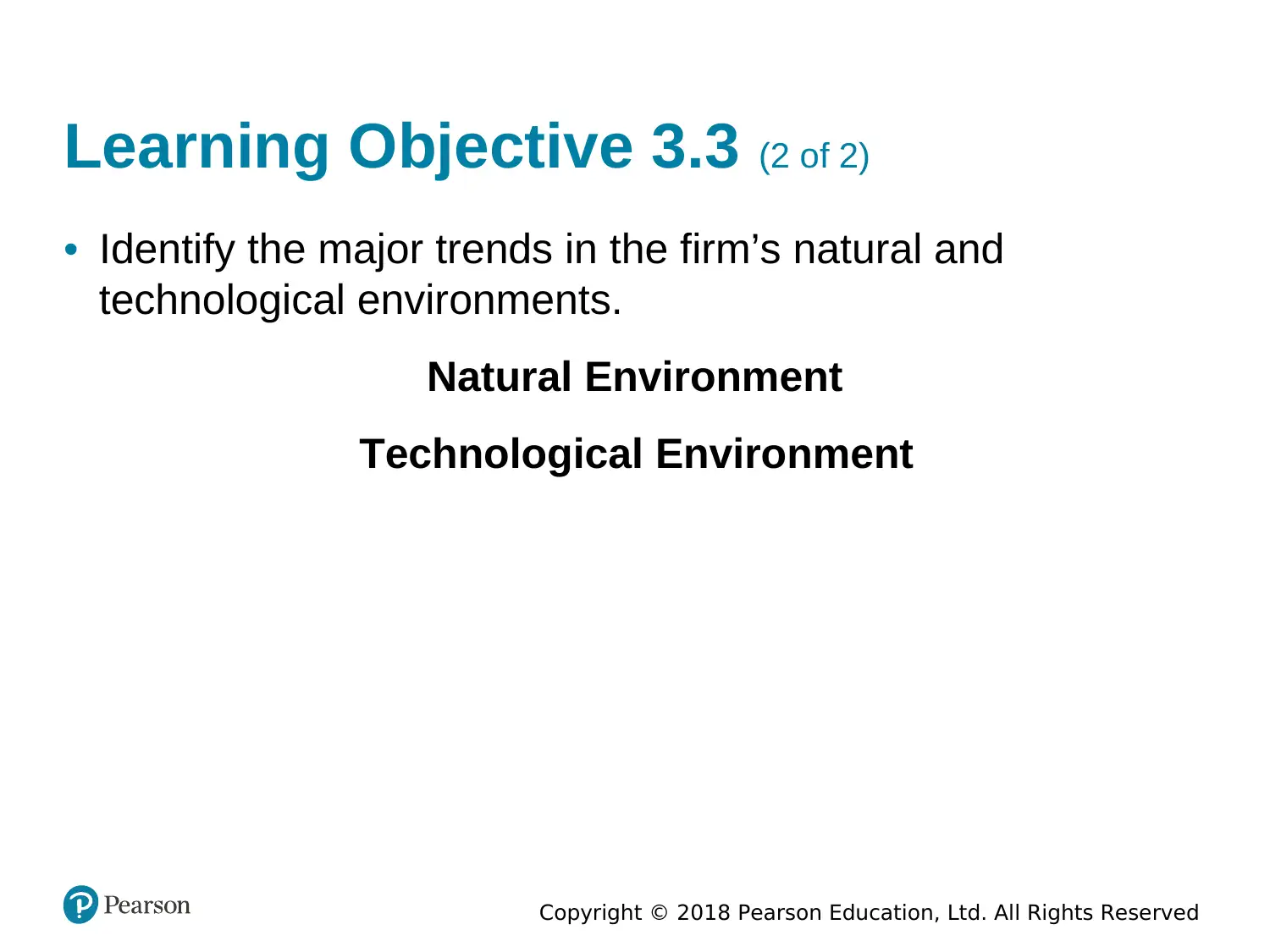
Copyright © 2018 Pearson Education, Ltd. All Rights Reserved
Learning Objective 3.3 (2 of 2)
• Identify the major trends in the firm’s natural and
technological environments.
Natural Environment
Technological Environment
Learning Objective 3.3 (2 of 2)
• Identify the major trends in the firm’s natural and
technological environments.
Natural Environment
Technological Environment
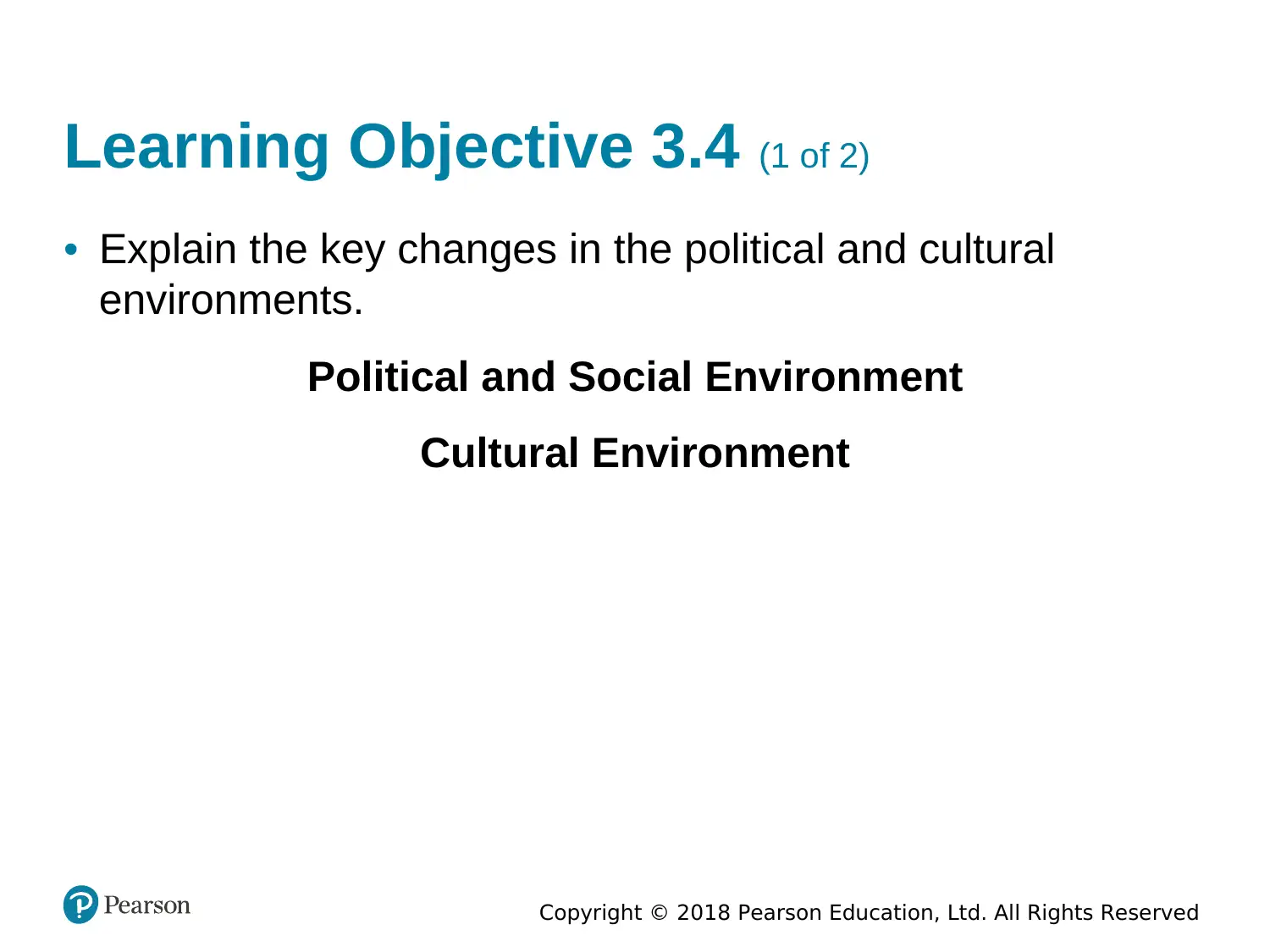
Copyright © 2018 Pearson Education, Ltd. All Rights Reserved
Learning Objective 3.4 (1 of 2)
• Explain the key changes in the political and cultural
environments.
Political and Social Environment
Cultural Environment
Learning Objective 3.4 (1 of 2)
• Explain the key changes in the political and cultural
environments.
Political and Social Environment
Cultural Environment
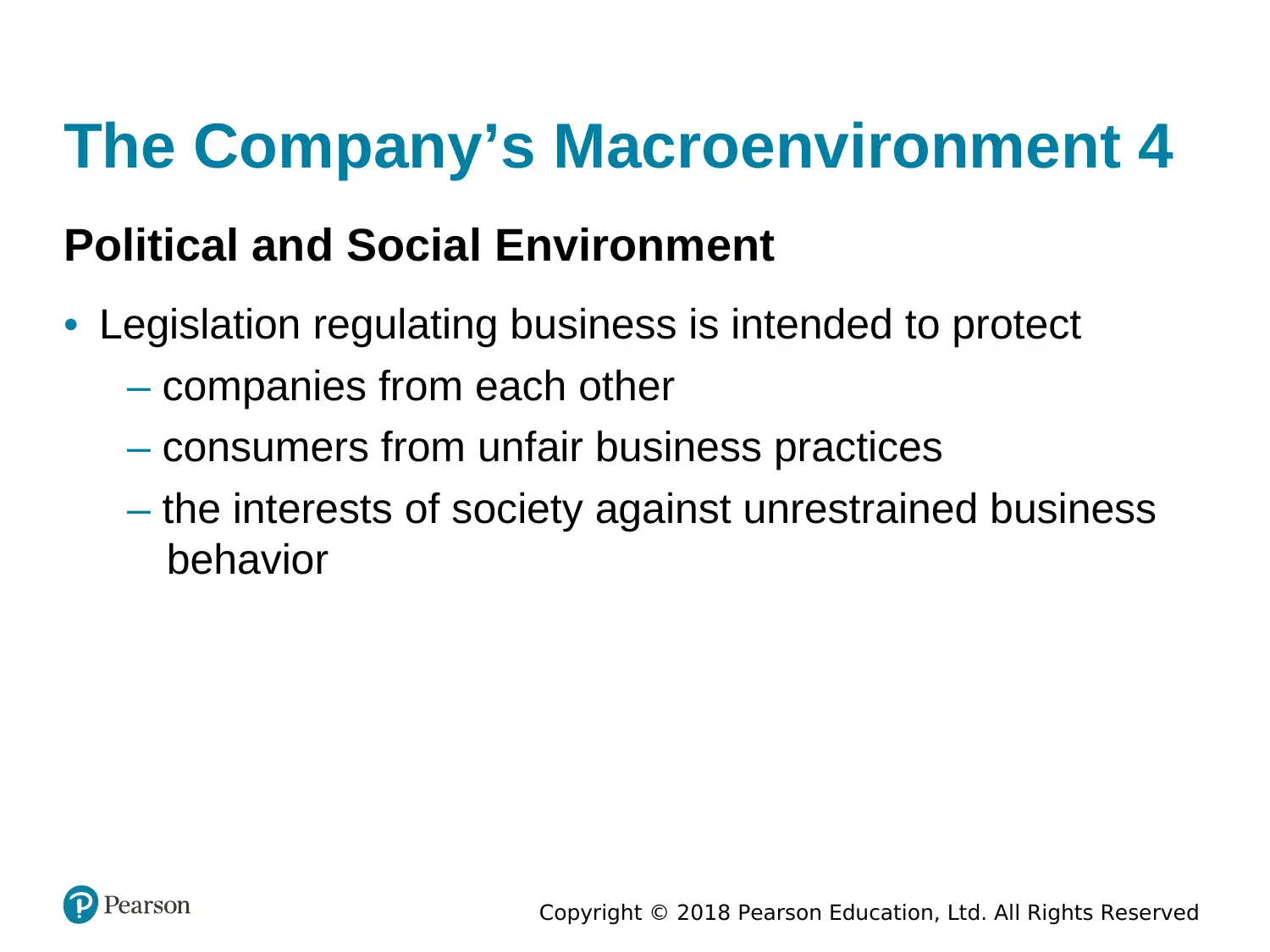
Copyright © 2018 Pearson Education, Ltd. All Rights Reserved
The Company’s Macroenvironment 4
Political and Social Environment
• Legislation regulating business is intended to protect
– companies from each other
– consumers from unfair business practices
– the interests of society against unrestrained business
behavior
The Company’s Macroenvironment 4
Political and Social Environment
• Legislation regulating business is intended to protect
– companies from each other
– consumers from unfair business practices
– the interests of society against unrestrained business
behavior
Paraphrase This Document
Need a fresh take? Get an instant paraphrase of this document with our AI Paraphraser
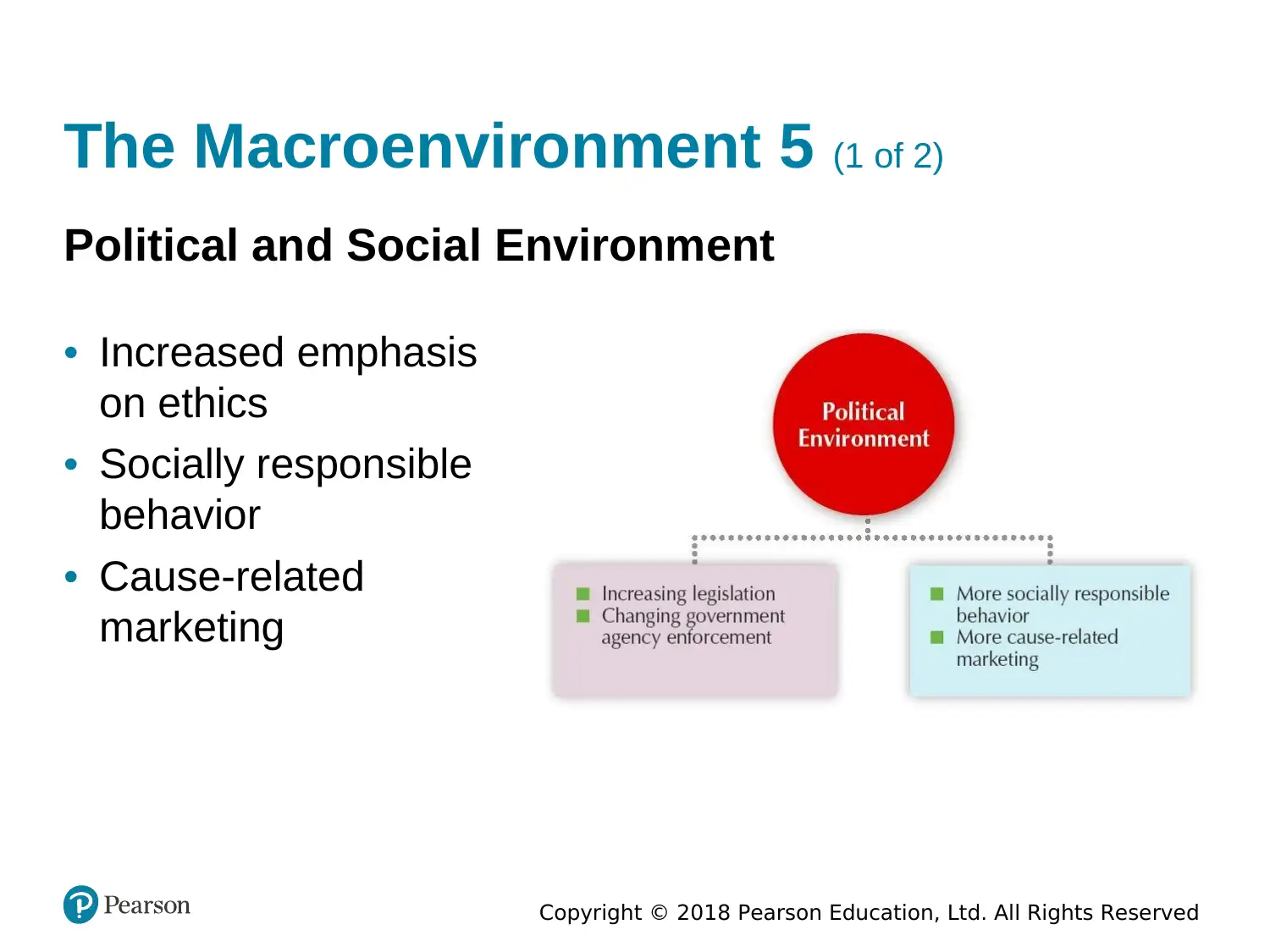
Copyright © 2018 Pearson Education, Ltd. All Rights Reserved
The Macroenvironment 5 (1 of 2)
Political and Social Environment
• Increased emphasis
on ethics
• Socially responsible
behavior
• Cause-related
marketing
The Macroenvironment 5 (1 of 2)
Political and Social Environment
• Increased emphasis
on ethics
• Socially responsible
behavior
• Cause-related
marketing
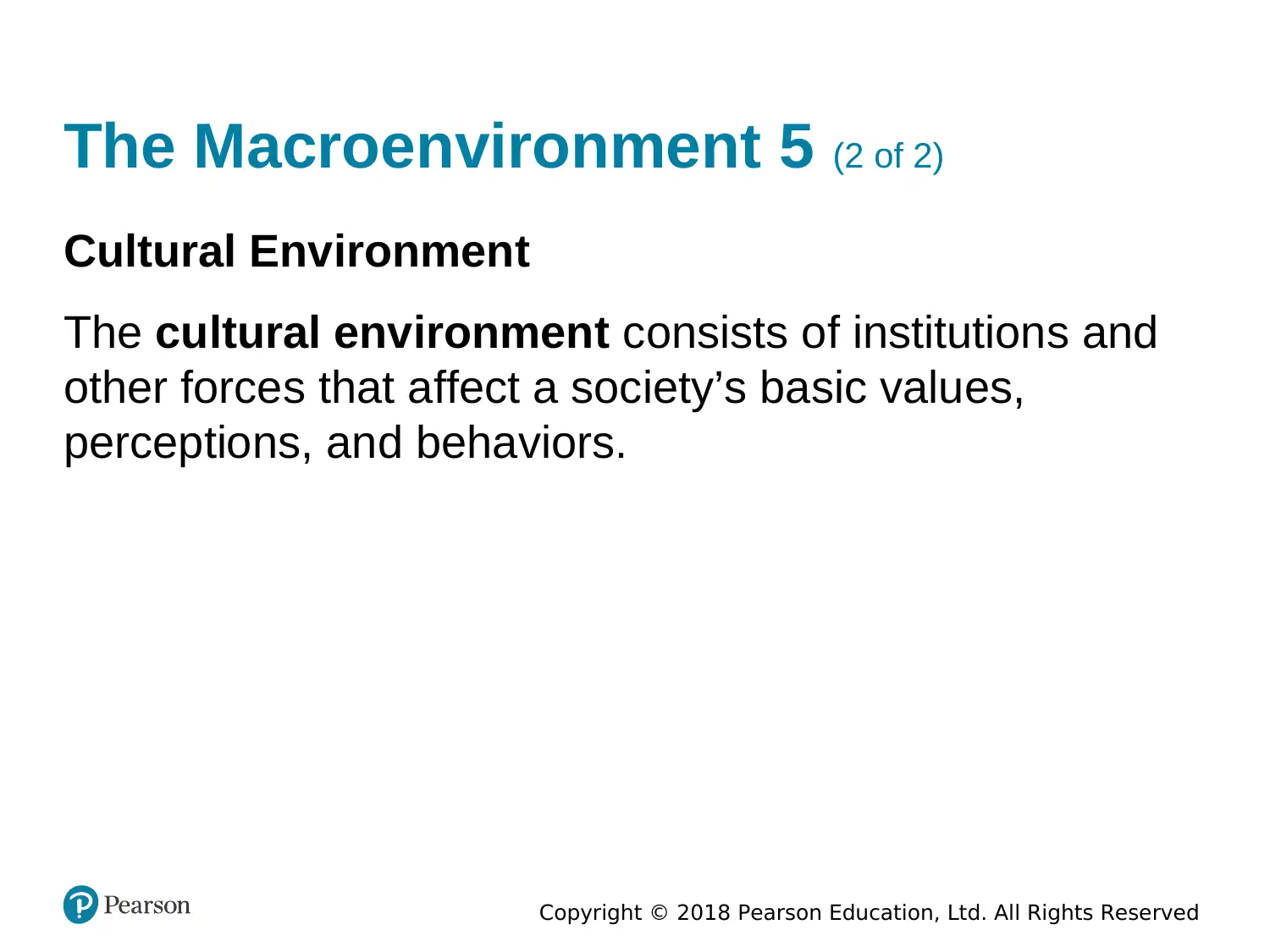
Copyright © 2018 Pearson Education, Ltd. All Rights Reserved
The Macroenvironment 5 (2 of 2)
Cultural Environment
The cultural environment consists of institutions and
other forces that affect a society’s basic values,
perceptions, and behaviors.
The Macroenvironment 5 (2 of 2)
Cultural Environment
The cultural environment consists of institutions and
other forces that affect a society’s basic values,
perceptions, and behaviors.
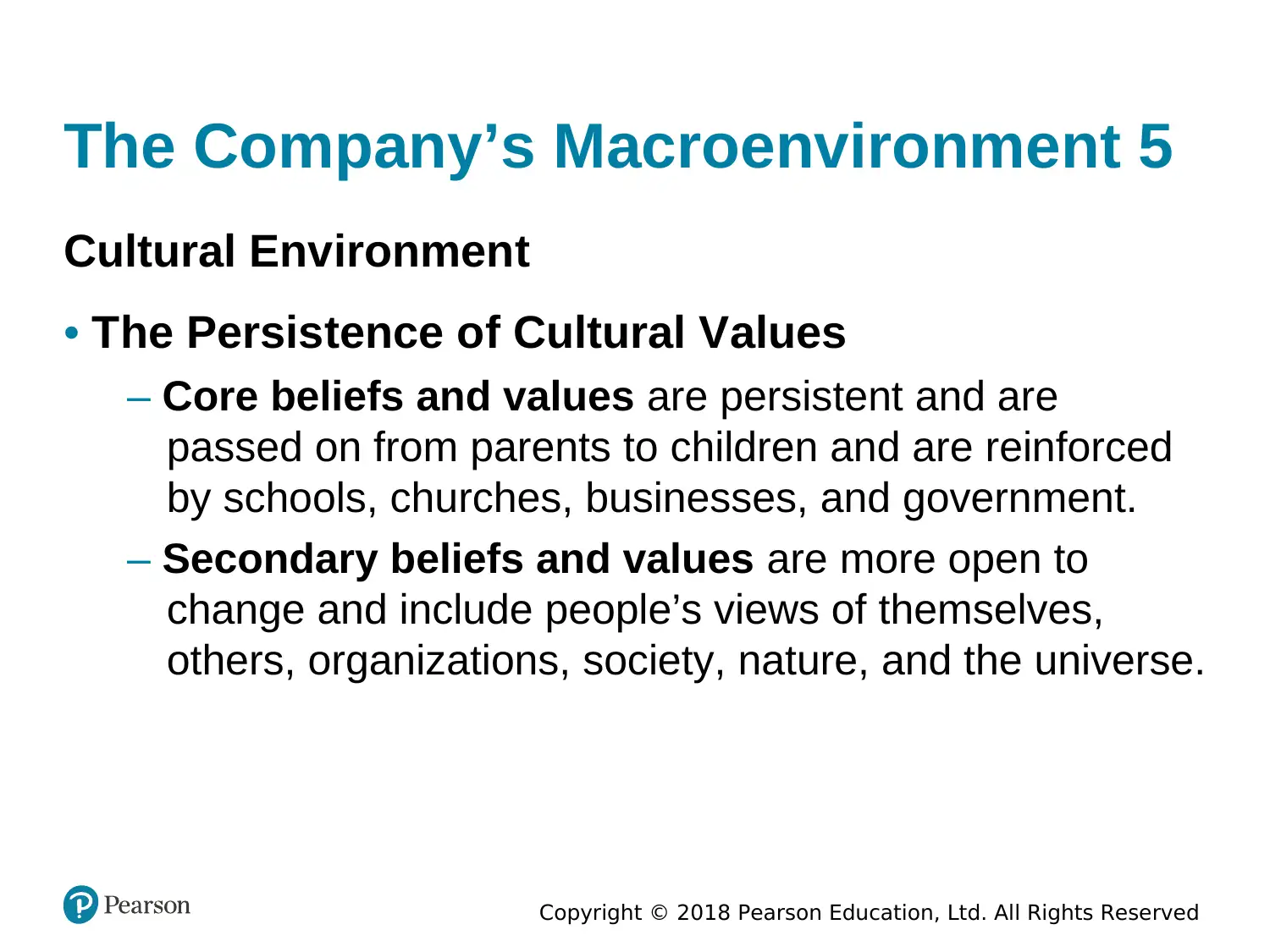
Copyright © 2018 Pearson Education, Ltd. All Rights Reserved
The Company’s Macroenvironment 5
Cultural Environment
• The Persistence of Cultural Values
– Core beliefs and values are persistent and are
passed on from parents to children and are reinforced
by schools, churches, businesses, and government.
– Secondary beliefs and values are more open to
change and include people’s views of themselves,
others, organizations, society, nature, and the universe.
The Company’s Macroenvironment 5
Cultural Environment
• The Persistence of Cultural Values
– Core beliefs and values are persistent and are
passed on from parents to children and are reinforced
by schools, churches, businesses, and government.
– Secondary beliefs and values are more open to
change and include people’s views of themselves,
others, organizations, society, nature, and the universe.
Secure Best Marks with AI Grader
Need help grading? Try our AI Grader for instant feedback on your assignments.
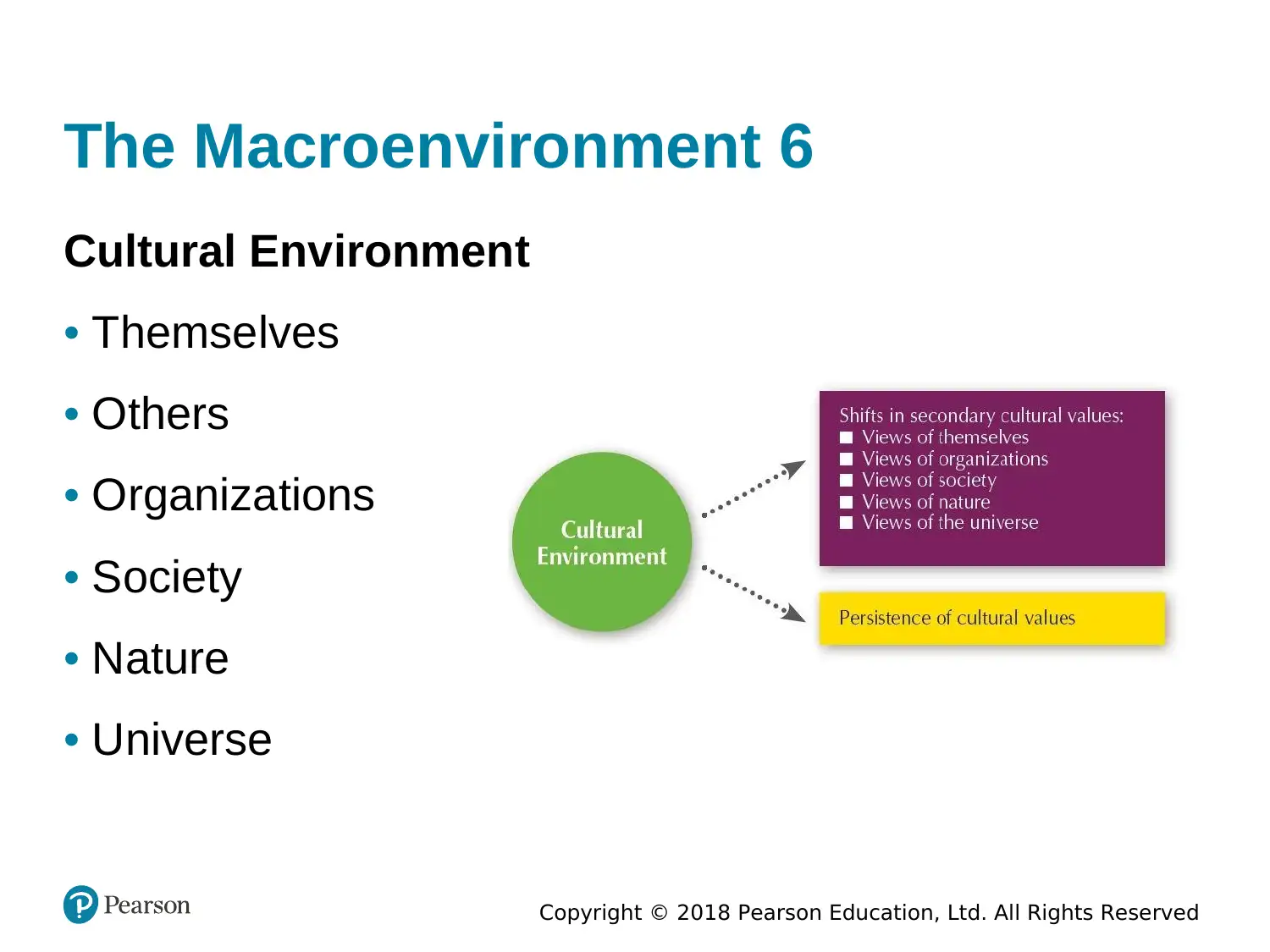
Copyright © 2018 Pearson Education, Ltd. All Rights Reserved
The Macroenvironment 6
Cultural Environment
• Themselves
• Others
• Organizations
• Society
• Nature
• Universe
The Macroenvironment 6
Cultural Environment
• Themselves
• Others
• Organizations
• Society
• Nature
• Universe
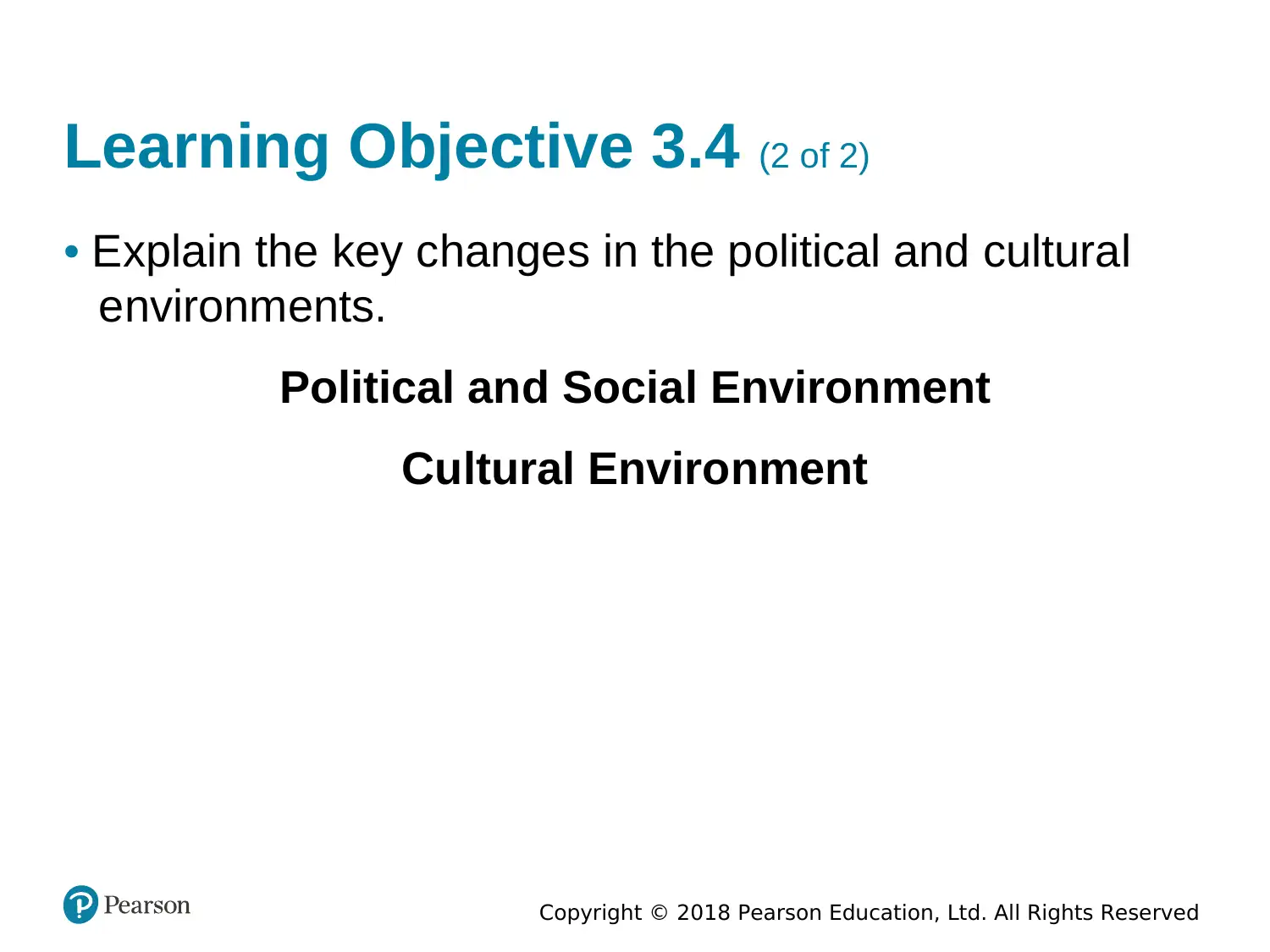
Copyright © 2018 Pearson Education, Ltd. All Rights Reserved
Learning Objective 3.4 (2 of 2)
• Explain the key changes in the political and cultural
environments.
Political and Social Environment
Cultural Environment
Learning Objective 3.4 (2 of 2)
• Explain the key changes in the political and cultural
environments.
Political and Social Environment
Cultural Environment
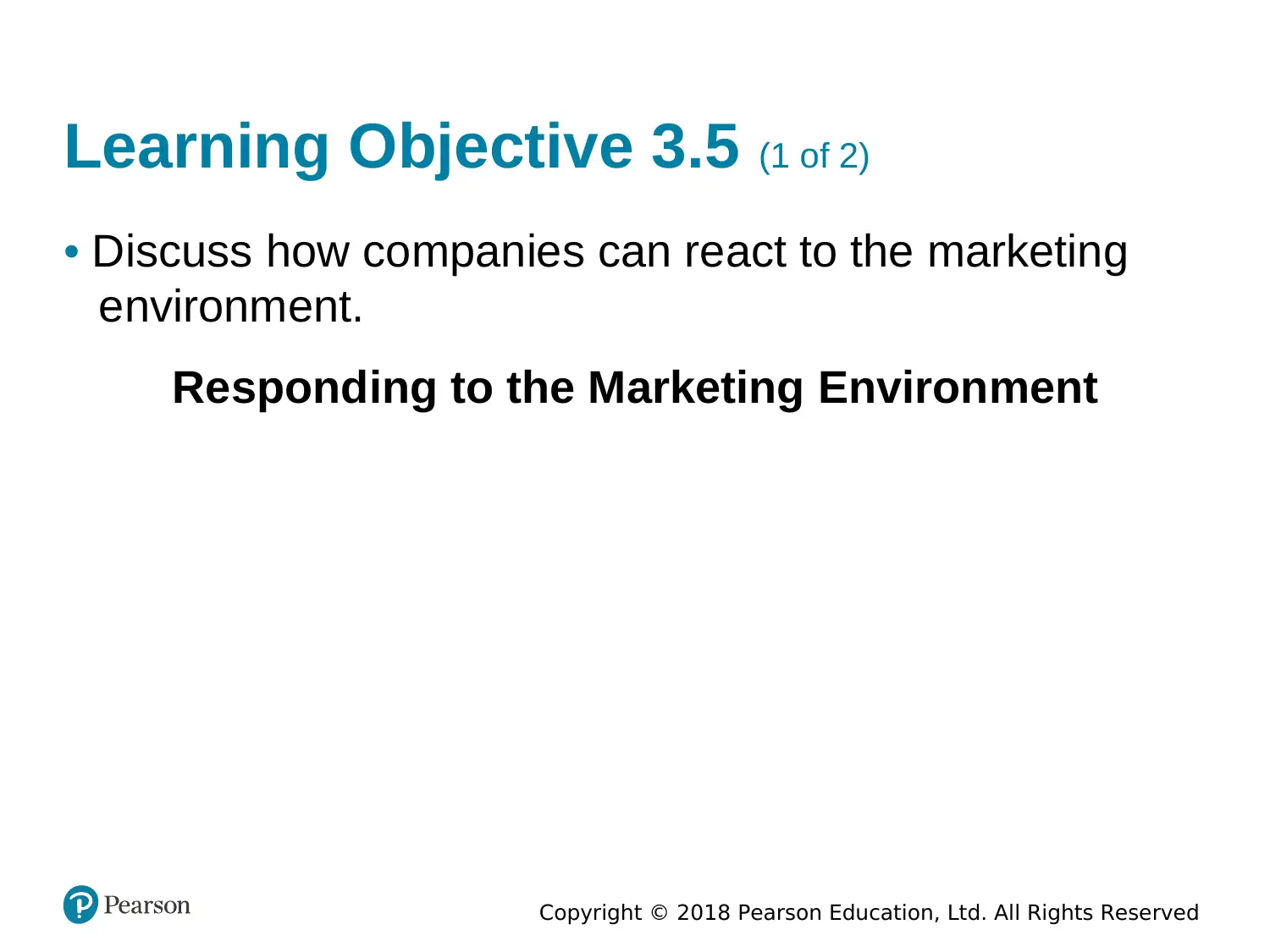
Copyright © 2018 Pearson Education, Ltd. All Rights Reserved
Learning Objective 3.5 (1 of 2)
• Discuss how companies can react to the marketing
environment.
Responding to the Marketing Environment
Learning Objective 3.5 (1 of 2)
• Discuss how companies can react to the marketing
environment.
Responding to the Marketing Environment
Paraphrase This Document
Need a fresh take? Get an instant paraphrase of this document with our AI Paraphraser
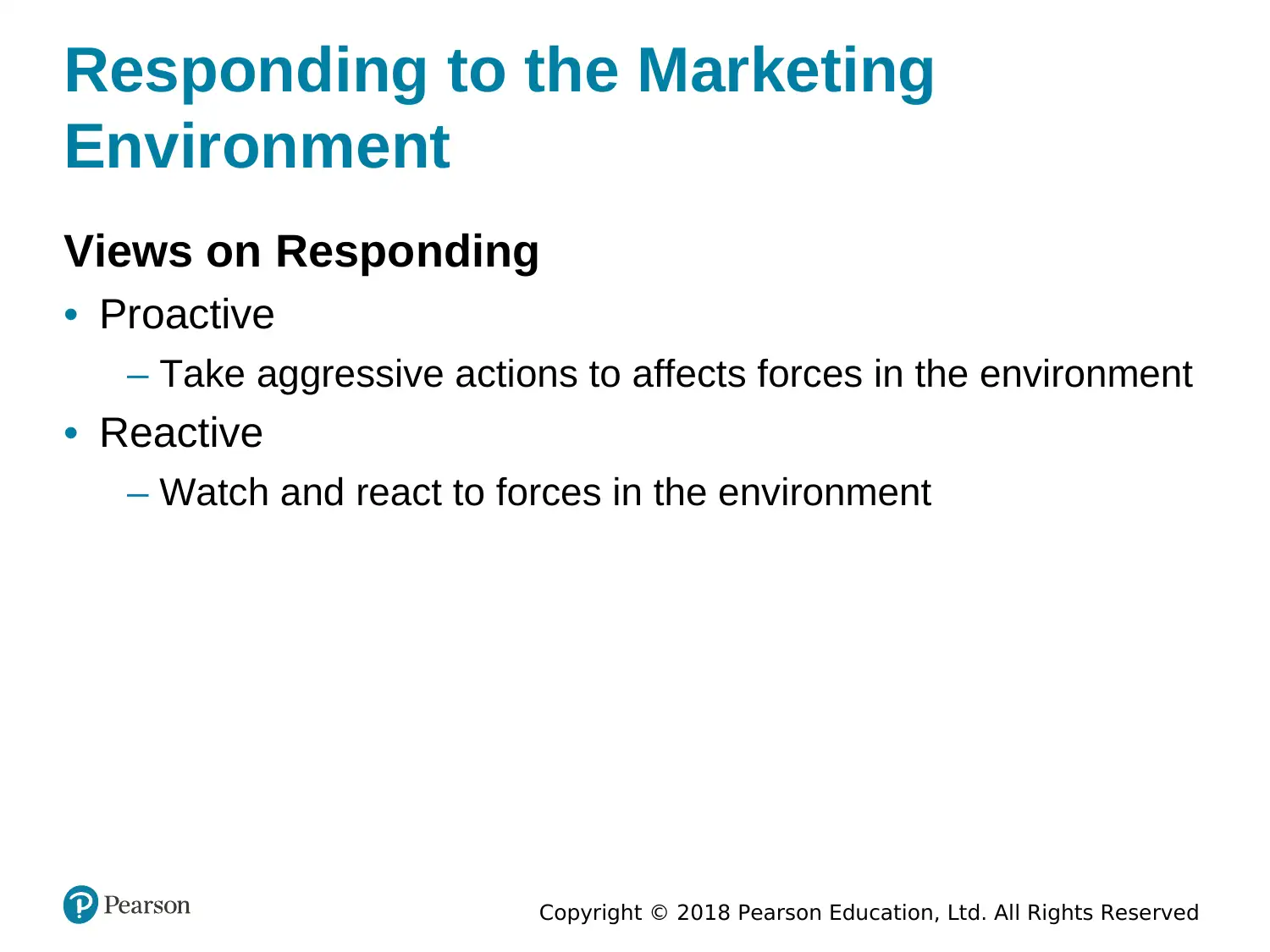
Copyright © 2018 Pearson Education, Ltd. All Rights Reserved
Responding to the Marketing
Environment
Views on Responding
• Proactive
– Take aggressive actions to affects forces in the environment
• Reactive
– Watch and react to forces in the environment
Responding to the Marketing
Environment
Views on Responding
• Proactive
– Take aggressive actions to affects forces in the environment
• Reactive
– Watch and react to forces in the environment
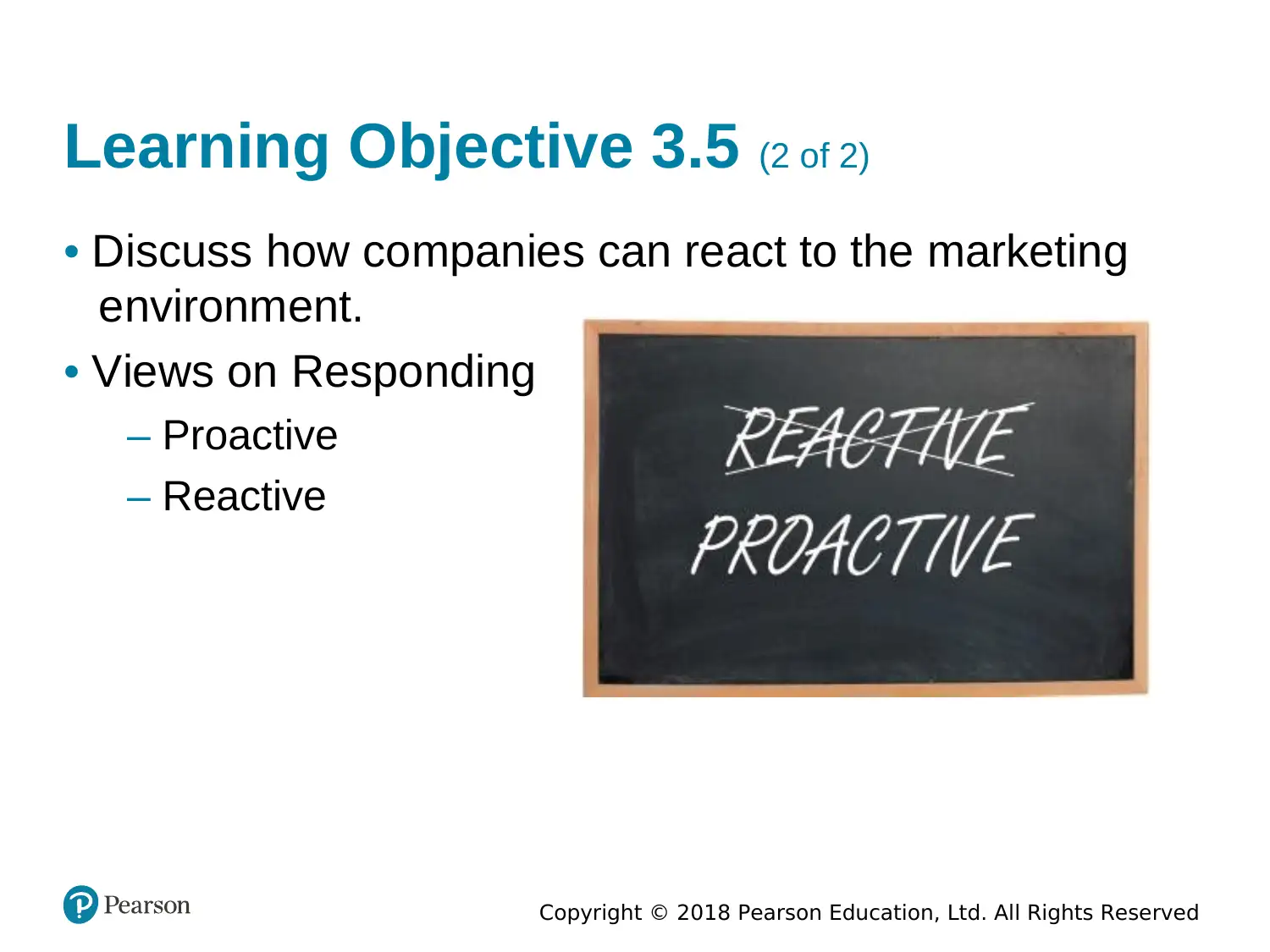
Copyright © 2018 Pearson Education, Ltd. All Rights Reserved
Learning Objective 3.5 (2 of 2)
• Discuss how companies can react to the marketing
environment.
• Views on Responding
– Proactive
– Reactive
Learning Objective 3.5 (2 of 2)
• Discuss how companies can react to the marketing
environment.
• Views on Responding
– Proactive
– Reactive
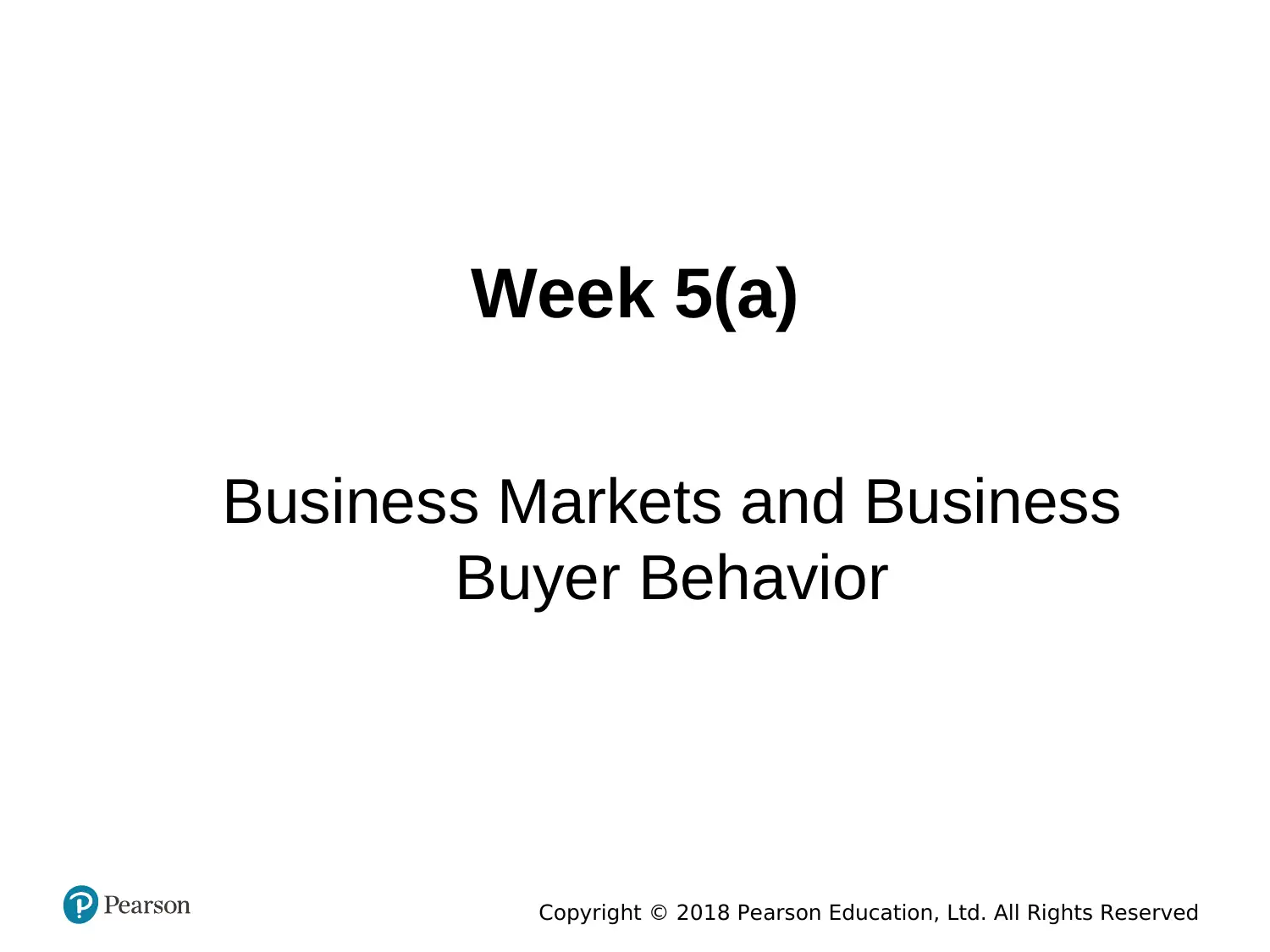
Week 5(a)
Business Markets and Business
Buyer Behavior
Copyright © 2018 Pearson Education, Ltd. All Rights Reserved
Business Markets and Business
Buyer Behavior
Copyright © 2018 Pearson Education, Ltd. All Rights Reserved
Secure Best Marks with AI Grader
Need help grading? Try our AI Grader for instant feedback on your assignments.
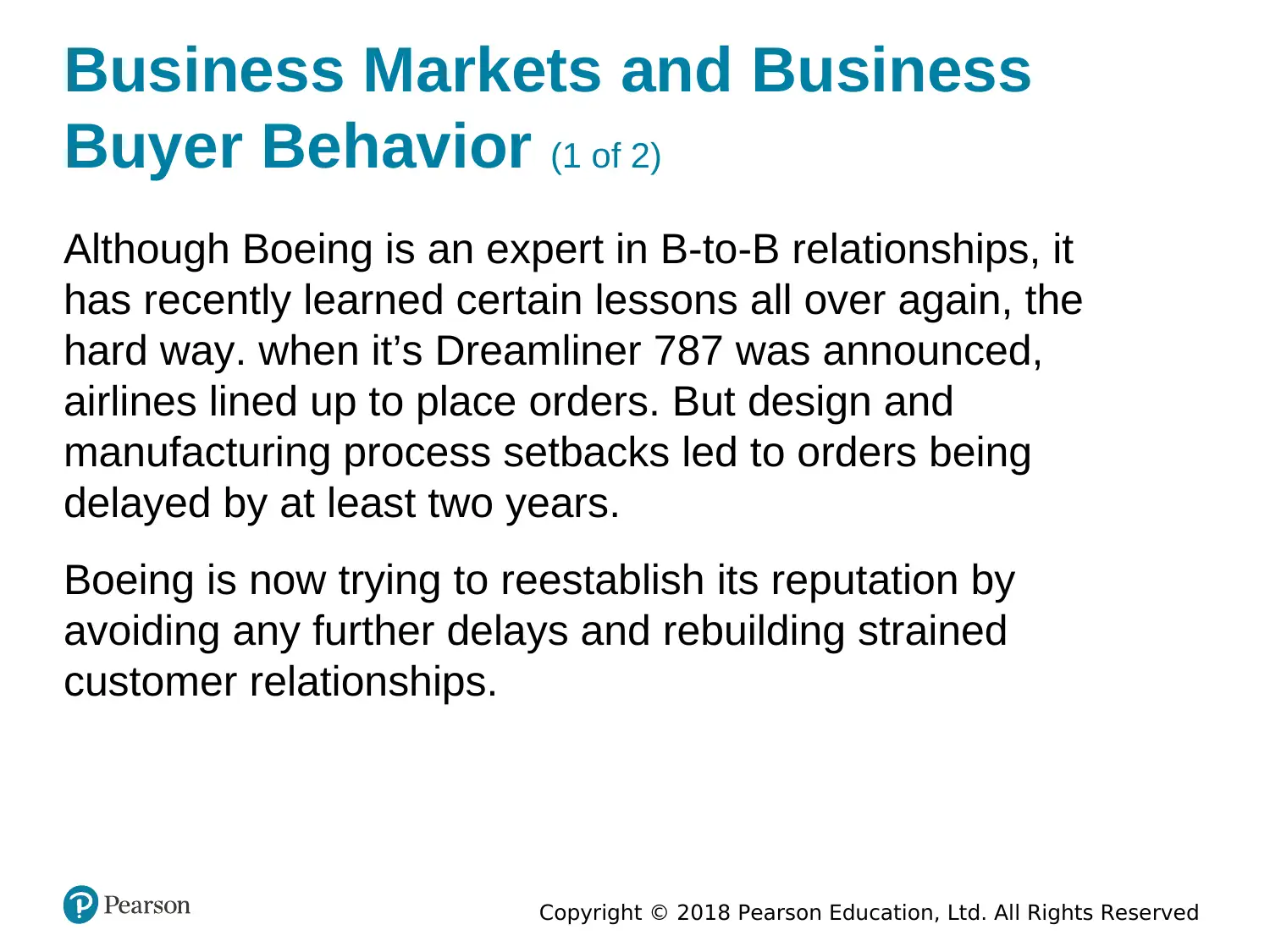
Copyright © 2018 Pearson Education, Ltd. All Rights Reserved
Business Markets and Business
Buyer Behavior (1 of 2)
Although Boeing is an expert in B-to-B relationships, it
has recently learned certain lessons all over again, the
hard way. when it’s Dreamliner 787 was announced,
airlines lined up to place orders. But design and
manufacturing process setbacks led to orders being
delayed by at least two years.
Boeing is now trying to reestablish its reputation by
avoiding any further delays and rebuilding strained
customer relationships.
Business Markets and Business
Buyer Behavior (1 of 2)
Although Boeing is an expert in B-to-B relationships, it
has recently learned certain lessons all over again, the
hard way. when it’s Dreamliner 787 was announced,
airlines lined up to place orders. But design and
manufacturing process setbacks led to orders being
delayed by at least two years.
Boeing is now trying to reestablish its reputation by
avoiding any further delays and rebuilding strained
customer relationships.
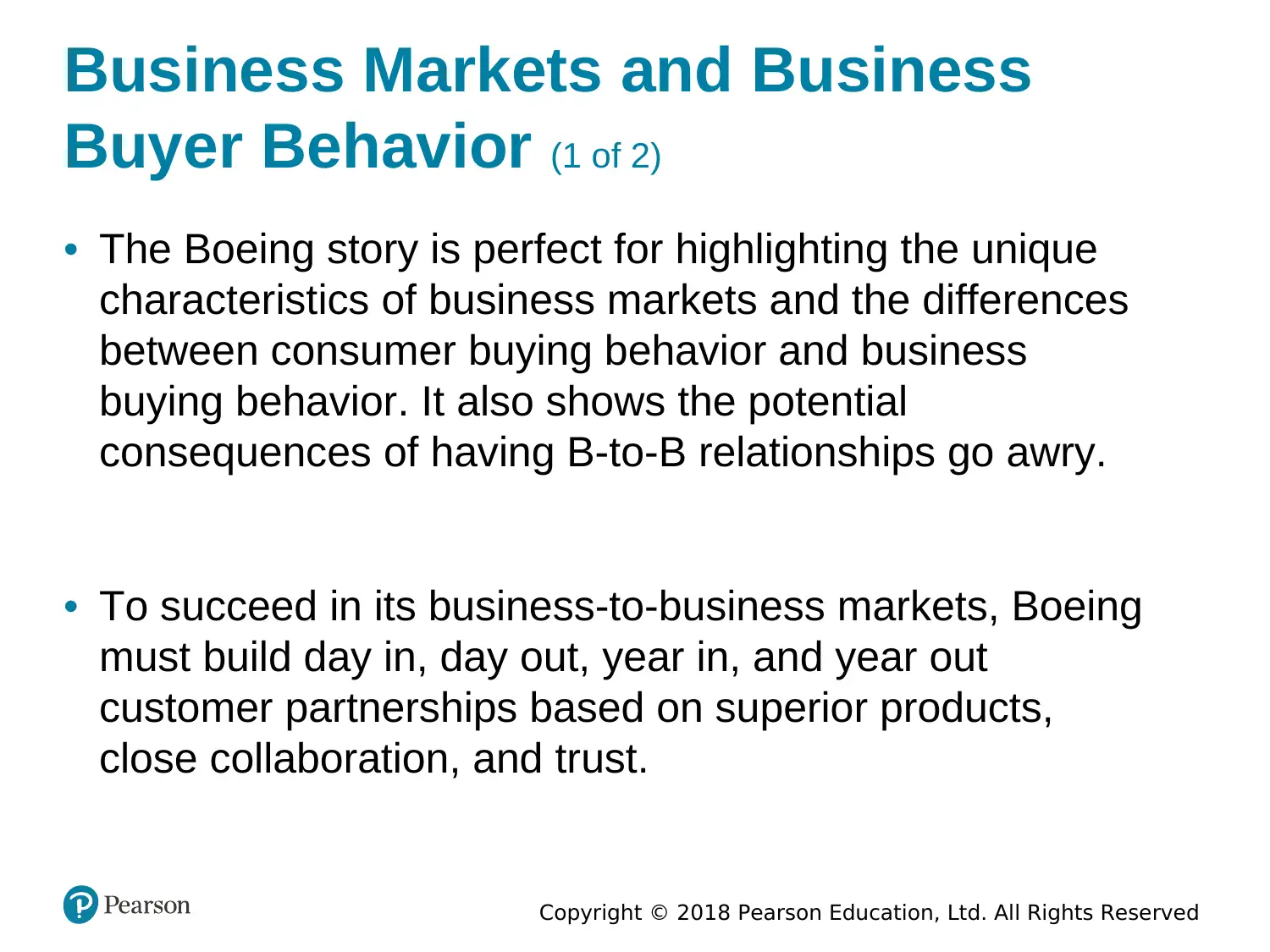
Copyright © 2018 Pearson Education, Ltd. All Rights Reserved
Business Markets and Business
Buyer Behavior (1 of 2)
• The Boeing story is perfect for highlighting the unique
characteristics of business markets and the differences
between consumer buying behavior and business
buying behavior. It also shows the potential
consequences of having B-to-B relationships go awry.
• To succeed in its business-to-business markets, Boeing
must build day in, day out, year in, and year out
customer partnerships based on superior products,
close collaboration, and trust.
Business Markets and Business
Buyer Behavior (1 of 2)
• The Boeing story is perfect for highlighting the unique
characteristics of business markets and the differences
between consumer buying behavior and business
buying behavior. It also shows the potential
consequences of having B-to-B relationships go awry.
• To succeed in its business-to-business markets, Boeing
must build day in, day out, year in, and year out
customer partnerships based on superior products,
close collaboration, and trust.
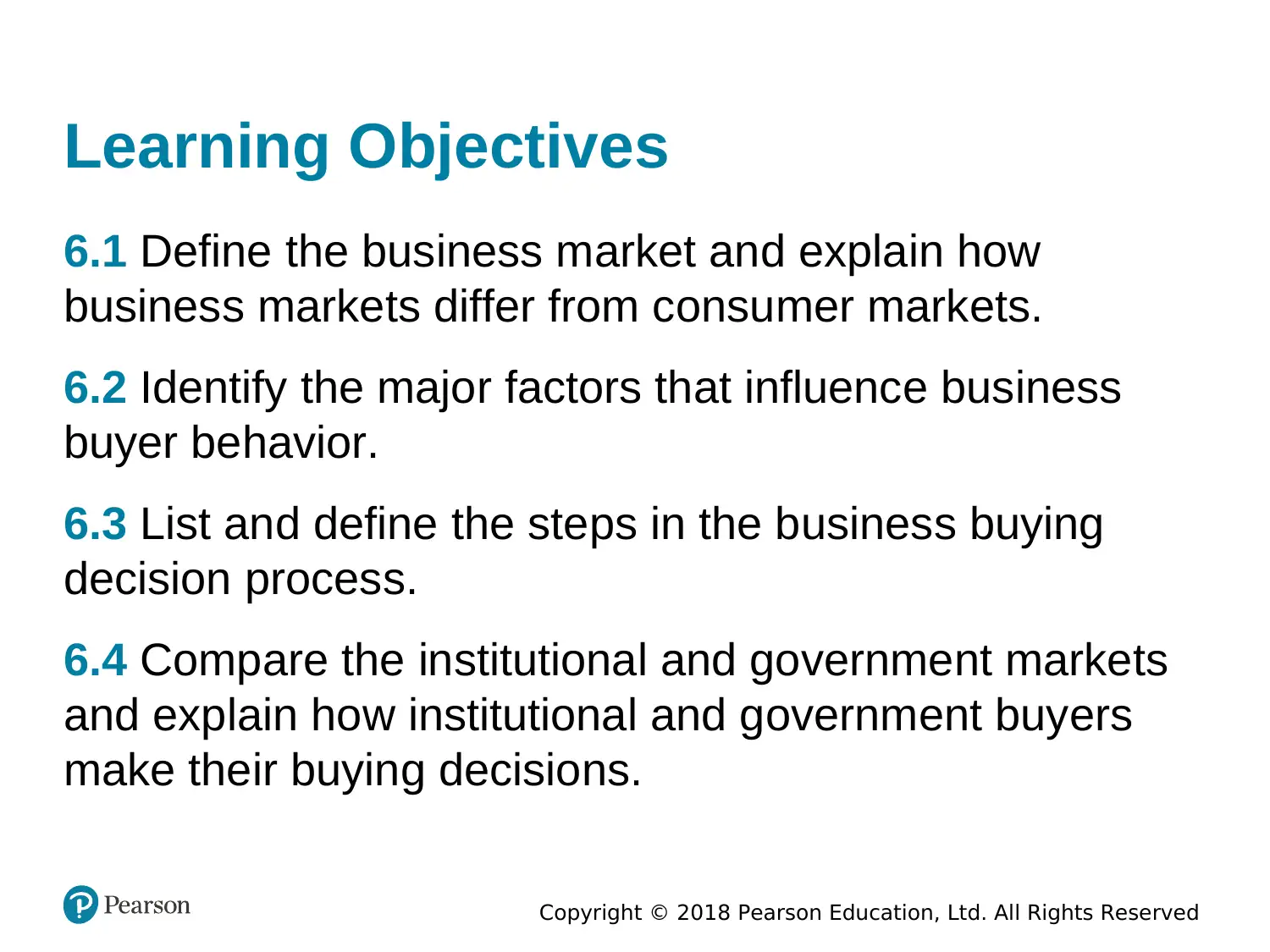
Copyright © 2018 Pearson Education, Ltd. All Rights Reserved
Learning Objectives
6.1 Define the business market and explain how
business markets differ from consumer markets.
6.2 Identify the major factors that influence business
buyer behavior.
6.3 List and define the steps in the business buying
decision process.
6.4 Compare the institutional and government markets
and explain how institutional and government buyers
make their buying decisions.
Learning Objectives
6.1 Define the business market and explain how
business markets differ from consumer markets.
6.2 Identify the major factors that influence business
buyer behavior.
6.3 List and define the steps in the business buying
decision process.
6.4 Compare the institutional and government markets
and explain how institutional and government buyers
make their buying decisions.
Paraphrase This Document
Need a fresh take? Get an instant paraphrase of this document with our AI Paraphraser
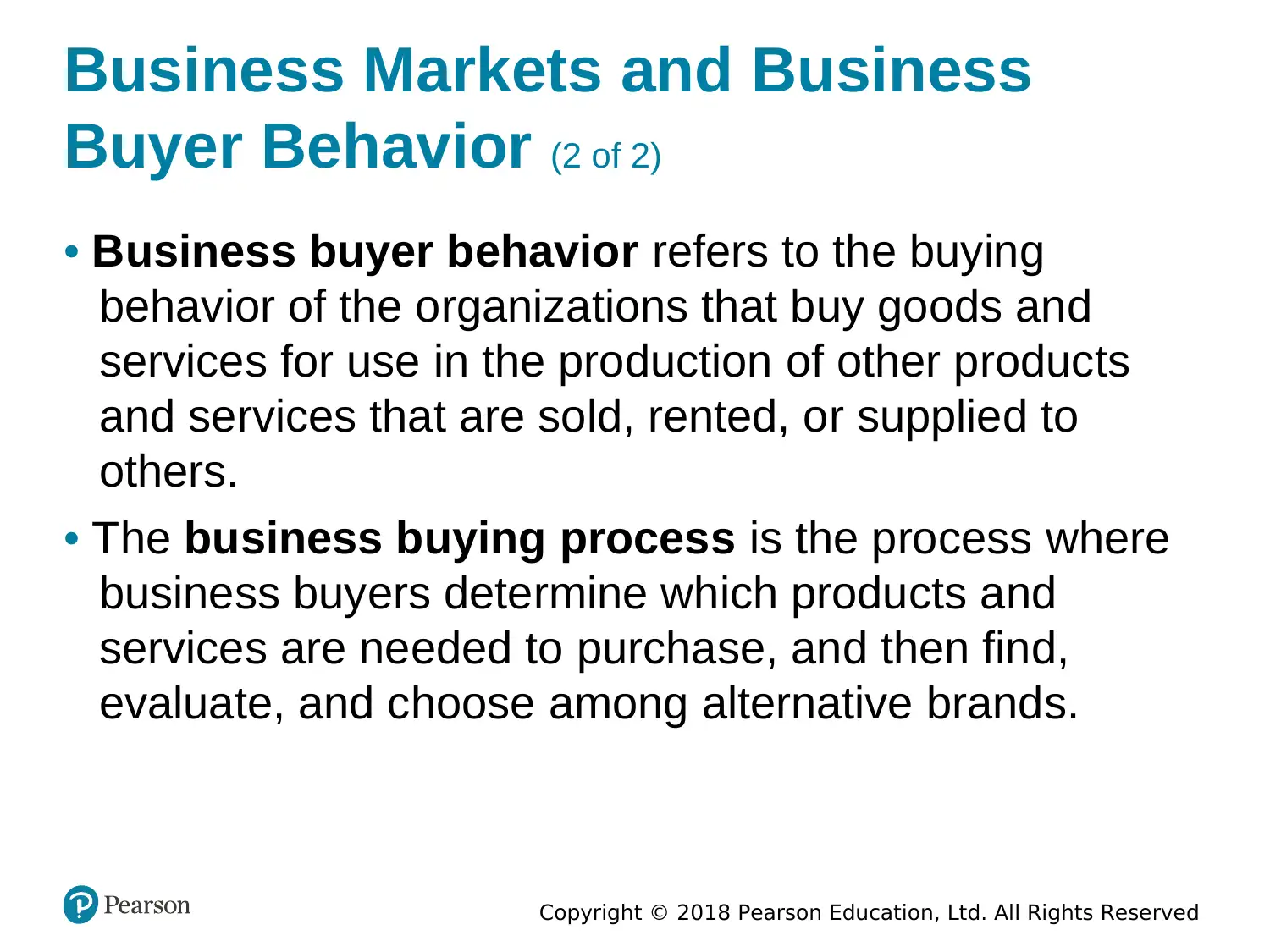
Copyright © 2018 Pearson Education, Ltd. All Rights Reserved
Business Markets and Business
Buyer Behavior (2 of 2)
• Business buyer behavior refers to the buying
behavior of the organizations that buy goods and
services for use in the production of other products
and services that are sold, rented, or supplied to
others.
• The business buying process is the process where
business buyers determine which products and
services are needed to purchase, and then find,
evaluate, and choose among alternative brands.
Business Markets and Business
Buyer Behavior (2 of 2)
• Business buyer behavior refers to the buying
behavior of the organizations that buy goods and
services for use in the production of other products
and services that are sold, rented, or supplied to
others.
• The business buying process is the process where
business buyers determine which products and
services are needed to purchase, and then find,
evaluate, and choose among alternative brands.
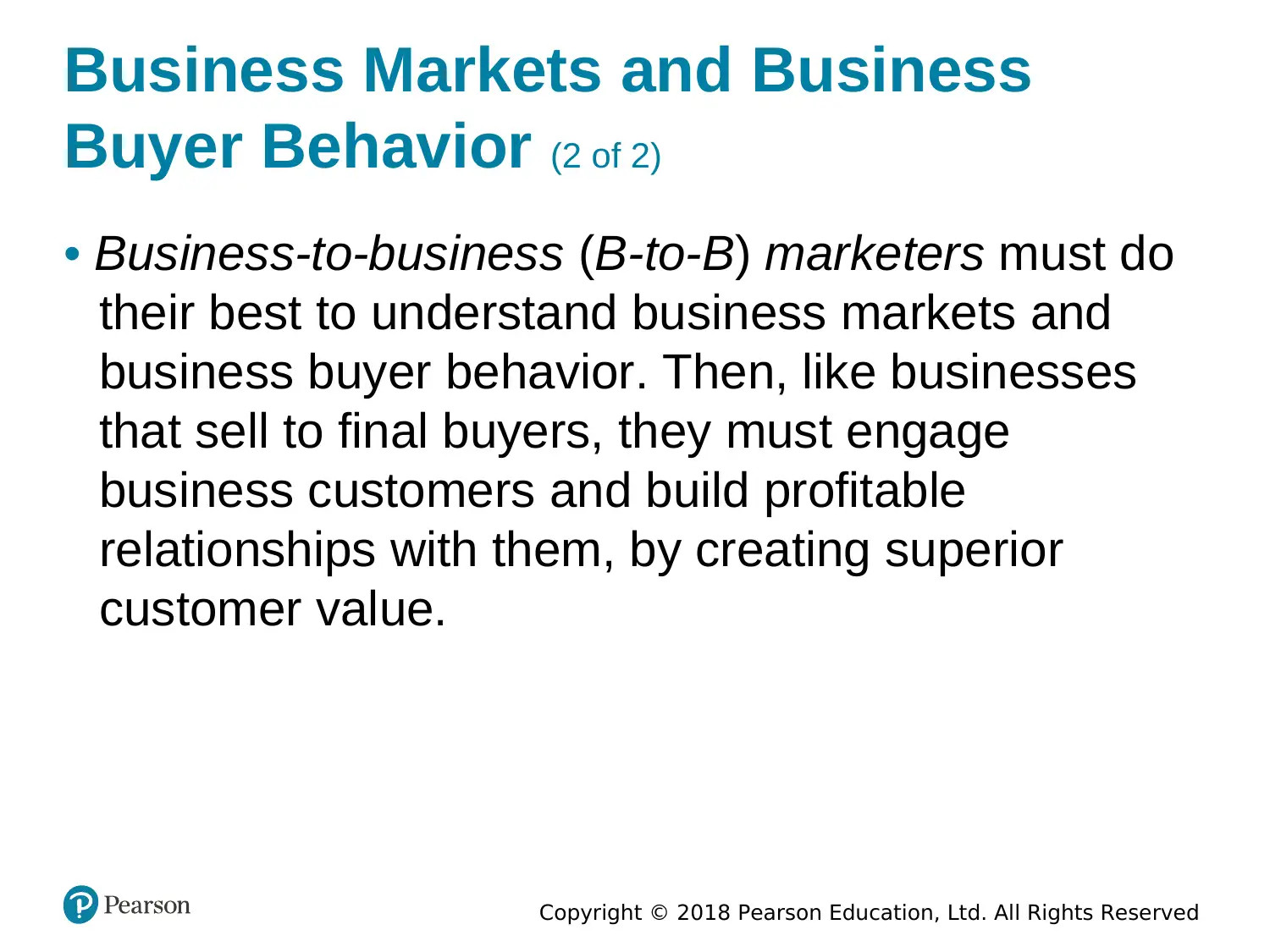
Copyright © 2018 Pearson Education, Ltd. All Rights Reserved
Business Markets and Business
Buyer Behavior (2 of 2)
• Business-to-business (B-to-B) marketers must do
their best to understand business markets and
business buyer behavior. Then, like businesses
that sell to final buyers, they must engage
business customers and build profitable
relationships with them, by creating superior
customer value.
Business Markets and Business
Buyer Behavior (2 of 2)
• Business-to-business (B-to-B) marketers must do
their best to understand business markets and
business buyer behavior. Then, like businesses
that sell to final buyers, they must engage
business customers and build profitable
relationships with them, by creating superior
customer value.
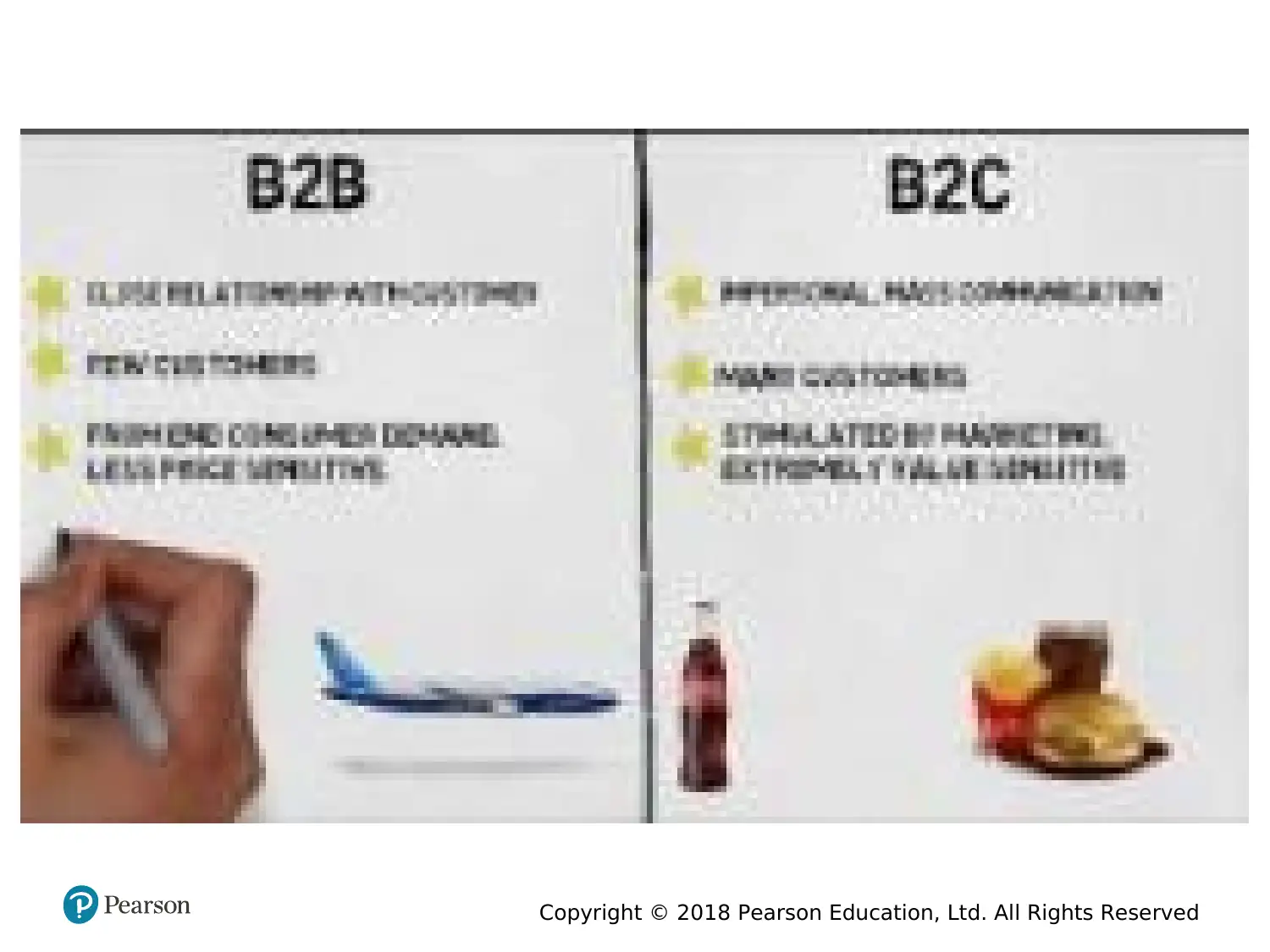
Copyright © 2018 Pearson Education, Ltd. All Rights Reserved
Secure Best Marks with AI Grader
Need help grading? Try our AI Grader for instant feedback on your assignments.
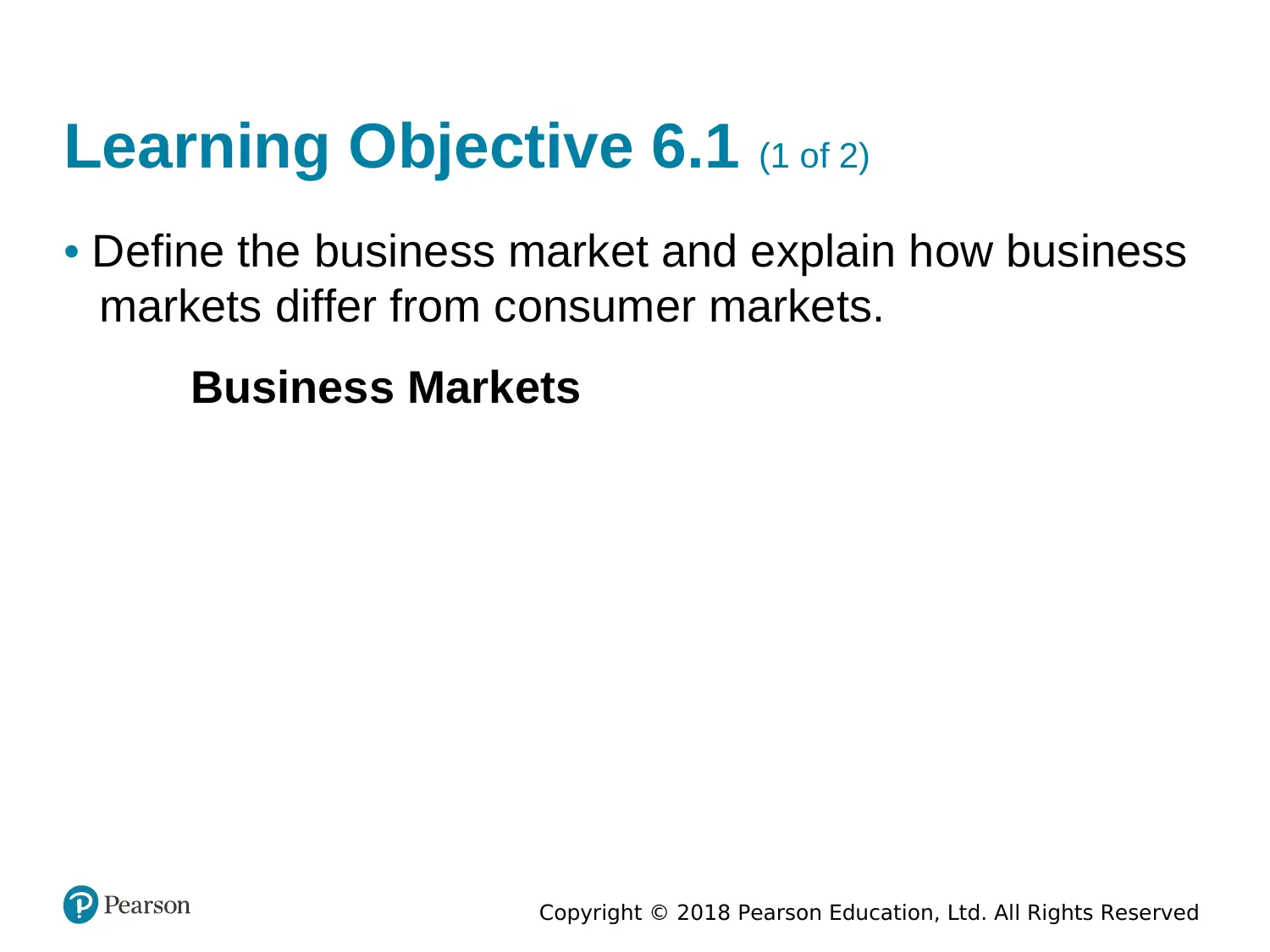
Copyright © 2018 Pearson Education, Ltd. All Rights Reserved
Learning Objective 6.1 (1 of 2)
• Define the business market and explain how business
markets differ from consumer markets.
Business Markets
Learning Objective 6.1 (1 of 2)
• Define the business market and explain how business
markets differ from consumer markets.
Business Markets
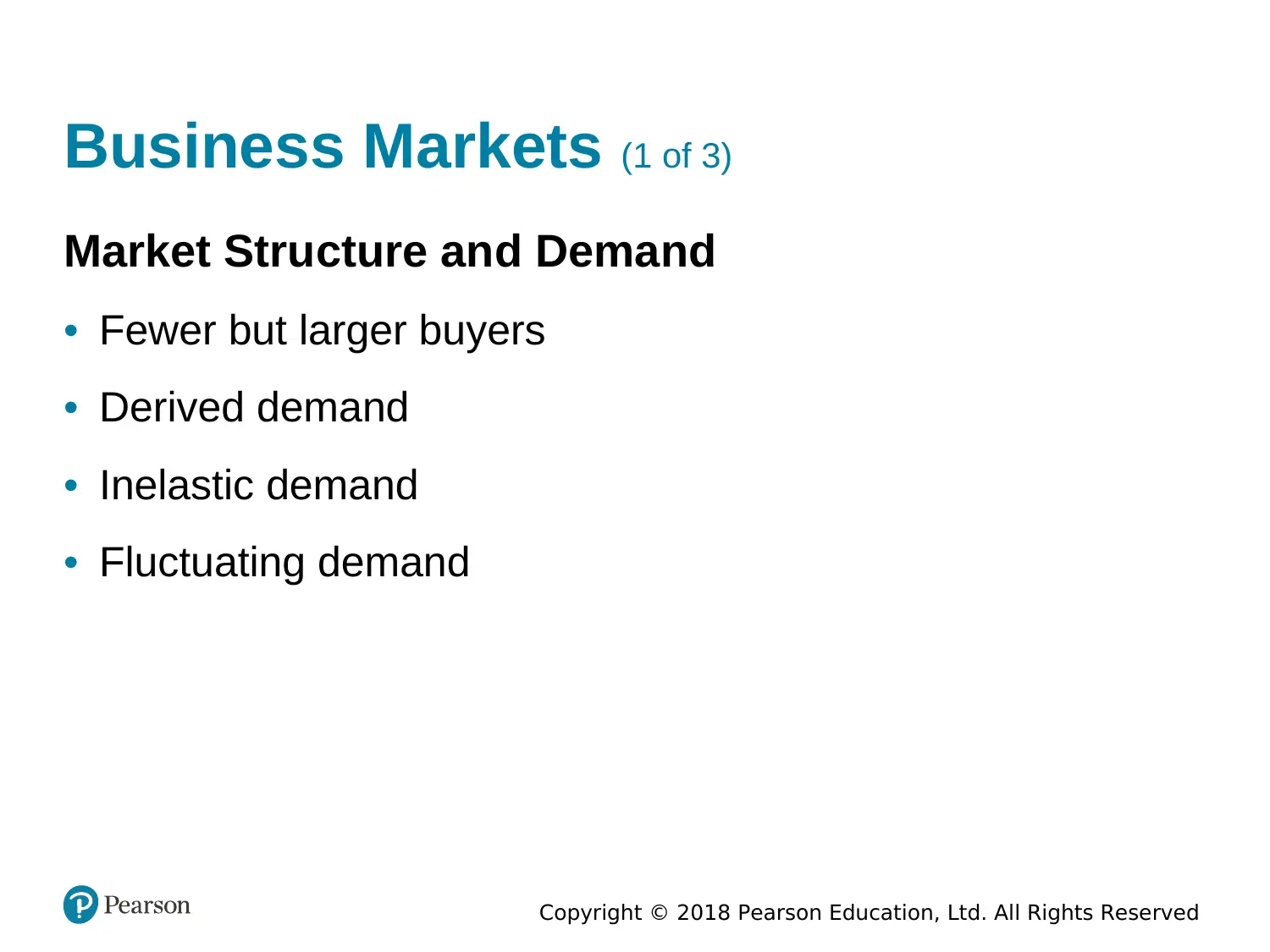
Copyright © 2018 Pearson Education, Ltd. All Rights Reserved
Business Markets (1 of 3)
Market Structure and Demand
• Fewer but larger buyers
• Derived demand
• Inelastic demand
• Fluctuating demand
Business Markets (1 of 3)
Market Structure and Demand
• Fewer but larger buyers
• Derived demand
• Inelastic demand
• Fluctuating demand
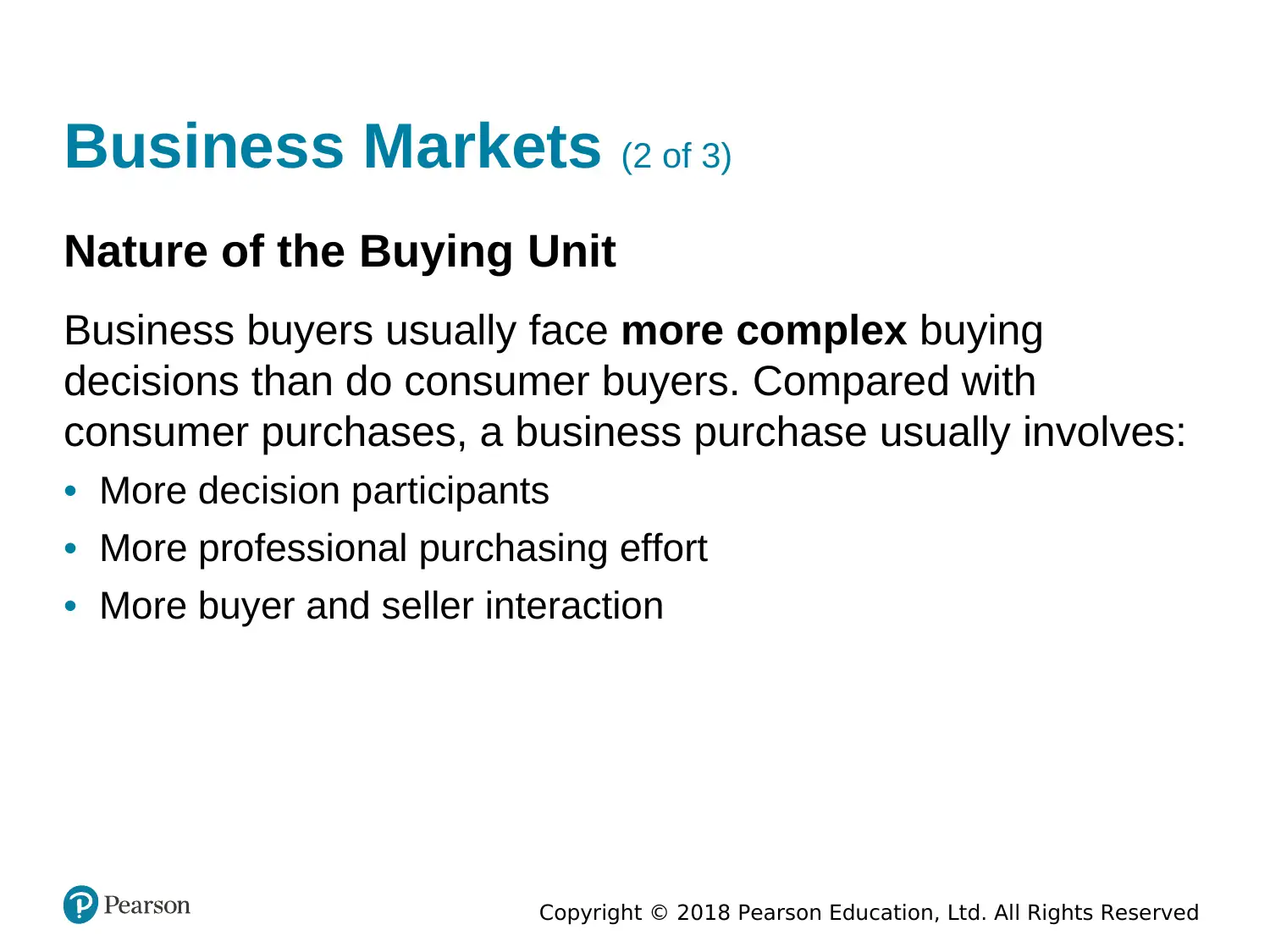
Copyright © 2018 Pearson Education, Ltd. All Rights Reserved
Business Markets (2 of 3)
Nature of the Buying Unit
Business buyers usually face more complex buying
decisions than do consumer buyers. Compared with
consumer purchases, a business purchase usually involves:
• More decision participants
• More professional purchasing effort
• More buyer and seller interaction
Business Markets (2 of 3)
Nature of the Buying Unit
Business buyers usually face more complex buying
decisions than do consumer buyers. Compared with
consumer purchases, a business purchase usually involves:
• More decision participants
• More professional purchasing effort
• More buyer and seller interaction
Paraphrase This Document
Need a fresh take? Get an instant paraphrase of this document with our AI Paraphraser
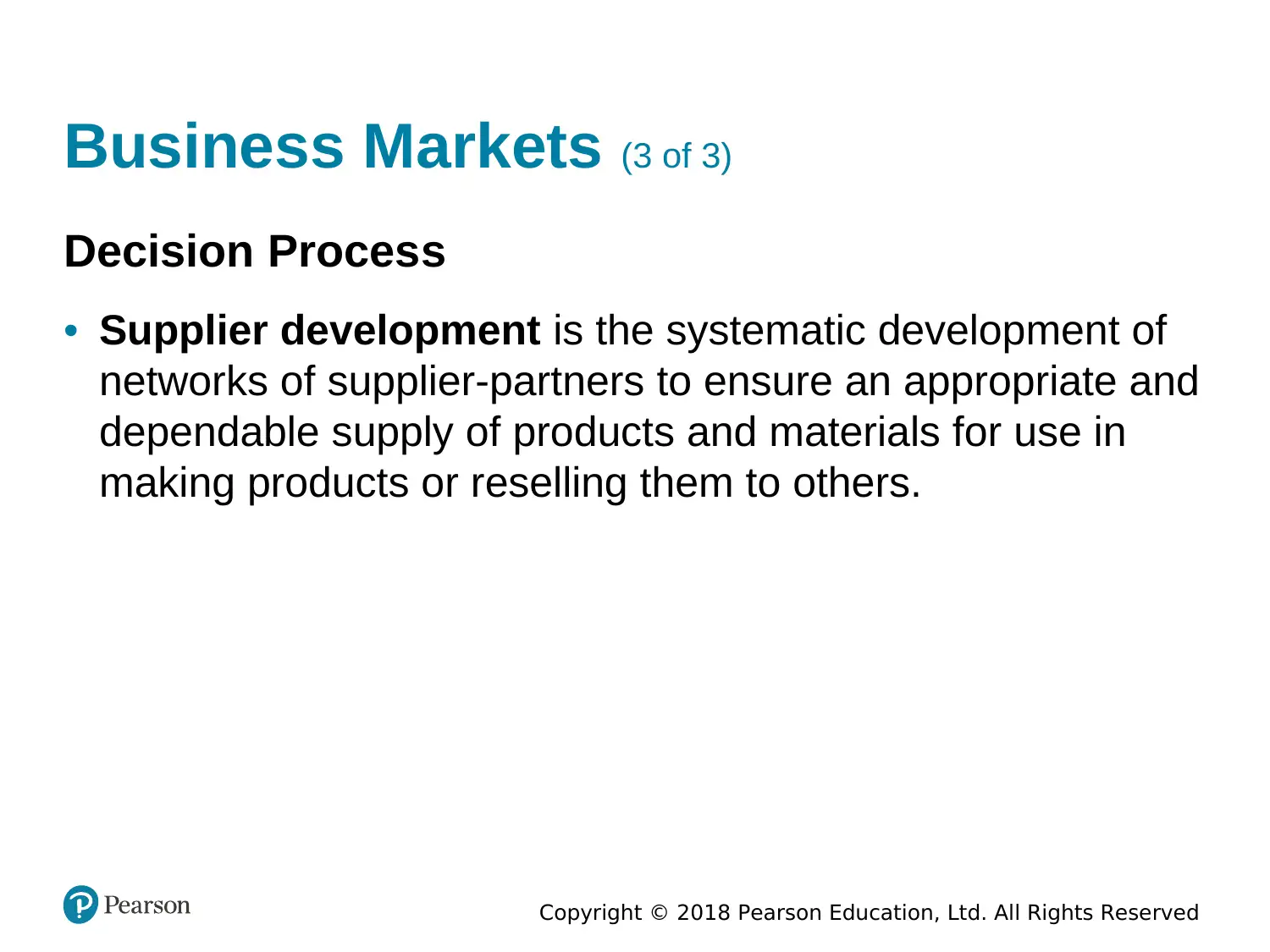
Copyright © 2018 Pearson Education, Ltd. All Rights Reserved
Business Markets (3 of 3)
Decision Process
• Supplier development is the systematic development of
networks of supplier-partners to ensure an appropriate and
dependable supply of products and materials for use in
making products or reselling them to others.
Business Markets (3 of 3)
Decision Process
• Supplier development is the systematic development of
networks of supplier-partners to ensure an appropriate and
dependable supply of products and materials for use in
making products or reselling them to others.
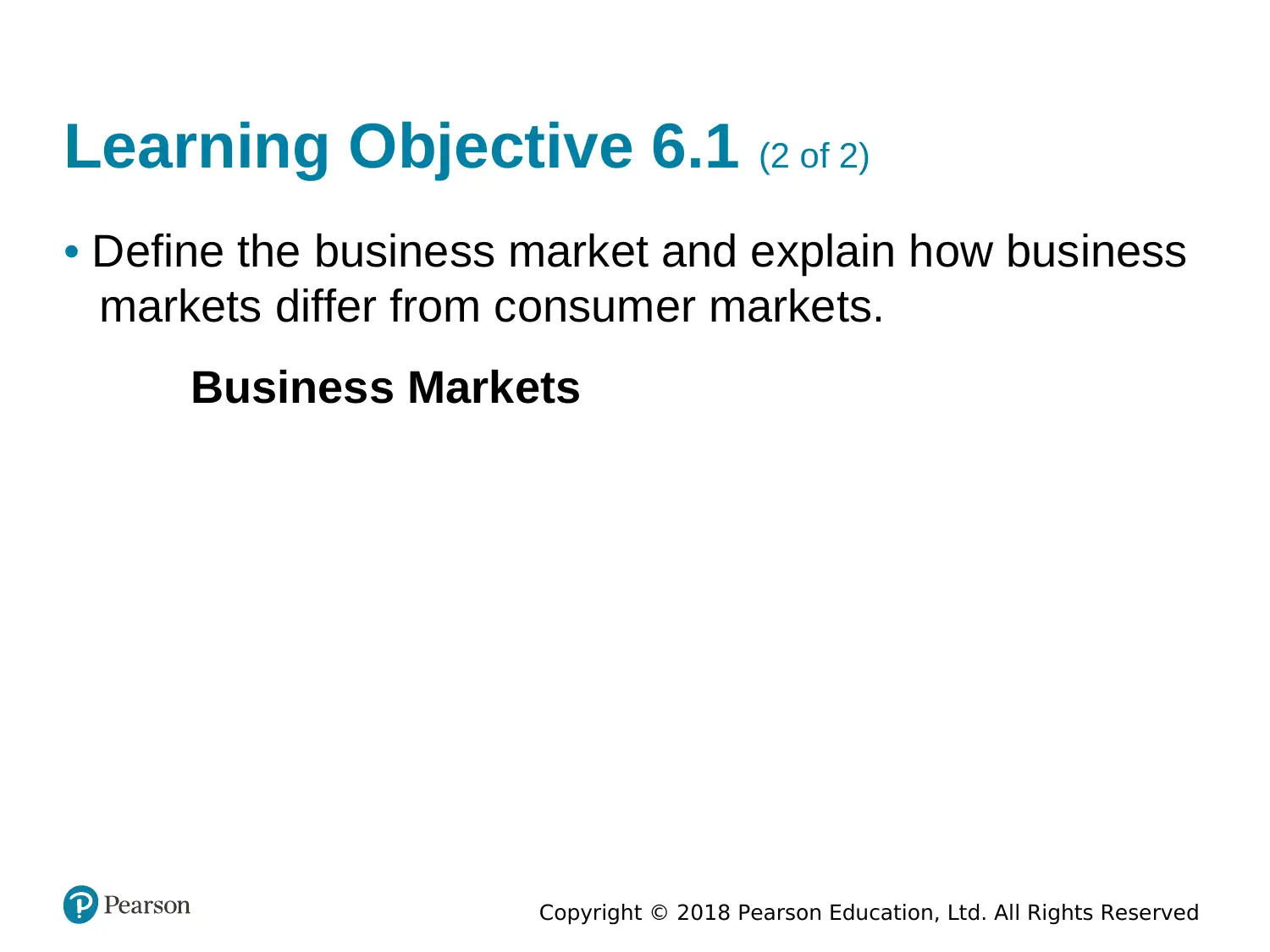
Copyright © 2018 Pearson Education, Ltd. All Rights Reserved
Learning Objective 6.1 (2 of 2)
• Define the business market and explain how business
markets differ from consumer markets.
Business Markets
Learning Objective 6.1 (2 of 2)
• Define the business market and explain how business
markets differ from consumer markets.
Business Markets
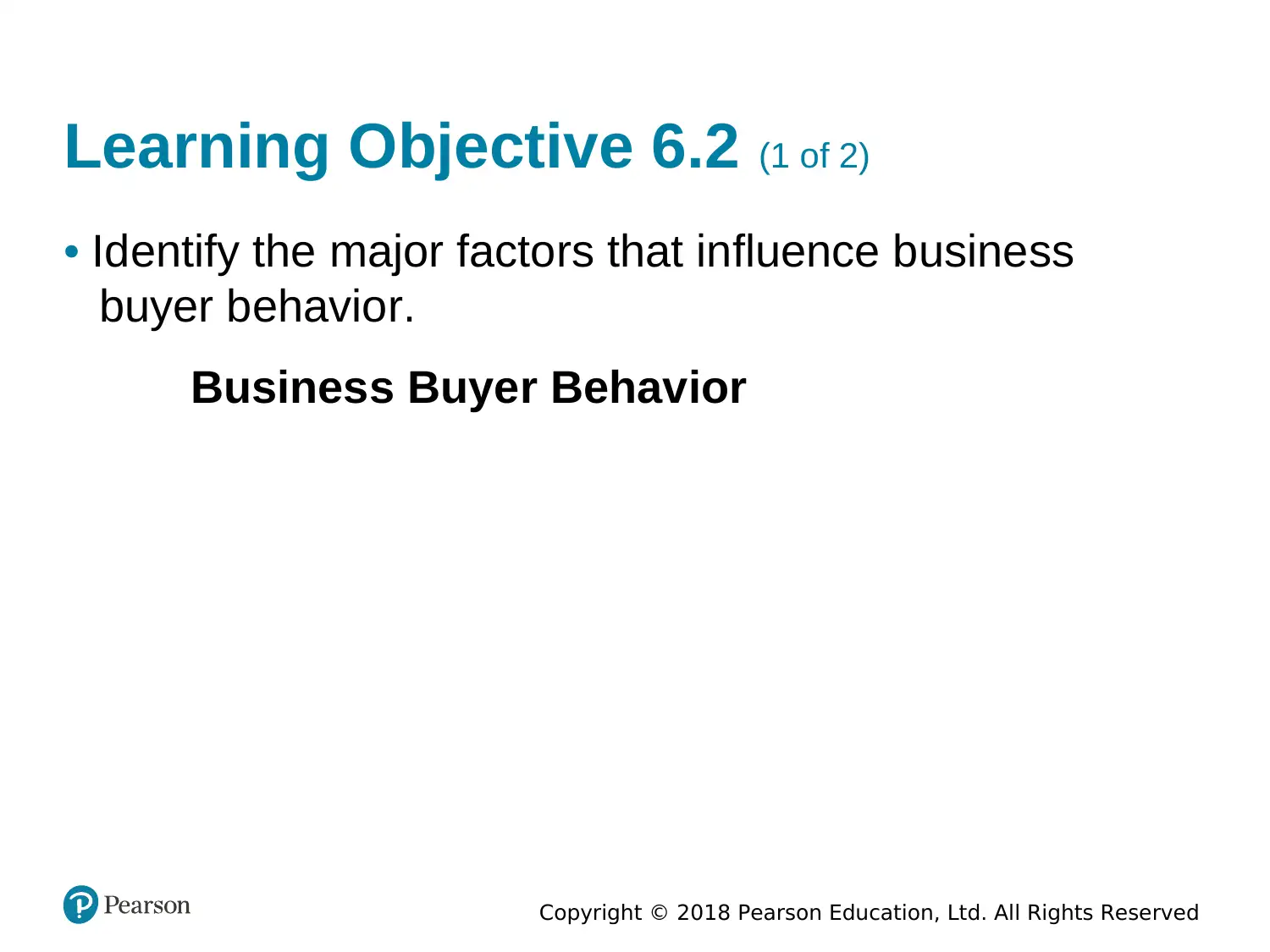
Copyright © 2018 Pearson Education, Ltd. All Rights Reserved
Learning Objective 6.2 (1 of 2)
• Identify the major factors that influence business
buyer behavior.
Business Buyer Behavior
Learning Objective 6.2 (1 of 2)
• Identify the major factors that influence business
buyer behavior.
Business Buyer Behavior
Secure Best Marks with AI Grader
Need help grading? Try our AI Grader for instant feedback on your assignments.
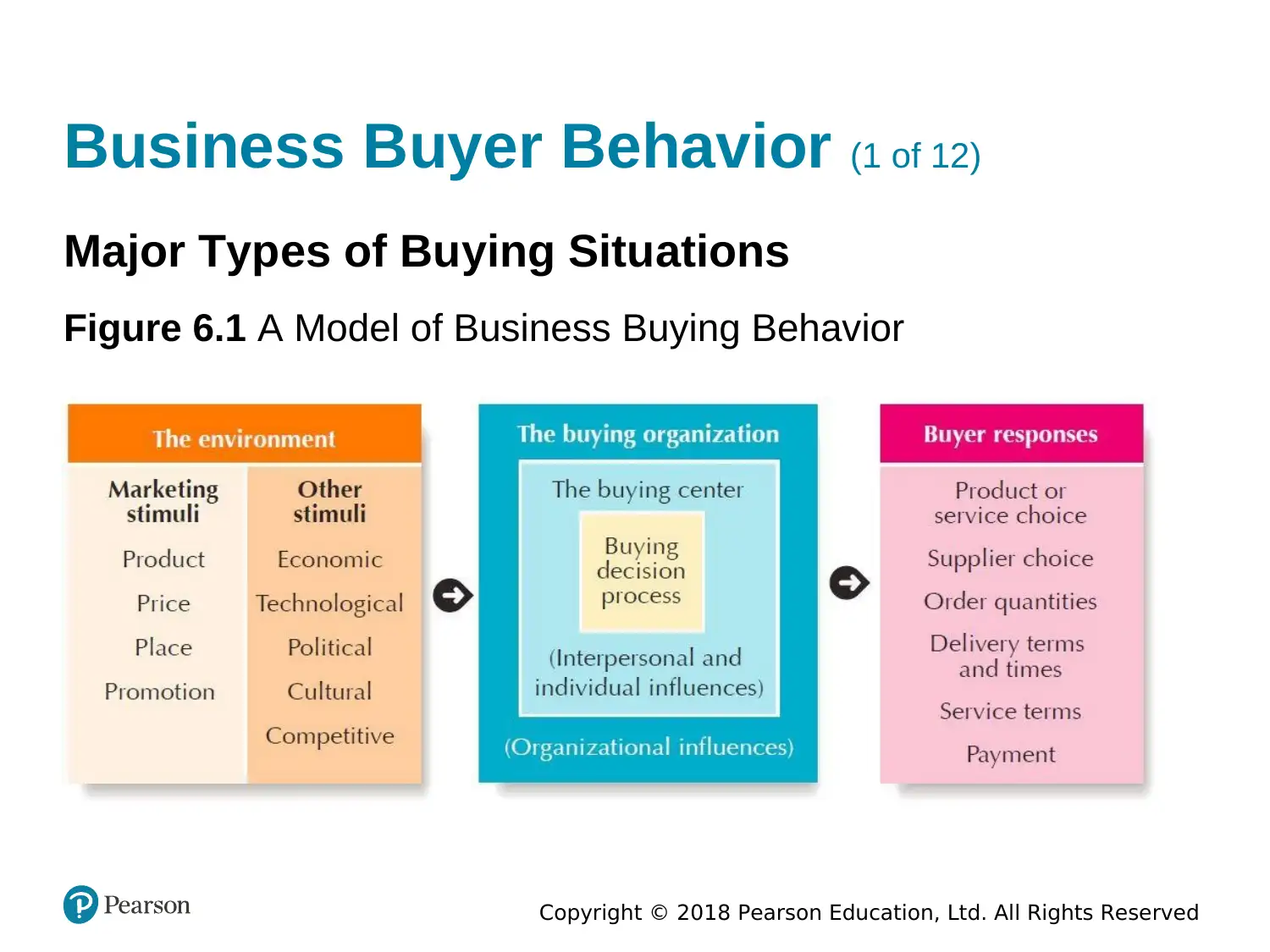
Copyright © 2018 Pearson Education, Ltd. All Rights Reserved
Business Buyer Behavior (1 of 12)
Major Types of Buying Situations
Figure 6.1 A Model of Business Buying Behavior
Business Buyer Behavior (1 of 12)
Major Types of Buying Situations
Figure 6.1 A Model of Business Buying Behavior
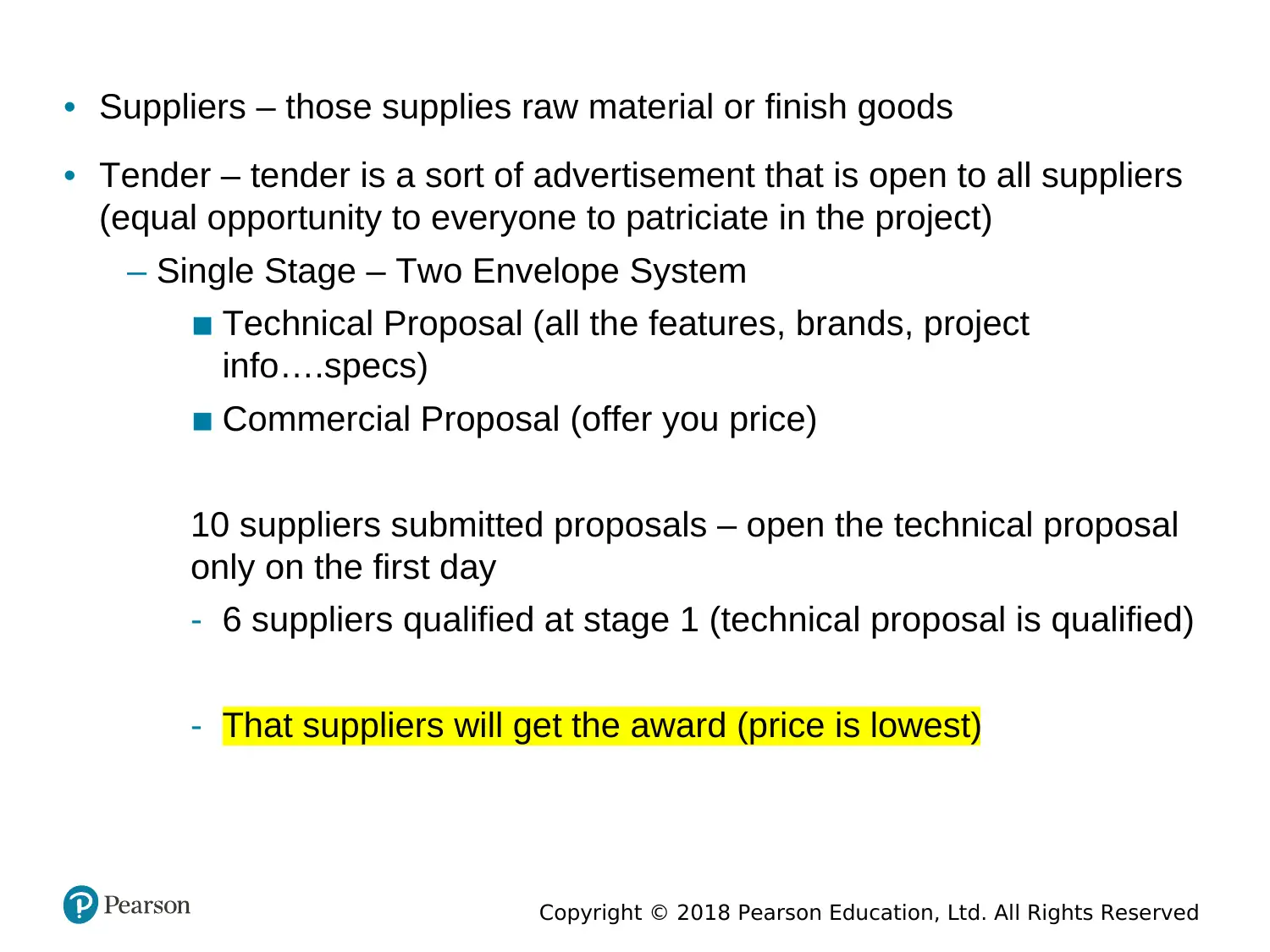
Copyright © 2018 Pearson Education, Ltd. All Rights Reserved
• Suppliers – those supplies raw material or finish goods
• Tender – tender is a sort of advertisement that is open to all suppliers
(equal opportunity to everyone to patriciate in the project)
– Single Stage – Two Envelope System
▪ Technical Proposal (all the features, brands, project
info….specs)
▪ Commercial Proposal (offer you price)
10 suppliers submitted proposals – open the technical proposal
only on the first day
- 6 suppliers qualified at stage 1 (technical proposal is qualified)
- That suppliers will get the award (price is lowest)
• Suppliers – those supplies raw material or finish goods
• Tender – tender is a sort of advertisement that is open to all suppliers
(equal opportunity to everyone to patriciate in the project)
– Single Stage – Two Envelope System
▪ Technical Proposal (all the features, brands, project
info….specs)
▪ Commercial Proposal (offer you price)
10 suppliers submitted proposals – open the technical proposal
only on the first day
- 6 suppliers qualified at stage 1 (technical proposal is qualified)
- That suppliers will get the award (price is lowest)
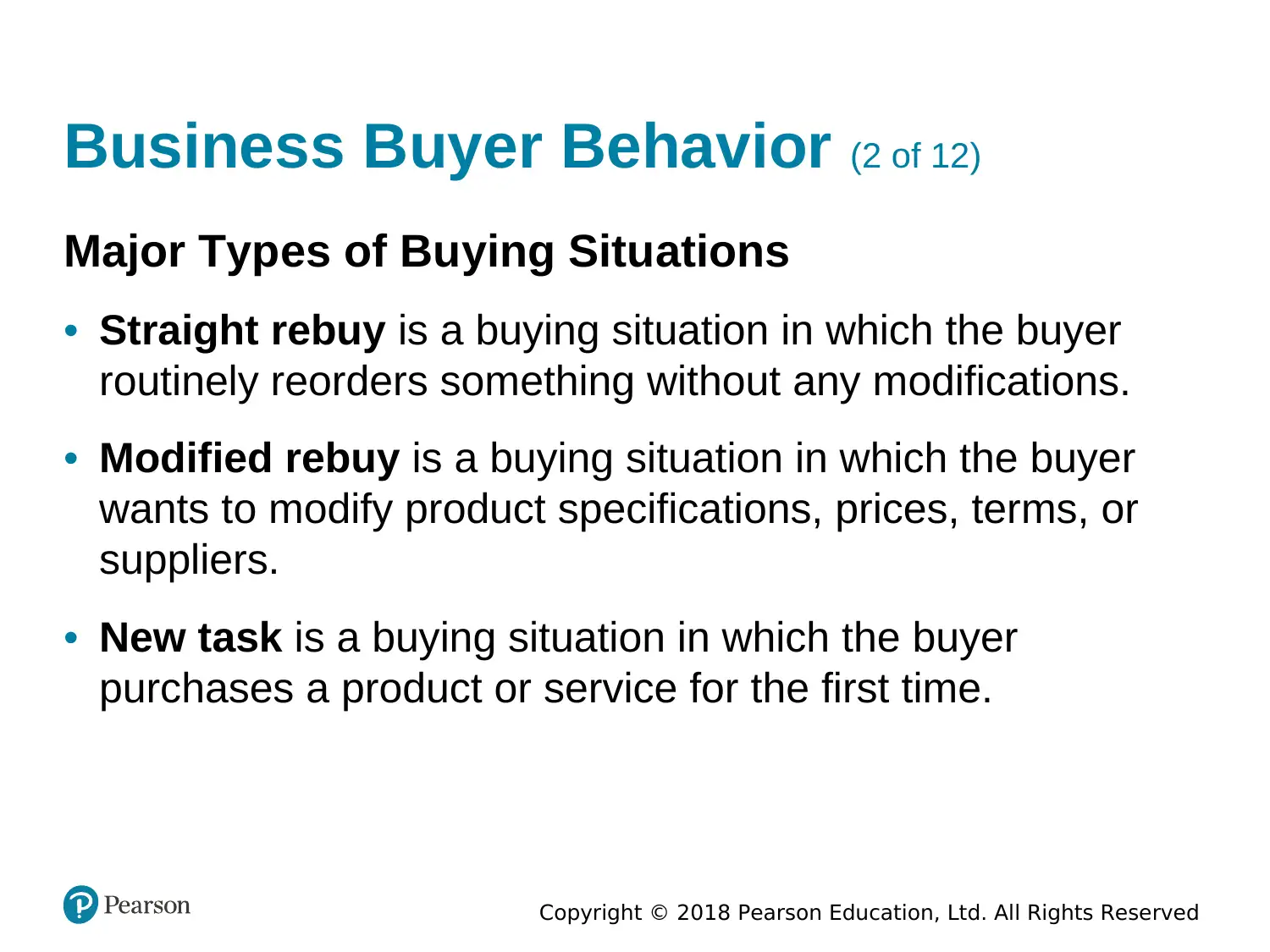
Copyright © 2018 Pearson Education, Ltd. All Rights Reserved
Business Buyer Behavior (2 of 12)
Major Types of Buying Situations
• Straight rebuy is a buying situation in which the buyer
routinely reorders something without any modifications.
• Modified rebuy is a buying situation in which the buyer
wants to modify product specifications, prices, terms, or
suppliers.
• New task is a buying situation in which the buyer
purchases a product or service for the first time.
Business Buyer Behavior (2 of 12)
Major Types of Buying Situations
• Straight rebuy is a buying situation in which the buyer
routinely reorders something without any modifications.
• Modified rebuy is a buying situation in which the buyer
wants to modify product specifications, prices, terms, or
suppliers.
• New task is a buying situation in which the buyer
purchases a product or service for the first time.
Paraphrase This Document
Need a fresh take? Get an instant paraphrase of this document with our AI Paraphraser
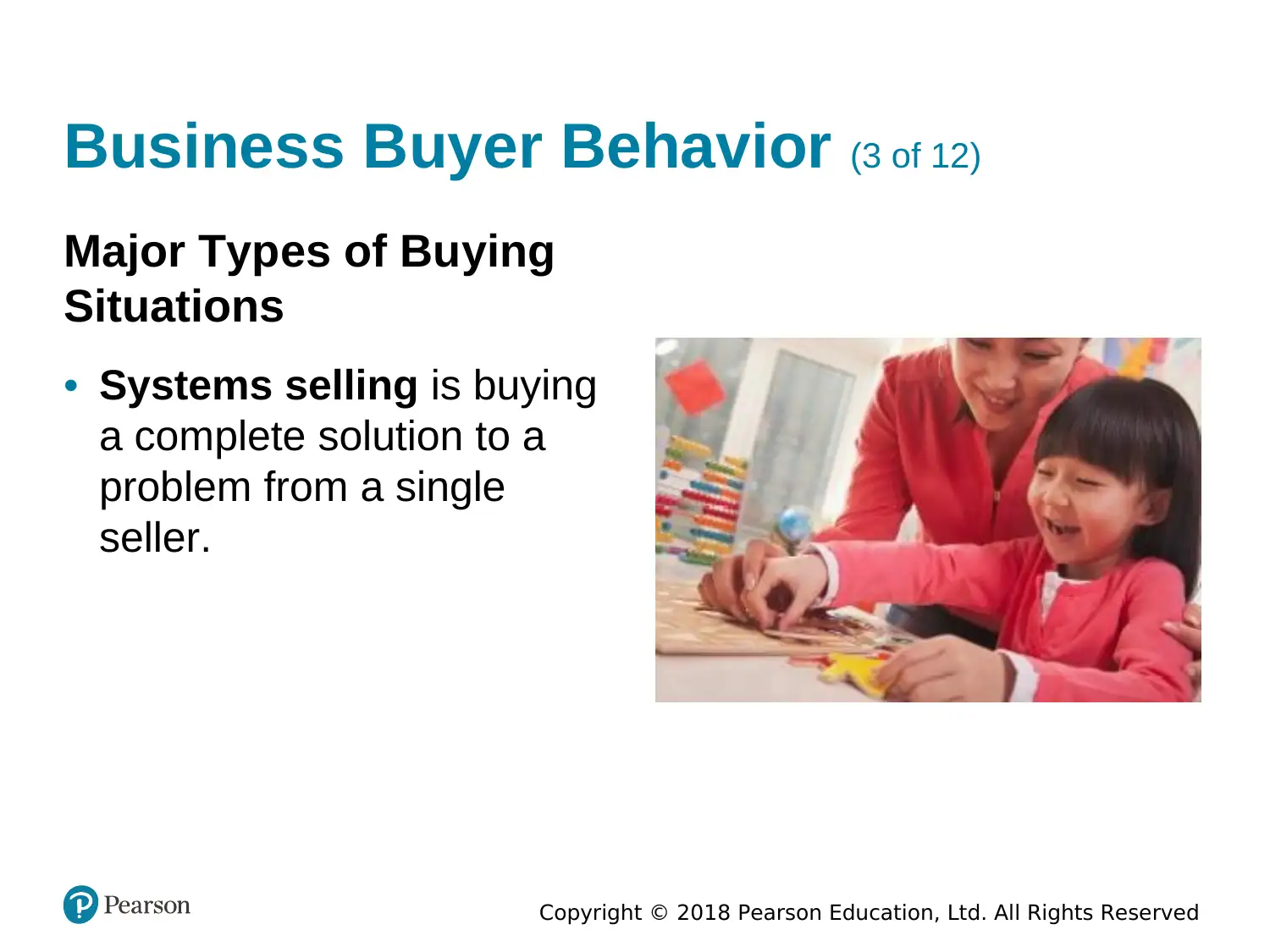
Copyright © 2018 Pearson Education, Ltd. All Rights Reserved
Business Buyer Behavior (3 of 12)
Major Types of Buying
Situations
• Systems selling is buying
a complete solution to a
problem from a single
seller.
Business Buyer Behavior (3 of 12)
Major Types of Buying
Situations
• Systems selling is buying
a complete solution to a
problem from a single
seller.
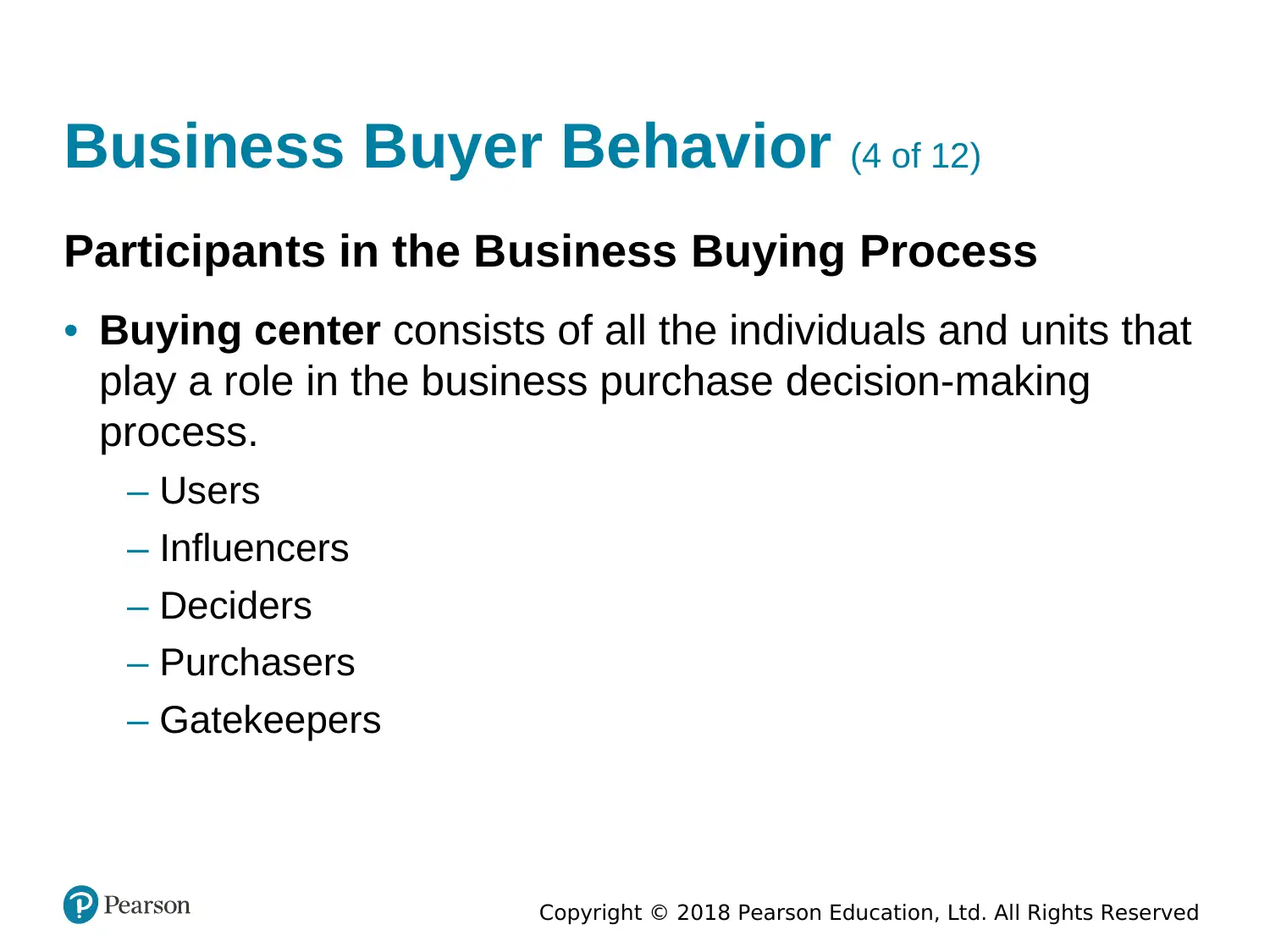
Copyright © 2018 Pearson Education, Ltd. All Rights Reserved
Business Buyer Behavior (4 of 12)
Participants in the Business Buying Process
• Buying center consists of all the individuals and units that
play a role in the business purchase decision-making
process.
‒ Users
‒ Influencers
‒ Deciders
‒ Purchasers
‒ Gatekeepers
Business Buyer Behavior (4 of 12)
Participants in the Business Buying Process
• Buying center consists of all the individuals and units that
play a role in the business purchase decision-making
process.
‒ Users
‒ Influencers
‒ Deciders
‒ Purchasers
‒ Gatekeepers
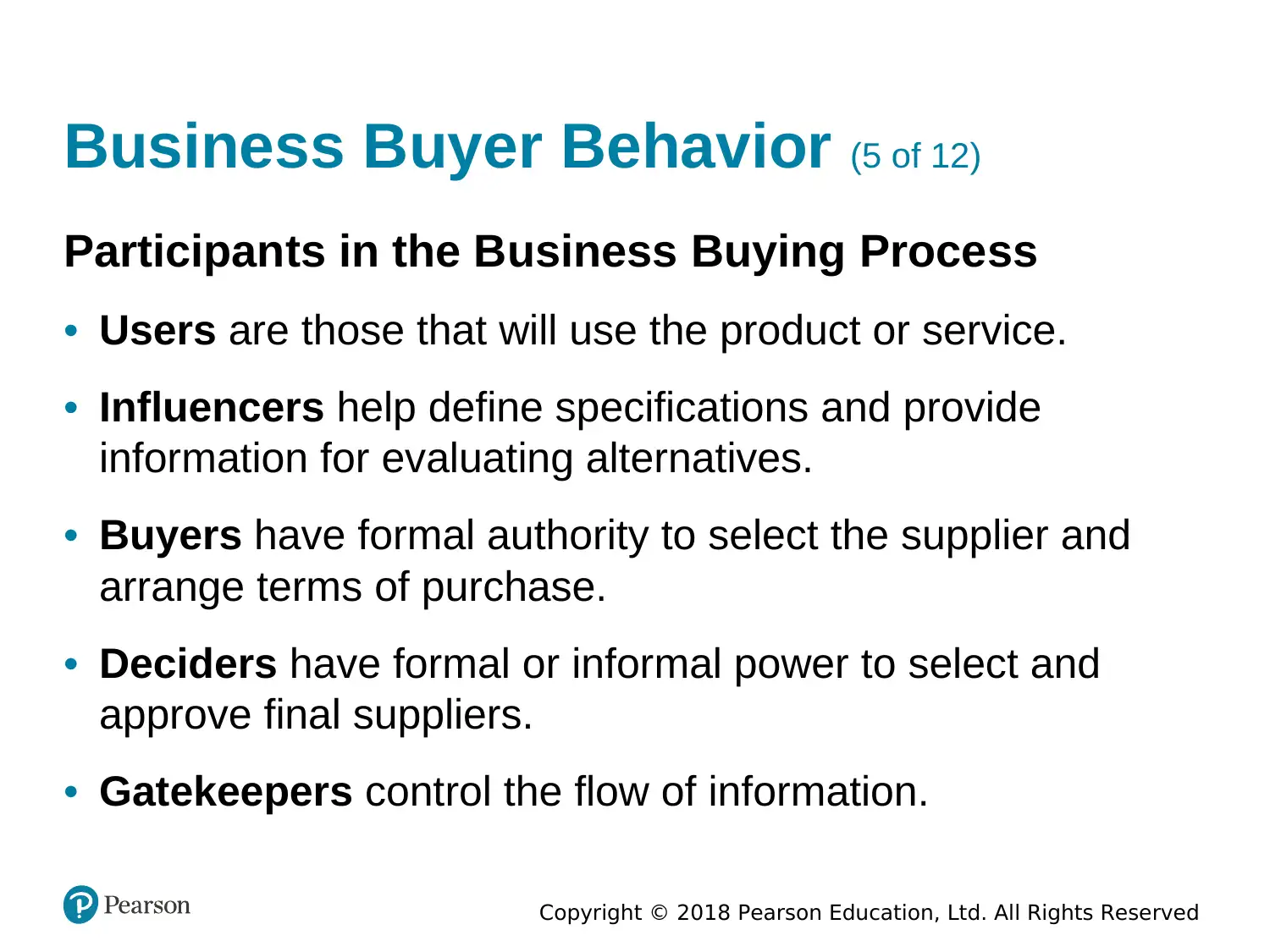
Copyright © 2018 Pearson Education, Ltd. All Rights Reserved
Business Buyer Behavior (5 of 12)
Participants in the Business Buying Process
• Users are those that will use the product or service.
• Influencers help define specifications and provide
information for evaluating alternatives.
• Buyers have formal authority to select the supplier and
arrange terms of purchase.
• Deciders have formal or informal power to select and
approve final suppliers.
• Gatekeepers control the flow of information.
Business Buyer Behavior (5 of 12)
Participants in the Business Buying Process
• Users are those that will use the product or service.
• Influencers help define specifications and provide
information for evaluating alternatives.
• Buyers have formal authority to select the supplier and
arrange terms of purchase.
• Deciders have formal or informal power to select and
approve final suppliers.
• Gatekeepers control the flow of information.
Secure Best Marks with AI Grader
Need help grading? Try our AI Grader for instant feedback on your assignments.
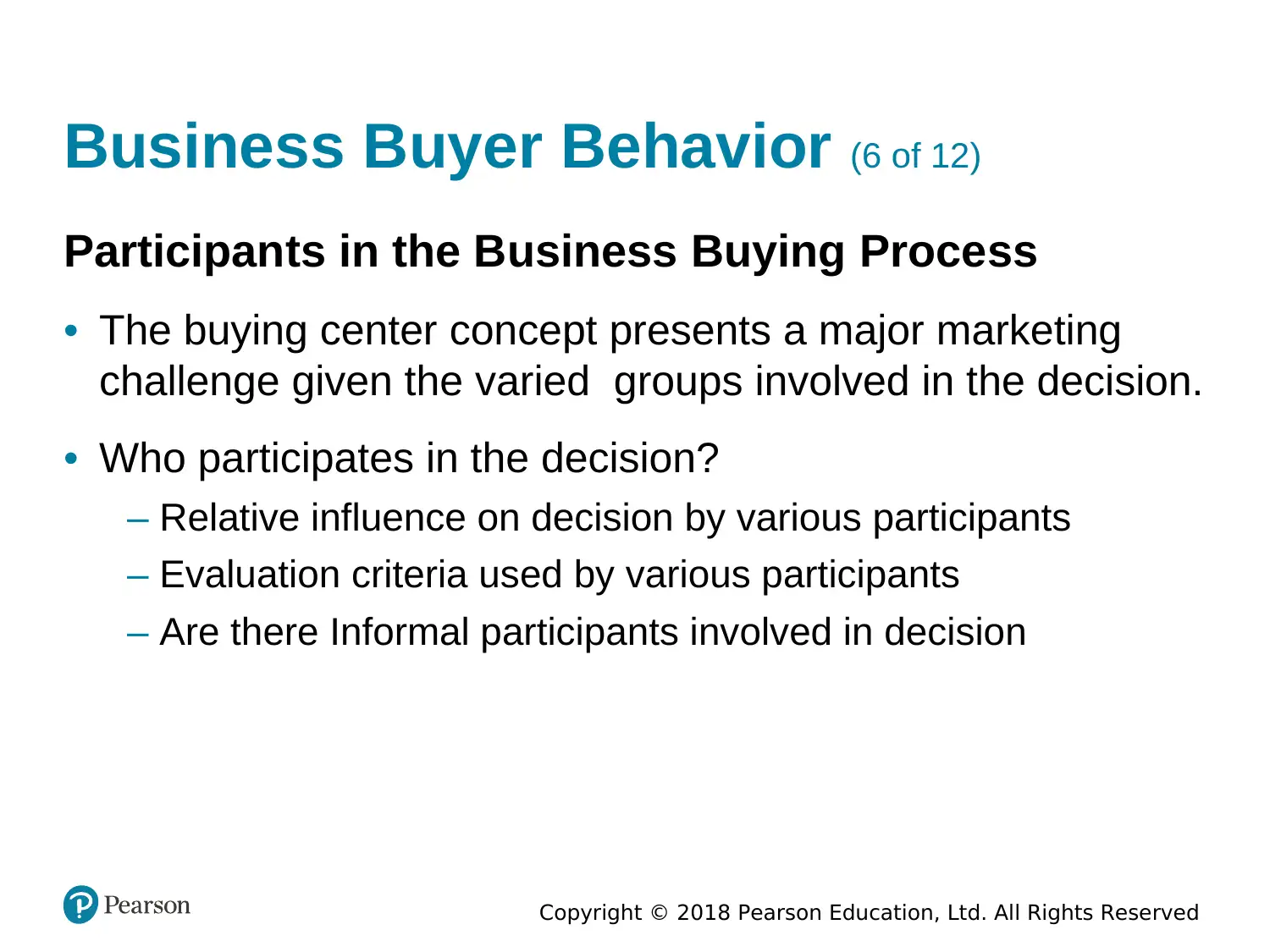
Copyright © 2018 Pearson Education, Ltd. All Rights Reserved
Business Buyer Behavior (6 of 12)
Participants in the Business Buying Process
• The buying center concept presents a major marketing
challenge given the varied groups involved in the decision.
• Who participates in the decision?
– Relative influence on decision by various participants
– Evaluation criteria used by various participants
– Are there Informal participants involved in decision
Business Buyer Behavior (6 of 12)
Participants in the Business Buying Process
• The buying center concept presents a major marketing
challenge given the varied groups involved in the decision.
• Who participates in the decision?
– Relative influence on decision by various participants
– Evaluation criteria used by various participants
– Are there Informal participants involved in decision
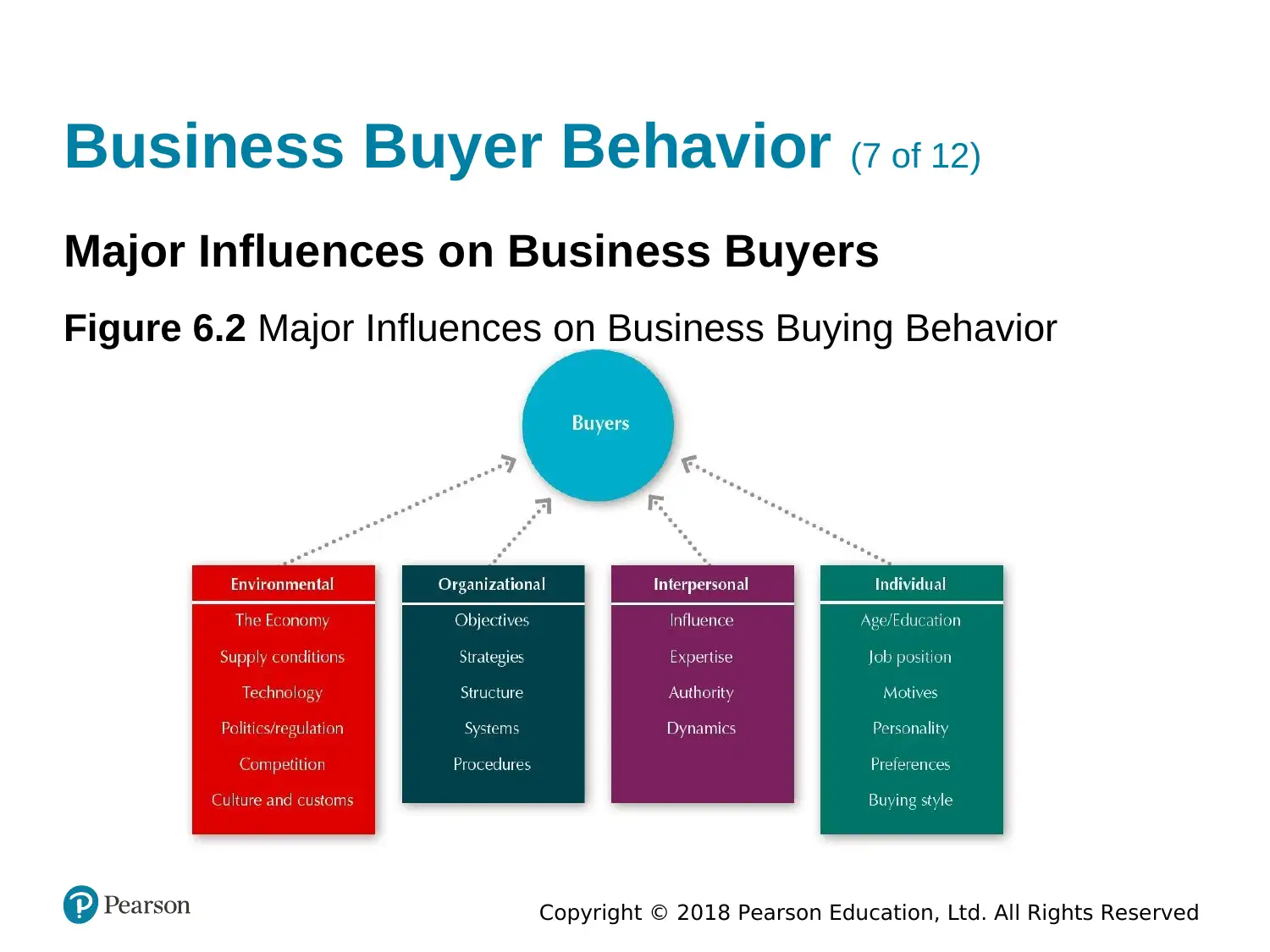
Copyright © 2018 Pearson Education, Ltd. All Rights Reserved
Business Buyer Behavior (7 of 12)
Major Influences on Business Buyers
Figure 6.2 Major Influences on Business Buying Behavior
Business Buyer Behavior (7 of 12)
Major Influences on Business Buyers
Figure 6.2 Major Influences on Business Buying Behavior
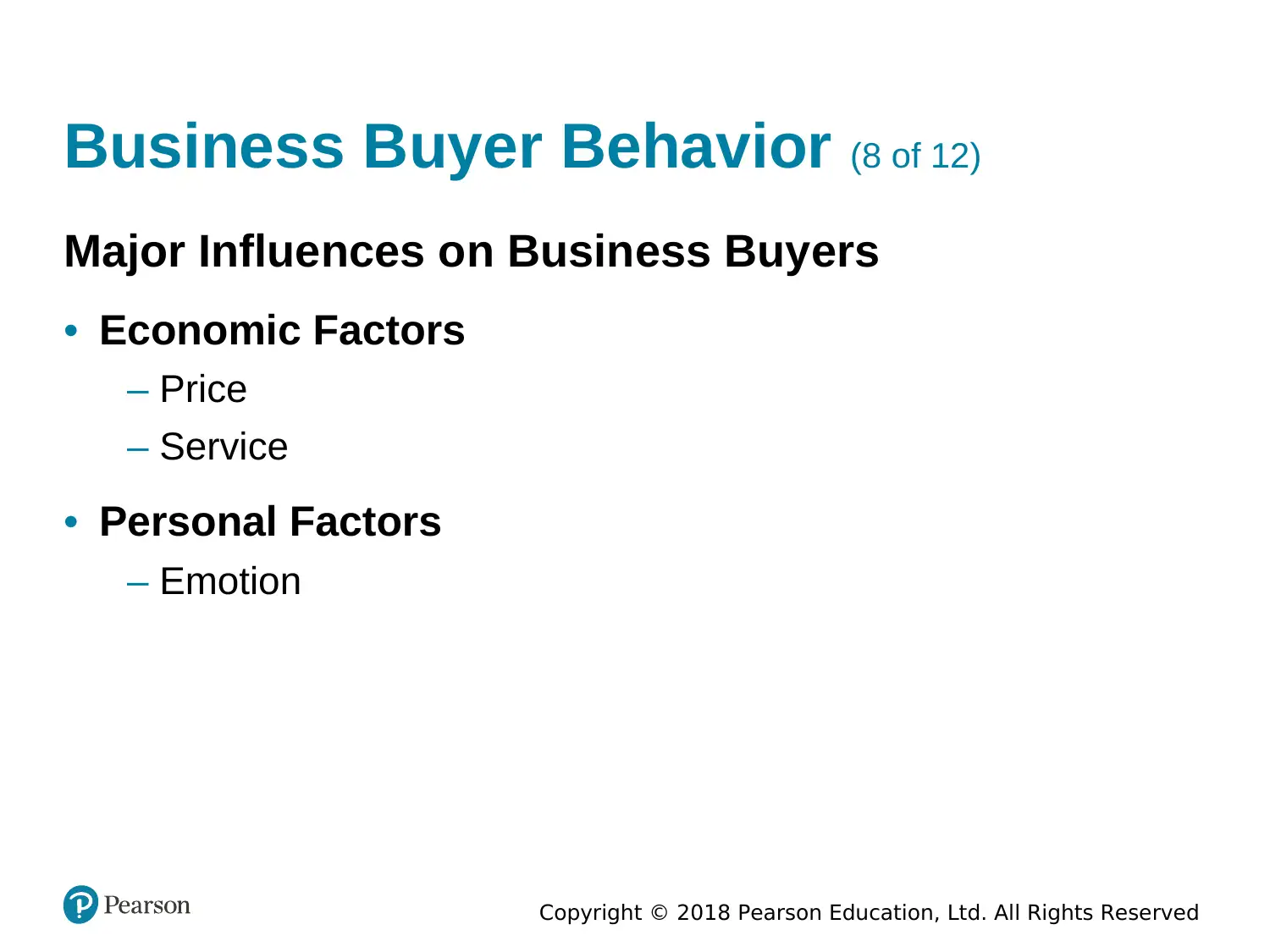
Copyright © 2018 Pearson Education, Ltd. All Rights Reserved
Business Buyer Behavior (8 of 12)
Major Influences on Business Buyers
• Economic Factors
– Price
– Service
• Personal Factors
– Emotion
Business Buyer Behavior (8 of 12)
Major Influences on Business Buyers
• Economic Factors
– Price
– Service
• Personal Factors
– Emotion
Paraphrase This Document
Need a fresh take? Get an instant paraphrase of this document with our AI Paraphraser
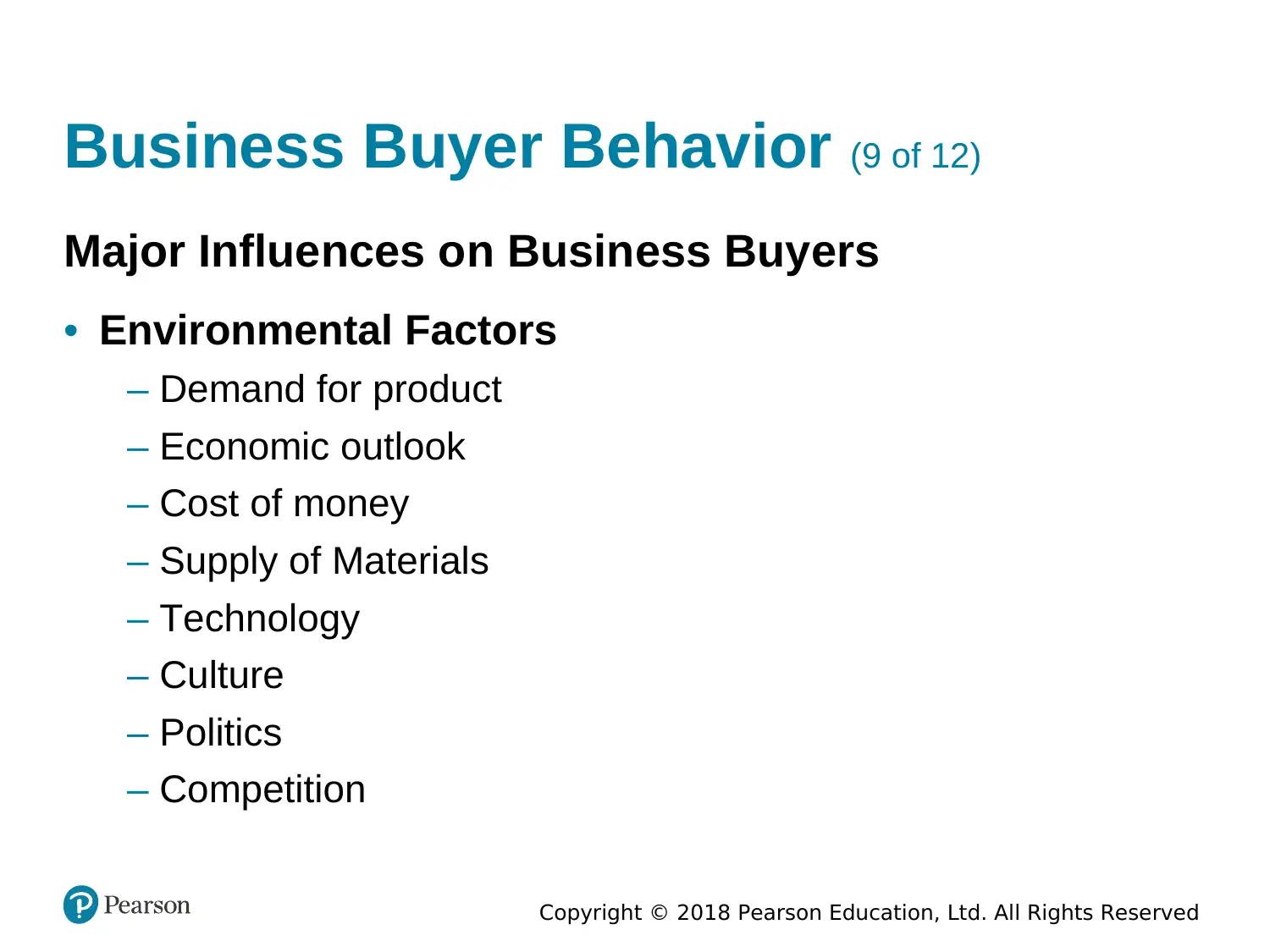
Copyright © 2018 Pearson Education, Ltd. All Rights Reserved
Business Buyer Behavior (9 of 12)
Major Influences on Business Buyers
• Environmental Factors
– Demand for product
– Economic outlook
– Cost of money
– Supply of Materials
– Technology
– Culture
– Politics
– Competition
Business Buyer Behavior (9 of 12)
Major Influences on Business Buyers
• Environmental Factors
– Demand for product
– Economic outlook
– Cost of money
– Supply of Materials
– Technology
– Culture
– Politics
– Competition
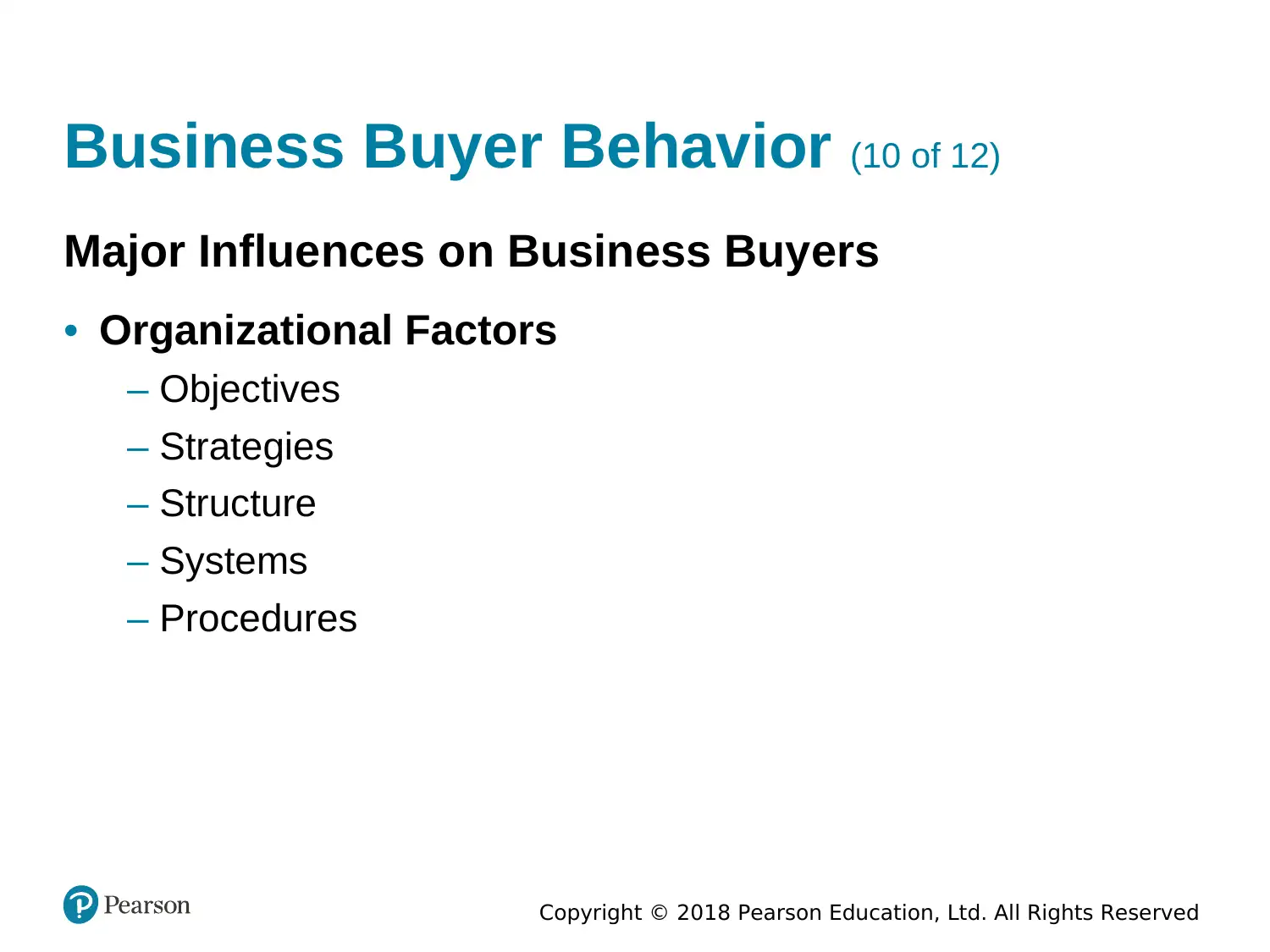
Copyright © 2018 Pearson Education, Ltd. All Rights Reserved
Business Buyer Behavior (10 of 12)
Major Influences on Business Buyers
• Organizational Factors
– Objectives
– Strategies
– Structure
– Systems
– Procedures
Business Buyer Behavior (10 of 12)
Major Influences on Business Buyers
• Organizational Factors
– Objectives
– Strategies
– Structure
– Systems
– Procedures
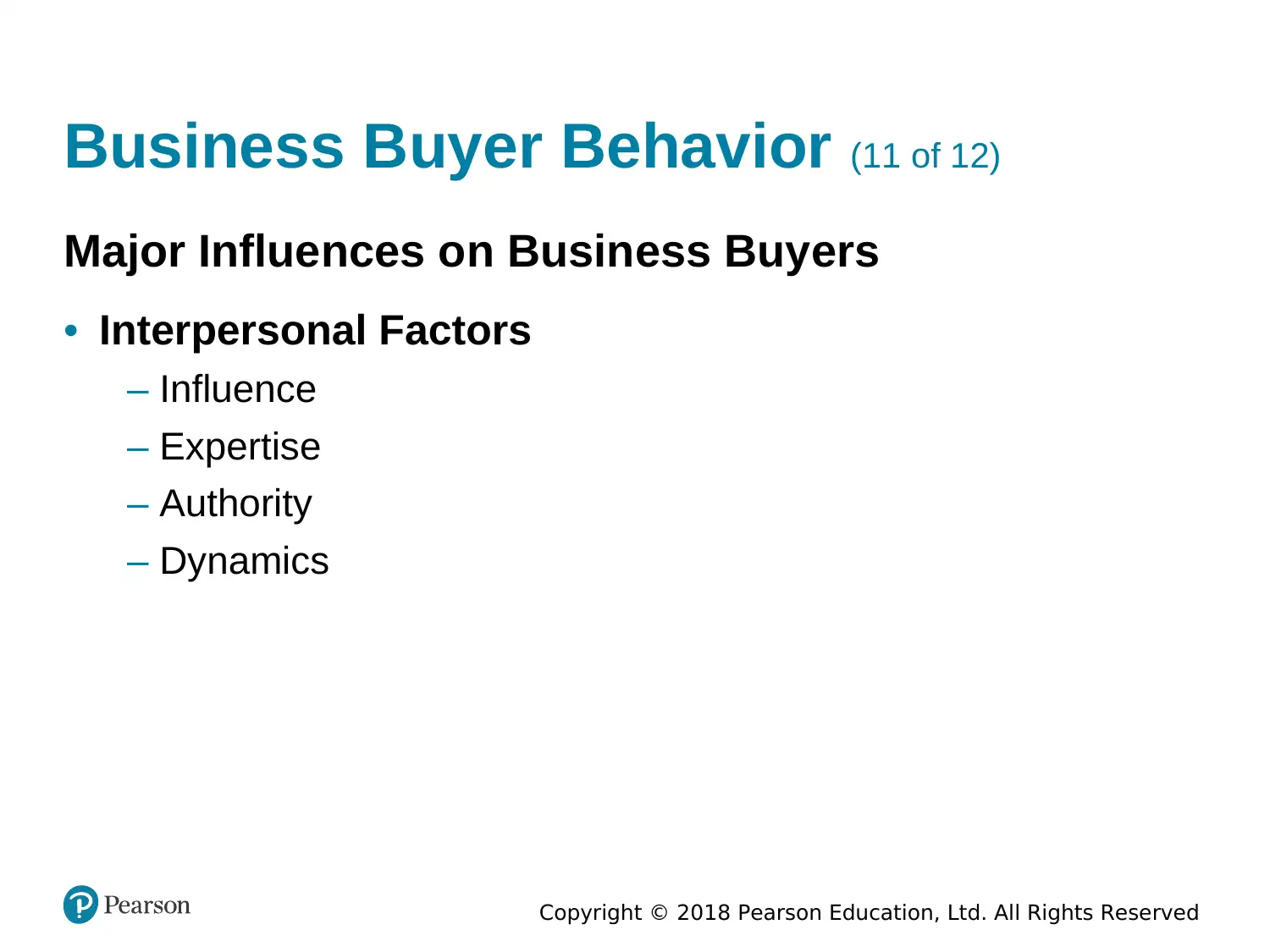
Copyright © 2018 Pearson Education, Ltd. All Rights Reserved
Business Buyer Behavior (11 of 12)
Major Influences on Business Buyers
• Interpersonal Factors
– Influence
– Expertise
– Authority
– Dynamics
Business Buyer Behavior (11 of 12)
Major Influences on Business Buyers
• Interpersonal Factors
– Influence
– Expertise
– Authority
– Dynamics
Secure Best Marks with AI Grader
Need help grading? Try our AI Grader for instant feedback on your assignments.
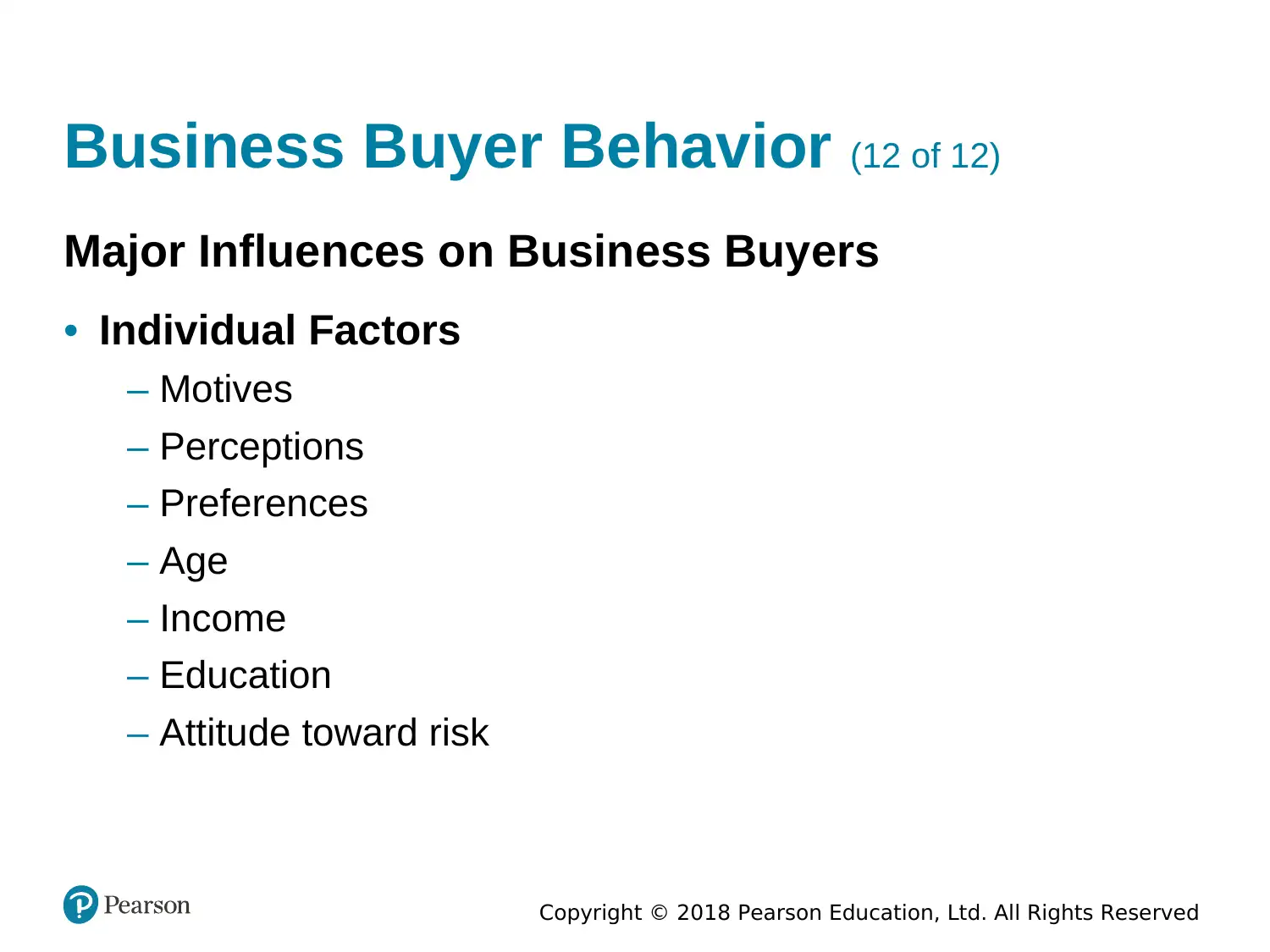
Copyright © 2018 Pearson Education, Ltd. All Rights Reserved
Business Buyer Behavior (12 of 12)
Major Influences on Business Buyers
• Individual Factors
– Motives
– Perceptions
– Preferences
– Age
– Income
– Education
– Attitude toward risk
Business Buyer Behavior (12 of 12)
Major Influences on Business Buyers
• Individual Factors
– Motives
– Perceptions
– Preferences
– Age
– Income
– Education
– Attitude toward risk
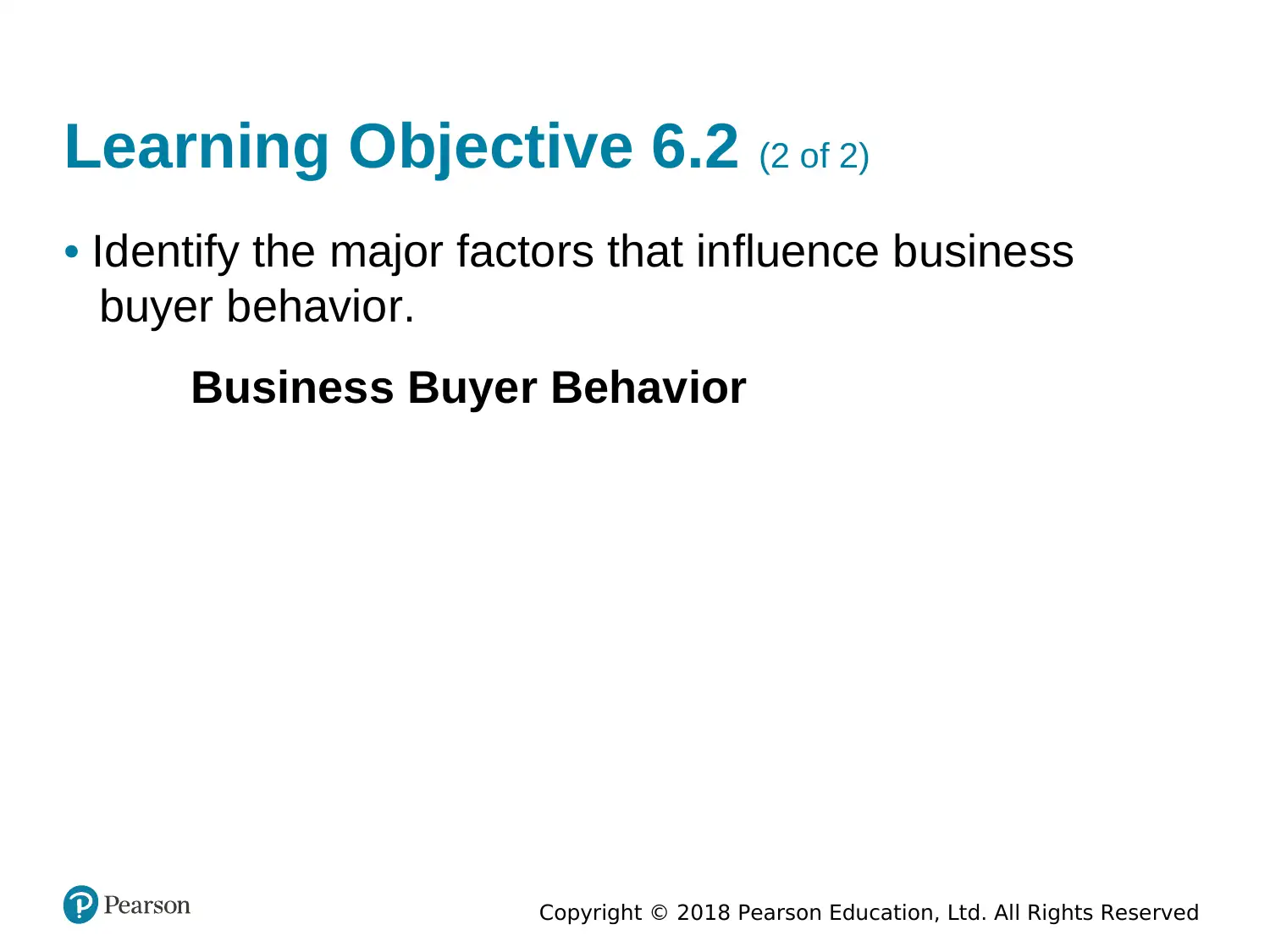
Copyright © 2018 Pearson Education, Ltd. All Rights Reserved
Learning Objective 6.2 (2 of 2)
• Identify the major factors that influence business
buyer behavior.
Business Buyer Behavior
Learning Objective 6.2 (2 of 2)
• Identify the major factors that influence business
buyer behavior.
Business Buyer Behavior
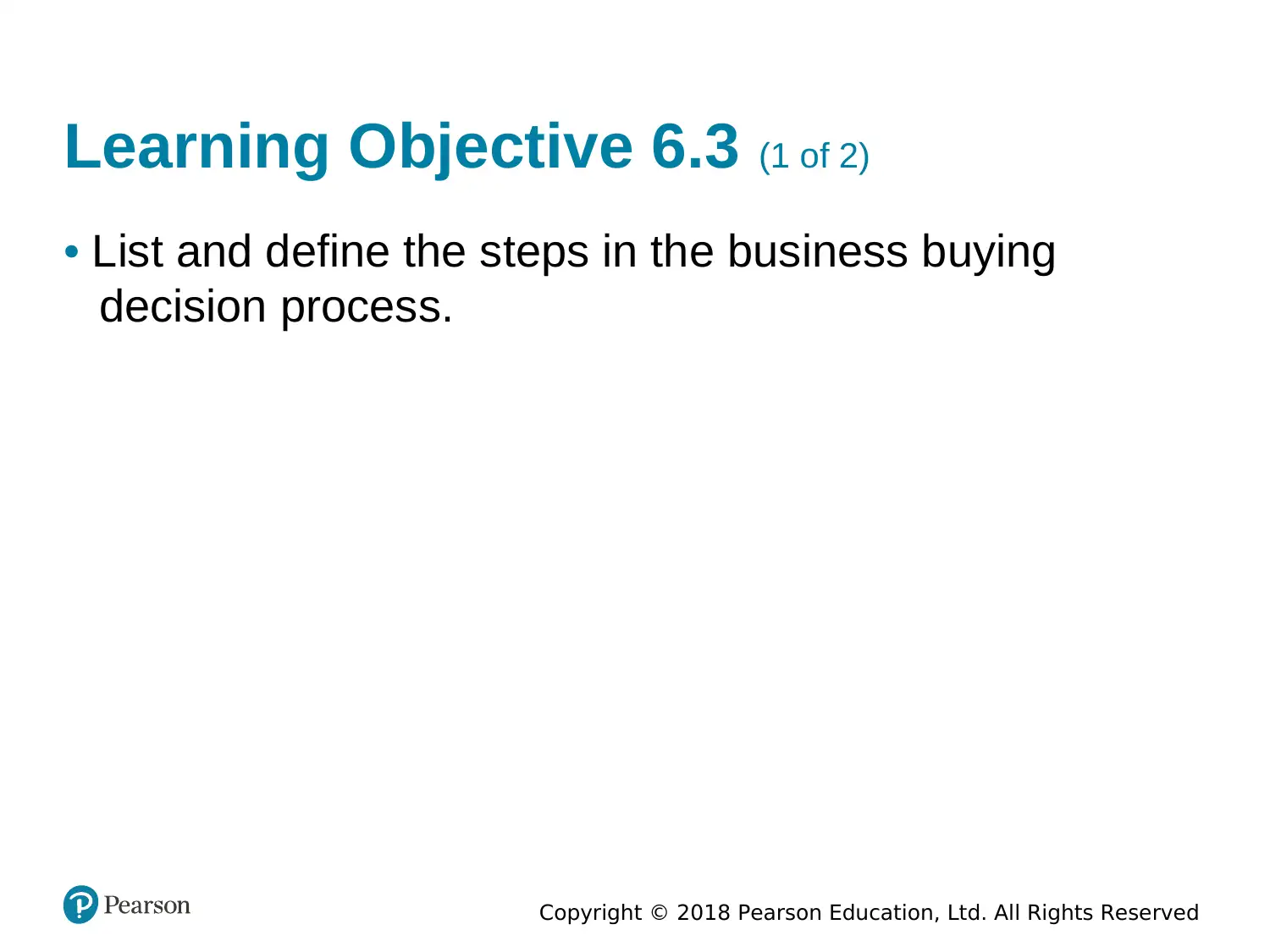
Copyright © 2018 Pearson Education, Ltd. All Rights Reserved
Learning Objective 6.3 (1 of 2)
• List and define the steps in the business buying
decision process.
Learning Objective 6.3 (1 of 2)
• List and define the steps in the business buying
decision process.
Paraphrase This Document
Need a fresh take? Get an instant paraphrase of this document with our AI Paraphraser
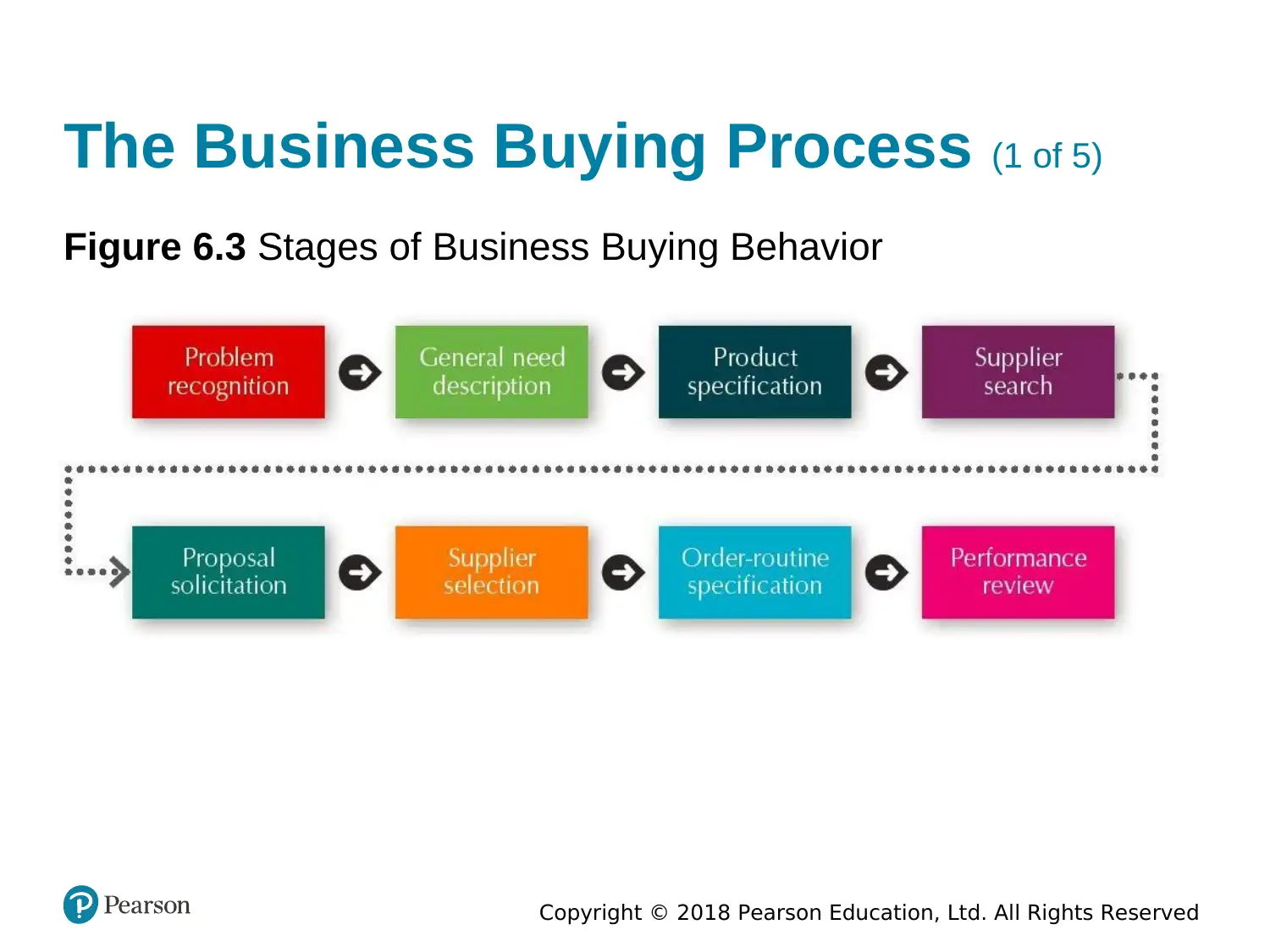
Copyright © 2018 Pearson Education, Ltd. All Rights Reserved
The Business Buying Process (1 of 5)
Figure 6.3 Stages of Business Buying Behavior
The Business Buying Process (1 of 5)
Figure 6.3 Stages of Business Buying Behavior
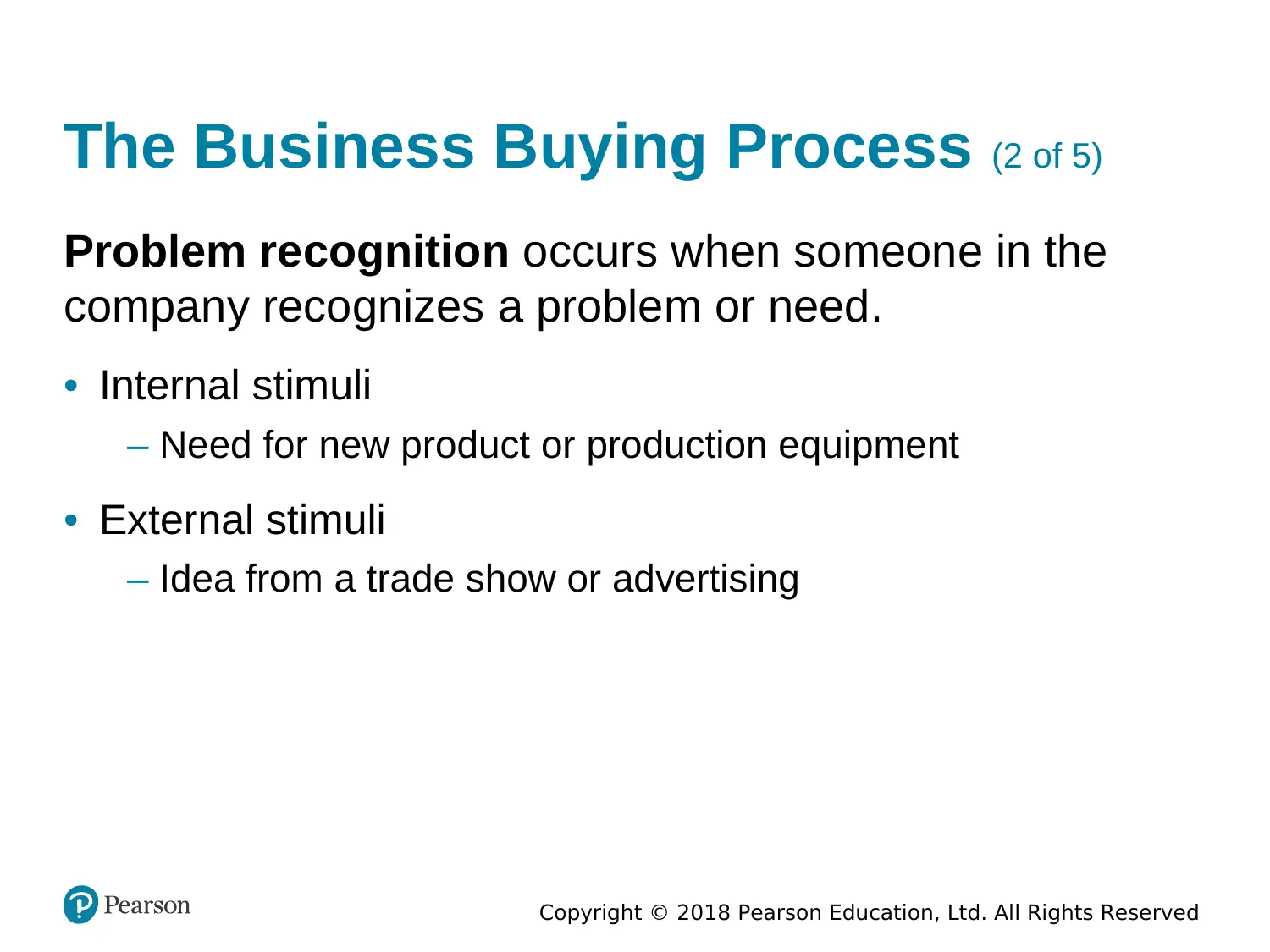
Copyright © 2018 Pearson Education, Ltd. All Rights Reserved
The Business Buying Process (2 of 5)
Problem recognition occurs when someone in the
company recognizes a problem or need.
• Internal stimuli
– Need for new product or production equipment
• External stimuli
– Idea from a trade show or advertising
The Business Buying Process (2 of 5)
Problem recognition occurs when someone in the
company recognizes a problem or need.
• Internal stimuli
– Need for new product or production equipment
• External stimuli
– Idea from a trade show or advertising
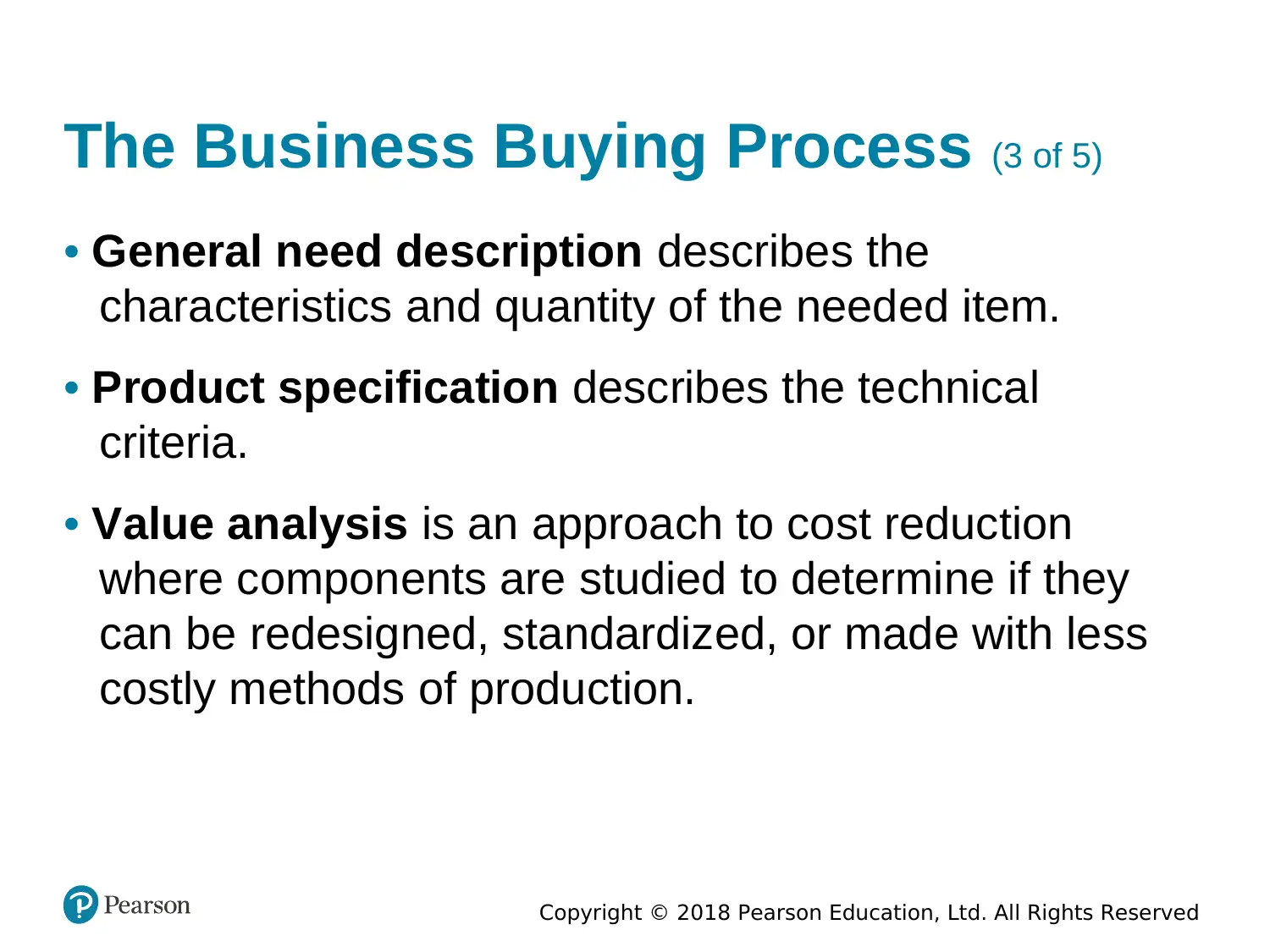
Copyright © 2018 Pearson Education, Ltd. All Rights Reserved
The Business Buying Process (3 of 5)
• General need description describes the
characteristics and quantity of the needed item.
• Product specification describes the technical
criteria.
• Value analysis is an approach to cost reduction
where components are studied to determine if they
can be redesigned, standardized, or made with less
costly methods of production.
The Business Buying Process (3 of 5)
• General need description describes the
characteristics and quantity of the needed item.
• Product specification describes the technical
criteria.
• Value analysis is an approach to cost reduction
where components are studied to determine if they
can be redesigned, standardized, or made with less
costly methods of production.
Secure Best Marks with AI Grader
Need help grading? Try our AI Grader for instant feedback on your assignments.
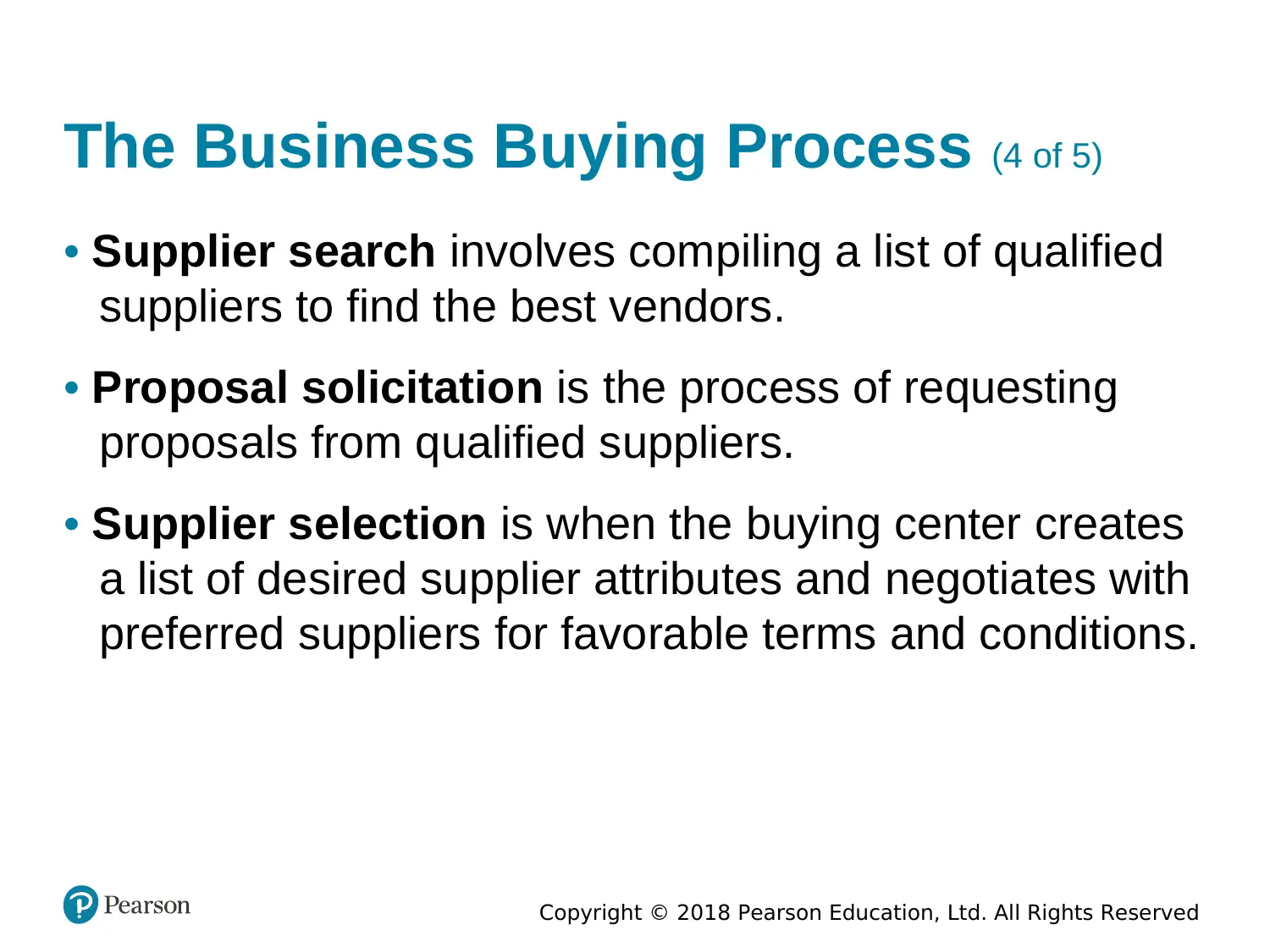
Copyright © 2018 Pearson Education, Ltd. All Rights Reserved
The Business Buying Process (4 of 5)
• Supplier search involves compiling a list of qualified
suppliers to find the best vendors.
• Proposal solicitation is the process of requesting
proposals from qualified suppliers.
• Supplier selection is when the buying center creates
a list of desired supplier attributes and negotiates with
preferred suppliers for favorable terms and conditions.
The Business Buying Process (4 of 5)
• Supplier search involves compiling a list of qualified
suppliers to find the best vendors.
• Proposal solicitation is the process of requesting
proposals from qualified suppliers.
• Supplier selection is when the buying center creates
a list of desired supplier attributes and negotiates with
preferred suppliers for favorable terms and conditions.
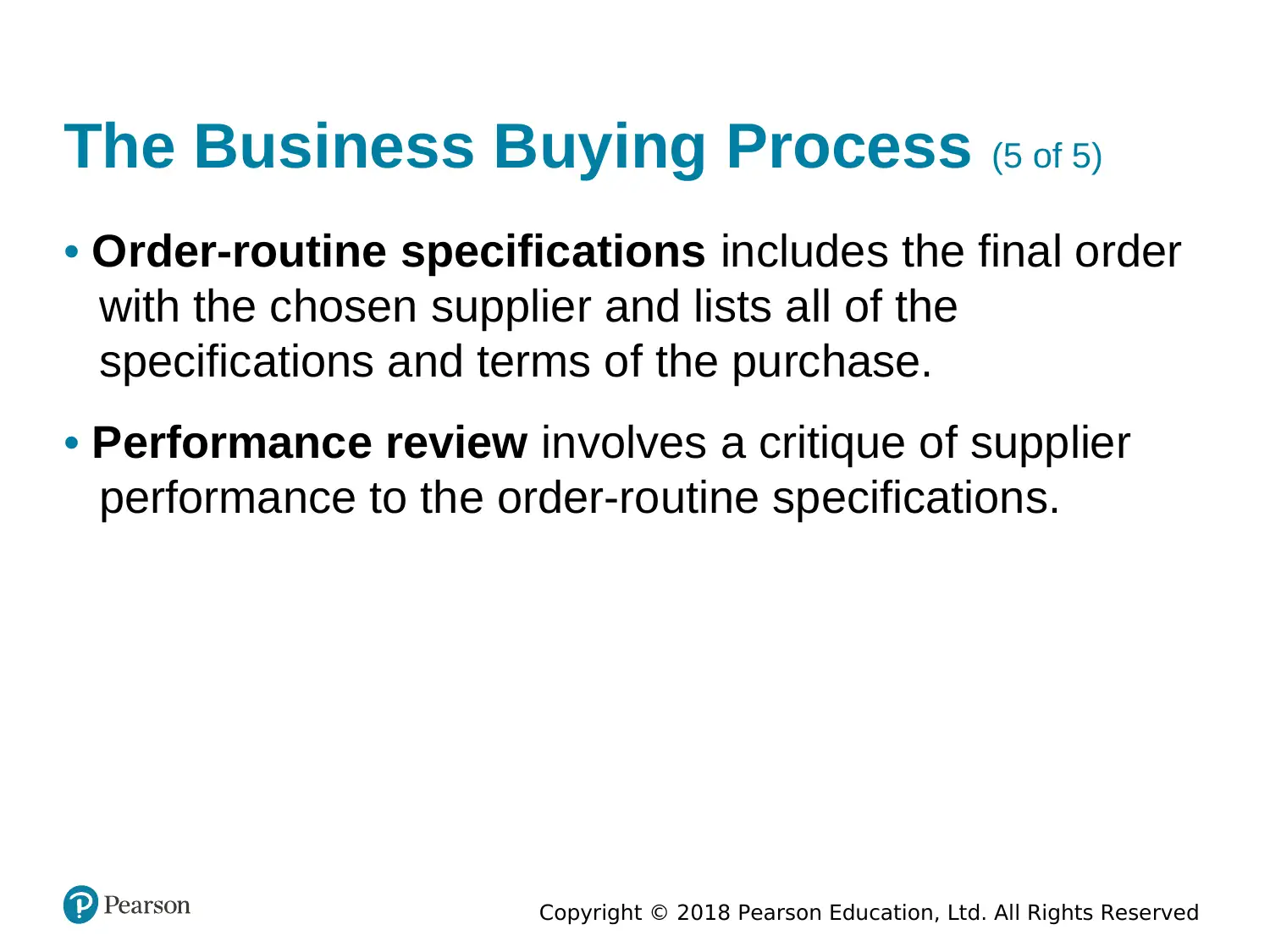
Copyright © 2018 Pearson Education, Ltd. All Rights Reserved
The Business Buying Process (5 of 5)
• Order-routine specifications includes the final order
with the chosen supplier and lists all of the
specifications and terms of the purchase.
• Performance review involves a critique of supplier
performance to the order-routine specifications.
The Business Buying Process (5 of 5)
• Order-routine specifications includes the final order
with the chosen supplier and lists all of the
specifications and terms of the purchase.
• Performance review involves a critique of supplier
performance to the order-routine specifications.
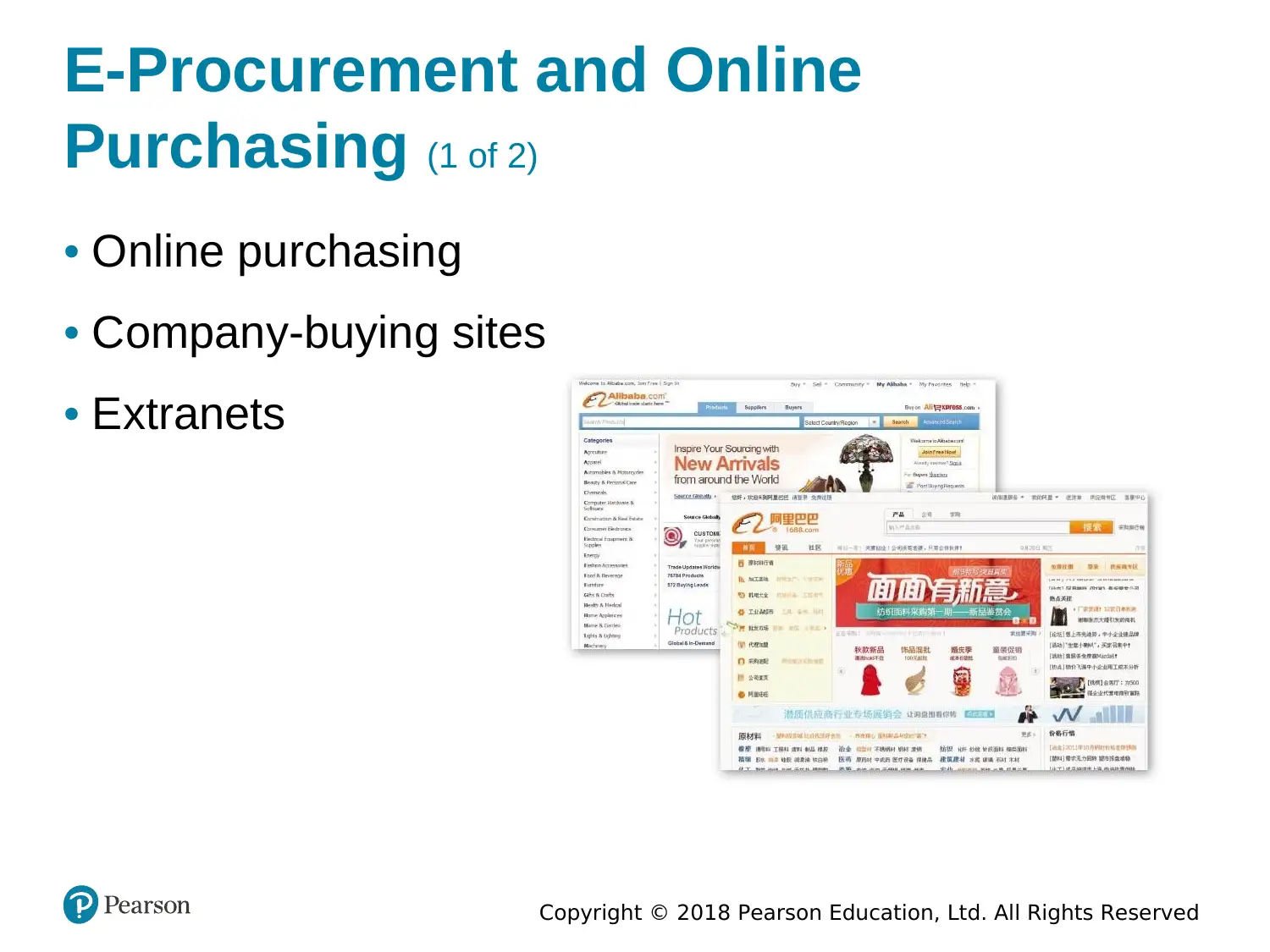
Copyright © 2018 Pearson Education, Ltd. All Rights Reserved
E-Procurement and Online
Purchasing (1 of 2)
• Online purchasing
• Company-buying sites
• Extranets
E-Procurement and Online
Purchasing (1 of 2)
• Online purchasing
• Company-buying sites
• Extranets
Paraphrase This Document
Need a fresh take? Get an instant paraphrase of this document with our AI Paraphraser
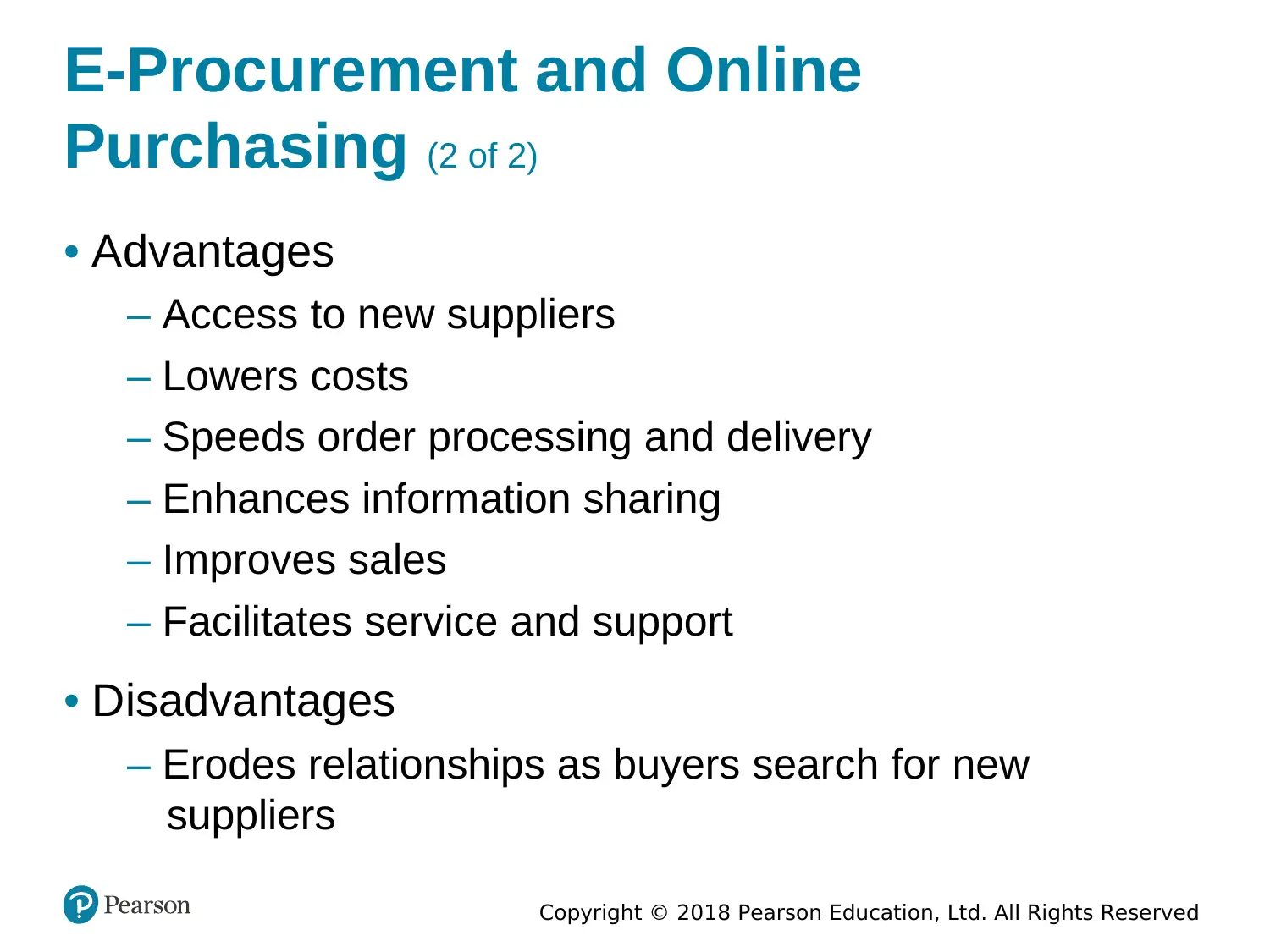
Copyright © 2018 Pearson Education, Ltd. All Rights Reserved
E-Procurement and Online
Purchasing (2 of 2)
• Advantages
– Access to new suppliers
– Lowers costs
– Speeds order processing and delivery
– Enhances information sharing
– Improves sales
– Facilitates service and support
• Disadvantages
– Erodes relationships as buyers search for new
suppliers
E-Procurement and Online
Purchasing (2 of 2)
• Advantages
– Access to new suppliers
– Lowers costs
– Speeds order processing and delivery
– Enhances information sharing
– Improves sales
– Facilitates service and support
• Disadvantages
– Erodes relationships as buyers search for new
suppliers
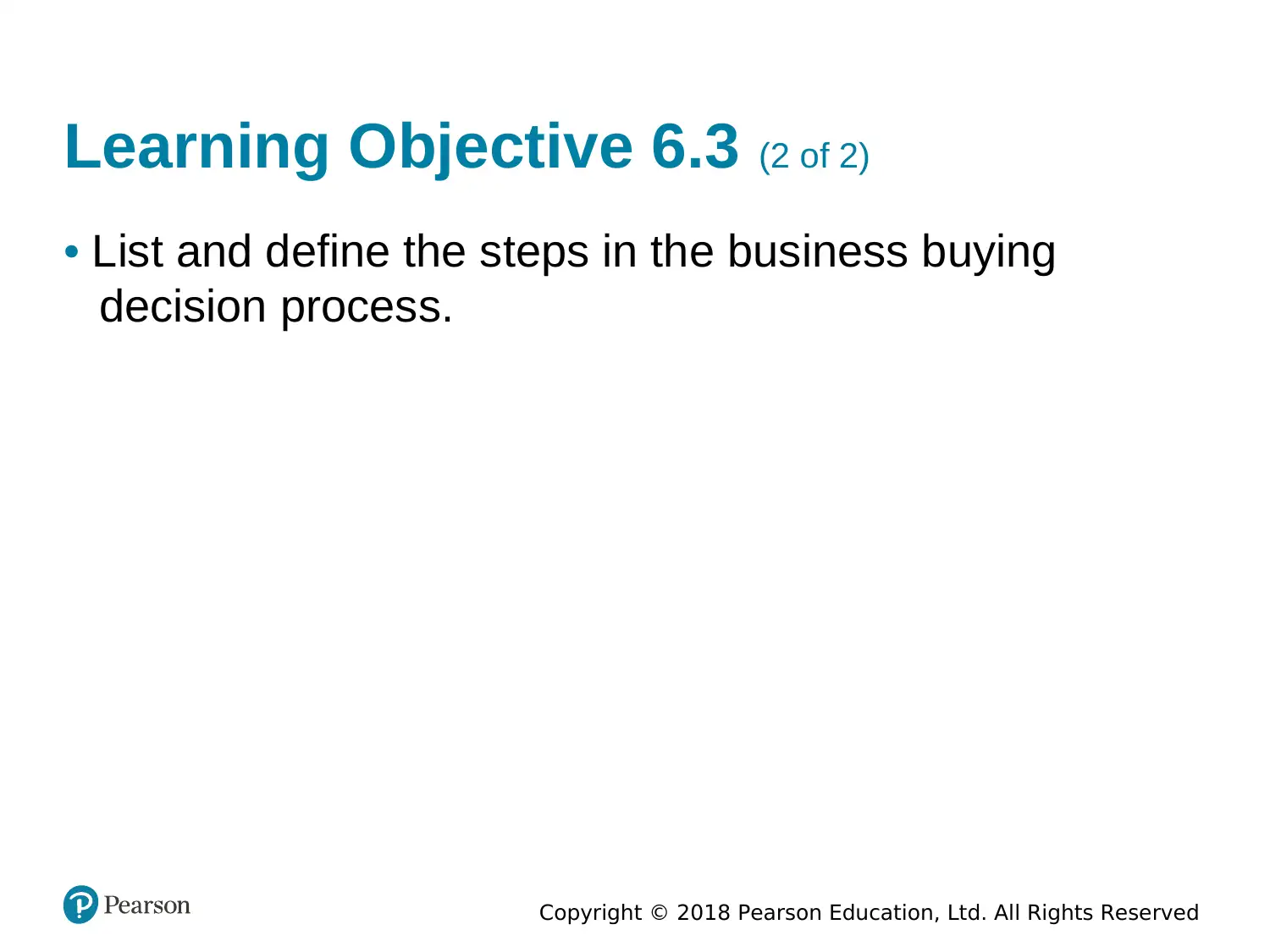
Copyright © 2018 Pearson Education, Ltd. All Rights Reserved
Learning Objective 6.3 (2 of 2)
• List and define the steps in the business buying
decision process.
Learning Objective 6.3 (2 of 2)
• List and define the steps in the business buying
decision process.
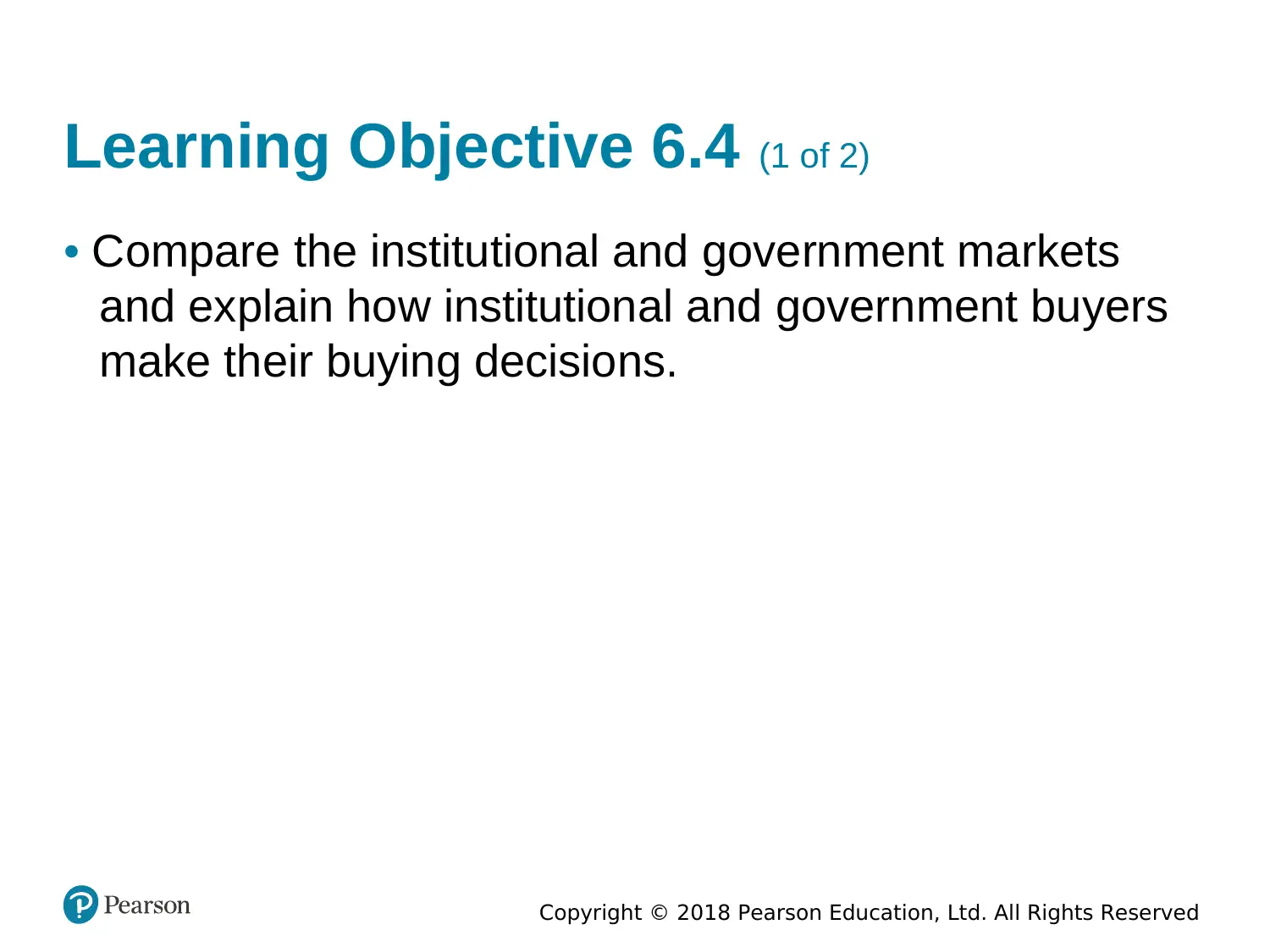
Copyright © 2018 Pearson Education, Ltd. All Rights Reserved
Learning Objective 6.4 (1 of 2)
• Compare the institutional and government markets
and explain how institutional and government buyers
make their buying decisions.
Learning Objective 6.4 (1 of 2)
• Compare the institutional and government markets
and explain how institutional and government buyers
make their buying decisions.
Secure Best Marks with AI Grader
Need help grading? Try our AI Grader for instant feedback on your assignments.
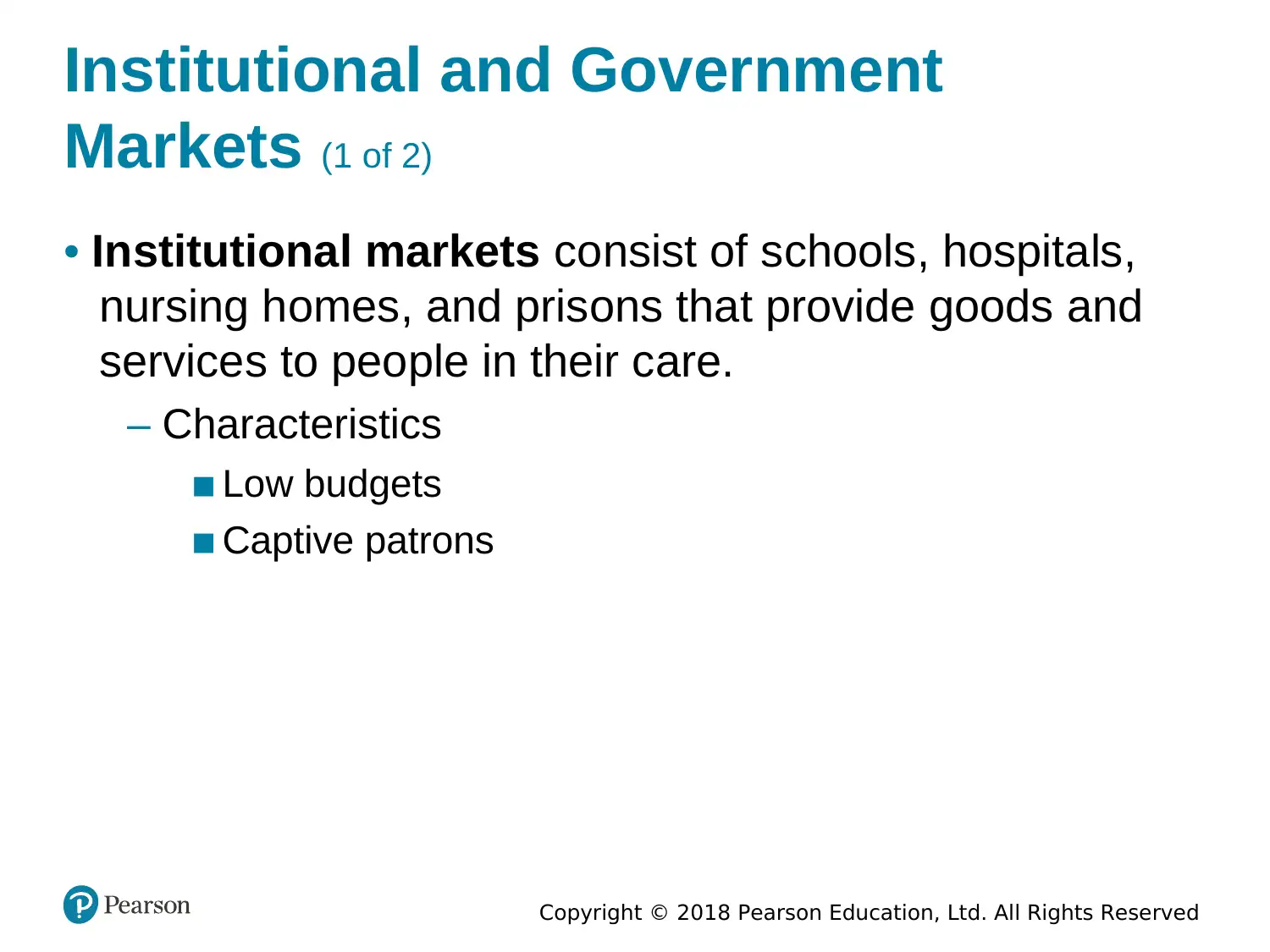
Copyright © 2018 Pearson Education, Ltd. All Rights Reserved
Institutional and Government
Markets (1 of 2)
• Institutional markets consist of schools, hospitals,
nursing homes, and prisons that provide goods and
services to people in their care.
– Characteristics
▪ Low budgets
▪ Captive patrons
Institutional and Government
Markets (1 of 2)
• Institutional markets consist of schools, hospitals,
nursing homes, and prisons that provide goods and
services to people in their care.
– Characteristics
▪ Low budgets
▪ Captive patrons
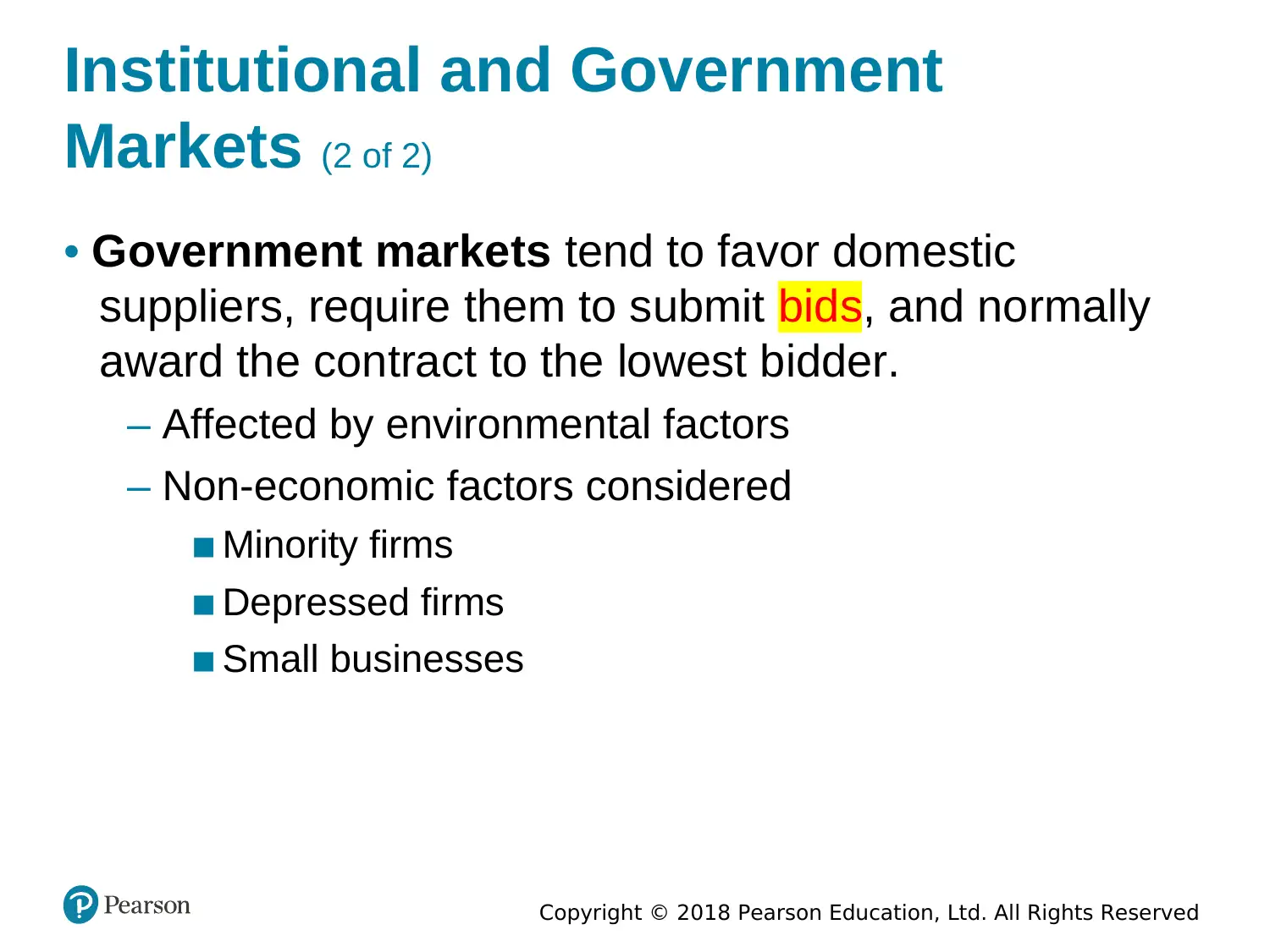
Copyright © 2018 Pearson Education, Ltd. All Rights Reserved
Institutional and Government
Markets (2 of 2)
• Government markets tend to favor domestic
suppliers, require them to submit bids, and normally
award the contract to the lowest bidder.
– Affected by environmental factors
– Non-economic factors considered
▪ Minority firms
▪ Depressed firms
▪ Small businesses
Institutional and Government
Markets (2 of 2)
• Government markets tend to favor domestic
suppliers, require them to submit bids, and normally
award the contract to the lowest bidder.
– Affected by environmental factors
– Non-economic factors considered
▪ Minority firms
▪ Depressed firms
▪ Small businesses
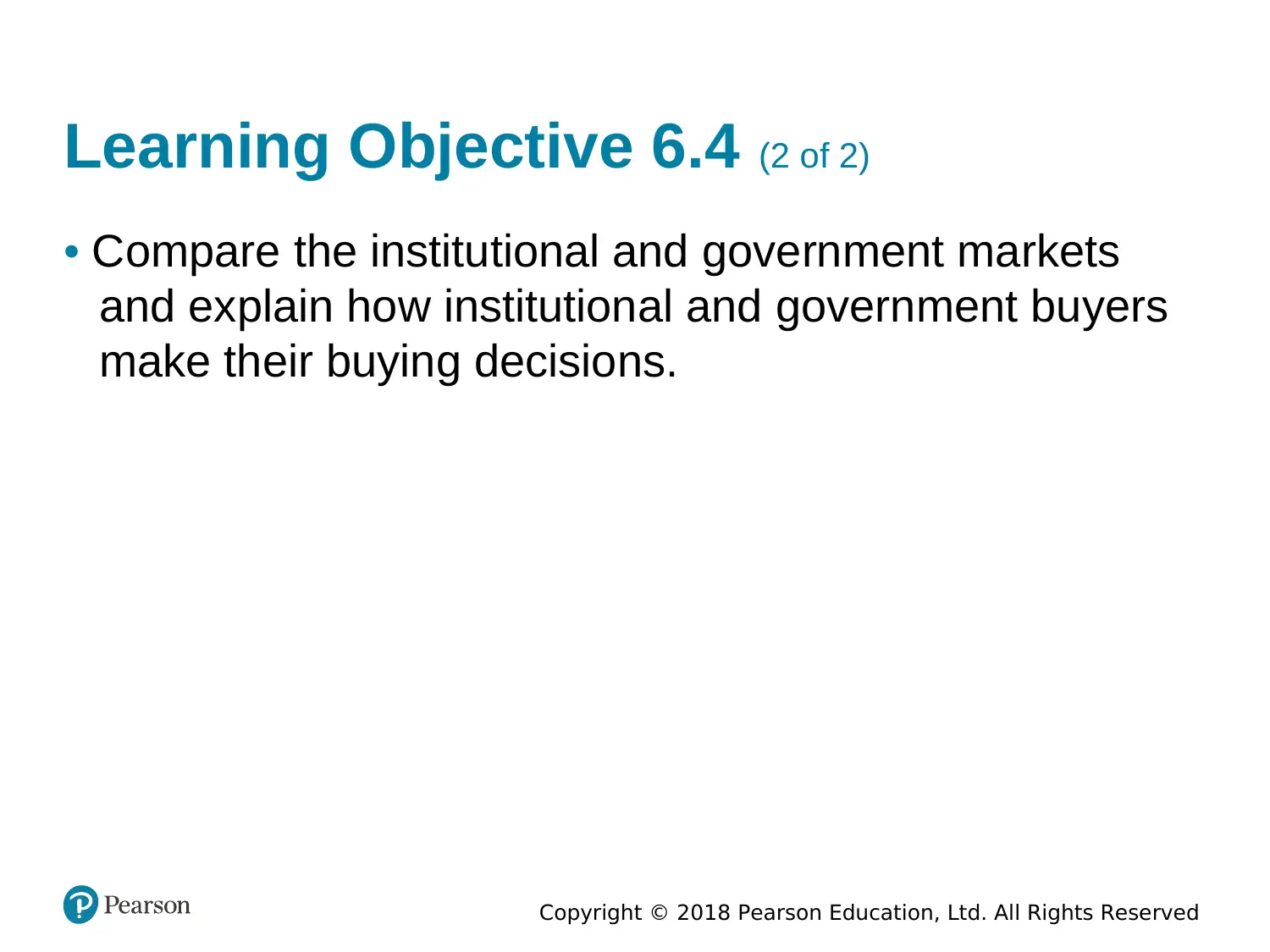
Copyright © 2018 Pearson Education, Ltd. All Rights Reserved
Learning Objective 6.4 (2 of 2)
• Compare the institutional and government markets
and explain how institutional and government buyers
make their buying decisions.
Learning Objective 6.4 (2 of 2)
• Compare the institutional and government markets
and explain how institutional and government buyers
make their buying decisions.
Paraphrase This Document
Need a fresh take? Get an instant paraphrase of this document with our AI Paraphraser
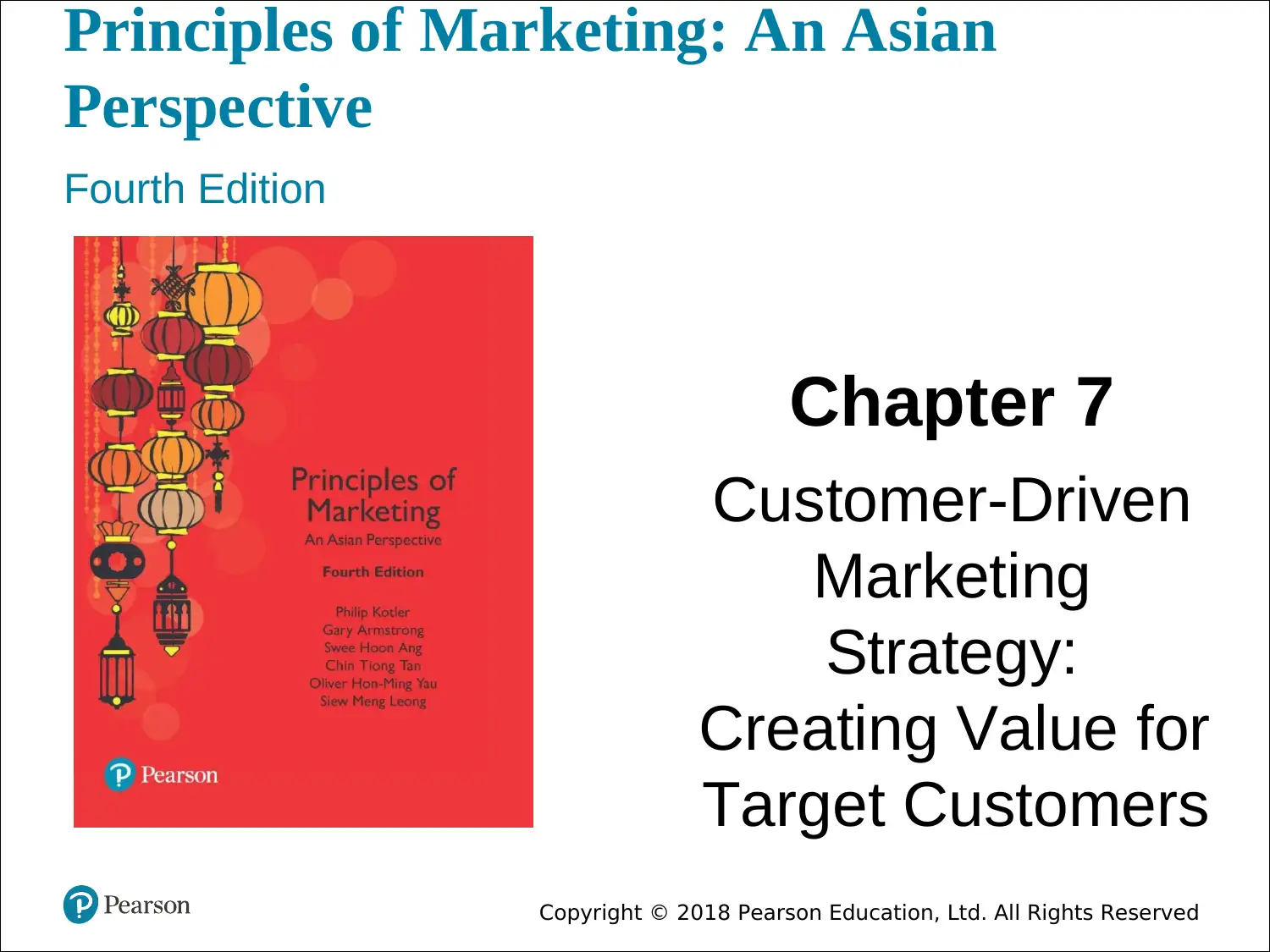
Principles of Marketing: An Asian
Perspective
Fourth Edition
Chapter 7
Customer-Driven
Marketing
Strategy:
Creating Value for
Target Customers
Copyright © 2018 Pearson Education, Ltd. All Rights Reserved
Perspective
Fourth Edition
Chapter 7
Customer-Driven
Marketing
Strategy:
Creating Value for
Target Customers
Copyright © 2018 Pearson Education, Ltd. All Rights Reserved
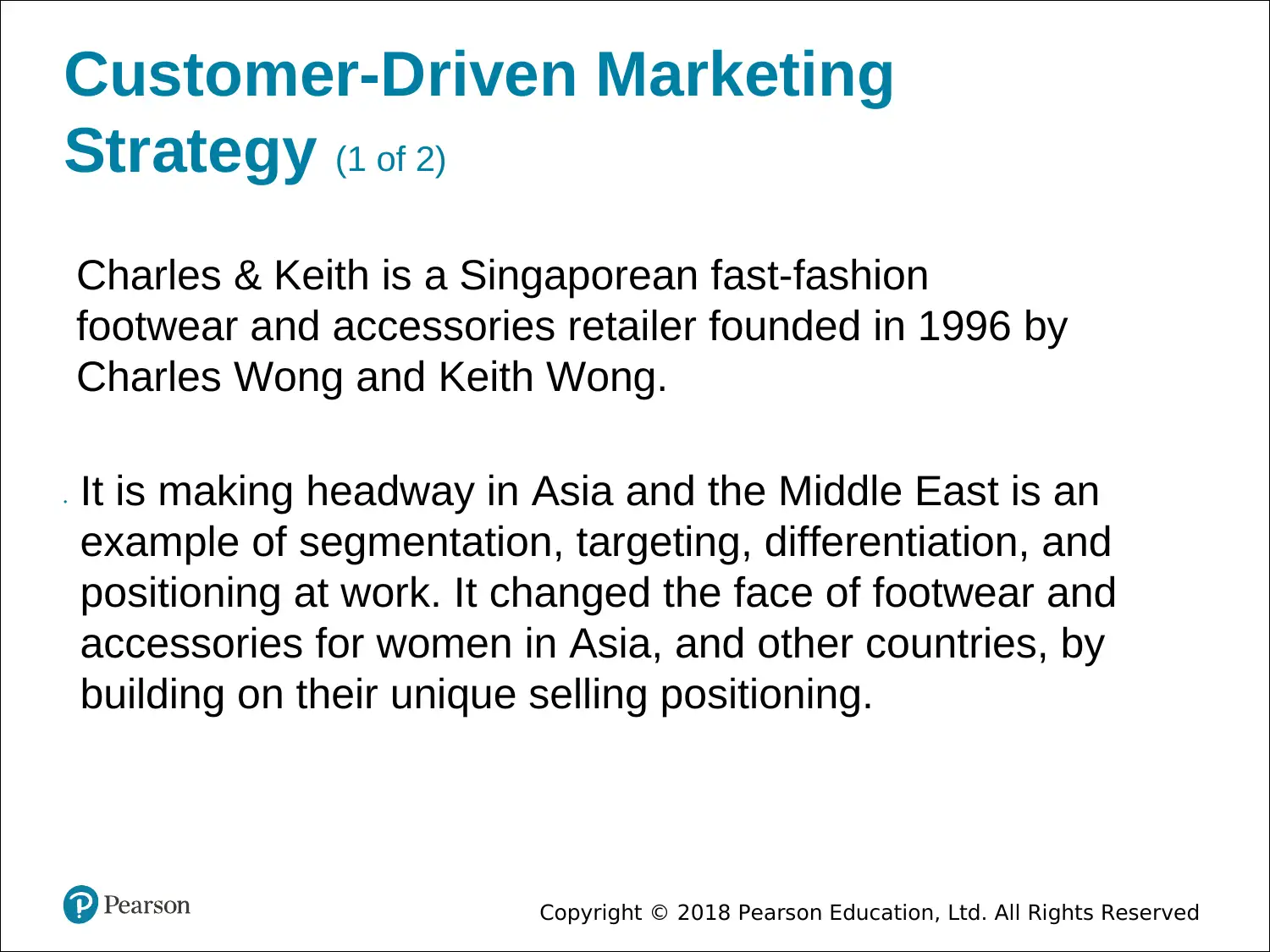
Copyright © 2018 Pearson Education, Ltd. All Rights Reserved
Customer-Driven Marketing
Strategy (1 of 2)
• It is making headway in Asia and the Middle East is an
example of segmentation, targeting, differentiation, and
positioning at work. It changed the face of footwear and
accessories for women in Asia, and other countries, by
building on their unique selling positioning.
Charles & Keith is a Singaporean fast-fashion
footwear and accessories retailer founded in 1996 by
Charles Wong and Keith Wong.
Customer-Driven Marketing
Strategy (1 of 2)
• It is making headway in Asia and the Middle East is an
example of segmentation, targeting, differentiation, and
positioning at work. It changed the face of footwear and
accessories for women in Asia, and other countries, by
building on their unique selling positioning.
Charles & Keith is a Singaporean fast-fashion
footwear and accessories retailer founded in 1996 by
Charles Wong and Keith Wong.
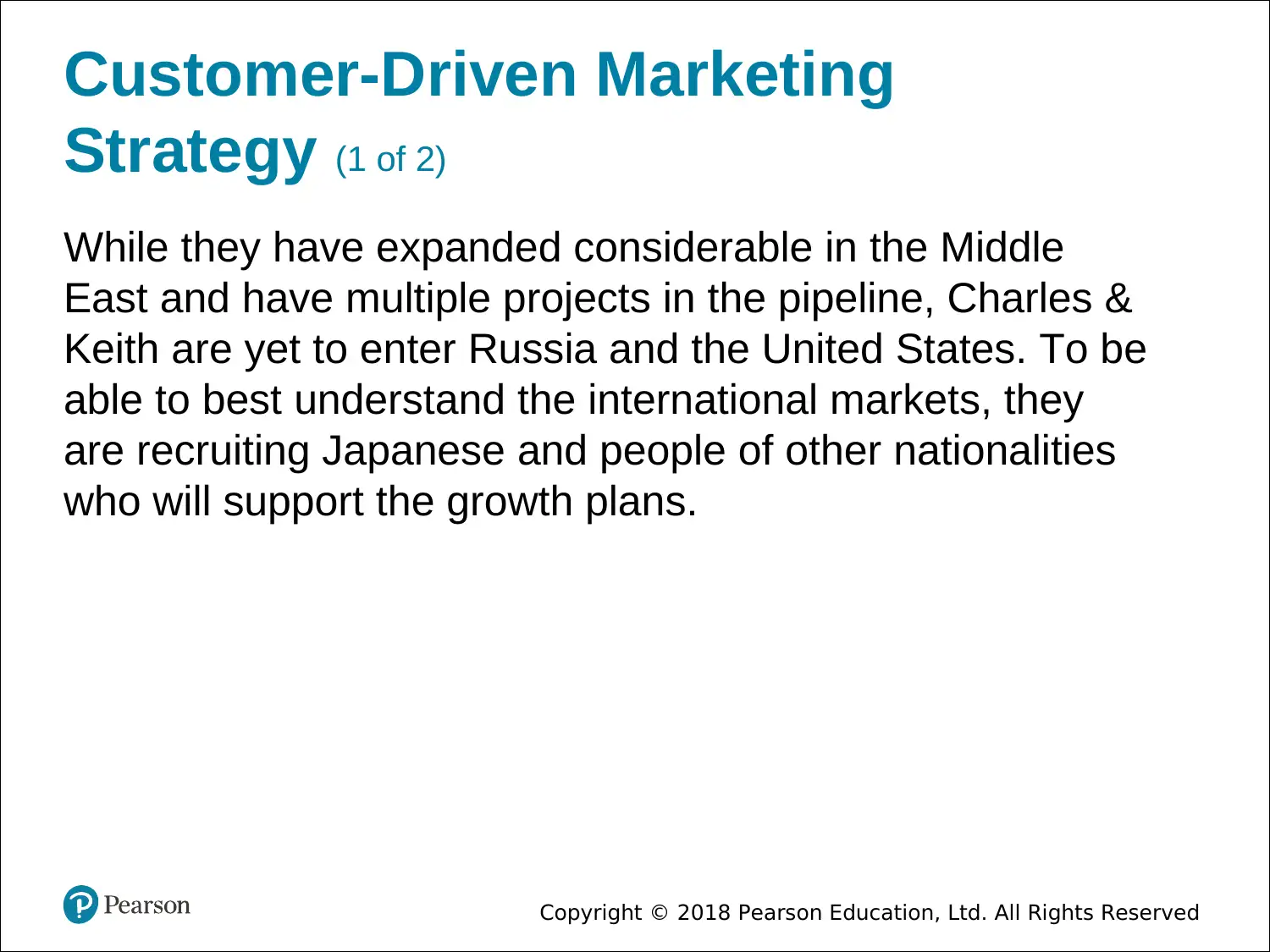
Copyright © 2018 Pearson Education, Ltd. All Rights Reserved
Customer-Driven Marketing
Strategy (1 of 2)
While they have expanded considerable in the Middle
East and have multiple projects in the pipeline, Charles &
Keith are yet to enter Russia and the United States. To be
able to best understand the international markets, they
are recruiting Japanese and people of other nationalities
who will support the growth plans.
Customer-Driven Marketing
Strategy (1 of 2)
While they have expanded considerable in the Middle
East and have multiple projects in the pipeline, Charles &
Keith are yet to enter Russia and the United States. To be
able to best understand the international markets, they
are recruiting Japanese and people of other nationalities
who will support the growth plans.
Secure Best Marks with AI Grader
Need help grading? Try our AI Grader for instant feedback on your assignments.
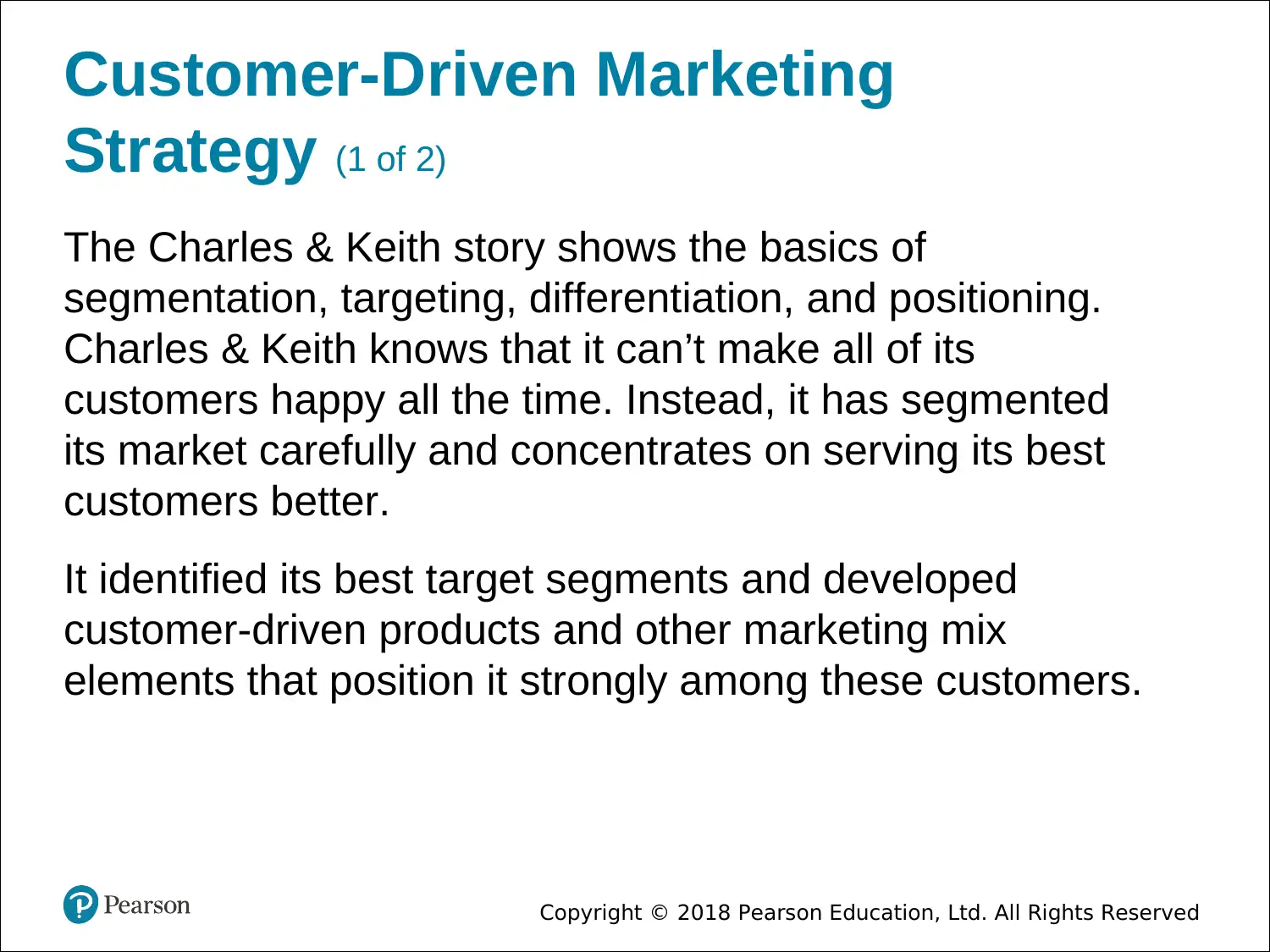
Copyright © 2018 Pearson Education, Ltd. All Rights Reserved
Customer-Driven Marketing
Strategy (1 of 2)
The Charles & Keith story shows the basics of
segmentation, targeting, differentiation, and positioning.
Charles & Keith knows that it can’t make all of its
customers happy all the time. Instead, it has segmented
its market carefully and concentrates on serving its best
customers better.
It identified its best target segments and developed
customer-driven products and other marketing mix
elements that position it strongly among these customers.
Customer-Driven Marketing
Strategy (1 of 2)
The Charles & Keith story shows the basics of
segmentation, targeting, differentiation, and positioning.
Charles & Keith knows that it can’t make all of its
customers happy all the time. Instead, it has segmented
its market carefully and concentrates on serving its best
customers better.
It identified its best target segments and developed
customer-driven products and other marketing mix
elements that position it strongly among these customers.
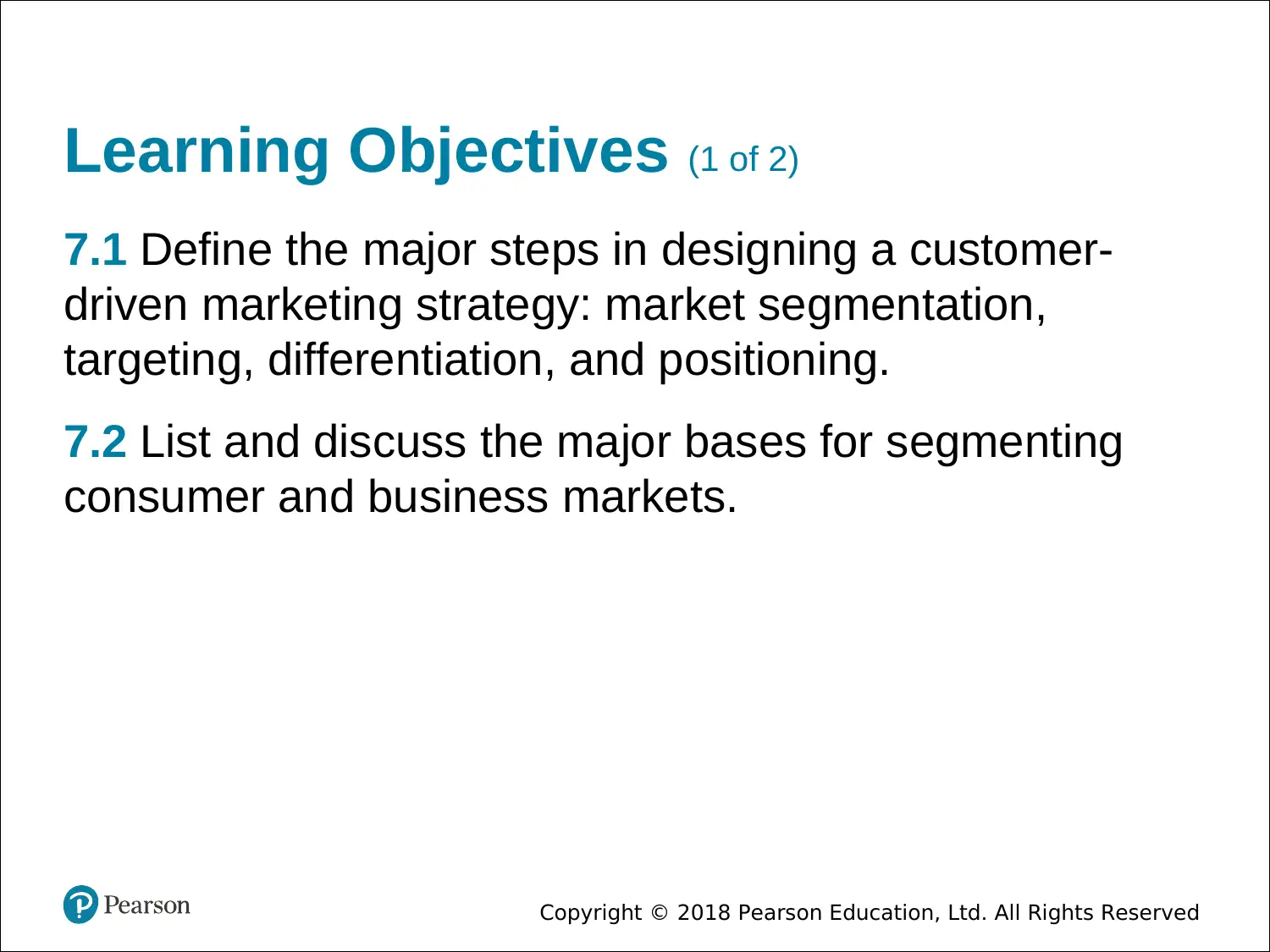
Copyright © 2018 Pearson Education, Ltd. All Rights Reserved
Learning Objectives (1 of 2)
7.1 Define the major steps in designing a customer-
driven marketing strategy: market segmentation,
targeting, differentiation, and positioning.
7.2 List and discuss the major bases for segmenting
consumer and business markets.
Learning Objectives (1 of 2)
7.1 Define the major steps in designing a customer-
driven marketing strategy: market segmentation,
targeting, differentiation, and positioning.
7.2 List and discuss the major bases for segmenting
consumer and business markets.
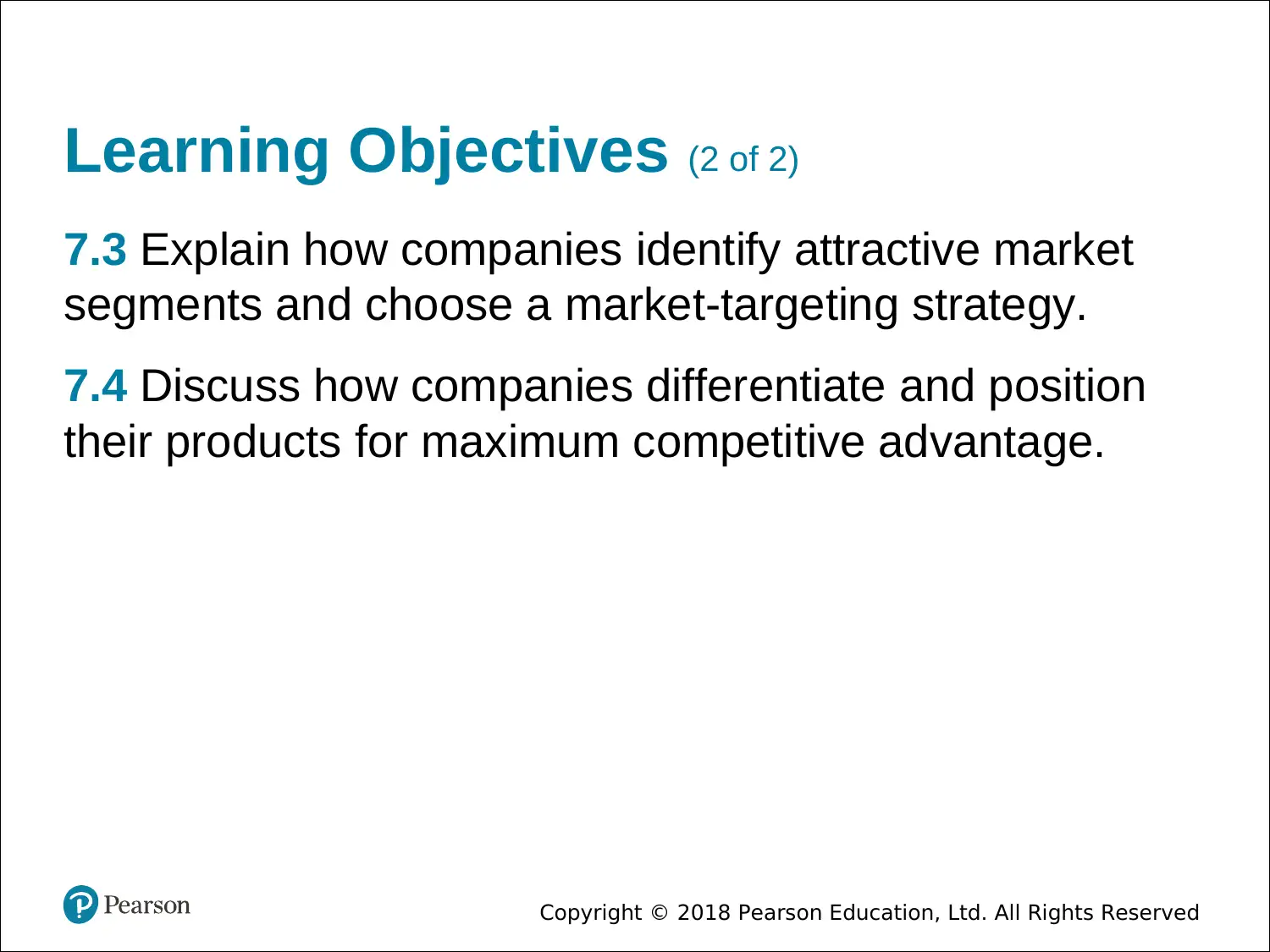
Copyright © 2018 Pearson Education, Ltd. All Rights Reserved
Learning Objectives (2 of 2)
7.3 Explain how companies identify attractive market
segments and choose a market-targeting strategy.
7.4 Discuss how companies differentiate and position
their products for maximum competitive advantage.
Learning Objectives (2 of 2)
7.3 Explain how companies identify attractive market
segments and choose a market-targeting strategy.
7.4 Discuss how companies differentiate and position
their products for maximum competitive advantage.
Paraphrase This Document
Need a fresh take? Get an instant paraphrase of this document with our AI Paraphraser

Copyright © 2018 Pearson Education, Ltd. All Rights Reserved
GROUP A
GROUP A
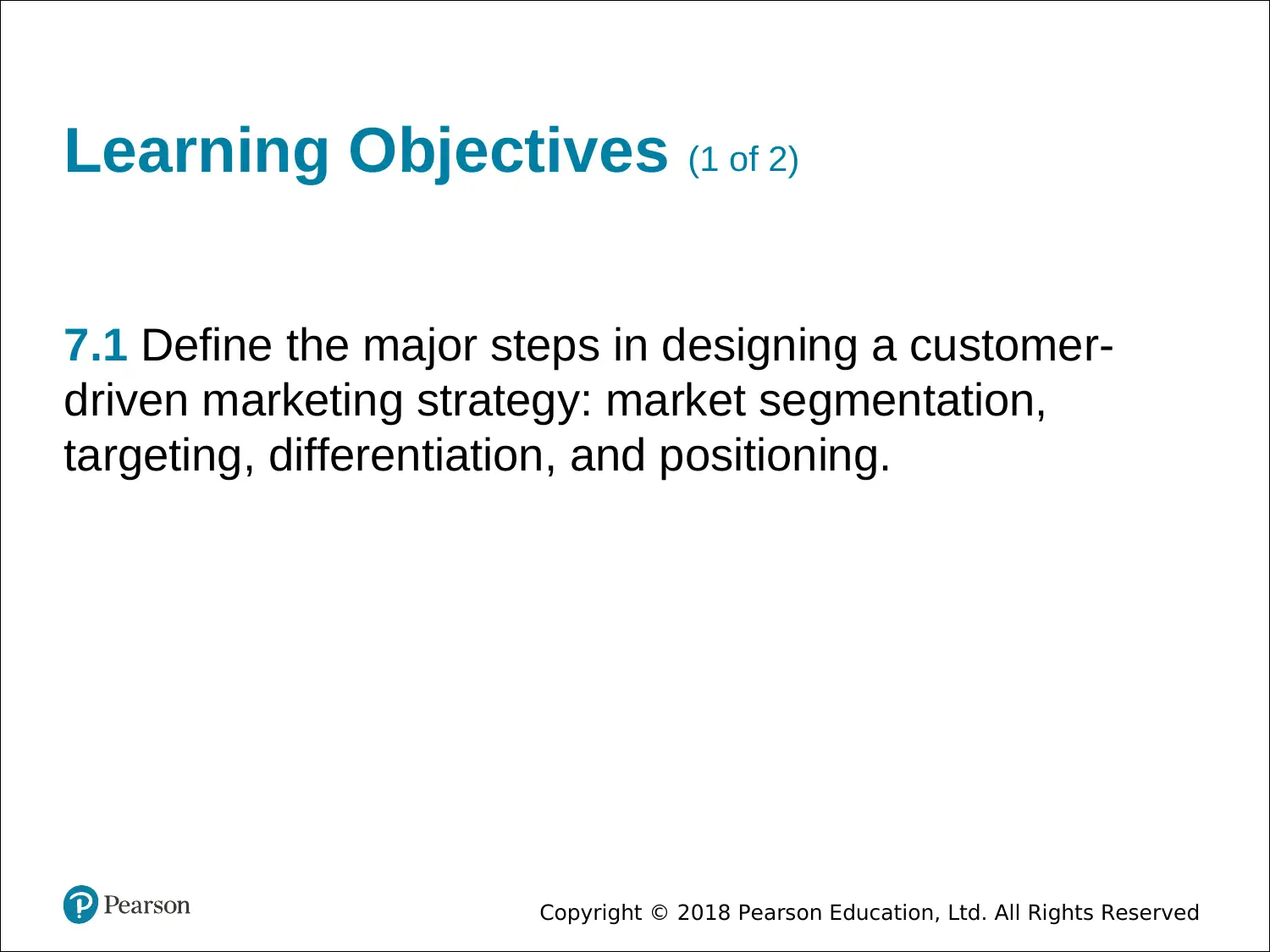
Copyright © 2018 Pearson Education, Ltd. All Rights Reserved
Learning Objectives (1 of 2)
7.1 Define the major steps in designing a customer-
driven marketing strategy: market segmentation,
targeting, differentiation, and positioning.
Learning Objectives (1 of 2)
7.1 Define the major steps in designing a customer-
driven marketing strategy: market segmentation,
targeting, differentiation, and positioning.
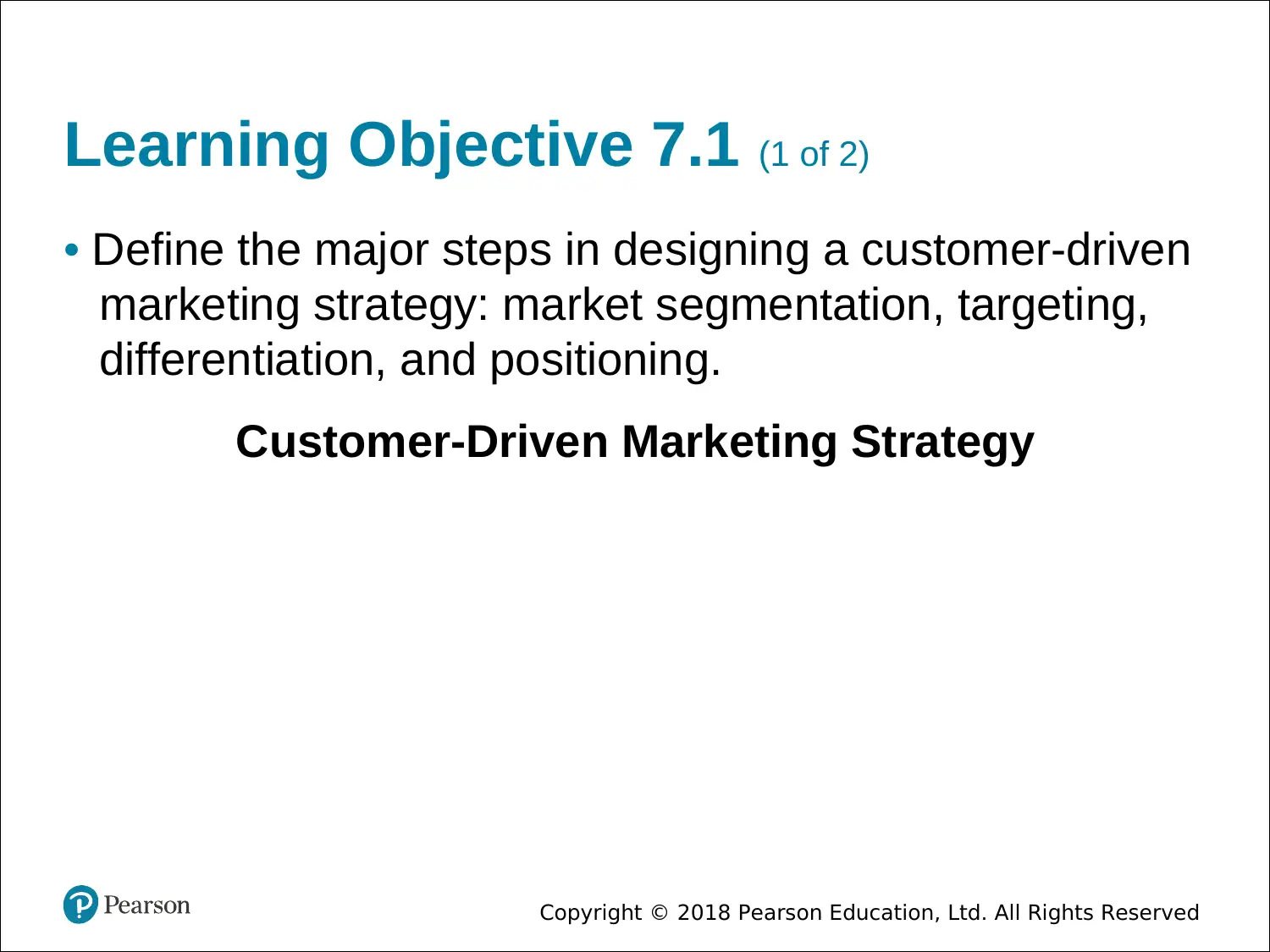
Copyright © 2018 Pearson Education, Ltd. All Rights Reserved
Learning Objective 7.1 (1 of 2)
• Define the major steps in designing a customer-driven
marketing strategy: market segmentation, targeting,
differentiation, and positioning.
Customer-Driven Marketing Strategy
Learning Objective 7.1 (1 of 2)
• Define the major steps in designing a customer-driven
marketing strategy: market segmentation, targeting,
differentiation, and positioning.
Customer-Driven Marketing Strategy
Secure Best Marks with AI Grader
Need help grading? Try our AI Grader for instant feedback on your assignments.
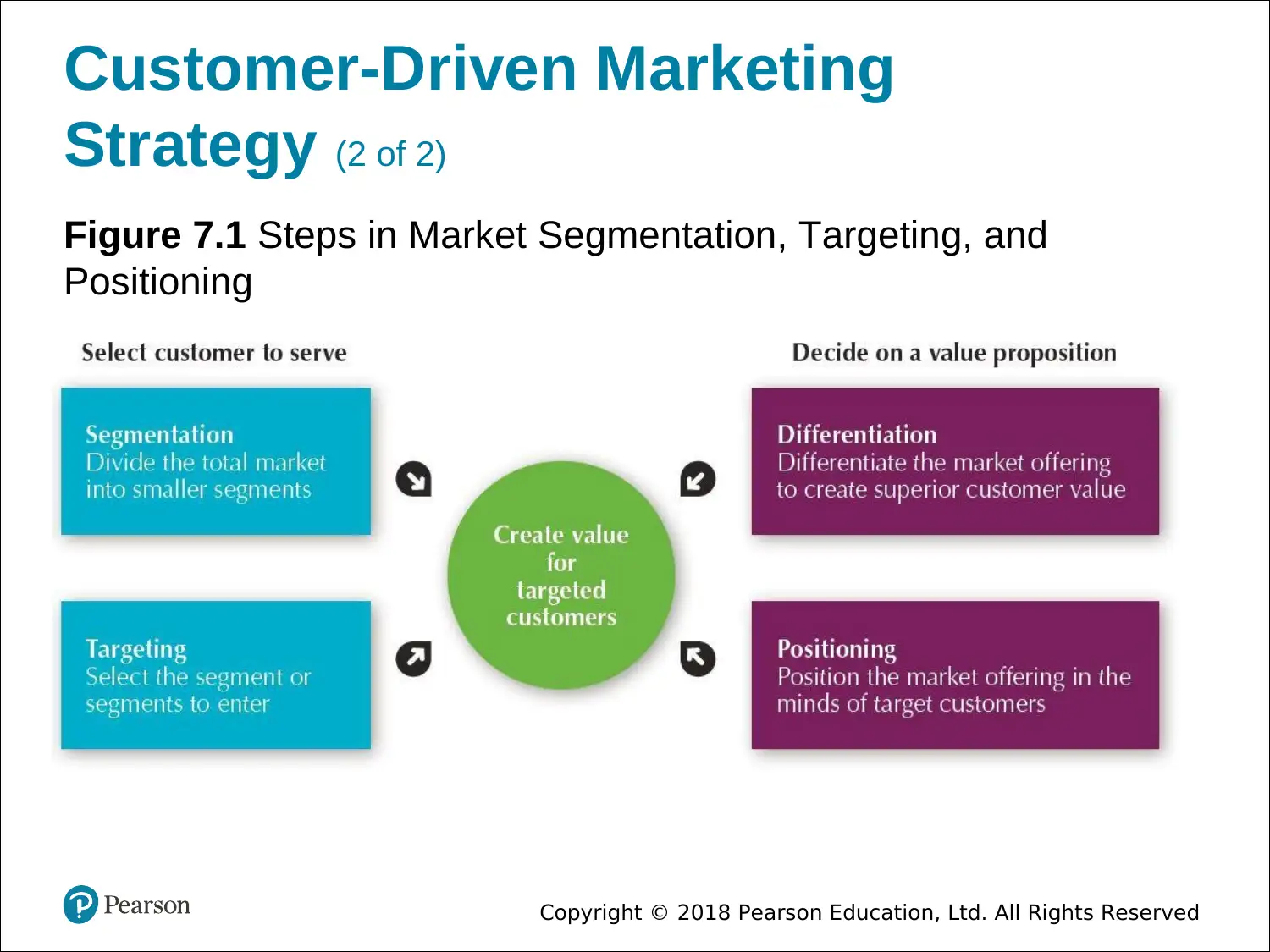
Copyright © 2018 Pearson Education, Ltd. All Rights Reserved
Customer-Driven Marketing
Strategy (2 of 2)
Figure 7.1 Steps in Market Segmentation, Targeting, and
Positioning
Customer-Driven Marketing
Strategy (2 of 2)
Figure 7.1 Steps in Market Segmentation, Targeting, and
Positioning

Copyright © 2018 Pearson Education, Ltd. All Rights Reserved
GROUP B
GROUP B
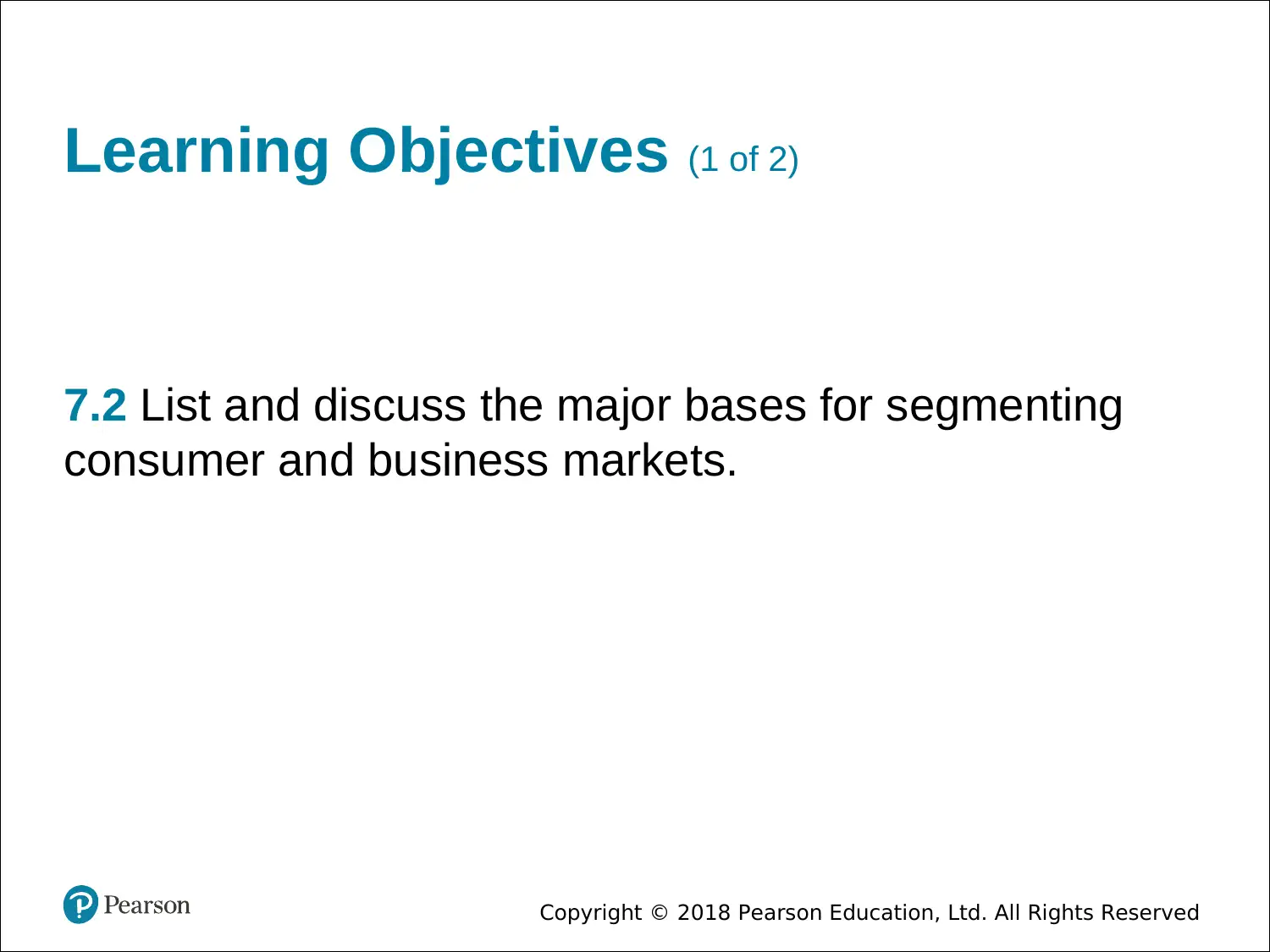
Copyright © 2018 Pearson Education, Ltd. All Rights Reserved
Learning Objectives (1 of 2)
7.2 List and discuss the major bases for segmenting
consumer and business markets.
Learning Objectives (1 of 2)
7.2 List and discuss the major bases for segmenting
consumer and business markets.
Paraphrase This Document
Need a fresh take? Get an instant paraphrase of this document with our AI Paraphraser
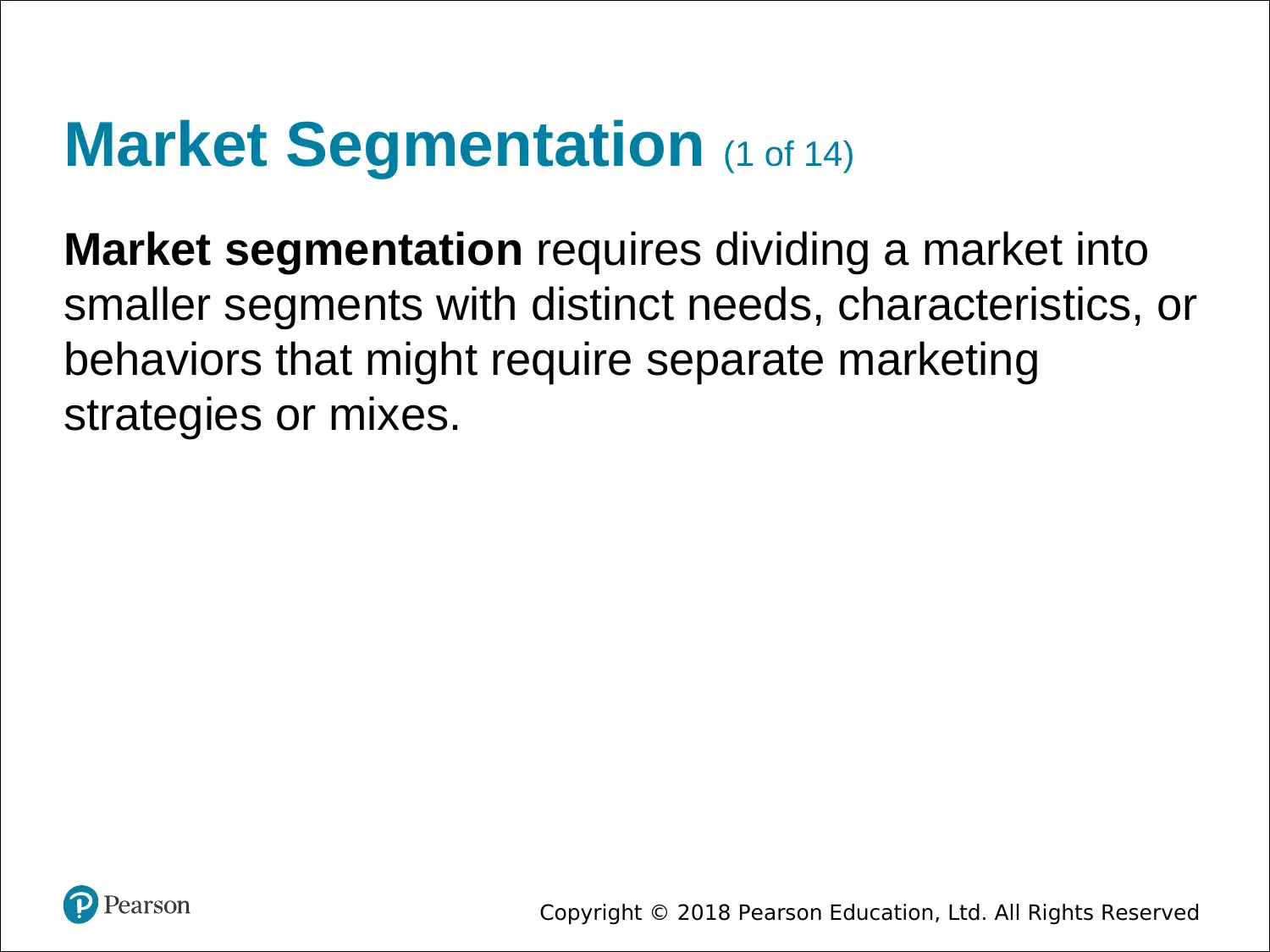
Copyright © 2018 Pearson Education, Ltd. All Rights Reserved
Market Segmentation (1 of 14)
Market segmentation requires dividing a market into
smaller segments with distinct needs, characteristics, or
behaviors that might require separate marketing
strategies or mixes.
Market Segmentation (1 of 14)
Market segmentation requires dividing a market into
smaller segments with distinct needs, characteristics, or
behaviors that might require separate marketing
strategies or mixes.
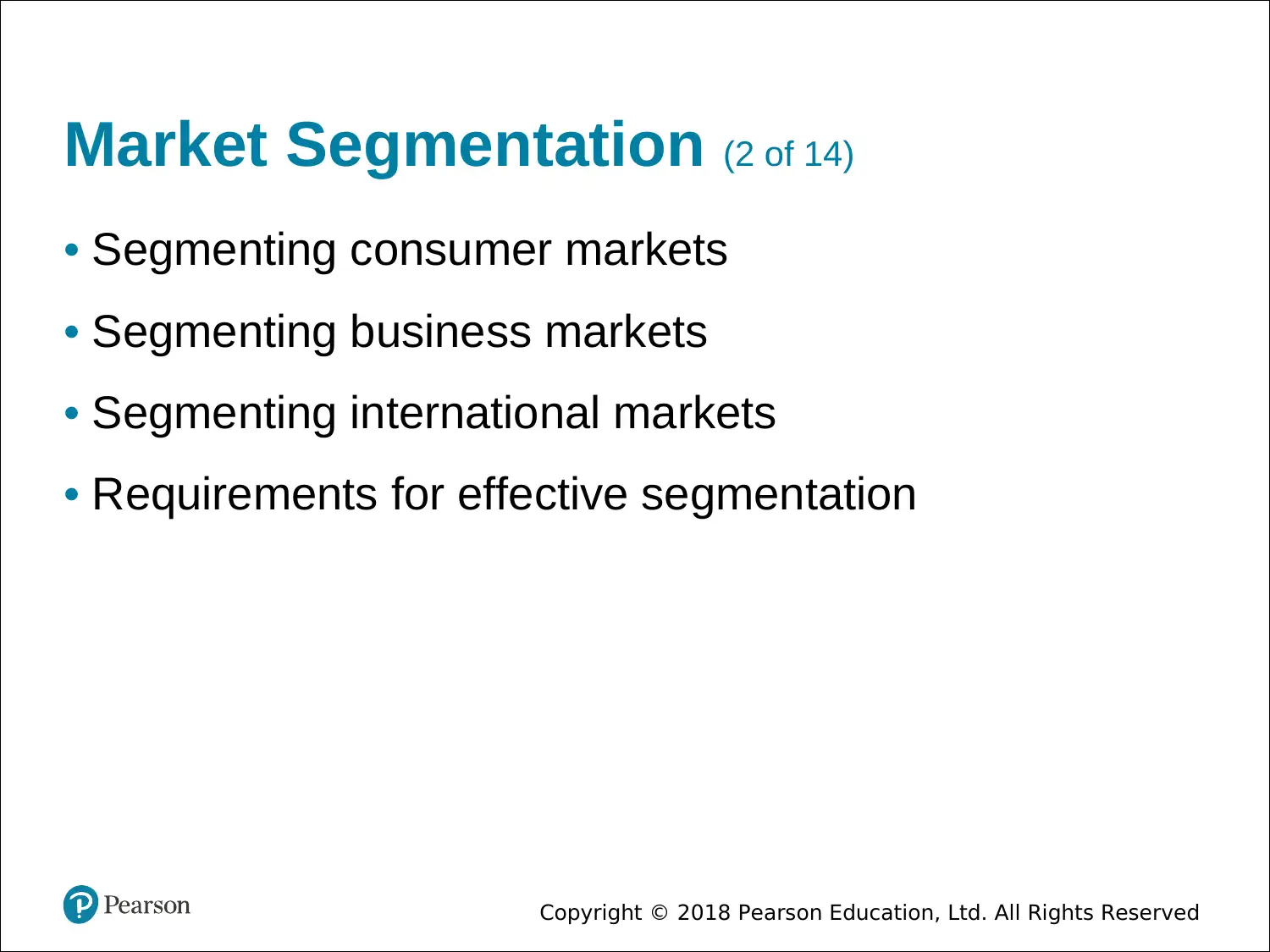
Copyright © 2018 Pearson Education, Ltd. All Rights Reserved
Market Segmentation (2 of 14)
• Segmenting consumer markets
• Segmenting business markets
• Segmenting international markets
• Requirements for effective segmentation
Market Segmentation (2 of 14)
• Segmenting consumer markets
• Segmenting business markets
• Segmenting international markets
• Requirements for effective segmentation
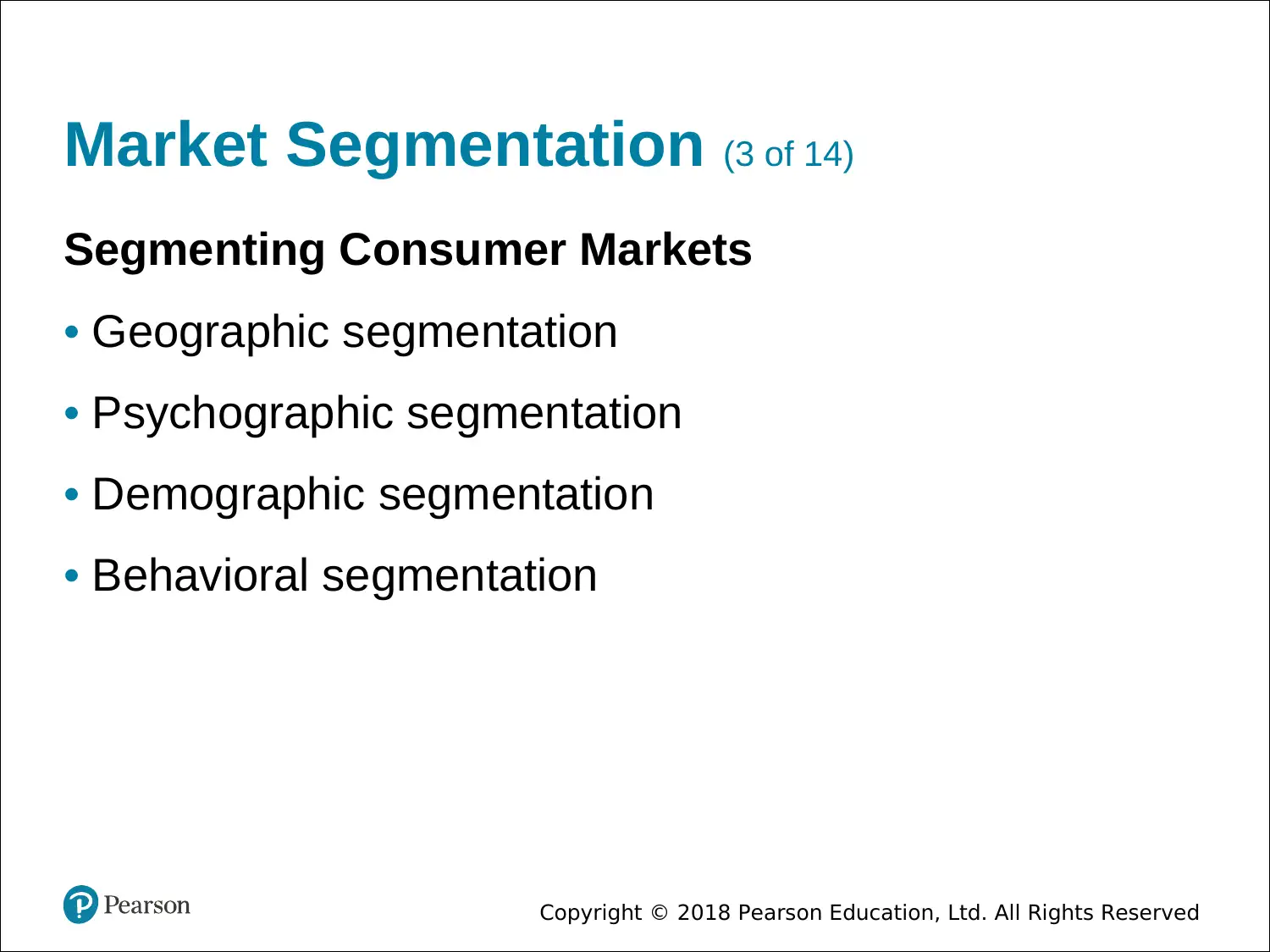
Copyright © 2018 Pearson Education, Ltd. All Rights Reserved
Market Segmentation (3 of 14)
Segmenting Consumer Markets
• Geographic segmentation
• Psychographic segmentation
• Demographic segmentation
• Behavioral segmentation
Market Segmentation (3 of 14)
Segmenting Consumer Markets
• Geographic segmentation
• Psychographic segmentation
• Demographic segmentation
• Behavioral segmentation
Secure Best Marks with AI Grader
Need help grading? Try our AI Grader for instant feedback on your assignments.
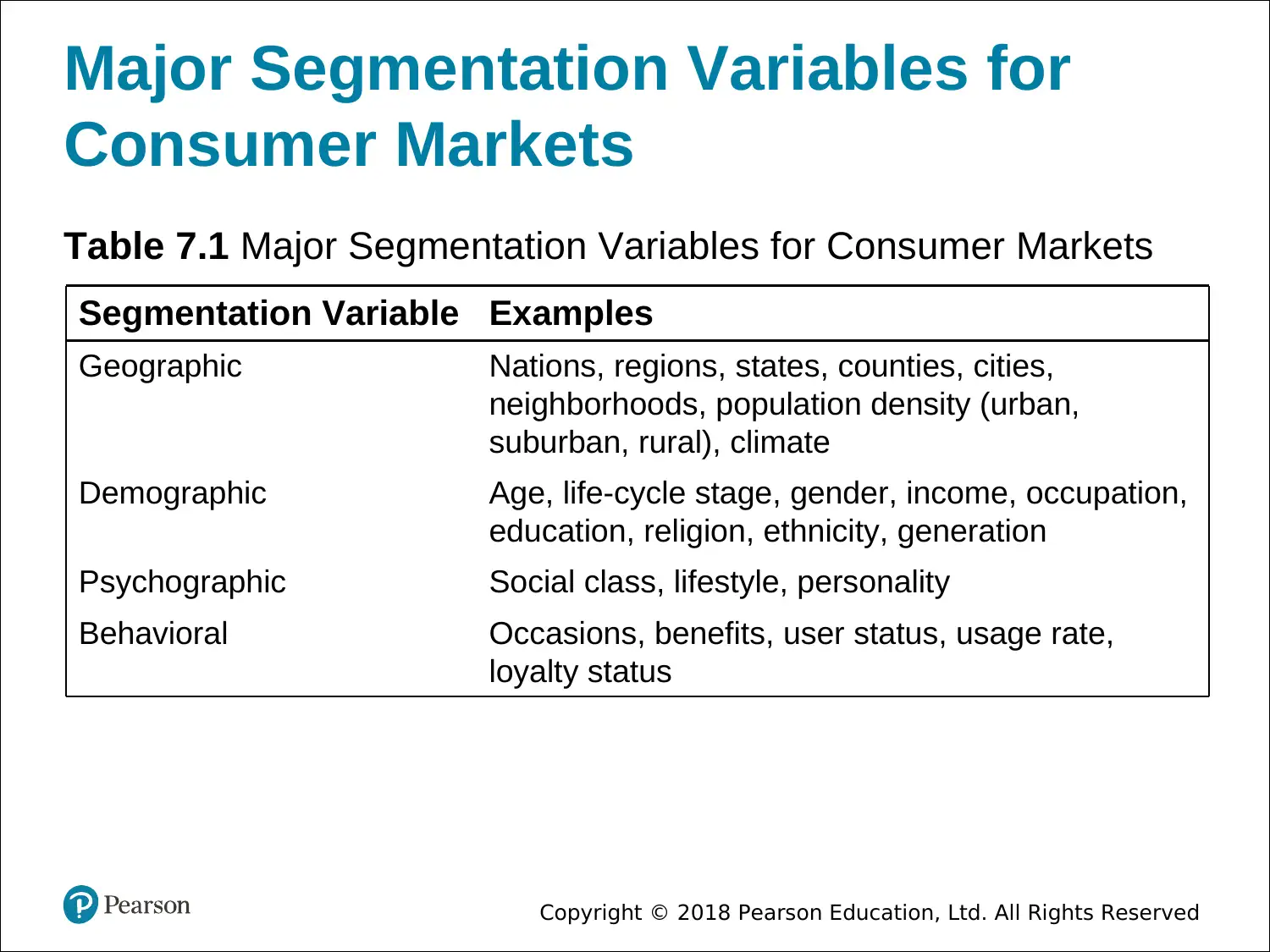
Copyright © 2018 Pearson Education, Ltd. All Rights Reserved
Major Segmentation Variables for
Consumer Markets
Table 7.1 Major Segmentation Variables for Consumer Markets
Segmentation Variable Examples
Geographic Nations, regions, states, counties, cities,
neighborhoods, population density (urban,
suburban, rural), climate
Demographic Age, life-cycle stage, gender, income, occupation,
education, religion, ethnicity, generation
Psychographic Social class, lifestyle, personality
Behavioral Occasions, benefits, user status, usage rate,
loyalty status
Major Segmentation Variables for
Consumer Markets
Table 7.1 Major Segmentation Variables for Consumer Markets
Segmentation Variable Examples
Geographic Nations, regions, states, counties, cities,
neighborhoods, population density (urban,
suburban, rural), climate
Demographic Age, life-cycle stage, gender, income, occupation,
education, religion, ethnicity, generation
Psychographic Social class, lifestyle, personality
Behavioral Occasions, benefits, user status, usage rate,
loyalty status
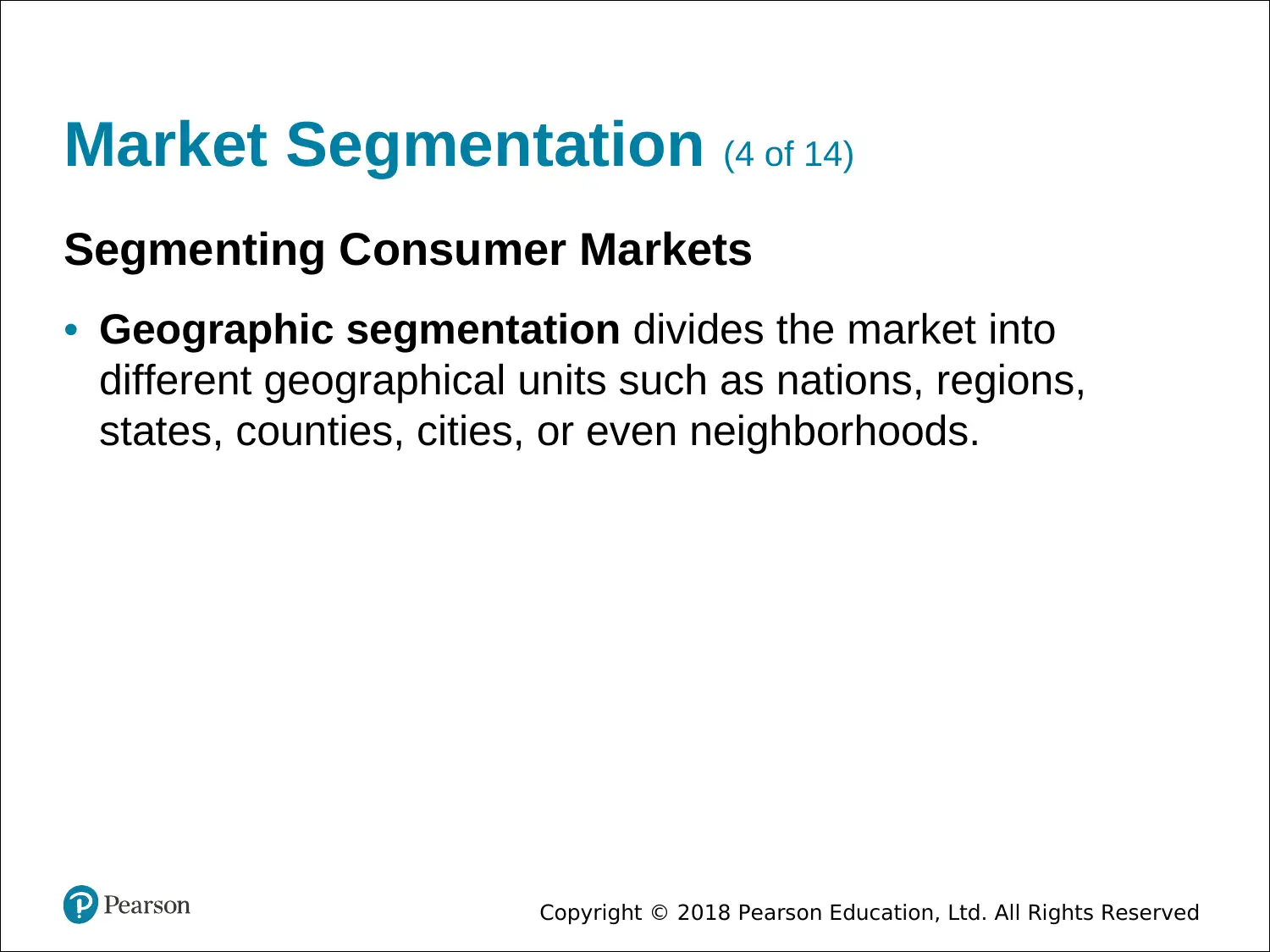
Copyright © 2018 Pearson Education, Ltd. All Rights Reserved
Market Segmentation (4 of 14)
Segmenting Consumer Markets
• Geographic segmentation divides the market into
different geographical units such as nations, regions,
states, counties, cities, or even neighborhoods.
Market Segmentation (4 of 14)
Segmenting Consumer Markets
• Geographic segmentation divides the market into
different geographical units such as nations, regions,
states, counties, cities, or even neighborhoods.
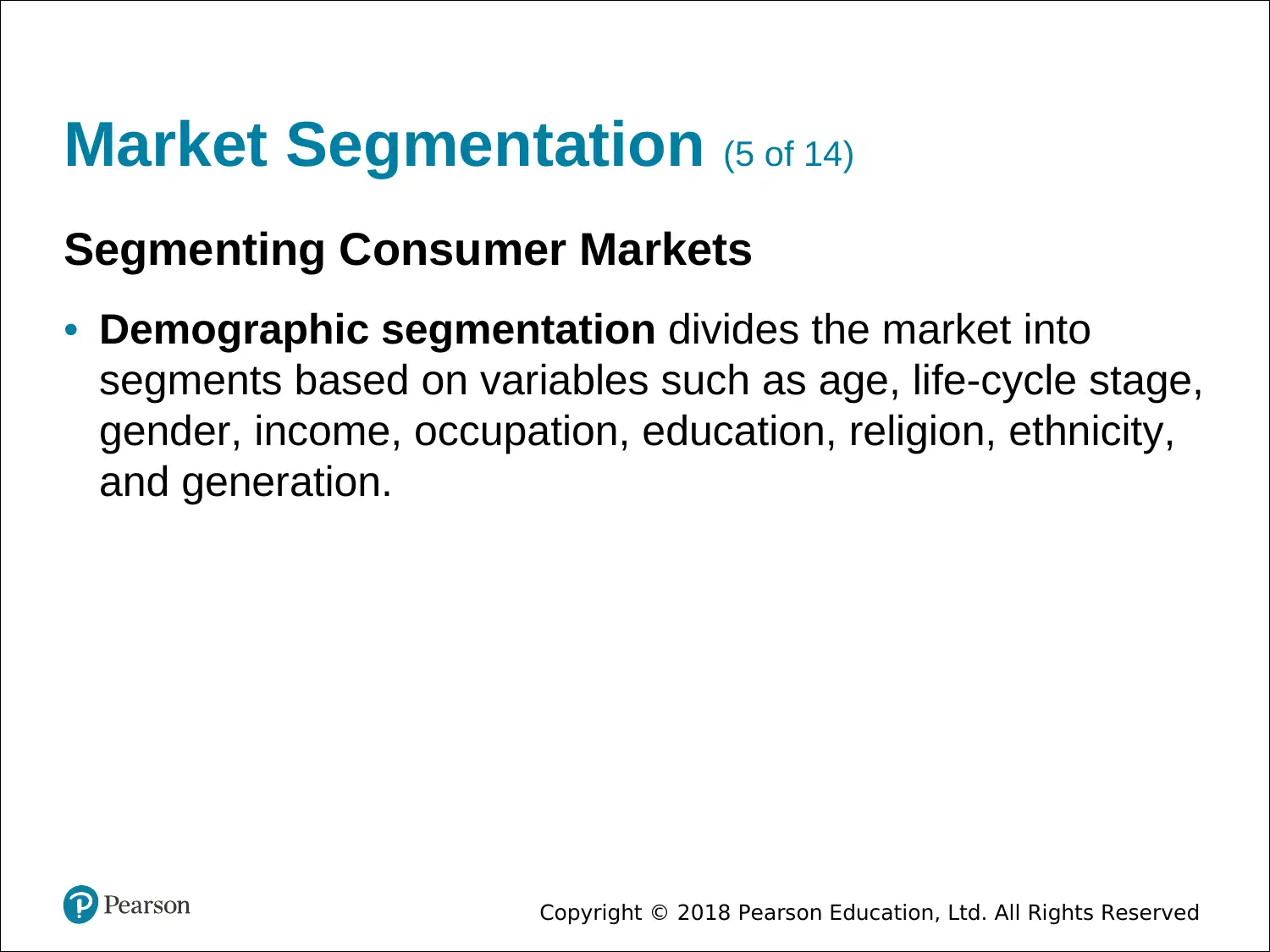
Copyright © 2018 Pearson Education, Ltd. All Rights Reserved
Market Segmentation (5 of 14)
Segmenting Consumer Markets
• Demographic segmentation divides the market into
segments based on variables such as age, life-cycle stage,
gender, income, occupation, education, religion, ethnicity,
and generation.
Market Segmentation (5 of 14)
Segmenting Consumer Markets
• Demographic segmentation divides the market into
segments based on variables such as age, life-cycle stage,
gender, income, occupation, education, religion, ethnicity,
and generation.
Paraphrase This Document
Need a fresh take? Get an instant paraphrase of this document with our AI Paraphraser
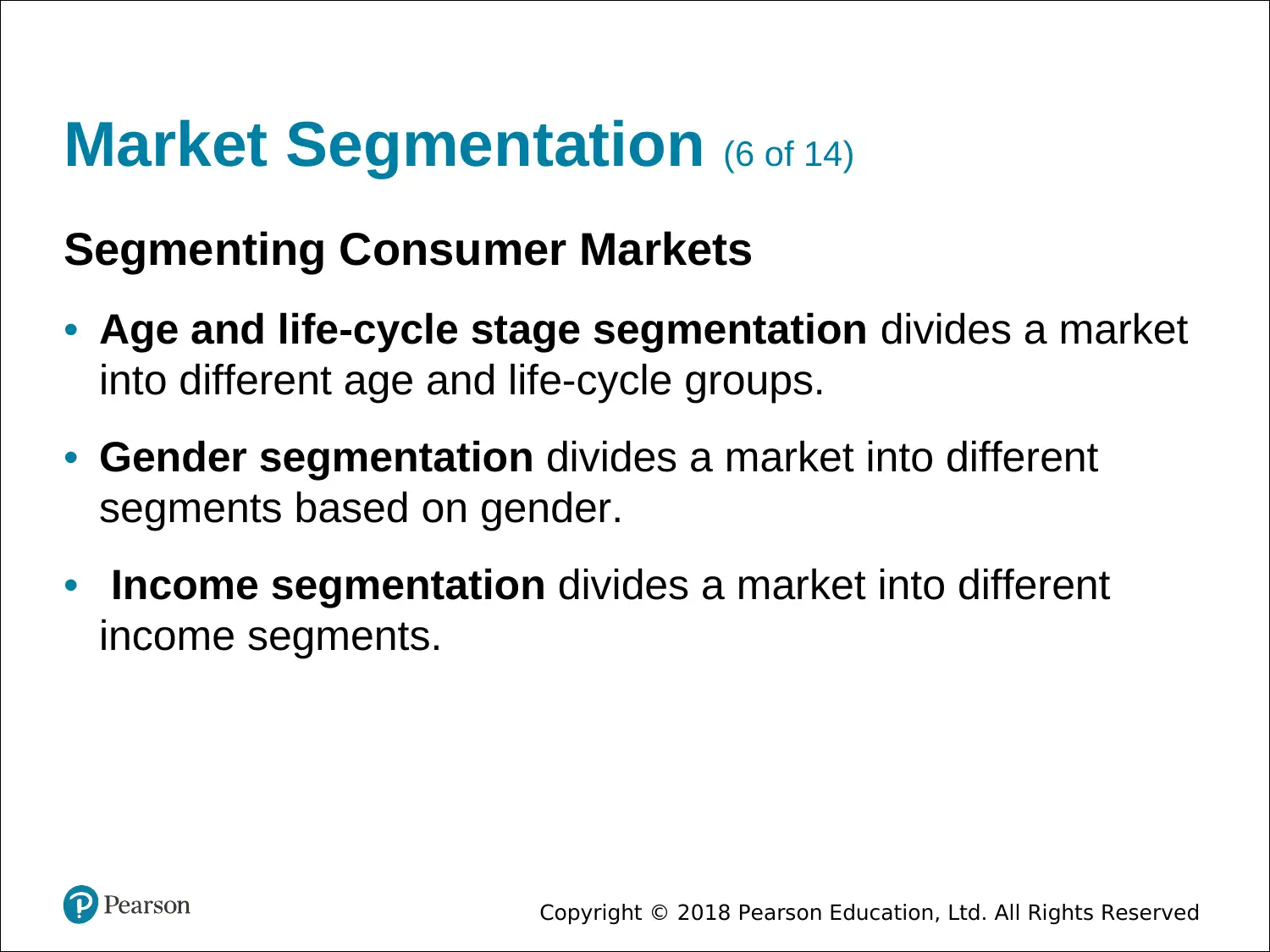
Copyright © 2018 Pearson Education, Ltd. All Rights Reserved
Market Segmentation (6 of 14)
Segmenting Consumer Markets
• Age and life-cycle stage segmentation divides a market
into different age and life-cycle groups.
• Gender segmentation divides a market into different
segments based on gender.
• Income segmentation divides a market into different
income segments.
Market Segmentation (6 of 14)
Segmenting Consumer Markets
• Age and life-cycle stage segmentation divides a market
into different age and life-cycle groups.
• Gender segmentation divides a market into different
segments based on gender.
• Income segmentation divides a market into different
income segments.

Copyright © 2018 Pearson Education, Ltd. All Rights Reserved
GROUP C
GROUP C
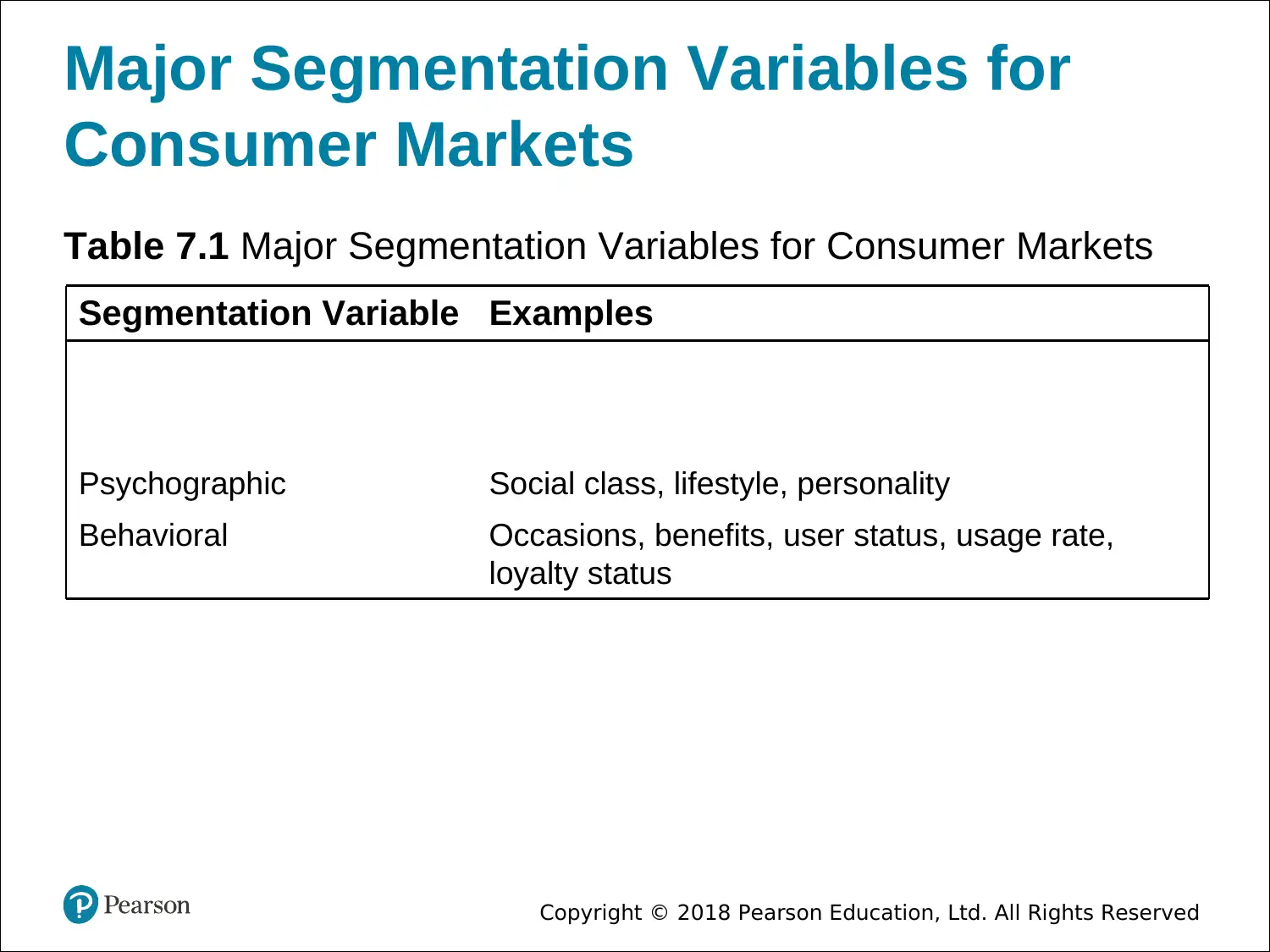
Copyright © 2018 Pearson Education, Ltd. All Rights Reserved
Major Segmentation Variables for
Consumer Markets
Table 7.1 Major Segmentation Variables for Consumer Markets
Segmentation Variable Examples
Psychographic Social class, lifestyle, personality
Behavioral Occasions, benefits, user status, usage rate,
loyalty status
Major Segmentation Variables for
Consumer Markets
Table 7.1 Major Segmentation Variables for Consumer Markets
Segmentation Variable Examples
Psychographic Social class, lifestyle, personality
Behavioral Occasions, benefits, user status, usage rate,
loyalty status
Secure Best Marks with AI Grader
Need help grading? Try our AI Grader for instant feedback on your assignments.
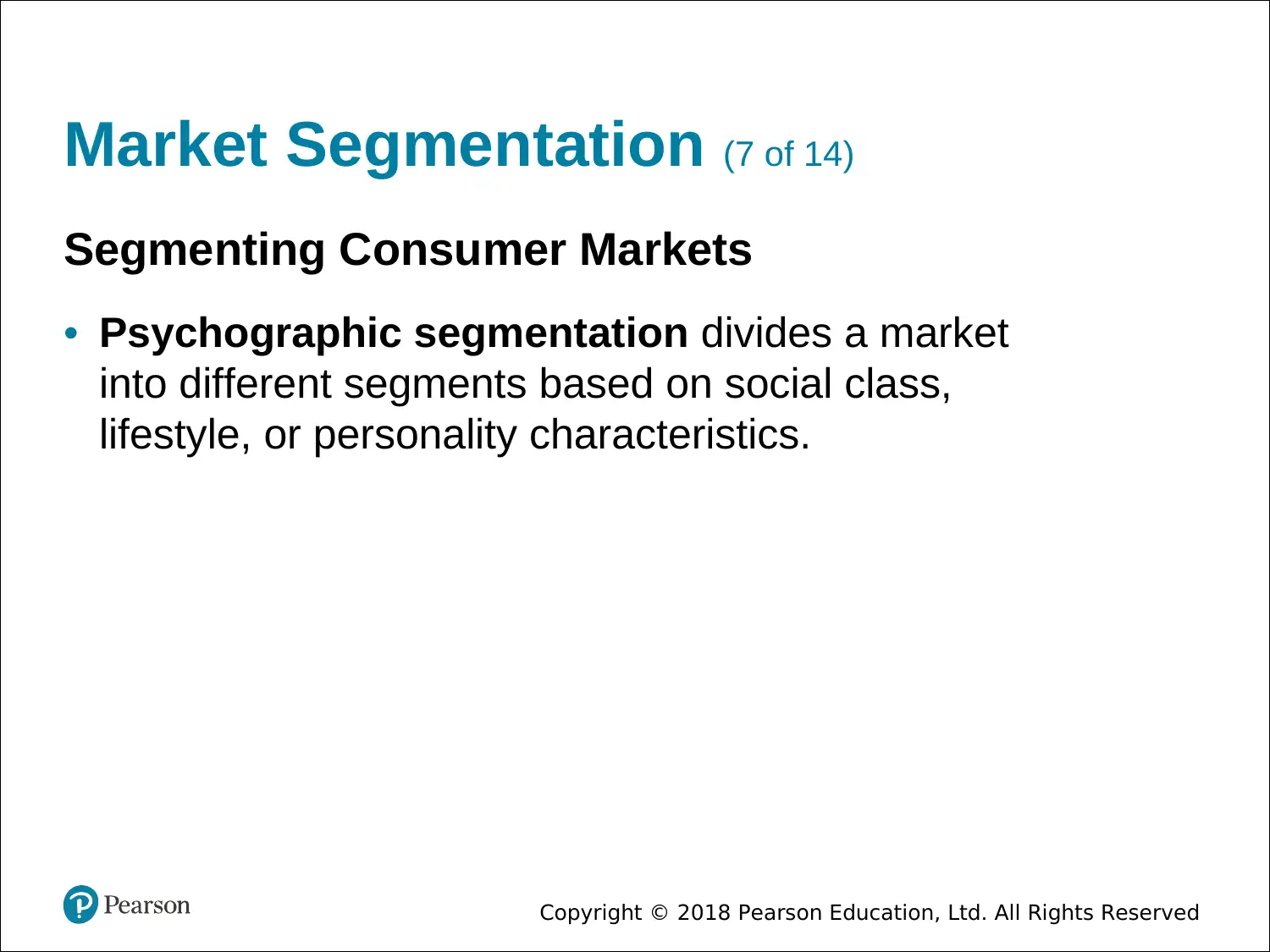
Copyright © 2018 Pearson Education, Ltd. All Rights Reserved
Market Segmentation (7 of 14)
Segmenting Consumer Markets
• Psychographic segmentation divides a market
into different segments based on social class,
lifestyle, or personality characteristics.
Market Segmentation (7 of 14)
Segmenting Consumer Markets
• Psychographic segmentation divides a market
into different segments based on social class,
lifestyle, or personality characteristics.
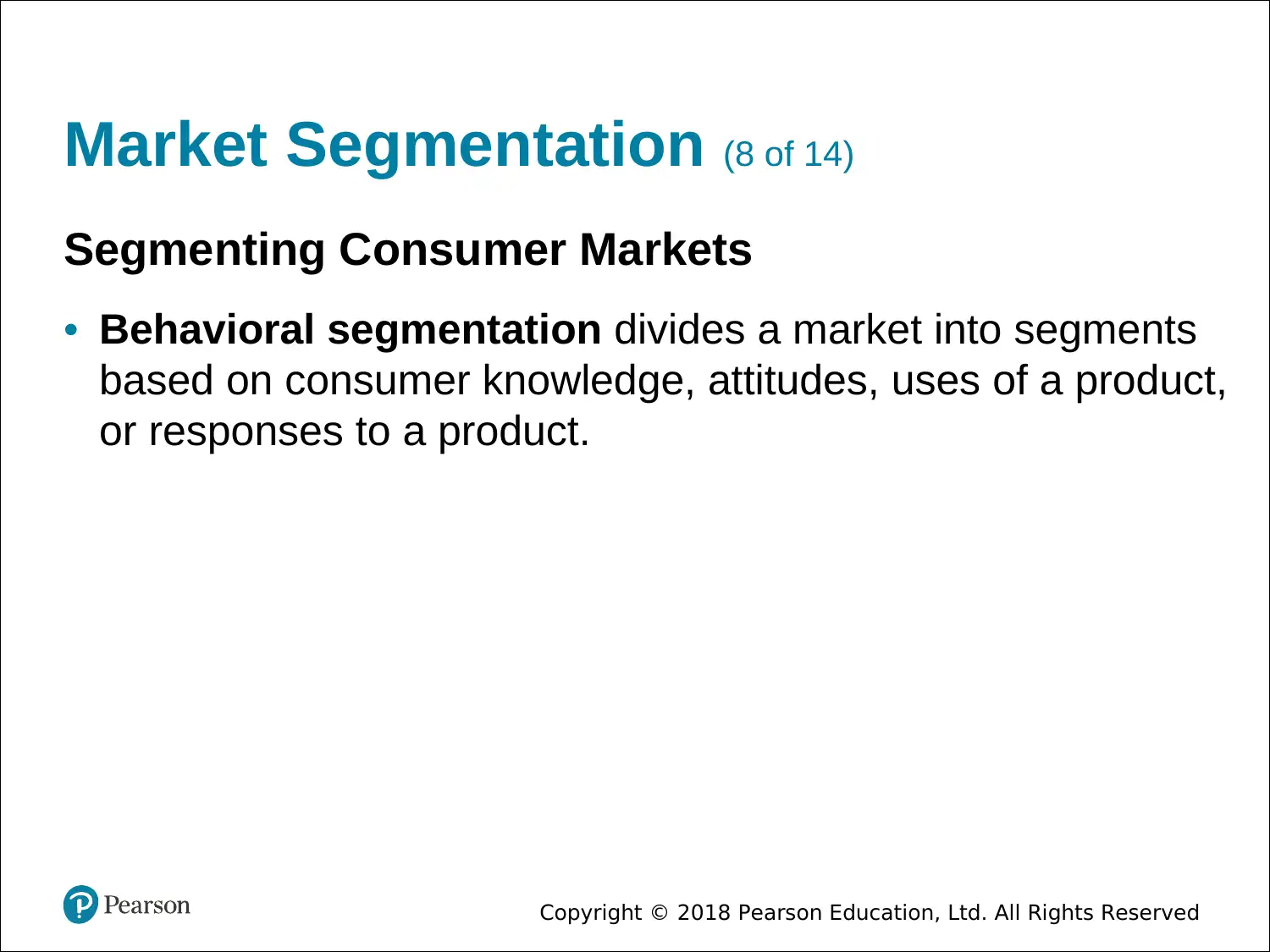
Copyright © 2018 Pearson Education, Ltd. All Rights Reserved
Market Segmentation (8 of 14)
Segmenting Consumer Markets
• Behavioral segmentation divides a market into segments
based on consumer knowledge, attitudes, uses of a product,
or responses to a product.
Market Segmentation (8 of 14)
Segmenting Consumer Markets
• Behavioral segmentation divides a market into segments
based on consumer knowledge, attitudes, uses of a product,
or responses to a product.
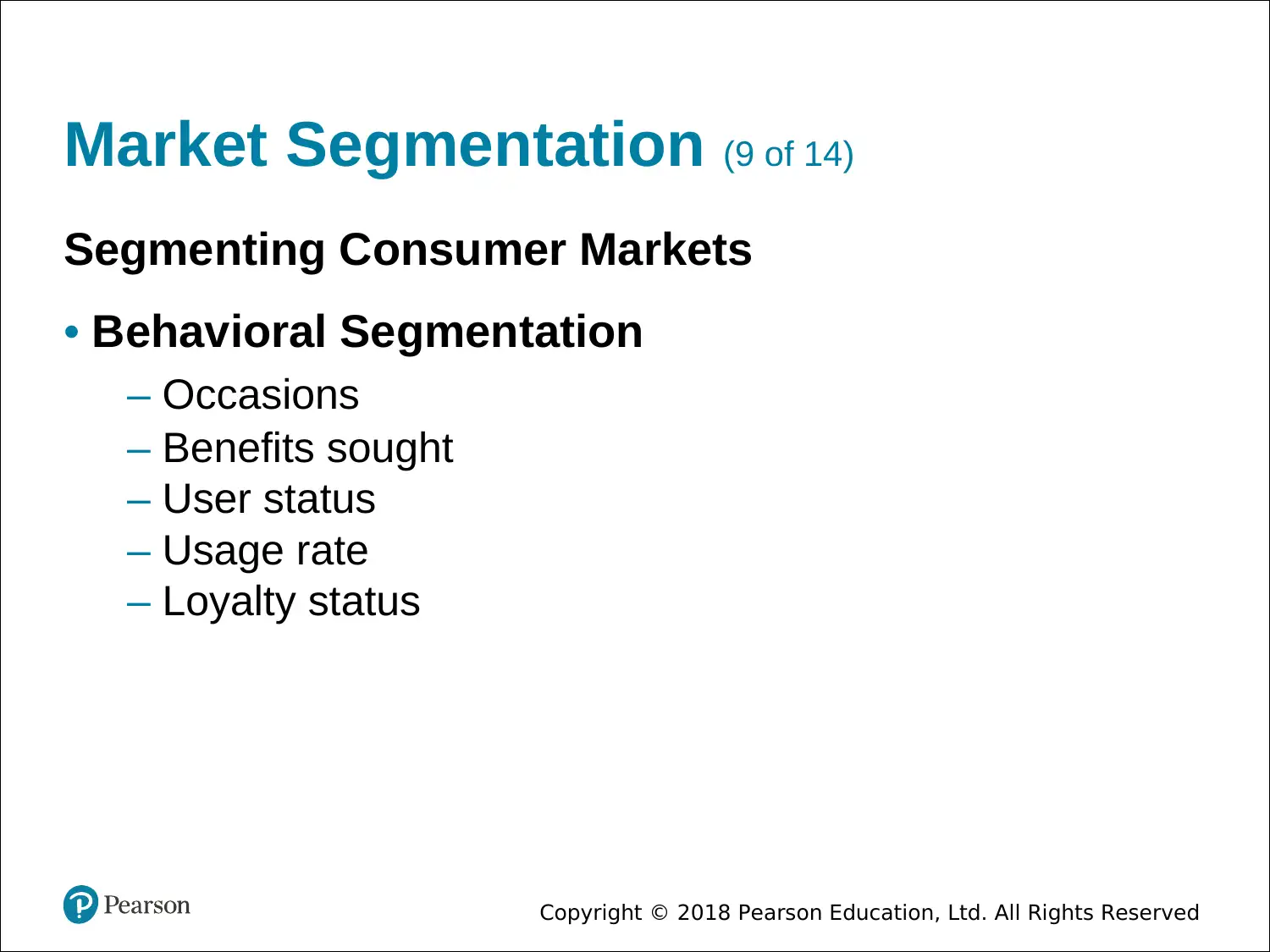
Copyright © 2018 Pearson Education, Ltd. All Rights Reserved
Market Segmentation (9 of 14)
Segmenting Consumer Markets
• Behavioral Segmentation
– Occasions
– Benefits sought
– User status
– Usage rate
– Loyalty status
Market Segmentation (9 of 14)
Segmenting Consumer Markets
• Behavioral Segmentation
– Occasions
– Benefits sought
– User status
– Usage rate
– Loyalty status
Paraphrase This Document
Need a fresh take? Get an instant paraphrase of this document with our AI Paraphraser
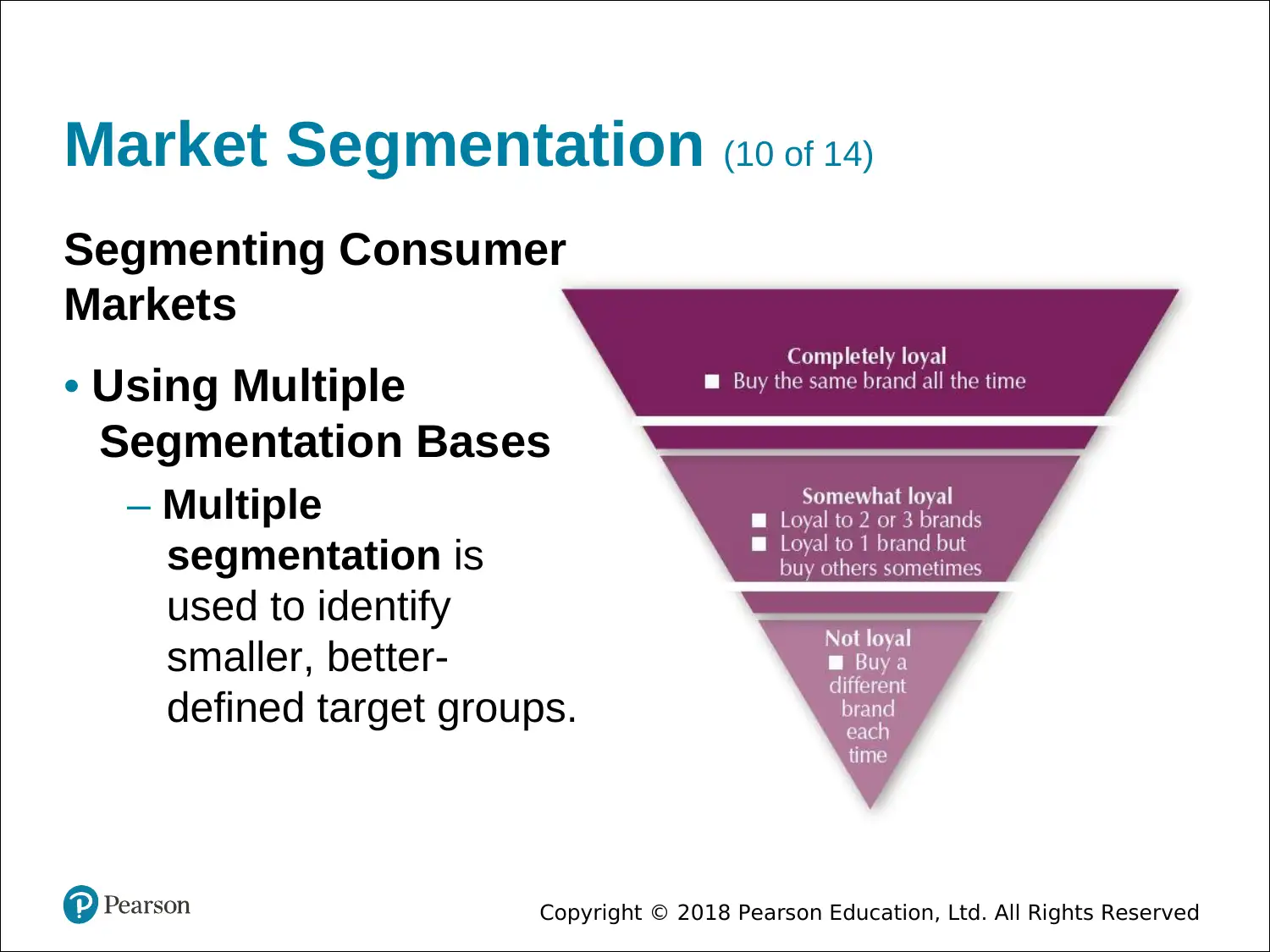
Copyright © 2018 Pearson Education, Ltd. All Rights Reserved
Market Segmentation (10 of 14)
Segmenting Consumer
Markets
• Using Multiple
Segmentation Bases
– Multiple
segmentation is
used to identify
smaller, better-
defined target groups.
Market Segmentation (10 of 14)
Segmenting Consumer
Markets
• Using Multiple
Segmentation Bases
– Multiple
segmentation is
used to identify
smaller, better-
defined target groups.
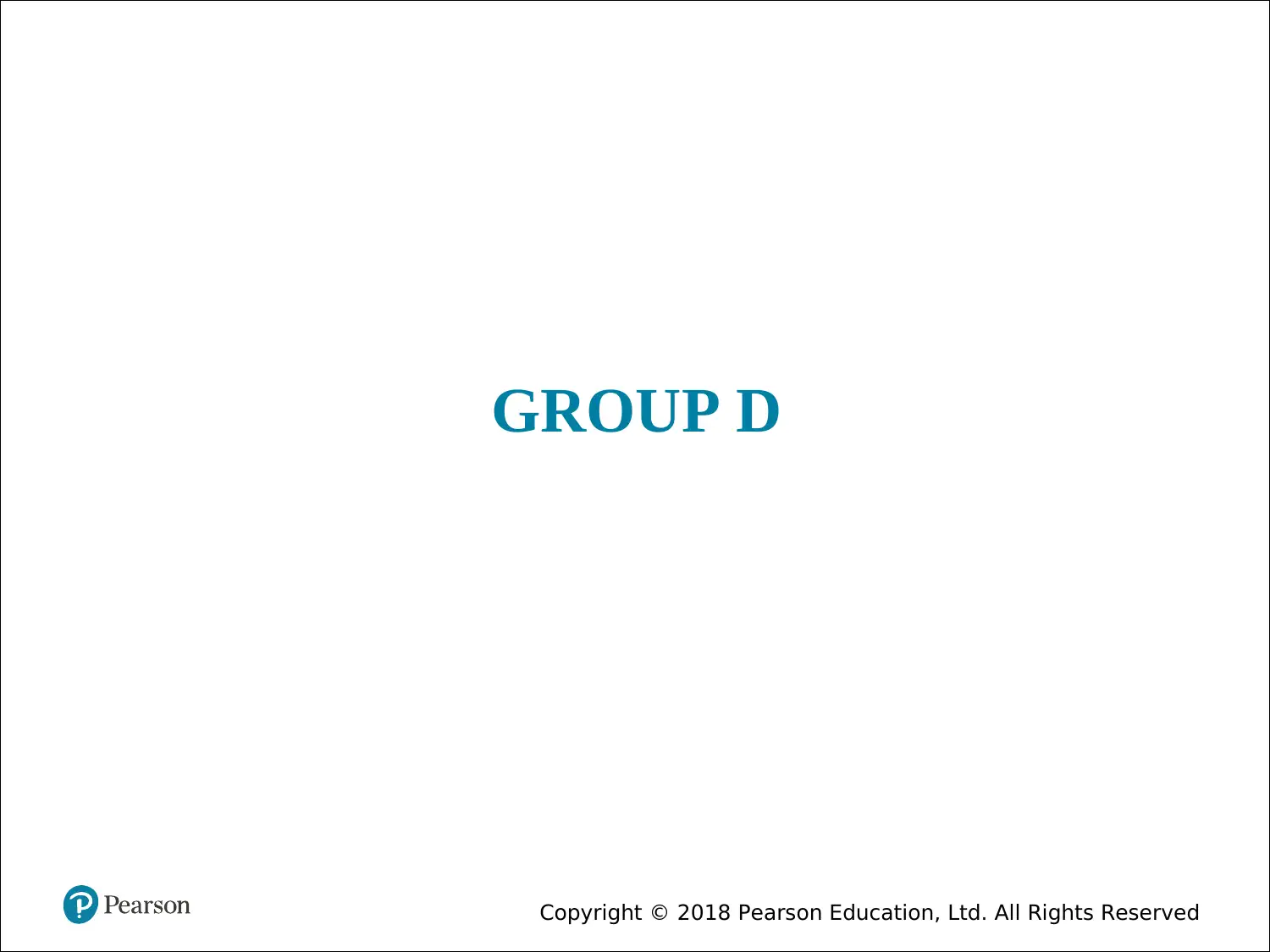
Copyright © 2018 Pearson Education, Ltd. All Rights Reserved
GROUP D
GROUP D
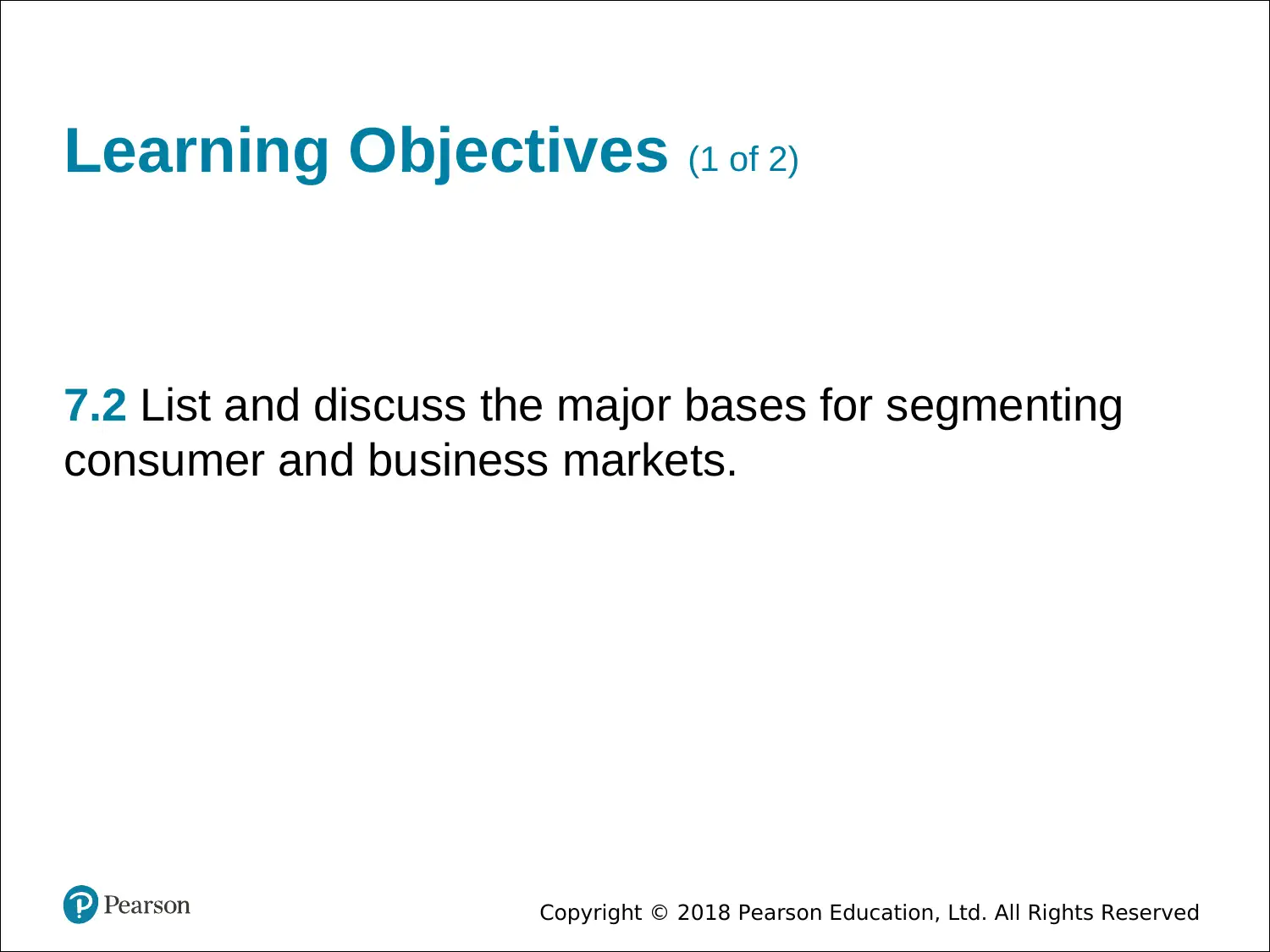
Copyright © 2018 Pearson Education, Ltd. All Rights Reserved
Learning Objectives (1 of 2)
7.2 List and discuss the major bases for segmenting
consumer and business markets.
Learning Objectives (1 of 2)
7.2 List and discuss the major bases for segmenting
consumer and business markets.
Secure Best Marks with AI Grader
Need help grading? Try our AI Grader for instant feedback on your assignments.
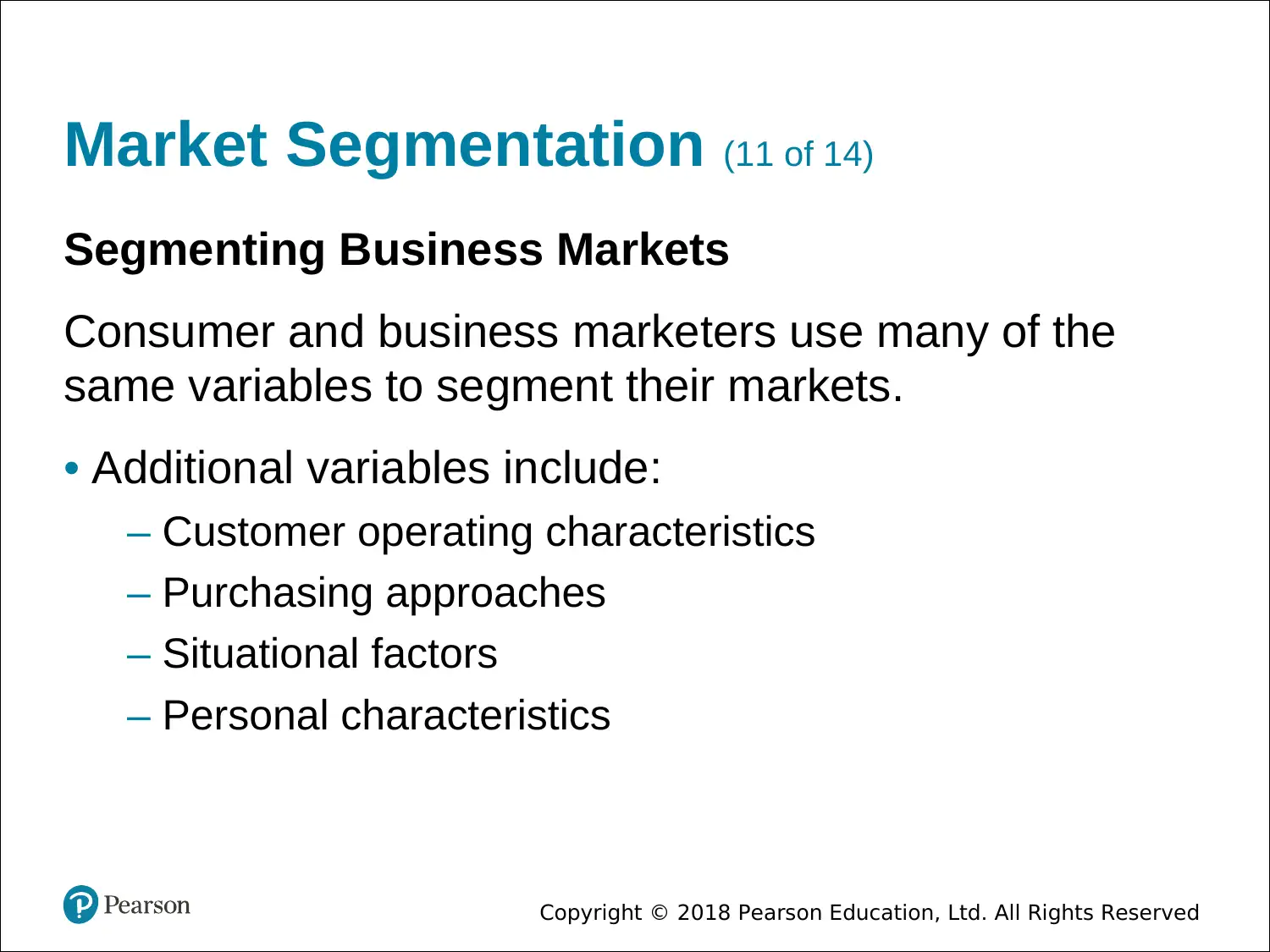
Copyright © 2018 Pearson Education, Ltd. All Rights Reserved
Market Segmentation (11 of 14)
Segmenting Business Markets
Consumer and business marketers use many of the
same variables to segment their markets.
• Additional variables include:
– Customer operating characteristics
– Purchasing approaches
– Situational factors
– Personal characteristics
Market Segmentation (11 of 14)
Segmenting Business Markets
Consumer and business marketers use many of the
same variables to segment their markets.
• Additional variables include:
– Customer operating characteristics
– Purchasing approaches
– Situational factors
– Personal characteristics
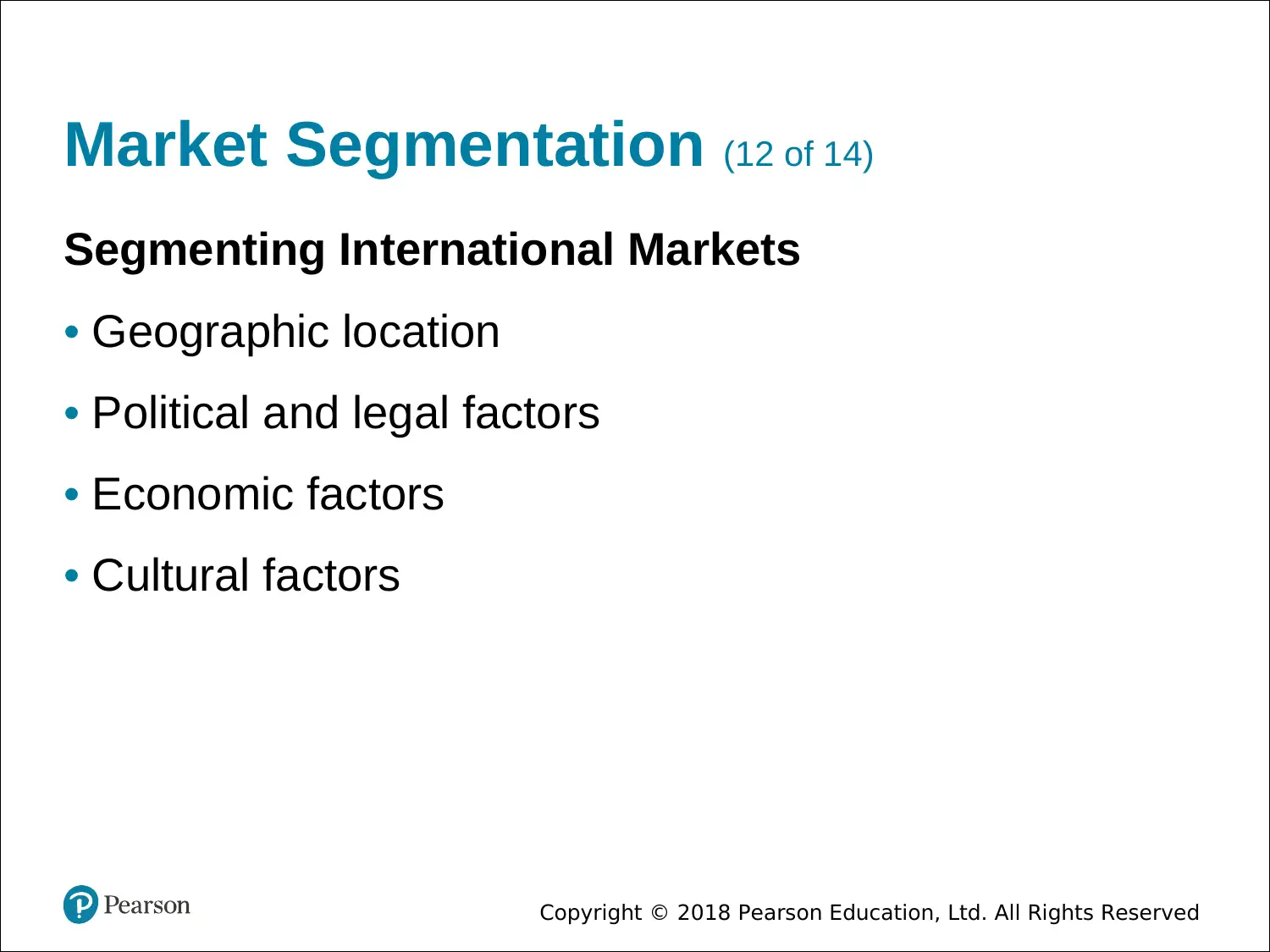
Copyright © 2018 Pearson Education, Ltd. All Rights Reserved
Market Segmentation (12 of 14)
Segmenting International Markets
• Geographic location
• Political and legal factors
• Economic factors
• Cultural factors
Market Segmentation (12 of 14)
Segmenting International Markets
• Geographic location
• Political and legal factors
• Economic factors
• Cultural factors
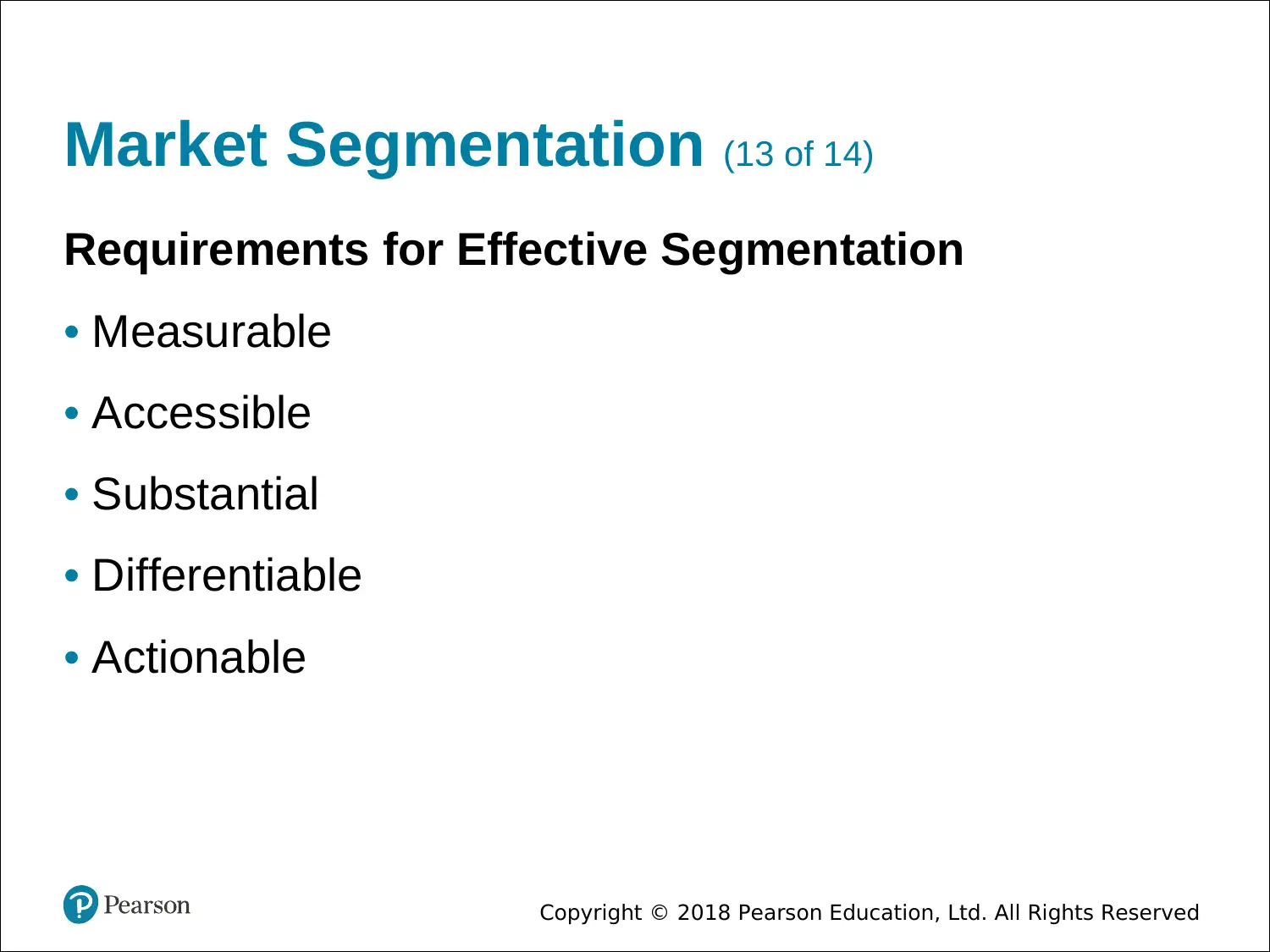
Copyright © 2018 Pearson Education, Ltd. All Rights Reserved
Market Segmentation (13 of 14)
Requirements for Effective Segmentation
• Measurable
• Accessible
• Substantial
• Differentiable
• Actionable
Market Segmentation (13 of 14)
Requirements for Effective Segmentation
• Measurable
• Accessible
• Substantial
• Differentiable
• Actionable
Paraphrase This Document
Need a fresh take? Get an instant paraphrase of this document with our AI Paraphraser
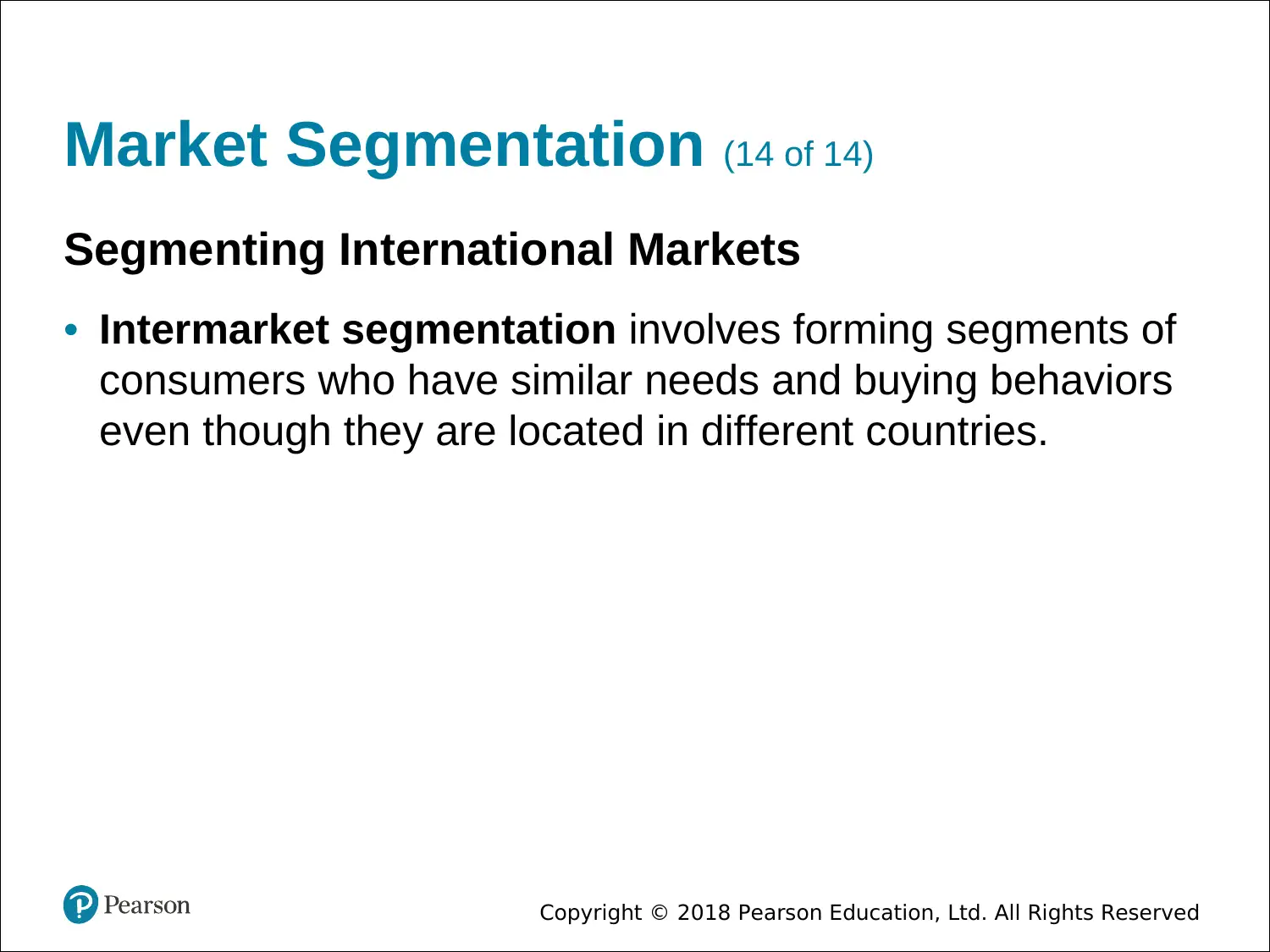
Copyright © 2018 Pearson Education, Ltd. All Rights Reserved
Market Segmentation (14 of 14)
Segmenting International Markets
• Intermarket segmentation involves forming segments of
consumers who have similar needs and buying behaviors
even though they are located in different countries.
Market Segmentation (14 of 14)
Segmenting International Markets
• Intermarket segmentation involves forming segments of
consumers who have similar needs and buying behaviors
even though they are located in different countries.

Copyright © 2018 Pearson Education, Ltd. All Rights Reserved
GROUP E
GROUP E
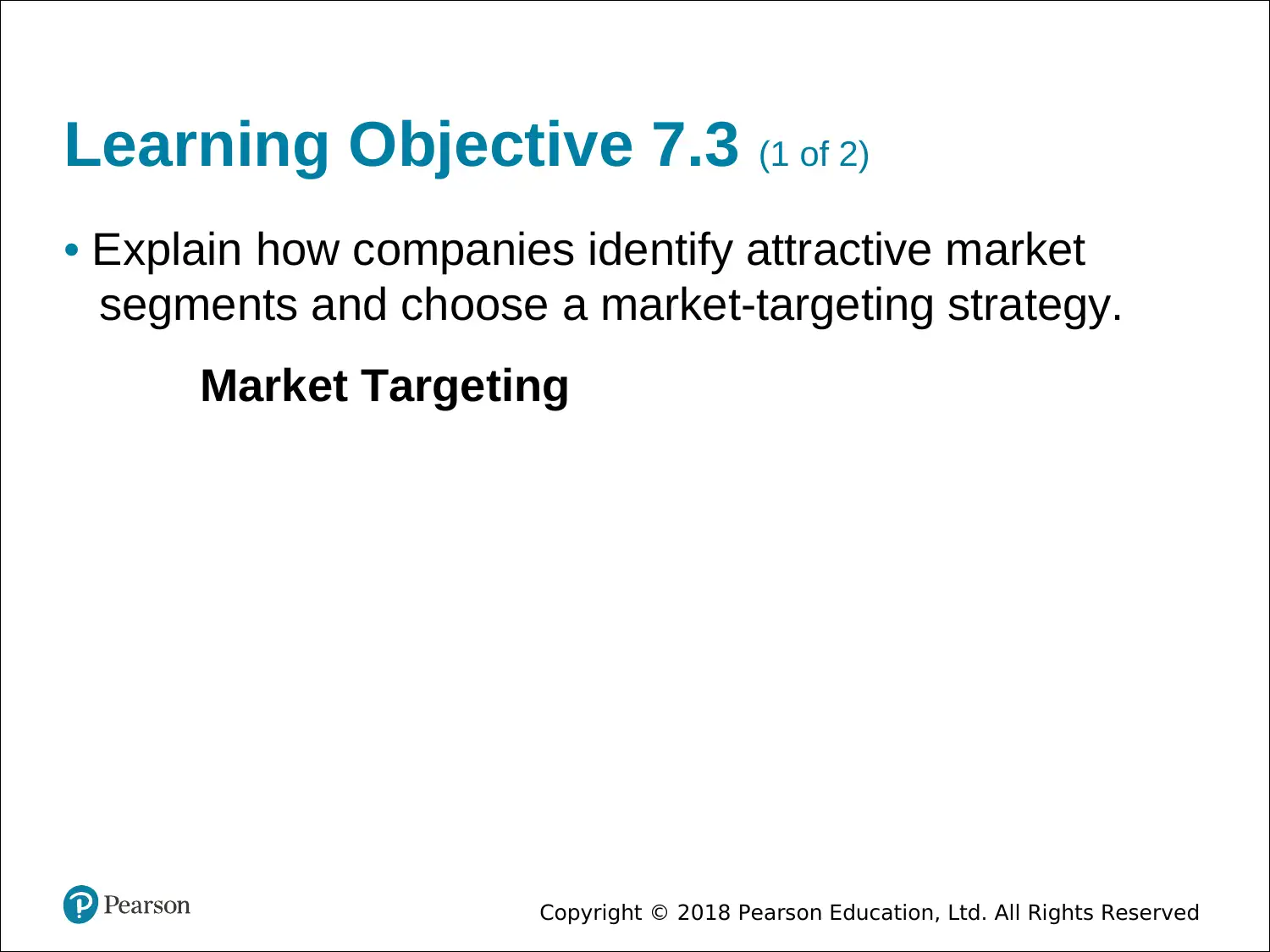
Copyright © 2018 Pearson Education, Ltd. All Rights Reserved
Learning Objective 7.3 (1 of 2)
• Explain how companies identify attractive market
segments and choose a market-targeting strategy.
Market Targeting
Learning Objective 7.3 (1 of 2)
• Explain how companies identify attractive market
segments and choose a market-targeting strategy.
Market Targeting
Secure Best Marks with AI Grader
Need help grading? Try our AI Grader for instant feedback on your assignments.
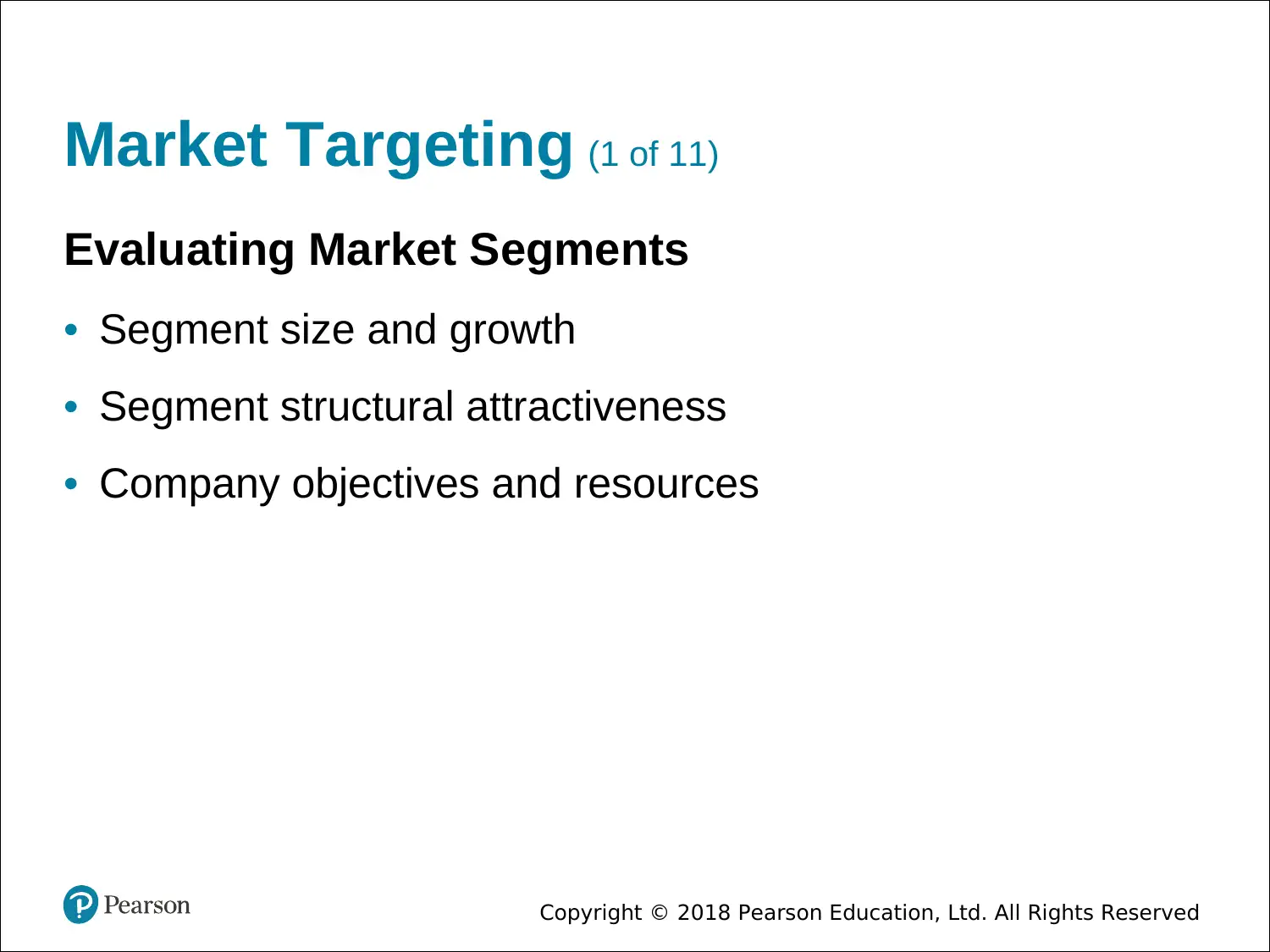
Copyright © 2018 Pearson Education, Ltd. All Rights Reserved
Market Targeting (1 of 11)
Evaluating Market Segments
• Segment size and growth
• Segment structural attractiveness
• Company objectives and resources
Market Targeting (1 of 11)
Evaluating Market Segments
• Segment size and growth
• Segment structural attractiveness
• Company objectives and resources

Copyright © 2018 Pearson Education, Ltd. All Rights Reserved
GROUP F
GROUP F
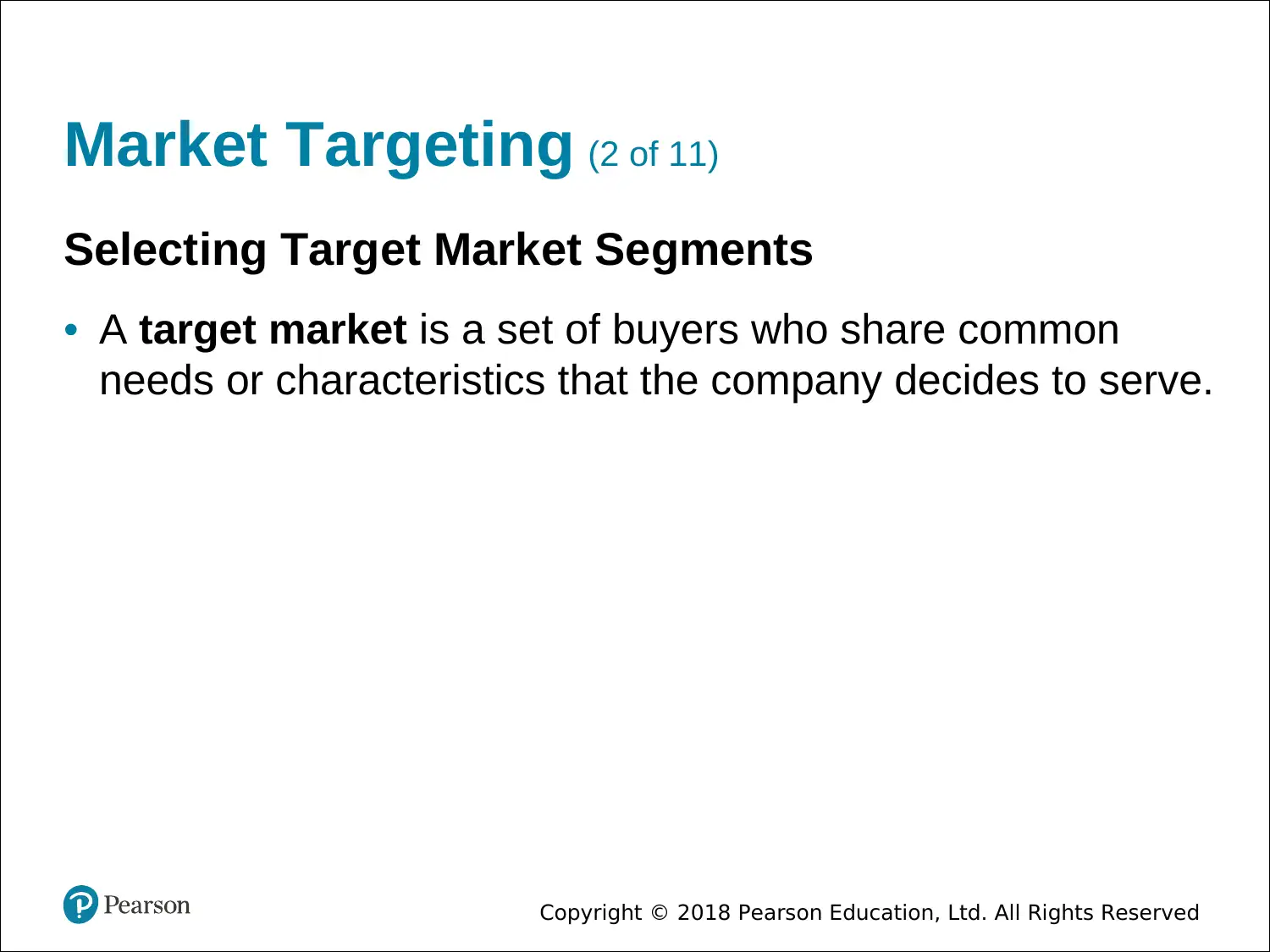
Copyright © 2018 Pearson Education, Ltd. All Rights Reserved
Market Targeting (2 of 11)
Selecting Target Market Segments
• A target market is a set of buyers who share common
needs or characteristics that the company decides to serve.
Market Targeting (2 of 11)
Selecting Target Market Segments
• A target market is a set of buyers who share common
needs or characteristics that the company decides to serve.
Paraphrase This Document
Need a fresh take? Get an instant paraphrase of this document with our AI Paraphraser
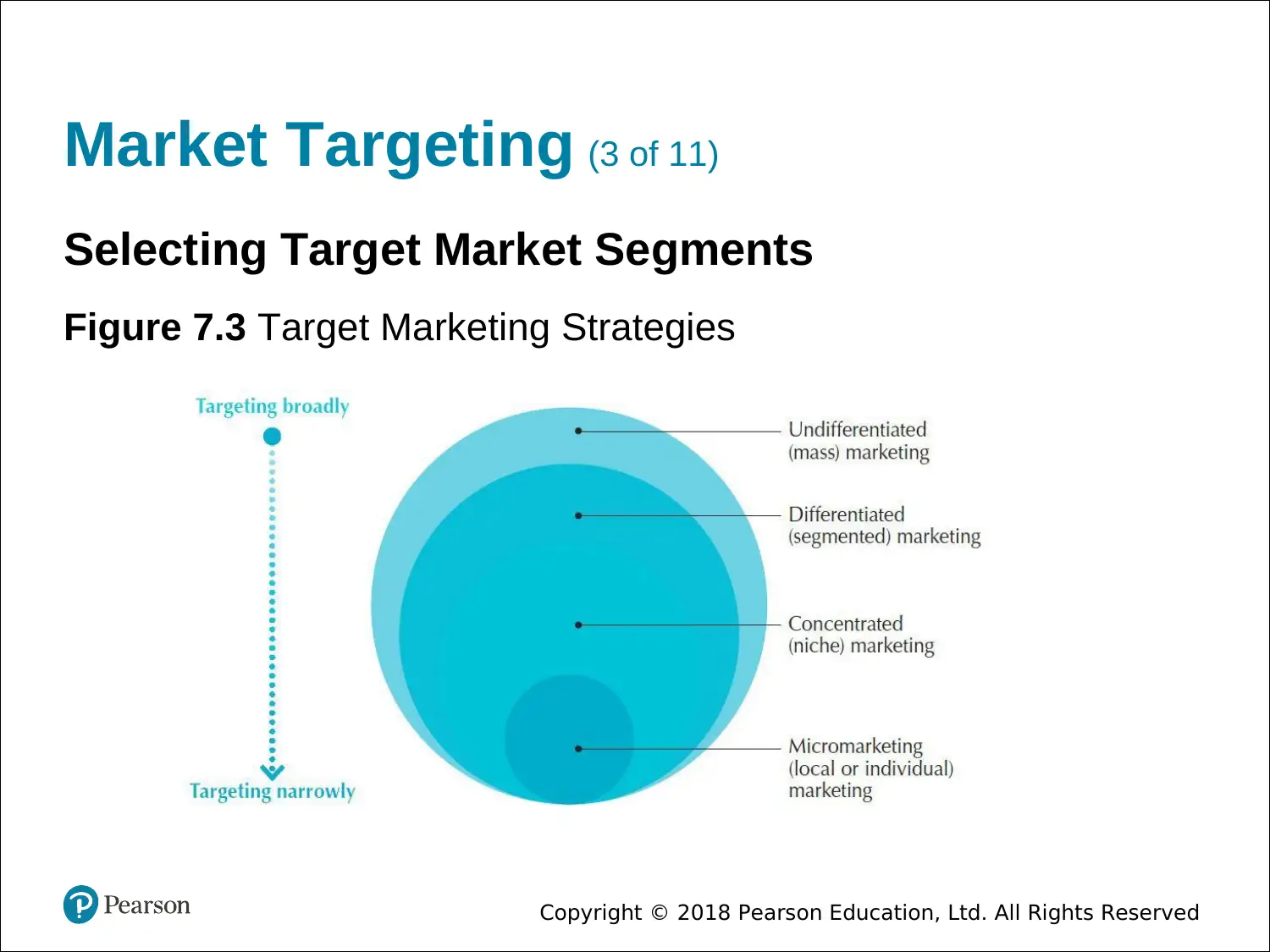
Copyright © 2018 Pearson Education, Ltd. All Rights Reserved
Market Targeting (3 of 11)
Selecting Target Market Segments
Figure 7.3 Target Marketing Strategies
Market Targeting (3 of 11)
Selecting Target Market Segments
Figure 7.3 Target Marketing Strategies
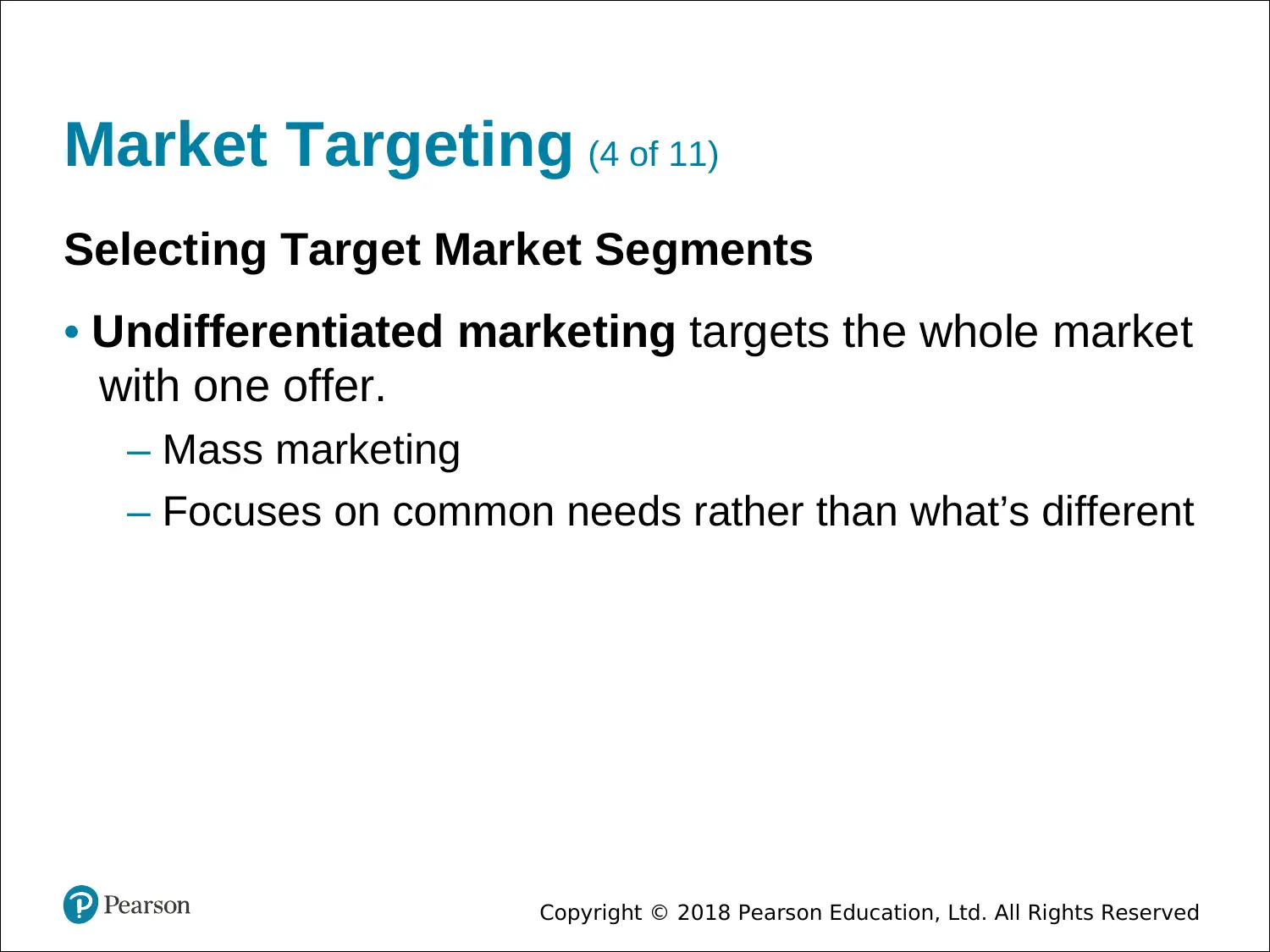
Copyright © 2018 Pearson Education, Ltd. All Rights Reserved
Market Targeting (4 of 11)
Selecting Target Market Segments
• Undifferentiated marketing targets the whole market
with one offer.
– Mass marketing
– Focuses on common needs rather than what’s different
Market Targeting (4 of 11)
Selecting Target Market Segments
• Undifferentiated marketing targets the whole market
with one offer.
– Mass marketing
– Focuses on common needs rather than what’s different
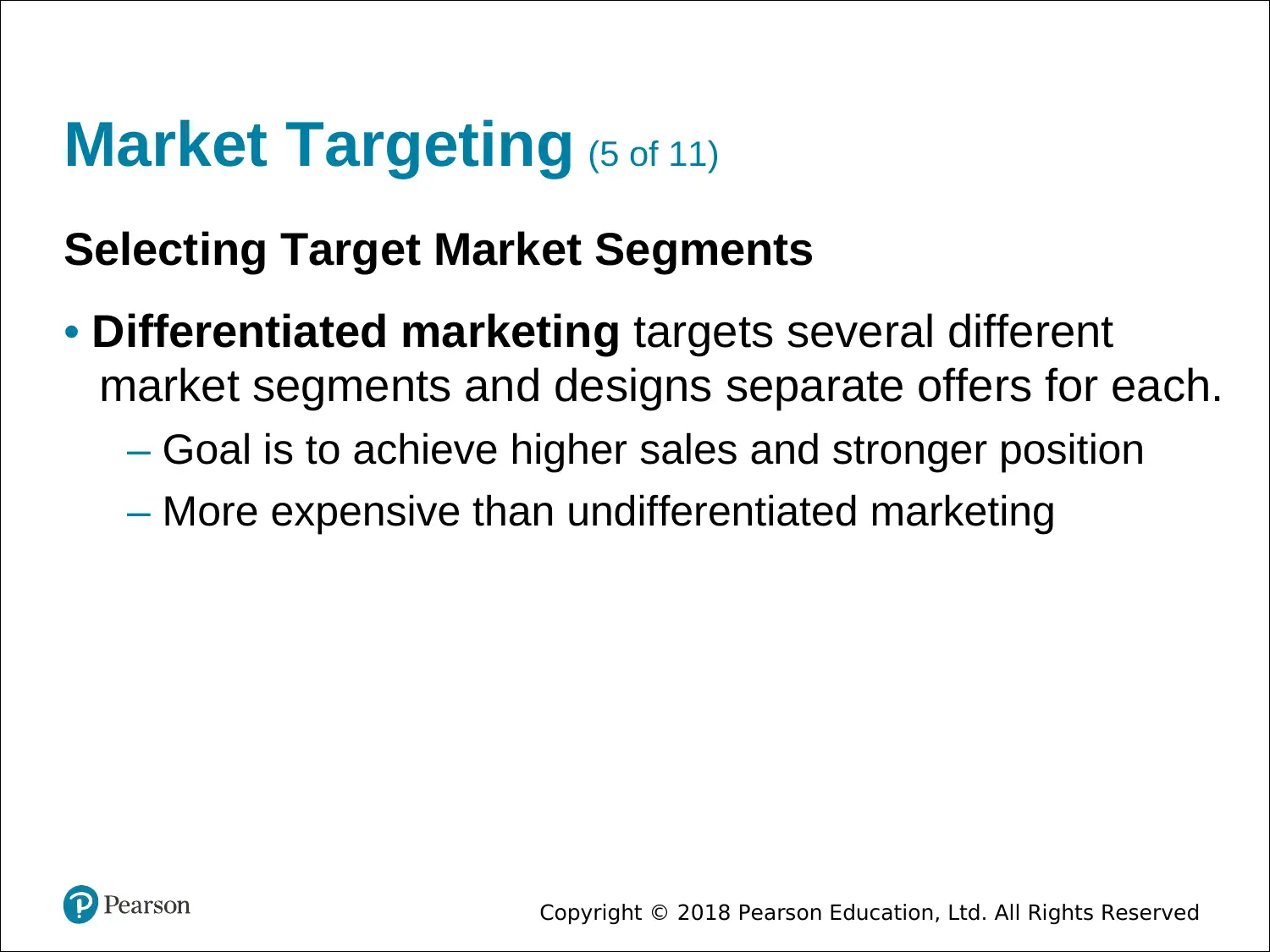
Copyright © 2018 Pearson Education, Ltd. All Rights Reserved
Market Targeting (5 of 11)
Selecting Target Market Segments
• Differentiated marketing targets several different
market segments and designs separate offers for each.
– Goal is to achieve higher sales and stronger position
– More expensive than undifferentiated marketing
Market Targeting (5 of 11)
Selecting Target Market Segments
• Differentiated marketing targets several different
market segments and designs separate offers for each.
– Goal is to achieve higher sales and stronger position
– More expensive than undifferentiated marketing
Secure Best Marks with AI Grader
Need help grading? Try our AI Grader for instant feedback on your assignments.
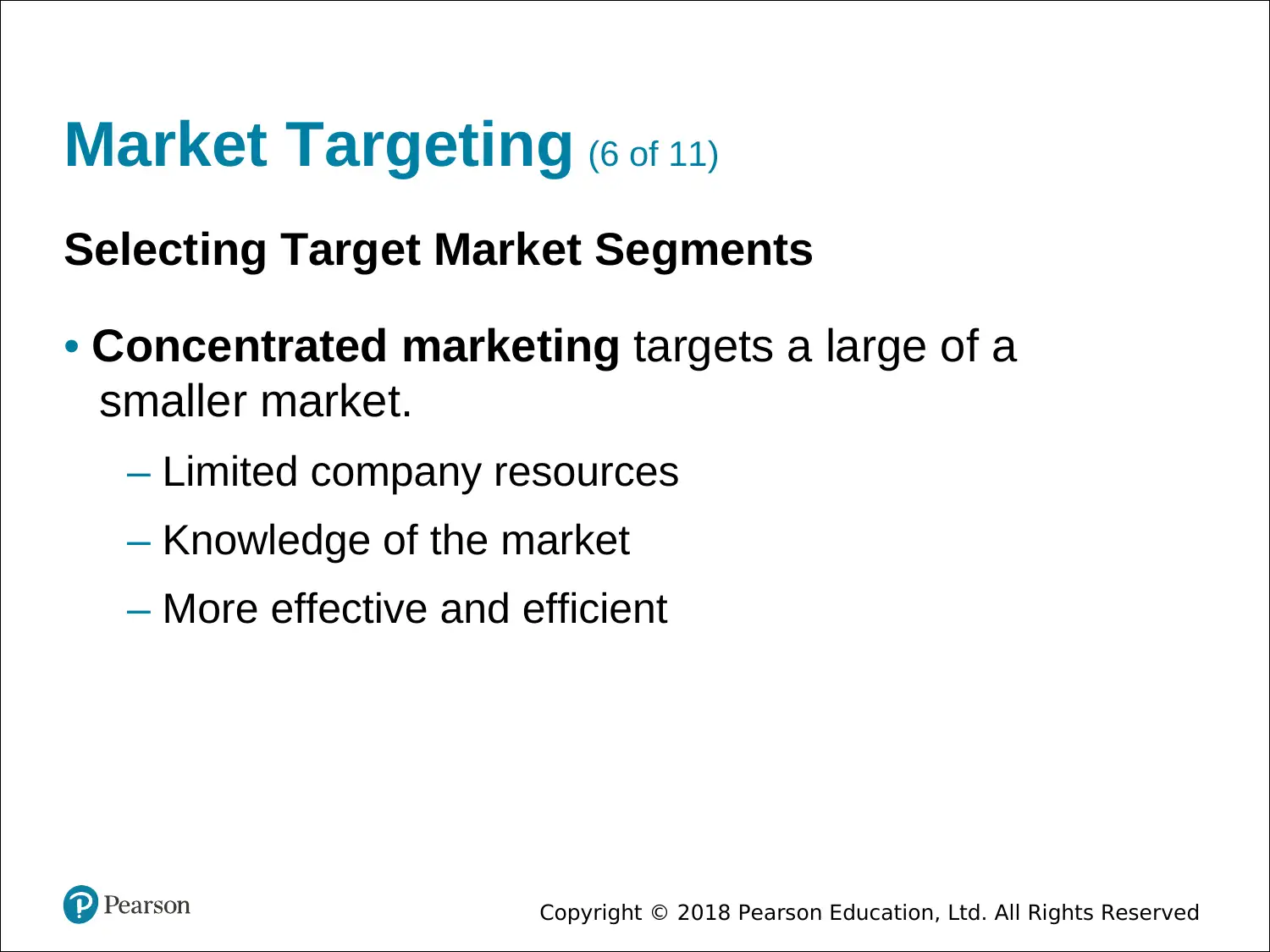
Copyright © 2018 Pearson Education, Ltd. All Rights Reserved
Market Targeting (6 of 11)
Selecting Target Market Segments
• Concentrated marketing targets a large of a
smaller market.
– Limited company resources
– Knowledge of the market
– More effective and efficient
Market Targeting (6 of 11)
Selecting Target Market Segments
• Concentrated marketing targets a large of a
smaller market.
– Limited company resources
– Knowledge of the market
– More effective and efficient
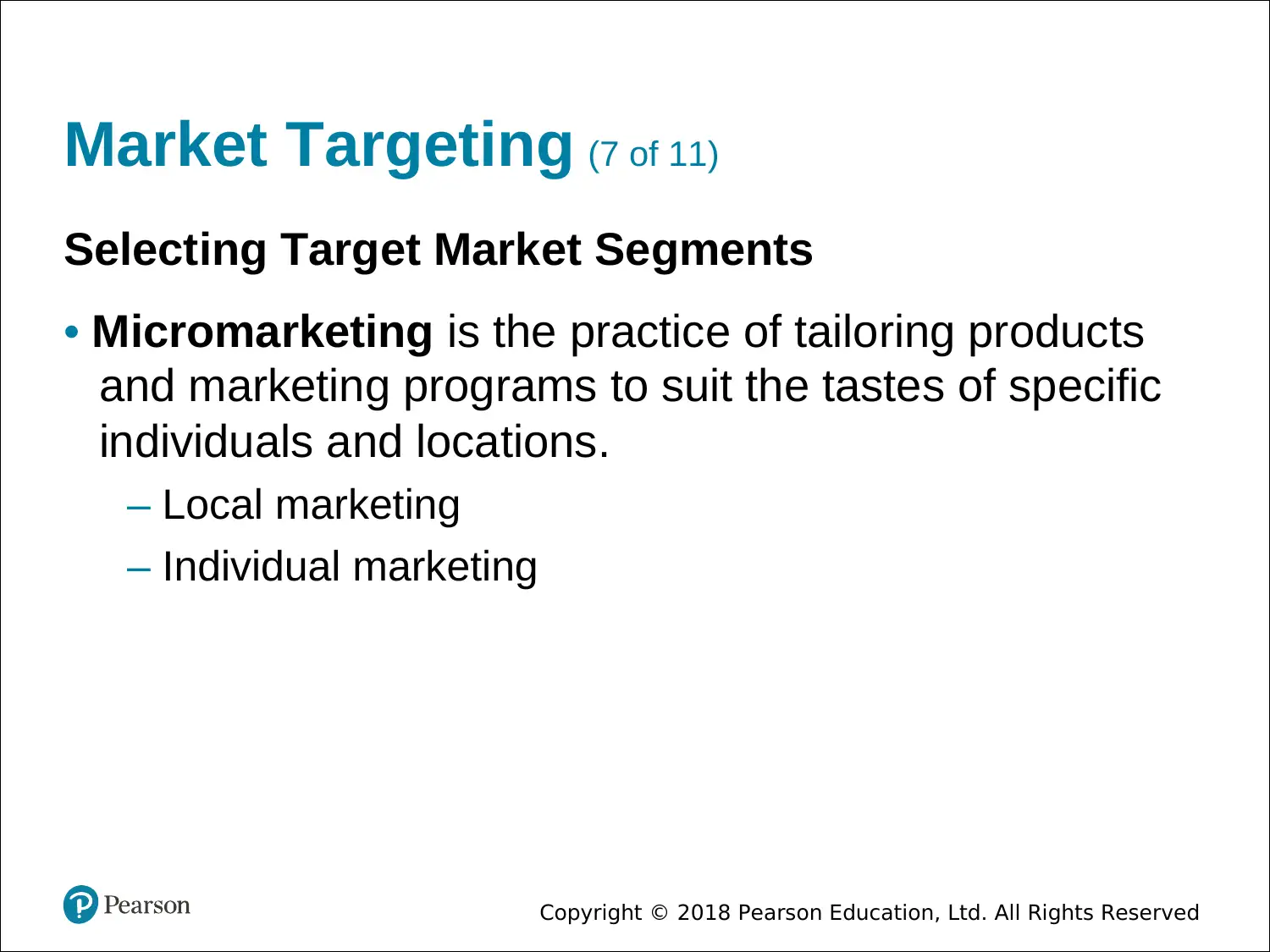
Copyright © 2018 Pearson Education, Ltd. All Rights Reserved
Market Targeting (7 of 11)
Selecting Target Market Segments
• Micromarketing is the practice of tailoring products
and marketing programs to suit the tastes of specific
individuals and locations.
– Local marketing
– Individual marketing
Market Targeting (7 of 11)
Selecting Target Market Segments
• Micromarketing is the practice of tailoring products
and marketing programs to suit the tastes of specific
individuals and locations.
– Local marketing
– Individual marketing

Copyright © 2018 Pearson Education, Ltd. All Rights Reserved
GROUP G
GROUP G
Paraphrase This Document
Need a fresh take? Get an instant paraphrase of this document with our AI Paraphraser
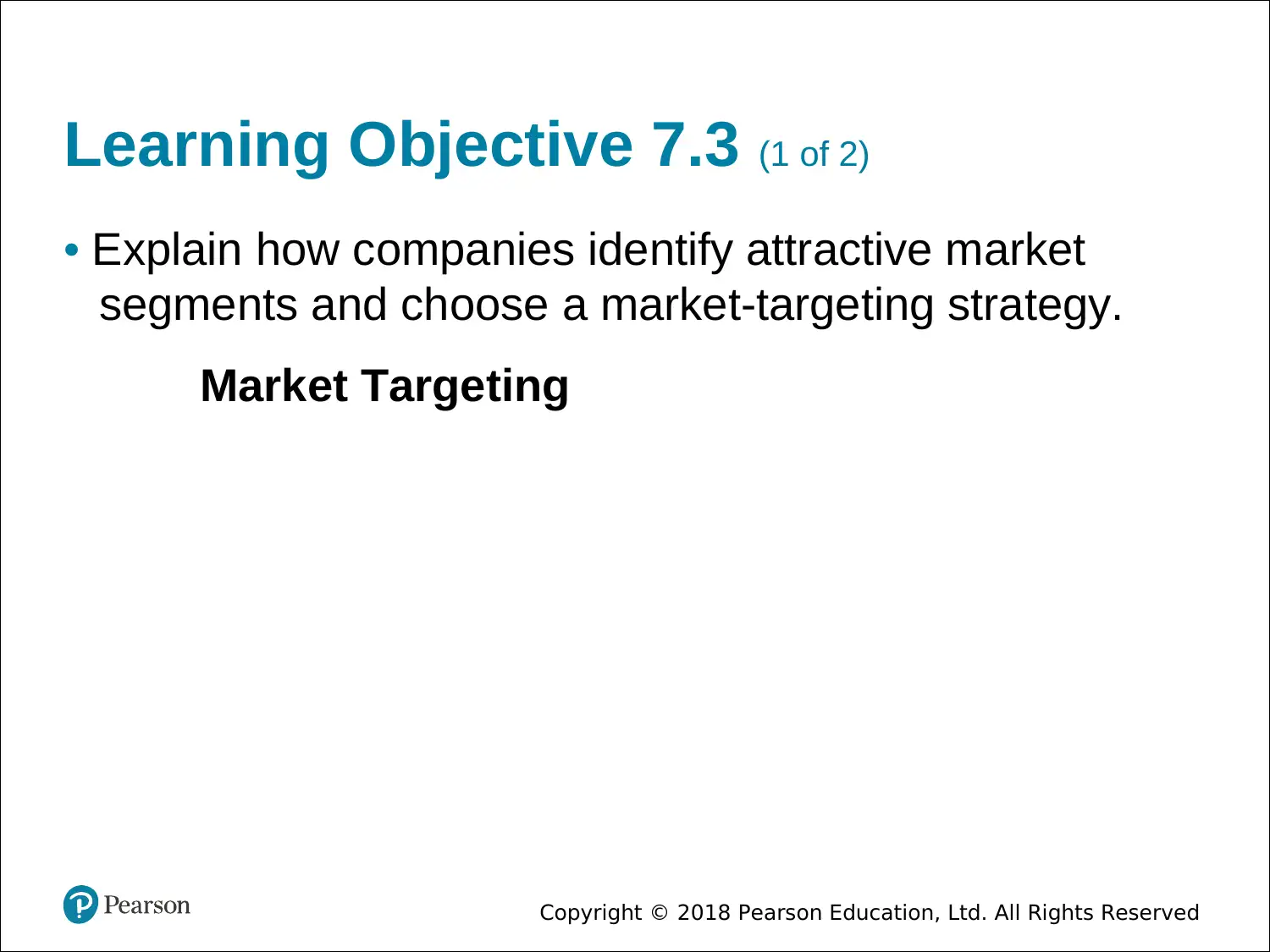
Copyright © 2018 Pearson Education, Ltd. All Rights Reserved
Learning Objective 7.3 (1 of 2)
• Explain how companies identify attractive market
segments and choose a market-targeting strategy.
Market Targeting
Learning Objective 7.3 (1 of 2)
• Explain how companies identify attractive market
segments and choose a market-targeting strategy.
Market Targeting
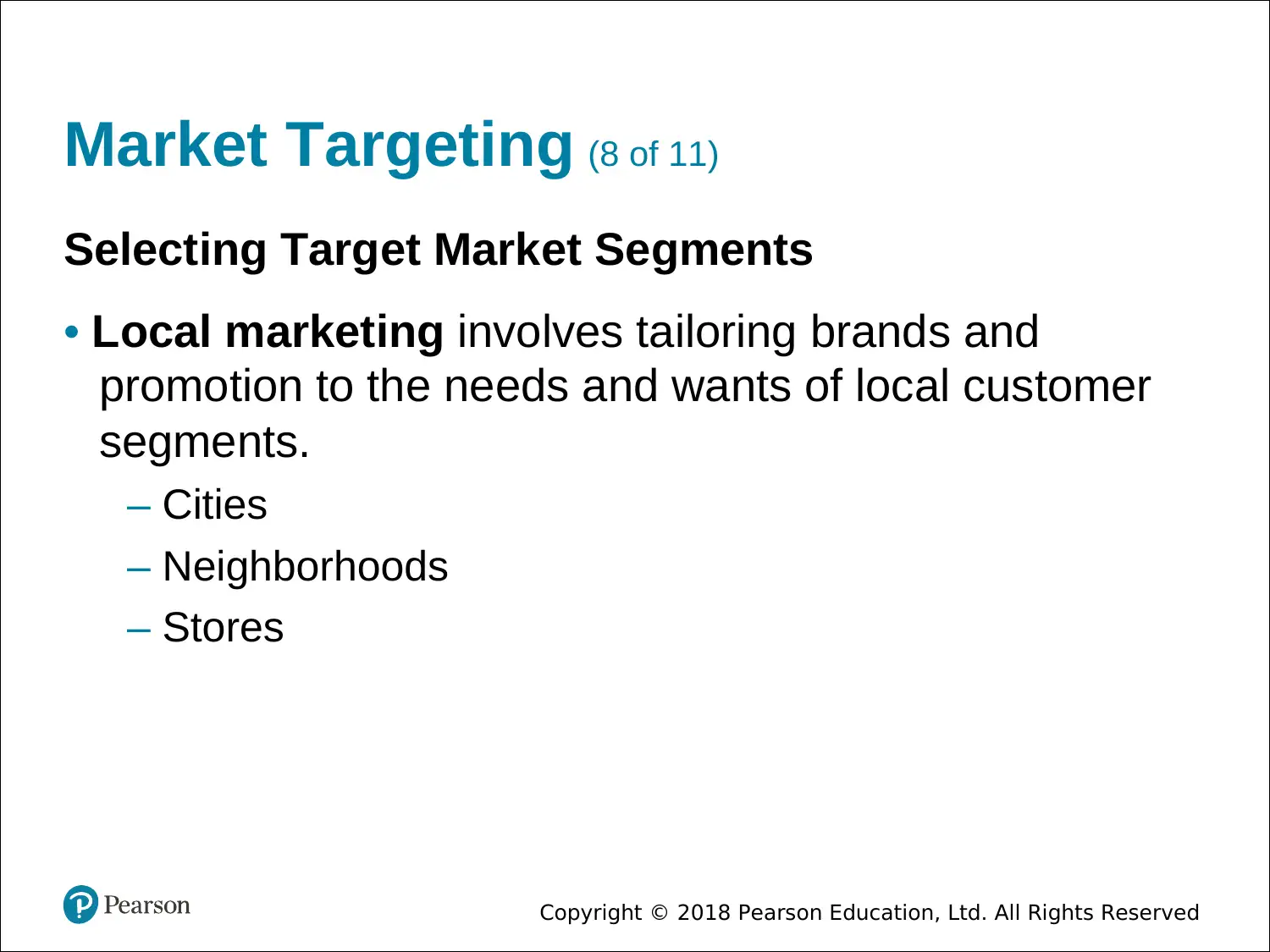
Copyright © 2018 Pearson Education, Ltd. All Rights Reserved
Market Targeting (8 of 11)
Selecting Target Market Segments
• Local marketing involves tailoring brands and
promotion to the needs and wants of local customer
segments.
– Cities
– Neighborhoods
– Stores
Market Targeting (8 of 11)
Selecting Target Market Segments
• Local marketing involves tailoring brands and
promotion to the needs and wants of local customer
segments.
– Cities
– Neighborhoods
– Stores
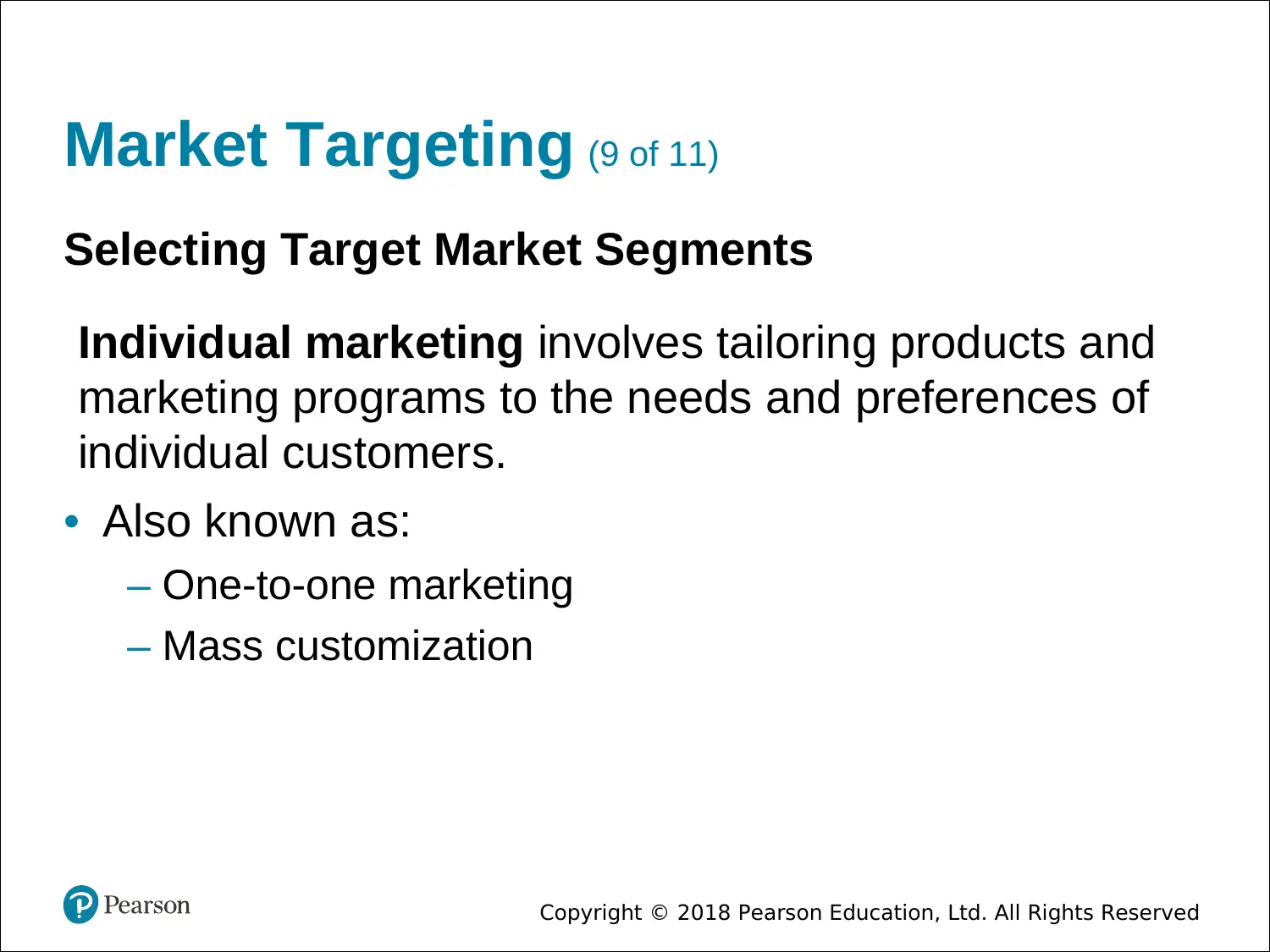
Copyright © 2018 Pearson Education, Ltd. All Rights Reserved
Market Targeting (9 of 11)
Selecting Target Market Segments
Individual marketing involves tailoring products and
marketing programs to the needs and preferences of
individual customers.
• Also known as:
– One-to-one marketing
– Mass customization
Market Targeting (9 of 11)
Selecting Target Market Segments
Individual marketing involves tailoring products and
marketing programs to the needs and preferences of
individual customers.
• Also known as:
– One-to-one marketing
– Mass customization
Secure Best Marks with AI Grader
Need help grading? Try our AI Grader for instant feedback on your assignments.
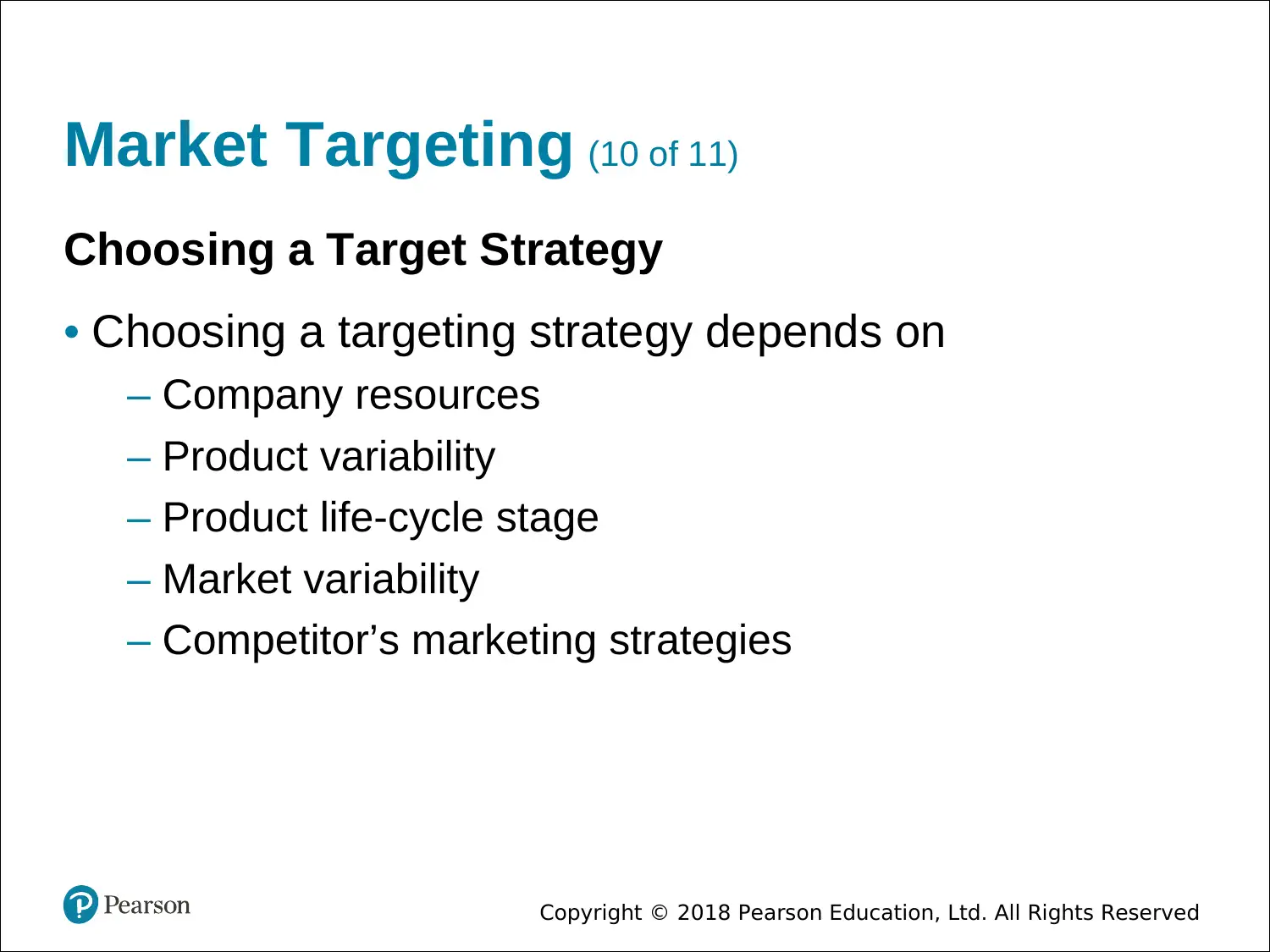
Copyright © 2018 Pearson Education, Ltd. All Rights Reserved
Market Targeting (10 of 11)
Choosing a Target Strategy
• Choosing a targeting strategy depends on
– Company resources
– Product variability
– Product life-cycle stage
– Market variability
– Competitor’s marketing strategies
Market Targeting (10 of 11)
Choosing a Target Strategy
• Choosing a targeting strategy depends on
– Company resources
– Product variability
– Product life-cycle stage
– Market variability
– Competitor’s marketing strategies
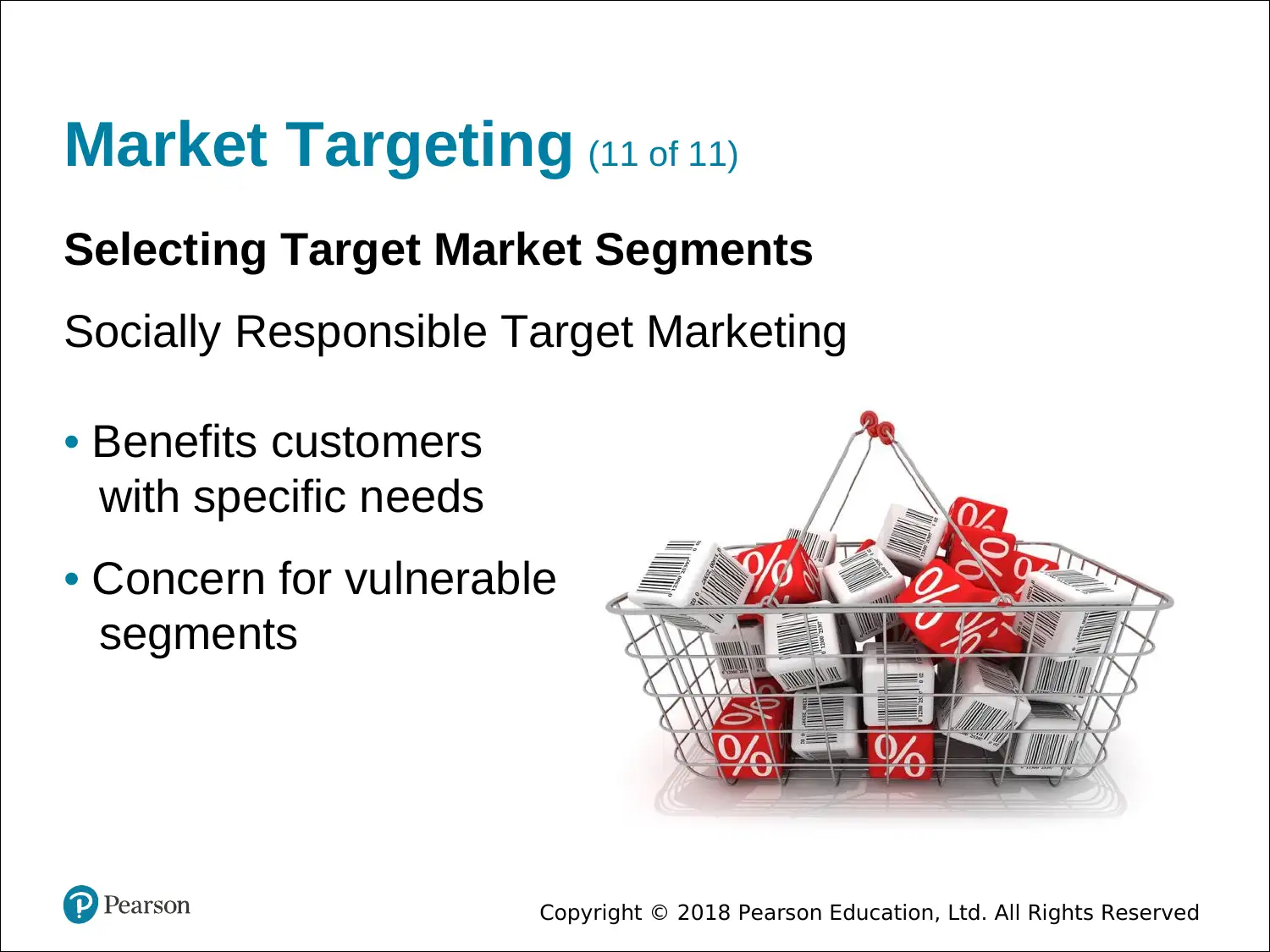
Copyright © 2018 Pearson Education, Ltd. All Rights Reserved
Market Targeting (11 of 11)
Selecting Target Market Segments
Socially Responsible Target Marketing
• Benefits customers
with specific needs
• Concern for vulnerable
segments
Market Targeting (11 of 11)
Selecting Target Market Segments
Socially Responsible Target Marketing
• Benefits customers
with specific needs
• Concern for vulnerable
segments

Copyright © 2018 Pearson Education, Ltd. All Rights Reserved
GROUP H
GROUP H
Paraphrase This Document
Need a fresh take? Get an instant paraphrase of this document with our AI Paraphraser
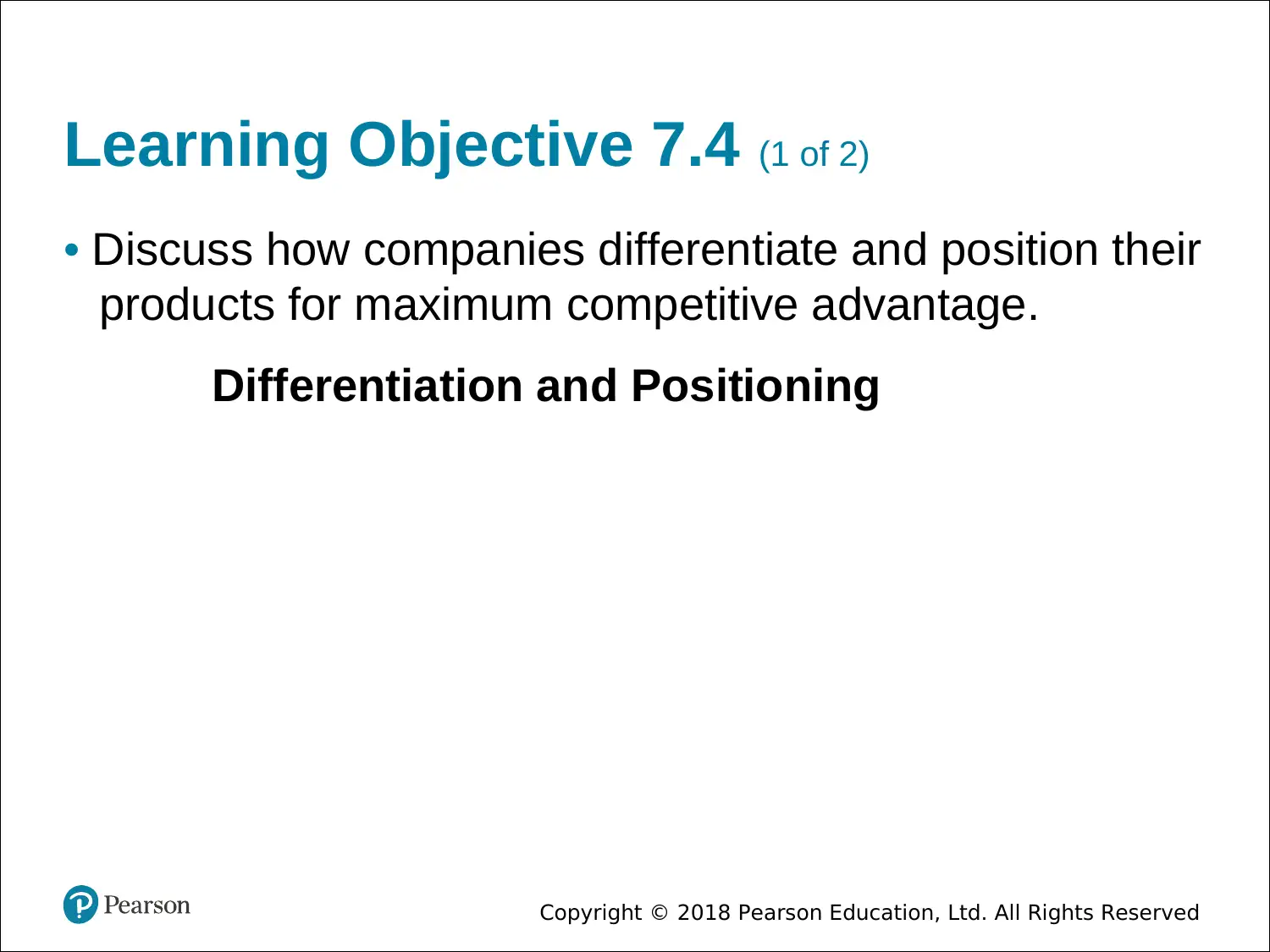
Copyright © 2018 Pearson Education, Ltd. All Rights Reserved
Learning Objective 7.4 (1 of 2)
• Discuss how companies differentiate and position their
products for maximum competitive advantage.
Differentiation and Positioning
Learning Objective 7.4 (1 of 2)
• Discuss how companies differentiate and position their
products for maximum competitive advantage.
Differentiation and Positioning
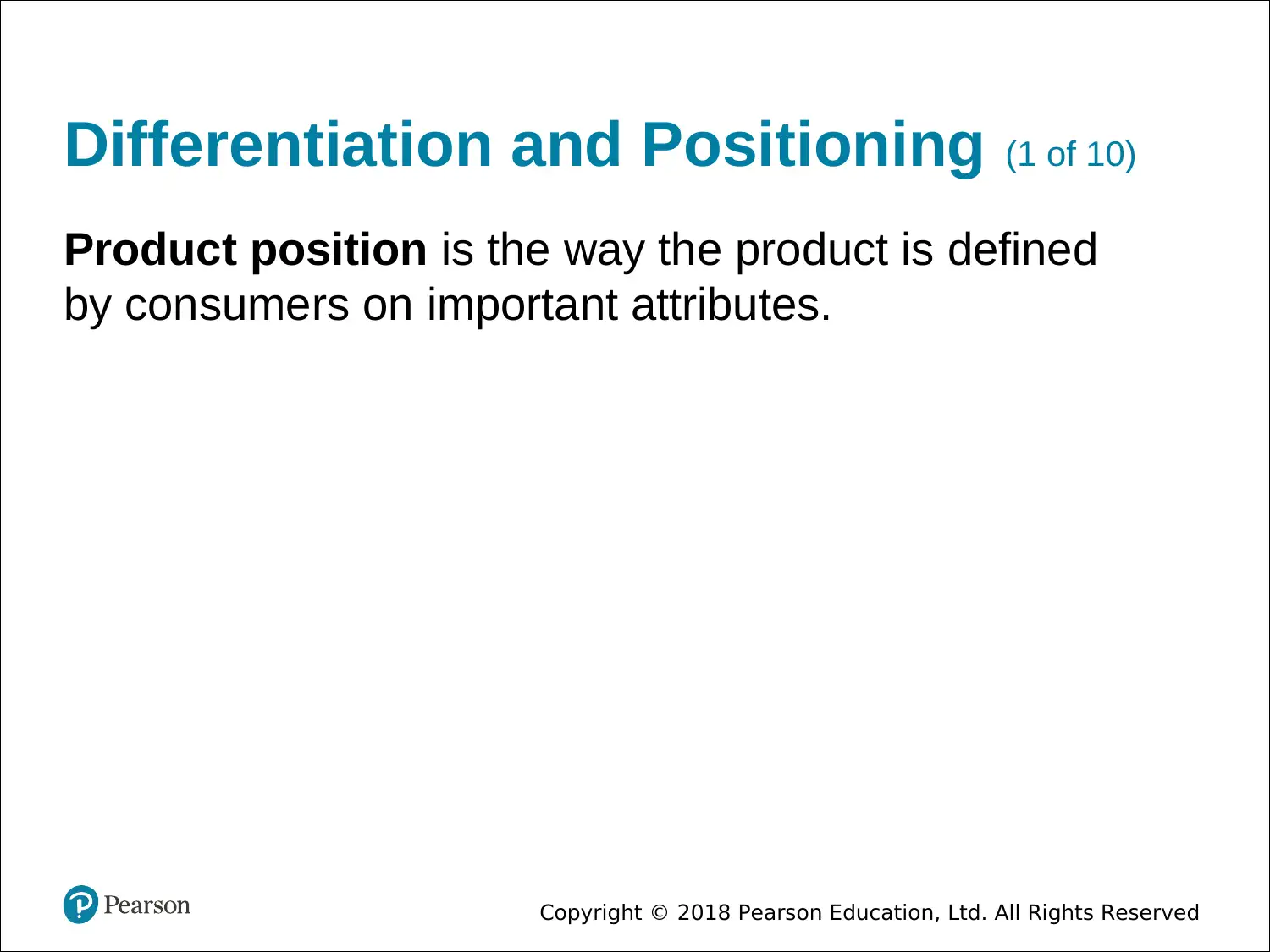
Copyright © 2018 Pearson Education, Ltd. All Rights Reserved
Differentiation and Positioning (1 of 10)
Product position is the way the product is defined
by consumers on important attributes.
Differentiation and Positioning (1 of 10)
Product position is the way the product is defined
by consumers on important attributes.
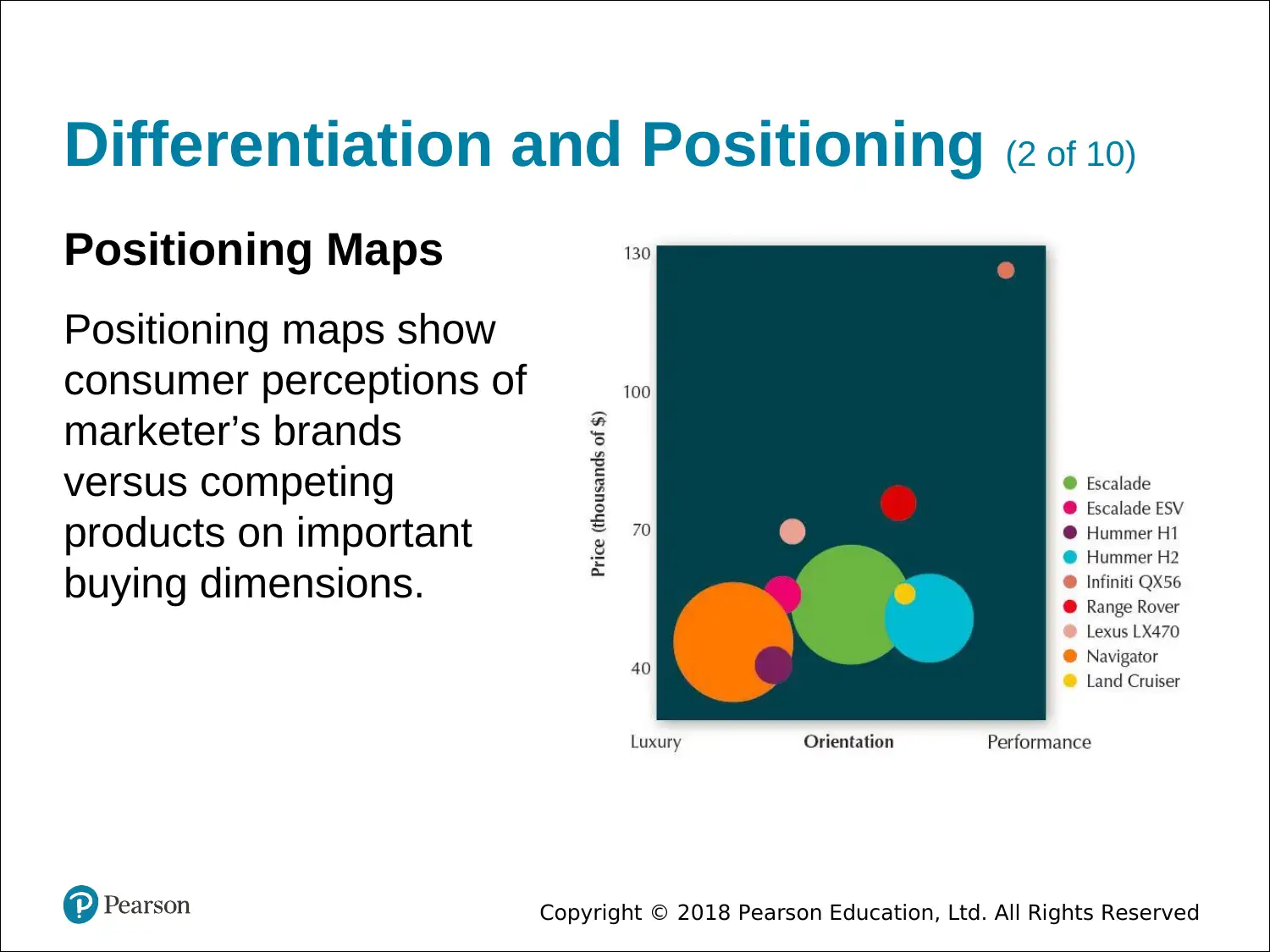
Copyright © 2018 Pearson Education, Ltd. All Rights Reserved
Differentiation and Positioning (2 of 10)
Positioning Maps
Positioning maps show
consumer perceptions of
marketer’s brands
versus competing
products on important
buying dimensions.
Differentiation and Positioning (2 of 10)
Positioning Maps
Positioning maps show
consumer perceptions of
marketer’s brands
versus competing
products on important
buying dimensions.
Secure Best Marks with AI Grader
Need help grading? Try our AI Grader for instant feedback on your assignments.
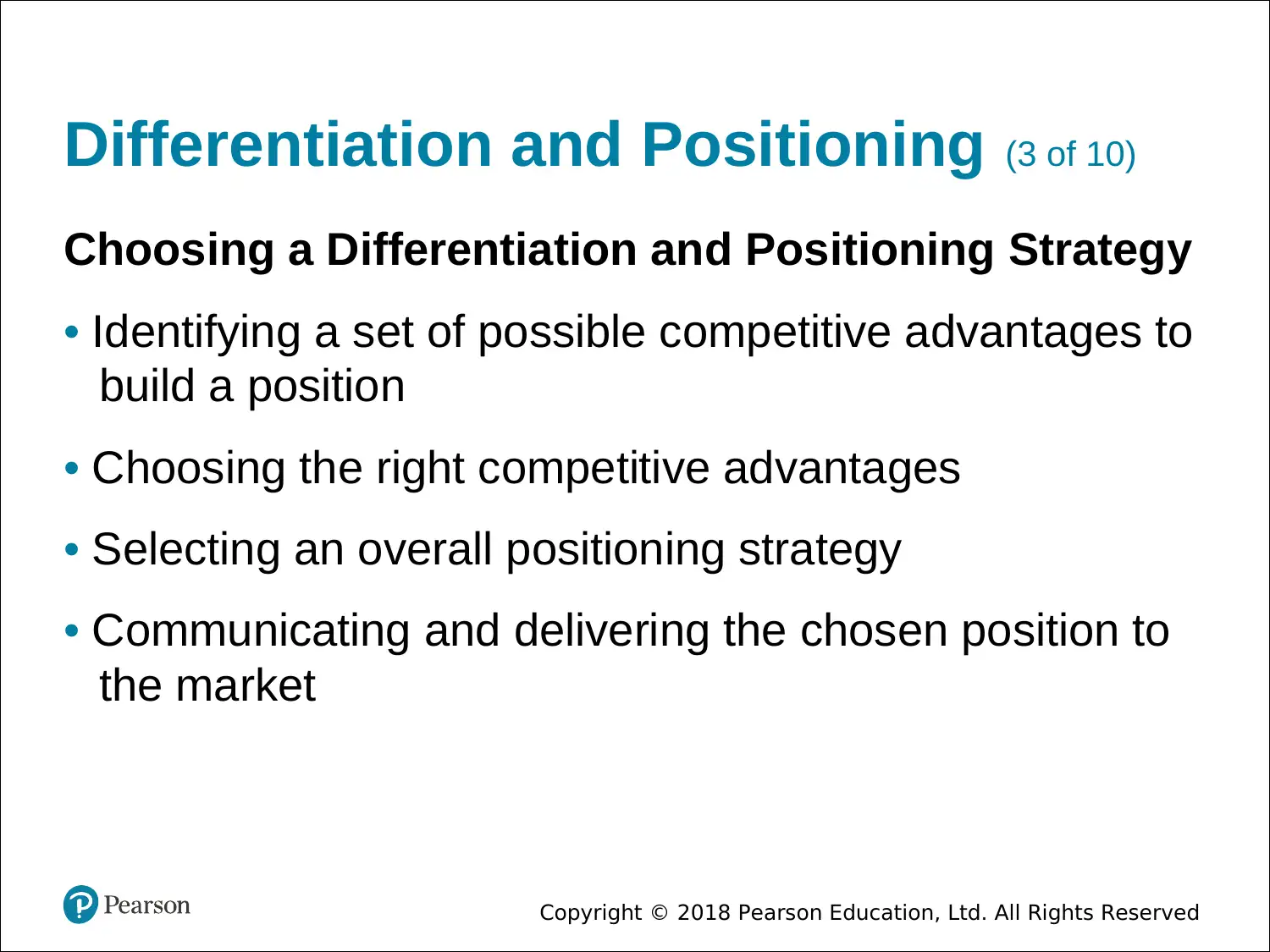
Copyright © 2018 Pearson Education, Ltd. All Rights Reserved
Differentiation and Positioning (3 of 10)
Choosing a Differentiation and Positioning Strategy
• Identifying a set of possible competitive advantages to
build a position
• Choosing the right competitive advantages
• Selecting an overall positioning strategy
• Communicating and delivering the chosen position to
the market
Differentiation and Positioning (3 of 10)
Choosing a Differentiation and Positioning Strategy
• Identifying a set of possible competitive advantages to
build a position
• Choosing the right competitive advantages
• Selecting an overall positioning strategy
• Communicating and delivering the chosen position to
the market
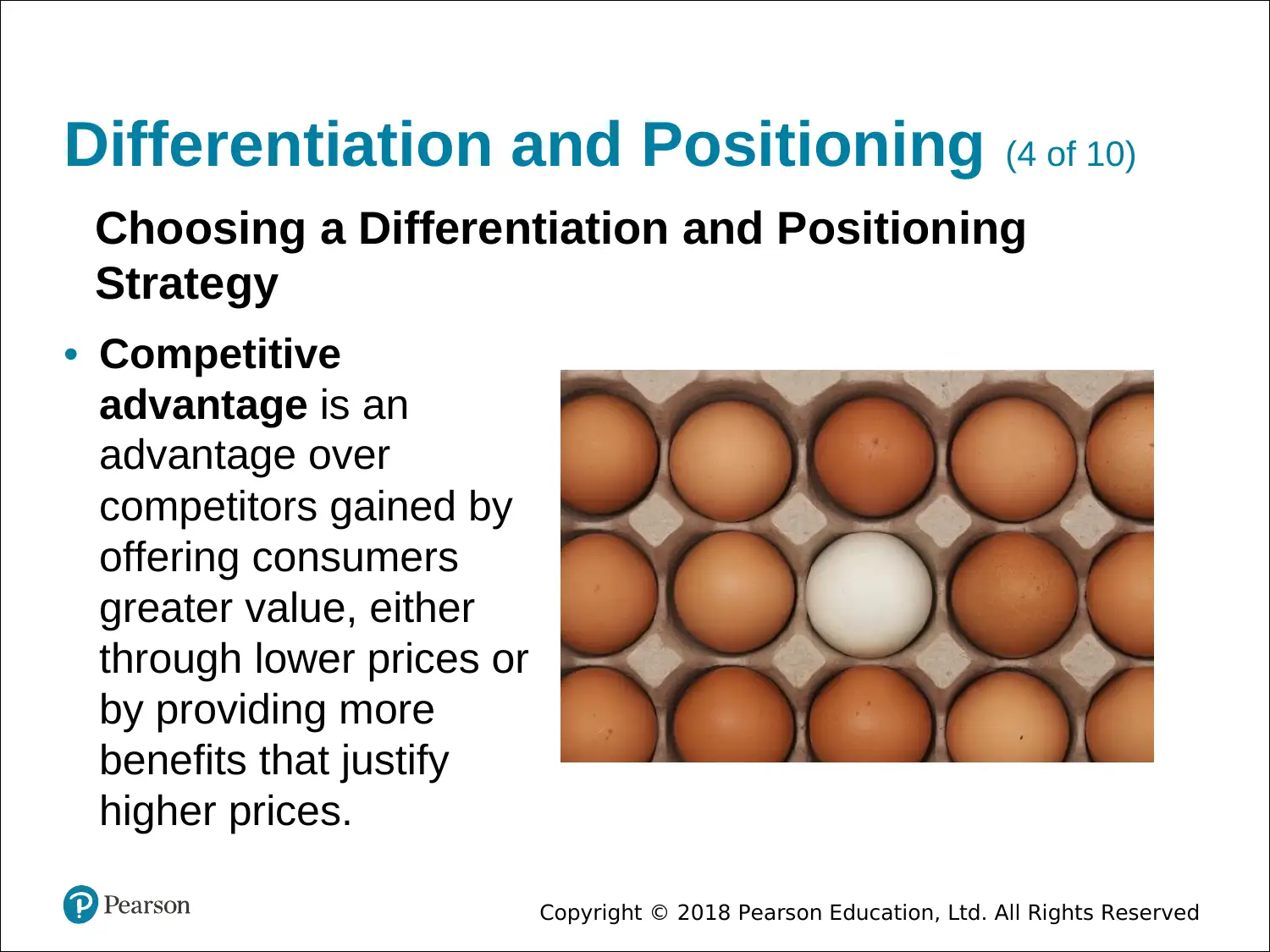
Copyright © 2018 Pearson Education, Ltd. All Rights Reserved
Differentiation and Positioning (4 of 10)
• Competitive
advantage is an
advantage over
competitors gained by
offering consumers
greater value, either
through lower prices or
by providing more
benefits that justify
higher prices.
Choosing a Differentiation and Positioning
Strategy
Differentiation and Positioning (4 of 10)
• Competitive
advantage is an
advantage over
competitors gained by
offering consumers
greater value, either
through lower prices or
by providing more
benefits that justify
higher prices.
Choosing a Differentiation and Positioning
Strategy
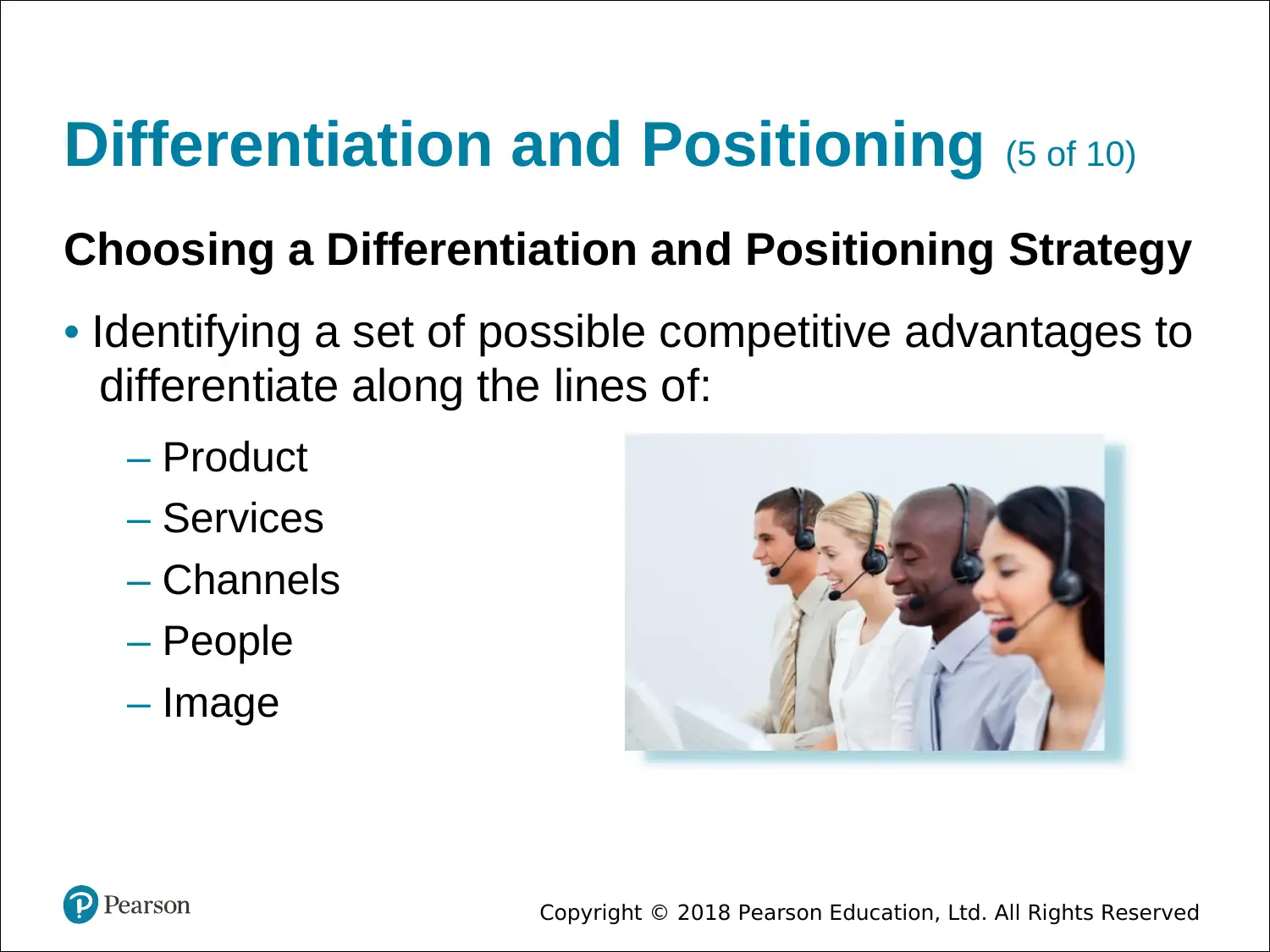
Copyright © 2018 Pearson Education, Ltd. All Rights Reserved
Differentiation and Positioning (5 of 10)
Choosing a Differentiation and Positioning Strategy
• Identifying a set of possible competitive advantages to
differentiate along the lines of:
– Product
– Services
– Channels
– People
– Image
Differentiation and Positioning (5 of 10)
Choosing a Differentiation and Positioning Strategy
• Identifying a set of possible competitive advantages to
differentiate along the lines of:
– Product
– Services
– Channels
– People
– Image
Paraphrase This Document
Need a fresh take? Get an instant paraphrase of this document with our AI Paraphraser
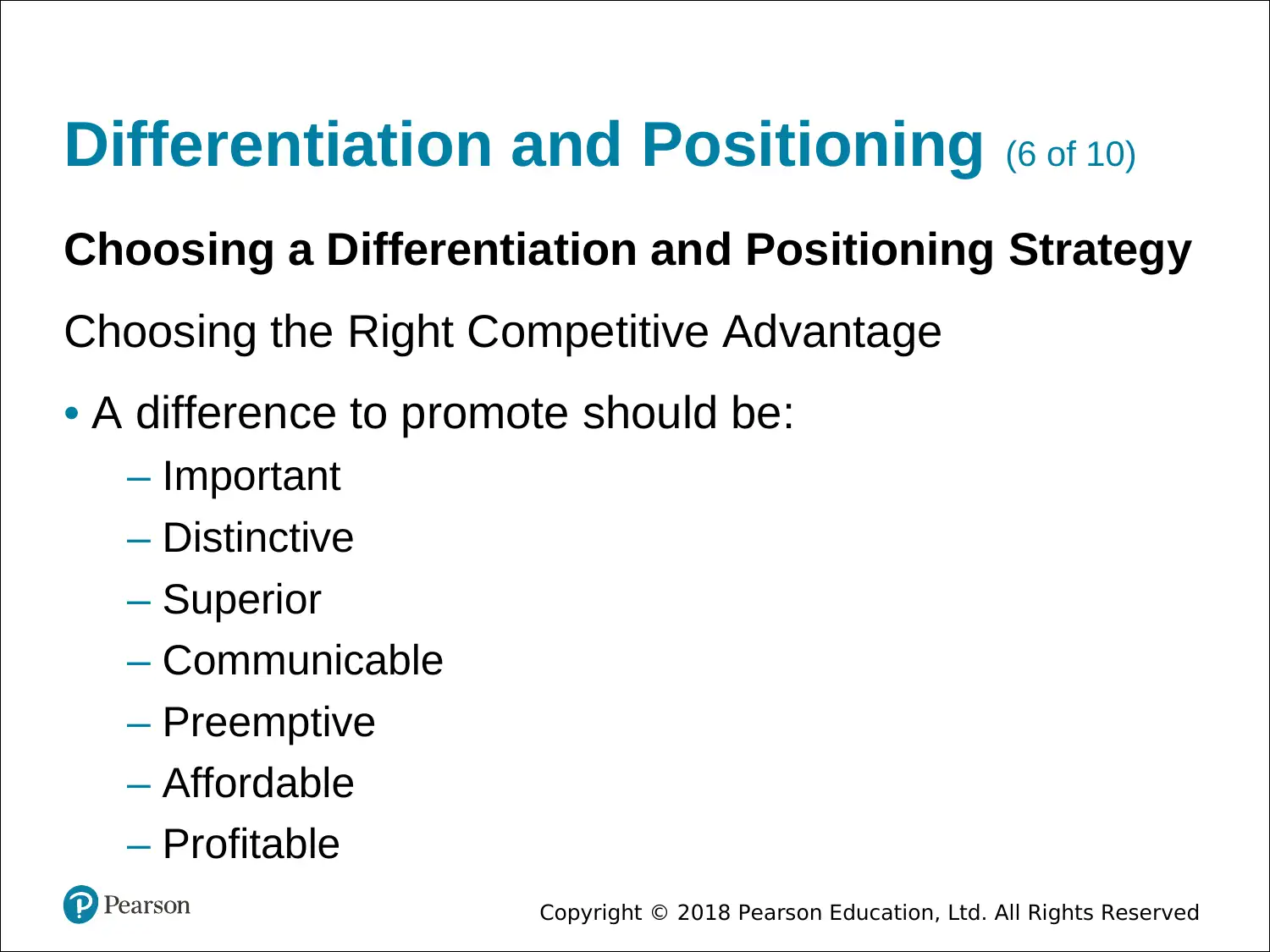
Copyright © 2018 Pearson Education, Ltd. All Rights Reserved
Differentiation and Positioning (6 of 10)
Choosing a Differentiation and Positioning Strategy
Choosing the Right Competitive Advantage
• A difference to promote should be:
– Important
– Distinctive
– Superior
– Communicable
– Preemptive
– Affordable
– Profitable
Differentiation and Positioning (6 of 10)
Choosing a Differentiation and Positioning Strategy
Choosing the Right Competitive Advantage
• A difference to promote should be:
– Important
– Distinctive
– Superior
– Communicable
– Preemptive
– Affordable
– Profitable

Copyright © 2018 Pearson Education, Ltd. All Rights Reserved
GROUP I
GROUP I
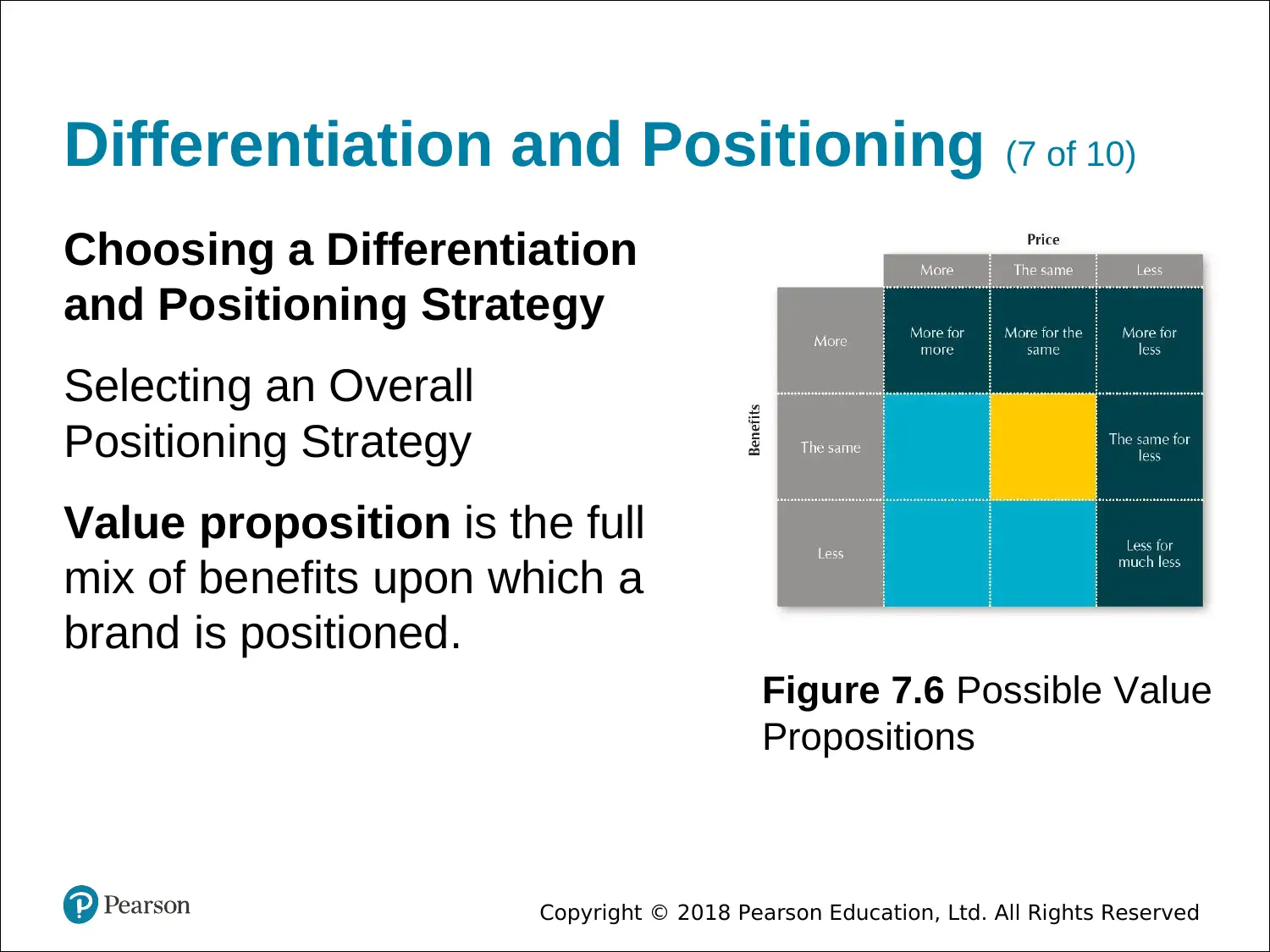
Copyright © 2018 Pearson Education, Ltd. All Rights Reserved
Differentiation and Positioning (7 of 10)
Choosing a Differentiation
and Positioning Strategy
Selecting an Overall
Positioning Strategy
Value proposition is the full
mix of benefits upon which a
brand is positioned.
Figure 7.6 Possible Value
Propositions
Differentiation and Positioning (7 of 10)
Choosing a Differentiation
and Positioning Strategy
Selecting an Overall
Positioning Strategy
Value proposition is the full
mix of benefits upon which a
brand is positioned.
Figure 7.6 Possible Value
Propositions
Secure Best Marks with AI Grader
Need help grading? Try our AI Grader for instant feedback on your assignments.
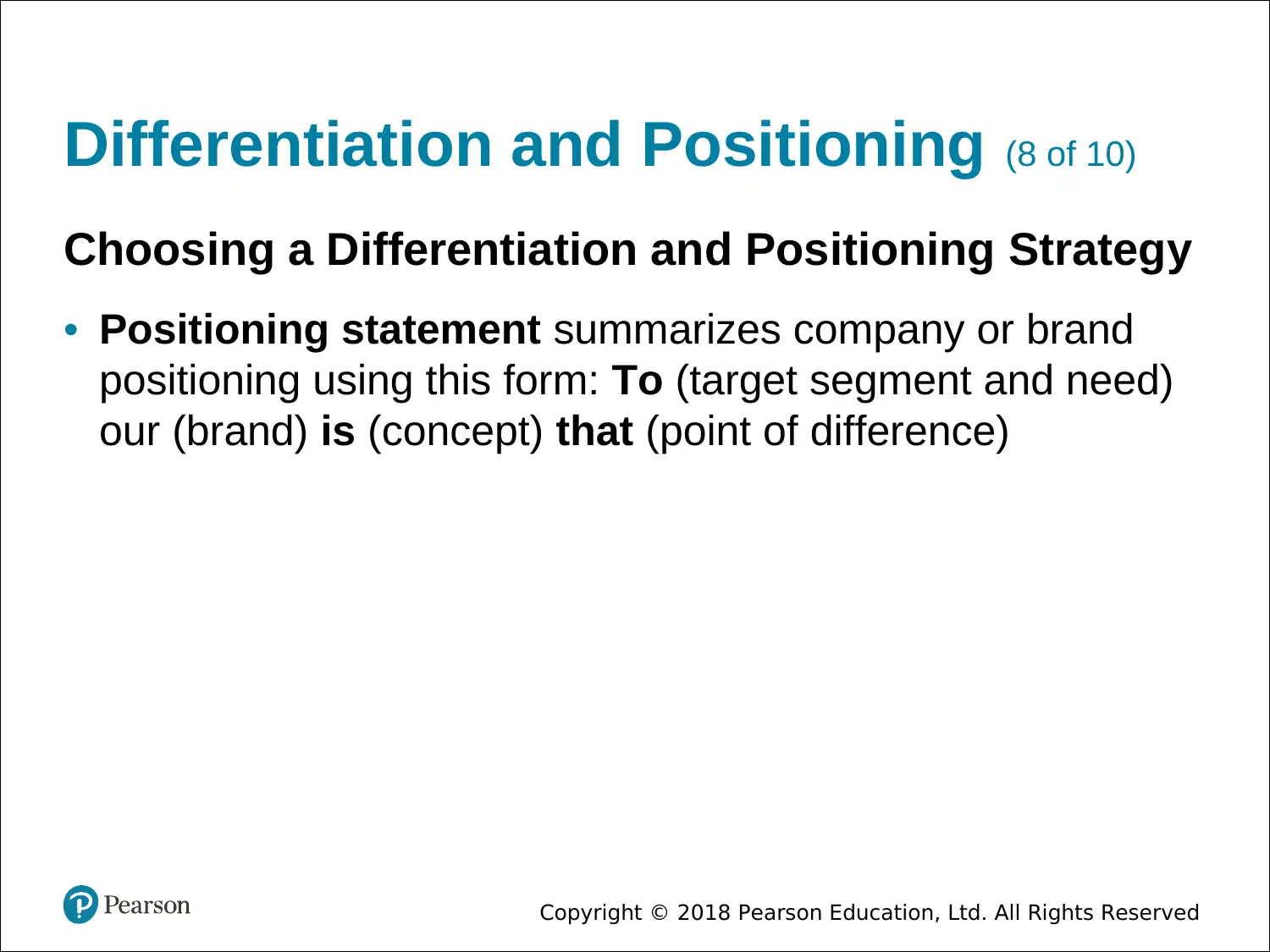
Copyright © 2018 Pearson Education, Ltd. All Rights Reserved
Differentiation and Positioning (8 of 10)
Choosing a Differentiation and Positioning Strategy
• Positioning statement summarizes company or brand
positioning using this form: To (target segment and need)
our (brand) is (concept) that (point of difference)
Differentiation and Positioning (8 of 10)
Choosing a Differentiation and Positioning Strategy
• Positioning statement summarizes company or brand
positioning using this form: To (target segment and need)
our (brand) is (concept) that (point of difference)
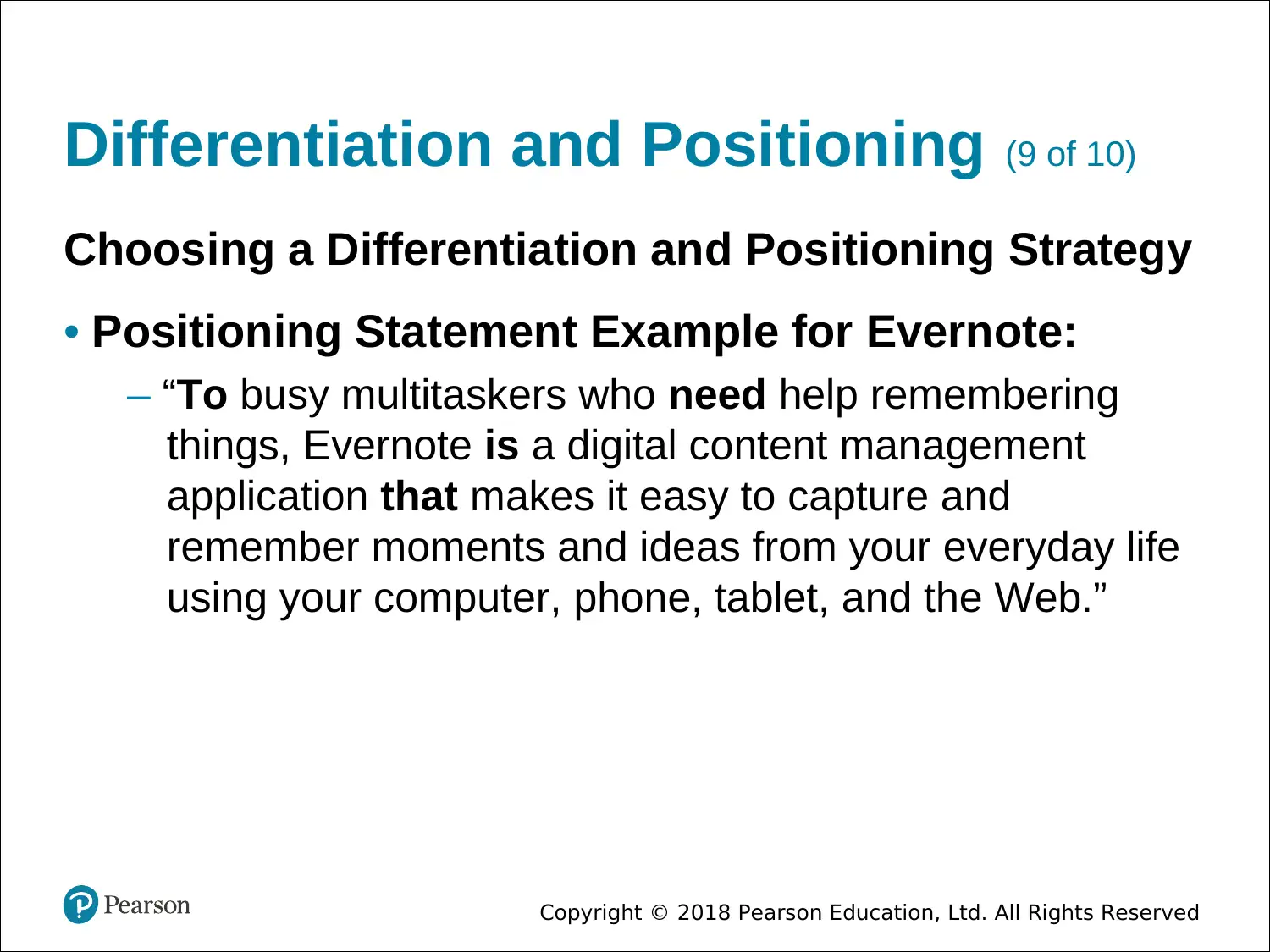
Copyright © 2018 Pearson Education, Ltd. All Rights Reserved
Differentiation and Positioning (9 of 10)
Choosing a Differentiation and Positioning Strategy
• Positioning Statement Example for Evernote:
– “To busy multitaskers who need help remembering
things, Evernote is a digital content management
application that makes it easy to capture and
remember moments and ideas from your everyday life
using your computer, phone, tablet, and the Web.”
Differentiation and Positioning (9 of 10)
Choosing a Differentiation and Positioning Strategy
• Positioning Statement Example for Evernote:
– “To busy multitaskers who need help remembering
things, Evernote is a digital content management
application that makes it easy to capture and
remember moments and ideas from your everyday life
using your computer, phone, tablet, and the Web.”
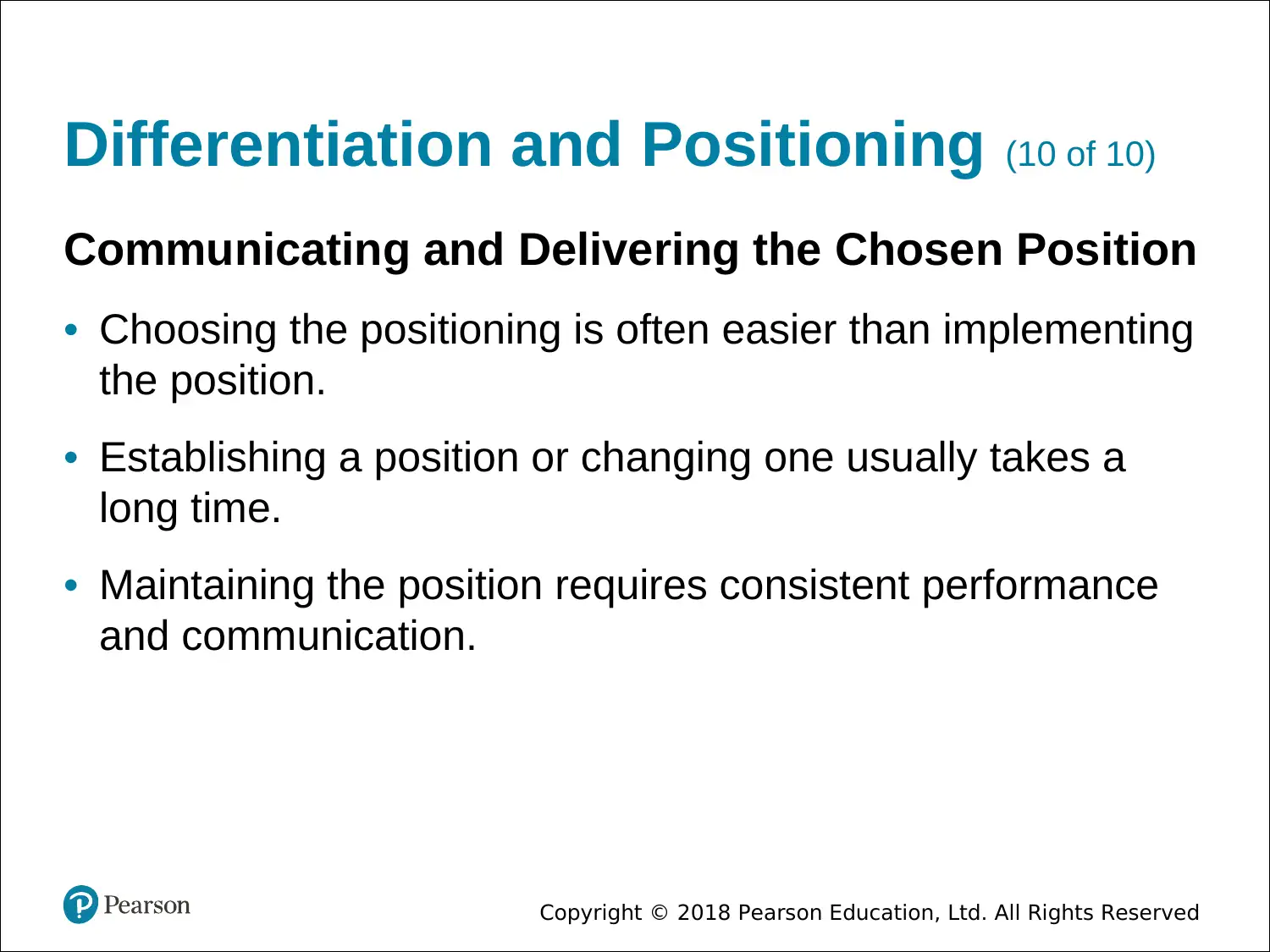
Copyright © 2018 Pearson Education, Ltd. All Rights Reserved
Differentiation and Positioning (10 of 10)
Communicating and Delivering the Chosen Position
• Choosing the positioning is often easier than implementing
the position.
• Establishing a position or changing one usually takes a
long time.
• Maintaining the position requires consistent performance
and communication.
Differentiation and Positioning (10 of 10)
Communicating and Delivering the Chosen Position
• Choosing the positioning is often easier than implementing
the position.
• Establishing a position or changing one usually takes a
long time.
• Maintaining the position requires consistent performance
and communication.
Paraphrase This Document
Need a fresh take? Get an instant paraphrase of this document with our AI Paraphraser
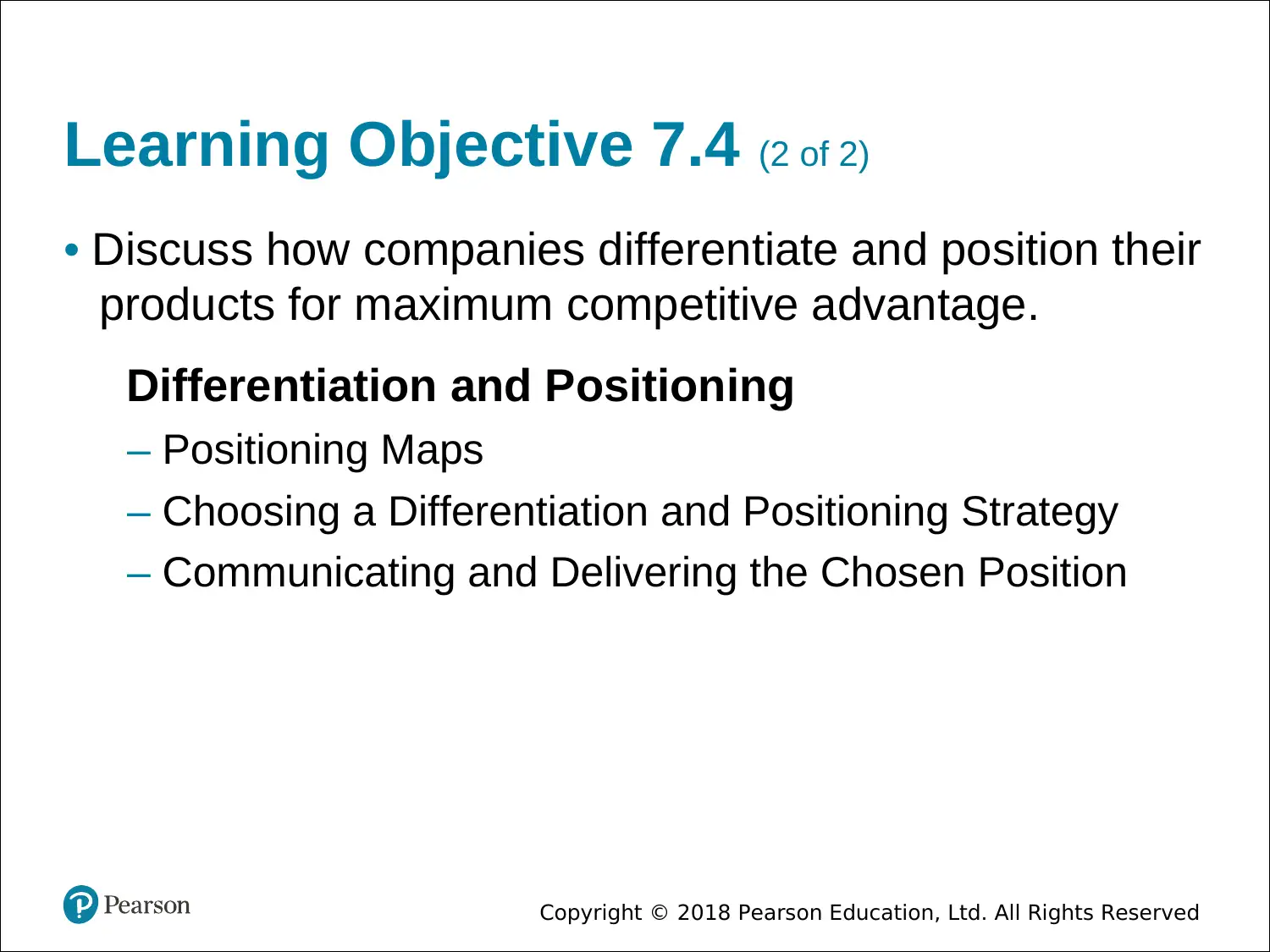
Copyright © 2018 Pearson Education, Ltd. All Rights Reserved
Learning Objective 7.4 (2 of 2)
• Discuss how companies differentiate and position their
products for maximum competitive advantage.
Differentiation and Positioning
– Positioning Maps
– Choosing a Differentiation and Positioning Strategy
– Communicating and Delivering the Chosen Position
Learning Objective 7.4 (2 of 2)
• Discuss how companies differentiate and position their
products for maximum competitive advantage.
Differentiation and Positioning
– Positioning Maps
– Choosing a Differentiation and Positioning Strategy
– Communicating and Delivering the Chosen Position
1 out of 272
Related Documents
Your All-in-One AI-Powered Toolkit for Academic Success.
+13062052269
info@desklib.com
Available 24*7 on WhatsApp / Email
![[object Object]](/_next/static/media/star-bottom.7253800d.svg)
Unlock your academic potential
© 2024 | Zucol Services PVT LTD | All rights reserved.





